| schema location: | ..\..\xsd\schema\railml3.xsd |
| attributeFormDefault: | |
| elementFormDefault: | qualified |
| targetNamespace: | https://www.railml.org/schemas/3.1 |
| Elements | Complex types | Attr. groups |
| railML | railML | aRailML |
| schema location: | ..\..\xsd\schema\timetable3.xsd |
| attributeFormDefault: | |
| elementFormDefault: | qualified |
| targetNamespace: | https://www.railml.org/schemas/3.1 |
| Elements | Complex types |
| Timetable | Timetable |
| schema location: | ..\..\xsd\schema\rollingstock3.xsd |
| attributeFormDefault: | |
| elementFormDefault: | qualified |
| targetNamespace: | https://www.railml.org/schemas/3.1 |
| Elements | Complex types |
| Rollingstock | Rollingstock |
| schema location: | ..\..\xsd\schema\interlocking3.xsd |
| attributeFormDefault: | |
| elementFormDefault: | qualified |
| targetNamespace: | https://www.railml.org/schemas/3.1 |
| schema location: | ..\..\xsd\schema\infrastructure3.xsd |
| attributeFormDefault: | |
| elementFormDefault: | qualified |
| targetNamespace: | https://www.railml.org/schemas/3.1 |
| schema location: | ..\..\xsd\schema\common3.xsd |
| attributeFormDefault: | |
| elementFormDefault: | qualified |
| targetNamespace: | https://www.railml.org/schemas/3.1 |
| schema location: | ..\..\xsd\schema\rtm4railml3.xsd |
| attributeFormDefault: | |
| elementFormDefault: | qualified |
| targetNamespace: | https://www.railml.org/schemas/3.1 |
| schema location: | ..\..\xsd\schema\gml\gml4railml3.xsd |
| attributeFormDefault: | |
| elementFormDefault: | qualified |
| targetNamespace: | https://www.railml.org/schemas/3.1/gml |
| schema location: | http://dublincore.org/schemas/xmls/qdc/2008/02/11/dc.xsd |
| attributeFormDefault: | unqualified |
| elementFormDefault: | qualified |
| targetNamespace: | http://purl.org/dc/elements/1.1/ |
| Elements | Groups | Complex types |
| any | elementsGroup | elementContainer |
| contributor | SimpleLiteral | |
| coverage | ||
| creator | ||
| date | ||
| description | ||
| format | ||
| identifier | ||
| language | ||
| publisher | ||
| relation | ||
| rights | ||
| source | ||
| subject | ||
| title | ||
| type |
| schema location: | http://www.w3.org/2001/03/xml.xsd |
| attributeFormDefault: | |
| elementFormDefault: | |
| targetNamespace: | http://www.w3.org/XML/1998/namespace |
| Attributes | Attr. groups |
| base | specialAttrs |
| lang | |
| space |
element railML
| diagram | 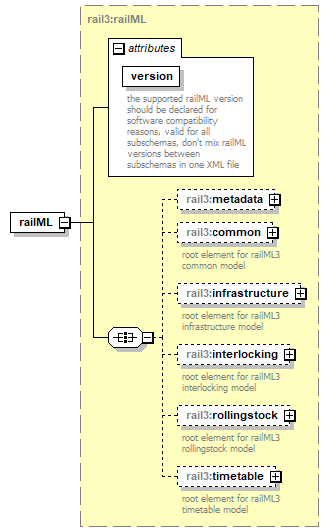 | ||||||||||||||
| namespace | https://www.railml.org/schemas/3.1 | ||||||||||||||
| type | rail3:railML | ||||||||||||||
| properties |
| ||||||||||||||
| children | rail3:metadata rail3:common rail3:infrastructure rail3:interlocking rail3:rollingstock rail3:timetable | ||||||||||||||
| attributes |
| ||||||||||||||
| source | <xs:element name="railML" type="rail3:railML"/> |
complexType railML
| diagram | 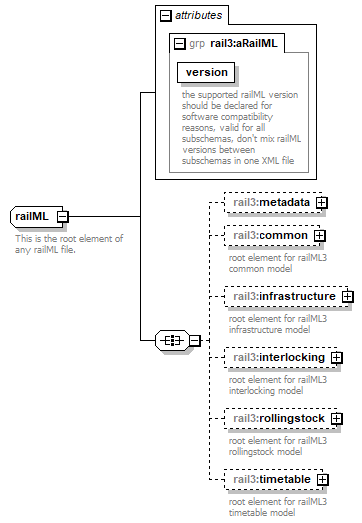 | ||||||||||||||
| namespace | https://www.railml.org/schemas/3.1 | ||||||||||||||
| children | rail3:metadata rail3:common rail3:infrastructure rail3:interlocking rail3:rollingstock rail3:timetable | ||||||||||||||
| used by |
| ||||||||||||||
| attributes |
| ||||||||||||||
| annotation |
| ||||||||||||||
| source | <xs:complexType name="railML"> <xs:annotation> <xs:documentation>This is the root element of any railML file.</xs:documentation> </xs:annotation> <xs:all> <xs:element name="metadata" type="rail3:Metadata" minOccurs="0" maxOccurs="1"/> <xs:element name="common" type="rail3:Common" minOccurs="0" maxOccurs="1"> <xs:annotation> <xs:documentation>root element for railML3 common model</xs:documentation> </xs:annotation> </xs:element> <xs:element name="infrastructure" type="rail3:Infrastructure" minOccurs="0" maxOccurs="1"> <xs:annotation> <xs:documentation>root element for railML3 infrastructure model</xs:documentation> </xs:annotation> </xs:element> <xs:element name="interlocking" type="rail3:Interlocking" minOccurs="0" maxOccurs="1"> <xs:annotation> <xs:documentation>root element for railML3 interlocking model</xs:documentation> </xs:annotation> </xs:element> <xs:element name="rollingstock" type="rail3:Rollingstock" minOccurs="0" maxOccurs="1"> <xs:annotation> <xs:documentation>root element for railML3 rollingstock model</xs:documentation> </xs:annotation> </xs:element> <xs:element name="timetable" type="rail3:Timetable" minOccurs="0" maxOccurs="1"> <xs:annotation> <xs:documentation>root element for railML3 timetable model</xs:documentation> </xs:annotation> </xs:element> </xs:all> <xs:attributeGroup ref="rail3:aRailML"/> </xs:complexType> |
element railML/metadata
| diagram | 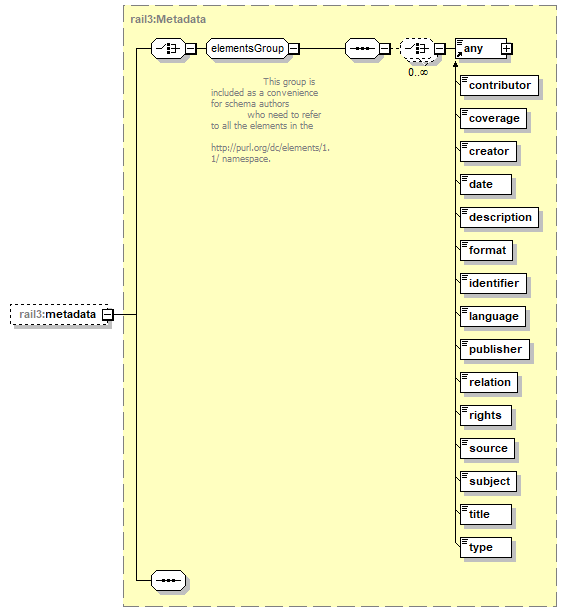 | ||||||
| namespace | https://www.railml.org/schemas/3.1 | ||||||
| type | rail3:Metadata | ||||||
| properties |
| ||||||
| children | any | ||||||
| source | <xs:element name="metadata" type="rail3:Metadata" minOccurs="0" maxOccurs="1"/> |
element railML/common
| diagram | 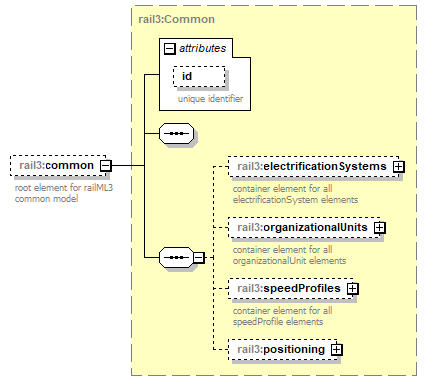 | ||||||||||||||
| namespace | https://www.railml.org/schemas/3.1 | ||||||||||||||
| type | rail3:Common | ||||||||||||||
| properties |
| ||||||||||||||
| children | rail3:electrificationSystems rail3:organizationalUnits rail3:speedProfiles rail3:positioning | ||||||||||||||
| attributes |
| ||||||||||||||
| annotation |
| ||||||||||||||
| source | <xs:element name="common" type="rail3:Common" minOccurs="0" maxOccurs="1"> <xs:annotation> <xs:documentation>root element for railML3 common model</xs:documentation> </xs:annotation> </xs:element> |
element railML/infrastructure
| diagram | 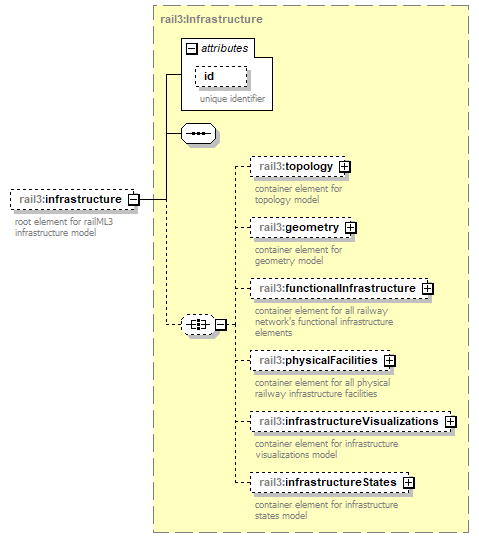 | ||||||||||||||
| namespace | https://www.railml.org/schemas/3.1 | ||||||||||||||
| type | rail3:Infrastructure | ||||||||||||||
| properties |
| ||||||||||||||
| children | rail3:topology rail3:geometry rail3:functionalInfrastructure rail3:physicalFacilities rail3:infrastructureVisualizations rail3:infrastructureStates | ||||||||||||||
| attributes |
| ||||||||||||||
| annotation |
| ||||||||||||||
| source | <xs:element name="infrastructure" type="rail3:Infrastructure" minOccurs="0" maxOccurs="1"> <xs:annotation> <xs:documentation>root element for railML3 infrastructure model</xs:documentation> </xs:annotation> </xs:element> |
element railML/interlocking
| diagram | 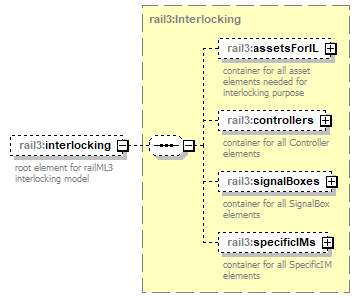 | ||||||
| namespace | https://www.railml.org/schemas/3.1 | ||||||
| type | rail3:Interlocking | ||||||
| properties |
| ||||||
| children | rail3:assetsForIL rail3:controllers rail3:signalBoxes rail3:specificIMs | ||||||
| annotation |
| ||||||
| source | <xs:element name="interlocking" type="rail3:Interlocking" minOccurs="0" maxOccurs="1"> <xs:annotation> <xs:documentation>root element for railML3 interlocking model</xs:documentation> </xs:annotation> </xs:element> |
element railML/rollingstock
| diagram |  | ||||||
| namespace | https://www.railml.org/schemas/3.1 | ||||||
| type | rail3:Rollingstock | ||||||
| properties |
| ||||||
| annotation |
| ||||||
| source | <xs:element name="rollingstock" type="rail3:Rollingstock" minOccurs="0" maxOccurs="1"> <xs:annotation> <xs:documentation>root element for railML3 rollingstock model</xs:documentation> </xs:annotation> </xs:element> |
element railML/timetable
| diagram |  | ||||||
| namespace | https://www.railml.org/schemas/3.1 | ||||||
| type | rail3:Timetable | ||||||
| properties |
| ||||||
| annotation |
| ||||||
| source | <xs:element name="timetable" type="rail3:Timetable" minOccurs="0" maxOccurs="1"> <xs:annotation> <xs:documentation>root element for railML3 timetable model</xs:documentation> </xs:annotation> </xs:element> |
attributeGroup aRailML
| namespace | https://www.railml.org/schemas/3.1 | ||||||||||||||
| used by |
| ||||||||||||||
| attributes |
| ||||||||||||||
| source | <xs:attributeGroup name="aRailML"> <xs:attribute name="version" type="xs:string" use="required"> <xs:annotation> <xs:documentation>the supported railML version should be declared for software compatibility reasons, valid for all subschemas, don't mix railML versions between subschemas in one XML file</xs:documentation> </xs:annotation> </xs:attribute> </xs:attributeGroup> |
attribute aRailML/@version
| type | xs:string | ||
| properties |
| ||
| annotation |
| ||
| source | <xs:attribute name="version" type="xs:string" use="required"> <xs:annotation> <xs:documentation>the supported railML version should be declared for software compatibility reasons, valid for all subschemas, don't mix railML versions between subschemas in one XML file</xs:documentation> </xs:annotation> </xs:attribute> |
element Timetable
| diagram |  | ||
| namespace | https://www.railml.org/schemas/3.1 | ||
| type | rail3:Timetable | ||
| properties |
| ||
| source | <xs:element name="Timetable" type="rail3:Timetable"/> |
complexType Timetable
| diagram |  | ||
| namespace | https://www.railml.org/schemas/3.1 | ||
| used by |
| ||
| annotation |
| ||
| source | <xs:complexType name="Timetable"> <xs:annotation> <xs:documentation>This is the top level element for the timetable model.</xs:documentation> </xs:annotation> <xs:sequence minOccurs="0" maxOccurs="1"/> </xs:complexType> |
element Rollingstock
| diagram |  | ||
| namespace | https://www.railml.org/schemas/3.1 | ||
| type | rail3:Rollingstock | ||
| properties |
| ||
| source | <xs:element name="Rollingstock" type="rail3:Rollingstock"/> |
complexType Rollingstock
| diagram |  | ||
| namespace | https://www.railml.org/schemas/3.1 | ||
| used by |
| ||
| annotation |
| ||
| source | <xs:complexType name="Rollingstock"> <xs:annotation> <xs:documentation>This is the top level element for the rollingstock model.</xs:documentation> </xs:annotation> <xs:sequence minOccurs="0" maxOccurs="1"/> </xs:complexType> |
complexType ActivationCondition
| diagram | 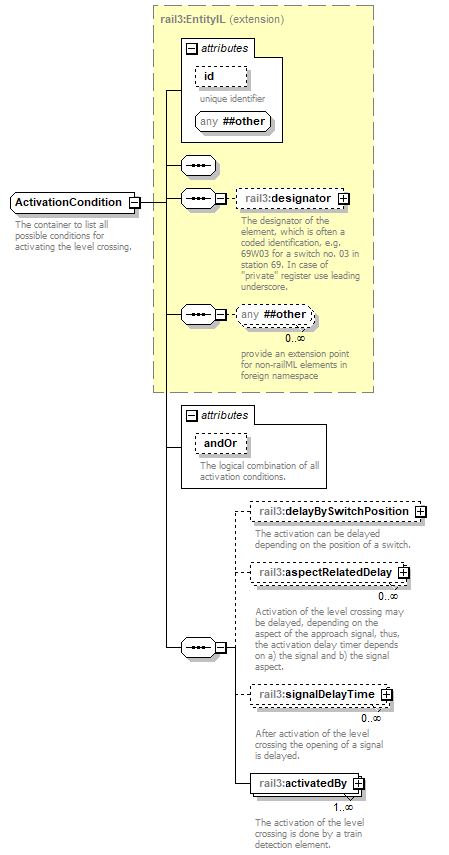 | ||||||||||||||||||||||
| namespace | https://www.railml.org/schemas/3.1 | ||||||||||||||||||||||
| type | extension of rail3:EntityIL | ||||||||||||||||||||||
| properties |
| ||||||||||||||||||||||
| children | rail3:designator rail3:delayBySwitchPosition rail3:aspectRelatedDelay rail3:signalDelayTime rail3:activatedBy | ||||||||||||||||||||||
| used by |
| ||||||||||||||||||||||
| attributes |
| ||||||||||||||||||||||
| annotation |
| ||||||||||||||||||||||
| source | <xs:complexType name="ActivationCondition"> <xs:annotation> <xs:documentation>The container to list all possible conditions for activating the level crossing.</xs:documentation> </xs:annotation> <xs:complexContent> <xs:extension base="rail3:EntityIL"> <xs:sequence> <xs:element name="delayBySwitchPosition" type="rail3:SwitchRelatedDelay" minOccurs="0" maxOccurs="1"> <xs:annotation> <xs:documentation>The activation can be delayed depending on the position of a switch.</xs:documentation> </xs:annotation> </xs:element> <xs:element name="aspectRelatedDelay" type="rail3:AspectRelatedLevelCrossingDelay" minOccurs="0" maxOccurs="unbounded"> <xs:annotation> <xs:documentation>Activation of the level crossing may be delayed, depending on the aspect of the approach signal, thus, the activation delay timer depends on a) the signal and b) the signal aspect.</xs:documentation> </xs:annotation> </xs:element> <xs:element name="signalDelayTime" type="rail3:SignalDelayTime" minOccurs="0" maxOccurs="unbounded"> <xs:annotation> <xs:documentation>After activation of the level crossing the opening of a signal is delayed.</xs:documentation> </xs:annotation> </xs:element> <xs:element name="activatedBy" type="rail3:ApproachStartingDetector" minOccurs="1" maxOccurs="unbounded"> <xs:annotation> <xs:documentation>The activation of the level crossing is done by a train detection element.</xs:documentation> </xs:annotation> </xs:element> </xs:sequence> <xs:attribute name="andOr" type="rail3:tAndOr" use="optional"> <xs:annotation> <xs:documentation>The logical combination of all activation conditions.</xs:documentation> </xs:annotation> </xs:attribute> </xs:extension> </xs:complexContent> </xs:complexType> |
attribute ActivationCondition/@andOr
| type | rail3:tAndOr | ||||||||||||
| properties |
| ||||||||||||
| facets |
| ||||||||||||
| annotation |
| ||||||||||||
| source | <xs:attribute name="andOr" type="rail3:tAndOr" use="optional"> <xs:annotation> <xs:documentation>The logical combination of all activation conditions.</xs:documentation> </xs:annotation> </xs:attribute> |
element ActivationCondition/delayBySwitchPosition
| diagram | 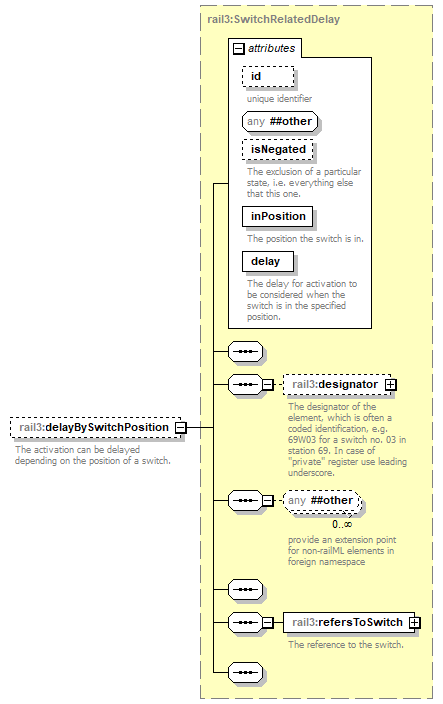 | ||||||||||||||||||||||||||||||||||||||
| namespace | https://www.railml.org/schemas/3.1 | ||||||||||||||||||||||||||||||||||||||
| type | rail3:SwitchRelatedDelay | ||||||||||||||||||||||||||||||||||||||
| properties |
| ||||||||||||||||||||||||||||||||||||||
| children | rail3:designator rail3:refersToSwitch | ||||||||||||||||||||||||||||||||||||||
| attributes |
| ||||||||||||||||||||||||||||||||||||||
| annotation |
| ||||||||||||||||||||||||||||||||||||||
| source | <xs:element name="delayBySwitchPosition" type="rail3:SwitchRelatedDelay" minOccurs="0" maxOccurs="1"> <xs:annotation> <xs:documentation>The activation can be delayed depending on the position of a switch.</xs:documentation> </xs:annotation> </xs:element> |
element ActivationCondition/aspectRelatedDelay
| diagram | 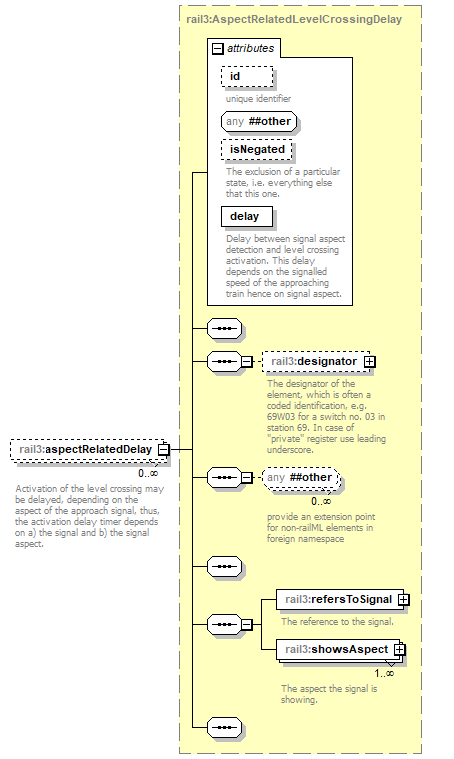 | ||||||||||||||||||||||||||||||
| namespace | https://www.railml.org/schemas/3.1 | ||||||||||||||||||||||||||||||
| type | rail3:AspectRelatedLevelCrossingDelay | ||||||||||||||||||||||||||||||
| properties |
| ||||||||||||||||||||||||||||||
| children | rail3:designator rail3:refersToSignal rail3:showsAspect | ||||||||||||||||||||||||||||||
| attributes |
| ||||||||||||||||||||||||||||||
| annotation |
| ||||||||||||||||||||||||||||||
| source | <xs:element name="aspectRelatedDelay" type="rail3:AspectRelatedLevelCrossingDelay" minOccurs="0" maxOccurs="unbounded"> <xs:annotation> <xs:documentation>Activation of the level crossing may be delayed, depending on the aspect of the approach signal, thus, the activation delay timer depends on a) the signal and b) the signal aspect.</xs:documentation> </xs:annotation> </xs:element> |
element ActivationCondition/signalDelayTime
| diagram | 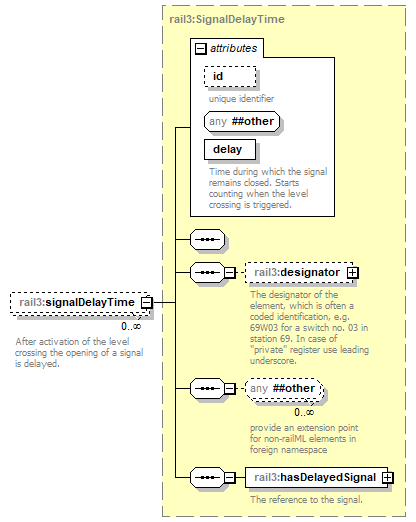 | ||||||||||||||||||||||
| namespace | https://www.railml.org/schemas/3.1 | ||||||||||||||||||||||
| type | rail3:SignalDelayTime | ||||||||||||||||||||||
| properties |
| ||||||||||||||||||||||
| children | rail3:designator rail3:hasDelayedSignal | ||||||||||||||||||||||
| attributes |
| ||||||||||||||||||||||
| annotation |
| ||||||||||||||||||||||
| source | <xs:element name="signalDelayTime" type="rail3:SignalDelayTime" minOccurs="0" maxOccurs="unbounded"> <xs:annotation> <xs:documentation>After activation of the level crossing the opening of a signal is delayed.</xs:documentation> </xs:annotation> </xs:element> |
element ActivationCondition/activatedBy
| diagram | 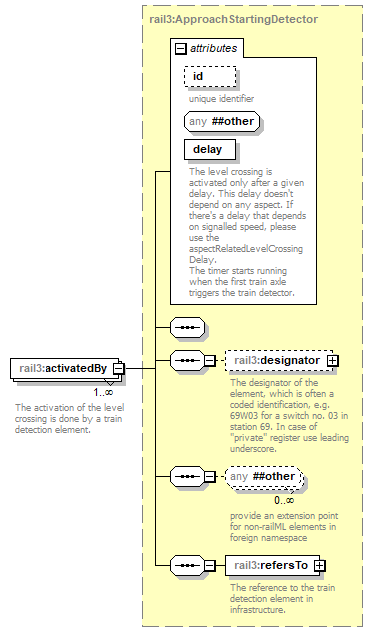 | ||||||||||||||||||||||
| namespace | https://www.railml.org/schemas/3.1 | ||||||||||||||||||||||
| type | rail3:ApproachStartingDetector | ||||||||||||||||||||||
| properties |
| ||||||||||||||||||||||
| children | rail3:designator rail3:refersTo | ||||||||||||||||||||||
| attributes |
| ||||||||||||||||||||||
| annotation |
| ||||||||||||||||||||||
| source | <xs:element name="activatedBy" type="rail3:ApproachStartingDetector" minOccurs="1" maxOccurs="unbounded"> <xs:annotation> <xs:documentation>The activation of the level crossing is done by a train detection element.</xs:documentation> </xs:annotation> </xs:element> |
complexType ApproachStartingDetector
| diagram | 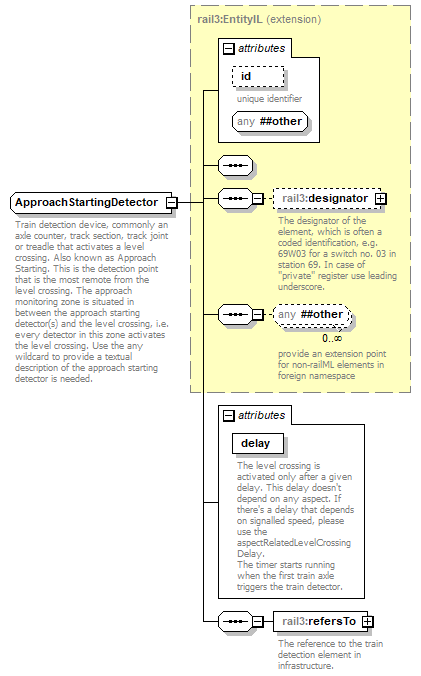 | ||||||||||||||||||||||
| namespace | https://www.railml.org/schemas/3.1 | ||||||||||||||||||||||
| type | extension of rail3:EntityIL | ||||||||||||||||||||||
| properties |
| ||||||||||||||||||||||
| children | rail3:designator rail3:refersTo | ||||||||||||||||||||||
| used by |
| ||||||||||||||||||||||
| attributes |
| ||||||||||||||||||||||
| annotation |
| ||||||||||||||||||||||
| source | <xs:complexType name="ApproachStartingDetector"> <xs:annotation> <xs:documentation>Train detection device, commonly an axle counter, track section, track joint or treadle that activates a level crossing. Also known as Approach Starting. This is the detection point that is the most remote from the level crossing. The approach monitoring zone is situated in between the approach starting detector(s) and the level crossing, i.e. every detector in this zone activates the level crossing. Use the any wildcard to provide a textual description of the approach starting detector is needed.</xs:documentation> </xs:annotation> <xs:complexContent> <xs:extension base="rail3:EntityIL"> <xs:sequence> <xs:element name="refersTo" type="rail3:EntityILref" minOccurs="1" maxOccurs="1"> <xs:annotation> <xs:documentation>The reference to the train detection element in infrastructure.</xs:documentation> </xs:annotation> </xs:element> </xs:sequence> <xs:attribute name="delay" type="xs:duration" use="required"> <xs:annotation> <xs:documentation>The level crossing is activated only after a given delay. This delay doesn't depend on any aspect. If there's a delay that depends on signalled speed, please use the aspectRelatedLevelCrossingDelay. The timer starts running when the first train axle triggers the train detector.</xs:documentation> </xs:annotation> </xs:attribute> </xs:extension> </xs:complexContent> </xs:complexType> |
attribute ApproachStartingDetector/@delay
| type | xs:duration | ||
| properties |
| ||
| annotation |
| ||
| source | <xs:attribute name="delay" type="xs:duration" use="required"> <xs:annotation> <xs:documentation>The level crossing is activated only after a given delay. This delay doesn't depend on any aspect. If there's a delay that depends on signalled speed, please use the aspectRelatedLevelCrossingDelay. The timer starts running when the first train axle triggers the train detector.</xs:documentation> </xs:annotation> </xs:attribute> |
element ApproachStartingDetector/refersTo
| diagram | 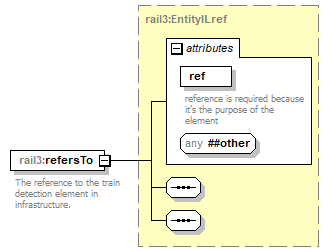 | ||||||||||||||
| namespace | https://www.railml.org/schemas/3.1 | ||||||||||||||
| type | rail3:EntityILref | ||||||||||||||
| properties |
| ||||||||||||||
| attributes |
| ||||||||||||||
| annotation |
| ||||||||||||||
| source | <xs:element name="refersTo" type="rail3:EntityILref" minOccurs="1" maxOccurs="1"> <xs:annotation> <xs:documentation>The reference to the train detection element in infrastructure.</xs:documentation> </xs:annotation> </xs:element> |
complexType AspectRelatedLevelCrossingDelay
| diagram | 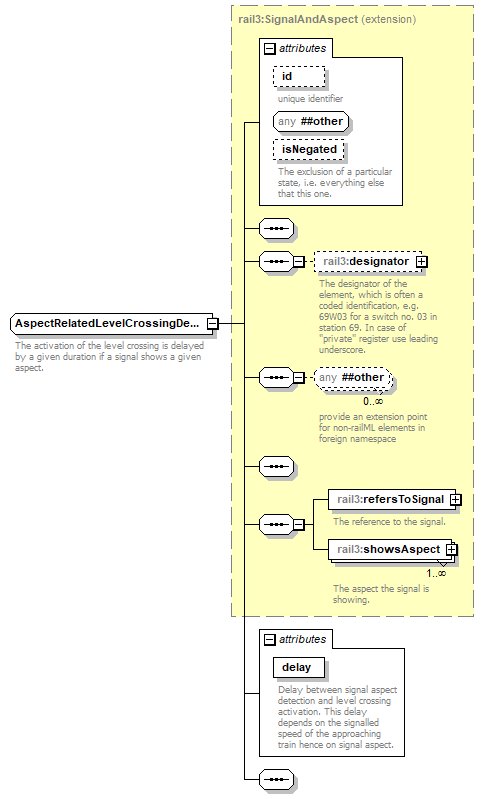 | ||||||||||||||||||||||||||||||
| namespace | https://www.railml.org/schemas/3.1 | ||||||||||||||||||||||||||||||
| type | extension of rail3:SignalAndAspect | ||||||||||||||||||||||||||||||
| properties |
| ||||||||||||||||||||||||||||||
| children | rail3:designator rail3:refersToSignal rail3:showsAspect | ||||||||||||||||||||||||||||||
| used by |
| ||||||||||||||||||||||||||||||
| attributes |
| ||||||||||||||||||||||||||||||
| annotation |
| ||||||||||||||||||||||||||||||
| source | <xs:complexType name="AspectRelatedLevelCrossingDelay"> <xs:annotation> <xs:documentation>The activation of the level crossing is delayed by a given duration if a signal shows a given aspect.</xs:documentation> </xs:annotation> <xs:complexContent> <xs:extension base="rail3:SignalAndAspect"> <xs:sequence/> <xs:attribute name="delay" type="xs:duration" use="required"> <xs:annotation> <xs:documentation>Delay between signal aspect detection and level crossing activation. This delay depends on the signalled speed of the approaching train hence on signal aspect.</xs:documentation> </xs:annotation> </xs:attribute> </xs:extension> </xs:complexContent> </xs:complexType> |
attribute AspectRelatedLevelCrossingDelay/@delay
| type | xs:duration | ||
| properties |
| ||
| annotation |
| ||
| source | <xs:attribute name="delay" type="xs:duration" use="required"> <xs:annotation> <xs:documentation>Delay between signal aspect detection and level crossing activation. This delay depends on the signalled speed of the approaching train hence on signal aspect.</xs:documentation> </xs:annotation> </xs:attribute> |
complexType AspectRelation
| diagram | 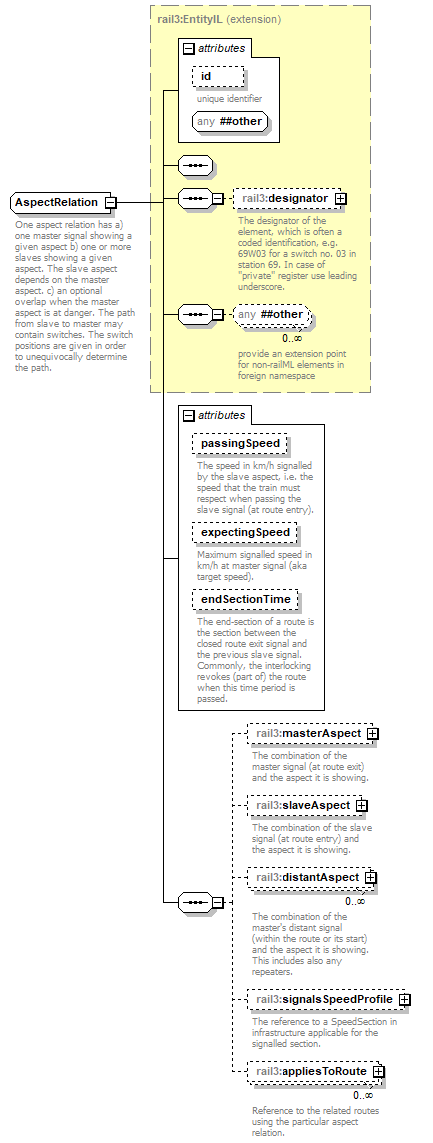 | ||||||||||||||||||||||||||||||||||||||
| namespace | https://www.railml.org/schemas/3.1 | ||||||||||||||||||||||||||||||||||||||
| type | extension of rail3:EntityIL | ||||||||||||||||||||||||||||||||||||||
| properties |
| ||||||||||||||||||||||||||||||||||||||
| children | rail3:designator rail3:masterAspect rail3:slaveAspect rail3:distantAspect rail3:signalsSpeedProfile rail3:appliesToRoute | ||||||||||||||||||||||||||||||||||||||
| used by |
| ||||||||||||||||||||||||||||||||||||||
| attributes |
| ||||||||||||||||||||||||||||||||||||||
| annotation |
| ||||||||||||||||||||||||||||||||||||||
| source | <xs:complexType name="AspectRelation"> <xs:annotation> <xs:documentation>One aspect relation has a) one master signal showing a given aspect b) one or more slaves showing a given aspect. The slave aspect depends on the master aspect. c) an optional overlap when the master aspect is at danger. The path from slave to master may contain switches. The switch positions are given in order to unequivocally determine the path.</xs:documentation> </xs:annotation> <xs:complexContent> <xs:extension base="rail3:EntityIL"> <xs:sequence> <xs:element name="masterAspect" type="rail3:SignalAndAspect" minOccurs="0" maxOccurs="1"> <xs:annotation> <xs:documentation>The combination of the master signal (at route exit) and the aspect it is showing.</xs:documentation> </xs:annotation> </xs:element> <xs:element name="slaveAspect" type="rail3:SignalAndAspect" minOccurs="0" maxOccurs="1"> <xs:annotation> <xs:documentation>The combination of the slave signal (at route entry) and the aspect it is showing.</xs:documentation> </xs:annotation> </xs:element> <xs:element name="distantAspect" type="rail3:SignalAndAspect" minOccurs="0" maxOccurs="unbounded"> <xs:annotation> <xs:documentation>The combination of the master's distant signal (within the route or its start) and the aspect it is showing. This includes also any repeaters.</xs:documentation> </xs:annotation> </xs:element> <xs:element name="signalsSpeedProfile" type="rail3:EntityILref" minOccurs="0" maxOccurs="1"> <xs:annotation> <xs:documentation>The reference to a SpeedSection in infrastructure applicable for the signalled section.</xs:documentation> </xs:annotation> </xs:element> <xs:element name="appliesToRoute" type="rail3:EntityILref" minOccurs="0" maxOccurs="unbounded"> <xs:annotation> <xs:documentation>Reference to the related routes using the particular aspect relation.</xs:documentation> </xs:annotation> </xs:element> </xs:sequence> <xs:attribute name="passingSpeed" type="rail3:tSpeedKmPerHour" use="optional"> <xs:annotation> <xs:documentation>The speed in km/h signalled by the slave aspect, i.e. the speed that the train must respect when passing the slave signal (at route entry).</xs:documentation> </xs:annotation> </xs:attribute> <xs:attribute name="expectingSpeed" type="rail3:tSpeedKmPerHour" use="optional"> <xs:annotation> <xs:documentation>Maximum signalled speed in km/h at master signal (aka target speed).</xs:documentation> </xs:annotation> </xs:attribute> <xs:attribute name="endSectionTime" type="xs:duration" use="optional"> <xs:annotation> <xs:documentation>The end-section of a route is the section between the closed route exit signal and the previous slave signal. Commonly, the interlocking revokes (part of) the route when this time period is passed.</xs:documentation> </xs:annotation> </xs:attribute> </xs:extension> </xs:complexContent> </xs:complexType> |
attribute AspectRelation/@passingSpeed
| type | rail3:tSpeedKmPerHour | ||
| properties |
| ||
| annotation |
| ||
| source | <xs:attribute name="passingSpeed" type="rail3:tSpeedKmPerHour" use="optional"> <xs:annotation> <xs:documentation>The speed in km/h signalled by the slave aspect, i.e. the speed that the train must respect when passing the slave signal (at route entry).</xs:documentation> </xs:annotation> </xs:attribute> |
attribute AspectRelation/@expectingSpeed
| type | rail3:tSpeedKmPerHour | ||
| properties |
| ||
| annotation |
| ||
| source | <xs:attribute name="expectingSpeed" type="rail3:tSpeedKmPerHour" use="optional"> <xs:annotation> <xs:documentation>Maximum signalled speed in km/h at master signal (aka target speed).</xs:documentation> </xs:annotation> </xs:attribute> |
attribute AspectRelation/@endSectionTime
| type | xs:duration | ||
| properties |
| ||
| annotation |
| ||
| source | <xs:attribute name="endSectionTime" type="xs:duration" use="optional"> <xs:annotation> <xs:documentation>The end-section of a route is the section between the closed route exit signal and the previous slave signal. Commonly, the interlocking revokes (part of) the route when this time period is passed.</xs:documentation> </xs:annotation> </xs:attribute> |
element AspectRelation/masterAspect
| diagram | 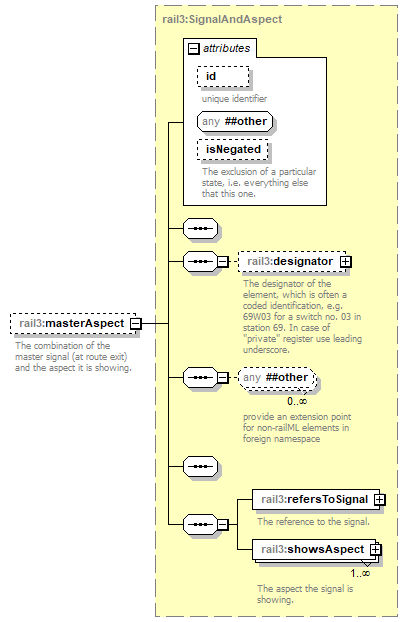 | ||||||||||||||||||||||
| namespace | https://www.railml.org/schemas/3.1 | ||||||||||||||||||||||
| type | rail3:SignalAndAspect | ||||||||||||||||||||||
| properties |
| ||||||||||||||||||||||
| children | rail3:designator rail3:refersToSignal rail3:showsAspect | ||||||||||||||||||||||
| attributes |
| ||||||||||||||||||||||
| annotation |
| ||||||||||||||||||||||
| source | <xs:element name="masterAspect" type="rail3:SignalAndAspect" minOccurs="0" maxOccurs="1"> <xs:annotation> <xs:documentation>The combination of the master signal (at route exit) and the aspect it is showing.</xs:documentation> </xs:annotation> </xs:element> |
element AspectRelation/slaveAspect
| diagram | 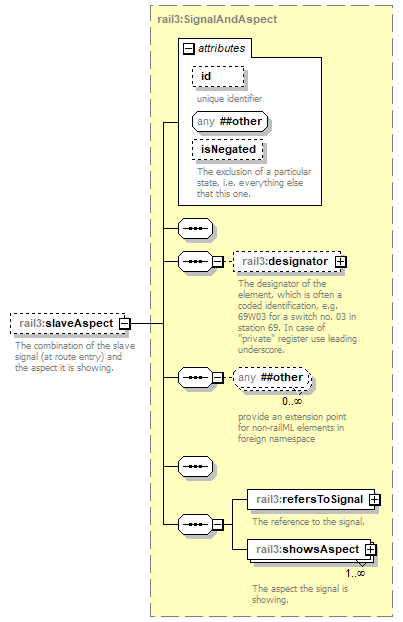 | ||||||||||||||||||||||
| namespace | https://www.railml.org/schemas/3.1 | ||||||||||||||||||||||
| type | rail3:SignalAndAspect | ||||||||||||||||||||||
| properties |
| ||||||||||||||||||||||
| children | rail3:designator rail3:refersToSignal rail3:showsAspect | ||||||||||||||||||||||
| attributes |
| ||||||||||||||||||||||
| annotation |
| ||||||||||||||||||||||
| source | <xs:element name="slaveAspect" type="rail3:SignalAndAspect" minOccurs="0" maxOccurs="1"> <xs:annotation> <xs:documentation>The combination of the slave signal (at route entry) and the aspect it is showing.</xs:documentation> </xs:annotation> </xs:element> |
element AspectRelation/distantAspect
| diagram | 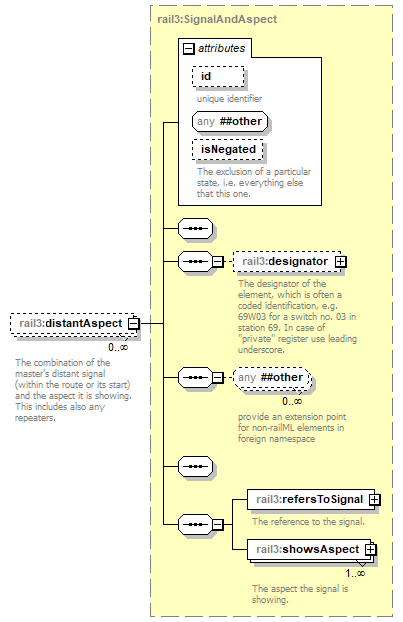 | ||||||||||||||||||||||
| namespace | https://www.railml.org/schemas/3.1 | ||||||||||||||||||||||
| type | rail3:SignalAndAspect | ||||||||||||||||||||||
| properties |
| ||||||||||||||||||||||
| children | rail3:designator rail3:refersToSignal rail3:showsAspect | ||||||||||||||||||||||
| attributes |
| ||||||||||||||||||||||
| annotation |
| ||||||||||||||||||||||
| source | <xs:element name="distantAspect" type="rail3:SignalAndAspect" minOccurs="0" maxOccurs="unbounded"> <xs:annotation> <xs:documentation>The combination of the master's distant signal (within the route or its start) and the aspect it is showing. This includes also any repeaters.</xs:documentation> </xs:annotation> </xs:element> |
element AspectRelation/signalsSpeedProfile
| diagram | 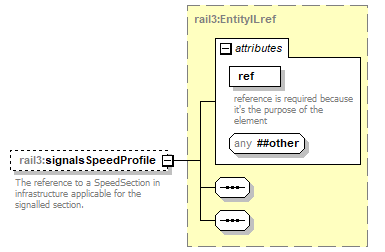 | ||||||||||||||
| namespace | https://www.railml.org/schemas/3.1 | ||||||||||||||
| type | rail3:EntityILref | ||||||||||||||
| properties |
| ||||||||||||||
| attributes |
| ||||||||||||||
| annotation |
| ||||||||||||||
| source | <xs:element name="signalsSpeedProfile" type="rail3:EntityILref" minOccurs="0" maxOccurs="1"> <xs:annotation> <xs:documentation>The reference to a SpeedSection in infrastructure applicable for the signalled section.</xs:documentation> </xs:annotation> </xs:element> |
element AspectRelation/appliesToRoute
| diagram | 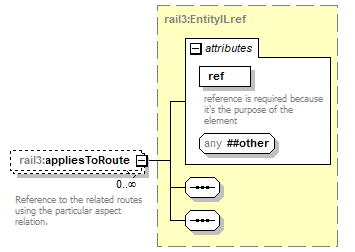 | ||||||||||||||
| namespace | https://www.railml.org/schemas/3.1 | ||||||||||||||
| type | rail3:EntityILref | ||||||||||||||
| properties |
| ||||||||||||||
| attributes |
| ||||||||||||||
| annotation |
| ||||||||||||||
| source | <xs:element name="appliesToRoute" type="rail3:EntityILref" minOccurs="0" maxOccurs="unbounded"> <xs:annotation> <xs:documentation>Reference to the related routes using the particular aspect relation.</xs:documentation> </xs:annotation> </xs:element> |
complexType AssetAndGivenState
| diagram | 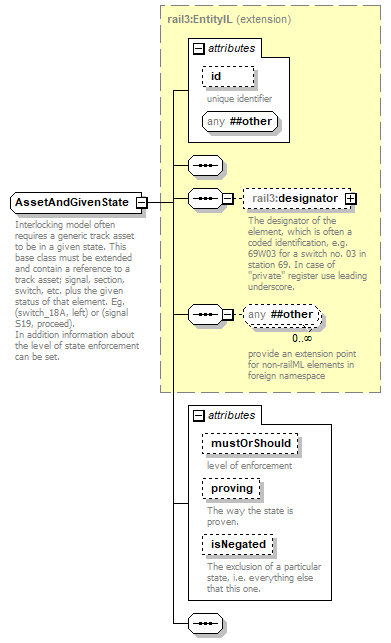 | ||||||||||||||||||||||||||||||||||||||
| namespace | https://www.railml.org/schemas/3.1 | ||||||||||||||||||||||||||||||||||||||
| type | extension of rail3:EntityIL | ||||||||||||||||||||||||||||||||||||||
| properties |
| ||||||||||||||||||||||||||||||||||||||
| children | rail3:designator | ||||||||||||||||||||||||||||||||||||||
| used by |
| ||||||||||||||||||||||||||||||||||||||
| attributes |
| ||||||||||||||||||||||||||||||||||||||
| annotation |
| ||||||||||||||||||||||||||||||||||||||
| source | <xs:complexType name="AssetAndGivenState" abstract="true"> <xs:annotation> <xs:documentation>Interlocking model often requires a generic track asset to be in a given state. This base class must be extended and contain a reference to a track asset; signal, section, switch, etc. plus the given status of that element. Eg. (switch_18A, left) or (signal S19, proceed). In addition information about the level of state enforcement can be set.</xs:documentation> </xs:annotation> <xs:complexContent> <xs:extension base="rail3:EntityIL"> <xs:sequence/> <xs:attribute name="mustOrShould" type="rail3:tMustOrShould" use="optional"> <xs:annotation> <xs:documentation>level of enforcement</xs:documentation> </xs:annotation> </xs:attribute> <xs:attribute name="proving" type="rail3:tProving" use="optional"> <xs:annotation> <xs:documentation>The way the state is proven.</xs:documentation> </xs:annotation> </xs:attribute> <xs:attribute name="isNegated" type="xs:boolean" use="optional"> <xs:annotation> <xs:documentation>The exclusion of a particular state, i.e. everything else that this one.</xs:documentation> </xs:annotation> </xs:attribute> </xs:extension> </xs:complexContent> </xs:complexType> |
attribute AssetAndGivenState/@mustOrShould
| type | rail3:tMustOrShould | ||||||||||||
| properties |
| ||||||||||||
| facets |
| ||||||||||||
| annotation |
| ||||||||||||
| source | <xs:attribute name="mustOrShould" type="rail3:tMustOrShould" use="optional"> <xs:annotation> <xs:documentation>level of enforcement</xs:documentation> </xs:annotation> </xs:attribute> |
attribute AssetAndGivenState/@proving
| type | rail3:tProving | ||||||||||||
| properties |
| ||||||||||||
| facets |
| ||||||||||||
| annotation |
| ||||||||||||
| source | <xs:attribute name="proving" type="rail3:tProving" use="optional"> <xs:annotation> <xs:documentation>The way the state is proven.</xs:documentation> </xs:annotation> </xs:attribute> |
attribute AssetAndGivenState/@isNegated
| type | xs:boolean | ||
| properties |
| ||
| annotation |
| ||
| source | <xs:attribute name="isNegated" type="xs:boolean" use="optional"> <xs:annotation> <xs:documentation>The exclusion of a particular state, i.e. everything else that this one.</xs:documentation> </xs:annotation> </xs:attribute> |
complexType AssetAndState
| diagram | 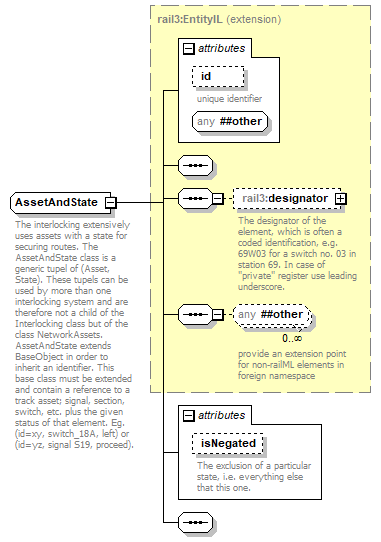 | ||||||||||||||||||||||
| namespace | https://www.railml.org/schemas/3.1 | ||||||||||||||||||||||
| type | extension of rail3:EntityIL | ||||||||||||||||||||||
| properties |
| ||||||||||||||||||||||
| children | rail3:designator | ||||||||||||||||||||||
| used by |
| ||||||||||||||||||||||
| attributes |
| ||||||||||||||||||||||
| annotation |
| ||||||||||||||||||||||
| source | <xs:complexType name="AssetAndState" abstract="true"> <xs:annotation> <xs:documentation>The interlocking extensively uses assets with a state for securing routes. The AssetAndState class is a generic tupel of (Asset, State). These tupels can be used by more than one interlocking system and are therefore not a child of the Interlocking class but of the class NetworkAssets. AssetAndState extends BaseObject in order to inherit an identifier. This base class must be extended and contain a reference to a track asset; signal, section, switch, etc. plus the given status of that element. Eg. (id=xy, switch_18A, left) or (id=yz, signal S19, proceed).</xs:documentation> </xs:annotation> <xs:complexContent> <xs:extension base="rail3:EntityIL"> <xs:sequence/> <xs:attribute name="isNegated" type="xs:boolean" use="optional"> <xs:annotation> <xs:documentation>The exclusion of a particular state, i.e. everything else that this one.</xs:documentation> </xs:annotation> </xs:attribute> </xs:extension> </xs:complexContent> </xs:complexType> |
attribute AssetAndState/@isNegated
| type | xs:boolean | ||
| properties |
| ||
| annotation |
| ||
| source | <xs:attribute name="isNegated" type="xs:boolean" use="optional"> <xs:annotation> <xs:documentation>The exclusion of a particular state, i.e. everything else that this one.</xs:documentation> </xs:annotation> </xs:attribute> |
complexType AssetsForIL
| diagram |  | ||||||||||||||
| namespace | https://www.railml.org/schemas/3.1 | ||||||||||||||
| type | extension of rail3:EntityIL | ||||||||||||||
| properties |
| ||||||||||||||
| children | rail3:designator rail3:tvdSections rail3:switchesIL rail3:derailersIL rail3:movableCrossings rail3:levelCrossingsIL rail3:keys rail3:keyLocksIL rail3:genericDetectors rail3:signalsIL rail3:atpDevices rail3:interfaces rail3:workZones rail3:localOperationAreas rail3:shuntingZones rail3:permissionZones rail3:routeReleaseGroupsAhead rail3:routeReleaseGroupsRear rail3:routes rail3:conflictingRoutes rail3:routeRelations rail3:combinedRoutes rail3:overlaps rail3:dangerPoints rail3:destinationPoints rail3:powerSuppliesIL | ||||||||||||||
| used by |
| ||||||||||||||
| attributes |
| ||||||||||||||
| annotation |
| ||||||||||||||
| source | <xs:complexType name="AssetsForIL"> <xs:annotation> <xs:documentation>Container for assets used for operation of interlockings and controllers. They represent a more functional/logical view onto the railway network but depending on the hardware as defined in infrastructure domain. Assets in the container are owned by the railway network rather than by individual interlocking systems.</xs:documentation> </xs:annotation> <xs:complexContent> <xs:extension base="rail3:EntityIL"> <xs:sequence> <xs:element name="tvdSections" type="rail3:TvdSections" minOccurs="0" maxOccurs="1"> <xs:annotation> <xs:documentation>contains all tvdSection elements</xs:documentation> </xs:annotation> </xs:element> <xs:element name="switchesIL" type="rail3:SwitchesIL" minOccurs="0" maxOccurs="1"> <xs:annotation> <xs:documentation>contains all MovableElements of type SwitchIL</xs:documentation> </xs:annotation> </xs:element> <xs:element name="derailersIL" type="rail3:DerailersIL" minOccurs="0" maxOccurs="1"> <xs:annotation> <xs:documentation>contains all MovableElements of type DerailerIL</xs:documentation> </xs:annotation> </xs:element> <xs:element name="movableCrossings" type="rail3:MovableCrossings" minOccurs="0" maxOccurs="1"> <xs:annotation> <xs:documentation>contains all MovableElements of type MovableCrossing</xs:documentation> </xs:annotation> </xs:element> <xs:element name="levelCrossingsIL" type="rail3:LevelCrossingsIL" minOccurs="0" maxOccurs="1"> <xs:annotation> <xs:documentation>contains all levelCrossingIL elements</xs:documentation> </xs:annotation> </xs:element> <xs:element name="keys" type="rail3:Keys" minOccurs="0" maxOccurs="1"> <xs:annotation> <xs:documentation>contains all key elements</xs:documentation> </xs:annotation> </xs:element> <xs:element name="keyLocksIL" type="rail3:KeyLocksIL" minOccurs="0" maxOccurs="1"> <xs:annotation> <xs:documentation>contains all keyLockIL elements</xs:documentation> </xs:annotation> </xs:element> <xs:element name="genericDetectors" type="rail3:GenericDetectors" minOccurs="0" maxOccurs="1"> <xs:annotation> <xs:documentation>contains all genericDetector elements</xs:documentation> </xs:annotation> </xs:element> <xs:element name="signalsIL" type="rail3:SignalsIL" minOccurs="0" maxOccurs="1"> <xs:annotation> <xs:documentation>contains all signalIL elements</xs:documentation> </xs:annotation> </xs:element> <xs:element name="atpDevices" type="rail3:ATPdevices" minOccurs="0" maxOccurs="1"> <xs:annotation> <xs:documentation>contains all atpDevice elements (not with railML3.1)</xs:documentation> </xs:annotation> </xs:element> <xs:element name="interfaces" type="rail3:Interfaces" minOccurs="0" maxOccurs="1"> <xs:annotation> <xs:documentation>contains all interface elements</xs:documentation> </xs:annotation> </xs:element> <xs:element name="workZones" type="rail3:WorkZones" minOccurs="0" maxOccurs="1"> <xs:annotation> <xs:documentation>contains all workZone elements</xs:documentation> </xs:annotation> </xs:element> <xs:element name="localOperationAreas" type="rail3:LocalOperationAreas" minOccurs="0" maxOccurs="1"> <xs:annotation> <xs:documentation>contains all localOperationArea elements</xs:documentation> </xs:annotation> </xs:element> <xs:element name="shuntingZones" type="rail3:ShuntingZones" minOccurs="0" maxOccurs="1"> <xs:annotation> <xs:documentation>contains all shuntingZone elements</xs:documentation> </xs:annotation> </xs:element> <xs:element name="permissionZones" type="rail3:PermissionZones" minOccurs="0" maxOccurs="1"> <xs:annotation> <xs:documentation>contains all permissionZone elements</xs:documentation> </xs:annotation> </xs:element> <xs:element name="routeReleaseGroupsAhead" type="rail3:RouteReleaseGroupsAhead" minOccurs="0" maxOccurs="1"> <xs:annotation> <xs:documentation>contains all routeReleaseGroupAhead elements</xs:documentation> </xs:annotation> </xs:element> <xs:element name="routeReleaseGroupsRear" type="rail3:RouteReleaseGroupsRear" minOccurs="0" maxOccurs="1"> <xs:annotation> <xs:documentation>contains all routeReleaseGroupRear elements</xs:documentation> </xs:annotation> </xs:element> <xs:element name="routes" type="rail3:Routes" minOccurs="0" maxOccurs="1"> <xs:annotation> <xs:documentation>contains all route elements</xs:documentation> </xs:annotation> </xs:element> <xs:element name="conflictingRoutes" type="rail3:ConflictingRoutes" minOccurs="0" maxOccurs="1"> <xs:annotation> <xs:documentation>contains all conflictingRoute elements</xs:documentation> </xs:annotation> </xs:element> <xs:element name="routeRelations" type="rail3:RouteRelations" minOccurs="0" maxOccurs="1"> <xs:annotation> <xs:documentation>contains all routeRelation elements</xs:documentation> </xs:annotation> </xs:element> <xs:element name="combinedRoutes" type="rail3:CombinedRoutes" minOccurs="0" maxOccurs="1"> <xs:annotation> <xs:documentation>contains all combinedRoute elements</xs:documentation> </xs:annotation> </xs:element> <xs:element name="overlaps" type="rail3:Overlaps" minOccurs="0" maxOccurs="1"> <xs:annotation> <xs:documentation>contains all overlap elements</xs:documentation> </xs:annotation> </xs:element> <xs:element name="dangerPoints" type="rail3:DangerPoints" minOccurs="0" maxOccurs="1"> <xs:annotation> <xs:documentation>contains all dangerPoints elements</xs:documentation> </xs:annotation> </xs:element> <xs:element name="destinationPoints" type="rail3:DestinationPoints" minOccurs="0" maxOccurs="1"> <xs:annotation> <xs:documentation>contains all destinationPoint elements</xs:documentation> </xs:annotation> </xs:element> <xs:element name="powerSuppliesIL" type="rail3:PowerSuppliesIL" minOccurs="0" maxOccurs="1"> <xs:annotation> <xs:documentation>contains all powerSupplyIL elements</xs:documentation> </xs:annotation> </xs:element> </xs:sequence> </xs:extension> </xs:complexContent> </xs:complexType> |
element AssetsForIL/tvdSections
| diagram | 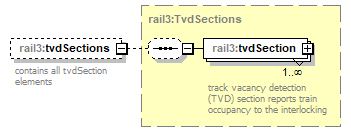 | ||||||
| namespace | https://www.railml.org/schemas/3.1 | ||||||
| type | rail3:TvdSections | ||||||
| properties |
| ||||||
| children | rail3:tvdSection | ||||||
| annotation |
| ||||||
| source | <xs:element name="tvdSections" type="rail3:TvdSections" minOccurs="0" maxOccurs="1"> <xs:annotation> <xs:documentation>contains all tvdSection elements</xs:documentation> </xs:annotation> </xs:element> |
element AssetsForIL/switchesIL
| diagram | 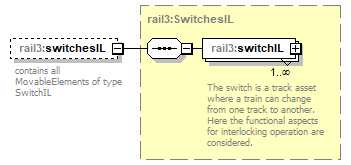 | ||||||
| namespace | https://www.railml.org/schemas/3.1 | ||||||
| type | rail3:SwitchesIL | ||||||
| properties |
| ||||||
| children | rail3:switchIL | ||||||
| annotation |
| ||||||
| source | <xs:element name="switchesIL" type="rail3:SwitchesIL" minOccurs="0" maxOccurs="1"> <xs:annotation> <xs:documentation>contains all MovableElements of type SwitchIL</xs:documentation> </xs:annotation> </xs:element> |
element AssetsForIL/derailersIL
| diagram | 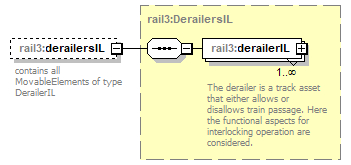 | ||||||
| namespace | https://www.railml.org/schemas/3.1 | ||||||
| type | rail3:DerailersIL | ||||||
| properties |
| ||||||
| children | rail3:derailerIL | ||||||
| annotation |
| ||||||
| source | <xs:element name="derailersIL" type="rail3:DerailersIL" minOccurs="0" maxOccurs="1"> <xs:annotation> <xs:documentation>contains all MovableElements of type DerailerIL</xs:documentation> </xs:annotation> </xs:element> |
element AssetsForIL/movableCrossings
| diagram | 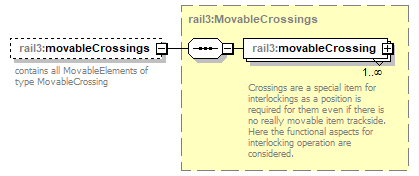 | ||||||
| namespace | https://www.railml.org/schemas/3.1 | ||||||
| type | rail3:MovableCrossings | ||||||
| properties |
| ||||||
| children | rail3:movableCrossing | ||||||
| annotation |
| ||||||
| source | <xs:element name="movableCrossings" type="rail3:MovableCrossings" minOccurs="0" maxOccurs="1"> <xs:annotation> <xs:documentation>contains all MovableElements of type MovableCrossing</xs:documentation> </xs:annotation> </xs:element> |
element AssetsForIL/levelCrossingsIL
| diagram | 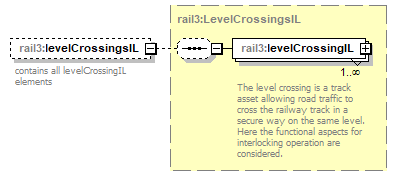 | ||||||
| namespace | https://www.railml.org/schemas/3.1 | ||||||
| type | rail3:LevelCrossingsIL | ||||||
| properties |
| ||||||
| children | rail3:levelCrossingIL | ||||||
| annotation |
| ||||||
| source | <xs:element name="levelCrossingsIL" type="rail3:LevelCrossingsIL" minOccurs="0" maxOccurs="1"> <xs:annotation> <xs:documentation>contains all levelCrossingIL elements</xs:documentation> </xs:annotation> </xs:element> |
element AssetsForIL/keys
| diagram | 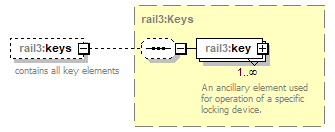 | ||||||
| namespace | https://www.railml.org/schemas/3.1 | ||||||
| type | rail3:Keys | ||||||
| properties |
| ||||||
| children | rail3:key | ||||||
| annotation |
| ||||||
| source | <xs:element name="keys" type="rail3:Keys" minOccurs="0" maxOccurs="1"> <xs:annotation> <xs:documentation>contains all key elements</xs:documentation> </xs:annotation> </xs:element> |
element AssetsForIL/keyLocksIL
| diagram | 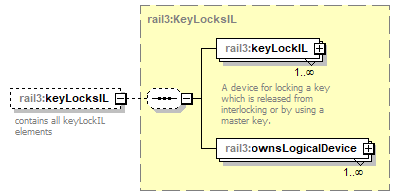 | ||||||
| namespace | https://www.railml.org/schemas/3.1 | ||||||
| type | rail3:KeyLocksIL | ||||||
| properties |
| ||||||
| children | rail3:keyLockIL rail3:ownsLogicalDevice | ||||||
| annotation |
| ||||||
| source | <xs:element name="keyLocksIL" type="rail3:KeyLocksIL" minOccurs="0" maxOccurs="1"> <xs:annotation> <xs:documentation>contains all keyLockIL elements</xs:documentation> </xs:annotation> </xs:element> |
element AssetsForIL/genericDetectors
| diagram |  | ||||||
| namespace | https://www.railml.org/schemas/3.1 | ||||||
| type | rail3:GenericDetectors | ||||||
| properties |
| ||||||
| children | rail3:genericDetector | ||||||
| annotation |
| ||||||
| source | <xs:element name="genericDetectors" type="rail3:GenericDetectors" minOccurs="0" maxOccurs="1"> <xs:annotation> <xs:documentation>contains all genericDetector elements</xs:documentation> </xs:annotation> </xs:element> |
element AssetsForIL/signalsIL
| diagram | 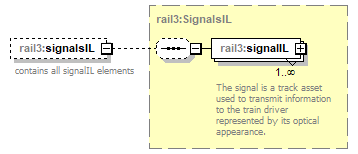 | ||||||
| namespace | https://www.railml.org/schemas/3.1 | ||||||
| type | rail3:SignalsIL | ||||||
| properties |
| ||||||
| children | rail3:signalIL | ||||||
| annotation |
| ||||||
| source | <xs:element name="signalsIL" type="rail3:SignalsIL" minOccurs="0" maxOccurs="1"> <xs:annotation> <xs:documentation>contains all signalIL elements</xs:documentation> </xs:annotation> </xs:element> |
element AssetsForIL/atpDevices
| diagram |  | ||||||
| namespace | https://www.railml.org/schemas/3.1 | ||||||
| type | rail3:ATPdevices | ||||||
| properties |
| ||||||
| children | rail3:atpDevice | ||||||
| annotation |
| ||||||
| source | <xs:element name="atpDevices" type="rail3:ATPdevices" minOccurs="0" maxOccurs="1"> <xs:annotation> <xs:documentation>contains all atpDevice elements (not with railML3.1)</xs:documentation> </xs:annotation> </xs:element> |
element AssetsForIL/interfaces
| diagram | 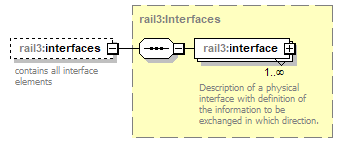 | ||||||
| namespace | https://www.railml.org/schemas/3.1 | ||||||
| type | rail3:Interfaces | ||||||
| properties |
| ||||||
| children | rail3:interface | ||||||
| annotation |
| ||||||
| source | <xs:element name="interfaces" type="rail3:Interfaces" minOccurs="0" maxOccurs="1"> <xs:annotation> <xs:documentation>contains all interface elements</xs:documentation> </xs:annotation> </xs:element> |
element AssetsForIL/workZones
| diagram | 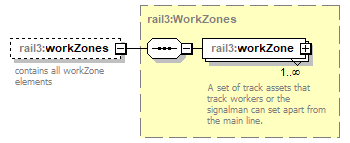 | ||||||
| namespace | https://www.railml.org/schemas/3.1 | ||||||
| type | rail3:WorkZones | ||||||
| properties |
| ||||||
| children | rail3:workZone | ||||||
| annotation |
| ||||||
| source | <xs:element name="workZones" type="rail3:WorkZones" minOccurs="0" maxOccurs="1"> <xs:annotation> <xs:documentation>contains all workZone elements</xs:documentation> </xs:annotation> </xs:element> |
element AssetsForIL/localOperationAreas
| diagram | 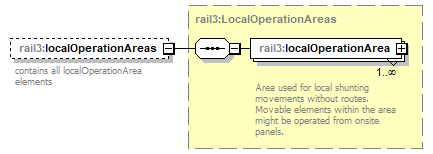 | ||||||
| namespace | https://www.railml.org/schemas/3.1 | ||||||
| type | rail3:LocalOperationAreas | ||||||
| properties |
| ||||||
| children | rail3:localOperationArea | ||||||
| annotation |
| ||||||
| source | <xs:element name="localOperationAreas" type="rail3:LocalOperationAreas" minOccurs="0" maxOccurs="1"> <xs:annotation> <xs:documentation>contains all localOperationArea elements</xs:documentation> </xs:annotation> </xs:element> |
element AssetsForIL/shuntingZones
| diagram |  | ||||||
| namespace | https://www.railml.org/schemas/3.1 | ||||||
| type | rail3:ShuntingZones | ||||||
| properties |
| ||||||
| children | rail3:shuntingZone | ||||||
| annotation |
| ||||||
| source | <xs:element name="shuntingZones" type="rail3:ShuntingZones" minOccurs="0" maxOccurs="1"> <xs:annotation> <xs:documentation>contains all shuntingZone elements</xs:documentation> </xs:annotation> </xs:element> |
element AssetsForIL/permissionZones
| diagram | 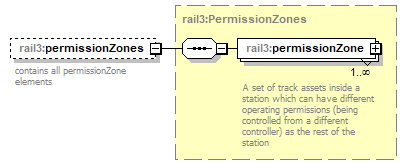 | ||||||
| namespace | https://www.railml.org/schemas/3.1 | ||||||
| type | rail3:PermissionZones | ||||||
| properties |
| ||||||
| children | rail3:permissionZone | ||||||
| annotation |
| ||||||
| source | <xs:element name="permissionZones" type="rail3:PermissionZones" minOccurs="0" maxOccurs="1"> <xs:annotation> <xs:documentation>contains all permissionZone elements</xs:documentation> </xs:annotation> </xs:element> |
element AssetsForIL/routeReleaseGroupsAhead
| diagram |  | ||||||
| namespace | https://www.railml.org/schemas/3.1 | ||||||
| type | rail3:RouteReleaseGroupsAhead | ||||||
| properties |
| ||||||
| children | rail3:routeReleaseGroupAhead | ||||||
| annotation |
| ||||||
| source | <xs:element name="routeReleaseGroupsAhead" type="rail3:RouteReleaseGroupsAhead" minOccurs="0" maxOccurs="1"> <xs:annotation> <xs:documentation>contains all routeReleaseGroupAhead elements</xs:documentation> </xs:annotation> </xs:element> |
element AssetsForIL/routeReleaseGroupsRear
| diagram |  | ||||||
| namespace | https://www.railml.org/schemas/3.1 | ||||||
| type | rail3:RouteReleaseGroupsRear | ||||||
| properties |
| ||||||
| children | rail3:routeReleaseGroupRear | ||||||
| annotation |
| ||||||
| source | <xs:element name="routeReleaseGroupsRear" type="rail3:RouteReleaseGroupsRear" minOccurs="0" maxOccurs="1"> <xs:annotation> <xs:documentation>contains all routeReleaseGroupRear elements</xs:documentation> </xs:annotation> </xs:element> |
element AssetsForIL/routes
| diagram | 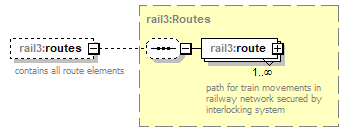 | ||||||
| namespace | https://www.railml.org/schemas/3.1 | ||||||
| type | rail3:Routes | ||||||
| properties |
| ||||||
| children | rail3:route | ||||||
| annotation |
| ||||||
| source | <xs:element name="routes" type="rail3:Routes" minOccurs="0" maxOccurs="1"> <xs:annotation> <xs:documentation>contains all route elements</xs:documentation> </xs:annotation> </xs:element> |
element AssetsForIL/conflictingRoutes
| diagram |  | ||||||
| namespace | https://www.railml.org/schemas/3.1 | ||||||
| type | rail3:ConflictingRoutes | ||||||
| properties |
| ||||||
| children | rail3:conflictingRoute | ||||||
| annotation |
| ||||||
| source | <xs:element name="conflictingRoutes" type="rail3:ConflictingRoutes" minOccurs="0" maxOccurs="1"> <xs:annotation> <xs:documentation>contains all conflictingRoute elements</xs:documentation> </xs:annotation> </xs:element> |
element AssetsForIL/routeRelations
| diagram | 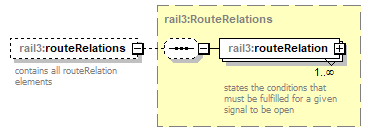 | ||||||
| namespace | https://www.railml.org/schemas/3.1 | ||||||
| type | rail3:RouteRelations | ||||||
| properties |
| ||||||
| children | rail3:routeRelation | ||||||
| annotation |
| ||||||
| source | <xs:element name="routeRelations" type="rail3:RouteRelations" minOccurs="0" maxOccurs="1"> <xs:annotation> <xs:documentation>contains all routeRelation elements</xs:documentation> </xs:annotation> </xs:element> |
element AssetsForIL/combinedRoutes
| diagram |  | ||||||
| namespace | https://www.railml.org/schemas/3.1 | ||||||
| type | rail3:CombinedRoutes | ||||||
| properties |
| ||||||
| children | rail3:combinedRoute | ||||||
| annotation |
| ||||||
| source | <xs:element name="combinedRoutes" type="rail3:CombinedRoutes" minOccurs="0" maxOccurs="1"> <xs:annotation> <xs:documentation>contains all combinedRoute elements</xs:documentation> </xs:annotation> </xs:element> |
element AssetsForIL/overlaps
| diagram | 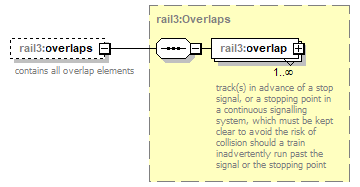 | ||||||
| namespace | https://www.railml.org/schemas/3.1 | ||||||
| type | rail3:Overlaps | ||||||
| properties |
| ||||||
| children | rail3:overlap | ||||||
| annotation |
| ||||||
| source | <xs:element name="overlaps" type="rail3:Overlaps" minOccurs="0" maxOccurs="1"> <xs:annotation> <xs:documentation>contains all overlap elements</xs:documentation> </xs:annotation> </xs:element> |
element AssetsForIL/dangerPoints
| diagram | 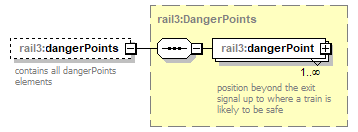 | ||||||
| namespace | https://www.railml.org/schemas/3.1 | ||||||
| type | rail3:DangerPoints | ||||||
| properties |
| ||||||
| children | rail3:dangerPoint | ||||||
| annotation |
| ||||||
| source | <xs:element name="dangerPoints" type="rail3:DangerPoints" minOccurs="0" maxOccurs="1"> <xs:annotation> <xs:documentation>contains all dangerPoints elements</xs:documentation> </xs:annotation> </xs:element> |
element AssetsForIL/destinationPoints
| diagram |  | ||||||
| namespace | https://www.railml.org/schemas/3.1 | ||||||
| type | rail3:DestinationPoints | ||||||
| properties |
| ||||||
| children | rail3:destinationPoint | ||||||
| annotation |
| ||||||
| source | <xs:element name="destinationPoints" type="rail3:DestinationPoints" minOccurs="0" maxOccurs="1"> <xs:annotation> <xs:documentation>contains all destinationPoint elements</xs:documentation> </xs:annotation> </xs:element> |
element AssetsForIL/powerSuppliesIL
| diagram |  | ||||||
| namespace | https://www.railml.org/schemas/3.1 | ||||||
| type | rail3:PowerSuppliesIL | ||||||
| properties |
| ||||||
| children | rail3:powerSupplyIL | ||||||
| annotation |
| ||||||
| source | <xs:element name="powerSuppliesIL" type="rail3:PowerSuppliesIL" minOccurs="0" maxOccurs="1"> <xs:annotation> <xs:documentation>contains all powerSupplyIL elements</xs:documentation> </xs:annotation> </xs:element> |
complexType ATPdevice
| diagram | 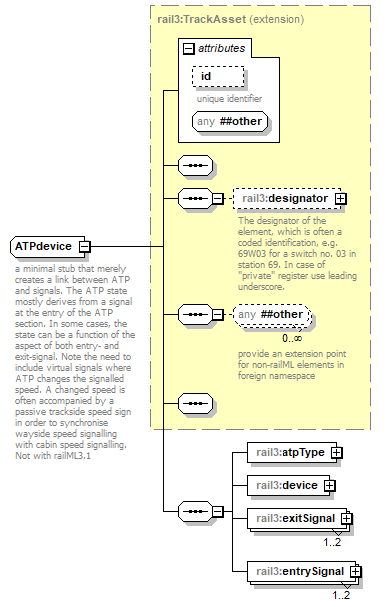 | ||||||||||||||
| namespace | https://www.railml.org/schemas/3.1 | ||||||||||||||
| type | extension of rail3:TrackAsset | ||||||||||||||
| properties |
| ||||||||||||||
| children | rail3:designator rail3:atpType rail3:device rail3:exitSignal rail3:entrySignal | ||||||||||||||
| used by |
| ||||||||||||||
| attributes |
| ||||||||||||||
| annotation |
| ||||||||||||||
| source | <xs:complexType name="ATPdevice" abstract="true"> <xs:annotation> <xs:documentation>a minimal stub that merely creates a link between ATP and signals. The ATP state mostly derives from a signal at the entry of the ATP section. In some cases, the state can be a function of the aspect of both entry- and exit-signal. Note the need to include virtual signals where ATP changes the signalled speed. A changed speed is often accompanied by a passive trackside speed sign in order to synchronise wayside speed signalling with cabin speed signalling. Not with railML3.1</xs:documentation> </xs:annotation> <xs:complexContent> <xs:extension base="rail3:TrackAsset"> <xs:sequence> <xs:element name="atpType" type="rail3:EntityILref" minOccurs="1" maxOccurs="1"/> <xs:element name="device" type="rail3:EntityILref" minOccurs="1" maxOccurs="1"/> <xs:element name="exitSignal" type="rail3:EntityILref" minOccurs="1" maxOccurs="2"/> <xs:element name="entrySignal" type="rail3:EntityILref" minOccurs="1" maxOccurs="2"/> </xs:sequence> </xs:extension> </xs:complexContent> </xs:complexType> |
element ATPdevice/atpType
| diagram | 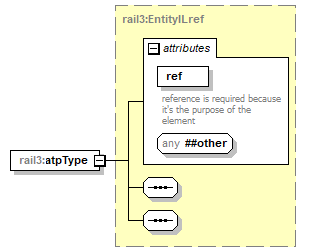 | ||||||||||||||
| namespace | https://www.railml.org/schemas/3.1 | ||||||||||||||
| type | rail3:EntityILref | ||||||||||||||
| properties |
| ||||||||||||||
| attributes |
| ||||||||||||||
| source | <xs:element name="atpType" type="rail3:EntityILref" minOccurs="1" maxOccurs="1"/> |
element ATPdevice/device
| diagram | 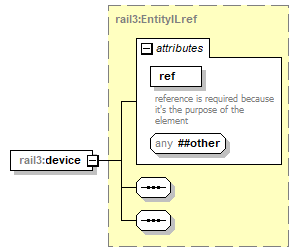 | ||||||||||||||
| namespace | https://www.railml.org/schemas/3.1 | ||||||||||||||
| type | rail3:EntityILref | ||||||||||||||
| properties |
| ||||||||||||||
| attributes |
| ||||||||||||||
| source | <xs:element name="device" type="rail3:EntityILref" minOccurs="1" maxOccurs="1"/> |
element ATPdevice/exitSignal
| diagram | 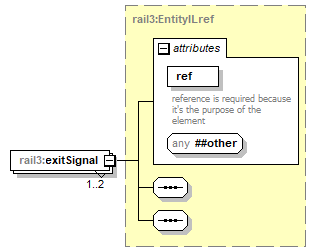 | ||||||||||||||
| namespace | https://www.railml.org/schemas/3.1 | ||||||||||||||
| type | rail3:EntityILref | ||||||||||||||
| properties |
| ||||||||||||||
| attributes |
| ||||||||||||||
| source | <xs:element name="exitSignal" type="rail3:EntityILref" minOccurs="1" maxOccurs="2"/> |
element ATPdevice/entrySignal
| diagram | 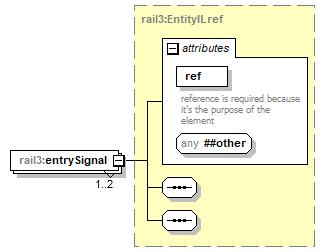 | ||||||||||||||
| namespace | https://www.railml.org/schemas/3.1 | ||||||||||||||
| type | rail3:EntityILref | ||||||||||||||
| properties |
| ||||||||||||||
| attributes |
| ||||||||||||||
| source | <xs:element name="entrySignal" type="rail3:EntityILref" minOccurs="1" maxOccurs="2"/> |
complexType ATPdevices
| diagram |  | ||
| namespace | https://www.railml.org/schemas/3.1 | ||
| children | rail3:atpDevice | ||
| used by |
| ||
| annotation |
| ||
| source | <xs:complexType name="ATPdevices"> <xs:annotation> <xs:documentation>container element for all ATPdevice elements (not with railML3.1)</xs:documentation> </xs:annotation> <xs:sequence minOccurs="0" maxOccurs="1"> <xs:element name="atpDevice" type="rail3:ATPdevice" minOccurs="1" maxOccurs="unbounded"> <xs:annotation> <xs:documentation>not with railML3.1</xs:documentation> </xs:annotation> </xs:element> </xs:sequence> </xs:complexType> |
element ATPdevices/atpDevice
| diagram | 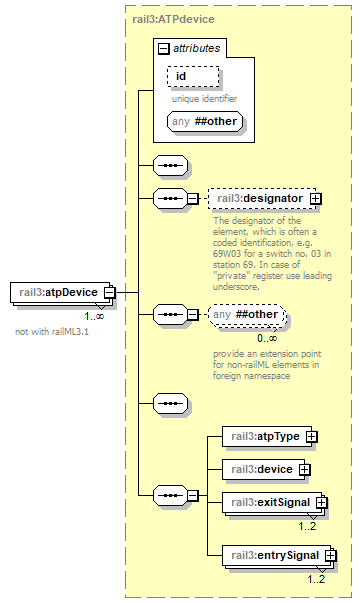 | ||||||||||||||
| namespace | https://www.railml.org/schemas/3.1 | ||||||||||||||
| type | rail3:ATPdevice | ||||||||||||||
| properties |
| ||||||||||||||
| children | rail3:designator rail3:atpType rail3:device rail3:exitSignal rail3:entrySignal | ||||||||||||||
| attributes |
| ||||||||||||||
| annotation |
| ||||||||||||||
| source | <xs:element name="atpDevice" type="rail3:ATPdevice" minOccurs="1" maxOccurs="unbounded"> <xs:annotation> <xs:documentation>not with railML3.1</xs:documentation> </xs:annotation> </xs:element> |
complexType CombinedRoute
| diagram | 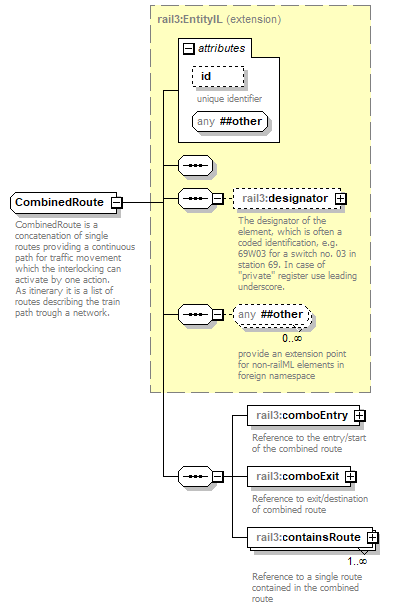 | ||||||||||||||
| namespace | https://www.railml.org/schemas/3.1 | ||||||||||||||
| type | extension of rail3:EntityIL | ||||||||||||||
| properties |
| ||||||||||||||
| children | rail3:designator rail3:comboEntry rail3:comboExit rail3:containsRoute | ||||||||||||||
| used by |
| ||||||||||||||
| attributes |
| ||||||||||||||
| annotation |
| ||||||||||||||
| source | <xs:complexType name="CombinedRoute"> <xs:annotation> <xs:documentation>CombinedRoute is a concatenation of single routes providing a continuous path for traffic movement which the interlocking can activate by one action. As itinerary it is a list of routes describing the train path trough a network.</xs:documentation> </xs:annotation> <xs:complexContent> <xs:extension base="rail3:EntityIL"> <xs:sequence> <xs:element name="comboEntry" type="rail3:EntityILref" minOccurs="1" maxOccurs="1"> <xs:annotation> <xs:documentation>Reference to the entry/start of the combined route</xs:documentation> </xs:annotation> </xs:element> <xs:element name="comboExit" type="rail3:EntityILref" minOccurs="1" maxOccurs="1"> <xs:annotation> <xs:documentation>Reference to exit/destination of combined route</xs:documentation> </xs:annotation> </xs:element> <xs:element name="containsRoute" type="rail3:EntityILref" minOccurs="1" maxOccurs="unbounded"> <xs:annotation> <xs:documentation>Reference to a single route contained in the combined route</xs:documentation> </xs:annotation> </xs:element> </xs:sequence> </xs:extension> </xs:complexContent> </xs:complexType> |
element CombinedRoute/comboEntry
| diagram | 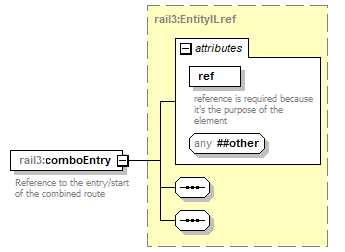 | ||||||||||||||
| namespace | https://www.railml.org/schemas/3.1 | ||||||||||||||
| type | rail3:EntityILref | ||||||||||||||
| properties |
| ||||||||||||||
| attributes |
| ||||||||||||||
| annotation |
| ||||||||||||||
| source | <xs:element name="comboEntry" type="rail3:EntityILref" minOccurs="1" maxOccurs="1"> <xs:annotation> <xs:documentation>Reference to the entry/start of the combined route</xs:documentation> </xs:annotation> </xs:element> |
element CombinedRoute/comboExit
| diagram | 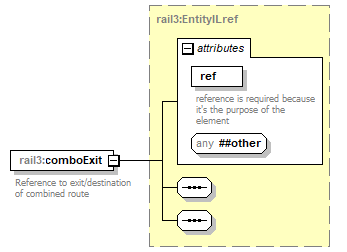 | ||||||||||||||
| namespace | https://www.railml.org/schemas/3.1 | ||||||||||||||
| type | rail3:EntityILref | ||||||||||||||
| properties |
| ||||||||||||||
| attributes |
| ||||||||||||||
| annotation |
| ||||||||||||||
| source | <xs:element name="comboExit" type="rail3:EntityILref" minOccurs="1" maxOccurs="1"> <xs:annotation> <xs:documentation>Reference to exit/destination of combined route</xs:documentation> </xs:annotation> </xs:element> |
element CombinedRoute/containsRoute
| diagram | 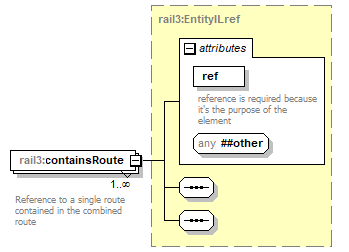 | ||||||||||||||
| namespace | https://www.railml.org/schemas/3.1 | ||||||||||||||
| type | rail3:EntityILref | ||||||||||||||
| properties |
| ||||||||||||||
| attributes |
| ||||||||||||||
| annotation |
| ||||||||||||||
| source | <xs:element name="containsRoute" type="rail3:EntityILref" minOccurs="1" maxOccurs="unbounded"> <xs:annotation> <xs:documentation>Reference to a single route contained in the combined route</xs:documentation> </xs:annotation> </xs:element> |
complexType CombinedRoutes
| diagram |  | ||
| namespace | https://www.railml.org/schemas/3.1 | ||
| children | rail3:combinedRoute | ||
| used by |
| ||
| annotation |
| ||
| source | <xs:complexType name="CombinedRoutes"> <xs:annotation> <xs:documentation>container element for all CombinedRoute elements</xs:documentation> </xs:annotation> <xs:sequence> <xs:element name="combinedRoute" type="rail3:CombinedRoute" minOccurs="1" maxOccurs="unbounded"> <xs:annotation> <xs:documentation>a concatenation of single routes providing a continuous path for traffic movement</xs:documentation> </xs:annotation> </xs:element> </xs:sequence> </xs:complexType> |
element CombinedRoutes/combinedRoute
| diagram | 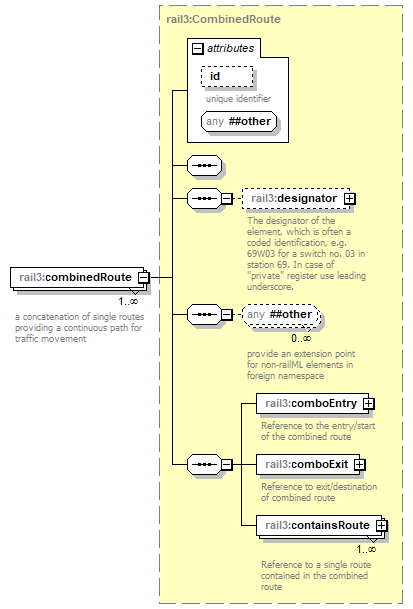 | ||||||||||||||
| namespace | https://www.railml.org/schemas/3.1 | ||||||||||||||
| type | rail3:CombinedRoute | ||||||||||||||
| properties |
| ||||||||||||||
| children | rail3:designator rail3:comboEntry rail3:comboExit rail3:containsRoute | ||||||||||||||
| attributes |
| ||||||||||||||
| annotation |
| ||||||||||||||
| source | <xs:element name="combinedRoute" type="rail3:CombinedRoute" minOccurs="1" maxOccurs="unbounded"> <xs:annotation> <xs:documentation>a concatenation of single routes providing a continuous path for traffic movement</xs:documentation> </xs:annotation> </xs:element> |
complexType Configuration
| diagram | 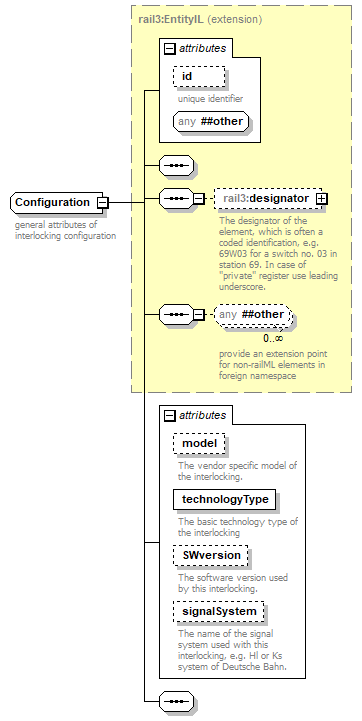 | ||||||||||||||||||||||||||||||||||||||||||||||
| namespace | https://www.railml.org/schemas/3.1 | ||||||||||||||||||||||||||||||||||||||||||||||
| type | extension of rail3:EntityIL | ||||||||||||||||||||||||||||||||||||||||||||||
| properties |
| ||||||||||||||||||||||||||||||||||||||||||||||
| children | rail3:designator | ||||||||||||||||||||||||||||||||||||||||||||||
| used by |
| ||||||||||||||||||||||||||||||||||||||||||||||
| attributes |
| ||||||||||||||||||||||||||||||||||||||||||||||
| annotation |
| ||||||||||||||||||||||||||||||||||||||||||||||
| source | <xs:complexType name="Configuration"> <xs:annotation> <xs:documentation>general attributes of interlocking configuration</xs:documentation> </xs:annotation> <xs:complexContent> <xs:extension base="rail3:EntityIL"> <xs:sequence/> <xs:attribute name="model" type="xs:string" use="optional"> <xs:annotation> <xs:documentation>The vendor specific model of the interlocking.</xs:documentation> </xs:annotation> </xs:attribute> <xs:attribute name="technologyType" type="rail3:tIxlTechnologyTypeListExt" use="required"> <xs:annotation> <xs:documentation>The basic technology type of the interlocking</xs:documentation> </xs:annotation> </xs:attribute> <xs:attribute name="SWversion" type="xs:string" use="optional"> <xs:annotation> <xs:documentation>The software version used by this interlocking.</xs:documentation> </xs:annotation> </xs:attribute> <xs:attribute name="signalSystem" type="xs:string" use="optional"> <xs:annotation> <xs:documentation>The name of the signal system used with this interlocking, e.g. Hl or Ks system of Deutsche Bahn.</xs:documentation> </xs:annotation> </xs:attribute> </xs:extension> </xs:complexContent> </xs:complexType> |
attribute Configuration/@model
| type | xs:string | ||
| properties |
| ||
| annotation |
| ||
| source | <xs:attribute name="model" type="xs:string" use="optional"> <xs:annotation> <xs:documentation>The vendor specific model of the interlocking.</xs:documentation> </xs:annotation> </xs:attribute> |
attribute Configuration/@technologyType
| type | rail3:tIxlTechnologyTypeListExt | ||
| properties |
| ||
| annotation |
| ||
| source | <xs:attribute name="technologyType" type="rail3:tIxlTechnologyTypeListExt" use="required"> <xs:annotation> <xs:documentation>The basic technology type of the interlocking</xs:documentation> </xs:annotation> </xs:attribute> |
attribute Configuration/@SWversion
| type | xs:string | ||
| properties |
| ||
| annotation |
| ||
| source | <xs:attribute name="SWversion" type="xs:string" use="optional"> <xs:annotation> <xs:documentation>The software version used by this interlocking.</xs:documentation> </xs:annotation> </xs:attribute> |
attribute Configuration/@signalSystem
| type | xs:string | ||
| properties |
| ||
| annotation |
| ||
| source | <xs:attribute name="signalSystem" type="xs:string" use="optional"> <xs:annotation> <xs:documentation>The name of the signal system used with this interlocking, e.g. Hl or Ks system of Deutsche Bahn.</xs:documentation> </xs:annotation> </xs:attribute> |
complexType ConflictingRoute
| diagram | 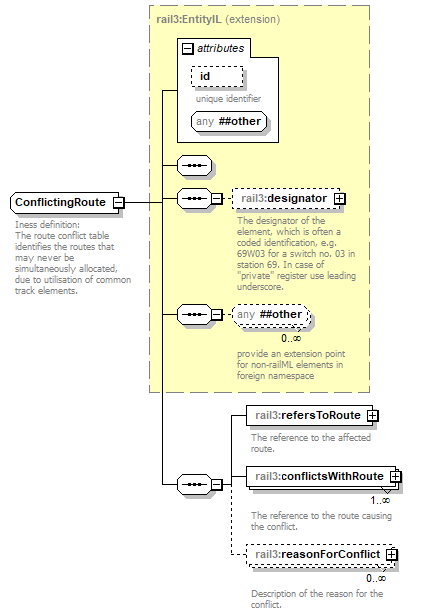 | ||||||||||||||
| namespace | https://www.railml.org/schemas/3.1 | ||||||||||||||
| type | extension of rail3:EntityIL | ||||||||||||||
| properties |
| ||||||||||||||
| children | rail3:designator rail3:refersToRoute rail3:conflictsWithRoute rail3:reasonForConflict | ||||||||||||||
| used by |
| ||||||||||||||
| attributes |
| ||||||||||||||
| annotation |
| ||||||||||||||
| source | <xs:complexType name="ConflictingRoute"> <xs:annotation> <xs:documentation>Iness definition: The route conflict table identifies the routes that may never be simultaneously allocated, due to utilisation of common track elements.</xs:documentation> </xs:annotation> <xs:complexContent> <xs:extension base="rail3:EntityIL"> <xs:sequence> <xs:element name="refersToRoute" type="rail3:EntityILref" minOccurs="1" maxOccurs="1"> <xs:annotation> <xs:documentation>The reference to the affected route.</xs:documentation> </xs:annotation> </xs:element> <xs:element name="conflictsWithRoute" type="rail3:EntityILref" minOccurs="1" maxOccurs="unbounded"> <xs:annotation> <xs:documentation>The reference to the route causing the conflict.</xs:documentation> </xs:annotation> </xs:element> <xs:element name="reasonForConflict" type="rail3:ConflictReason" minOccurs="0" maxOccurs="unbounded"> <xs:annotation> <xs:documentation>Description of the reason for the conflict.</xs:documentation> </xs:annotation> </xs:element> </xs:sequence> </xs:extension> </xs:complexContent> </xs:complexType> |
element ConflictingRoute/refersToRoute
| diagram | 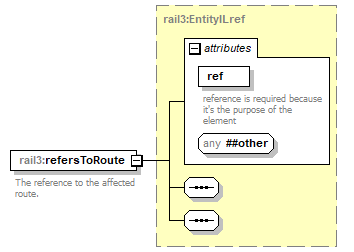 | ||||||||||||||
| namespace | https://www.railml.org/schemas/3.1 | ||||||||||||||
| type | rail3:EntityILref | ||||||||||||||
| properties |
| ||||||||||||||
| attributes |
| ||||||||||||||
| annotation |
| ||||||||||||||
| source | <xs:element name="refersToRoute" type="rail3:EntityILref" minOccurs="1" maxOccurs="1"> <xs:annotation> <xs:documentation>The reference to the affected route.</xs:documentation> </xs:annotation> </xs:element> |
element ConflictingRoute/conflictsWithRoute
| diagram | 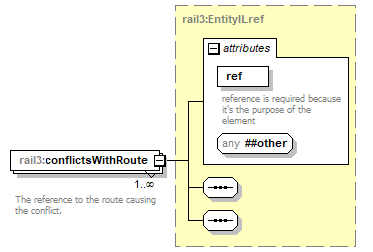 | ||||||||||||||
| namespace | https://www.railml.org/schemas/3.1 | ||||||||||||||
| type | rail3:EntityILref | ||||||||||||||
| properties |
| ||||||||||||||
| attributes |
| ||||||||||||||
| annotation |
| ||||||||||||||
| source | <xs:element name="conflictsWithRoute" type="rail3:EntityILref" minOccurs="1" maxOccurs="unbounded"> <xs:annotation> <xs:documentation>The reference to the route causing the conflict.</xs:documentation> </xs:annotation> </xs:element> |
element ConflictingRoute/reasonForConflict
| diagram | 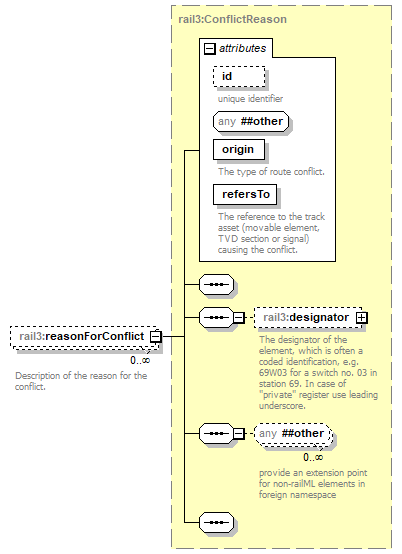 | ||||||||||||||||||||||||||||||
| namespace | https://www.railml.org/schemas/3.1 | ||||||||||||||||||||||||||||||
| type | rail3:ConflictReason | ||||||||||||||||||||||||||||||
| properties |
| ||||||||||||||||||||||||||||||
| children | rail3:designator | ||||||||||||||||||||||||||||||
| attributes |
| ||||||||||||||||||||||||||||||
| annotation |
| ||||||||||||||||||||||||||||||
| source | <xs:element name="reasonForConflict" type="rail3:ConflictReason" minOccurs="0" maxOccurs="unbounded"> <xs:annotation> <xs:documentation>Description of the reason for the conflict.</xs:documentation> </xs:annotation> </xs:element> |
complexType ConflictingRoutes
| diagram |  | ||
| namespace | https://www.railml.org/schemas/3.1 | ||
| children | rail3:conflictingRoute | ||
| used by |
| ||
| annotation |
| ||
| source | <xs:complexType name="ConflictingRoutes"> <xs:annotation> <xs:documentation>container element for all ConflictingRoute elements</xs:documentation> </xs:annotation> <xs:sequence minOccurs="0" maxOccurs="1"> <xs:element name="conflictingRoute" type="rail3:ConflictingRoute" minOccurs="1" maxOccurs="unbounded"> <xs:annotation> <xs:documentation>identifies the routes that may never be simultaneously allocated</xs:documentation> </xs:annotation> </xs:element> </xs:sequence> </xs:complexType> |
element ConflictingRoutes/conflictingRoute
| diagram | 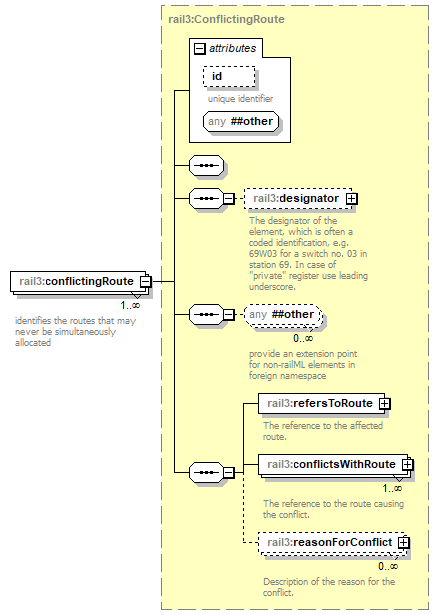 | ||||||||||||||
| namespace | https://www.railml.org/schemas/3.1 | ||||||||||||||
| type | rail3:ConflictingRoute | ||||||||||||||
| properties |
| ||||||||||||||
| children | rail3:designator rail3:refersToRoute rail3:conflictsWithRoute rail3:reasonForConflict | ||||||||||||||
| attributes |
| ||||||||||||||
| annotation |
| ||||||||||||||
| source | <xs:element name="conflictingRoute" type="rail3:ConflictingRoute" minOccurs="1" maxOccurs="unbounded"> <xs:annotation> <xs:documentation>identifies the routes that may never be simultaneously allocated</xs:documentation> </xs:annotation> </xs:element> |
complexType ConflictReason
| diagram | 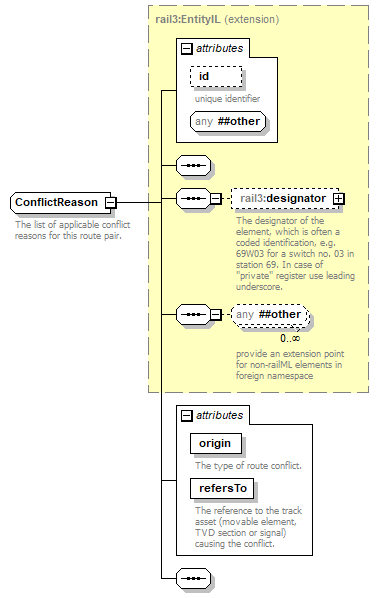 | ||||||||||||||||||||||||||||||
| namespace | https://www.railml.org/schemas/3.1 | ||||||||||||||||||||||||||||||
| type | extension of rail3:EntityIL | ||||||||||||||||||||||||||||||
| properties |
| ||||||||||||||||||||||||||||||
| children | rail3:designator | ||||||||||||||||||||||||||||||
| used by |
| ||||||||||||||||||||||||||||||
| attributes |
| ||||||||||||||||||||||||||||||
| annotation |
| ||||||||||||||||||||||||||||||
| source | <xs:complexType name="ConflictReason"> <xs:annotation> <xs:documentation>The list of applicable conflict reasons for this route pair.</xs:documentation> </xs:annotation> <xs:complexContent> <xs:extension base="rail3:EntityIL"> <xs:sequence/> <xs:attribute name="origin" type="rail3:tRouteConflictTypesExt" use="required"> <xs:annotation> <xs:documentation>The type of route conflict.</xs:documentation> </xs:annotation> </xs:attribute> <xs:attribute name="refersTo" type="rail3:tRef" use="required"> <xs:annotation> <xs:documentation>The reference to the track asset (movable element, TVD section or signal) causing the conflict.</xs:documentation> </xs:annotation> </xs:attribute> </xs:extension> </xs:complexContent> </xs:complexType> |
attribute ConflictReason/@origin
| type | rail3:tRouteConflictTypesExt | ||
| properties |
| ||
| annotation |
| ||
| source | <xs:attribute name="origin" type="rail3:tRouteConflictTypesExt" use="required"> <xs:annotation> <xs:documentation>The type of route conflict.</xs:documentation> </xs:annotation> </xs:attribute> |
attribute ConflictReason/@refersTo
| type | rail3:tRef | ||
| properties |
| ||
| annotation |
| ||
| source | <xs:attribute name="refersTo" type="rail3:tRef" use="required"> <xs:annotation> <xs:documentation>The reference to the track asset (movable element, TVD section or signal) causing the conflict.</xs:documentation> </xs:annotation> </xs:attribute> |
complexType ControlledAssets
| diagram | 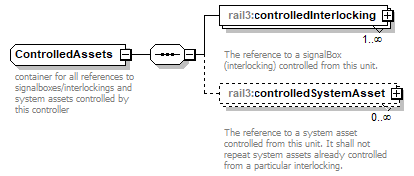 | ||
| namespace | https://www.railml.org/schemas/3.1 | ||
| children | rail3:controlledInterlocking rail3:controlledSystemAsset | ||
| used by |
| ||
| annotation |
| ||
| source | <xs:complexType name="ControlledAssets"> <xs:annotation> <xs:documentation>container for all references to signalboxes/interlockings and system assets controlled by this controller</xs:documentation> </xs:annotation> <xs:sequence> <xs:element name="controlledInterlocking" type="rail3:ControlledSignalBox" minOccurs="1" maxOccurs="unbounded"> <xs:annotation> <xs:documentation>The reference to a signalBox (interlocking) controlled from this unit.</xs:documentation> </xs:annotation> </xs:element> <xs:element name="controlledSystemAsset" type="rail3:SystemAssetConnectedToIL" minOccurs="0" maxOccurs="unbounded"> <xs:annotation> <xs:documentation>The reference to a system asset controlled from this unit. It shall not repeat system assets already controlled from a particular interlocking.</xs:documentation> </xs:annotation> </xs:element> </xs:sequence> </xs:complexType> |
element ControlledAssets/controlledInterlocking
| diagram | 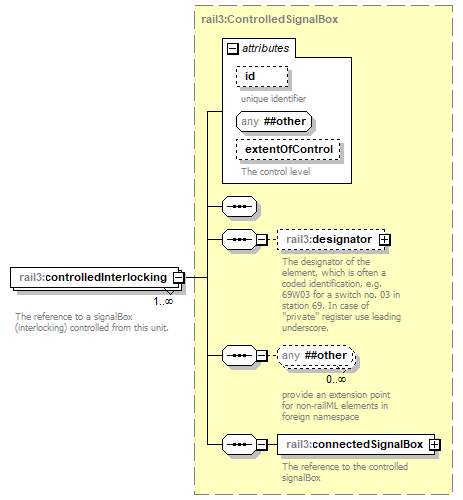 | ||||||||||||||||||||||
| namespace | https://www.railml.org/schemas/3.1 | ||||||||||||||||||||||
| type | rail3:ControlledSignalBox | ||||||||||||||||||||||
| properties |
| ||||||||||||||||||||||
| children | rail3:designator rail3:connectedSignalBox | ||||||||||||||||||||||
| attributes |
| ||||||||||||||||||||||
| annotation |
| ||||||||||||||||||||||
| source | <xs:element name="controlledInterlocking" type="rail3:ControlledSignalBox" minOccurs="1" maxOccurs="unbounded"> <xs:annotation> <xs:documentation>The reference to a signalBox (interlocking) controlled from this unit.</xs:documentation> </xs:annotation> </xs:element> |
element ControlledAssets/controlledSystemAsset
| diagram | 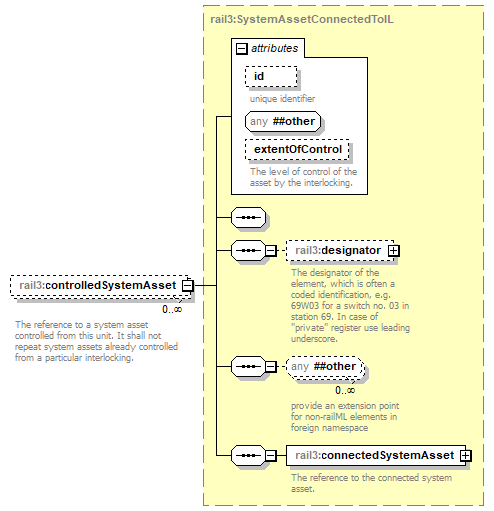 | ||||||||||||||||||||||
| namespace | https://www.railml.org/schemas/3.1 | ||||||||||||||||||||||
| type | rail3:SystemAssetConnectedToIL | ||||||||||||||||||||||
| properties |
| ||||||||||||||||||||||
| children | rail3:designator rail3:connectedSystemAsset | ||||||||||||||||||||||
| attributes |
| ||||||||||||||||||||||
| annotation |
| ||||||||||||||||||||||
| source | <xs:element name="controlledSystemAsset" type="rail3:SystemAssetConnectedToIL" minOccurs="0" maxOccurs="unbounded"> <xs:annotation> <xs:documentation>The reference to a system asset controlled from this unit. It shall not repeat system assets already controlled from a particular interlocking.</xs:documentation> </xs:annotation> </xs:element> |
complexType ControlledSignalBox
| diagram | 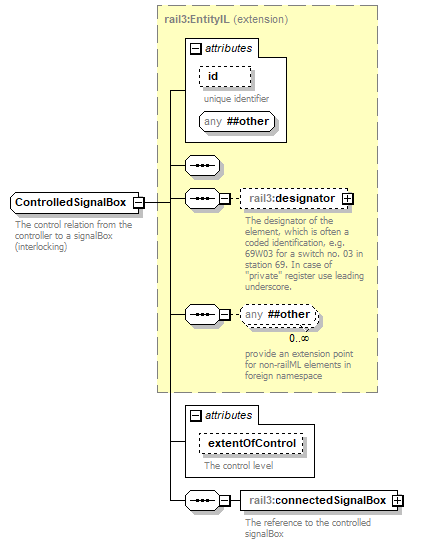 | ||||||||||||||||||||||
| namespace | https://www.railml.org/schemas/3.1 | ||||||||||||||||||||||
| type | extension of rail3:EntityIL | ||||||||||||||||||||||
| properties |
| ||||||||||||||||||||||
| children | rail3:designator rail3:connectedSignalBox | ||||||||||||||||||||||
| used by |
| ||||||||||||||||||||||
| attributes |
| ||||||||||||||||||||||
| annotation |
| ||||||||||||||||||||||
| source | <xs:complexType name="ControlledSignalBox"> <xs:annotation> <xs:documentation>The control relation from the controller to a signalBox (interlocking)</xs:documentation> </xs:annotation> <xs:complexContent> <xs:extension base="rail3:EntityIL"> <xs:sequence> <xs:element name="connectedSignalBox" type="rail3:EntityILref" minOccurs="1" maxOccurs="1"> <xs:annotation> <xs:documentation>The reference to the controlled signalBox</xs:documentation> </xs:annotation> </xs:element> </xs:sequence> <xs:attribute name="extentOfControl" type="rail3:tExtentOfControl" use="optional"> <xs:annotation> <xs:documentation>The control level</xs:documentation> </xs:annotation> </xs:attribute> </xs:extension> </xs:complexContent> </xs:complexType> |
attribute ControlledSignalBox/@extentOfControl
| type | rail3:tExtentOfControl | |||||||||||||||
| properties |
| |||||||||||||||
| facets |
| |||||||||||||||
| annotation |
| |||||||||||||||
| source | <xs:attribute name="extentOfControl" type="rail3:tExtentOfControl" use="optional"> <xs:annotation> <xs:documentation>The control level</xs:documentation> </xs:annotation> </xs:attribute> |
element ControlledSignalBox/connectedSignalBox
| diagram | 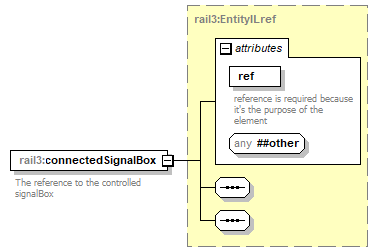 | ||||||||||||||
| namespace | https://www.railml.org/schemas/3.1 | ||||||||||||||
| type | rail3:EntityILref | ||||||||||||||
| properties |
| ||||||||||||||
| attributes |
| ||||||||||||||
| annotation |
| ||||||||||||||
| source | <xs:element name="connectedSignalBox" type="rail3:EntityILref" minOccurs="1" maxOccurs="1"> <xs:annotation> <xs:documentation>The reference to the controlled signalBox</xs:documentation> </xs:annotation> </xs:element> |
complexType Controller
| diagram | 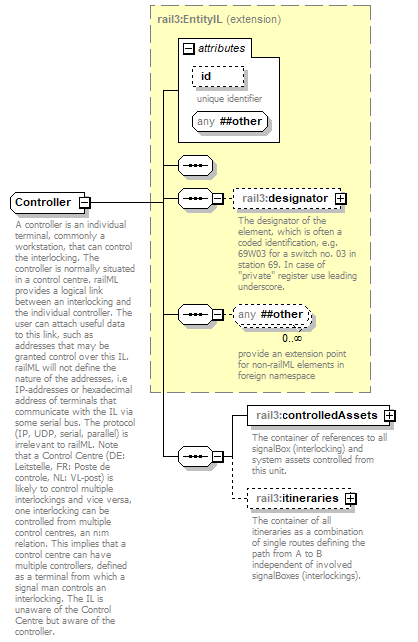 | ||||||||||||||
| namespace | https://www.railml.org/schemas/3.1 | ||||||||||||||
| type | extension of rail3:EntityIL | ||||||||||||||
| properties |
| ||||||||||||||
| children | rail3:designator rail3:controlledAssets rail3:itineraries | ||||||||||||||
| used by |
| ||||||||||||||
| attributes |
| ||||||||||||||
| annotation |
| ||||||||||||||
| source | <xs:complexType name="Controller"> <xs:annotation> <xs:documentation>A controller is an individual terminal, commonly a workstation, that can control the interlocking. The controller is normally situated in a control centre. railML provides a logical link between an interlocking and the individual controller. The user can attach useful data to this link, such as addresses that may be granted control over this IL. railML will not define the nature of the addresses, i.e IP-addresses or hexadecimal address of terminals that communicate with the IL via some serial bus. The protocol (IP, UDP, serial, parallel) is irrelevant to railML. Note that a Control Centre (DE: Leitstelle, FR: Poste de controle, NL: VL-post) is likely to control multiple interlockings and vice versa, one interlocking can be controlled from multiple control centres, an n:m relation. This implies that a control centre can have multiple controllers, defined as a terminal from which a signal man controls an interlocking. The IL is unaware of the Control Centre but aware of the controller.</xs:documentation> </xs:annotation> <xs:complexContent> <xs:extension base="rail3:EntityIL"> <xs:sequence> <xs:element name="controlledAssets" type="rail3:ControlledAssets" minOccurs="1" maxOccurs="1"> <xs:annotation> <xs:documentation>The container of references to all signalBox (interlocking) and system assets controlled from this unit.</xs:documentation> </xs:annotation> </xs:element> <xs:element name="itineraries" type="rail3:Itineraries" minOccurs="0" maxOccurs="1"> <xs:annotation> <xs:documentation>The container of all itineraries as a combination of single routes defining the path from A to B independent of involved signalBoxes (interlockings).</xs:documentation> </xs:annotation> </xs:element> </xs:sequence> </xs:extension> </xs:complexContent> </xs:complexType> |
element Controller/controlledAssets
| diagram | 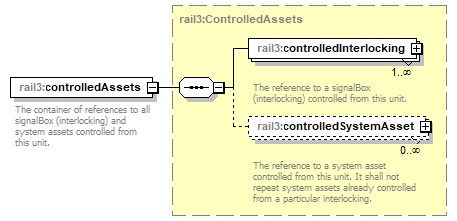 | ||
| namespace | https://www.railml.org/schemas/3.1 | ||
| type | rail3:ControlledAssets | ||
| properties |
| ||
| children | rail3:controlledInterlocking rail3:controlledSystemAsset | ||
| annotation |
| ||
| source | <xs:element name="controlledAssets" type="rail3:ControlledAssets" minOccurs="1" maxOccurs="1"> <xs:annotation> <xs:documentation>The container of references to all signalBox (interlocking) and system assets controlled from this unit.</xs:documentation> </xs:annotation> </xs:element> |
element Controller/itineraries
| diagram | 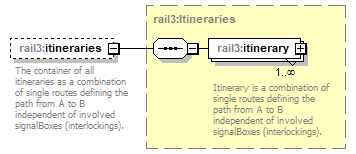 | ||||||
| namespace | https://www.railml.org/schemas/3.1 | ||||||
| type | rail3:Itineraries | ||||||
| properties |
| ||||||
| children | rail3:itinerary | ||||||
| annotation |
| ||||||
| source | <xs:element name="itineraries" type="rail3:Itineraries" minOccurs="0" maxOccurs="1"> <xs:annotation> <xs:documentation>The container of all itineraries as a combination of single routes defining the path from A to B independent of involved signalBoxes (interlockings).</xs:documentation> </xs:annotation> </xs:element> |
complexType Controllers
| diagram |  | ||
| namespace | https://www.railml.org/schemas/3.1 | ||
| children | rail3:controller | ||
| used by |
| ||
| annotation |
| ||
| source | <xs:complexType name="Controllers"> <xs:annotation> <xs:documentation>container element for all controller elements</xs:documentation> </xs:annotation> <xs:sequence minOccurs="0" maxOccurs="1"> <xs:element name="controller" type="rail3:Controller" minOccurs="1" maxOccurs="unbounded"> <xs:annotation> <xs:documentation>Container with reference to connected interlockings and system assets controlled by this operational terminal.</xs:documentation> </xs:annotation> </xs:element> </xs:sequence> </xs:complexType> |
element Controllers/controller
| diagram | 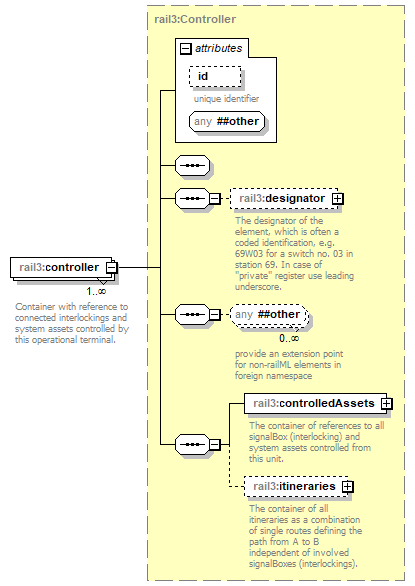 | ||||||||||||||
| namespace | https://www.railml.org/schemas/3.1 | ||||||||||||||
| type | rail3:Controller | ||||||||||||||
| properties |
| ||||||||||||||
| children | rail3:designator rail3:controlledAssets rail3:itineraries | ||||||||||||||
| attributes |
| ||||||||||||||
| annotation |
| ||||||||||||||
| source | <xs:element name="controller" type="rail3:Controller" minOccurs="1" maxOccurs="unbounded"> <xs:annotation> <xs:documentation>Container with reference to connected interlockings and system assets controlled by this operational terminal.</xs:documentation> </xs:annotation> </xs:element> |
complexType CrossingAndGivenPosition
| diagram | 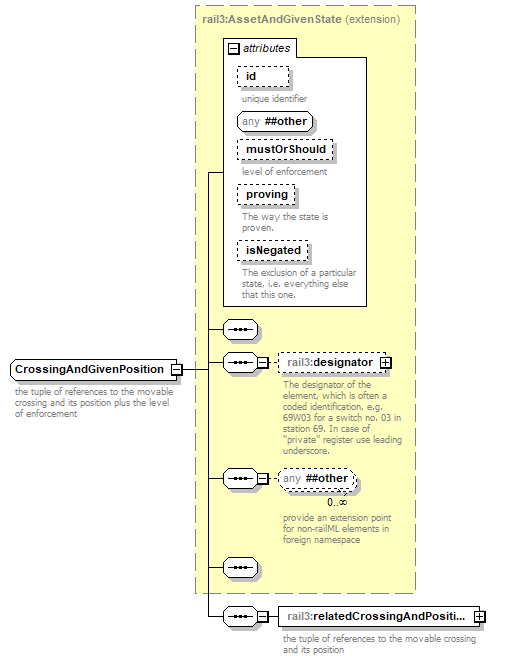 | ||||||||||||||||||||||||||||||||||||||
| namespace | https://www.railml.org/schemas/3.1 | ||||||||||||||||||||||||||||||||||||||
| type | extension of rail3:AssetAndGivenState | ||||||||||||||||||||||||||||||||||||||
| properties |
| ||||||||||||||||||||||||||||||||||||||
| children | rail3:designator rail3:relatedCrossingAndPosition | ||||||||||||||||||||||||||||||||||||||
| used by |
| ||||||||||||||||||||||||||||||||||||||
| attributes |
| ||||||||||||||||||||||||||||||||||||||
| annotation |
| ||||||||||||||||||||||||||||||||||||||
| source | <xs:complexType name="CrossingAndGivenPosition"> <xs:annotation> <xs:documentation>the tuple of references to the movable crossing and its position plus the level of enforcement</xs:documentation> </xs:annotation> <xs:complexContent> <xs:extension base="rail3:AssetAndGivenState"> <xs:sequence> <xs:element name="relatedCrossingAndPosition" type="rail3:CrossingAndPosition" minOccurs="1" maxOccurs="1"> <xs:annotation> <xs:documentation>the tuple of references to the movable crossing and its position</xs:documentation> </xs:annotation> </xs:element> </xs:sequence> </xs:extension> </xs:complexContent> </xs:complexType> |
element CrossingAndGivenPosition/relatedCrossingAndPosition
| diagram | 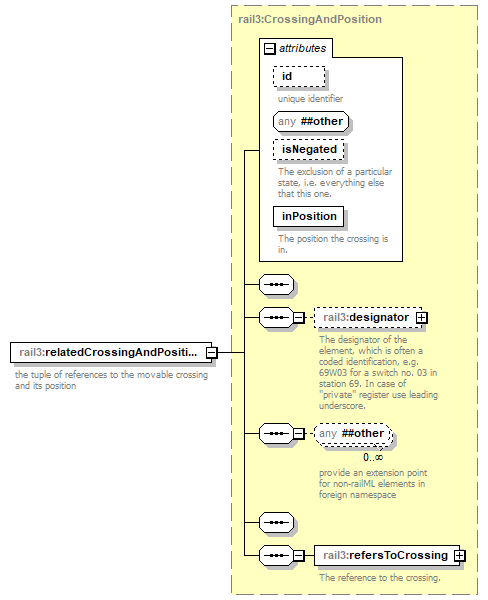 | ||||||||||||||||||||||||||||||
| namespace | https://www.railml.org/schemas/3.1 | ||||||||||||||||||||||||||||||
| type | rail3:CrossingAndPosition | ||||||||||||||||||||||||||||||
| properties |
| ||||||||||||||||||||||||||||||
| children | rail3:designator rail3:refersToCrossing | ||||||||||||||||||||||||||||||
| attributes |
| ||||||||||||||||||||||||||||||
| annotation |
| ||||||||||||||||||||||||||||||
| source | <xs:element name="relatedCrossingAndPosition" type="rail3:CrossingAndPosition" minOccurs="1" maxOccurs="1"> <xs:annotation> <xs:documentation>the tuple of references to the movable crossing and its position</xs:documentation> </xs:annotation> </xs:element> |
complexType CrossingAndPosition
| diagram | 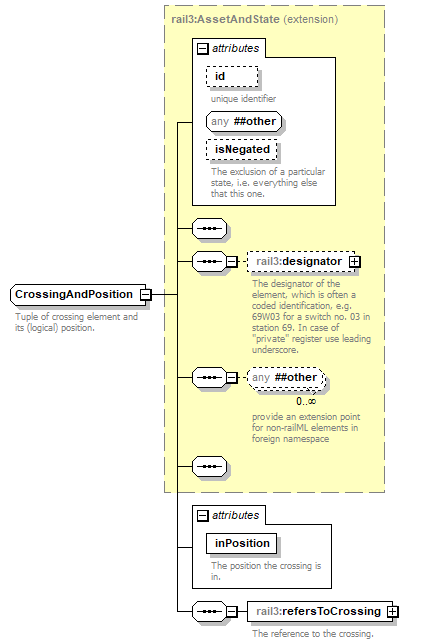 | ||||||||||||||||||||||||||||||
| namespace | https://www.railml.org/schemas/3.1 | ||||||||||||||||||||||||||||||
| type | extension of rail3:AssetAndState | ||||||||||||||||||||||||||||||
| properties |
| ||||||||||||||||||||||||||||||
| children | rail3:designator rail3:refersToCrossing | ||||||||||||||||||||||||||||||
| used by |
| ||||||||||||||||||||||||||||||
| attributes |
| ||||||||||||||||||||||||||||||
| annotation |
| ||||||||||||||||||||||||||||||
| source | <xs:complexType name="CrossingAndPosition"> <xs:annotation> <xs:documentation>Tuple of crossing element and its (logical) position.</xs:documentation> </xs:annotation> <xs:complexContent> <xs:extension base="rail3:AssetAndState"> <xs:sequence> <xs:element name="refersToCrossing" type="rail3:EntityILref" minOccurs="1" maxOccurs="1"> <xs:annotation> <xs:documentation>The reference to the crossing.</xs:documentation> </xs:annotation> </xs:element> </xs:sequence> <xs:attribute name="inPosition" type="rail3:tCrossingPosition" use="required"> <xs:annotation> <xs:documentation>The position the crossing is in.</xs:documentation> </xs:annotation> </xs:attribute> </xs:extension> </xs:complexContent> </xs:complexType> |
attribute CrossingAndPosition/@inPosition
| type | rail3:tCrossingPosition | |||||||||
| properties |
| |||||||||
| facets |
| |||||||||
| annotation |
| |||||||||
| source | <xs:attribute name="inPosition" type="rail3:tCrossingPosition" use="required"> <xs:annotation> <xs:documentation>The position the crossing is in.</xs:documentation> </xs:annotation> </xs:attribute> |
element CrossingAndPosition/refersToCrossing
| diagram | 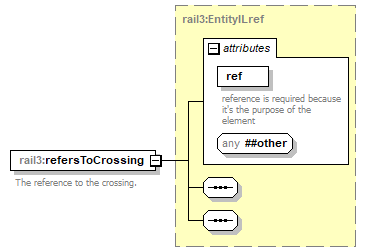 | ||||||||||||||
| namespace | https://www.railml.org/schemas/3.1 | ||||||||||||||
| type | rail3:EntityILref | ||||||||||||||
| properties |
| ||||||||||||||
| attributes |
| ||||||||||||||
| annotation |
| ||||||||||||||
| source | <xs:element name="refersToCrossing" type="rail3:EntityILref" minOccurs="1" maxOccurs="1"> <xs:annotation> <xs:documentation>The reference to the crossing.</xs:documentation> </xs:annotation> </xs:element> |
complexType CrossingInPosition
| diagram | 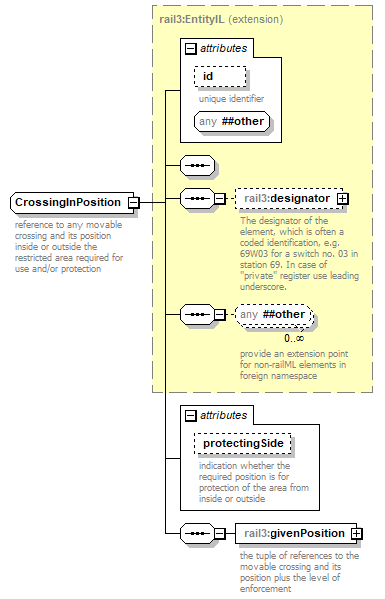 | ||||||||||||||||||||||
| namespace | https://www.railml.org/schemas/3.1 | ||||||||||||||||||||||
| type | extension of rail3:EntityIL | ||||||||||||||||||||||
| properties |
| ||||||||||||||||||||||
| children | rail3:designator rail3:givenPosition | ||||||||||||||||||||||
| used by |
| ||||||||||||||||||||||
| attributes |
| ||||||||||||||||||||||
| annotation |
| ||||||||||||||||||||||
| source | <xs:complexType name="CrossingInPosition"> <xs:annotation> <xs:documentation>reference to any movable crossing and its position inside or outside the restricted area required for use and/or protection</xs:documentation> </xs:annotation> <xs:complexContent> <xs:extension base="rail3:EntityIL"> <xs:sequence> <xs:element name="givenPosition" type="rail3:CrossingAndGivenPosition" minOccurs="1" maxOccurs="1"> <xs:annotation> <xs:documentation>the tuple of references to the movable crossing and its position plus the level of enforcement</xs:documentation> </xs:annotation> </xs:element> </xs:sequence> <xs:attribute name="protectingSide" type="rail3:tProtectingSideList" use="optional"> <xs:annotation> <xs:documentation>indication whether the required position is for protection of the area from inside or outside</xs:documentation> </xs:annotation> </xs:attribute> </xs:extension> </xs:complexContent> </xs:complexType> |
attribute CrossingInPosition/@protectingSide
| type | rail3:tProtectingSideList | ||||||||||||
| properties |
| ||||||||||||
| facets |
| ||||||||||||
| annotation |
| ||||||||||||
| source | <xs:attribute name="protectingSide" type="rail3:tProtectingSideList" use="optional"> <xs:annotation> <xs:documentation>indication whether the required position is for protection of the area from inside or outside</xs:documentation> </xs:annotation> </xs:attribute> |
element CrossingInPosition/givenPosition
| diagram | 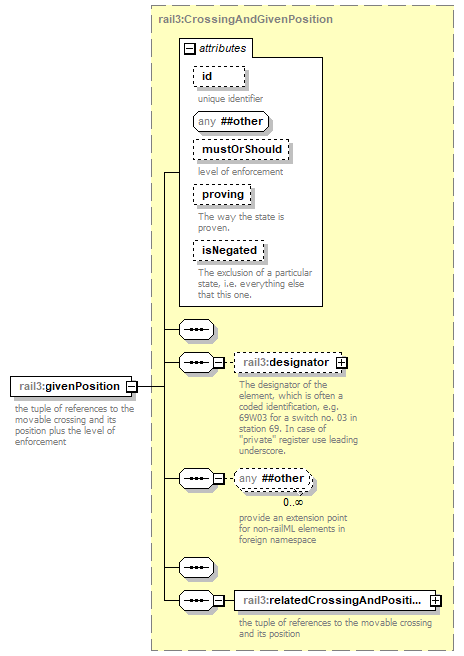 | ||||||||||||||||||||||||||||||||||||||
| namespace | https://www.railml.org/schemas/3.1 | ||||||||||||||||||||||||||||||||||||||
| type | rail3:CrossingAndGivenPosition | ||||||||||||||||||||||||||||||||||||||
| properties |
| ||||||||||||||||||||||||||||||||||||||
| children | rail3:designator rail3:relatedCrossingAndPosition | ||||||||||||||||||||||||||||||||||||||
| attributes |
| ||||||||||||||||||||||||||||||||||||||
| annotation |
| ||||||||||||||||||||||||||||||||||||||
| source | <xs:element name="givenPosition" type="rail3:CrossingAndGivenPosition" minOccurs="1" maxOccurs="1"> <xs:annotation> <xs:documentation>the tuple of references to the movable crossing and its position plus the level of enforcement</xs:documentation> </xs:annotation> </xs:element> |
complexType DangerPoint
| diagram | 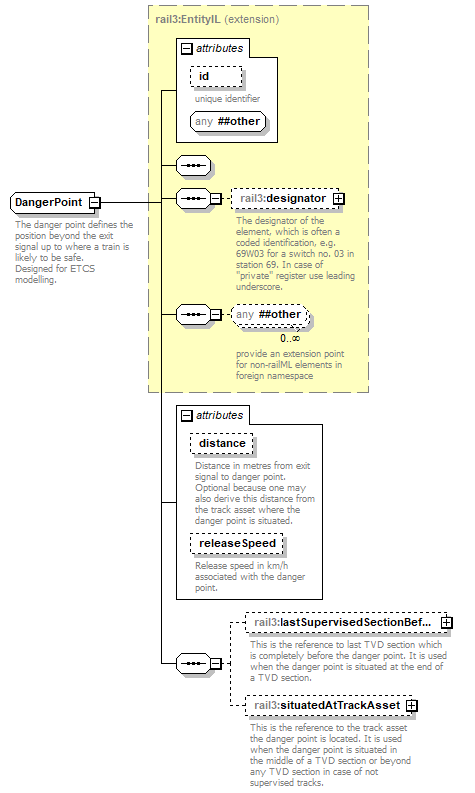 | ||||||||||||||||||||||||||||||
| namespace | https://www.railml.org/schemas/3.1 | ||||||||||||||||||||||||||||||
| type | extension of rail3:EntityIL | ||||||||||||||||||||||||||||||
| properties |
| ||||||||||||||||||||||||||||||
| children | rail3:designator rail3:lastSupervisedSectionBeforeDP rail3:situatedAtTrackAsset | ||||||||||||||||||||||||||||||
| used by |
| ||||||||||||||||||||||||||||||
| attributes |
| ||||||||||||||||||||||||||||||
| annotation |
| ||||||||||||||||||||||||||||||
| source | <xs:complexType name="DangerPoint"> <xs:annotation> <xs:documentation>The danger point defines the position beyond the exit signal up to where a train is likely to be safe. Designed for ETCS modelling.</xs:documentation> </xs:annotation> <xs:complexContent> <xs:extension base="rail3:EntityIL"> <xs:sequence> <xs:element name="lastSupervisedSectionBeforeDP" type="rail3:EntityILref" minOccurs="0" maxOccurs="1"> <xs:annotation> <xs:documentation>This is the reference to last TVD section which is completely before the danger point. It is used when the danger point is situated at the end of a TVD section.</xs:documentation> </xs:annotation> </xs:element> <xs:element name="situatedAtTrackAsset" type="rail3:EntityILref" minOccurs="0" maxOccurs="1"> <xs:annotation> <xs:documentation>This is the reference to the track asset the danger point is located. It is used when the danger point is situated in the middle of a TVD section or beyond any TVD section in case of not supervised tracks.</xs:documentation> </xs:annotation> </xs:element> </xs:sequence> <xs:attribute name="distance" type="rail3:tLengthM" use="optional"> <xs:annotation> <xs:documentation>Distance in metres from exit signal to danger point. Optional because one may also derive this distance from the track asset where the danger point is situated.</xs:documentation> </xs:annotation> </xs:attribute> <xs:attribute name="releaseSpeed" type="rail3:tSpeedKmPerHour" use="optional"> <xs:annotation> <xs:documentation>Release speed in km/h associated with the danger point.</xs:documentation> </xs:annotation> </xs:attribute> </xs:extension> </xs:complexContent> </xs:complexType> |
attribute DangerPoint/@distance
| type | rail3:tLengthM | ||
| properties |
| ||
| annotation |
| ||
| source | <xs:attribute name="distance" type="rail3:tLengthM" use="optional"> <xs:annotation> <xs:documentation>Distance in metres from exit signal to danger point. Optional because one may also derive this distance from the track asset where the danger point is situated.</xs:documentation> </xs:annotation> </xs:attribute> |
attribute DangerPoint/@releaseSpeed
| type | rail3:tSpeedKmPerHour | ||
| properties |
| ||
| annotation |
| ||
| source | <xs:attribute name="releaseSpeed" type="rail3:tSpeedKmPerHour" use="optional"> <xs:annotation> <xs:documentation>Release speed in km/h associated with the danger point.</xs:documentation> </xs:annotation> </xs:attribute> |
element DangerPoint/lastSupervisedSectionBeforeDP
| diagram | 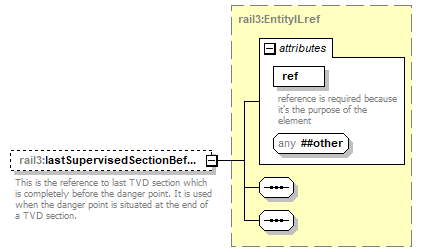 | ||||||||||||||
| namespace | https://www.railml.org/schemas/3.1 | ||||||||||||||
| type | rail3:EntityILref | ||||||||||||||
| properties |
| ||||||||||||||
| attributes |
| ||||||||||||||
| annotation |
| ||||||||||||||
| source | <xs:element name="lastSupervisedSectionBeforeDP" type="rail3:EntityILref" minOccurs="0" maxOccurs="1"> <xs:annotation> <xs:documentation>This is the reference to last TVD section which is completely before the danger point. It is used when the danger point is situated at the end of a TVD section.</xs:documentation> </xs:annotation> </xs:element> |
element DangerPoint/situatedAtTrackAsset
| diagram | 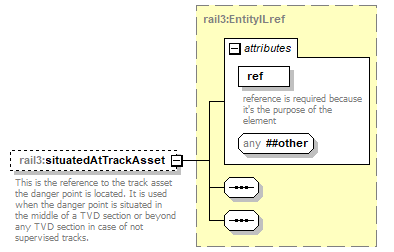 | ||||||||||||||
| namespace | https://www.railml.org/schemas/3.1 | ||||||||||||||
| type | rail3:EntityILref | ||||||||||||||
| properties |
| ||||||||||||||
| attributes |
| ||||||||||||||
| annotation |
| ||||||||||||||
| source | <xs:element name="situatedAtTrackAsset" type="rail3:EntityILref" minOccurs="0" maxOccurs="1"> <xs:annotation> <xs:documentation>This is the reference to the track asset the danger point is located. It is used when the danger point is situated in the middle of a TVD section or beyond any TVD section in case of not supervised tracks.</xs:documentation> </xs:annotation> </xs:element> |
complexType DangerPoints
| diagram |  | ||
| namespace | https://www.railml.org/schemas/3.1 | ||
| children | rail3:dangerPoint | ||
| used by |
| ||
| annotation |
| ||
| source | <xs:complexType name="DangerPoints"> <xs:annotation> <xs:documentation>container element for all DangerPoint elements</xs:documentation> </xs:annotation> <xs:sequence> <xs:element name="dangerPoint" type="rail3:DangerPoint" minOccurs="1" maxOccurs="unbounded"> <xs:annotation> <xs:documentation>position beyond the exit signal up to where a train is likely to be safe</xs:documentation> </xs:annotation> </xs:element> </xs:sequence> </xs:complexType> |
element DangerPoints/dangerPoint
| diagram | 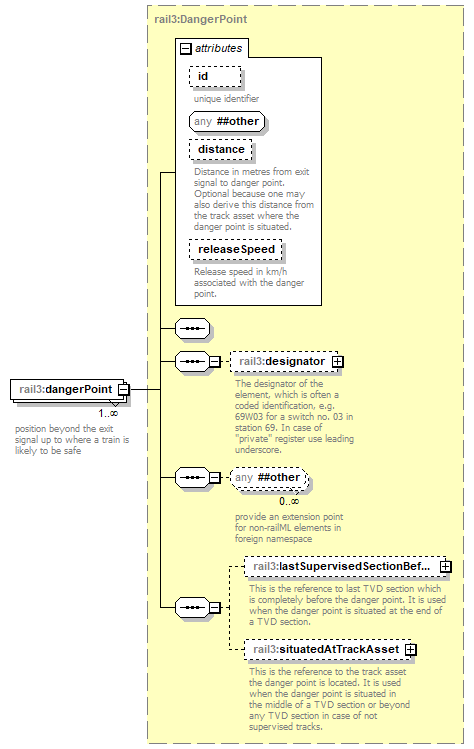 | ||||||||||||||||||||||||||||||
| namespace | https://www.railml.org/schemas/3.1 | ||||||||||||||||||||||||||||||
| type | rail3:DangerPoint | ||||||||||||||||||||||||||||||
| properties |
| ||||||||||||||||||||||||||||||
| children | rail3:designator rail3:lastSupervisedSectionBeforeDP rail3:situatedAtTrackAsset | ||||||||||||||||||||||||||||||
| attributes |
| ||||||||||||||||||||||||||||||
| annotation |
| ||||||||||||||||||||||||||||||
| source | <xs:element name="dangerPoint" type="rail3:DangerPoint" minOccurs="1" maxOccurs="unbounded"> <xs:annotation> <xs:documentation>position beyond the exit signal up to where a train is likely to be safe</xs:documentation> </xs:annotation> </xs:element> |
complexType DerailerAndGivenPosition
| diagram | 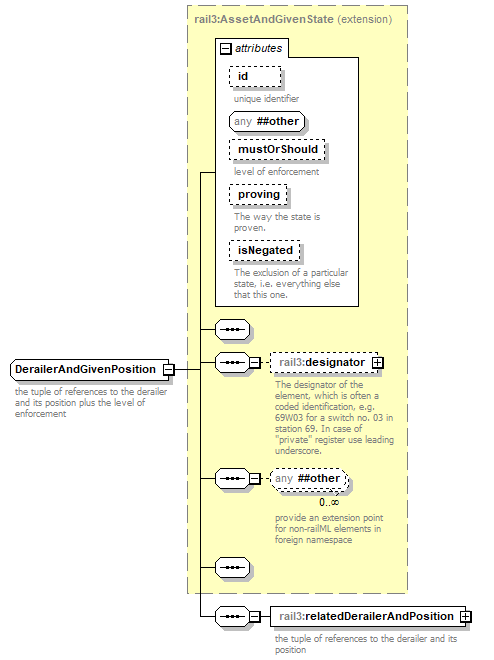 | ||||||||||||||||||||||||||||||||||||||
| namespace | https://www.railml.org/schemas/3.1 | ||||||||||||||||||||||||||||||||||||||
| type | extension of rail3:AssetAndGivenState | ||||||||||||||||||||||||||||||||||||||
| properties |
| ||||||||||||||||||||||||||||||||||||||
| children | rail3:designator rail3:relatedDerailerAndPosition | ||||||||||||||||||||||||||||||||||||||
| used by |
| ||||||||||||||||||||||||||||||||||||||
| attributes |
| ||||||||||||||||||||||||||||||||||||||
| annotation |
| ||||||||||||||||||||||||||||||||||||||
| source | <xs:complexType name="DerailerAndGivenPosition"> <xs:annotation> <xs:documentation>the tuple of references to the derailer and its position plus the level of enforcement</xs:documentation> </xs:annotation> <xs:complexContent> <xs:extension base="rail3:AssetAndGivenState"> <xs:sequence> <xs:element name="relatedDerailerAndPosition" type="rail3:DerailerAndPosition" minOccurs="1" maxOccurs="1"> <xs:annotation> <xs:documentation>the tuple of references to the derailer and its position</xs:documentation> </xs:annotation> </xs:element> </xs:sequence> </xs:extension> </xs:complexContent> </xs:complexType> |
element DerailerAndGivenPosition/relatedDerailerAndPosition
| diagram | 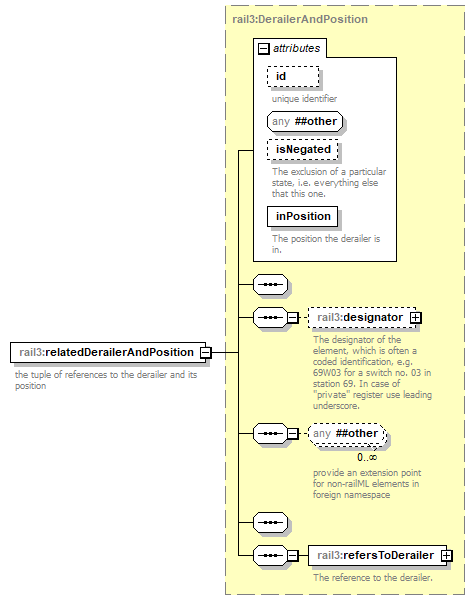 | ||||||||||||||||||||||||||||||
| namespace | https://www.railml.org/schemas/3.1 | ||||||||||||||||||||||||||||||
| type | rail3:DerailerAndPosition | ||||||||||||||||||||||||||||||
| properties |
| ||||||||||||||||||||||||||||||
| children | rail3:designator rail3:refersToDerailer | ||||||||||||||||||||||||||||||
| attributes |
| ||||||||||||||||||||||||||||||
| annotation |
| ||||||||||||||||||||||||||||||
| source | <xs:element name="relatedDerailerAndPosition" type="rail3:DerailerAndPosition" minOccurs="1" maxOccurs="1"> <xs:annotation> <xs:documentation>the tuple of references to the derailer and its position</xs:documentation> </xs:annotation> </xs:element> |
complexType DerailerAndPosition
| diagram | 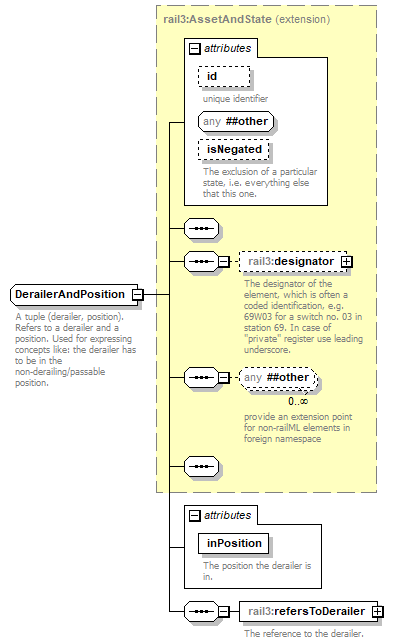 | ||||||||||||||||||||||||||||||
| namespace | https://www.railml.org/schemas/3.1 | ||||||||||||||||||||||||||||||
| type | extension of rail3:AssetAndState | ||||||||||||||||||||||||||||||
| properties |
| ||||||||||||||||||||||||||||||
| children | rail3:designator rail3:refersToDerailer | ||||||||||||||||||||||||||||||
| used by |
| ||||||||||||||||||||||||||||||
| attributes |
| ||||||||||||||||||||||||||||||
| annotation |
| ||||||||||||||||||||||||||||||
| source | <xs:complexType name="DerailerAndPosition"> <xs:annotation> <xs:documentation>A tuple (derailer, position). Refers to a derailer and a position. Used for expressing concepts like: the derailer has to be in the non-derailing/passable position.</xs:documentation> </xs:annotation> <xs:complexContent> <xs:extension base="rail3:AssetAndState"> <xs:sequence> <xs:element name="refersToDerailer" type="rail3:EntityILref" minOccurs="1" maxOccurs="1"> <xs:annotation> <xs:documentation>The reference to the derailer.</xs:documentation> </xs:annotation> </xs:element> </xs:sequence> <xs:attribute name="inPosition" type="rail3:tDerailingPosition" use="required"> <xs:annotation> <xs:documentation>The position the derailer is in.</xs:documentation> </xs:annotation> </xs:attribute> </xs:extension> </xs:complexContent> </xs:complexType> |
attribute DerailerAndPosition/@inPosition
| type | rail3:tDerailingPosition | |||||||||
| properties |
| |||||||||
| facets |
| |||||||||
| annotation |
| |||||||||
| source | <xs:attribute name="inPosition" type="rail3:tDerailingPosition" use="required"> <xs:annotation> <xs:documentation>The position the derailer is in.</xs:documentation> </xs:annotation> </xs:attribute> |
element DerailerAndPosition/refersToDerailer
| diagram | 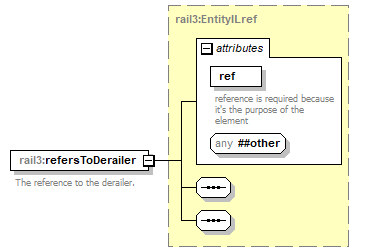 | ||||||||||||||
| namespace | https://www.railml.org/schemas/3.1 | ||||||||||||||
| type | rail3:EntityILref | ||||||||||||||
| properties |
| ||||||||||||||
| attributes |
| ||||||||||||||
| annotation |
| ||||||||||||||
| source | <xs:element name="refersToDerailer" type="rail3:EntityILref" minOccurs="1" maxOccurs="1"> <xs:annotation> <xs:documentation>The reference to the derailer.</xs:documentation> </xs:annotation> </xs:element> |
complexType DerailerIL
| diagram |  | ||||||||||||||||||||||||||||||||||||||||||||||||||||||||||||||||||||||
| namespace | https://www.railml.org/schemas/3.1 | ||||||||||||||||||||||||||||||||||||||||||||||||||||||||||||||||||||||
| type | extension of rail3:MovableElement | ||||||||||||||||||||||||||||||||||||||||||||||||||||||||||||||||||||||
| properties |
| ||||||||||||||||||||||||||||||||||||||||||||||||||||||||||||||||||||||
| children | rail3:designator rail3:refersTo rail3:hasGaugeClearanceMarker rail3:hasTvdSection rail3:connectedToPowerSupply rail3:relatedMovableElement | ||||||||||||||||||||||||||||||||||||||||||||||||||||||||||||||||||||||
| used by |
| ||||||||||||||||||||||||||||||||||||||||||||||||||||||||||||||||||||||
| attributes |
| ||||||||||||||||||||||||||||||||||||||||||||||||||||||||||||||||||||||
| annotation |
| ||||||||||||||||||||||||||||||||||||||||||||||||||||||||||||||||||||||
| source | <xs:complexType name="DerailerIL"> <xs:annotation> <xs:documentation>The derailer or trap switch is an infrastructure element that either allows or disallows train passage. A derailer typically operates on one rail only; trap switch (points) have similar effect using both rails to literally derail the train for protection purpose. Derailers that are locally and manually controlled are obviously not within the scope of an interlocking as the dispatcher will typically prevent trains from derailing by blocking signals leading towards such a device</xs:documentation> </xs:annotation> <xs:complexContent> <xs:extension base="rail3:MovableElement"> <xs:sequence/> <xs:attribute name="preferredPosition" type="rail3:tDerailingPosition" use="optional"> <xs:annotation> <xs:documentation>This is the preferred position of the derailer which it is switched to when not in use.</xs:documentation> </xs:annotation> </xs:attribute> </xs:extension> </xs:complexContent> </xs:complexType> |
attribute DerailerIL/@preferredPosition
| type | rail3:tDerailingPosition | |||||||||
| properties |
| |||||||||
| facets |
| |||||||||
| annotation |
| |||||||||
| source | <xs:attribute name="preferredPosition" type="rail3:tDerailingPosition" use="optional"> <xs:annotation> <xs:documentation>This is the preferred position of the derailer which it is switched to when not in use.</xs:documentation> </xs:annotation> </xs:attribute> |
complexType DerailerInPosition
| diagram | 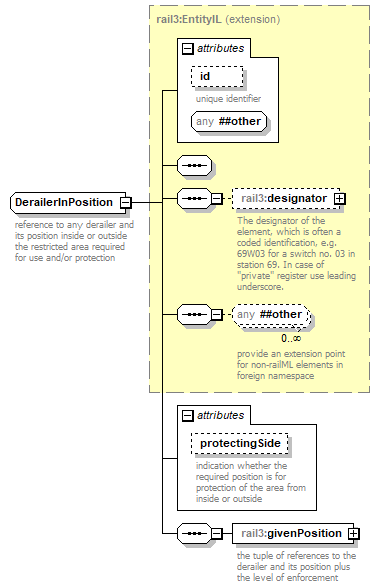 | ||||||||||||||||||||||
| namespace | https://www.railml.org/schemas/3.1 | ||||||||||||||||||||||
| type | extension of rail3:EntityIL | ||||||||||||||||||||||
| properties |
| ||||||||||||||||||||||
| children | rail3:designator rail3:givenPosition | ||||||||||||||||||||||
| used by |
| ||||||||||||||||||||||
| attributes |
| ||||||||||||||||||||||
| annotation |
| ||||||||||||||||||||||
| source | <xs:complexType name="DerailerInPosition"> <xs:annotation> <xs:documentation>reference to any derailer and its position inside or outside the restricted area required for use and/or protection</xs:documentation> </xs:annotation> <xs:complexContent> <xs:extension base="rail3:EntityIL"> <xs:sequence> <xs:element name="givenPosition" type="rail3:DerailerAndGivenPosition" minOccurs="1" maxOccurs="1"> <xs:annotation> <xs:documentation>the tuple of references to the derailer and its position plus the level of enforcement</xs:documentation> </xs:annotation> </xs:element> </xs:sequence> <xs:attribute name="protectingSide" type="rail3:tProtectingSideList" use="optional"> <xs:annotation> <xs:documentation>indication whether the required position is for protection of the area from inside or outside</xs:documentation> </xs:annotation> </xs:attribute> </xs:extension> </xs:complexContent> </xs:complexType> |
attribute DerailerInPosition/@protectingSide
| type | rail3:tProtectingSideList | ||||||||||||
| properties |
| ||||||||||||
| facets |
| ||||||||||||
| annotation |
| ||||||||||||
| source | <xs:attribute name="protectingSide" type="rail3:tProtectingSideList" use="optional"> <xs:annotation> <xs:documentation>indication whether the required position is for protection of the area from inside or outside</xs:documentation> </xs:annotation> </xs:attribute> |
element DerailerInPosition/givenPosition
| diagram | 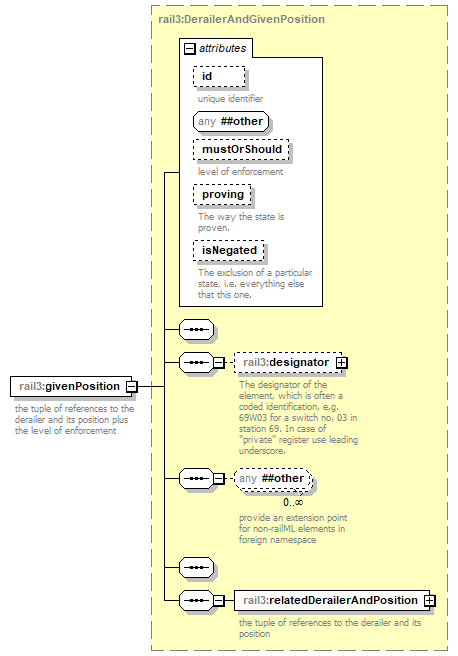 | ||||||||||||||||||||||||||||||||||||||
| namespace | https://www.railml.org/schemas/3.1 | ||||||||||||||||||||||||||||||||||||||
| type | rail3:DerailerAndGivenPosition | ||||||||||||||||||||||||||||||||||||||
| properties |
| ||||||||||||||||||||||||||||||||||||||
| children | rail3:designator rail3:relatedDerailerAndPosition | ||||||||||||||||||||||||||||||||||||||
| attributes |
| ||||||||||||||||||||||||||||||||||||||
| annotation |
| ||||||||||||||||||||||||||||||||||||||
| source | <xs:element name="givenPosition" type="rail3:DerailerAndGivenPosition" minOccurs="1" maxOccurs="1"> <xs:annotation> <xs:documentation>the tuple of references to the derailer and its position plus the level of enforcement</xs:documentation> </xs:annotation> </xs:element> |
complexType DerailersIL
| diagram | 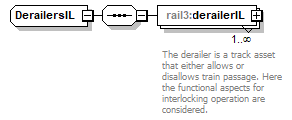 | ||
| namespace | https://www.railml.org/schemas/3.1 | ||
| children | rail3:derailerIL | ||
| used by |
| ||
| source | <xs:complexType name="DerailersIL"> <xs:sequence> <xs:element name="derailerIL" type="rail3:DerailerIL" minOccurs="1" maxOccurs="unbounded"> <xs:annotation> <xs:documentation>The derailer is a track asset that either allows or disallows train passage. Here the functional aspects for interlocking operation are considered.</xs:documentation> </xs:annotation> </xs:element> </xs:sequence> </xs:complexType> |
element DerailersIL/derailerIL
| diagram |  | ||||||||||||||||||||||||||||||||||||||||||||||||||||||||||||||||||||||
| namespace | https://www.railml.org/schemas/3.1 | ||||||||||||||||||||||||||||||||||||||||||||||||||||||||||||||||||||||
| type | rail3:DerailerIL | ||||||||||||||||||||||||||||||||||||||||||||||||||||||||||||||||||||||
| properties |
| ||||||||||||||||||||||||||||||||||||||||||||||||||||||||||||||||||||||
| children | rail3:designator rail3:refersTo rail3:hasGaugeClearanceMarker rail3:hasTvdSection rail3:connectedToPowerSupply rail3:relatedMovableElement | ||||||||||||||||||||||||||||||||||||||||||||||||||||||||||||||||||||||
| attributes |
| ||||||||||||||||||||||||||||||||||||||||||||||||||||||||||||||||||||||
| annotation |
| ||||||||||||||||||||||||||||||||||||||||||||||||||||||||||||||||||||||
| source | <xs:element name="derailerIL" type="rail3:DerailerIL" minOccurs="1" maxOccurs="unbounded"> <xs:annotation> <xs:documentation>The derailer is a track asset that either allows or disallows train passage. Here the functional aspects for interlocking operation are considered.</xs:documentation> </xs:annotation> </xs:element> |
complexType DestinationPoints
| diagram |  | ||
| namespace | https://www.railml.org/schemas/3.1 | ||
| children | rail3:destinationPoint | ||
| used by |
| ||
| annotation |
| ||
| source | <xs:complexType name="DestinationPoints"> <xs:annotation> <xs:documentation>container element for all DestinationPoint elements The definition of destination points which are mainly route exits. This allows definition independent of routes.</xs:documentation> </xs:annotation> <xs:sequence> <xs:element name="destinationPoint" type="rail3:RouteExit" minOccurs="1" maxOccurs="unbounded"> <xs:annotation> <xs:documentation>destination point of a secured running path</xs:documentation> </xs:annotation> </xs:element> </xs:sequence> </xs:complexType> |
element DestinationPoints/destinationPoint
| diagram | 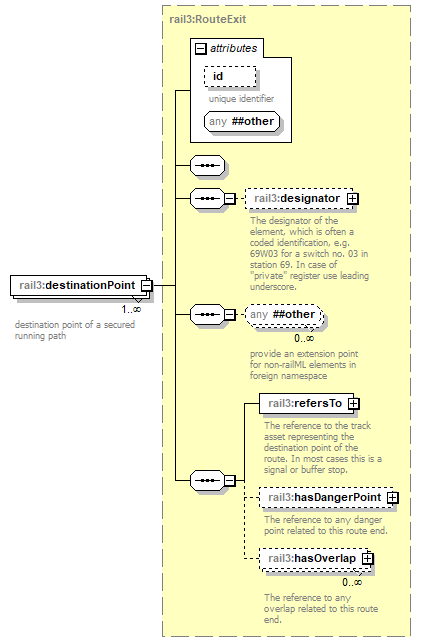 | ||||||||||||||
| namespace | https://www.railml.org/schemas/3.1 | ||||||||||||||
| type | rail3:RouteExit | ||||||||||||||
| properties |
| ||||||||||||||
| children | rail3:designator rail3:refersTo rail3:hasDangerPoint rail3:hasOverlap | ||||||||||||||
| attributes |
| ||||||||||||||
| annotation |
| ||||||||||||||
| source | <xs:element name="destinationPoint" type="rail3:RouteExit" minOccurs="1" maxOccurs="unbounded"> <xs:annotation> <xs:documentation>destination point of a secured running path</xs:documentation> </xs:annotation> </xs:element> |
complexType DetectorAndGivenState
| diagram | 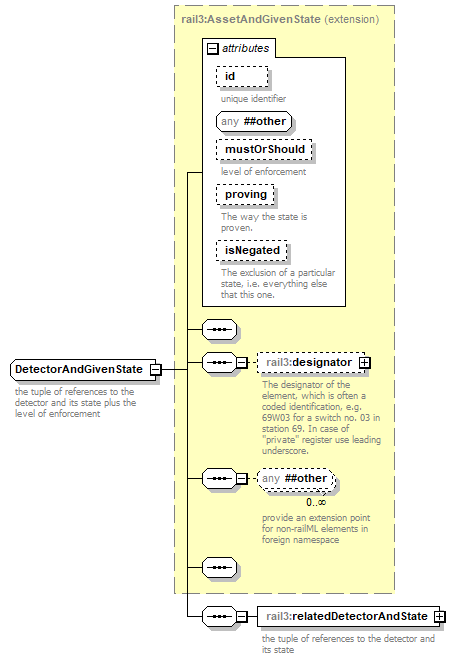 | ||||||||||||||||||||||||||||||||||||||
| namespace | https://www.railml.org/schemas/3.1 | ||||||||||||||||||||||||||||||||||||||
| type | extension of rail3:AssetAndGivenState | ||||||||||||||||||||||||||||||||||||||
| properties |
| ||||||||||||||||||||||||||||||||||||||
| children | rail3:designator rail3:relatedDetectorAndState | ||||||||||||||||||||||||||||||||||||||
| used by |
| ||||||||||||||||||||||||||||||||||||||
| attributes |
| ||||||||||||||||||||||||||||||||||||||
| annotation |
| ||||||||||||||||||||||||||||||||||||||
| source | <xs:complexType name="DetectorAndGivenState"> <xs:annotation> <xs:documentation>the tuple of references to the detector and its state plus the level of enforcement</xs:documentation> </xs:annotation> <xs:complexContent> <xs:extension base="rail3:AssetAndGivenState"> <xs:sequence> <xs:element name="relatedDetectorAndState" type="rail3:DetectorAndState" minOccurs="1" maxOccurs="1"> <xs:annotation> <xs:documentation>the tuple of references to the detector and its state</xs:documentation> </xs:annotation> </xs:element> </xs:sequence> </xs:extension> </xs:complexContent> </xs:complexType> |
element DetectorAndGivenState/relatedDetectorAndState
| diagram | 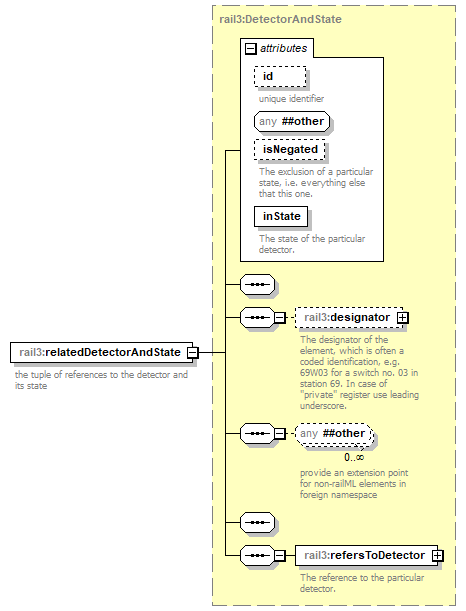 | ||||||||||||||||||||||||||||||
| namespace | https://www.railml.org/schemas/3.1 | ||||||||||||||||||||||||||||||
| type | rail3:DetectorAndState | ||||||||||||||||||||||||||||||
| properties |
| ||||||||||||||||||||||||||||||
| children | rail3:designator rail3:refersToDetector | ||||||||||||||||||||||||||||||
| attributes |
| ||||||||||||||||||||||||||||||
| annotation |
| ||||||||||||||||||||||||||||||
| source | <xs:element name="relatedDetectorAndState" type="rail3:DetectorAndState" minOccurs="1" maxOccurs="1"> <xs:annotation> <xs:documentation>the tuple of references to the detector and its state</xs:documentation> </xs:annotation> </xs:element> |
complexType DetectorAndState
| diagram | 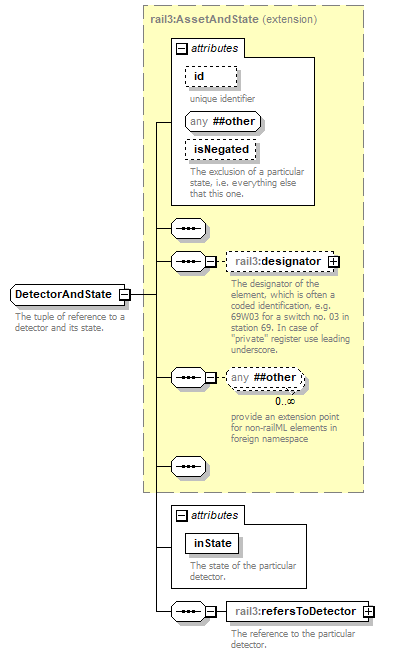 | ||||||||||||||||||||||||||||||
| namespace | https://www.railml.org/schemas/3.1 | ||||||||||||||||||||||||||||||
| type | extension of rail3:AssetAndState | ||||||||||||||||||||||||||||||
| properties |
| ||||||||||||||||||||||||||||||
| children | rail3:designator rail3:refersToDetector | ||||||||||||||||||||||||||||||
| used by |
| ||||||||||||||||||||||||||||||
| attributes |
| ||||||||||||||||||||||||||||||
| annotation |
| ||||||||||||||||||||||||||||||
| source | <xs:complexType name="DetectorAndState"> <xs:annotation> <xs:documentation>The tuple of reference to a detector and its state.</xs:documentation> </xs:annotation> <xs:complexContent> <xs:extension base="rail3:AssetAndState"> <xs:sequence> <xs:element name="refersToDetector" type="rail3:EntityILref" minOccurs="1" maxOccurs="1"> <xs:annotation> <xs:documentation>The reference to the particular detector.</xs:documentation> </xs:annotation> </xs:element> </xs:sequence> <xs:attribute name="inState" type="rail3:tDetectorStates" use="required"> <xs:annotation> <xs:documentation>The state of the particular detector.</xs:documentation> </xs:annotation> </xs:attribute> </xs:extension> </xs:complexContent> </xs:complexType> |
attribute DetectorAndState/@inState
| type | rail3:tDetectorStates | ||||||||||||
| properties |
| ||||||||||||
| facets |
| ||||||||||||
| annotation |
| ||||||||||||
| source | <xs:attribute name="inState" type="rail3:tDetectorStates" use="required"> <xs:annotation> <xs:documentation>The state of the particular detector.</xs:documentation> </xs:annotation> </xs:attribute> |
element DetectorAndState/refersToDetector
| diagram | 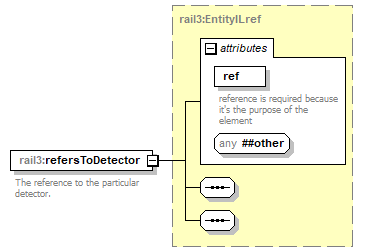 | ||||||||||||||
| namespace | https://www.railml.org/schemas/3.1 | ||||||||||||||
| type | rail3:EntityILref | ||||||||||||||
| properties |
| ||||||||||||||
| attributes |
| ||||||||||||||
| annotation |
| ||||||||||||||
| source | <xs:element name="refersToDetector" type="rail3:EntityILref" minOccurs="1" maxOccurs="1"> <xs:annotation> <xs:documentation>The reference to the particular detector.</xs:documentation> </xs:annotation> </xs:element> |
complexType DetectorInState
| diagram | 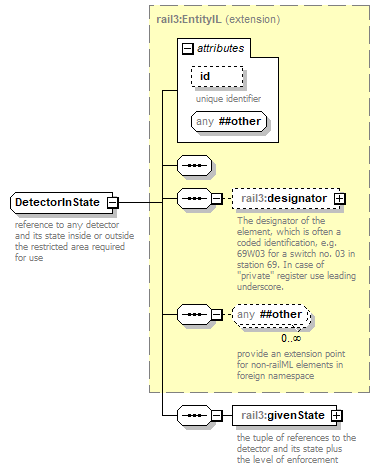 | ||||||||||||||
| namespace | https://www.railml.org/schemas/3.1 | ||||||||||||||
| type | extension of rail3:EntityIL | ||||||||||||||
| properties |
| ||||||||||||||
| children | rail3:designator rail3:givenState | ||||||||||||||
| used by |
| ||||||||||||||
| attributes |
| ||||||||||||||
| annotation |
| ||||||||||||||
| source | <xs:complexType name="DetectorInState"> <xs:annotation> <xs:documentation>reference to any detector and its state inside or outside the restricted area required for use</xs:documentation> </xs:annotation> <xs:complexContent> <xs:extension base="rail3:EntityIL"> <xs:sequence> <xs:element name="givenState" type="rail3:DetectorAndGivenState" minOccurs="1" maxOccurs="1"> <xs:annotation> <xs:documentation>the tuple of references to the detector and its state plus the level of enforcement</xs:documentation> </xs:annotation> </xs:element> </xs:sequence> </xs:extension> </xs:complexContent> </xs:complexType> |
element DetectorInState/givenState
| diagram | 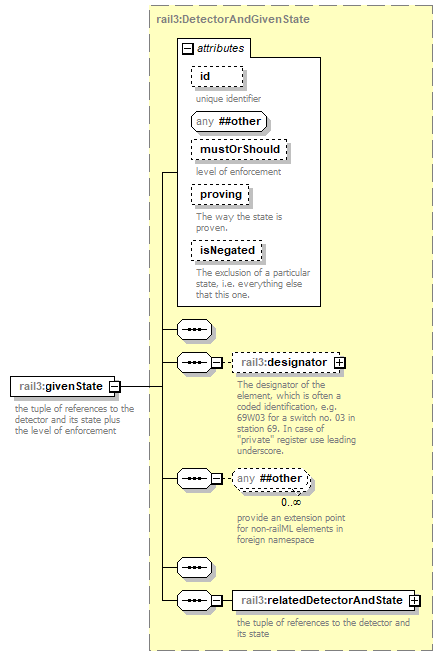 | ||||||||||||||||||||||||||||||||||||||
| namespace | https://www.railml.org/schemas/3.1 | ||||||||||||||||||||||||||||||||||||||
| type | rail3:DetectorAndGivenState | ||||||||||||||||||||||||||||||||||||||
| properties |
| ||||||||||||||||||||||||||||||||||||||
| children | rail3:designator rail3:relatedDetectorAndState | ||||||||||||||||||||||||||||||||||||||
| attributes |
| ||||||||||||||||||||||||||||||||||||||
| annotation |
| ||||||||||||||||||||||||||||||||||||||
| source | <xs:element name="givenState" type="rail3:DetectorAndGivenState" minOccurs="1" maxOccurs="1"> <xs:annotation> <xs:documentation>the tuple of references to the detector and its state plus the level of enforcement</xs:documentation> </xs:annotation> </xs:element> |
complexType DetectorTypes
| diagram | 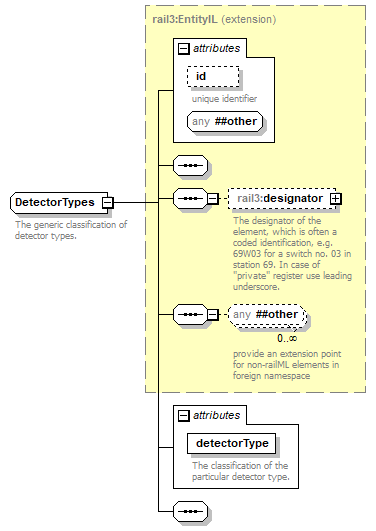 | ||||||||||||||||||||||
| namespace | https://www.railml.org/schemas/3.1 | ||||||||||||||||||||||
| type | extension of rail3:EntityIL | ||||||||||||||||||||||
| properties |
| ||||||||||||||||||||||
| children | rail3:designator | ||||||||||||||||||||||
| used by |
| ||||||||||||||||||||||
| attributes |
| ||||||||||||||||||||||
| annotation |
| ||||||||||||||||||||||
| source | <xs:complexType name="DetectorTypes"> <xs:annotation> <xs:documentation>The generic classification of detector types.</xs:documentation> </xs:annotation> <xs:complexContent> <xs:extension base="rail3:EntityIL"> <xs:sequence/> <xs:attribute name="detectorType" type="rail3:tDetectorTypeListExt" use="required"> <xs:annotation> <xs:documentation>The classification of the particular detector type.</xs:documentation> </xs:annotation> </xs:attribute> </xs:extension> </xs:complexContent> </xs:complexType> |
attribute DetectorTypes/@detectorType
| type | rail3:tDetectorTypeListExt | ||
| properties |
| ||
| annotation |
| ||
| source | <xs:attribute name="detectorType" type="rail3:tDetectorTypeListExt" use="required"> <xs:annotation> <xs:documentation>The classification of the particular detector type.</xs:documentation> </xs:annotation> </xs:attribute> |
complexType ElementGroup
| diagram | 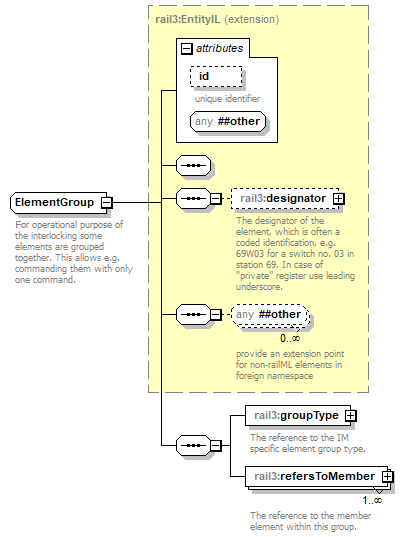 | ||||||||||||||
| namespace | https://www.railml.org/schemas/3.1 | ||||||||||||||
| type | extension of rail3:EntityIL | ||||||||||||||
| properties |
| ||||||||||||||
| children | rail3:designator rail3:groupType rail3:refersToMember | ||||||||||||||
| used by |
| ||||||||||||||
| attributes |
| ||||||||||||||
| annotation |
| ||||||||||||||
| source | <xs:complexType name="ElementGroup"> <xs:annotation> <xs:documentation>For operational purpose of the interlocking some elements are grouped together. This allows e.g. commanding them with only one command.</xs:documentation> </xs:annotation> <xs:complexContent> <xs:extension base="rail3:EntityIL"> <xs:sequence> <xs:element name="groupType" type="rail3:EntityILref" minOccurs="1" maxOccurs="1"> <xs:annotation> <xs:documentation>The reference to the IM specific element group type.</xs:documentation> </xs:annotation> </xs:element> <xs:element name="refersToMember" type="rail3:EntityILref" minOccurs="1" maxOccurs="unbounded"> <xs:annotation> <xs:documentation>The reference to the member element within this group.</xs:documentation> </xs:annotation> </xs:element> </xs:sequence> </xs:extension> </xs:complexContent> </xs:complexType> |
element ElementGroup/groupType
| diagram | 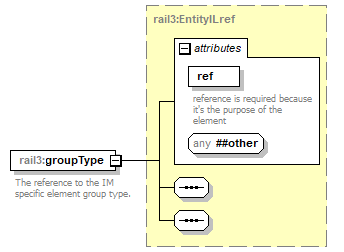 | ||||||||||||||
| namespace | https://www.railml.org/schemas/3.1 | ||||||||||||||
| type | rail3:EntityILref | ||||||||||||||
| properties |
| ||||||||||||||
| attributes |
| ||||||||||||||
| annotation |
| ||||||||||||||
| source | <xs:element name="groupType" type="rail3:EntityILref" minOccurs="1" maxOccurs="1"> <xs:annotation> <xs:documentation>The reference to the IM specific element group type.</xs:documentation> </xs:annotation> </xs:element> |
element ElementGroup/refersToMember
| diagram | 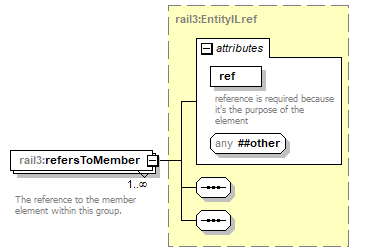 | ||||||||||||||
| namespace | https://www.railml.org/schemas/3.1 | ||||||||||||||
| type | rail3:EntityILref | ||||||||||||||
| properties |
| ||||||||||||||
| attributes |
| ||||||||||||||
| annotation |
| ||||||||||||||
| source | <xs:element name="refersToMember" type="rail3:EntityILref" minOccurs="1" maxOccurs="unbounded"> <xs:annotation> <xs:documentation>The reference to the member element within this group.</xs:documentation> </xs:annotation> </xs:element> |
complexType ElementGroupingTypes
| diagram | 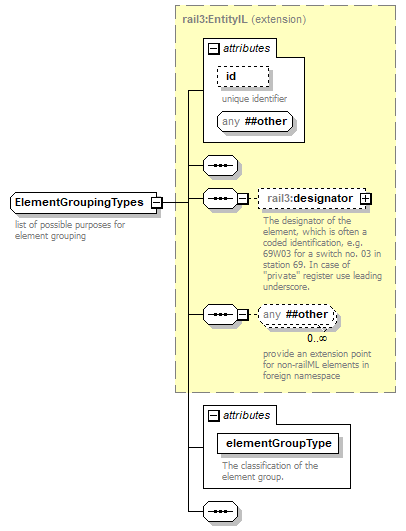 | ||||||||||||||||||||||
| namespace | https://www.railml.org/schemas/3.1 | ||||||||||||||||||||||
| type | extension of rail3:EntityIL | ||||||||||||||||||||||
| properties |
| ||||||||||||||||||||||
| children | rail3:designator | ||||||||||||||||||||||
| used by |
| ||||||||||||||||||||||
| attributes |
| ||||||||||||||||||||||
| annotation |
| ||||||||||||||||||||||
| source | <xs:complexType name="ElementGroupingTypes"> <xs:annotation> <xs:documentation>list of possible purposes for element grouping</xs:documentation> </xs:annotation> <xs:complexContent> <xs:extension base="rail3:EntityIL"> <xs:sequence/> <xs:attribute name="elementGroupType" type="rail3:tGroupingTypesExt" use="required"> <xs:annotation> <xs:documentation>The classification of the element group.</xs:documentation> </xs:annotation> </xs:attribute> </xs:extension> </xs:complexContent> </xs:complexType> |
attribute ElementGroupingTypes/@elementGroupType
| type | rail3:tGroupingTypesExt | ||
| properties |
| ||
| annotation |
| ||
| source | <xs:attribute name="elementGroupType" type="rail3:tGroupingTypesExt" use="required"> <xs:annotation> <xs:documentation>The classification of the element group.</xs:documentation> </xs:annotation> </xs:attribute> |
complexType EntityIL
| diagram | 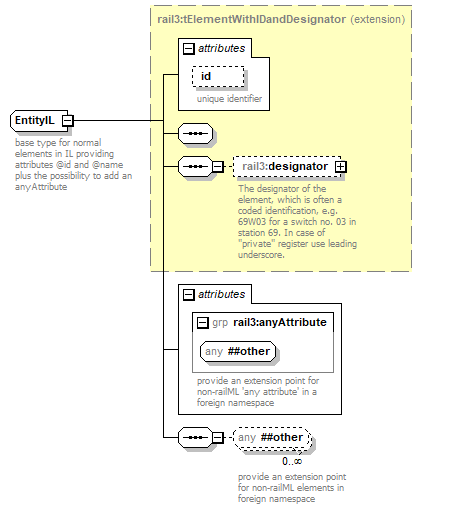 | ||||||||||||||
| namespace | https://www.railml.org/schemas/3.1 | ||||||||||||||
| type | extension of rail3:tElementWithIDandDesignator | ||||||||||||||
| properties |
| ||||||||||||||
| children | rail3:designator | ||||||||||||||
| used by | |||||||||||||||
| attributes |
| ||||||||||||||
| annotation |
| ||||||||||||||
| source | <xs:complexType name="EntityIL"> <xs:annotation> <xs:documentation>base type for normal elements in IL providing attributes @id and @name plus the possibility to add an anyAttribute</xs:documentation> </xs:annotation> <xs:complexContent> <xs:extension base="rail3:tElementWithIDandDesignator"> <xs:sequence> <xs:any namespace="##other" processContents="strict" minOccurs="0" maxOccurs="unbounded"> <xs:annotation> <xs:documentation>provide an extension point for non-railML elements in foreign namespace</xs:documentation> </xs:annotation> </xs:any> </xs:sequence> <xs:attributeGroup ref="rail3:anyAttribute"/> </xs:extension> </xs:complexContent> </xs:complexType> |
complexType EntityILref
complexType GenericAspect
| diagram | 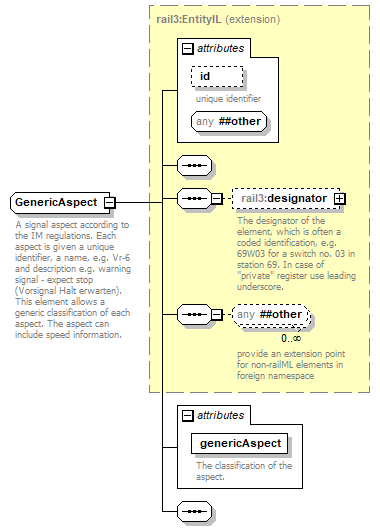 | ||||||||||||||||||||||
| namespace | https://www.railml.org/schemas/3.1 | ||||||||||||||||||||||
| type | extension of rail3:EntityIL | ||||||||||||||||||||||
| properties |
| ||||||||||||||||||||||
| children | rail3:designator | ||||||||||||||||||||||
| used by |
| ||||||||||||||||||||||
| attributes |
| ||||||||||||||||||||||
| annotation |
| ||||||||||||||||||||||
| source | <xs:complexType name="GenericAspect"> <xs:annotation> <xs:documentation>A signal aspect according to the IM regulations. Each aspect is given a unique identifier, a name, e.g. Vr-6 and description e.g. warning signal - expect stop (Vorsignal Halt erwarten). This element allows a generic classification of each aspect. The aspect can include speed information.</xs:documentation> </xs:annotation> <xs:complexContent> <xs:extension base="rail3:EntityIL"> <xs:sequence/> <xs:attribute name="genericAspect" type="rail3:tGenericAspectList" use="required"> <xs:annotation> <xs:documentation>The classification of the aspect.</xs:documentation> </xs:annotation> </xs:attribute> </xs:extension> </xs:complexContent> </xs:complexType> |
attribute GenericAspect/@genericAspect
| type | rail3:tGenericAspectList | |||||||||||||||||||||||||||||||||
| properties |
| |||||||||||||||||||||||||||||||||
| facets |
| |||||||||||||||||||||||||||||||||
| annotation |
| |||||||||||||||||||||||||||||||||
| source | <xs:attribute name="genericAspect" type="rail3:tGenericAspectList" use="required"> <xs:annotation> <xs:documentation>The classification of the aspect.</xs:documentation> </xs:annotation> </xs:attribute> |
complexType GenericDetector
| diagram | 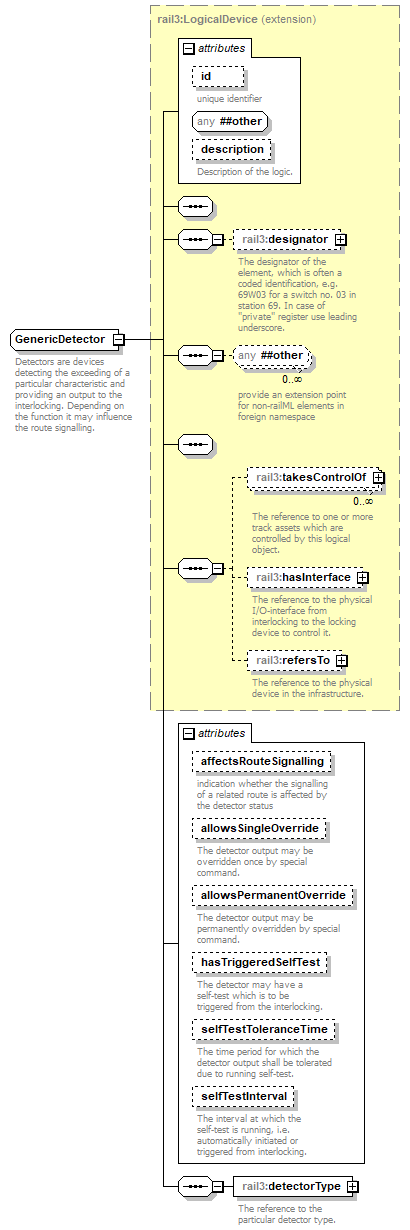 | ||||||||||||||||||||||||||||||||||||||||||||||||||||||||||||||||||||||
| namespace | https://www.railml.org/schemas/3.1 | ||||||||||||||||||||||||||||||||||||||||||||||||||||||||||||||||||||||
| type | extension of rail3:LogicalDevice | ||||||||||||||||||||||||||||||||||||||||||||||||||||||||||||||||||||||
| properties |
| ||||||||||||||||||||||||||||||||||||||||||||||||||||||||||||||||||||||
| children | rail3:designator rail3:takesControlOf rail3:hasInterface rail3:refersTo rail3:detectorType | ||||||||||||||||||||||||||||||||||||||||||||||||||||||||||||||||||||||
| used by |
| ||||||||||||||||||||||||||||||||||||||||||||||||||||||||||||||||||||||
| attributes |
| ||||||||||||||||||||||||||||||||||||||||||||||||||||||||||||||||||||||
| annotation |
| ||||||||||||||||||||||||||||||||||||||||||||||||||||||||||||||||||||||
| source | <xs:complexType name="GenericDetector"> <xs:annotation> <xs:documentation>Detectors are devices detecting the exceeding of a particular characteristic and providing an output to the interlocking. Depending on the function it may influence the route signalling.</xs:documentation> </xs:annotation> <xs:complexContent> <xs:extension base="rail3:LogicalDevice"> <xs:sequence> <xs:element name="detectorType" type="rail3:EntityILref" minOccurs="1" maxOccurs="1"> <xs:annotation> <xs:documentation>The reference to the particular detector type.</xs:documentation> </xs:annotation> </xs:element> </xs:sequence> <xs:attribute name="affectsRouteSignalling" type="xs:boolean" use="optional"> <xs:annotation> <xs:documentation>indication whether the signalling of a related route is affected by the detector status</xs:documentation> </xs:annotation> </xs:attribute> <xs:attribute name="allowsSingleOverride" type="xs:boolean" use="optional"> <xs:annotation> <xs:documentation>The detector output may be overridden once by special command.</xs:documentation> </xs:annotation> </xs:attribute> <xs:attribute name="allowsPermanentOverride" type="xs:boolean" use="optional"> <xs:annotation> <xs:documentation>The detector output may be permanently overridden by special command.</xs:documentation> </xs:annotation> </xs:attribute> <xs:attribute name="hasTriggeredSelfTest" type="xs:boolean" use="optional"> <xs:annotation> <xs:documentation>The detector may have a self-test which is to be triggered from the interlocking.</xs:documentation> </xs:annotation> </xs:attribute> <xs:attribute name="selfTestToleranceTime" type="xs:duration" use="optional"> <xs:annotation> <xs:documentation>The time period for which the detector output shall be tolerated due to running self-test.</xs:documentation> </xs:annotation> </xs:attribute> <xs:attribute name="selfTestInterval" type="xs:duration" use="optional"> <xs:annotation> <xs:documentation>The interval at which the self-test is running, i.e. automatically initiated or triggered from interlocking.</xs:documentation> </xs:annotation> </xs:attribute> </xs:extension> </xs:complexContent> </xs:complexType> |
attribute GenericDetector/@affectsRouteSignalling
| type | xs:boolean | ||
| properties |
| ||
| annotation |
| ||
| source | <xs:attribute name="affectsRouteSignalling" type="xs:boolean" use="optional"> <xs:annotation> <xs:documentation>indication whether the signalling of a related route is affected by the detector status</xs:documentation> </xs:annotation> </xs:attribute> |
attribute GenericDetector/@allowsSingleOverride
| type | xs:boolean | ||
| properties |
| ||
| annotation |
| ||
| source | <xs:attribute name="allowsSingleOverride" type="xs:boolean" use="optional"> <xs:annotation> <xs:documentation>The detector output may be overridden once by special command.</xs:documentation> </xs:annotation> </xs:attribute> |
attribute GenericDetector/@allowsPermanentOverride
| type | xs:boolean | ||
| properties |
| ||
| annotation |
| ||
| source | <xs:attribute name="allowsPermanentOverride" type="xs:boolean" use="optional"> <xs:annotation> <xs:documentation>The detector output may be permanently overridden by special command.</xs:documentation> </xs:annotation> </xs:attribute> |
attribute GenericDetector/@hasTriggeredSelfTest
| type | xs:boolean | ||
| properties |
| ||
| annotation |
| ||
| source | <xs:attribute name="hasTriggeredSelfTest" type="xs:boolean" use="optional"> <xs:annotation> <xs:documentation>The detector may have a self-test which is to be triggered from the interlocking.</xs:documentation> </xs:annotation> </xs:attribute> |
attribute GenericDetector/@selfTestToleranceTime
| type | xs:duration | ||
| properties |
| ||
| annotation |
| ||
| source | <xs:attribute name="selfTestToleranceTime" type="xs:duration" use="optional"> <xs:annotation> <xs:documentation>The time period for which the detector output shall be tolerated due to running self-test.</xs:documentation> </xs:annotation> </xs:attribute> |
attribute GenericDetector/@selfTestInterval
| type | xs:duration | ||
| properties |
| ||
| annotation |
| ||
| source | <xs:attribute name="selfTestInterval" type="xs:duration" use="optional"> <xs:annotation> <xs:documentation>The interval at which the self-test is running, i.e. automatically initiated or triggered from interlocking.</xs:documentation> </xs:annotation> </xs:attribute> |
element GenericDetector/detectorType
| diagram | 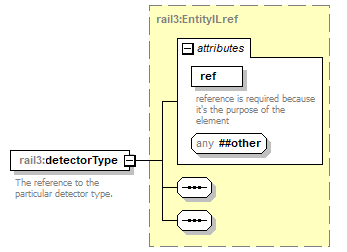 | ||||||||||||||
| namespace | https://www.railml.org/schemas/3.1 | ||||||||||||||
| type | rail3:EntityILref | ||||||||||||||
| properties |
| ||||||||||||||
| attributes |
| ||||||||||||||
| annotation |
| ||||||||||||||
| source | <xs:element name="detectorType" type="rail3:EntityILref" minOccurs="1" maxOccurs="1"> <xs:annotation> <xs:documentation>The reference to the particular detector type.</xs:documentation> </xs:annotation> </xs:element> |
complexType GenericDetectors
| diagram |  | ||
| namespace | https://www.railml.org/schemas/3.1 | ||
| children | rail3:genericDetector | ||
| used by |
| ||
| annotation |
| ||
| source | <xs:complexType name="GenericDetectors"> <xs:annotation> <xs:documentation>contains all GenericDetector elements</xs:documentation> </xs:annotation> <xs:sequence> <xs:element name="genericDetector" type="rail3:GenericDetector" minOccurs="1" maxOccurs="unbounded"> <xs:annotation> <xs:documentation>Device for detecting the exceeding of a particular characteristic.</xs:documentation> </xs:annotation> </xs:element> </xs:sequence> </xs:complexType> |
element GenericDetectors/genericDetector
| diagram | 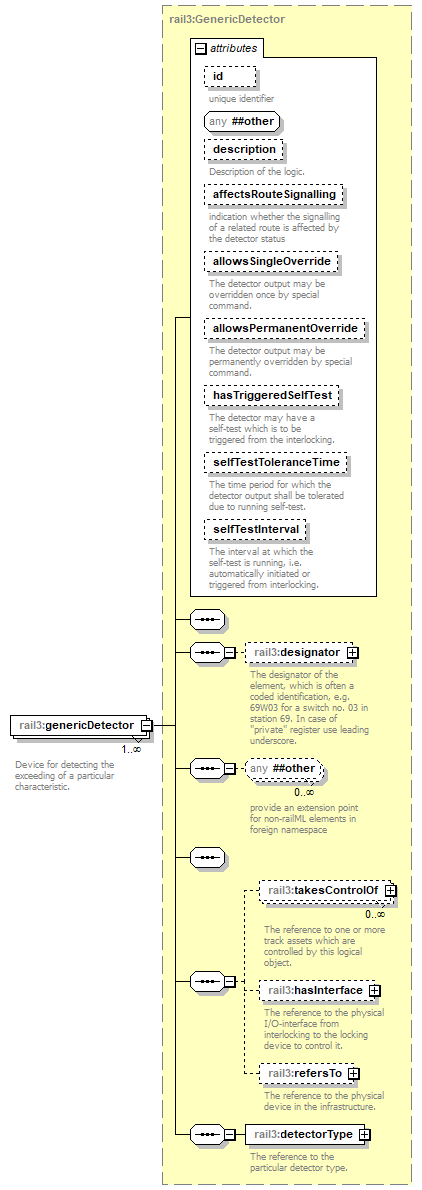 | ||||||||||||||||||||||||||||||||||||||||||||||||||||||||||||||||||||||
| namespace | https://www.railml.org/schemas/3.1 | ||||||||||||||||||||||||||||||||||||||||||||||||||||||||||||||||||||||
| type | rail3:GenericDetector | ||||||||||||||||||||||||||||||||||||||||||||||||||||||||||||||||||||||
| properties |
| ||||||||||||||||||||||||||||||||||||||||||||||||||||||||||||||||||||||
| children | rail3:designator rail3:takesControlOf rail3:hasInterface rail3:refersTo rail3:detectorType | ||||||||||||||||||||||||||||||||||||||||||||||||||||||||||||||||||||||
| attributes |
| ||||||||||||||||||||||||||||||||||||||||||||||||||||||||||||||||||||||
| annotation |
| ||||||||||||||||||||||||||||||||||||||||||||||||||||||||||||||||||||||
| source | <xs:element name="genericDetector" type="rail3:GenericDetector" minOccurs="1" maxOccurs="unbounded"> <xs:annotation> <xs:documentation>Device for detecting the exceeding of a particular characteristic.</xs:documentation> </xs:annotation> </xs:element> |
complexType GenericIM
| diagram | 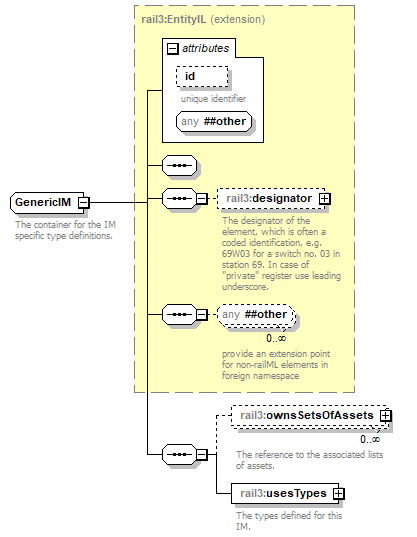 | ||||||||||||||
| namespace | https://www.railml.org/schemas/3.1 | ||||||||||||||
| type | extension of rail3:EntityIL | ||||||||||||||
| properties |
| ||||||||||||||
| children | rail3:designator rail3:ownsSetsOfAssets rail3:usesTypes | ||||||||||||||
| used by |
| ||||||||||||||
| attributes |
| ||||||||||||||
| annotation |
| ||||||||||||||
| source | <xs:complexType name="GenericIM"> <xs:annotation> <xs:documentation>The container for the IM specific type definitions.</xs:documentation> </xs:annotation> <xs:complexContent> <xs:extension base="rail3:EntityIL"> <xs:sequence> <xs:element name="ownsSetsOfAssets" type="rail3:EntityILref" minOccurs="0" maxOccurs="unbounded"> <xs:annotation> <xs:documentation>The reference to the associated lists of assets.</xs:documentation> </xs:annotation> </xs:element> <xs:element name="usesTypes" type="rail3:GenericTypes" minOccurs="1" maxOccurs="1"> <xs:annotation> <xs:documentation>The types defined for this IM.</xs:documentation> </xs:annotation> </xs:element> </xs:sequence> </xs:extension> </xs:complexContent> </xs:complexType> |
element GenericIM/ownsSetsOfAssets
| diagram | 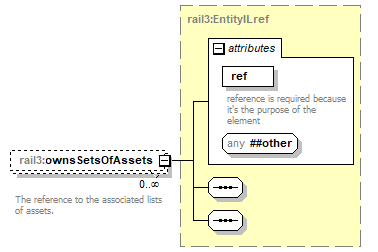 | ||||||||||||||
| namespace | https://www.railml.org/schemas/3.1 | ||||||||||||||
| type | rail3:EntityILref | ||||||||||||||
| properties |
| ||||||||||||||
| attributes |
| ||||||||||||||
| annotation |
| ||||||||||||||
| source | <xs:element name="ownsSetsOfAssets" type="rail3:EntityILref" minOccurs="0" maxOccurs="unbounded"> <xs:annotation> <xs:documentation>The reference to the associated lists of assets.</xs:documentation> </xs:annotation> </xs:element> |
element GenericIM/usesTypes
| diagram | 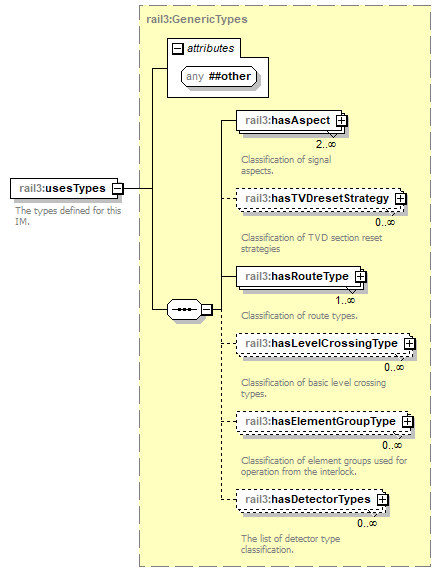 | ||||||
| namespace | https://www.railml.org/schemas/3.1 | ||||||
| type | rail3:GenericTypes | ||||||
| properties |
| ||||||
| children | rail3:hasAspect rail3:hasTVDresetStrategy rail3:hasRouteType rail3:hasLevelCrossingType rail3:hasElementGroupType rail3:hasDetectorTypes | ||||||
| attributes |
| ||||||
| annotation |
| ||||||
| source | <xs:element name="usesTypes" type="rail3:GenericTypes" minOccurs="1" maxOccurs="1"> <xs:annotation> <xs:documentation>The types defined for this IM.</xs:documentation> </xs:annotation> </xs:element> |
complexType GenericIMs
| diagram |  | ||
| namespace | https://www.railml.org/schemas/3.1 | ||
| children | rail3:specificIM | ||
| used by |
| ||
| annotation |
| ||
| source | <xs:complexType name="GenericIMs"> <xs:annotation> <xs:documentation>container element for all specificIM elements</xs:documentation> </xs:annotation> <xs:sequence minOccurs="0" maxOccurs="1"> <xs:element name="specificIM" type="rail3:GenericIM" minOccurs="1" maxOccurs="unbounded"> <xs:annotation> <xs:documentation>Container with the generic classification of types used by a specific infrastructure manager.</xs:documentation> </xs:annotation> </xs:element> </xs:sequence> </xs:complexType> |
element GenericIMs/specificIM
| diagram | 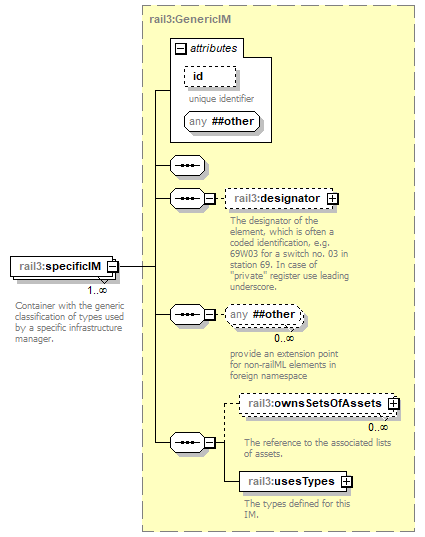 | ||||||||||||||
| namespace | https://www.railml.org/schemas/3.1 | ||||||||||||||
| type | rail3:GenericIM | ||||||||||||||
| properties |
| ||||||||||||||
| children | rail3:designator rail3:ownsSetsOfAssets rail3:usesTypes | ||||||||||||||
| attributes |
| ||||||||||||||
| annotation |
| ||||||||||||||
| source | <xs:element name="specificIM" type="rail3:GenericIM" minOccurs="1" maxOccurs="unbounded"> <xs:annotation> <xs:documentation>Container with the generic classification of types used by a specific infrastructure manager.</xs:documentation> </xs:annotation> </xs:element> |
complexType GenericResetStrategy
| diagram | 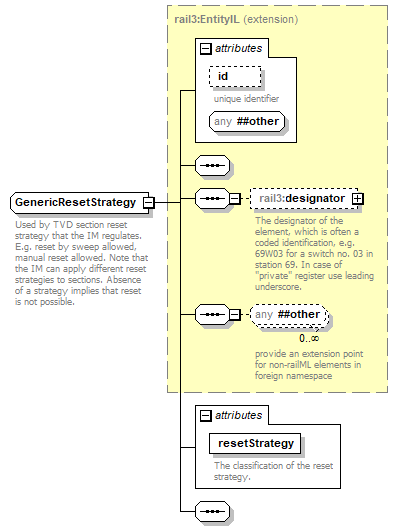 | ||||||||||||||||||||||
| namespace | https://www.railml.org/schemas/3.1 | ||||||||||||||||||||||
| type | extension of rail3:EntityIL | ||||||||||||||||||||||
| properties |
| ||||||||||||||||||||||
| children | rail3:designator | ||||||||||||||||||||||
| used by |
| ||||||||||||||||||||||
| attributes |
| ||||||||||||||||||||||
| annotation |
| ||||||||||||||||||||||
| source | <xs:complexType name="GenericResetStrategy"> <xs:annotation> <xs:documentation>Used by TVD section reset strategy that the IM regulates. E.g. reset by sweep allowed, manual reset allowed. Note that the IM can apply different reset strategies to sections. Absence of a strategy implies that reset is not possible.</xs:documentation> </xs:annotation> <xs:complexContent> <xs:extension base="rail3:EntityIL"> <xs:sequence/> <xs:attribute name="resetStrategy" type="rail3:tGenericResetStrategyList" use="required"> <xs:annotation> <xs:documentation>The classification of the reset strategy.</xs:documentation> </xs:annotation> </xs:attribute> </xs:extension> </xs:complexContent> </xs:complexType> |
attribute GenericResetStrategy/@resetStrategy
| type | rail3:tGenericResetStrategyList | ||||||||||||||||||
| properties |
| ||||||||||||||||||
| facets |
| ||||||||||||||||||
| annotation |
| ||||||||||||||||||
| source | <xs:attribute name="resetStrategy" type="rail3:tGenericResetStrategyList" use="required"> <xs:annotation> <xs:documentation>The classification of the reset strategy.</xs:documentation> </xs:annotation> </xs:attribute> |
complexType GenericRouteType
| diagram | 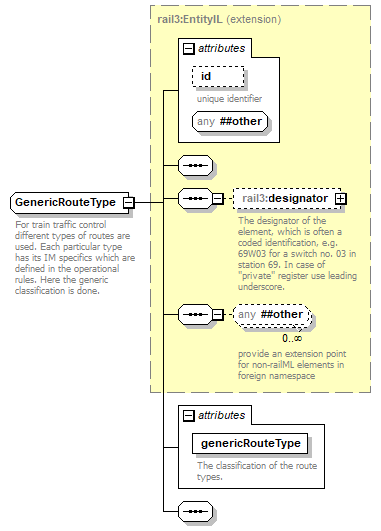 | ||||||||||||||||||||||
| namespace | https://www.railml.org/schemas/3.1 | ||||||||||||||||||||||
| type | extension of rail3:EntityIL | ||||||||||||||||||||||
| properties |
| ||||||||||||||||||||||
| children | rail3:designator | ||||||||||||||||||||||
| used by |
| ||||||||||||||||||||||
| attributes |
| ||||||||||||||||||||||
| annotation |
| ||||||||||||||||||||||
| source | <xs:complexType name="GenericRouteType"> <xs:annotation> <xs:documentation>For train traffic control different types of routes are used. Each particular type has its IM specifics which are defined in the operational rules. Here the generic classification is done.</xs:documentation> </xs:annotation> <xs:complexContent> <xs:extension base="rail3:EntityIL"> <xs:sequence/> <xs:attribute name="genericRouteType" type="rail3:tGenericRouteTypeExt" use="required"> <xs:annotation> <xs:documentation>The classification of the route types.</xs:documentation> </xs:annotation> </xs:attribute> </xs:extension> </xs:complexContent> </xs:complexType> |
attribute GenericRouteType/@genericRouteType
| type | rail3:tGenericRouteTypeExt | ||
| properties |
| ||
| annotation |
| ||
| source | <xs:attribute name="genericRouteType" type="rail3:tGenericRouteTypeExt" use="required"> <xs:annotation> <xs:documentation>The classification of the route types.</xs:documentation> </xs:annotation> </xs:attribute> |
complexType GenericTypes
| diagram | 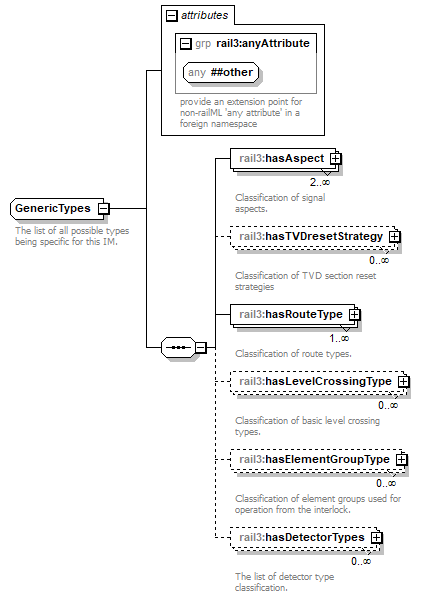 | ||||||
| namespace | https://www.railml.org/schemas/3.1 | ||||||
| children | rail3:hasAspect rail3:hasTVDresetStrategy rail3:hasRouteType rail3:hasLevelCrossingType rail3:hasElementGroupType rail3:hasDetectorTypes | ||||||
| used by |
| ||||||
| attributes |
| ||||||
| annotation |
| ||||||
| source | <xs:complexType name="GenericTypes"> <xs:annotation> <xs:documentation>The list of all possible types being specific for this IM.</xs:documentation> </xs:annotation> <xs:sequence> <xs:element name="hasAspect" type="rail3:GenericAspect" minOccurs="2" maxOccurs="unbounded"> <xs:annotation> <xs:documentation>Classification of signal aspects.</xs:documentation> </xs:annotation> </xs:element> <xs:element name="hasTVDresetStrategy" type="rail3:GenericResetStrategy" minOccurs="0" maxOccurs="unbounded"> <xs:annotation> <xs:documentation>Classification of TVD section reset strategies</xs:documentation> </xs:annotation> </xs:element> <xs:element name="hasRouteType" type="rail3:GenericRouteType" minOccurs="1" maxOccurs="unbounded"> <xs:annotation> <xs:documentation>Classification of route types.</xs:documentation> </xs:annotation> </xs:element> <xs:element name="hasLevelCrossingType" type="rail3:LevelCrossingTypeList" minOccurs="0" maxOccurs="unbounded"> <xs:annotation> <xs:documentation>Classification of basic level crossing types.</xs:documentation> </xs:annotation> </xs:element> <xs:element name="hasElementGroupType" type="rail3:ElementGroupingTypes" minOccurs="0" maxOccurs="unbounded"> <xs:annotation> <xs:documentation>Classification of element groups used for operation from the interlock.</xs:documentation> </xs:annotation> </xs:element> <xs:element name="hasDetectorTypes" type="rail3:DetectorTypes" minOccurs="0" maxOccurs="unbounded"> <xs:annotation> <xs:documentation>The list of detector type classification.</xs:documentation> </xs:annotation> </xs:element> </xs:sequence> <xs:attributeGroup ref="rail3:anyAttribute"/> </xs:complexType> |
element GenericTypes/hasAspect
| diagram | 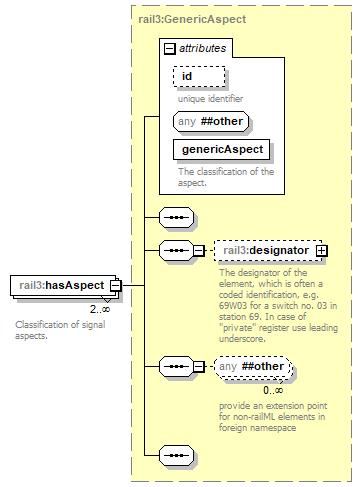 | ||||||||||||||||||||||
| namespace | https://www.railml.org/schemas/3.1 | ||||||||||||||||||||||
| type | rail3:GenericAspect | ||||||||||||||||||||||
| properties |
| ||||||||||||||||||||||
| children | rail3:designator | ||||||||||||||||||||||
| attributes |
| ||||||||||||||||||||||
| annotation |
| ||||||||||||||||||||||
| source | <xs:element name="hasAspect" type="rail3:GenericAspect" minOccurs="2" maxOccurs="unbounded"> <xs:annotation> <xs:documentation>Classification of signal aspects.</xs:documentation> </xs:annotation> </xs:element> |
element GenericTypes/hasTVDresetStrategy
| diagram | 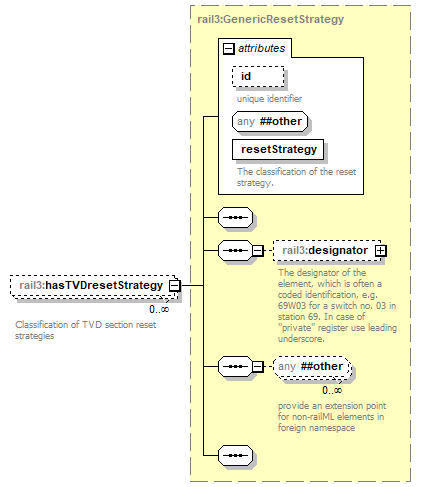 | ||||||||||||||||||||||
| namespace | https://www.railml.org/schemas/3.1 | ||||||||||||||||||||||
| type | rail3:GenericResetStrategy | ||||||||||||||||||||||
| properties |
| ||||||||||||||||||||||
| children | rail3:designator | ||||||||||||||||||||||
| attributes |
| ||||||||||||||||||||||
| annotation |
| ||||||||||||||||||||||
| source | <xs:element name="hasTVDresetStrategy" type="rail3:GenericResetStrategy" minOccurs="0" maxOccurs="unbounded"> <xs:annotation> <xs:documentation>Classification of TVD section reset strategies</xs:documentation> </xs:annotation> </xs:element> |
element GenericTypes/hasRouteType
| diagram | 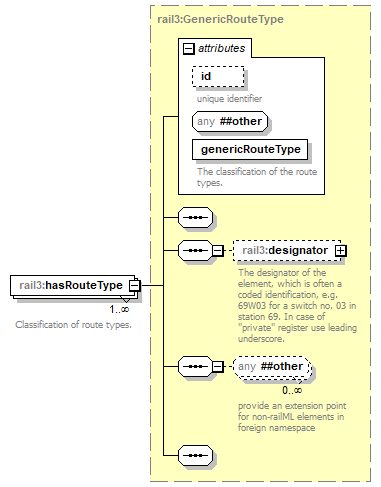 | ||||||||||||||||||||||
| namespace | https://www.railml.org/schemas/3.1 | ||||||||||||||||||||||
| type | rail3:GenericRouteType | ||||||||||||||||||||||
| properties |
| ||||||||||||||||||||||
| children | rail3:designator | ||||||||||||||||||||||
| attributes |
| ||||||||||||||||||||||
| annotation |
| ||||||||||||||||||||||
| source | <xs:element name="hasRouteType" type="rail3:GenericRouteType" minOccurs="1" maxOccurs="unbounded"> <xs:annotation> <xs:documentation>Classification of route types.</xs:documentation> </xs:annotation> </xs:element> |
element GenericTypes/hasLevelCrossingType
| diagram | 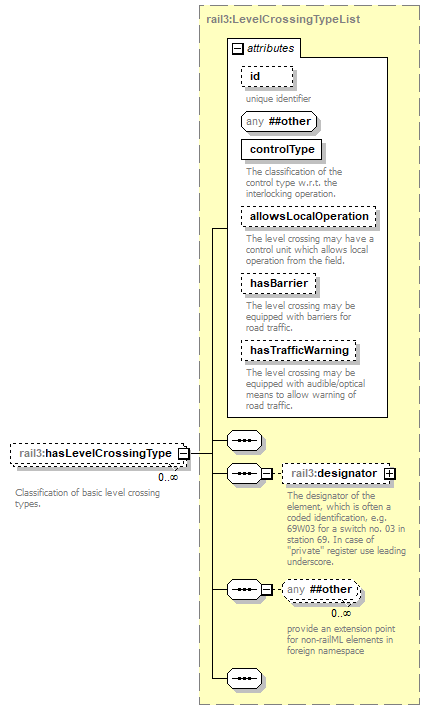 | ||||||||||||||||||||||||||||||||||||||||||||||
| namespace | https://www.railml.org/schemas/3.1 | ||||||||||||||||||||||||||||||||||||||||||||||
| type | rail3:LevelCrossingTypeList | ||||||||||||||||||||||||||||||||||||||||||||||
| properties |
| ||||||||||||||||||||||||||||||||||||||||||||||
| children | rail3:designator | ||||||||||||||||||||||||||||||||||||||||||||||
| attributes |
| ||||||||||||||||||||||||||||||||||||||||||||||
| annotation |
| ||||||||||||||||||||||||||||||||||||||||||||||
| source | <xs:element name="hasLevelCrossingType" type="rail3:LevelCrossingTypeList" minOccurs="0" maxOccurs="unbounded"> <xs:annotation> <xs:documentation>Classification of basic level crossing types.</xs:documentation> </xs:annotation> </xs:element> |
element GenericTypes/hasElementGroupType
| diagram | 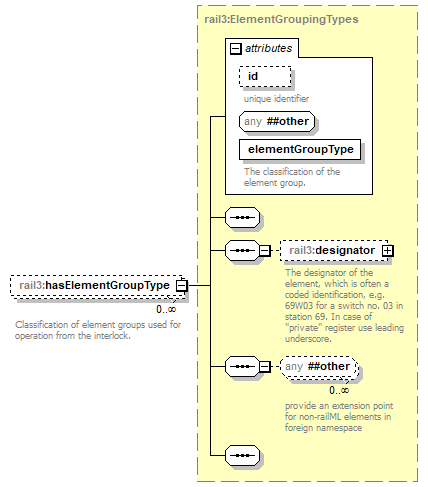 | ||||||||||||||||||||||
| namespace | https://www.railml.org/schemas/3.1 | ||||||||||||||||||||||
| type | rail3:ElementGroupingTypes | ||||||||||||||||||||||
| properties |
| ||||||||||||||||||||||
| children | rail3:designator | ||||||||||||||||||||||
| attributes |
| ||||||||||||||||||||||
| annotation |
| ||||||||||||||||||||||
| source | <xs:element name="hasElementGroupType" type="rail3:ElementGroupingTypes" minOccurs="0" maxOccurs="unbounded"> <xs:annotation> <xs:documentation>Classification of element groups used for operation from the interlock.</xs:documentation> </xs:annotation> </xs:element> |
element GenericTypes/hasDetectorTypes
| diagram | 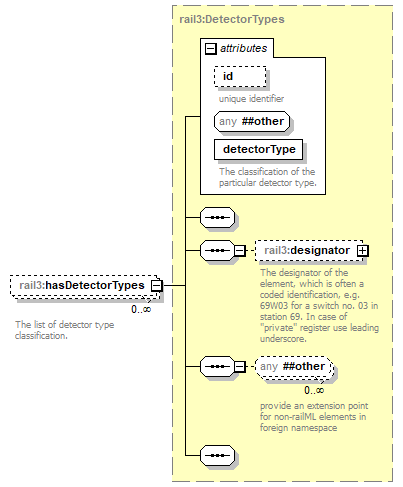 | ||||||||||||||||||||||
| namespace | https://www.railml.org/schemas/3.1 | ||||||||||||||||||||||
| type | rail3:DetectorTypes | ||||||||||||||||||||||
| properties |
| ||||||||||||||||||||||
| children | rail3:designator | ||||||||||||||||||||||
| attributes |
| ||||||||||||||||||||||
| annotation |
| ||||||||||||||||||||||
| source | <xs:element name="hasDetectorTypes" type="rail3:DetectorTypes" minOccurs="0" maxOccurs="unbounded"> <xs:annotation> <xs:documentation>The list of detector type classification.</xs:documentation> </xs:annotation> </xs:element> |
complexType InitStatus
| diagram | 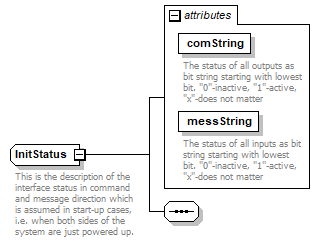 | ||||||||||||||||||||||
| namespace | https://www.railml.org/schemas/3.1 | ||||||||||||||||||||||
| used by |
| ||||||||||||||||||||||
| attributes |
| ||||||||||||||||||||||
| annotation |
| ||||||||||||||||||||||
| source | <xs:complexType name="InitStatus"> <xs:annotation> <xs:documentation>This is the description of the interface status in command and message direction which is assumed in start-up cases, i.e. when both sides of the system are just powered up.</xs:documentation> </xs:annotation> <xs:sequence/> <xs:attribute name="comString" type="rail3:tBitPatternAny" use="required"> <xs:annotation> <xs:documentation>The status of all outputs as bit string starting with lowest bit. "0"-inactive, "1"-active, "x"-does not matter</xs:documentation> </xs:annotation> </xs:attribute> <xs:attribute name="messString" type="rail3:tBitPatternAny" use="required"> <xs:annotation> <xs:documentation>The status of all inputs as bit string starting with lowest bit. "0"-inactive, "1"-active, "x"-does not matter</xs:documentation> </xs:annotation> </xs:attribute> </xs:complexType> |
attribute InitStatus/@comString
| type | rail3:tBitPatternAny | |||||||||
| properties |
| |||||||||
| facets |
| |||||||||
| annotation |
| |||||||||
| source | <xs:attribute name="comString" type="rail3:tBitPatternAny" use="required"> <xs:annotation> <xs:documentation>The status of all outputs as bit string starting with lowest bit. "0"-inactive, "1"-active, "x"-does not matter</xs:documentation> </xs:annotation> </xs:attribute> |
attribute InitStatus/@messString
| type | rail3:tBitPatternAny | |||||||||
| properties |
| |||||||||
| facets |
| |||||||||
| annotation |
| |||||||||
| source | <xs:attribute name="messString" type="rail3:tBitPatternAny" use="required"> <xs:annotation> <xs:documentation>The status of all inputs as bit string starting with lowest bit. "0"-inactive, "1"-active, "x"-does not matter</xs:documentation> </xs:annotation> </xs:attribute> |
complexType InputOutput
| diagram | 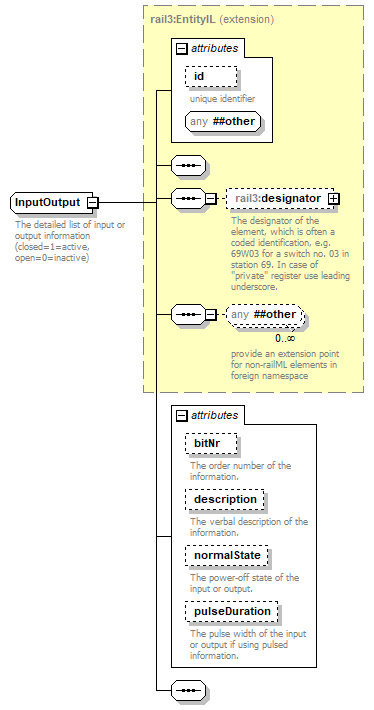 | ||||||||||||||||||||||||||||||||||||||||||||||
| namespace | https://www.railml.org/schemas/3.1 | ||||||||||||||||||||||||||||||||||||||||||||||
| type | extension of rail3:EntityIL | ||||||||||||||||||||||||||||||||||||||||||||||
| properties |
| ||||||||||||||||||||||||||||||||||||||||||||||
| children | rail3:designator | ||||||||||||||||||||||||||||||||||||||||||||||
| used by |
| ||||||||||||||||||||||||||||||||||||||||||||||
| attributes |
| ||||||||||||||||||||||||||||||||||||||||||||||
| annotation |
| ||||||||||||||||||||||||||||||||||||||||||||||
| source | <xs:complexType name="InputOutput"> <xs:annotation> <xs:documentation>The detailed list of input or output information (closed=1=active, open=0=inactive)</xs:documentation> </xs:annotation> <xs:complexContent> <xs:extension base="rail3:EntityIL"> <xs:sequence/> <xs:attribute name="bitNr" type="xs:nonNegativeInteger" use="optional"> <xs:annotation> <xs:documentation>The order number of the information.</xs:documentation> </xs:annotation> </xs:attribute> <xs:attribute name="description" type="xs:string" use="optional"> <xs:annotation> <xs:documentation>The verbal description of the information.</xs:documentation> </xs:annotation> </xs:attribute> <xs:attribute name="normalState" type="rail3:tContactState" use="optional"> <xs:annotation> <xs:documentation>The power-off state of the input or output.</xs:documentation> </xs:annotation> </xs:attribute> <xs:attribute name="pulseDuration" type="xs:duration" use="optional"> <xs:annotation> <xs:documentation>The pulse width of the input or output if using pulsed information.</xs:documentation> </xs:annotation> </xs:attribute> </xs:extension> </xs:complexContent> </xs:complexType> |
attribute InputOutput/@bitNr
| type | xs:nonNegativeInteger | ||
| properties |
| ||
| annotation |
| ||
| source | <xs:attribute name="bitNr" type="xs:nonNegativeInteger" use="optional"> <xs:annotation> <xs:documentation>The order number of the information.</xs:documentation> </xs:annotation> </xs:attribute> |
attribute InputOutput/@description
| type | xs:string | ||
| properties |
| ||
| annotation |
| ||
| source | <xs:attribute name="description" type="xs:string" use="optional"> <xs:annotation> <xs:documentation>The verbal description of the information.</xs:documentation> </xs:annotation> </xs:attribute> |
attribute InputOutput/@normalState
| type | rail3:tContactState | |||||||||
| properties |
| |||||||||
| facets |
| |||||||||
| annotation |
| |||||||||
| source | <xs:attribute name="normalState" type="rail3:tContactState" use="optional"> <xs:annotation> <xs:documentation>The power-off state of the input or output.</xs:documentation> </xs:annotation> </xs:attribute> |
attribute InputOutput/@pulseDuration
| type | xs:duration | ||
| properties |
| ||
| annotation |
| ||
| source | <xs:attribute name="pulseDuration" type="xs:duration" use="optional"> <xs:annotation> <xs:documentation>The pulse width of the input or output if using pulsed information.</xs:documentation> </xs:annotation> </xs:attribute> |
complexType Interface
| diagram | 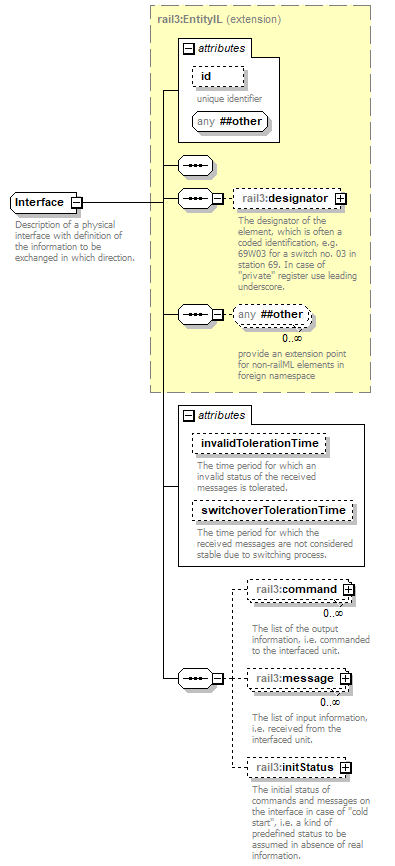 | ||||||||||||||||||||||||||||||
| namespace | https://www.railml.org/schemas/3.1 | ||||||||||||||||||||||||||||||
| type | extension of rail3:EntityIL | ||||||||||||||||||||||||||||||
| properties |
| ||||||||||||||||||||||||||||||
| children | rail3:designator rail3:command rail3:message rail3:initStatus | ||||||||||||||||||||||||||||||
| used by |
| ||||||||||||||||||||||||||||||
| attributes |
| ||||||||||||||||||||||||||||||
| annotation |
| ||||||||||||||||||||||||||||||
| source | <xs:complexType name="Interface"> <xs:annotation> <xs:documentation>Description of a physical interface with definition of the information to be exchanged in which direction.</xs:documentation> </xs:annotation> <xs:complexContent> <xs:extension base="rail3:EntityIL"> <xs:sequence> <xs:element name="command" type="rail3:InputOutput" minOccurs="0" maxOccurs="unbounded"> <xs:annotation> <xs:documentation>The list of the output information, i.e. commanded to the interfaced unit.</xs:documentation> </xs:annotation> </xs:element> <xs:element name="message" type="rail3:InputOutput" minOccurs="0" maxOccurs="unbounded"> <xs:annotation> <xs:documentation>The list of input information, i.e. received from the interfaced unit.</xs:documentation> </xs:annotation> </xs:element> <xs:element name="initStatus" type="rail3:InitStatus" minOccurs="0" maxOccurs="1"> <xs:annotation> <xs:documentation>The initial status of commands and messages on the interface in case of "cold start", i.e. a kind of predefined status to be assumed in absence of real information.</xs:documentation> </xs:annotation> </xs:element> </xs:sequence> <xs:attribute name="invalidTolerationTime" type="xs:duration" use="optional"> <xs:annotation> <xs:documentation>The time period for which an invalid status of the received messages is tolerated.</xs:documentation> </xs:annotation> </xs:attribute> <xs:attribute name="switchoverTolerationTime" type="xs:duration" use="optional"> <xs:annotation> <xs:documentation>The time period for which the received messages are not considered stable due to switching process.</xs:documentation> </xs:annotation> </xs:attribute> </xs:extension> </xs:complexContent> </xs:complexType> |
attribute Interface/@invalidTolerationTime
| type | xs:duration | ||
| properties |
| ||
| annotation |
| ||
| source | <xs:attribute name="invalidTolerationTime" type="xs:duration" use="optional"> <xs:annotation> <xs:documentation>The time period for which an invalid status of the received messages is tolerated.</xs:documentation> </xs:annotation> </xs:attribute> |
attribute Interface/@switchoverTolerationTime
| type | xs:duration | ||
| properties |
| ||
| annotation |
| ||
| source | <xs:attribute name="switchoverTolerationTime" type="xs:duration" use="optional"> <xs:annotation> <xs:documentation>The time period for which the received messages are not considered stable due to switching process.</xs:documentation> </xs:annotation> </xs:attribute> |
element Interface/command
| diagram | 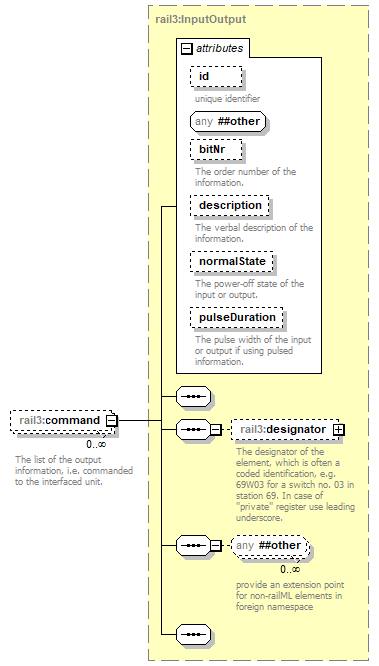 | ||||||||||||||||||||||||||||||||||||||||||||||
| namespace | https://www.railml.org/schemas/3.1 | ||||||||||||||||||||||||||||||||||||||||||||||
| type | rail3:InputOutput | ||||||||||||||||||||||||||||||||||||||||||||||
| properties |
| ||||||||||||||||||||||||||||||||||||||||||||||
| children | rail3:designator | ||||||||||||||||||||||||||||||||||||||||||||||
| attributes |
| ||||||||||||||||||||||||||||||||||||||||||||||
| annotation |
| ||||||||||||||||||||||||||||||||||||||||||||||
| source | <xs:element name="command" type="rail3:InputOutput" minOccurs="0" maxOccurs="unbounded"> <xs:annotation> <xs:documentation>The list of the output information, i.e. commanded to the interfaced unit.</xs:documentation> </xs:annotation> </xs:element> |
element Interface/message
| diagram | 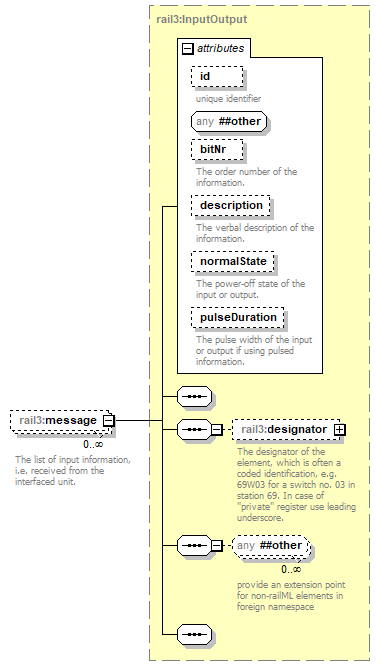 | ||||||||||||||||||||||||||||||||||||||||||||||
| namespace | https://www.railml.org/schemas/3.1 | ||||||||||||||||||||||||||||||||||||||||||||||
| type | rail3:InputOutput | ||||||||||||||||||||||||||||||||||||||||||||||
| properties |
| ||||||||||||||||||||||||||||||||||||||||||||||
| children | rail3:designator | ||||||||||||||||||||||||||||||||||||||||||||||
| attributes |
| ||||||||||||||||||||||||||||||||||||||||||||||
| annotation |
| ||||||||||||||||||||||||||||||||||||||||||||||
| source | <xs:element name="message" type="rail3:InputOutput" minOccurs="0" maxOccurs="unbounded"> <xs:annotation> <xs:documentation>The list of input information, i.e. received from the interfaced unit.</xs:documentation> </xs:annotation> </xs:element> |
element Interface/initStatus
| diagram | 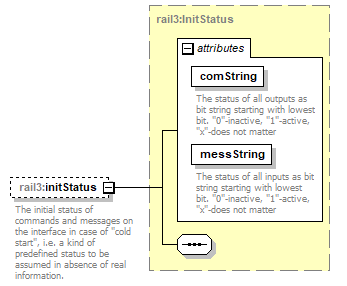 | ||||||||||||||||||||||
| namespace | https://www.railml.org/schemas/3.1 | ||||||||||||||||||||||
| type | rail3:InitStatus | ||||||||||||||||||||||
| properties |
| ||||||||||||||||||||||
| attributes |
| ||||||||||||||||||||||
| annotation |
| ||||||||||||||||||||||
| source | <xs:element name="initStatus" type="rail3:InitStatus" minOccurs="0" maxOccurs="1"> <xs:annotation> <xs:documentation>The initial status of commands and messages on the interface in case of "cold start", i.e. a kind of predefined status to be assumed in absence of real information.</xs:documentation> </xs:annotation> </xs:element> |
complexType Interfaces
| diagram |  | ||
| namespace | https://www.railml.org/schemas/3.1 | ||
| children | rail3:interface | ||
| used by |
| ||
| annotation |
| ||
| source | <xs:complexType name="Interfaces"> <xs:annotation> <xs:documentation>container element for all Interface elements</xs:documentation> </xs:annotation> <xs:sequence> <xs:element name="interface" type="rail3:Interface" minOccurs="1" maxOccurs="unbounded"> <xs:annotation> <xs:documentation>Description of a physical interface with definition of the information to be exchanged in which direction.</xs:documentation> </xs:annotation> </xs:element> </xs:sequence> </xs:complexType> |
element Interfaces/interface
| diagram | 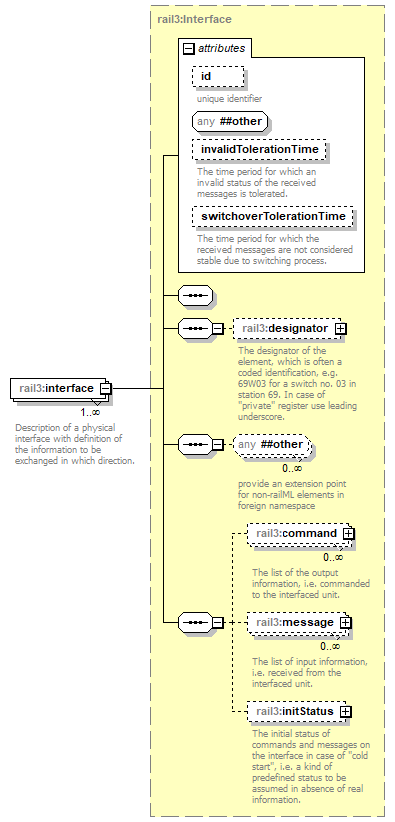 | ||||||||||||||||||||||||||||||
| namespace | https://www.railml.org/schemas/3.1 | ||||||||||||||||||||||||||||||
| type | rail3:Interface | ||||||||||||||||||||||||||||||
| properties |
| ||||||||||||||||||||||||||||||
| children | rail3:designator rail3:command rail3:message rail3:initStatus | ||||||||||||||||||||||||||||||
| attributes |
| ||||||||||||||||||||||||||||||
| annotation |
| ||||||||||||||||||||||||||||||
| source | <xs:element name="interface" type="rail3:Interface" minOccurs="1" maxOccurs="unbounded"> <xs:annotation> <xs:documentation>Description of a physical interface with definition of the information to be exchanged in which direction.</xs:documentation> </xs:annotation> </xs:element> |
complexType Interlocking
| diagram | 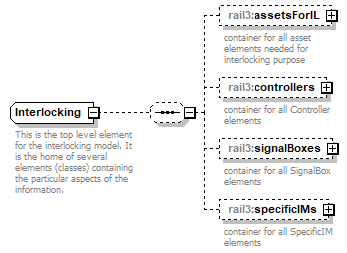 | ||
| namespace | https://www.railml.org/schemas/3.1 | ||
| children | rail3:assetsForIL rail3:controllers rail3:signalBoxes rail3:specificIMs | ||
| used by |
| ||
| annotation |
| ||
| source | <xs:complexType name="Interlocking"> <xs:annotation> <xs:documentation>This is the top level element for the interlocking model. It is the home of several elements (classes) containing the particular aspects of the information.</xs:documentation> </xs:annotation> <xs:sequence minOccurs="0" maxOccurs="1"> <xs:element name="assetsForIL" type="rail3:AssetsForIL" minOccurs="0" maxOccurs="1"> <xs:annotation> <xs:documentation>container for all asset elements needed for interlocking purpose</xs:documentation> </xs:annotation> </xs:element> <xs:element name="controllers" type="rail3:Controllers" minOccurs="0" maxOccurs="1"> <xs:annotation> <xs:documentation>container for all Controller elements</xs:documentation> </xs:annotation> </xs:element> <xs:element name="signalBoxes" type="rail3:SignalBoxes" minOccurs="0" maxOccurs="1"> <xs:annotation> <xs:documentation>container for all SignalBox elements</xs:documentation> </xs:annotation> </xs:element> <xs:element name="specificIMs" type="rail3:GenericIMs" minOccurs="0" maxOccurs="1"> <xs:annotation> <xs:documentation>container for all SpecificIM elements</xs:documentation> </xs:annotation> </xs:element> </xs:sequence> </xs:complexType> |
element Interlocking/assetsForIL
| diagram |  | ||||||||||||||
| namespace | https://www.railml.org/schemas/3.1 | ||||||||||||||
| type | rail3:AssetsForIL | ||||||||||||||
| properties |
| ||||||||||||||
| children | rail3:designator rail3:tvdSections rail3:switchesIL rail3:derailersIL rail3:movableCrossings rail3:levelCrossingsIL rail3:keys rail3:keyLocksIL rail3:genericDetectors rail3:signalsIL rail3:atpDevices rail3:interfaces rail3:workZones rail3:localOperationAreas rail3:shuntingZones rail3:permissionZones rail3:routeReleaseGroupsAhead rail3:routeReleaseGroupsRear rail3:routes rail3:conflictingRoutes rail3:routeRelations rail3:combinedRoutes rail3:overlaps rail3:dangerPoints rail3:destinationPoints rail3:powerSuppliesIL | ||||||||||||||
| attributes |
| ||||||||||||||
| annotation |
| ||||||||||||||
| source | <xs:element name="assetsForIL" type="rail3:AssetsForIL" minOccurs="0" maxOccurs="1"> <xs:annotation> <xs:documentation>container for all asset elements needed for interlocking purpose</xs:documentation> </xs:annotation> </xs:element> |
element Interlocking/controllers
| diagram | 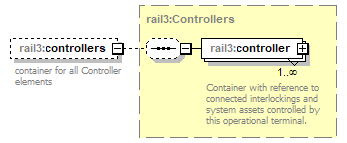 | ||||||
| namespace | https://www.railml.org/schemas/3.1 | ||||||
| type | rail3:Controllers | ||||||
| properties |
| ||||||
| children | rail3:controller | ||||||
| annotation |
| ||||||
| source | <xs:element name="controllers" type="rail3:Controllers" minOccurs="0" maxOccurs="1"> <xs:annotation> <xs:documentation>container for all Controller elements</xs:documentation> </xs:annotation> </xs:element> |
element Interlocking/signalBoxes
| diagram | 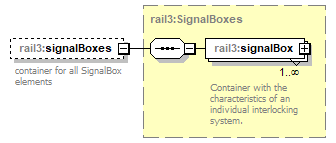 | ||||||
| namespace | https://www.railml.org/schemas/3.1 | ||||||
| type | rail3:SignalBoxes | ||||||
| properties |
| ||||||
| children | rail3:signalBox | ||||||
| annotation |
| ||||||
| source | <xs:element name="signalBoxes" type="rail3:SignalBoxes" minOccurs="0" maxOccurs="1"> <xs:annotation> <xs:documentation>container for all SignalBox elements</xs:documentation> </xs:annotation> </xs:element> |
element Interlocking/specificIMs
| diagram | 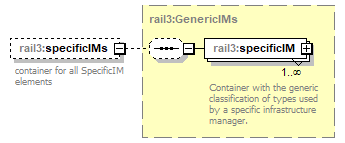 | ||||||
| namespace | https://www.railml.org/schemas/3.1 | ||||||
| type | rail3:GenericIMs | ||||||
| properties |
| ||||||
| children | rail3:specificIM | ||||||
| annotation |
| ||||||
| source | <xs:element name="specificIMs" type="rail3:GenericIMs" minOccurs="0" maxOccurs="1"> <xs:annotation> <xs:documentation>container for all SpecificIM elements</xs:documentation> </xs:annotation> </xs:element> |
complexType InterlockingInterface
| diagram | 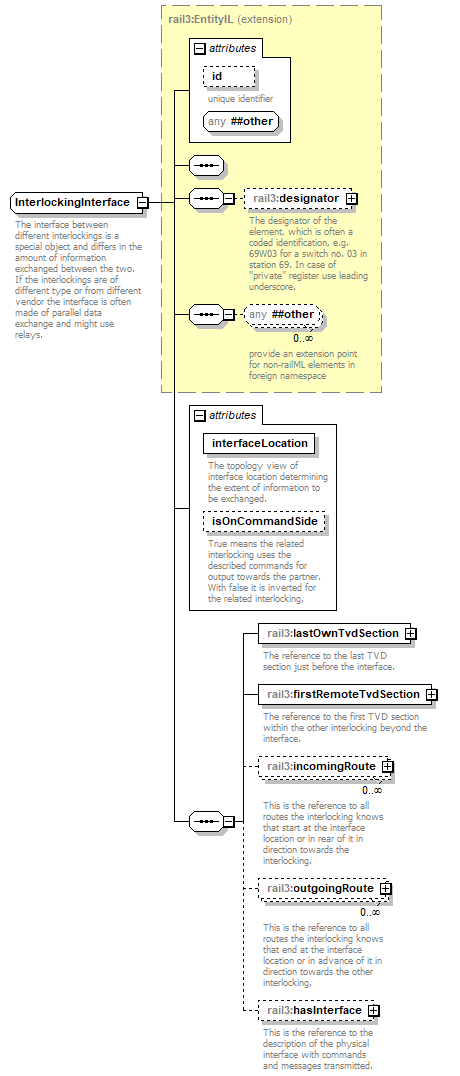 | ||||||||||||||||||||||||||||||
| namespace | https://www.railml.org/schemas/3.1 | ||||||||||||||||||||||||||||||
| type | extension of rail3:EntityIL | ||||||||||||||||||||||||||||||
| properties |
| ||||||||||||||||||||||||||||||
| children | rail3:designator rail3:lastOwnTvdSection rail3:firstRemoteTvdSection rail3:incomingRoute rail3:outgoingRoute rail3:hasInterface | ||||||||||||||||||||||||||||||
| used by |
| ||||||||||||||||||||||||||||||
| attributes |
| ||||||||||||||||||||||||||||||
| annotation |
| ||||||||||||||||||||||||||||||
| source | <xs:complexType name="InterlockingInterface"> <xs:annotation> <xs:documentation>The interface between different interlockings is a special object and differs in the amount of information exchanged between the two. If the interlockings are of different type or from different vendor the interface is often made of parallel data exchange and might use relays.</xs:documentation> </xs:annotation> <xs:complexContent> <xs:extension base="rail3:EntityIL"> <xs:sequence> <xs:element name="lastOwnTvdSection" type="rail3:EntityILref" minOccurs="1" maxOccurs="1"> <xs:annotation> <xs:documentation>The reference to the last TVD section just before the interface.</xs:documentation> </xs:annotation> </xs:element> <xs:element name="firstRemoteTvdSection" type="rail3:EntityILref" minOccurs="1" maxOccurs="1"> <xs:annotation> <xs:documentation>The reference to the first TVD section within the other interlocking beyond the interface.</xs:documentation> </xs:annotation> </xs:element> <xs:element name="incomingRoute" type="rail3:EntityILref" minOccurs="0" maxOccurs="unbounded"> <xs:annotation> <xs:documentation>This is the reference to all routes the interlocking knows that start at the interface location or in rear of it in direction towards the interlocking.</xs:documentation> </xs:annotation> </xs:element> <xs:element name="outgoingRoute" type="rail3:EntityILref" minOccurs="0" maxOccurs="unbounded"> <xs:annotation> <xs:documentation>This is the reference to all routes the interlocking knows that end at the interface location or in advance of it in direction towards the other interlocking.</xs:documentation> </xs:annotation> </xs:element> <xs:element name="hasInterface" type="rail3:EntityILref" minOccurs="0" maxOccurs="1"> <xs:annotation> <xs:documentation>This is the reference to the description of the physical interface with commands and messages transmitted.</xs:documentation> </xs:annotation> </xs:element> </xs:sequence> <xs:attribute name="interfaceLocation" type="rail3:tIxlInterfaceLocationTypeList" use="required"> <xs:annotation> <xs:documentation>The topology view of interface location determining the extent of information to be exchanged.</xs:documentation> </xs:annotation> </xs:attribute> <xs:attribute name="isOnCommandSide" type="xs:boolean" use="optional"> <xs:annotation> <xs:documentation>True means the related interlocking uses the described commands for output towards the partner. With false it is inverted for the related interlocking.</xs:documentation> </xs:annotation> </xs:attribute> </xs:extension> </xs:complexContent> </xs:complexType> |
attribute InterlockingInterface/@interfaceLocation
| type | rail3:tIxlInterfaceLocationTypeList | ||||||||||||
| properties |
| ||||||||||||
| facets |
| ||||||||||||
| annotation |
| ||||||||||||
| source | <xs:attribute name="interfaceLocation" type="rail3:tIxlInterfaceLocationTypeList" use="required"> <xs:annotation> <xs:documentation>The topology view of interface location determining the extent of information to be exchanged.</xs:documentation> </xs:annotation> </xs:attribute> |
attribute InterlockingInterface/@isOnCommandSide
| type | xs:boolean | ||
| properties |
| ||
| annotation |
| ||
| source | <xs:attribute name="isOnCommandSide" type="xs:boolean" use="optional"> <xs:annotation> <xs:documentation>True means the related interlocking uses the described commands for output towards the partner. With false it is inverted for the related interlocking.</xs:documentation> </xs:annotation> </xs:attribute> |
element InterlockingInterface/lastOwnTvdSection
| diagram | 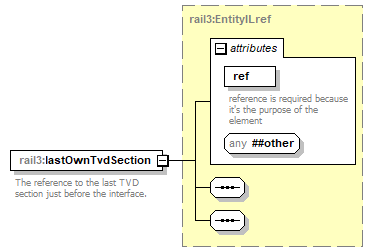 | ||||||||||||||
| namespace | https://www.railml.org/schemas/3.1 | ||||||||||||||
| type | rail3:EntityILref | ||||||||||||||
| properties |
| ||||||||||||||
| attributes |
| ||||||||||||||
| annotation |
| ||||||||||||||
| source | <xs:element name="lastOwnTvdSection" type="rail3:EntityILref" minOccurs="1" maxOccurs="1"> <xs:annotation> <xs:documentation>The reference to the last TVD section just before the interface.</xs:documentation> </xs:annotation> </xs:element> |
element InterlockingInterface/firstRemoteTvdSection
| diagram | 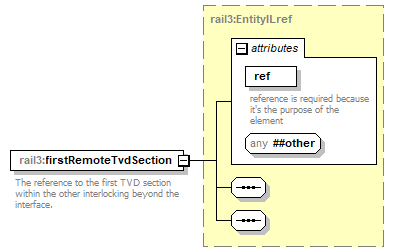 | ||||||||||||||
| namespace | https://www.railml.org/schemas/3.1 | ||||||||||||||
| type | rail3:EntityILref | ||||||||||||||
| properties |
| ||||||||||||||
| attributes |
| ||||||||||||||
| annotation |
| ||||||||||||||
| source | <xs:element name="firstRemoteTvdSection" type="rail3:EntityILref" minOccurs="1" maxOccurs="1"> <xs:annotation> <xs:documentation>The reference to the first TVD section within the other interlocking beyond the interface.</xs:documentation> </xs:annotation> </xs:element> |
element InterlockingInterface/incomingRoute
| diagram | 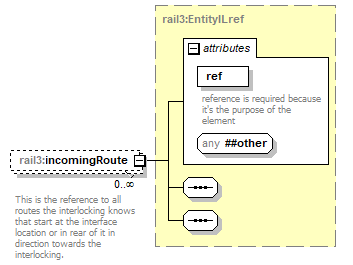 | ||||||||||||||
| namespace | https://www.railml.org/schemas/3.1 | ||||||||||||||
| type | rail3:EntityILref | ||||||||||||||
| properties |
| ||||||||||||||
| attributes |
| ||||||||||||||
| annotation |
| ||||||||||||||
| source | <xs:element name="incomingRoute" type="rail3:EntityILref" minOccurs="0" maxOccurs="unbounded"> <xs:annotation> <xs:documentation>This is the reference to all routes the interlocking knows that start at the interface location or in rear of it in direction towards the interlocking.</xs:documentation> </xs:annotation> </xs:element> |
element InterlockingInterface/outgoingRoute
| diagram | 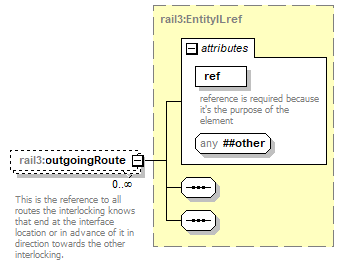 | ||||||||||||||
| namespace | https://www.railml.org/schemas/3.1 | ||||||||||||||
| type | rail3:EntityILref | ||||||||||||||
| properties |
| ||||||||||||||
| attributes |
| ||||||||||||||
| annotation |
| ||||||||||||||
| source | <xs:element name="outgoingRoute" type="rail3:EntityILref" minOccurs="0" maxOccurs="unbounded"> <xs:annotation> <xs:documentation>This is the reference to all routes the interlocking knows that end at the interface location or in advance of it in direction towards the other interlocking.</xs:documentation> </xs:annotation> </xs:element> |
element InterlockingInterface/hasInterface
| diagram | 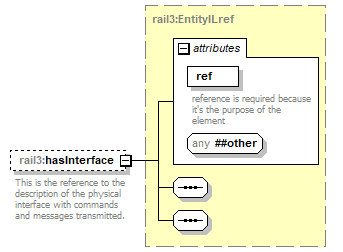 | ||||||||||||||
| namespace | https://www.railml.org/schemas/3.1 | ||||||||||||||
| type | rail3:EntityILref | ||||||||||||||
| properties |
| ||||||||||||||
| attributes |
| ||||||||||||||
| annotation |
| ||||||||||||||
| source | <xs:element name="hasInterface" type="rail3:EntityILref" minOccurs="0" maxOccurs="1"> <xs:annotation> <xs:documentation>This is the reference to the description of the physical interface with commands and messages transmitted.</xs:documentation> </xs:annotation> </xs:element> |
complexType Itineraries
| diagram |  | ||
| namespace | https://www.railml.org/schemas/3.1 | ||
| children | rail3:itinerary | ||
| used by |
| ||
| annotation |
| ||
| source | <xs:complexType name="Itineraries"> <xs:annotation> <xs:documentation>container for all itinerary elements describing train paths through the network</xs:documentation> </xs:annotation> <xs:sequence> <xs:element name="itinerary" type="rail3:CombinedRoute" minOccurs="1" maxOccurs="unbounded"> <xs:annotation> <xs:documentation>Itinerary is a combination of single routes defining the path from A to B independent of involved signalBoxes (interlockings).</xs:documentation> </xs:annotation> </xs:element> </xs:sequence> </xs:complexType> |
element Itineraries/itinerary
| diagram | 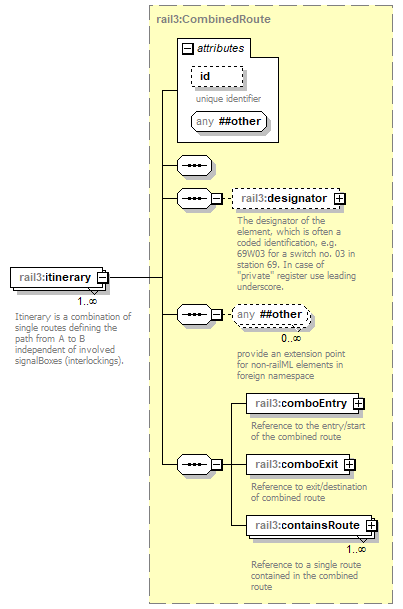 | ||||||||||||||
| namespace | https://www.railml.org/schemas/3.1 | ||||||||||||||
| type | rail3:CombinedRoute | ||||||||||||||
| properties |
| ||||||||||||||
| children | rail3:designator rail3:comboEntry rail3:comboExit rail3:containsRoute | ||||||||||||||
| attributes |
| ||||||||||||||
| annotation |
| ||||||||||||||
| source | <xs:element name="itinerary" type="rail3:CombinedRoute" minOccurs="1" maxOccurs="unbounded"> <xs:annotation> <xs:documentation>Itinerary is a combination of single routes defining the path from A to B independent of involved signalBoxes (interlockings).</xs:documentation> </xs:annotation> </xs:element> |
complexType Key
| diagram | 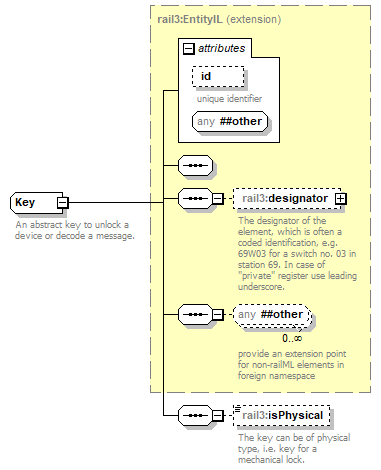 | ||||||||||||||
| namespace | https://www.railml.org/schemas/3.1 | ||||||||||||||
| type | extension of rail3:EntityIL | ||||||||||||||
| properties |
| ||||||||||||||
| children | rail3:designator rail3:isPhysical | ||||||||||||||
| used by |
| ||||||||||||||
| attributes |
| ||||||||||||||
| annotation |
| ||||||||||||||
| source | <xs:complexType name="Key"> <xs:annotation> <xs:documentation>An abstract key to unlock a device or decode a message.</xs:documentation> </xs:annotation> <xs:complexContent> <xs:extension base="rail3:EntityIL"> <xs:sequence> <xs:element name="isPhysical" type="xs:boolean" minOccurs="0" maxOccurs="1"> <xs:annotation> <xs:documentation>The key can be of physical type, i.e. key for a mechanical lock.</xs:documentation> </xs:annotation> </xs:element> </xs:sequence> </xs:extension> </xs:complexContent> </xs:complexType> |
element Key/isPhysical
| diagram |  | ||||||
| namespace | https://www.railml.org/schemas/3.1 | ||||||
| type | xs:boolean | ||||||
| properties |
| ||||||
| annotation |
| ||||||
| source | <xs:element name="isPhysical" type="xs:boolean" minOccurs="0" maxOccurs="1"> <xs:annotation> <xs:documentation>The key can be of physical type, i.e. key for a mechanical lock.</xs:documentation> </xs:annotation> </xs:element> |
complexType KeyLockIL
| diagram |  | ||||||||||||||||||||||||||||||||||||||||||||||||||||||
| namespace | https://www.railml.org/schemas/3.1 | ||||||||||||||||||||||||||||||||||||||||||||||||||||||
| type | extension of rail3:LogicalDevice | ||||||||||||||||||||||||||||||||||||||||||||||||||||||
| properties |
| ||||||||||||||||||||||||||||||||||||||||||||||||||||||
| children | rail3:designator rail3:takesControlOf rail3:hasInterface rail3:refersTo rail3:acceptsKey rail3:hasTvdSection rail3:hasSlaveLock | ||||||||||||||||||||||||||||||||||||||||||||||||||||||
| used by |
| ||||||||||||||||||||||||||||||||||||||||||||||||||||||
| attributes |
| ||||||||||||||||||||||||||||||||||||||||||||||||||||||
| annotation |
| ||||||||||||||||||||||||||||||||||||||||||||||||||||||
| source | <xs:complexType name="KeyLockIL"> <xs:annotation> <xs:documentation>A device, also known as key lock (de: Schlüsselschalter) situated near the track. It is used to request local control of a (group of) track assets from the interlocking. Commonly, staff requests local control from the interlocking via this device. Once granted, the key can be removed upon which the (group of) track asset is no longer under interlocking control. In reverse, the interlocking takes back control when the key is inserted and staff acknowledged relinquishing control. Note that the lock is a track asset defined in infrastructure namespace. The interlocking reads the state of the lock and returns permission to remove the key, i.e. levelOfControl=fullControl. A combined lock has a master lock that controls a set of slave locks. Slave locks may have to be released in a well-defined sequence.</xs:documentation> </xs:annotation> <xs:complexContent> <xs:extension base="rail3:LogicalDevice"> <xs:sequence> <xs:element name="acceptsKey" type="rail3:EntityILref" minOccurs="0" maxOccurs="1"> <xs:annotation> <xs:documentation>The reference to the particular key used with this master lock.</xs:documentation> </xs:annotation> </xs:element> <xs:element name="hasTvdSection" type="rail3:EntityILref" minOccurs="0" maxOccurs="1"> <xs:annotation> <xs:documentation>The reference to the TVD section related to this master lock. This is especially used for siding key locks on open line.</xs:documentation> </xs:annotation> </xs:element> <xs:element name="hasSlaveLock" type="rail3:EntityILref" minOccurs="0" maxOccurs="unbounded"> <xs:annotation> <xs:documentation>reference to a dependent KeyReleaseInstrument</xs:documentation> </xs:annotation> </xs:element> </xs:sequence> <xs:attribute name="hasAutomaticKeyRelease" type="xs:boolean" use="optional"> <xs:annotation> <xs:documentation>The key of a siding on open line may be released automatically when the related TVD section (trigger) becomes occupied.</xs:documentation> </xs:annotation> </xs:attribute> <xs:attribute name="hasAutomaticKeyLock" type="xs:boolean" use="optional"> <xs:annotation> <xs:documentation>The key may be automatically relocked when returned into the lock. Thus the key can be used only once.</xs:documentation> </xs:annotation> </xs:attribute> <xs:attribute name="keyRequestTime" type="xs:duration" use="optional"> <xs:annotation> <xs:documentation>The time period a request for key release is indicated to the operator.</xs:documentation> </xs:annotation> </xs:attribute> <xs:attribute name="keyAuthoriseTime" type="xs:duration" use="optional"> <xs:annotation> <xs:documentation>The time period the key release is active after commanded by the operator. Afterwards a not removed key will be automatically relocked again.</xs:documentation> </xs:annotation> </xs:attribute> </xs:extension> </xs:complexContent> </xs:complexType> |
attribute KeyLockIL/@hasAutomaticKeyRelease
| type | xs:boolean | ||
| properties |
| ||
| annotation |
| ||
| source | <xs:attribute name="hasAutomaticKeyRelease" type="xs:boolean" use="optional"> <xs:annotation> <xs:documentation>The key of a siding on open line may be released automatically when the related TVD section (trigger) becomes occupied.</xs:documentation> </xs:annotation> </xs:attribute> |
attribute KeyLockIL/@hasAutomaticKeyLock
| type | xs:boolean | ||
| properties |
| ||
| annotation |
| ||
| source | <xs:attribute name="hasAutomaticKeyLock" type="xs:boolean" use="optional"> <xs:annotation> <xs:documentation>The key may be automatically relocked when returned into the lock. Thus the key can be used only once.</xs:documentation> </xs:annotation> </xs:attribute> |
attribute KeyLockIL/@keyRequestTime
| type | xs:duration | ||
| properties |
| ||
| annotation |
| ||
| source | <xs:attribute name="keyRequestTime" type="xs:duration" use="optional"> <xs:annotation> <xs:documentation>The time period a request for key release is indicated to the operator.</xs:documentation> </xs:annotation> </xs:attribute> |
attribute KeyLockIL/@keyAuthoriseTime
| type | xs:duration | ||
| properties |
| ||
| annotation |
| ||
| source | <xs:attribute name="keyAuthoriseTime" type="xs:duration" use="optional"> <xs:annotation> <xs:documentation>The time period the key release is active after commanded by the operator. Afterwards a not removed key will be automatically relocked again.</xs:documentation> </xs:annotation> </xs:attribute> |
element KeyLockIL/acceptsKey
| diagram | 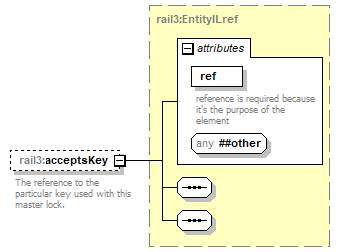 | ||||||||||||||
| namespace | https://www.railml.org/schemas/3.1 | ||||||||||||||
| type | rail3:EntityILref | ||||||||||||||
| properties |
| ||||||||||||||
| attributes |
| ||||||||||||||
| annotation |
| ||||||||||||||
| source | <xs:element name="acceptsKey" type="rail3:EntityILref" minOccurs="0" maxOccurs="1"> <xs:annotation> <xs:documentation>The reference to the particular key used with this master lock.</xs:documentation> </xs:annotation> </xs:element> |
element KeyLockIL/hasTvdSection
| diagram | 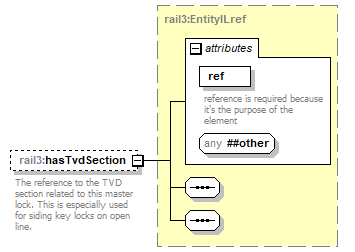 | ||||||||||||||
| namespace | https://www.railml.org/schemas/3.1 | ||||||||||||||
| type | rail3:EntityILref | ||||||||||||||
| properties |
| ||||||||||||||
| attributes |
| ||||||||||||||
| annotation |
| ||||||||||||||
| source | <xs:element name="hasTvdSection" type="rail3:EntityILref" minOccurs="0" maxOccurs="1"> <xs:annotation> <xs:documentation>The reference to the TVD section related to this master lock. This is especially used for siding key locks on open line.</xs:documentation> </xs:annotation> </xs:element> |
element KeyLockIL/hasSlaveLock
| diagram | 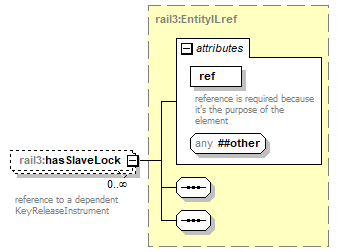 | ||||||||||||||
| namespace | https://www.railml.org/schemas/3.1 | ||||||||||||||
| type | rail3:EntityILref | ||||||||||||||
| properties |
| ||||||||||||||
| attributes |
| ||||||||||||||
| annotation |
| ||||||||||||||
| source | <xs:element name="hasSlaveLock" type="rail3:EntityILref" minOccurs="0" maxOccurs="unbounded"> <xs:annotation> <xs:documentation>reference to a dependent KeyReleaseInstrument</xs:documentation> </xs:annotation> </xs:element> |
complexType KeyLockInState
| diagram | 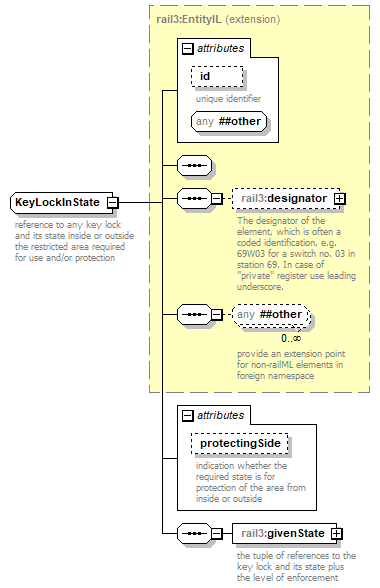 | ||||||||||||||||||||||
| namespace | https://www.railml.org/schemas/3.1 | ||||||||||||||||||||||
| type | extension of rail3:EntityIL | ||||||||||||||||||||||
| properties |
| ||||||||||||||||||||||
| children | rail3:designator rail3:givenState | ||||||||||||||||||||||
| used by |
| ||||||||||||||||||||||
| attributes |
| ||||||||||||||||||||||
| annotation |
| ||||||||||||||||||||||
| source | <xs:complexType name="KeyLockInState"> <xs:annotation> <xs:documentation>reference to any key lock and its state inside or outside the restricted area required for use and/or protection</xs:documentation> </xs:annotation> <xs:complexContent> <xs:extension base="rail3:EntityIL"> <xs:sequence> <xs:element name="givenState" type="rail3:LockAndGivenState" minOccurs="1" maxOccurs="1"> <xs:annotation> <xs:documentation>the tuple of references to the key lock and its state plus the level of enforcement</xs:documentation> </xs:annotation> </xs:element> </xs:sequence> <xs:attribute name="protectingSide" type="rail3:tProtectingSideList" use="optional"> <xs:annotation> <xs:documentation>indication whether the required state is for protection of the area from inside or outside</xs:documentation> </xs:annotation> </xs:attribute> </xs:extension> </xs:complexContent> </xs:complexType> |
attribute KeyLockInState/@protectingSide
| type | rail3:tProtectingSideList | ||||||||||||
| properties |
| ||||||||||||
| facets |
| ||||||||||||
| annotation |
| ||||||||||||
| source | <xs:attribute name="protectingSide" type="rail3:tProtectingSideList" use="optional"> <xs:annotation> <xs:documentation>indication whether the required state is for protection of the area from inside or outside</xs:documentation> </xs:annotation> </xs:attribute> |
element KeyLockInState/givenState
| diagram | 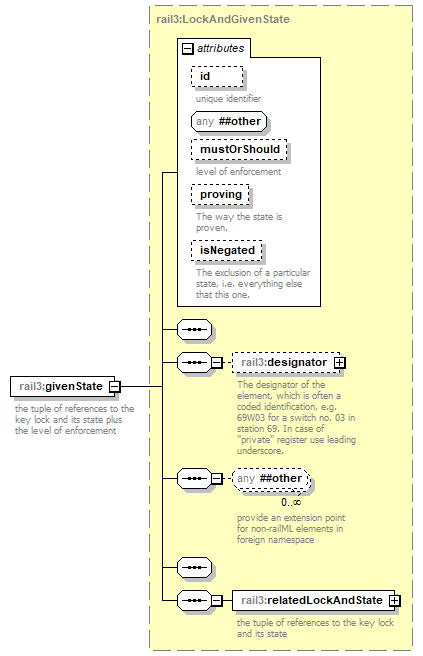 | ||||||||||||||||||||||||||||||||||||||
| namespace | https://www.railml.org/schemas/3.1 | ||||||||||||||||||||||||||||||||||||||
| type | rail3:LockAndGivenState | ||||||||||||||||||||||||||||||||||||||
| properties |
| ||||||||||||||||||||||||||||||||||||||
| children | rail3:designator rail3:relatedLockAndState | ||||||||||||||||||||||||||||||||||||||
| attributes |
| ||||||||||||||||||||||||||||||||||||||
| annotation |
| ||||||||||||||||||||||||||||||||||||||
| source | <xs:element name="givenState" type="rail3:LockAndGivenState" minOccurs="1" maxOccurs="1"> <xs:annotation> <xs:documentation>the tuple of references to the key lock and its state plus the level of enforcement</xs:documentation> </xs:annotation> </xs:element> |
complexType KeyLocksIL
| diagram | 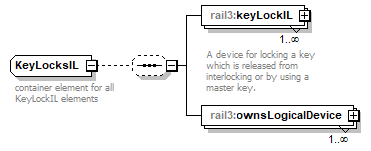 | ||
| namespace | https://www.railml.org/schemas/3.1 | ||
| children | rail3:keyLockIL rail3:ownsLogicalDevice | ||
| used by |
| ||
| annotation |
| ||
| source | <xs:complexType name="KeyLocksIL"> <xs:annotation> <xs:documentation>container element for all KeyLockIL elements</xs:documentation> </xs:annotation> <xs:sequence minOccurs="0" maxOccurs="1"> <xs:element name="keyLockIL" type="rail3:KeyLockIL" minOccurs="1" maxOccurs="unbounded"> <xs:annotation> <xs:documentation>A device for locking a key which is released from interlocking or by using a master key.</xs:documentation> </xs:annotation> </xs:element> <xs:element name="ownsLogicalDevice" type="rail3:LogicalDevice" minOccurs="1" maxOccurs="unbounded"/> </xs:sequence> </xs:complexType> |
element KeyLocksIL/keyLockIL
| diagram |  | ||||||||||||||||||||||||||||||||||||||||||||||||||||||
| namespace | https://www.railml.org/schemas/3.1 | ||||||||||||||||||||||||||||||||||||||||||||||||||||||
| type | rail3:KeyLockIL | ||||||||||||||||||||||||||||||||||||||||||||||||||||||
| properties |
| ||||||||||||||||||||||||||||||||||||||||||||||||||||||
| children | rail3:designator rail3:takesControlOf rail3:hasInterface rail3:refersTo rail3:acceptsKey rail3:hasTvdSection rail3:hasSlaveLock | ||||||||||||||||||||||||||||||||||||||||||||||||||||||
| attributes |
| ||||||||||||||||||||||||||||||||||||||||||||||||||||||
| annotation |
| ||||||||||||||||||||||||||||||||||||||||||||||||||||||
| source | <xs:element name="keyLockIL" type="rail3:KeyLockIL" minOccurs="1" maxOccurs="unbounded"> <xs:annotation> <xs:documentation>A device for locking a key which is released from interlocking or by using a master key.</xs:documentation> </xs:annotation> </xs:element> |
element KeyLocksIL/ownsLogicalDevice
| diagram | 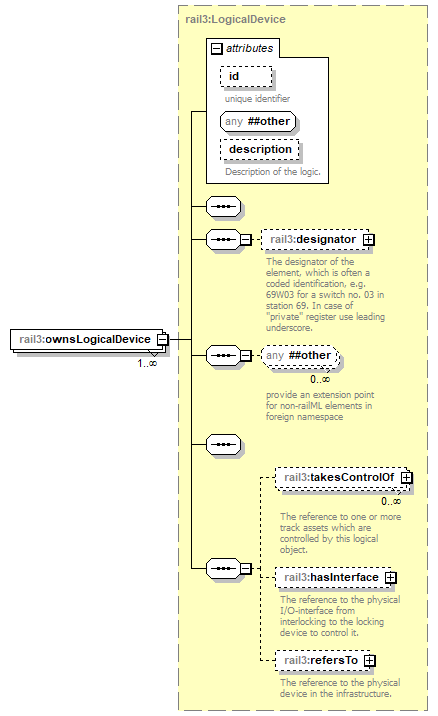 | ||||||||||||||||||||||
| namespace | https://www.railml.org/schemas/3.1 | ||||||||||||||||||||||
| type | rail3:LogicalDevice | ||||||||||||||||||||||
| properties |
| ||||||||||||||||||||||
| children | rail3:designator rail3:takesControlOf rail3:hasInterface rail3:refersTo | ||||||||||||||||||||||
| attributes |
| ||||||||||||||||||||||
| source | <xs:element name="ownsLogicalDevice" type="rail3:LogicalDevice" minOccurs="1" maxOccurs="unbounded"/> |
complexType Keys
| diagram |  | ||
| namespace | https://www.railml.org/schemas/3.1 | ||
| children | rail3:key | ||
| used by |
| ||
| annotation |
| ||
| source | <xs:complexType name="Keys"> <xs:annotation> <xs:documentation>container element for all Key elements</xs:documentation> </xs:annotation> <xs:sequence minOccurs="0" maxOccurs="1"> <xs:element name="key" type="rail3:Key" minOccurs="1" maxOccurs="unbounded"> <xs:annotation> <xs:documentation>An ancillary element used for operation of a specific locking device. </xs:documentation> </xs:annotation> </xs:element> </xs:sequence> </xs:complexType> |
element Keys/key
| diagram | 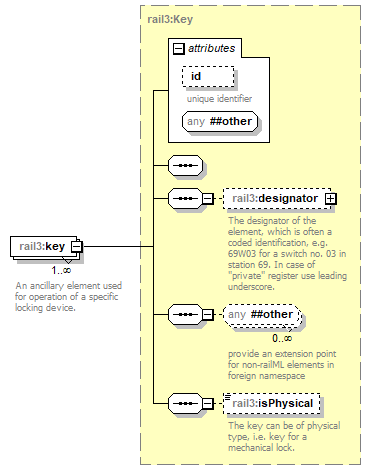 | ||||||||||||||
| namespace | https://www.railml.org/schemas/3.1 | ||||||||||||||
| type | rail3:Key | ||||||||||||||
| properties |
| ||||||||||||||
| children | rail3:designator rail3:isPhysical | ||||||||||||||
| attributes |
| ||||||||||||||
| annotation |
| ||||||||||||||
| source | <xs:element name="key" type="rail3:Key" minOccurs="1" maxOccurs="unbounded"> <xs:annotation> <xs:documentation>An ancillary element used for operation of a specific locking device. </xs:documentation> </xs:annotation> </xs:element> |
complexType LevelCrossingAndGivenState
| diagram | 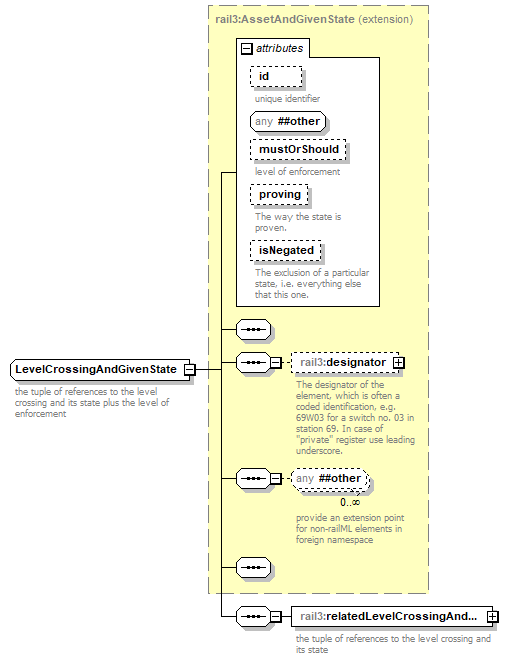 | ||||||||||||||||||||||||||||||||||||||
| namespace | https://www.railml.org/schemas/3.1 | ||||||||||||||||||||||||||||||||||||||
| type | extension of rail3:AssetAndGivenState | ||||||||||||||||||||||||||||||||||||||
| properties |
| ||||||||||||||||||||||||||||||||||||||
| children | rail3:designator rail3:relatedLevelCrossingAndState | ||||||||||||||||||||||||||||||||||||||
| used by |
| ||||||||||||||||||||||||||||||||||||||
| attributes |
| ||||||||||||||||||||||||||||||||||||||
| annotation |
| ||||||||||||||||||||||||||||||||||||||
| source | <xs:complexType name="LevelCrossingAndGivenState"> <xs:annotation> <xs:documentation>the tuple of references to the level crossing and its state plus the level of enforcement</xs:documentation> </xs:annotation> <xs:complexContent> <xs:extension base="rail3:AssetAndGivenState"> <xs:sequence> <xs:element name="relatedLevelCrossingAndState" type="rail3:LevelCrossingAndState" minOccurs="1" maxOccurs="1"> <xs:annotation> <xs:documentation>the tuple of references to the level crossing and its state</xs:documentation> </xs:annotation> </xs:element> </xs:sequence> </xs:extension> </xs:complexContent> </xs:complexType> |
element LevelCrossingAndGivenState/relatedLevelCrossingAndState
| diagram | 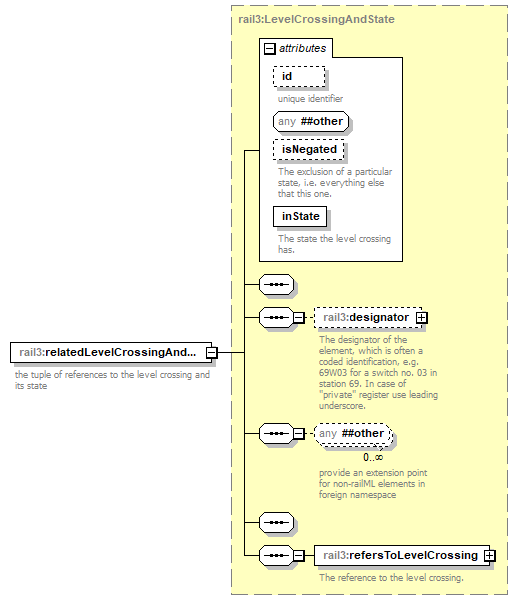 | ||||||||||||||||||||||||||||||
| namespace | https://www.railml.org/schemas/3.1 | ||||||||||||||||||||||||||||||
| type | rail3:LevelCrossingAndState | ||||||||||||||||||||||||||||||
| properties |
| ||||||||||||||||||||||||||||||
| children | rail3:designator rail3:refersToLevelCrossing | ||||||||||||||||||||||||||||||
| attributes |
| ||||||||||||||||||||||||||||||
| annotation |
| ||||||||||||||||||||||||||||||
| source | <xs:element name="relatedLevelCrossingAndState" type="rail3:LevelCrossingAndState" minOccurs="1" maxOccurs="1"> <xs:annotation> <xs:documentation>the tuple of references to the level crossing and its state</xs:documentation> </xs:annotation> </xs:element> |
complexType LevelCrossingAndState
| diagram | 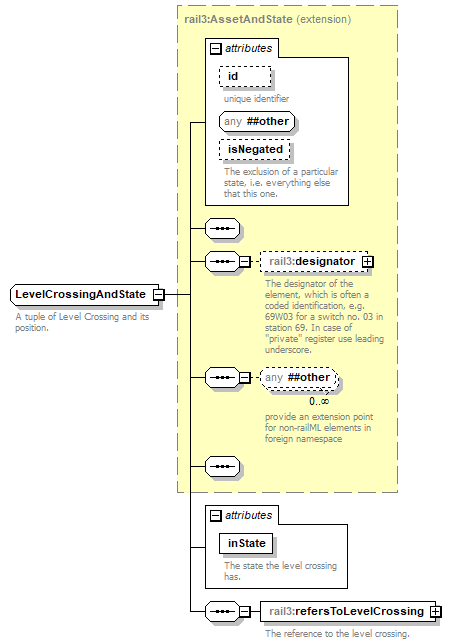 | ||||||||||||||||||||||||||||||
| namespace | https://www.railml.org/schemas/3.1 | ||||||||||||||||||||||||||||||
| type | extension of rail3:AssetAndState | ||||||||||||||||||||||||||||||
| properties |
| ||||||||||||||||||||||||||||||
| children | rail3:designator rail3:refersToLevelCrossing | ||||||||||||||||||||||||||||||
| used by |
| ||||||||||||||||||||||||||||||
| attributes |
| ||||||||||||||||||||||||||||||
| annotation |
| ||||||||||||||||||||||||||||||
| source | <xs:complexType name="LevelCrossingAndState"> <xs:annotation> <xs:documentation>A tuple of Level Crossing and its position.</xs:documentation> </xs:annotation> <xs:complexContent> <xs:extension base="rail3:AssetAndState"> <xs:sequence> <xs:element name="refersToLevelCrossing" type="rail3:EntityILref" minOccurs="1" maxOccurs="1"> <xs:annotation> <xs:documentation>The reference to the level crossing.</xs:documentation> </xs:annotation> </xs:element> </xs:sequence> <xs:attribute name="inState" type="rail3:tLevelCrossingState" use="required"> <xs:annotation> <xs:documentation>The state the level crossing has.</xs:documentation> </xs:annotation> </xs:attribute> </xs:extension> </xs:complexContent> </xs:complexType> |
attribute LevelCrossingAndState/@inState
| type | rail3:tLevelCrossingState | ||||||||||||||||||
| properties |
| ||||||||||||||||||
| facets |
| ||||||||||||||||||
| annotation |
| ||||||||||||||||||
| source | <xs:attribute name="inState" type="rail3:tLevelCrossingState" use="required"> <xs:annotation> <xs:documentation>The state the level crossing has.</xs:documentation> </xs:annotation> </xs:attribute> |
element LevelCrossingAndState/refersToLevelCrossing
| diagram | 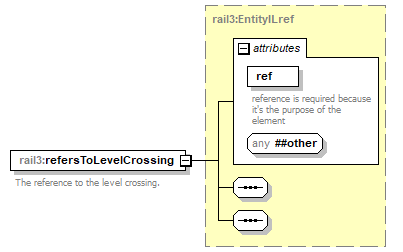 | ||||||||||||||
| namespace | https://www.railml.org/schemas/3.1 | ||||||||||||||
| type | rail3:EntityILref | ||||||||||||||
| properties |
| ||||||||||||||
| attributes |
| ||||||||||||||
| annotation |
| ||||||||||||||
| source | <xs:element name="refersToLevelCrossing" type="rail3:EntityILref" minOccurs="1" maxOccurs="1"> <xs:annotation> <xs:documentation>The reference to the level crossing.</xs:documentation> </xs:annotation> </xs:element> |
complexType LevelCrossingDeactivator
| diagram | 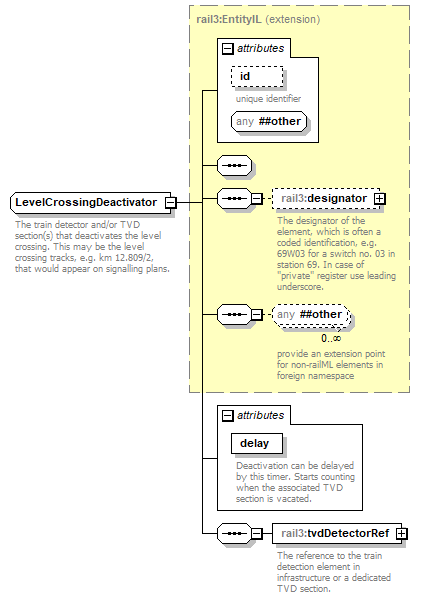 | ||||||||||||||||||||||
| namespace | https://www.railml.org/schemas/3.1 | ||||||||||||||||||||||
| type | extension of rail3:EntityIL | ||||||||||||||||||||||
| properties |
| ||||||||||||||||||||||
| children | rail3:designator rail3:tvdDetectorRef | ||||||||||||||||||||||
| used by |
| ||||||||||||||||||||||
| attributes |
| ||||||||||||||||||||||
| annotation |
| ||||||||||||||||||||||
| source | <xs:complexType name="LevelCrossingDeactivator"> <xs:annotation> <xs:documentation>The train detector and/or TVD section(s) that deactivates the level crossing. This may be the level crossing tracks, e.g. km 12.809/2, that would appear on signalling plans.</xs:documentation> </xs:annotation> <xs:complexContent> <xs:extension base="rail3:EntityIL"> <xs:sequence> <xs:element name="tvdDetectorRef" type="rail3:EntityILref" minOccurs="1" maxOccurs="1"> <xs:annotation> <xs:documentation>The reference to the train detection element in infrastructure or a dedicated TVD section.</xs:documentation> </xs:annotation> </xs:element> </xs:sequence> <xs:attribute name="delay" type="xs:duration" use="required"> <xs:annotation> <xs:documentation>Deactivation can be delayed by this timer. Starts counting when the associated TVD section is vacated.</xs:documentation> </xs:annotation> </xs:attribute> </xs:extension> </xs:complexContent> </xs:complexType> |
attribute LevelCrossingDeactivator/@delay
| type | xs:duration | ||
| properties |
| ||
| annotation |
| ||
| source | <xs:attribute name="delay" type="xs:duration" use="required"> <xs:annotation> <xs:documentation>Deactivation can be delayed by this timer. Starts counting when the associated TVD section is vacated.</xs:documentation> </xs:annotation> </xs:attribute> |
element LevelCrossingDeactivator/tvdDetectorRef
| diagram | 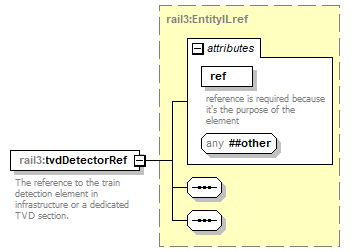 | ||||||||||||||
| namespace | https://www.railml.org/schemas/3.1 | ||||||||||||||
| type | rail3:EntityILref | ||||||||||||||
| properties |
| ||||||||||||||
| attributes |
| ||||||||||||||
| annotation |
| ||||||||||||||
| source | <xs:element name="tvdDetectorRef" type="rail3:EntityILref" minOccurs="1" maxOccurs="1"> <xs:annotation> <xs:documentation>The reference to the train detection element in infrastructure or a dedicated TVD section.</xs:documentation> </xs:annotation> </xs:element> |
complexType LevelCrossingIL
| diagram |  | ||||||||||||||||||||||||||||||||||||||||||||||||||||||||||||||||||||||
| namespace | https://www.railml.org/schemas/3.1 | ||||||||||||||||||||||||||||||||||||||||||||||||||||||||||||||||||||||
| type | extension of rail3:TrackAsset | ||||||||||||||||||||||||||||||||||||||||||||||||||||||||||||||||||||||
| properties |
| ||||||||||||||||||||||||||||||||||||||||||||||||||||||||||||||||||||||
| children | rail3:designator rail3:hasInterface rail3:isLevelCrossingType rail3:refersTo rail3:deactivatedBy rail3:activationCondition rail3:hasTvdSection | ||||||||||||||||||||||||||||||||||||||||||||||||||||||||||||||||||||||
| used by |
| ||||||||||||||||||||||||||||||||||||||||||||||||||||||||||||||||||||||
| attributes |
| ||||||||||||||||||||||||||||||||||||||||||||||||||||||||||||||||||||||
| annotation |
| ||||||||||||||||||||||||||||||||||||||||||||||||||||||||||||||||||||||
| source | <xs:complexType name="LevelCrossingIL"> <xs:annotation> <xs:documentation>A level crossing (LX) is activated, i.e. requested to close for road traffic, upon train approach. This happens when the train crosses a detection point, i.e. an insulated track joint, axle counter or treadle. These approach detectors are commonly referred to as Approach Starting (AS).</xs:documentation> </xs:annotation> <xs:complexContent> <xs:extension base="rail3:TrackAsset"> <xs:sequence> <xs:element name="hasInterface" type="rail3:EntityILref" minOccurs="0" maxOccurs="1"> <xs:annotation> <xs:documentation>Reference to physical description of level crossing interface with list of commands to the field and notifications from the field</xs:documentation> </xs:annotation> </xs:element> <xs:element name="isLevelCrossingType" type="rail3:EntityILref" minOccurs="1" maxOccurs="1"> <xs:annotation> <xs:documentation>Reference to the basic type of level crossing. It refers to a basic configuration of a level crossing for this IM.</xs:documentation> </xs:annotation> </xs:element> <xs:element name="refersTo" type="rail3:EntityILref" minOccurs="1" maxOccurs="1"> <xs:annotation> <xs:documentation>The reference to the physical level crossing in infrastructure.</xs:documentation> </xs:annotation> </xs:element> <xs:element name="deactivatedBy" type="rail3:LevelCrossingDeactivator" minOccurs="0" maxOccurs="unbounded"> <xs:annotation> <xs:documentation>The description of deactivation conditions for this level crossing.</xs:documentation> </xs:annotation> </xs:element> <xs:element name="activationCondition" type="rail3:ActivationCondition" minOccurs="0" maxOccurs="unbounded"> <xs:annotation> <xs:documentation>Description of the possible activation conditions of this level crossing.</xs:documentation> </xs:annotation> </xs:element> <xs:element name="hasTvdSection" type="rail3:EntityILref" minOccurs="0" maxOccurs="unbounded"> <xs:annotation> <xs:documentation>The reference to the TVD section(s) directly at the level crossing</xs:documentation> </xs:annotation> </xs:element> </xs:sequence> <xs:attribute name="preferredPosition" type="rail3:tLevelCrossingState" use="optional"> <xs:annotation> <xs:documentation>This is the state of level crossing under normal conditions, i.e. when not in use. For most level crossings this would be the open state.</xs:documentation> </xs:annotation> </xs:attribute> <xs:attribute name="unprotectedSpeed" type="rail3:tSpeedKmPerHour" use="optional"> <xs:annotation> <xs:documentation>Speed in km/h at which the level crossing can be passed when it is not protected (V_LX)</xs:documentation> </xs:annotation> </xs:attribute> <xs:attribute name="typicalTimeToClose" type="xs:duration" use="required"> <xs:annotation> <xs:documentation>Average time between the time a train detector notes an approaching train and the moment the level crossing is closed to road traffic, i.e. the moment that the interlocking can lock a route across the level crossing. This equates to the time it takes to close the barrier (if present). Should be set to 0 if no barrier is configured. Useful for simulation.</xs:documentation> </xs:annotation> </xs:attribute> <xs:attribute name="constantWarningTime" type="xs:duration" use="optional"> <xs:annotation> <xs:documentation>A level crossing must cause as little as possible hindering to train as well as road traffic. Therefore, the level crossing must close as late as safely possible. The optimal delay, known as constant warning time, between activation and closing is possible when the train speed and position are known.</xs:documentation> </xs:annotation> </xs:attribute> <xs:attribute name="minimumOpenTime" type="xs:duration" use="optional"> <xs:annotation> <xs:documentation>This is the time the level crossing has to be open before it is allowed to close again. This is to ensure a certain capacity for the crossing road traffic.</xs:documentation> </xs:annotation> </xs:attribute> <xs:attribute name="maximumClosedTime" type="xs:duration" use="optional"> <xs:annotation> <xs:documentation>This is the time span after a message to the operator is triggered because a level crossing being closed for too long time can be considered as unsafe. In such cases the road drivers and pedestrians might try to cross the railway line illegally.</xs:documentation> </xs:annotation> </xs:attribute> <xs:attribute name="requiresStopBeforeUnprotectedLevelCrossing" type="xs:boolean" use="optional"> <xs:annotation> <xs:documentation>Flag to define whether any train needs to stop in front of the level crossing in case it is unprotected. Only afterwards it can proceed according the value in speedRestriction.</xs:documentation> </xs:annotation> </xs:attribute> </xs:extension> </xs:complexContent> </xs:complexType> |
attribute LevelCrossingIL/@preferredPosition
| type | rail3:tLevelCrossingState | ||||||||||||||||||
| properties |
| ||||||||||||||||||
| facets |
| ||||||||||||||||||
| annotation |
| ||||||||||||||||||
| source | <xs:attribute name="preferredPosition" type="rail3:tLevelCrossingState" use="optional"> <xs:annotation> <xs:documentation>This is the state of level crossing under normal conditions, i.e. when not in use. For most level crossings this would be the open state.</xs:documentation> </xs:annotation> </xs:attribute> |
attribute LevelCrossingIL/@unprotectedSpeed
| type | rail3:tSpeedKmPerHour | ||
| properties |
| ||
| annotation |
| ||
| source | <xs:attribute name="unprotectedSpeed" type="rail3:tSpeedKmPerHour" use="optional"> <xs:annotation> <xs:documentation>Speed in km/h at which the level crossing can be passed when it is not protected (V_LX)</xs:documentation> </xs:annotation> </xs:attribute> |
attribute LevelCrossingIL/@typicalTimeToClose
| type | xs:duration | ||
| properties |
| ||
| annotation |
| ||
| source | <xs:attribute name="typicalTimeToClose" type="xs:duration" use="required"> <xs:annotation> <xs:documentation>Average time between the time a train detector notes an approaching train and the moment the level crossing is closed to road traffic, i.e. the moment that the interlocking can lock a route across the level crossing. This equates to the time it takes to close the barrier (if present). Should be set to 0 if no barrier is configured. Useful for simulation.</xs:documentation> </xs:annotation> </xs:attribute> |
attribute LevelCrossingIL/@constantWarningTime
| type | xs:duration | ||
| properties |
| ||
| annotation |
| ||
| source | <xs:attribute name="constantWarningTime" type="xs:duration" use="optional"> <xs:annotation> <xs:documentation>A level crossing must cause as little as possible hindering to train as well as road traffic. Therefore, the level crossing must close as late as safely possible. The optimal delay, known as constant warning time, between activation and closing is possible when the train speed and position are known.</xs:documentation> </xs:annotation> </xs:attribute> |
attribute LevelCrossingIL/@minimumOpenTime
| type | xs:duration | ||
| properties |
| ||
| annotation |
| ||
| source | <xs:attribute name="minimumOpenTime" type="xs:duration" use="optional"> <xs:annotation> <xs:documentation>This is the time the level crossing has to be open before it is allowed to close again. This is to ensure a certain capacity for the crossing road traffic.</xs:documentation> </xs:annotation> </xs:attribute> |
attribute LevelCrossingIL/@maximumClosedTime
| type | xs:duration | ||
| properties |
| ||
| annotation |
| ||
| source | <xs:attribute name="maximumClosedTime" type="xs:duration" use="optional"> <xs:annotation> <xs:documentation>This is the time span after a message to the operator is triggered because a level crossing being closed for too long time can be considered as unsafe. In such cases the road drivers and pedestrians might try to cross the railway line illegally.</xs:documentation> </xs:annotation> </xs:attribute> |
attribute LevelCrossingIL/@requiresStopBeforeUnprotectedLevelCrossing
| type | xs:boolean | ||
| properties |
| ||
| annotation |
| ||
| source | <xs:attribute name="requiresStopBeforeUnprotectedLevelCrossing" type="xs:boolean" use="optional"> <xs:annotation> <xs:documentation>Flag to define whether any train needs to stop in front of the level crossing in case it is unprotected. Only afterwards it can proceed according the value in speedRestriction.</xs:documentation> </xs:annotation> </xs:attribute> |
element LevelCrossingIL/hasInterface
| diagram | 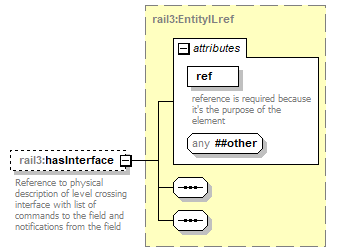 | ||||||||||||||
| namespace | https://www.railml.org/schemas/3.1 | ||||||||||||||
| type | rail3:EntityILref | ||||||||||||||
| properties |
| ||||||||||||||
| attributes |
| ||||||||||||||
| annotation |
| ||||||||||||||
| source | <xs:element name="hasInterface" type="rail3:EntityILref" minOccurs="0" maxOccurs="1"> <xs:annotation> <xs:documentation>Reference to physical description of level crossing interface with list of commands to the field and notifications from the field</xs:documentation> </xs:annotation> </xs:element> |
element LevelCrossingIL/isLevelCrossingType
| diagram | 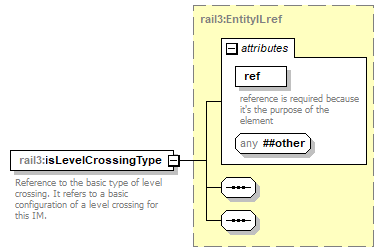 | ||||||||||||||
| namespace | https://www.railml.org/schemas/3.1 | ||||||||||||||
| type | rail3:EntityILref | ||||||||||||||
| properties |
| ||||||||||||||
| attributes |
| ||||||||||||||
| annotation |
| ||||||||||||||
| source | <xs:element name="isLevelCrossingType" type="rail3:EntityILref" minOccurs="1" maxOccurs="1"> <xs:annotation> <xs:documentation>Reference to the basic type of level crossing. It refers to a basic configuration of a level crossing for this IM.</xs:documentation> </xs:annotation> </xs:element> |
element LevelCrossingIL/refersTo
| diagram | 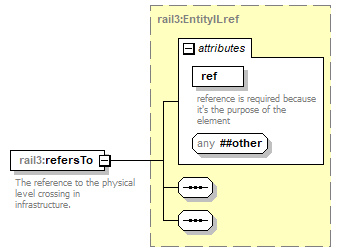 | ||||||||||||||
| namespace | https://www.railml.org/schemas/3.1 | ||||||||||||||
| type | rail3:EntityILref | ||||||||||||||
| properties |
| ||||||||||||||
| attributes |
| ||||||||||||||
| annotation |
| ||||||||||||||
| source | <xs:element name="refersTo" type="rail3:EntityILref" minOccurs="1" maxOccurs="1"> <xs:annotation> <xs:documentation>The reference to the physical level crossing in infrastructure.</xs:documentation> </xs:annotation> </xs:element> |
element LevelCrossingIL/deactivatedBy
| diagram | 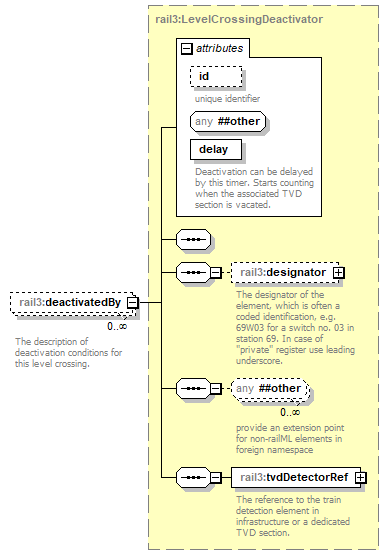 | ||||||||||||||||||||||
| namespace | https://www.railml.org/schemas/3.1 | ||||||||||||||||||||||
| type | rail3:LevelCrossingDeactivator | ||||||||||||||||||||||
| properties |
| ||||||||||||||||||||||
| children | rail3:designator rail3:tvdDetectorRef | ||||||||||||||||||||||
| attributes |
| ||||||||||||||||||||||
| annotation |
| ||||||||||||||||||||||
| source | <xs:element name="deactivatedBy" type="rail3:LevelCrossingDeactivator" minOccurs="0" maxOccurs="unbounded"> <xs:annotation> <xs:documentation>The description of deactivation conditions for this level crossing.</xs:documentation> </xs:annotation> </xs:element> |
element LevelCrossingIL/activationCondition
| diagram | 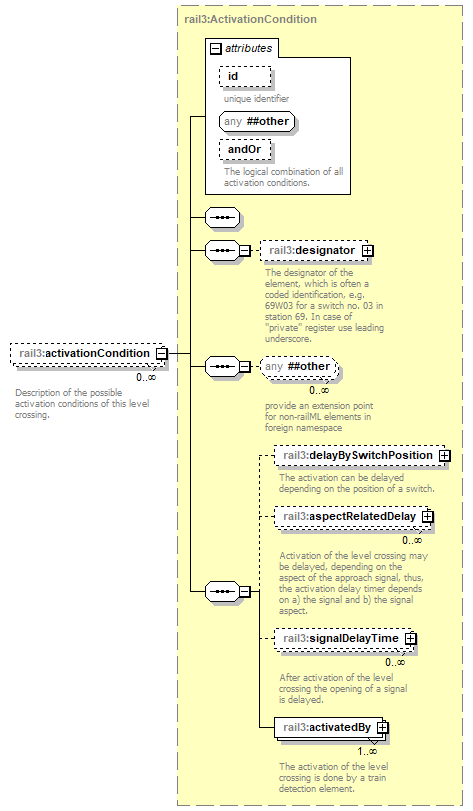 | ||||||||||||||||||||||
| namespace | https://www.railml.org/schemas/3.1 | ||||||||||||||||||||||
| type | rail3:ActivationCondition | ||||||||||||||||||||||
| properties |
| ||||||||||||||||||||||
| children | rail3:designator rail3:delayBySwitchPosition rail3:aspectRelatedDelay rail3:signalDelayTime rail3:activatedBy | ||||||||||||||||||||||
| attributes |
| ||||||||||||||||||||||
| annotation |
| ||||||||||||||||||||||
| source | <xs:element name="activationCondition" type="rail3:ActivationCondition" minOccurs="0" maxOccurs="unbounded"> <xs:annotation> <xs:documentation>Description of the possible activation conditions of this level crossing.</xs:documentation> </xs:annotation> </xs:element> |
element LevelCrossingIL/hasTvdSection
| diagram | 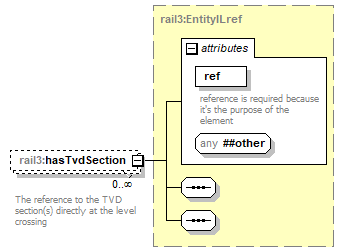 | ||||||||||||||
| namespace | https://www.railml.org/schemas/3.1 | ||||||||||||||
| type | rail3:EntityILref | ||||||||||||||
| properties |
| ||||||||||||||
| attributes |
| ||||||||||||||
| annotation |
| ||||||||||||||
| source | <xs:element name="hasTvdSection" type="rail3:EntityILref" minOccurs="0" maxOccurs="unbounded"> <xs:annotation> <xs:documentation>The reference to the TVD section(s) directly at the level crossing</xs:documentation> </xs:annotation> </xs:element> |
complexType LevelCrossingInState
| diagram | 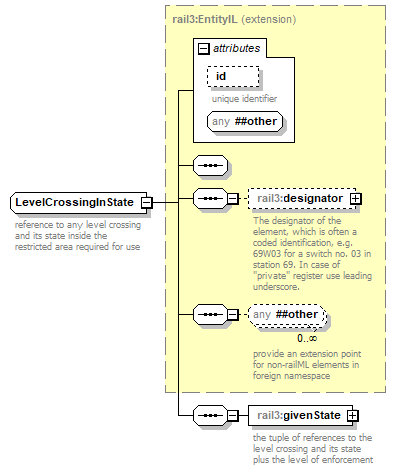 | ||||||||||||||
| namespace | https://www.railml.org/schemas/3.1 | ||||||||||||||
| type | extension of rail3:EntityIL | ||||||||||||||
| properties |
| ||||||||||||||
| children | rail3:designator rail3:givenState | ||||||||||||||
| used by |
| ||||||||||||||
| attributes |
| ||||||||||||||
| annotation |
| ||||||||||||||
| source | <xs:complexType name="LevelCrossingInState"> <xs:annotation> <xs:documentation>reference to any level crossing and its state inside the restricted area required for use</xs:documentation> </xs:annotation> <xs:complexContent> <xs:extension base="rail3:EntityIL"> <xs:sequence> <xs:element name="givenState" type="rail3:LevelCrossingAndGivenState" minOccurs="1" maxOccurs="1"> <xs:annotation> <xs:documentation>the tuple of references to the level crossing and its state plus the level of enforcement</xs:documentation> </xs:annotation> </xs:element> </xs:sequence> </xs:extension> </xs:complexContent> </xs:complexType> |
element LevelCrossingInState/givenState
| diagram | 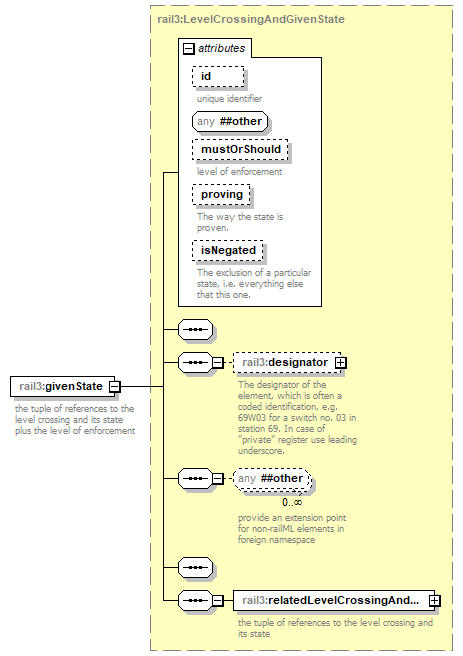 | ||||||||||||||||||||||||||||||||||||||
| namespace | https://www.railml.org/schemas/3.1 | ||||||||||||||||||||||||||||||||||||||
| type | rail3:LevelCrossingAndGivenState | ||||||||||||||||||||||||||||||||||||||
| properties |
| ||||||||||||||||||||||||||||||||||||||
| children | rail3:designator rail3:relatedLevelCrossingAndState | ||||||||||||||||||||||||||||||||||||||
| attributes |
| ||||||||||||||||||||||||||||||||||||||
| annotation |
| ||||||||||||||||||||||||||||||||||||||
| source | <xs:element name="givenState" type="rail3:LevelCrossingAndGivenState" minOccurs="1" maxOccurs="1"> <xs:annotation> <xs:documentation>the tuple of references to the level crossing and its state plus the level of enforcement</xs:documentation> </xs:annotation> </xs:element> |
complexType LevelCrossingsIL
| diagram | 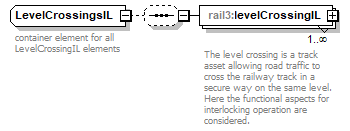 | ||
| namespace | https://www.railml.org/schemas/3.1 | ||
| children | rail3:levelCrossingIL | ||
| used by |
| ||
| annotation |
| ||
| source | <xs:complexType name="LevelCrossingsIL"> <xs:annotation> <xs:documentation>container element for all LevelCrossingIL elements</xs:documentation> </xs:annotation> <xs:sequence minOccurs="0" maxOccurs="1"> <xs:element name="levelCrossingIL" type="rail3:LevelCrossingIL" minOccurs="1" maxOccurs="unbounded"> <xs:annotation> <xs:documentation>The level crossing is a track asset allowing road traffic to cross the railway track in a secure way on the same level. Here the functional aspects for interlocking operation are considered.</xs:documentation> </xs:annotation> </xs:element> </xs:sequence> </xs:complexType> |
element LevelCrossingsIL/levelCrossingIL
| diagram |  | ||||||||||||||||||||||||||||||||||||||||||||||||||||||||||||||||||||||
| namespace | https://www.railml.org/schemas/3.1 | ||||||||||||||||||||||||||||||||||||||||||||||||||||||||||||||||||||||
| type | rail3:LevelCrossingIL | ||||||||||||||||||||||||||||||||||||||||||||||||||||||||||||||||||||||
| properties |
| ||||||||||||||||||||||||||||||||||||||||||||||||||||||||||||||||||||||
| children | rail3:designator rail3:hasInterface rail3:isLevelCrossingType rail3:refersTo rail3:deactivatedBy rail3:activationCondition rail3:hasTvdSection | ||||||||||||||||||||||||||||||||||||||||||||||||||||||||||||||||||||||
| attributes |
| ||||||||||||||||||||||||||||||||||||||||||||||||||||||||||||||||||||||
| annotation |
| ||||||||||||||||||||||||||||||||||||||||||||||||||||||||||||||||||||||
| source | <xs:element name="levelCrossingIL" type="rail3:LevelCrossingIL" minOccurs="1" maxOccurs="unbounded"> <xs:annotation> <xs:documentation>The level crossing is a track asset allowing road traffic to cross the railway track in a secure way on the same level. Here the functional aspects for interlocking operation are considered.</xs:documentation> </xs:annotation> </xs:element> |
complexType LevelCrossingTypeList
| diagram | 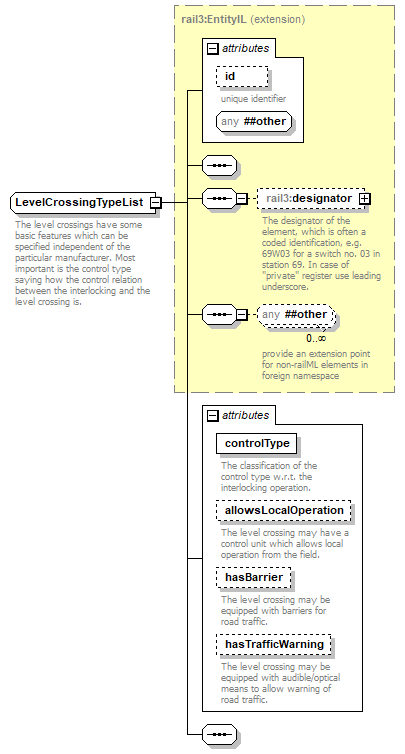 | ||||||||||||||||||||||||||||||||||||||||||||||
| namespace | https://www.railml.org/schemas/3.1 | ||||||||||||||||||||||||||||||||||||||||||||||
| type | extension of rail3:EntityIL | ||||||||||||||||||||||||||||||||||||||||||||||
| properties |
| ||||||||||||||||||||||||||||||||||||||||||||||
| children | rail3:designator | ||||||||||||||||||||||||||||||||||||||||||||||
| used by |
| ||||||||||||||||||||||||||||||||||||||||||||||
| attributes |
| ||||||||||||||||||||||||||||||||||||||||||||||
| annotation |
| ||||||||||||||||||||||||||||||||||||||||||||||
| source | <xs:complexType name="LevelCrossingTypeList"> <xs:annotation> <xs:documentation>The level crossings have some basic features which can be specified independent of the particular manufacturer. Most important is the control type saying how the control relation between the interlocking and the level crossing is.</xs:documentation> </xs:annotation> <xs:complexContent> <xs:extension base="rail3:EntityIL"> <xs:sequence/> <xs:attribute name="controlType" type="rail3:tLevelCrossingControlTypes" use="required"> <xs:annotation> <xs:documentation>The classification of the control type w.r.t. the interlocking operation.</xs:documentation> </xs:annotation> </xs:attribute> <xs:attribute name="allowsLocalOperation" type="xs:boolean" use="optional"> <xs:annotation> <xs:documentation>The level crossing may have a control unit which allows local operation from the field.</xs:documentation> </xs:annotation> </xs:attribute> <xs:attribute name="hasBarrier" type="xs:boolean" use="optional"> <xs:annotation> <xs:documentation>The level crossing may be equipped with barriers for road traffic.</xs:documentation> </xs:annotation> </xs:attribute> <xs:attribute name="hasTrafficWarning" type="xs:boolean" use="optional"> <xs:annotation> <xs:documentation>The level crossing may be equipped with audible/optical means to allow warning of road traffic.</xs:documentation> </xs:annotation> </xs:attribute> </xs:extension> </xs:complexContent> </xs:complexType> |
attribute LevelCrossingTypeList/@controlType
| type | rail3:tLevelCrossingControlTypes | ||||||||||||
| properties |
| ||||||||||||
| facets |
| ||||||||||||
| annotation |
| ||||||||||||
| source | <xs:attribute name="controlType" type="rail3:tLevelCrossingControlTypes" use="required"> <xs:annotation> <xs:documentation>The classification of the control type w.r.t. the interlocking operation.</xs:documentation> </xs:annotation> </xs:attribute> |
attribute LevelCrossingTypeList/@allowsLocalOperation
| type | xs:boolean | ||
| properties |
| ||
| annotation |
| ||
| source | <xs:attribute name="allowsLocalOperation" type="xs:boolean" use="optional"> <xs:annotation> <xs:documentation>The level crossing may have a control unit which allows local operation from the field.</xs:documentation> </xs:annotation> </xs:attribute> |
attribute LevelCrossingTypeList/@hasBarrier
| type | xs:boolean | ||
| properties |
| ||
| annotation |
| ||
| source | <xs:attribute name="hasBarrier" type="xs:boolean" use="optional"> <xs:annotation> <xs:documentation>The level crossing may be equipped with barriers for road traffic.</xs:documentation> </xs:annotation> </xs:attribute> |
attribute LevelCrossingTypeList/@hasTrafficWarning
| type | xs:boolean | ||
| properties |
| ||
| annotation |
| ||
| source | <xs:attribute name="hasTrafficWarning" type="xs:boolean" use="optional"> <xs:annotation> <xs:documentation>The level crossing may be equipped with audible/optical means to allow warning of road traffic.</xs:documentation> </xs:annotation> </xs:attribute> |
complexType LocalOperationArea
| diagram | 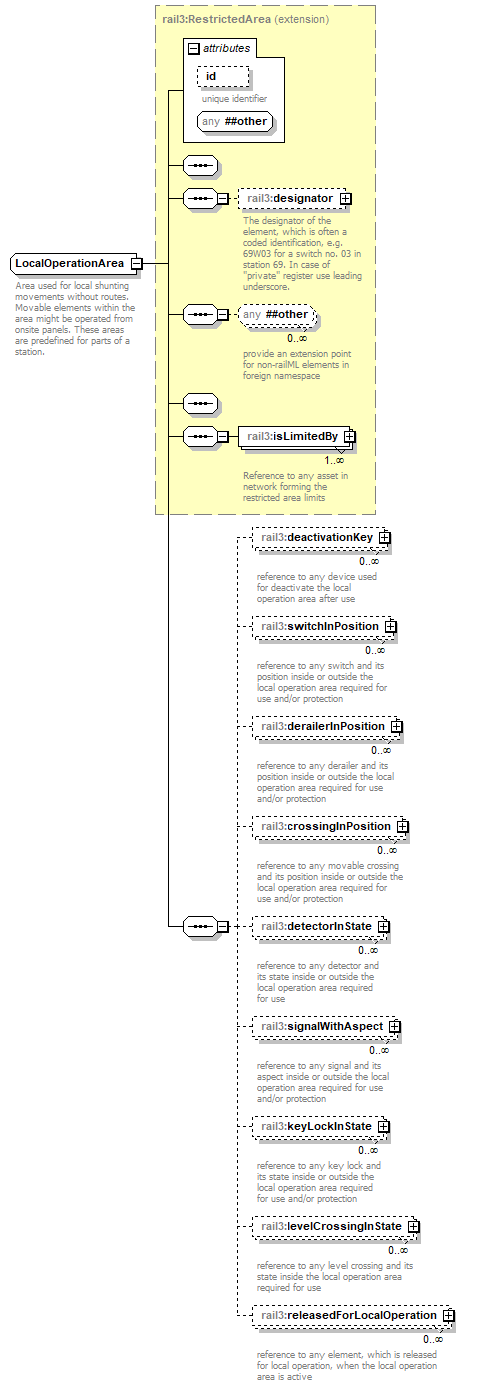 | ||||||||||||||
| namespace | https://www.railml.org/schemas/3.1 | ||||||||||||||
| type | extension of rail3:RestrictedArea | ||||||||||||||
| properties |
| ||||||||||||||
| children | rail3:designator rail3:isLimitedBy rail3:deactivationKey rail3:switchInPosition rail3:derailerInPosition rail3:crossingInPosition rail3:detectorInState rail3:signalWithAspect rail3:keyLockInState rail3:levelCrossingInState rail3:releasedForLocalOperation | ||||||||||||||
| used by |
| ||||||||||||||
| attributes |
| ||||||||||||||
| annotation |
| ||||||||||||||
| source | <xs:complexType name="LocalOperationArea"> <xs:annotation> <xs:documentation>Area used for local shunting movements without routes. Movable elements within the area might be operated from onsite panels. These areas are predefined for parts of a station.</xs:documentation> </xs:annotation> <xs:complexContent> <xs:extension base="rail3:RestrictedArea"> <xs:sequence> <xs:element name="deactivationKey" type="rail3:EntityILref" minOccurs="0" maxOccurs="unbounded"> <xs:annotation> <xs:documentation>reference to any device used for deactivate the local operation area after use</xs:documentation> </xs:annotation> </xs:element> <xs:element name="switchInPosition" type="rail3:SwitchInPosition" minOccurs="0" maxOccurs="unbounded"> <xs:annotation> <xs:documentation>reference to any switch and its position inside or outside the local operation area required for use and/or protection</xs:documentation> </xs:annotation> </xs:element> <xs:element name="derailerInPosition" type="rail3:DerailerInPosition" minOccurs="0" maxOccurs="unbounded"> <xs:annotation> <xs:documentation>reference to any derailer and its position inside or outside the local operation area required for use and/or protection</xs:documentation> </xs:annotation> </xs:element> <xs:element name="crossingInPosition" type="rail3:CrossingInPosition" minOccurs="0" maxOccurs="unbounded"> <xs:annotation> <xs:documentation>reference to any movable crossing and its position inside or outside the local operation area required for use and/or protection</xs:documentation> </xs:annotation> </xs:element> <xs:element name="detectorInState" type="rail3:DetectorInState" minOccurs="0" maxOccurs="unbounded"> <xs:annotation> <xs:documentation>reference to any detector and its state inside or outside the local operation area required for use</xs:documentation> </xs:annotation> </xs:element> <xs:element name="signalWithAspect" type="rail3:SignalWithAspect" minOccurs="0" maxOccurs="unbounded"> <xs:annotation> <xs:documentation>reference to any signal and its aspect inside or outside the local operation area required for use and/or protection</xs:documentation> </xs:annotation> </xs:element> <xs:element name="keyLockInState" type="rail3:KeyLockInState" minOccurs="0" maxOccurs="unbounded"> <xs:annotation> <xs:documentation>reference to any key lock and its state inside or outside the local operation area required for use and/or protection</xs:documentation> </xs:annotation> </xs:element> <xs:element name="levelCrossingInState" type="rail3:LevelCrossingInState" minOccurs="0" maxOccurs="unbounded"> <xs:annotation> <xs:documentation>reference to any level crossing and its state inside the local operation area required for use</xs:documentation> </xs:annotation> </xs:element> <xs:element name="releasedForLocalOperation" type="rail3:EntityILref" minOccurs="0" maxOccurs="unbounded"> <xs:annotation> <xs:documentation>reference to any element, which is released for local operation, when the local operation area is active</xs:documentation> </xs:annotation> </xs:element> </xs:sequence> </xs:extension> </xs:complexContent> </xs:complexType> |
element LocalOperationArea/deactivationKey
| diagram | 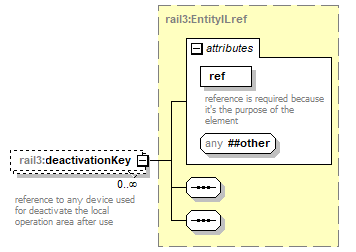 | ||||||||||||||
| namespace | https://www.railml.org/schemas/3.1 | ||||||||||||||
| type | rail3:EntityILref | ||||||||||||||
| properties |
| ||||||||||||||
| attributes |
| ||||||||||||||
| annotation |
| ||||||||||||||
| source | <xs:element name="deactivationKey" type="rail3:EntityILref" minOccurs="0" maxOccurs="unbounded"> <xs:annotation> <xs:documentation>reference to any device used for deactivate the local operation area after use</xs:documentation> </xs:annotation> </xs:element> |
element LocalOperationArea/switchInPosition
| diagram | 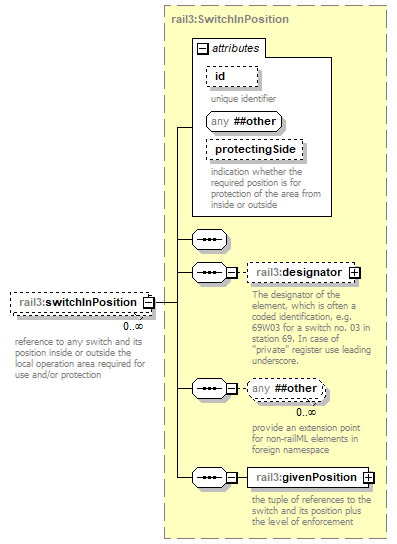 | ||||||||||||||||||||||
| namespace | https://www.railml.org/schemas/3.1 | ||||||||||||||||||||||
| type | rail3:SwitchInPosition | ||||||||||||||||||||||
| properties |
| ||||||||||||||||||||||
| children | rail3:designator rail3:givenPosition | ||||||||||||||||||||||
| attributes |
| ||||||||||||||||||||||
| annotation |
| ||||||||||||||||||||||
| source | <xs:element name="switchInPosition" type="rail3:SwitchInPosition" minOccurs="0" maxOccurs="unbounded"> <xs:annotation> <xs:documentation>reference to any switch and its position inside or outside the local operation area required for use and/or protection</xs:documentation> </xs:annotation> </xs:element> |
element LocalOperationArea/derailerInPosition
| diagram | 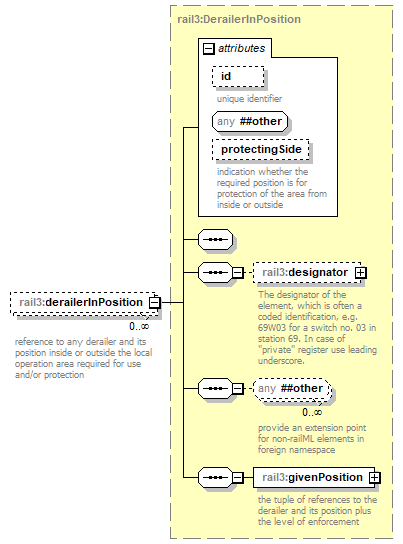 | ||||||||||||||||||||||
| namespace | https://www.railml.org/schemas/3.1 | ||||||||||||||||||||||
| type | rail3:DerailerInPosition | ||||||||||||||||||||||
| properties |
| ||||||||||||||||||||||
| children | rail3:designator rail3:givenPosition | ||||||||||||||||||||||
| attributes |
| ||||||||||||||||||||||
| annotation |
| ||||||||||||||||||||||
| source | <xs:element name="derailerInPosition" type="rail3:DerailerInPosition" minOccurs="0" maxOccurs="unbounded"> <xs:annotation> <xs:documentation>reference to any derailer and its position inside or outside the local operation area required for use and/or protection</xs:documentation> </xs:annotation> </xs:element> |
element LocalOperationArea/crossingInPosition
| diagram | 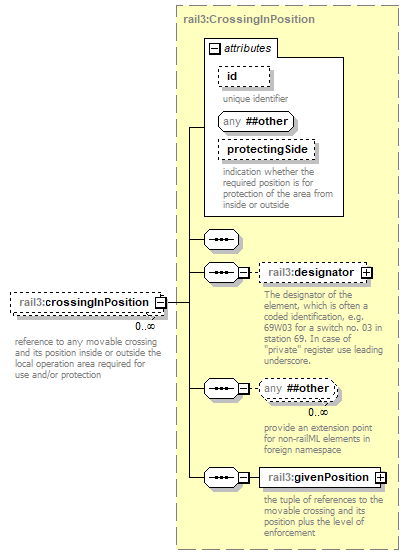 | ||||||||||||||||||||||
| namespace | https://www.railml.org/schemas/3.1 | ||||||||||||||||||||||
| type | rail3:CrossingInPosition | ||||||||||||||||||||||
| properties |
| ||||||||||||||||||||||
| children | rail3:designator rail3:givenPosition | ||||||||||||||||||||||
| attributes |
| ||||||||||||||||||||||
| annotation |
| ||||||||||||||||||||||
| source | <xs:element name="crossingInPosition" type="rail3:CrossingInPosition" minOccurs="0" maxOccurs="unbounded"> <xs:annotation> <xs:documentation>reference to any movable crossing and its position inside or outside the local operation area required for use and/or protection</xs:documentation> </xs:annotation> </xs:element> |
element LocalOperationArea/detectorInState
| diagram | 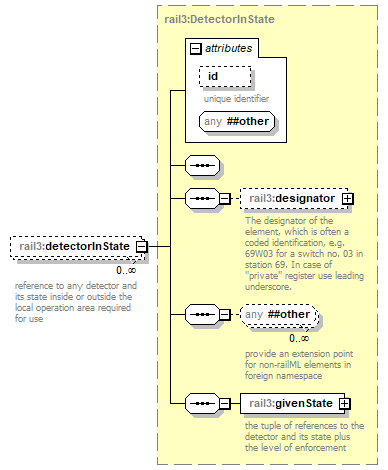 | ||||||||||||||
| namespace | https://www.railml.org/schemas/3.1 | ||||||||||||||
| type | rail3:DetectorInState | ||||||||||||||
| properties |
| ||||||||||||||
| children | rail3:designator rail3:givenState | ||||||||||||||
| attributes |
| ||||||||||||||
| annotation |
| ||||||||||||||
| source | <xs:element name="detectorInState" type="rail3:DetectorInState" minOccurs="0" maxOccurs="unbounded"> <xs:annotation> <xs:documentation>reference to any detector and its state inside or outside the local operation area required for use</xs:documentation> </xs:annotation> </xs:element> |
element LocalOperationArea/signalWithAspect
| diagram | 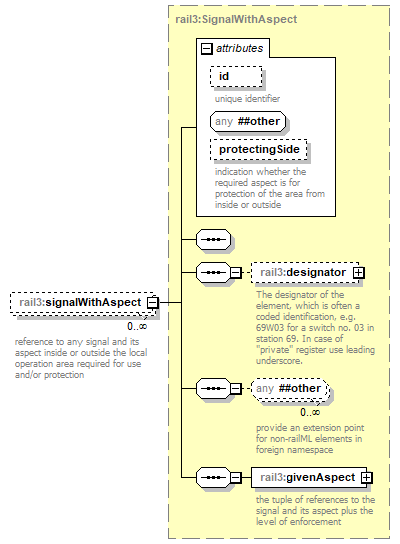 | ||||||||||||||||||||||
| namespace | https://www.railml.org/schemas/3.1 | ||||||||||||||||||||||
| type | rail3:SignalWithAspect | ||||||||||||||||||||||
| properties |
| ||||||||||||||||||||||
| children | rail3:designator rail3:givenAspect | ||||||||||||||||||||||
| attributes |
| ||||||||||||||||||||||
| annotation |
| ||||||||||||||||||||||
| source | <xs:element name="signalWithAspect" type="rail3:SignalWithAspect" minOccurs="0" maxOccurs="unbounded"> <xs:annotation> <xs:documentation>reference to any signal and its aspect inside or outside the local operation area required for use and/or protection</xs:documentation> </xs:annotation> </xs:element> |
element LocalOperationArea/keyLockInState
| diagram | 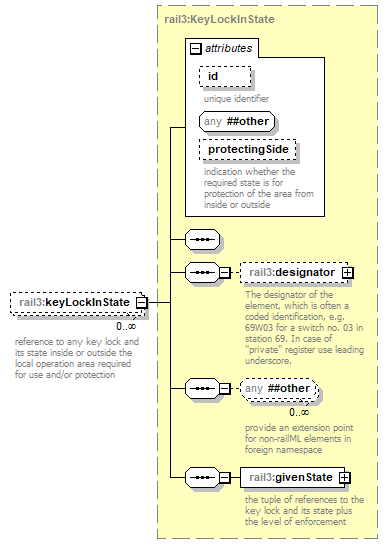 | ||||||||||||||||||||||
| namespace | https://www.railml.org/schemas/3.1 | ||||||||||||||||||||||
| type | rail3:KeyLockInState | ||||||||||||||||||||||
| properties |
| ||||||||||||||||||||||
| children | rail3:designator rail3:givenState | ||||||||||||||||||||||
| attributes |
| ||||||||||||||||||||||
| annotation |
| ||||||||||||||||||||||
| source | <xs:element name="keyLockInState" type="rail3:KeyLockInState" minOccurs="0" maxOccurs="unbounded"> <xs:annotation> <xs:documentation>reference to any key lock and its state inside or outside the local operation area required for use and/or protection</xs:documentation> </xs:annotation> </xs:element> |
element LocalOperationArea/levelCrossingInState
| diagram | 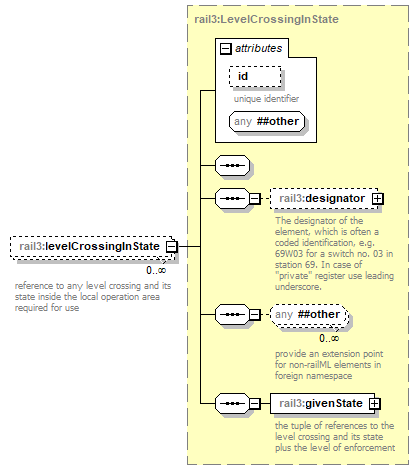 | ||||||||||||||
| namespace | https://www.railml.org/schemas/3.1 | ||||||||||||||
| type | rail3:LevelCrossingInState | ||||||||||||||
| properties |
| ||||||||||||||
| children | rail3:designator rail3:givenState | ||||||||||||||
| attributes |
| ||||||||||||||
| annotation |
| ||||||||||||||
| source | <xs:element name="levelCrossingInState" type="rail3:LevelCrossingInState" minOccurs="0" maxOccurs="unbounded"> <xs:annotation> <xs:documentation>reference to any level crossing and its state inside the local operation area required for use</xs:documentation> </xs:annotation> </xs:element> |
element LocalOperationArea/releasedForLocalOperation
| diagram | 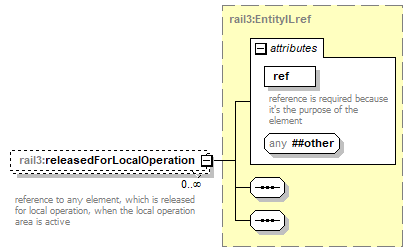 | ||||||||||||||
| namespace | https://www.railml.org/schemas/3.1 | ||||||||||||||
| type | rail3:EntityILref | ||||||||||||||
| properties |
| ||||||||||||||
| attributes |
| ||||||||||||||
| annotation |
| ||||||||||||||
| source | <xs:element name="releasedForLocalOperation" type="rail3:EntityILref" minOccurs="0" maxOccurs="unbounded"> <xs:annotation> <xs:documentation>reference to any element, which is released for local operation, when the local operation area is active</xs:documentation> </xs:annotation> </xs:element> |
complexType LocalOperationAreas
| diagram |  | ||
| namespace | https://www.railml.org/schemas/3.1 | ||
| children | rail3:localOperationArea | ||
| used by |
| ||
| source | <xs:complexType name="LocalOperationAreas"> <xs:sequence> <xs:element name="localOperationArea" type="rail3:LocalOperationArea" minOccurs="1" maxOccurs="unbounded"> <xs:annotation> <xs:documentation>Area used for local shunting movements without routes. Movable elements within the area might be operated from onsite panels.</xs:documentation> </xs:annotation> </xs:element> </xs:sequence> </xs:complexType> |
element LocalOperationAreas/localOperationArea
| diagram | 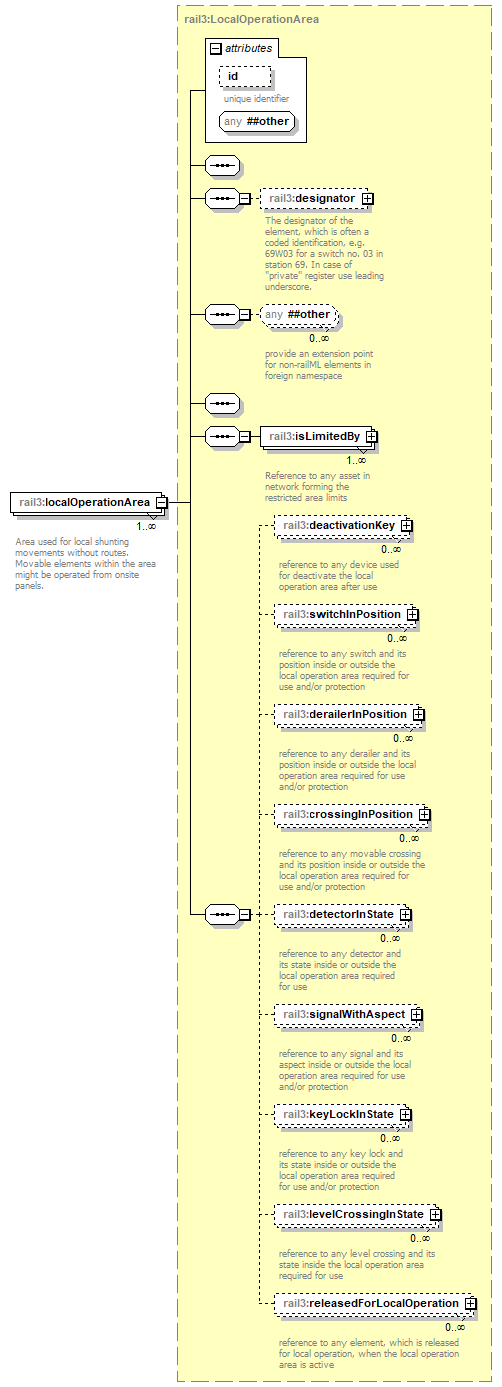 | ||||||||||||||
| namespace | https://www.railml.org/schemas/3.1 | ||||||||||||||
| type | rail3:LocalOperationArea | ||||||||||||||
| properties |
| ||||||||||||||
| children | rail3:designator rail3:isLimitedBy rail3:deactivationKey rail3:switchInPosition rail3:derailerInPosition rail3:crossingInPosition rail3:detectorInState rail3:signalWithAspect rail3:keyLockInState rail3:levelCrossingInState rail3:releasedForLocalOperation | ||||||||||||||
| attributes |
| ||||||||||||||
| annotation |
| ||||||||||||||
| source | <xs:element name="localOperationArea" type="rail3:LocalOperationArea" minOccurs="1" maxOccurs="unbounded"> <xs:annotation> <xs:documentation>Area used for local shunting movements without routes. Movable elements within the area might be operated from onsite panels.</xs:documentation> </xs:annotation> </xs:element> |
complexType LockAndGivenState
| diagram | 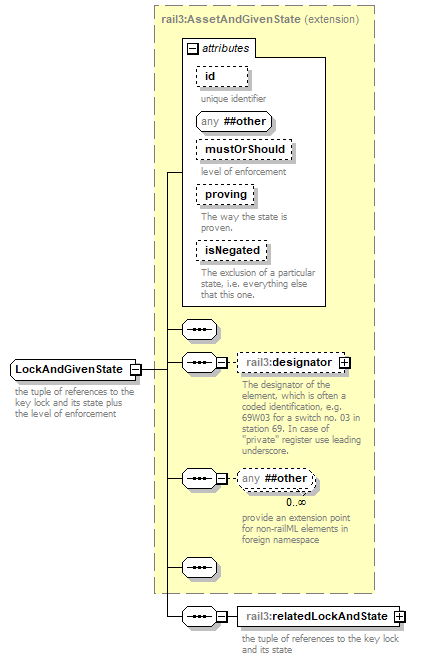 | ||||||||||||||||||||||||||||||||||||||
| namespace | https://www.railml.org/schemas/3.1 | ||||||||||||||||||||||||||||||||||||||
| type | extension of rail3:AssetAndGivenState | ||||||||||||||||||||||||||||||||||||||
| properties |
| ||||||||||||||||||||||||||||||||||||||
| children | rail3:designator rail3:relatedLockAndState | ||||||||||||||||||||||||||||||||||||||
| used by |
| ||||||||||||||||||||||||||||||||||||||
| attributes |
| ||||||||||||||||||||||||||||||||||||||
| annotation |
| ||||||||||||||||||||||||||||||||||||||
| source | <xs:complexType name="LockAndGivenState"> <xs:annotation> <xs:documentation>the tuple of references to the key lock and its state plus the level of enforcement</xs:documentation> </xs:annotation> <xs:complexContent> <xs:extension base="rail3:AssetAndGivenState"> <xs:sequence> <xs:element name="relatedLockAndState" type="rail3:LockAndState" minOccurs="1" maxOccurs="1"> <xs:annotation> <xs:documentation>the tuple of references to the key lock and its state</xs:documentation> </xs:annotation> </xs:element> </xs:sequence> </xs:extension> </xs:complexContent> </xs:complexType> |
element LockAndGivenState/relatedLockAndState
| diagram | 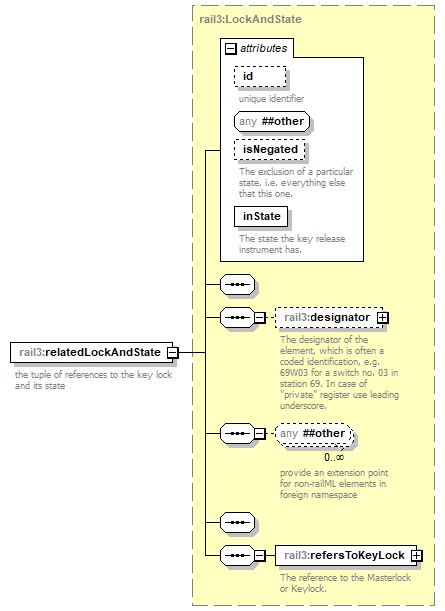 | ||||||||||||||||||||||||||||||
| namespace | https://www.railml.org/schemas/3.1 | ||||||||||||||||||||||||||||||
| type | rail3:LockAndState | ||||||||||||||||||||||||||||||
| properties |
| ||||||||||||||||||||||||||||||
| children | rail3:designator rail3:refersToKeyLock | ||||||||||||||||||||||||||||||
| attributes |
| ||||||||||||||||||||||||||||||
| annotation |
| ||||||||||||||||||||||||||||||
| source | <xs:element name="relatedLockAndState" type="rail3:LockAndState" minOccurs="1" maxOccurs="1"> <xs:annotation> <xs:documentation>the tuple of references to the key lock and its state</xs:documentation> </xs:annotation> </xs:element> |
complexType LockAndState
| diagram | 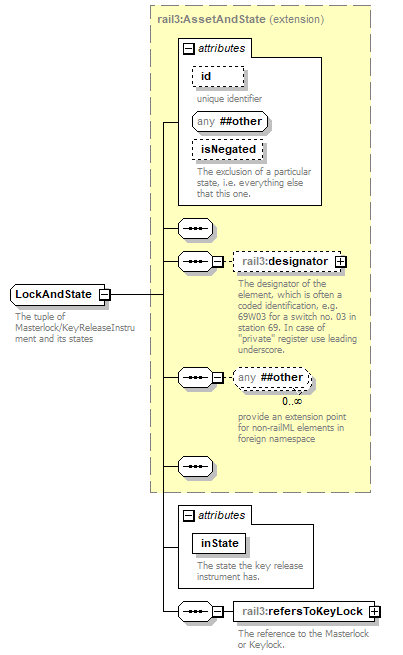 | ||||||||||||||||||||||||||||||
| namespace | https://www.railml.org/schemas/3.1 | ||||||||||||||||||||||||||||||
| type | extension of rail3:AssetAndState | ||||||||||||||||||||||||||||||
| properties |
| ||||||||||||||||||||||||||||||
| children | rail3:designator rail3:refersToKeyLock | ||||||||||||||||||||||||||||||
| used by |
| ||||||||||||||||||||||||||||||
| attributes |
| ||||||||||||||||||||||||||||||
| annotation |
| ||||||||||||||||||||||||||||||
| source | <xs:complexType name="LockAndState"> <xs:annotation> <xs:documentation>The tuple of Masterlock/KeyReleaseInstrument and its states</xs:documentation> </xs:annotation> <xs:complexContent> <xs:extension base="rail3:AssetAndState"> <xs:sequence> <xs:element name="refersToKeyLock" type="rail3:EntityILref" minOccurs="1" maxOccurs="1"> <xs:annotation> <xs:documentation>The reference to the Masterlock or Keylock.</xs:documentation> </xs:annotation> </xs:element> </xs:sequence> <xs:attribute name="inState" type="rail3:tLockState" use="required"> <xs:annotation> <xs:documentation>The state the key release instrument has.</xs:documentation> </xs:annotation> </xs:attribute> </xs:extension> </xs:complexContent> </xs:complexType> |
attribute LockAndState/@inState
| type | rail3:tLockState | |||||||||
| properties |
| |||||||||
| facets |
| |||||||||
| annotation |
| |||||||||
| source | <xs:attribute name="inState" type="rail3:tLockState" use="required"> <xs:annotation> <xs:documentation>The state the key release instrument has.</xs:documentation> </xs:annotation> </xs:attribute> |
element LockAndState/refersToKeyLock
| diagram | 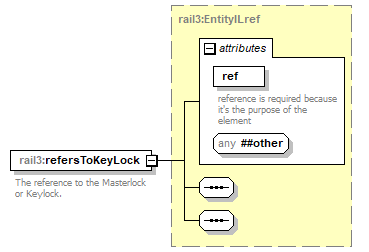 | ||||||||||||||
| namespace | https://www.railml.org/schemas/3.1 | ||||||||||||||
| type | rail3:EntityILref | ||||||||||||||
| properties |
| ||||||||||||||
| attributes |
| ||||||||||||||
| annotation |
| ||||||||||||||
| source | <xs:element name="refersToKeyLock" type="rail3:EntityILref" minOccurs="1" maxOccurs="1"> <xs:annotation> <xs:documentation>The reference to the Masterlock or Keylock.</xs:documentation> </xs:annotation> </xs:element> |
complexType LogicalDevice
| diagram | 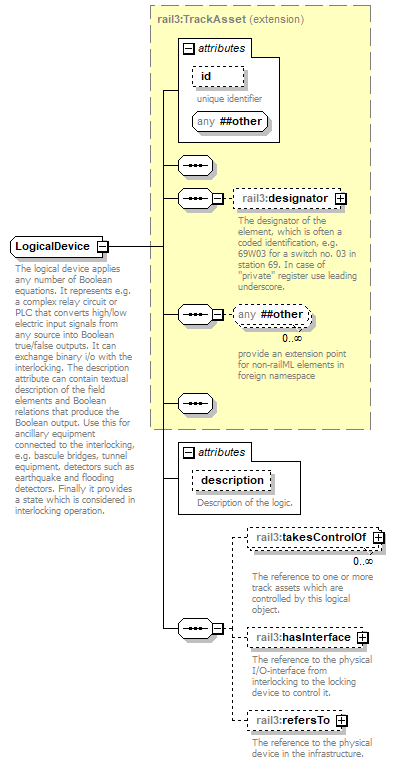 | ||||||||||||||||||||||
| namespace | https://www.railml.org/schemas/3.1 | ||||||||||||||||||||||
| type | extension of rail3:TrackAsset | ||||||||||||||||||||||
| properties |
| ||||||||||||||||||||||
| children | rail3:designator rail3:takesControlOf rail3:hasInterface rail3:refersTo | ||||||||||||||||||||||
| used by |
| ||||||||||||||||||||||
| attributes |
| ||||||||||||||||||||||
| annotation |
| ||||||||||||||||||||||
| source | <xs:complexType name="LogicalDevice" abstract="true"> <xs:annotation> <xs:documentation>The logical device applies any number of Boolean equations. It represents e.g. a complex relay circuit or PLC that converts high/low electric input signals from any source into Boolean true/false outputs. It can exchange binary i/o with the interlocking. The description attribute can contain textual description of the field elements and Boolean relations that produce the Boolean output. Use this for ancillary equipment connected to the interlocking, e.g. bascule bridges, tunnel equipment, detectors such as earthquake and flooding detectors. Finally it provides a state which is considered in interlocking operation.</xs:documentation> </xs:annotation> <xs:complexContent> <xs:extension base="rail3:TrackAsset"> <xs:sequence> <xs:element name="takesControlOf" type="rail3:EntityILref" minOccurs="0" maxOccurs="unbounded"> <xs:annotation> <xs:documentation>The reference to one or more track assets which are controlled by this logical object.</xs:documentation> </xs:annotation> </xs:element> <xs:element name="hasInterface" type="rail3:EntityILref" minOccurs="0" maxOccurs="1"> <xs:annotation> <xs:documentation>The reference to the physical I/O-interface from interlocking to the locking device to control it.</xs:documentation> </xs:annotation> </xs:element> <xs:element name="refersTo" type="rail3:EntityILref" minOccurs="0" maxOccurs="1"> <xs:annotation> <xs:documentation>The reference to the physical device in the infrastructure.</xs:documentation> </xs:annotation> </xs:element> </xs:sequence> <xs:attribute name="description" type="xs:string" use="optional"> <xs:annotation> <xs:documentation>Description of the logic.</xs:documentation> </xs:annotation> </xs:attribute> </xs:extension> </xs:complexContent> </xs:complexType> |
attribute LogicalDevice/@description
| type | xs:string | ||
| properties |
| ||
| annotation |
| ||
| source | <xs:attribute name="description" type="xs:string" use="optional"> <xs:annotation> <xs:documentation>Description of the logic.</xs:documentation> </xs:annotation> </xs:attribute> |
element LogicalDevice/takesControlOf
| diagram | 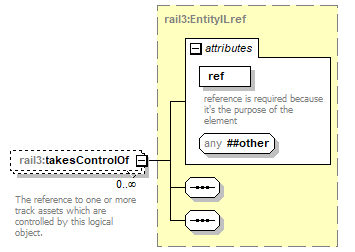 | ||||||||||||||
| namespace | https://www.railml.org/schemas/3.1 | ||||||||||||||
| type | rail3:EntityILref | ||||||||||||||
| properties |
| ||||||||||||||
| attributes |
| ||||||||||||||
| annotation |
| ||||||||||||||
| source | <xs:element name="takesControlOf" type="rail3:EntityILref" minOccurs="0" maxOccurs="unbounded"> <xs:annotation> <xs:documentation>The reference to one or more track assets which are controlled by this logical object.</xs:documentation> </xs:annotation> </xs:element> |
element LogicalDevice/hasInterface
| diagram | 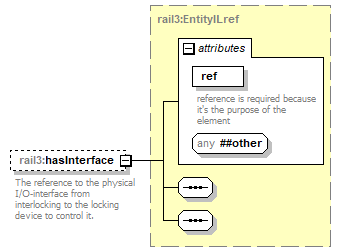 | ||||||||||||||
| namespace | https://www.railml.org/schemas/3.1 | ||||||||||||||
| type | rail3:EntityILref | ||||||||||||||
| properties |
| ||||||||||||||
| attributes |
| ||||||||||||||
| annotation |
| ||||||||||||||
| source | <xs:element name="hasInterface" type="rail3:EntityILref" minOccurs="0" maxOccurs="1"> <xs:annotation> <xs:documentation>The reference to the physical I/O-interface from interlocking to the locking device to control it.</xs:documentation> </xs:annotation> </xs:element> |
element LogicalDevice/refersTo
| diagram | 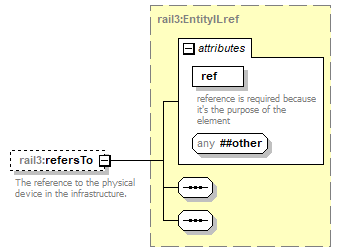 | ||||||||||||||
| namespace | https://www.railml.org/schemas/3.1 | ||||||||||||||
| type | rail3:EntityILref | ||||||||||||||
| properties |
| ||||||||||||||
| attributes |
| ||||||||||||||
| annotation |
| ||||||||||||||
| source | <xs:element name="refersTo" type="rail3:EntityILref" minOccurs="0" maxOccurs="1"> <xs:annotation> <xs:documentation>The reference to the physical device in the infrastructure.</xs:documentation> </xs:annotation> </xs:element> |
complexType MovableCrossing
| diagram |  | ||||||||||||||||||||||||||||||||||||||||||||||||||||||||||||||||||||||
| namespace | https://www.railml.org/schemas/3.1 | ||||||||||||||||||||||||||||||||||||||||||||||||||||||||||||||||||||||
| type | extension of rail3:MovableElement | ||||||||||||||||||||||||||||||||||||||||||||||||||||||||||||||||||||||
| properties |
| ||||||||||||||||||||||||||||||||||||||||||||||||||||||||||||||||||||||
| children | rail3:designator rail3:refersTo rail3:hasGaugeClearanceMarker rail3:hasTvdSection rail3:connectedToPowerSupply rail3:relatedMovableElement rail3:branchUpLeft rail3:branchUpRight rail3:branchDownLeft rail3:branchDownRight rail3:hasFoulingTrainDetectors | ||||||||||||||||||||||||||||||||||||||||||||||||||||||||||||||||||||||
| used by |
| ||||||||||||||||||||||||||||||||||||||||||||||||||||||||||||||||||||||
| attributes |
| ||||||||||||||||||||||||||||||||||||||||||||||||||||||||||||||||||||||
| annotation |
| ||||||||||||||||||||||||||||||||||||||||||||||||||||||||||||||||||||||
| source | <xs:complexType name="MovableCrossing"> <xs:annotation> <xs:documentation>Crossings are a special item for interlockings as a position is required for them even if there is no really movable item trackside. Some crossings, especially high speed ones, have a movable frog to close the gap at the crossing (UK: movable nose crossing, DE: Herzstück mit beweglicher Spitze, NL: kruising met beweegbaar puntstuk). Unlike a switch, such a movable frog will not send the train left or right but it does guide the train. Thus the position is essential for avoiding derailment. Do not confound this class with ordinary double or single slip switches. The latter are regarded as two back-to-back switches.</xs:documentation> </xs:annotation> <xs:complexContent> <xs:extension base="rail3:MovableElement"> <xs:sequence> <xs:element name="branchUpLeft" type="rail3:EntityILref" minOccurs="1" maxOccurs="1"> <xs:annotation> <xs:documentation>Referral to the physical track that connects from upper left side to the crossing.</xs:documentation> </xs:annotation> </xs:element> <xs:element name="branchUpRight" type="rail3:EntityILref" minOccurs="1" maxOccurs="1"> <xs:annotation> <xs:documentation>Referral to the physical track that connects from upper right side to the crossing.</xs:documentation> </xs:annotation> </xs:element> <xs:element name="branchDownLeft" type="rail3:EntityILref" minOccurs="1" maxOccurs="1"> <xs:annotation> <xs:documentation>Referral to the physical track that connects from lower left side to the crossing.</xs:documentation> </xs:annotation> </xs:element> <xs:element name="branchDownRight" type="rail3:EntityILref" minOccurs="1" maxOccurs="1"> <xs:annotation> <xs:documentation>Referral to the physical track that connects from lower right side to the crossing.</xs:documentation> </xs:annotation> </xs:element> <xs:element name="hasFoulingTrainDetectors" type="rail3:EntityILref" minOccurs="0" maxOccurs="unbounded"> <xs:annotation> <xs:documentation>This is the reference to the train detectors delimiting the TVD section of this crossing, which are too close and cannot guarantee a clear gauge of the set track.</xs:documentation> </xs:annotation> </xs:element> </xs:sequence> <xs:attribute name="preferredPosition" type="rail3:tCrossingPosition" use="optional"> <xs:annotation> <xs:documentation>This is the preferred position of the crossing which it is switched to when not in use.</xs:documentation> </xs:annotation> </xs:attribute> </xs:extension> </xs:complexContent> </xs:complexType> |
attribute MovableCrossing/@preferredPosition
| type | rail3:tCrossingPosition | |||||||||
| properties |
| |||||||||
| facets |
| |||||||||
| annotation |
| |||||||||
| source | <xs:attribute name="preferredPosition" type="rail3:tCrossingPosition" use="optional"> <xs:annotation> <xs:documentation>This is the preferred position of the crossing which it is switched to when not in use.</xs:documentation> </xs:annotation> </xs:attribute> |
element MovableCrossing/branchUpLeft
| diagram | 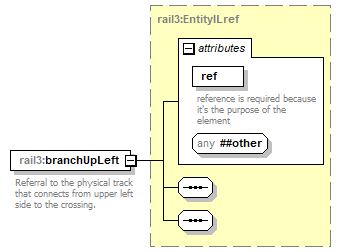 | ||||||||||||||
| namespace | https://www.railml.org/schemas/3.1 | ||||||||||||||
| type | rail3:EntityILref | ||||||||||||||
| properties |
| ||||||||||||||
| attributes |
| ||||||||||||||
| annotation |
| ||||||||||||||
| source | <xs:element name="branchUpLeft" type="rail3:EntityILref" minOccurs="1" maxOccurs="1"> <xs:annotation> <xs:documentation>Referral to the physical track that connects from upper left side to the crossing.</xs:documentation> </xs:annotation> </xs:element> |
element MovableCrossing/branchUpRight
| diagram | 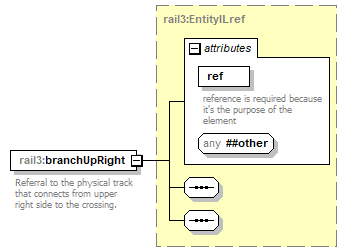 | ||||||||||||||
| namespace | https://www.railml.org/schemas/3.1 | ||||||||||||||
| type | rail3:EntityILref | ||||||||||||||
| properties |
| ||||||||||||||
| attributes |
| ||||||||||||||
| annotation |
| ||||||||||||||
| source | <xs:element name="branchUpRight" type="rail3:EntityILref" minOccurs="1" maxOccurs="1"> <xs:annotation> <xs:documentation>Referral to the physical track that connects from upper right side to the crossing.</xs:documentation> </xs:annotation> </xs:element> |
element MovableCrossing/branchDownLeft
| diagram | 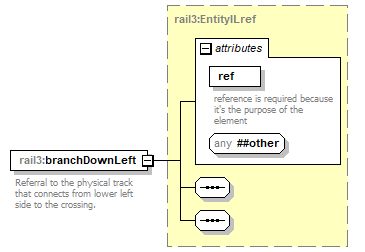 | ||||||||||||||
| namespace | https://www.railml.org/schemas/3.1 | ||||||||||||||
| type | rail3:EntityILref | ||||||||||||||
| properties |
| ||||||||||||||
| attributes |
| ||||||||||||||
| annotation |
| ||||||||||||||
| source | <xs:element name="branchDownLeft" type="rail3:EntityILref" minOccurs="1" maxOccurs="1"> <xs:annotation> <xs:documentation>Referral to the physical track that connects from lower left side to the crossing.</xs:documentation> </xs:annotation> </xs:element> |
element MovableCrossing/branchDownRight
| diagram | 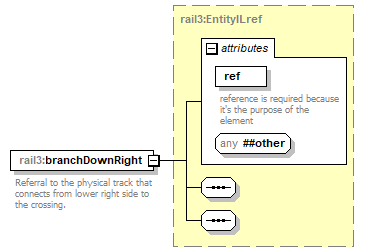 | ||||||||||||||
| namespace | https://www.railml.org/schemas/3.1 | ||||||||||||||
| type | rail3:EntityILref | ||||||||||||||
| properties |
| ||||||||||||||
| attributes |
| ||||||||||||||
| annotation |
| ||||||||||||||
| source | <xs:element name="branchDownRight" type="rail3:EntityILref" minOccurs="1" maxOccurs="1"> <xs:annotation> <xs:documentation>Referral to the physical track that connects from lower right side to the crossing.</xs:documentation> </xs:annotation> </xs:element> |
element MovableCrossing/hasFoulingTrainDetectors
| diagram | 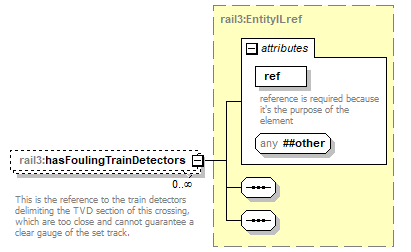 | ||||||||||||||
| namespace | https://www.railml.org/schemas/3.1 | ||||||||||||||
| type | rail3:EntityILref | ||||||||||||||
| properties |
| ||||||||||||||
| attributes |
| ||||||||||||||
| annotation |
| ||||||||||||||
| source | <xs:element name="hasFoulingTrainDetectors" type="rail3:EntityILref" minOccurs="0" maxOccurs="unbounded"> <xs:annotation> <xs:documentation>This is the reference to the train detectors delimiting the TVD section of this crossing, which are too close and cannot guarantee a clear gauge of the set track.</xs:documentation> </xs:annotation> </xs:element> |
complexType MovableCrossings
| diagram | 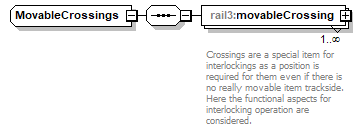 | ||
| namespace | https://www.railml.org/schemas/3.1 | ||
| children | rail3:movableCrossing | ||
| used by |
| ||
| source | <xs:complexType name="MovableCrossings"> <xs:sequence> <xs:element name="movableCrossing" type="rail3:MovableCrossing" minOccurs="1" maxOccurs="unbounded"> <xs:annotation> <xs:documentation>Crossings are a special item for interlockings as a position is required for them even if there is no really movable item trackside. Here the functional aspects for interlocking operation are considered.</xs:documentation> </xs:annotation> </xs:element> </xs:sequence> </xs:complexType> |
element MovableCrossings/movableCrossing
| diagram |  | ||||||||||||||||||||||||||||||||||||||||||||||||||||||||||||||||||||||
| namespace | https://www.railml.org/schemas/3.1 | ||||||||||||||||||||||||||||||||||||||||||||||||||||||||||||||||||||||
| type | rail3:MovableCrossing | ||||||||||||||||||||||||||||||||||||||||||||||||||||||||||||||||||||||
| properties |
| ||||||||||||||||||||||||||||||||||||||||||||||||||||||||||||||||||||||
| children | rail3:designator rail3:refersTo rail3:hasGaugeClearanceMarker rail3:hasTvdSection rail3:connectedToPowerSupply rail3:relatedMovableElement rail3:branchUpLeft rail3:branchUpRight rail3:branchDownLeft rail3:branchDownRight rail3:hasFoulingTrainDetectors | ||||||||||||||||||||||||||||||||||||||||||||||||||||||||||||||||||||||
| attributes |
| ||||||||||||||||||||||||||||||||||||||||||||||||||||||||||||||||||||||
| annotation |
| ||||||||||||||||||||||||||||||||||||||||||||||||||||||||||||||||||||||
| source | <xs:element name="movableCrossing" type="rail3:MovableCrossing" minOccurs="1" maxOccurs="unbounded"> <xs:annotation> <xs:documentation>Crossings are a special item for interlockings as a position is required for them even if there is no really movable item trackside. Here the functional aspects for interlocking operation are considered.</xs:documentation> </xs:annotation> </xs:element> |
complexType MovableElement
| diagram |  | ||||||||||||||||||||||||||||||||||||||||||||||||||||||||||||||
| namespace | https://www.railml.org/schemas/3.1 | ||||||||||||||||||||||||||||||||||||||||||||||||||||||||||||||
| type | extension of rail3:TrackAsset | ||||||||||||||||||||||||||||||||||||||||||||||||||||||||||||||
| properties |
| ||||||||||||||||||||||||||||||||||||||||||||||||||||||||||||||
| children | rail3:designator rail3:refersTo rail3:hasGaugeClearanceMarker rail3:hasTvdSection rail3:connectedToPowerSupply rail3:relatedMovableElement | ||||||||||||||||||||||||||||||||||||||||||||||||||||||||||||||
| used by |
| ||||||||||||||||||||||||||||||||||||||||||||||||||||||||||||||
| attributes |
| ||||||||||||||||||||||||||||||||||||||||||||||||||||||||||||||
| annotation |
| ||||||||||||||||||||||||||||||||||||||||||||||||||||||||||||||
| source | <xs:complexType name="MovableElement" abstract="true"> <xs:annotation> <xs:documentation>Abstract element defining the attributes common to movable elements. The movable element refers to TrackAsset, thus creating a link to the IS namespace.</xs:documentation> </xs:annotation> <xs:complexContent> <xs:extension base="rail3:TrackAsset"> <xs:sequence> <xs:element name="refersTo" type="rail3:EntityILref" minOccurs="1" maxOccurs="1"> <xs:annotation> <xs:documentation>Reference to the physical movable element in the infrastructure.</xs:documentation> </xs:annotation> </xs:element> <xs:element name="hasGaugeClearanceMarker" type="rail3:EntityILref" minOccurs="0" maxOccurs="2"> <xs:annotation> <xs:documentation>the reference to any gauge clearance marker in infrastructure</xs:documentation> </xs:annotation> </xs:element> <xs:element name="hasTvdSection" type="rail3:EntityILref" minOccurs="0" maxOccurs="1"> <xs:annotation> <xs:documentation>Reference to the underlying TVD section of the movable element</xs:documentation> </xs:annotation> </xs:element> <xs:element name="connectedToPowerSupply" type="rail3:EntityILref" minOccurs="0" maxOccurs="1"> <xs:annotation> <xs:documentation>relation to power supply for controlling the number of simultaneously switched switch actuators</xs:documentation> </xs:annotation> </xs:element> <xs:element name="relatedMovableElement" type="rail3:EntityILref" minOccurs="0" maxOccurs="1"> <xs:annotation> <xs:documentation>reference to other movable element in case of single/double slip switch or coupled switch</xs:documentation> </xs:annotation> </xs:element> </xs:sequence> <xs:attribute name="maxThrowTime" type="xs:duration" use="required"> <xs:annotation> <xs:documentation>Maximum time in milliseconds during which the IL can drive the element. If it has not reached end-position before this timer expires, the interlocking stops throwing as to prevent damage.</xs:documentation> </xs:annotation> </xs:attribute> <xs:attribute name="typicalThrowTime" type="xs:duration" use="optional"> <xs:annotation> <xs:documentation>typical throw time is the average time it takes between the moment the IL receives the call and the element reaches the new position. Switch throwing adds a delay to route setting that is of great interest to the use case simulation. For this purpose, we add an attribute typicalThrowTime that allows capacity planners to estimate the influence of slow throwing switches on train traffic. Note that this excludes controller (OCS) processing time and communication between controller (OCS) and interlocking.</xs:documentation> </xs:annotation> </xs:attribute> <xs:attribute name="returnsToPreferredPosition" type="xs:boolean" use="optional"> <xs:annotation> <xs:documentation>The automatic normalisation attribute is closely related to the preferred position. Whether or not the IL returns the element to its preferred position depends on this parameter. E.g. a derailer that is modelled as ... preferredPosition=engaged autoNormalisation=true ... will return to its engaged position when released. A switch modelled as preferredPosition=right autoNormalisation=false... will not automatically return to the right position when released. This combination of attributes is useful for geographical interlockings that automatically determine the preferred routes given the preferred position of intervening switches.</xs:documentation> </xs:annotation> </xs:attribute> <xs:attribute name="isKeyLocked" type="xs:boolean" use="optional"> <xs:annotation> <xs:documentation>One of boolean true or false. True means that the switch is clamped either mechanically or by any electric or electronic means. The interlocking shall never attempt to throw a clamped switch.</xs:documentation> </xs:annotation> </xs:attribute> <xs:attribute name="numberOfBladeSwitchActuators" type="xs:nonNegativeInteger" use="optional"> <xs:annotation> <xs:documentation>number of switch actuators controlled from interlocking to throw the switch blades, 0 means no direct operation from the interlocking</xs:documentation> </xs:annotation> </xs:attribute> <xs:attribute name="numberOfFrogSwitchActuators" type="xs:nonNegativeInteger" use="optional"> <xs:annotation> <xs:documentation>number of switch actuators controlled from interlocking to throw the frog nose(s), 0 means no movable frog</xs:documentation> </xs:annotation> </xs:attribute> </xs:extension> </xs:complexContent> </xs:complexType> |
attribute MovableElement/@maxThrowTime
| type | xs:duration | ||
| properties |
| ||
| annotation |
| ||
| source | <xs:attribute name="maxThrowTime" type="xs:duration" use="required"> <xs:annotation> <xs:documentation>Maximum time in milliseconds during which the IL can drive the element. If it has not reached end-position before this timer expires, the interlocking stops throwing as to prevent damage.</xs:documentation> </xs:annotation> </xs:attribute> |
attribute MovableElement/@typicalThrowTime
| type | xs:duration | ||
| properties |
| ||
| annotation |
| ||
| source | <xs:attribute name="typicalThrowTime" type="xs:duration" use="optional"> <xs:annotation> <xs:documentation>typical throw time is the average time it takes between the moment the IL receives the call and the element reaches the new position. Switch throwing adds a delay to route setting that is of great interest to the use case simulation. For this purpose, we add an attribute typicalThrowTime that allows capacity planners to estimate the influence of slow throwing switches on train traffic. Note that this excludes controller (OCS) processing time and communication between controller (OCS) and interlocking.</xs:documentation> </xs:annotation> </xs:attribute> |
attribute MovableElement/@returnsToPreferredPosition
| type | xs:boolean | ||
| properties |
| ||
| annotation |
| ||
| source | <xs:attribute name="returnsToPreferredPosition" type="xs:boolean" use="optional"> <xs:annotation> <xs:documentation>The automatic normalisation attribute is closely related to the preferred position. Whether or not the IL returns the element to its preferred position depends on this parameter. E.g. a derailer that is modelled as ... preferredPosition=engaged autoNormalisation=true ... will return to its engaged position when released. A switch modelled as preferredPosition=right autoNormalisation=false... will not automatically return to the right position when released. This combination of attributes is useful for geographical interlockings that automatically determine the preferred routes given the preferred position of intervening switches.</xs:documentation> </xs:annotation> </xs:attribute> |
attribute MovableElement/@isKeyLocked
| type | xs:boolean | ||
| properties |
| ||
| annotation |
| ||
| source | <xs:attribute name="isKeyLocked" type="xs:boolean" use="optional"> <xs:annotation> <xs:documentation>One of boolean true or false. True means that the switch is clamped either mechanically or by any electric or electronic means. The interlocking shall never attempt to throw a clamped switch.</xs:documentation> </xs:annotation> </xs:attribute> |
attribute MovableElement/@numberOfBladeSwitchActuators
| type | xs:nonNegativeInteger | ||
| properties |
| ||
| annotation |
| ||
| source | <xs:attribute name="numberOfBladeSwitchActuators" type="xs:nonNegativeInteger" use="optional"> <xs:annotation> <xs:documentation>number of switch actuators controlled from interlocking to throw the switch blades, 0 means no direct operation from the interlocking</xs:documentation> </xs:annotation> </xs:attribute> |
attribute MovableElement/@numberOfFrogSwitchActuators
| type | xs:nonNegativeInteger | ||
| properties |
| ||
| annotation |
| ||
| source | <xs:attribute name="numberOfFrogSwitchActuators" type="xs:nonNegativeInteger" use="optional"> <xs:annotation> <xs:documentation>number of switch actuators controlled from interlocking to throw the frog nose(s), 0 means no movable frog</xs:documentation> </xs:annotation> </xs:attribute> |
element MovableElement/refersTo
| diagram | 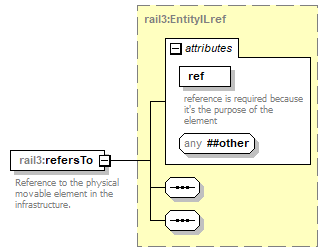 | ||||||||||||||
| namespace | https://www.railml.org/schemas/3.1 | ||||||||||||||
| type | rail3:EntityILref | ||||||||||||||
| properties |
| ||||||||||||||
| attributes |
| ||||||||||||||
| annotation |
| ||||||||||||||
| source | <xs:element name="refersTo" type="rail3:EntityILref" minOccurs="1" maxOccurs="1"> <xs:annotation> <xs:documentation>Reference to the physical movable element in the infrastructure.</xs:documentation> </xs:annotation> </xs:element> |
element MovableElement/hasGaugeClearanceMarker
| diagram | 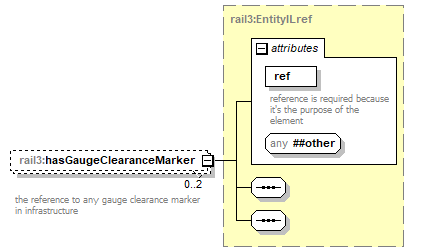 | ||||||||||||||
| namespace | https://www.railml.org/schemas/3.1 | ||||||||||||||
| type | rail3:EntityILref | ||||||||||||||
| properties |
| ||||||||||||||
| attributes |
| ||||||||||||||
| annotation |
| ||||||||||||||
| source | <xs:element name="hasGaugeClearanceMarker" type="rail3:EntityILref" minOccurs="0" maxOccurs="2"> <xs:annotation> <xs:documentation>the reference to any gauge clearance marker in infrastructure</xs:documentation> </xs:annotation> </xs:element> |
element MovableElement/hasTvdSection
| diagram | 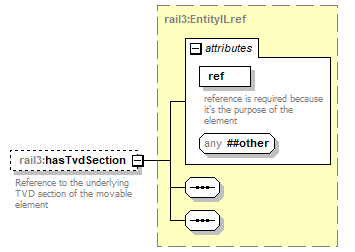 | ||||||||||||||
| namespace | https://www.railml.org/schemas/3.1 | ||||||||||||||
| type | rail3:EntityILref | ||||||||||||||
| properties |
| ||||||||||||||
| attributes |
| ||||||||||||||
| annotation |
| ||||||||||||||
| source | <xs:element name="hasTvdSection" type="rail3:EntityILref" minOccurs="0" maxOccurs="1"> <xs:annotation> <xs:documentation>Reference to the underlying TVD section of the movable element</xs:documentation> </xs:annotation> </xs:element> |
element MovableElement/connectedToPowerSupply
| diagram | 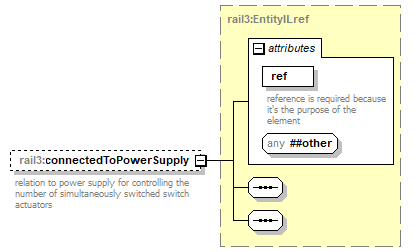 | ||||||||||||||
| namespace | https://www.railml.org/schemas/3.1 | ||||||||||||||
| type | rail3:EntityILref | ||||||||||||||
| properties |
| ||||||||||||||
| attributes |
| ||||||||||||||
| annotation |
| ||||||||||||||
| source | <xs:element name="connectedToPowerSupply" type="rail3:EntityILref" minOccurs="0" maxOccurs="1"> <xs:annotation> <xs:documentation>relation to power supply for controlling the number of simultaneously switched switch actuators</xs:documentation> </xs:annotation> </xs:element> |
element MovableElement/relatedMovableElement
| diagram | 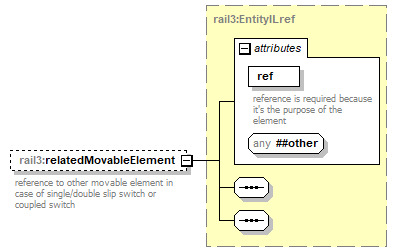 | ||||||||||||||
| namespace | https://www.railml.org/schemas/3.1 | ||||||||||||||
| type | rail3:EntityILref | ||||||||||||||
| properties |
| ||||||||||||||
| attributes |
| ||||||||||||||
| annotation |
| ||||||||||||||
| source | <xs:element name="relatedMovableElement" type="rail3:EntityILref" minOccurs="0" maxOccurs="1"> <xs:annotation> <xs:documentation>reference to other movable element in case of single/double slip switch or coupled switch</xs:documentation> </xs:annotation> </xs:element> |
complexType Overlap
| diagram |  | ||||||||||||||||||||||||||||||||||||||||||||||
| namespace | https://www.railml.org/schemas/3.1 | ||||||||||||||||||||||||||||||||||||||||||||||
| type | extension of rail3:EntityIL | ||||||||||||||||||||||||||||||||||||||||||||||
| properties |
| ||||||||||||||||||||||||||||||||||||||||||||||
| children | rail3:designator rail3:activeForApproachRoute rail3:relatedToTrackAsset rail3:requiresSwitchInPosition rail3:requiresLevelCrossingInState rail3:hasTvdSection rail3:isLimitedBy rail3:overlapRelease | ||||||||||||||||||||||||||||||||||||||||||||||
| used by |
| ||||||||||||||||||||||||||||||||||||||||||||||
| attributes |
| ||||||||||||||||||||||||||||||||||||||||||||||
| annotation |
| ||||||||||||||||||||||||||||||||||||||||||||||
| source | <xs:complexType name="Overlap"> <xs:annotation> <xs:documentation>INESS (INtegrated European Signalling System) definition: A defined section of track in advance of a stop signal, or a stopping point in a continuous signalling system, which must be kept clear to avoid the risk of collision should a train inadvertently run past the signal or the stopping point. Many IMs require overlap beyond active routes to protect from overshoot. One or more sections beyond the exit signal are locked out from use by other routes. The overlap is delimited by train detectors. Facing switches in the overlap are locked, otherwise, use the swinging overlap. Trailing switches in the overlap may normally not locked. Note that there is no need to explicitly identify the switches in the overlap because they can be derived from the begin and endpoints of the overlap. The overlap can be released if the RBC deems that an approaching train is slow enough such that overshoot is unlikely. Trains other than the one for which the route-overlap is locked may be attributed a permitted speed in the overlap. If the value is set to 0 it is not possible to set a route through the overlap. Compare this variable with the release speed that applies to the train that is being released beyond the danger point.</xs:documentation> </xs:annotation> <xs:complexContent> <xs:extension base="rail3:EntityIL"> <xs:sequence> <xs:element name="activeForApproachRoute" type="rail3:EntityILref" minOccurs="0" maxOccurs="unbounded"> <xs:annotation> <xs:documentation>The reference to the related route using the overlap.</xs:documentation> </xs:annotation> </xs:element> <xs:element name="relatedToTrackAsset" type="rail3:EntityILref" minOccurs="0" maxOccurs="1"> <xs:annotation> <xs:documentation>Alternatively to a specific route a reference to a track asset the danger point is related to can be given. This can be a destination signal of a route or any other suitable object.</xs:documentation> </xs:annotation> </xs:element> <xs:element name="requiresSwitchInPosition" type="rail3:SwitchAndGivenPosition" minOccurs="0" maxOccurs="unbounded"> <xs:annotation> <xs:documentation>The reference to any switch in the overlap required to be in a particular position and its position.</xs:documentation> </xs:annotation> </xs:element> <xs:element name="requiresLevelCrossingInState" type="rail3:LevelCrossingAndGivenState" minOccurs="0" maxOccurs="unbounded"> <xs:annotation> <xs:documentation>The reference to any level crossing in the overlap required to be in a particular state and its state.</xs:documentation> </xs:annotation> </xs:element> <xs:element name="hasTvdSection" type="rail3:EntityILref" minOccurs="0" maxOccurs="unbounded"> <xs:annotation> <xs:documentation>The reference to any TVD section(s) within the path of the overlap.</xs:documentation> </xs:annotation> </xs:element> <xs:element name="isLimitedBy" type="rail3:EntityILref" minOccurs="0" maxOccurs="unbounded"> <xs:annotation> <xs:documentation>References to track assets limiting the overlap. It may be used in conjunction to attribute length.</xs:documentation> </xs:annotation> </xs:element> <xs:element name="overlapRelease" type="rail3:OverlapRelease" minOccurs="0" maxOccurs="1"> <xs:annotation> <xs:documentation>Overlap is set in lockstep with the route. The interlocking releases the overlap when it is safe to presume that an approaching train will not overrun a closed destination signal. When the train occupied the last section (or destination area), an overlap release timer starts running. The timer value is defined by operational rules and the approaching speed. Upon expiry, the interlocking releases the overlap. Overlap is released together with the route or after expiration of the release timer. Overlap is released after a defined time in a timer that starts from a timerTriggerPoint.</xs:documentation> </xs:annotation> </xs:element> </xs:sequence> <xs:attribute name="releaseSpeed" type="rail3:tSpeedKmPerHour" use="optional"> <xs:annotation> <xs:documentation>Release speed in km/h associated with the overlap</xs:documentation> </xs:annotation> </xs:attribute> <xs:attribute name="overlapSpeed" type="rail3:tSpeedKmPerHour" use="optional"> <xs:annotation> <xs:documentation>Maximum speed in the overlap in km/h for other trains than the one using the related route.</xs:documentation> </xs:annotation> </xs:attribute> <xs:attribute name="overlapValidityTime" type="xs:duration" use="optional"> <xs:annotation> <xs:documentation>The overlap validity time is the time that the train assumes the overlap to be locked. This is the ETCS validity time T_OL.</xs:documentation> </xs:annotation> </xs:attribute> <xs:attribute name="length" type="rail3:tLengthM" use="optional"> <xs:annotation> <xs:documentation>Alternatively to a particular limit the length of the overlap in metres can be given.</xs:documentation> </xs:annotation> </xs:attribute> </xs:extension> </xs:complexContent> </xs:complexType> |
attribute Overlap/@releaseSpeed
| type | rail3:tSpeedKmPerHour | ||
| properties |
| ||
| annotation |
| ||
| source | <xs:attribute name="releaseSpeed" type="rail3:tSpeedKmPerHour" use="optional"> <xs:annotation> <xs:documentation>Release speed in km/h associated with the overlap</xs:documentation> </xs:annotation> </xs:attribute> |
attribute Overlap/@overlapSpeed
| type | rail3:tSpeedKmPerHour | ||
| properties |
| ||
| annotation |
| ||
| source | <xs:attribute name="overlapSpeed" type="rail3:tSpeedKmPerHour" use="optional"> <xs:annotation> <xs:documentation>Maximum speed in the overlap in km/h for other trains than the one using the related route.</xs:documentation> </xs:annotation> </xs:attribute> |
attribute Overlap/@overlapValidityTime
| type | xs:duration | ||
| properties |
| ||
| annotation |
| ||
| source | <xs:attribute name="overlapValidityTime" type="xs:duration" use="optional"> <xs:annotation> <xs:documentation>The overlap validity time is the time that the train assumes the overlap to be locked. This is the ETCS validity time T_OL.</xs:documentation> </xs:annotation> </xs:attribute> |
attribute Overlap/@length
| type | rail3:tLengthM | ||
| properties |
| ||
| annotation |
| ||
| source | <xs:attribute name="length" type="rail3:tLengthM" use="optional"> <xs:annotation> <xs:documentation>Alternatively to a particular limit the length of the overlap in metres can be given.</xs:documentation> </xs:annotation> </xs:attribute> |
element Overlap/activeForApproachRoute
| diagram | 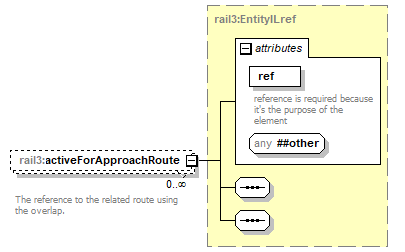 | ||||||||||||||
| namespace | https://www.railml.org/schemas/3.1 | ||||||||||||||
| type | rail3:EntityILref | ||||||||||||||
| properties |
| ||||||||||||||
| attributes |
| ||||||||||||||
| annotation |
| ||||||||||||||
| source | <xs:element name="activeForApproachRoute" type="rail3:EntityILref" minOccurs="0" maxOccurs="unbounded"> <xs:annotation> <xs:documentation>The reference to the related route using the overlap.</xs:documentation> </xs:annotation> </xs:element> |
element Overlap/relatedToTrackAsset
| diagram | 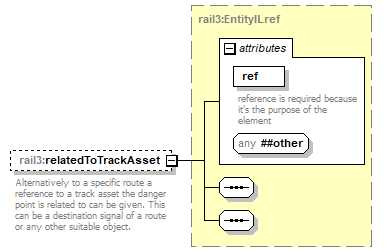 | ||||||||||||||
| namespace | https://www.railml.org/schemas/3.1 | ||||||||||||||
| type | rail3:EntityILref | ||||||||||||||
| properties |
| ||||||||||||||
| attributes |
| ||||||||||||||
| annotation |
| ||||||||||||||
| source | <xs:element name="relatedToTrackAsset" type="rail3:EntityILref" minOccurs="0" maxOccurs="1"> <xs:annotation> <xs:documentation>Alternatively to a specific route a reference to a track asset the danger point is related to can be given. This can be a destination signal of a route or any other suitable object.</xs:documentation> </xs:annotation> </xs:element> |
element Overlap/requiresSwitchInPosition
| diagram | 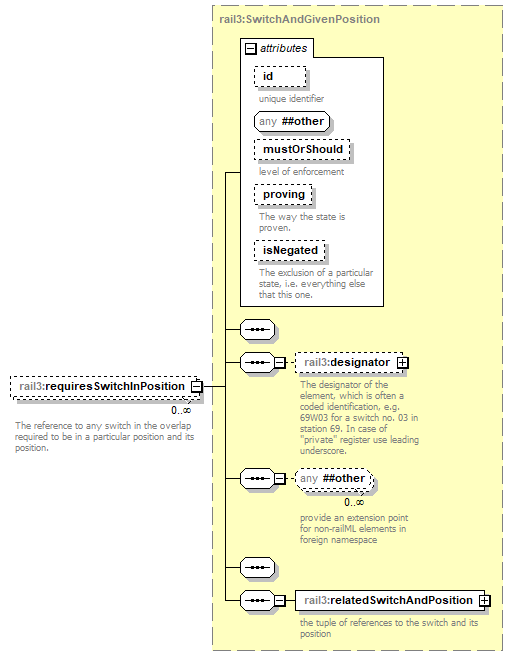 | ||||||||||||||||||||||||||||||||||||||
| namespace | https://www.railml.org/schemas/3.1 | ||||||||||||||||||||||||||||||||||||||
| type | rail3:SwitchAndGivenPosition | ||||||||||||||||||||||||||||||||||||||
| properties |
| ||||||||||||||||||||||||||||||||||||||
| children | rail3:designator rail3:relatedSwitchAndPosition | ||||||||||||||||||||||||||||||||||||||
| attributes |
| ||||||||||||||||||||||||||||||||||||||
| annotation |
| ||||||||||||||||||||||||||||||||||||||
| source | <xs:element name="requiresSwitchInPosition" type="rail3:SwitchAndGivenPosition" minOccurs="0" maxOccurs="unbounded"> <xs:annotation> <xs:documentation>The reference to any switch in the overlap required to be in a particular position and its position.</xs:documentation> </xs:annotation> </xs:element> |
element Overlap/requiresLevelCrossingInState
| diagram | 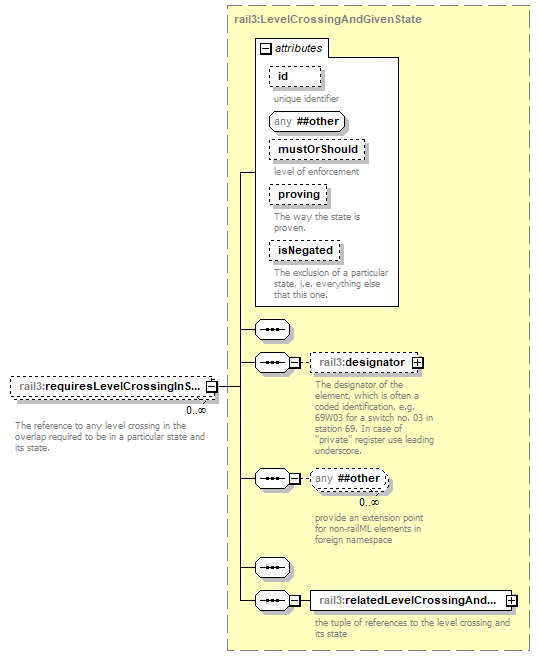 | ||||||||||||||||||||||||||||||||||||||
| namespace | https://www.railml.org/schemas/3.1 | ||||||||||||||||||||||||||||||||||||||
| type | rail3:LevelCrossingAndGivenState | ||||||||||||||||||||||||||||||||||||||
| properties |
| ||||||||||||||||||||||||||||||||||||||
| children | rail3:designator rail3:relatedLevelCrossingAndState | ||||||||||||||||||||||||||||||||||||||
| attributes |
| ||||||||||||||||||||||||||||||||||||||
| annotation |
| ||||||||||||||||||||||||||||||||||||||
| source | <xs:element name="requiresLevelCrossingInState" type="rail3:LevelCrossingAndGivenState" minOccurs="0" maxOccurs="unbounded"> <xs:annotation> <xs:documentation>The reference to any level crossing in the overlap required to be in a particular state and its state.</xs:documentation> </xs:annotation> </xs:element> |
element Overlap/hasTvdSection
| diagram | 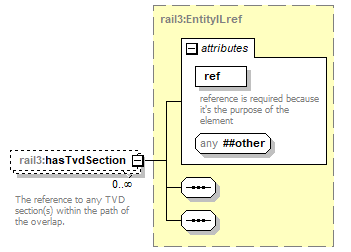 | ||||||||||||||
| namespace | https://www.railml.org/schemas/3.1 | ||||||||||||||
| type | rail3:EntityILref | ||||||||||||||
| properties |
| ||||||||||||||
| attributes |
| ||||||||||||||
| annotation |
| ||||||||||||||
| source | <xs:element name="hasTvdSection" type="rail3:EntityILref" minOccurs="0" maxOccurs="unbounded"> <xs:annotation> <xs:documentation>The reference to any TVD section(s) within the path of the overlap.</xs:documentation> </xs:annotation> </xs:element> |
element Overlap/isLimitedBy
| diagram | 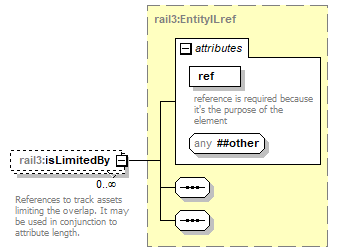 | ||||||||||||||
| namespace | https://www.railml.org/schemas/3.1 | ||||||||||||||
| type | rail3:EntityILref | ||||||||||||||
| properties |
| ||||||||||||||
| attributes |
| ||||||||||||||
| annotation |
| ||||||||||||||
| source | <xs:element name="isLimitedBy" type="rail3:EntityILref" minOccurs="0" maxOccurs="unbounded"> <xs:annotation> <xs:documentation>References to track assets limiting the overlap. It may be used in conjunction to attribute length.</xs:documentation> </xs:annotation> </xs:element> |
element Overlap/overlapRelease
| diagram | 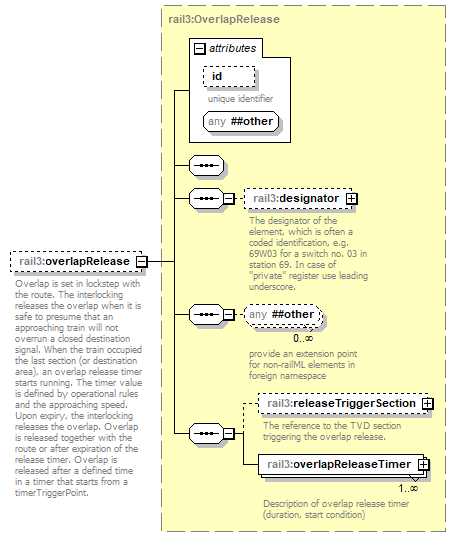 | ||||||||||||||
| namespace | https://www.railml.org/schemas/3.1 | ||||||||||||||
| type | rail3:OverlapRelease | ||||||||||||||
| properties |
| ||||||||||||||
| children | rail3:designator rail3:releaseTriggerSection rail3:overlapReleaseTimer | ||||||||||||||
| attributes |
| ||||||||||||||
| annotation |
| ||||||||||||||
| source | <xs:element name="overlapRelease" type="rail3:OverlapRelease" minOccurs="0" maxOccurs="1"> <xs:annotation> <xs:documentation>Overlap is set in lockstep with the route. The interlocking releases the overlap when it is safe to presume that an approaching train will not overrun a closed destination signal. When the train occupied the last section (or destination area), an overlap release timer starts running. The timer value is defined by operational rules and the approaching speed. Upon expiry, the interlocking releases the overlap. Overlap is released together with the route or after expiration of the release timer. Overlap is released after a defined time in a timer that starts from a timerTriggerPoint.</xs:documentation> </xs:annotation> </xs:element> |
complexType OverlapRelease
| diagram | 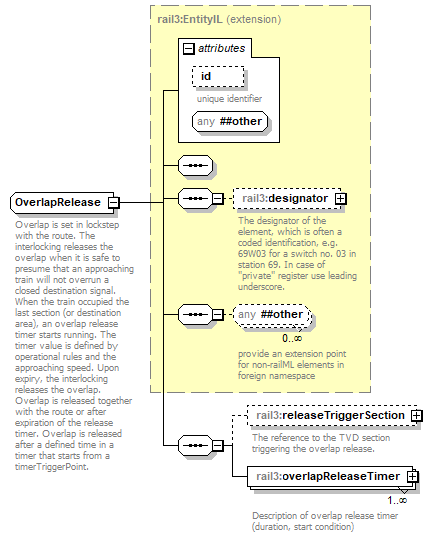 | ||||||||||||||
| namespace | https://www.railml.org/schemas/3.1 | ||||||||||||||
| type | extension of rail3:EntityIL | ||||||||||||||
| properties |
| ||||||||||||||
| children | rail3:designator rail3:releaseTriggerSection rail3:overlapReleaseTimer | ||||||||||||||
| used by |
| ||||||||||||||
| attributes |
| ||||||||||||||
| annotation |
| ||||||||||||||
| source | <xs:complexType name="OverlapRelease"> <xs:annotation> <xs:documentation>Overlap is set in lockstep with the route. The interlocking releases the overlap when it is safe to presume that an approaching train will not overrun a closed destination signal. When the train occupied the last section (or destination area), an overlap release timer starts running. The timer value is defined by operational rules and the approaching speed. Upon expiry, the interlocking releases the overlap. Overlap is released together with the route or after expiration of the release timer. Overlap is released after a defined time in a timer that starts from a timerTriggerPoint.</xs:documentation> </xs:annotation> <xs:complexContent> <xs:extension base="rail3:EntityIL"> <xs:sequence> <xs:element name="releaseTriggerSection" type="rail3:EntityILref" minOccurs="0" maxOccurs="1"> <xs:annotation> <xs:documentation>The reference to the TVD section triggering the overlap release.</xs:documentation> </xs:annotation> </xs:element> <xs:element name="overlapReleaseTimer" type="rail3:OverlapReleaseTimer" minOccurs="1" maxOccurs="unbounded"> <xs:annotation> <xs:documentation>Description of overlap release timer (duration, start condition)</xs:documentation> </xs:annotation> </xs:element> </xs:sequence> </xs:extension> </xs:complexContent> </xs:complexType> |
element OverlapRelease/releaseTriggerSection
| diagram | 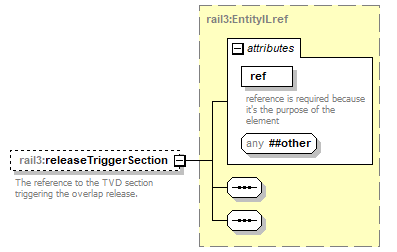 | ||||||||||||||
| namespace | https://www.railml.org/schemas/3.1 | ||||||||||||||
| type | rail3:EntityILref | ||||||||||||||
| properties |
| ||||||||||||||
| attributes |
| ||||||||||||||
| annotation |
| ||||||||||||||
| source | <xs:element name="releaseTriggerSection" type="rail3:EntityILref" minOccurs="0" maxOccurs="1"> <xs:annotation> <xs:documentation>The reference to the TVD section triggering the overlap release.</xs:documentation> </xs:annotation> </xs:element> |
element OverlapRelease/overlapReleaseTimer
| diagram | 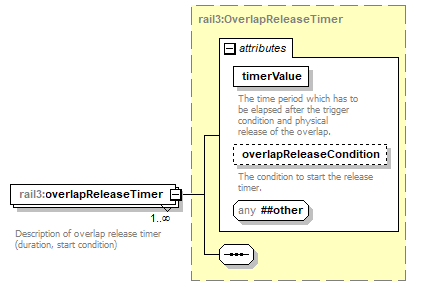 | ||||||||||||||||||||||
| namespace | https://www.railml.org/schemas/3.1 | ||||||||||||||||||||||
| type | rail3:OverlapReleaseTimer | ||||||||||||||||||||||
| properties |
| ||||||||||||||||||||||
| attributes |
| ||||||||||||||||||||||
| annotation |
| ||||||||||||||||||||||
| source | <xs:element name="overlapReleaseTimer" type="rail3:OverlapReleaseTimer" minOccurs="1" maxOccurs="unbounded"> <xs:annotation> <xs:documentation>Description of overlap release timer (duration, start condition)</xs:documentation> </xs:annotation> </xs:element> |
complexType OverlapReleaseTimer
| diagram | 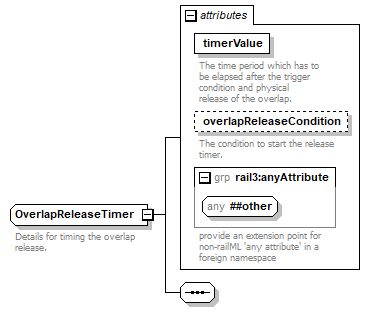 | ||||||||||||||||||||||
| namespace | https://www.railml.org/schemas/3.1 | ||||||||||||||||||||||
| used by |
| ||||||||||||||||||||||
| attributes |
| ||||||||||||||||||||||
| annotation |
| ||||||||||||||||||||||
| source | <xs:complexType name="OverlapReleaseTimer"> <xs:annotation> <xs:documentation>Details for timing the overlap release.</xs:documentation> </xs:annotation> <xs:sequence/> <xs:attribute name="timerValue" type="xs:duration" use="required"> <xs:annotation> <xs:documentation>The time period which has to be elapsed after the trigger condition and physical release of the overlap.</xs:documentation> </xs:annotation> </xs:attribute> <xs:attribute name="overlapReleaseCondition" type="rail3:tOverlapReleaseCondition" use="optional"> <xs:annotation> <xs:documentation>The condition to start the release timer.</xs:documentation> </xs:annotation> </xs:attribute> <xs:attributeGroup ref="rail3:anyAttribute"/> </xs:complexType> |
attribute OverlapReleaseTimer/@timerValue
| type | xs:duration | ||
| properties |
| ||
| annotation |
| ||
| source | <xs:attribute name="timerValue" type="xs:duration" use="required"> <xs:annotation> <xs:documentation>The time period which has to be elapsed after the trigger condition and physical release of the overlap.</xs:documentation> </xs:annotation> </xs:attribute> |
attribute OverlapReleaseTimer/@overlapReleaseCondition
| type | rail3:tOverlapReleaseCondition | ||||||||||||
| properties |
| ||||||||||||
| facets |
| ||||||||||||
| annotation |
| ||||||||||||
| source | <xs:attribute name="overlapReleaseCondition" type="rail3:tOverlapReleaseCondition" use="optional"> <xs:annotation> <xs:documentation>The condition to start the release timer.</xs:documentation> </xs:annotation> </xs:attribute> |
complexType Overlaps
| diagram | 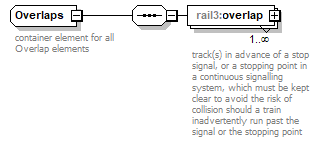 | ||
| namespace | https://www.railml.org/schemas/3.1 | ||
| children | rail3:overlap | ||
| used by |
| ||
| annotation |
| ||
| source | <xs:complexType name="Overlaps"> <xs:annotation> <xs:documentation>container element for all Overlap elements</xs:documentation> </xs:annotation> <xs:sequence> <xs:element name="overlap" type="rail3:Overlap" minOccurs="1" maxOccurs="unbounded"> <xs:annotation> <xs:documentation>track(s) in advance of a stop signal, or a stopping point in a continuous signalling system, which must be kept clear to avoid the risk of collision should a train inadvertently run past the signal or the stopping point</xs:documentation> </xs:annotation> </xs:element> </xs:sequence> </xs:complexType> |
element Overlaps/overlap
| diagram |  | ||||||||||||||||||||||||||||||||||||||||||||||
| namespace | https://www.railml.org/schemas/3.1 | ||||||||||||||||||||||||||||||||||||||||||||||
| type | rail3:Overlap | ||||||||||||||||||||||||||||||||||||||||||||||
| properties |
| ||||||||||||||||||||||||||||||||||||||||||||||
| children | rail3:designator rail3:activeForApproachRoute rail3:relatedToTrackAsset rail3:requiresSwitchInPosition rail3:requiresLevelCrossingInState rail3:hasTvdSection rail3:isLimitedBy rail3:overlapRelease | ||||||||||||||||||||||||||||||||||||||||||||||
| attributes |
| ||||||||||||||||||||||||||||||||||||||||||||||
| annotation |
| ||||||||||||||||||||||||||||||||||||||||||||||
| source | <xs:element name="overlap" type="rail3:Overlap" minOccurs="1" maxOccurs="unbounded"> <xs:annotation> <xs:documentation>track(s) in advance of a stop signal, or a stopping point in a continuous signalling system, which must be kept clear to avoid the risk of collision should a train inadvertently run past the signal or the stopping point</xs:documentation> </xs:annotation> </xs:element> |
complexType PartialRoute
| diagram | 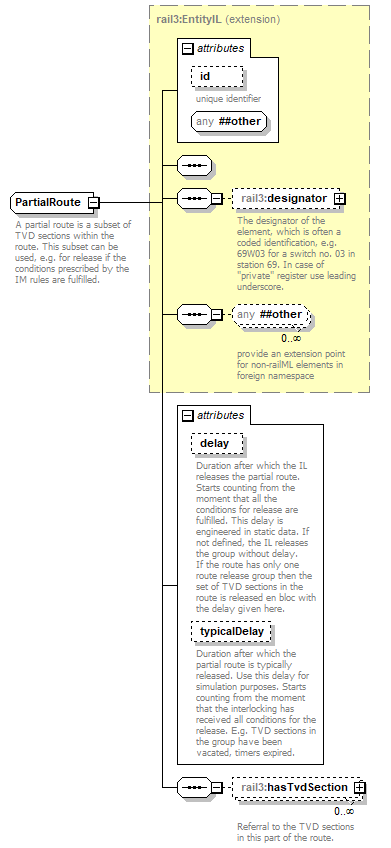 | ||||||||||||||||||||||||||||||
| namespace | https://www.railml.org/schemas/3.1 | ||||||||||||||||||||||||||||||
| type | extension of rail3:EntityIL | ||||||||||||||||||||||||||||||
| properties |
| ||||||||||||||||||||||||||||||
| children | rail3:designator rail3:hasTvdSection | ||||||||||||||||||||||||||||||
| used by |
| ||||||||||||||||||||||||||||||
| attributes |
| ||||||||||||||||||||||||||||||
| annotation |
| ||||||||||||||||||||||||||||||
| source | <xs:complexType name="PartialRoute" abstract="true"> <xs:annotation> <xs:documentation>A partial route is a subset of TVD sections within the route. This subset can be used, e.g. for release if the conditions prescribed by the IM rules are fulfilled.</xs:documentation> </xs:annotation> <xs:complexContent> <xs:extension base="rail3:EntityIL"> <xs:sequence> <xs:element name="hasTvdSection" type="rail3:EntityILref" minOccurs="0" maxOccurs="unbounded"> <xs:annotation> <xs:documentation>Referral to the TVD sections in this part of the route.</xs:documentation> </xs:annotation> </xs:element> </xs:sequence> <xs:attribute name="delay" type="xs:duration" use="optional"> <xs:annotation> <xs:documentation>Duration after which the IL releases the partial route. Starts counting from the moment that all the conditions for release are fulfilled. This delay is engineered in static data. If not defined, the IL releases the group without delay. If the route has only one route release group then the set of TVD sections in the route is released en bloc with the delay given here.</xs:documentation> </xs:annotation> </xs:attribute> <xs:attribute name="typicalDelay" type="xs:duration" use="optional"> <xs:annotation> <xs:documentation>Duration after which the partial route is typically released. Use this delay for simulation purposes. Starts counting from the moment that the interlocking has received all conditions for the release. E.g. TVD sections in the group have been vacated, timers expired.</xs:documentation> </xs:annotation> </xs:attribute> </xs:extension> </xs:complexContent> </xs:complexType> |
attribute PartialRoute/@delay
| type | xs:duration | ||
| properties |
| ||
| annotation |
| ||
| source | <xs:attribute name="delay" type="xs:duration" use="optional"> <xs:annotation> <xs:documentation>Duration after which the IL releases the partial route. Starts counting from the moment that all the conditions for release are fulfilled. This delay is engineered in static data. If not defined, the IL releases the group without delay. If the route has only one route release group then the set of TVD sections in the route is released en bloc with the delay given here.</xs:documentation> </xs:annotation> </xs:attribute> |
attribute PartialRoute/@typicalDelay
| type | xs:duration | ||
| properties |
| ||
| annotation |
| ||
| source | <xs:attribute name="typicalDelay" type="xs:duration" use="optional"> <xs:annotation> <xs:documentation>Duration after which the partial route is typically released. Use this delay for simulation purposes. Starts counting from the moment that the interlocking has received all conditions for the release. E.g. TVD sections in the group have been vacated, timers expired.</xs:documentation> </xs:annotation> </xs:attribute> |
element PartialRoute/hasTvdSection
| diagram | 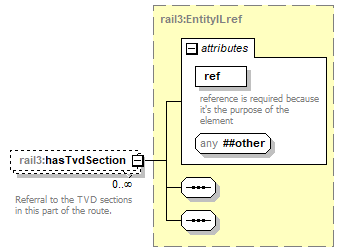 | ||||||||||||||
| namespace | https://www.railml.org/schemas/3.1 | ||||||||||||||
| type | rail3:EntityILref | ||||||||||||||
| properties |
| ||||||||||||||
| attributes |
| ||||||||||||||
| annotation |
| ||||||||||||||
| source | <xs:element name="hasTvdSection" type="rail3:EntityILref" minOccurs="0" maxOccurs="unbounded"> <xs:annotation> <xs:documentation>Referral to the TVD sections in this part of the route.</xs:documentation> </xs:annotation> </xs:element> |
complexType PartialRoutes
| diagram |  | ||
| namespace | https://www.railml.org/schemas/3.1 | ||
| children | rail3:knowsPartialRoute | ||
| annotation |
| ||
| source | <xs:complexType name="PartialRoutes"> <xs:annotation> <xs:documentation>container element for all PartialRoute elements</xs:documentation> </xs:annotation> <xs:sequence minOccurs="0" maxOccurs="1"> <xs:element name="knowsPartialRoute" type="rail3:PartialRoute" minOccurs="1" maxOccurs="unbounded"/> </xs:sequence> </xs:complexType> |
element PartialRoutes/knowsPartialRoute
| diagram | 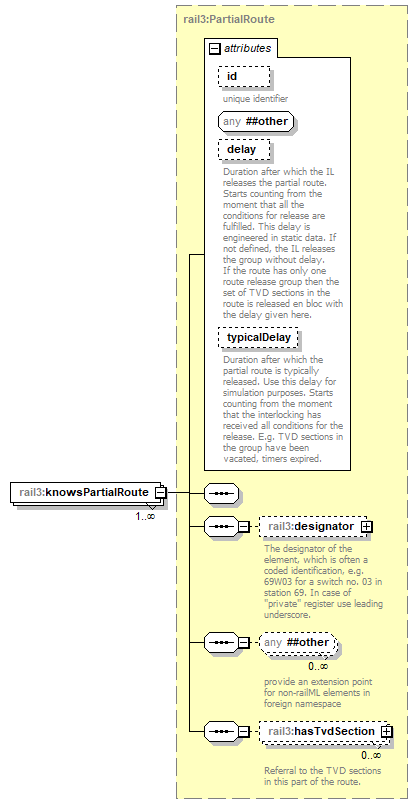 | ||||||||||||||||||||||||||||||
| namespace | https://www.railml.org/schemas/3.1 | ||||||||||||||||||||||||||||||
| type | rail3:PartialRoute | ||||||||||||||||||||||||||||||
| properties |
| ||||||||||||||||||||||||||||||
| children | rail3:designator rail3:hasTvdSection | ||||||||||||||||||||||||||||||
| attributes |
| ||||||||||||||||||||||||||||||
| source | <xs:element name="knowsPartialRoute" type="rail3:PartialRoute" minOccurs="1" maxOccurs="unbounded"/> |
complexType PermissionZone
| diagram | 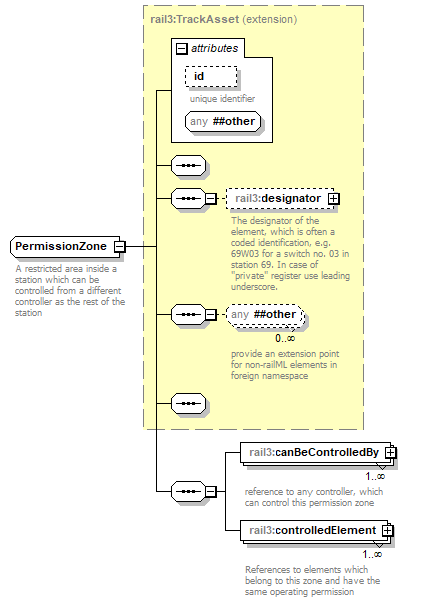 | ||||||||||||||
| namespace | https://www.railml.org/schemas/3.1 | ||||||||||||||
| type | extension of rail3:TrackAsset | ||||||||||||||
| properties |
| ||||||||||||||
| children | rail3:designator rail3:canBeControlledBy rail3:controlledElement | ||||||||||||||
| used by |
| ||||||||||||||
| attributes |
| ||||||||||||||
| annotation |
| ||||||||||||||
| source | <xs:complexType name="PermissionZone"> <xs:annotation> <xs:documentation>A restricted area inside a station which can be controlled from a different controller as the rest of the station</xs:documentation> </xs:annotation> <xs:complexContent> <xs:extension base="rail3:TrackAsset"> <xs:sequence> <xs:element name="canBeControlledBy" type="rail3:EntityILref" minOccurs="1" maxOccurs="unbounded"> <xs:annotation> <xs:documentation>reference to any controller, which can control this permission zone</xs:documentation> </xs:annotation> </xs:element> <xs:element name="controlledElement" type="rail3:EntityILref" minOccurs="1" maxOccurs="unbounded"> <xs:annotation> <xs:documentation>References to elements which belong to this zone and have the same operating permission</xs:documentation> </xs:annotation> </xs:element> </xs:sequence> </xs:extension> </xs:complexContent> </xs:complexType> |
element PermissionZone/canBeControlledBy
| diagram | 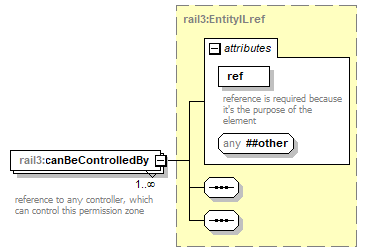 | ||||||||||||||
| namespace | https://www.railml.org/schemas/3.1 | ||||||||||||||
| type | rail3:EntityILref | ||||||||||||||
| properties |
| ||||||||||||||
| attributes |
| ||||||||||||||
| annotation |
| ||||||||||||||
| source | <xs:element name="canBeControlledBy" type="rail3:EntityILref" minOccurs="1" maxOccurs="unbounded"> <xs:annotation> <xs:documentation>reference to any controller, which can control this permission zone</xs:documentation> </xs:annotation> </xs:element> |
element PermissionZone/controlledElement
| diagram | 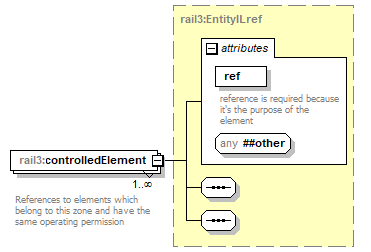 | ||||||||||||||
| namespace | https://www.railml.org/schemas/3.1 | ||||||||||||||
| type | rail3:EntityILref | ||||||||||||||
| properties |
| ||||||||||||||
| attributes |
| ||||||||||||||
| annotation |
| ||||||||||||||
| source | <xs:element name="controlledElement" type="rail3:EntityILref" minOccurs="1" maxOccurs="unbounded"> <xs:annotation> <xs:documentation>References to elements which belong to this zone and have the same operating permission</xs:documentation> </xs:annotation> </xs:element> |
complexType PermissionZones
| diagram | 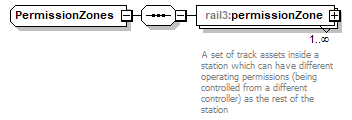 | ||
| namespace | https://www.railml.org/schemas/3.1 | ||
| children | rail3:permissionZone | ||
| used by |
| ||
| source | <xs:complexType name="PermissionZones"> <xs:sequence> <xs:element name="permissionZone" type="rail3:PermissionZone" minOccurs="1" maxOccurs="unbounded"> <xs:annotation> <xs:documentation>A set of track assets inside a station which can have different operating permissions (being controlled from a different controller) as the rest of the station</xs:documentation> </xs:annotation> </xs:element> </xs:sequence> </xs:complexType> |
element PermissionZones/permissionZone
| diagram | 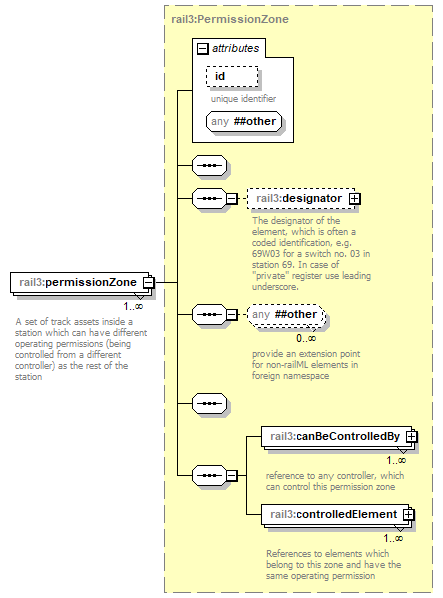 | ||||||||||||||
| namespace | https://www.railml.org/schemas/3.1 | ||||||||||||||
| type | rail3:PermissionZone | ||||||||||||||
| properties |
| ||||||||||||||
| children | rail3:designator rail3:canBeControlledBy rail3:controlledElement | ||||||||||||||
| attributes |
| ||||||||||||||
| annotation |
| ||||||||||||||
| source | <xs:element name="permissionZone" type="rail3:PermissionZone" minOccurs="1" maxOccurs="unbounded"> <xs:annotation> <xs:documentation>A set of track assets inside a station which can have different operating permissions (being controlled from a different controller) as the rest of the station</xs:documentation> </xs:annotation> </xs:element> |
complexType PowerSuppliesIL
| diagram |  | ||
| namespace | https://www.railml.org/schemas/3.1 | ||
| children | rail3:powerSupplyIL | ||
| used by |
| ||
| annotation |
| ||
| source | <xs:complexType name="PowerSuppliesIL"> <xs:annotation> <xs:documentation>container element for all PowerSupplyIL elements</xs:documentation> </xs:annotation> <xs:sequence minOccurs="0" maxOccurs="1"> <xs:element name="powerSupplyIL" type="rail3:PowerSupplyIL" minOccurs="1" maxOccurs="unbounded"> <xs:annotation> <xs:documentation>specific features of power supply used for interlocking</xs:documentation> </xs:annotation> </xs:element> </xs:sequence> </xs:complexType> |
element PowerSuppliesIL/powerSupplyIL
| diagram | 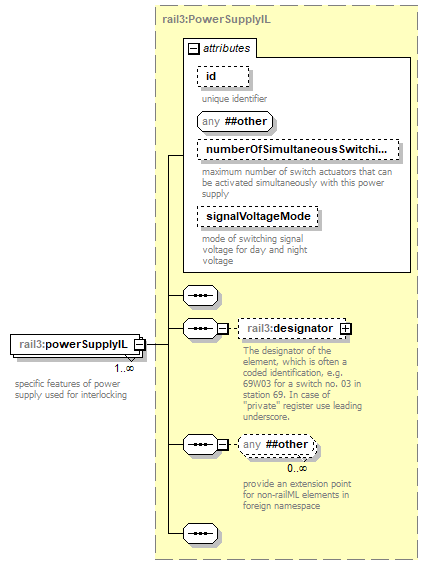 | ||||||||||||||||||||||||||||||
| namespace | https://www.railml.org/schemas/3.1 | ||||||||||||||||||||||||||||||
| type | rail3:PowerSupplyIL | ||||||||||||||||||||||||||||||
| properties |
| ||||||||||||||||||||||||||||||
| children | rail3:designator | ||||||||||||||||||||||||||||||
| attributes |
| ||||||||||||||||||||||||||||||
| annotation |
| ||||||||||||||||||||||||||||||
| source | <xs:element name="powerSupplyIL" type="rail3:PowerSupplyIL" minOccurs="1" maxOccurs="unbounded"> <xs:annotation> <xs:documentation>specific features of power supply used for interlocking</xs:documentation> </xs:annotation> </xs:element> |
complexType PowerSupplyIL
| diagram | 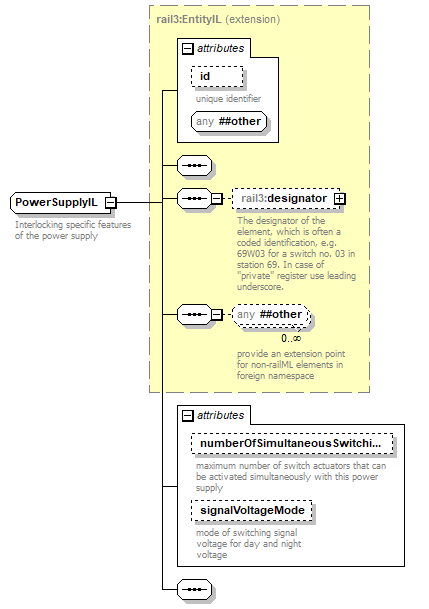 | ||||||||||||||||||||||||||||||
| namespace | https://www.railml.org/schemas/3.1 | ||||||||||||||||||||||||||||||
| type | extension of rail3:EntityIL | ||||||||||||||||||||||||||||||
| properties |
| ||||||||||||||||||||||||||||||
| children | rail3:designator | ||||||||||||||||||||||||||||||
| used by |
| ||||||||||||||||||||||||||||||
| attributes |
| ||||||||||||||||||||||||||||||
| annotation |
| ||||||||||||||||||||||||||||||
| source | <xs:complexType name="PowerSupplyIL"> <xs:annotation> <xs:documentation>Interlocking specific features of the power supply</xs:documentation> </xs:annotation> <xs:complexContent> <xs:extension base="rail3:EntityIL"> <xs:sequence/> <xs:attribute name="numberOfSimultaneousSwitchingActuators" type="xs:nonNegativeInteger" use="optional"> <xs:annotation> <xs:documentation>maximum number of switch actuators that can be activated simultaneously with this power supply</xs:documentation> </xs:annotation> </xs:attribute> <xs:attribute name="signalVoltageMode" type="rail3:tSignalVoltageModes" use="optional"> <xs:annotation> <xs:documentation>mode of switching signal voltage for day and night voltage</xs:documentation> </xs:annotation> </xs:attribute> </xs:extension> </xs:complexContent> </xs:complexType> |
attribute PowerSupplyIL/@numberOfSimultaneousSwitchingActuators
| type | xs:nonNegativeInteger | ||
| properties |
| ||
| annotation |
| ||
| source | <xs:attribute name="numberOfSimultaneousSwitchingActuators" type="xs:nonNegativeInteger" use="optional"> <xs:annotation> <xs:documentation>maximum number of switch actuators that can be activated simultaneously with this power supply</xs:documentation> </xs:annotation> </xs:attribute> |
attribute PowerSupplyIL/@signalVoltageMode
| type | rail3:tSignalVoltageModes | |||||||||||||||
| properties |
| |||||||||||||||
| facets |
| |||||||||||||||
| annotation |
| |||||||||||||||
| source | <xs:attribute name="signalVoltageMode" type="rail3:tSignalVoltageModes" use="optional"> <xs:annotation> <xs:documentation>mode of switching signal voltage for day and night voltage</xs:documentation> </xs:annotation> </xs:attribute> |
complexType RestrictedArea
| diagram | 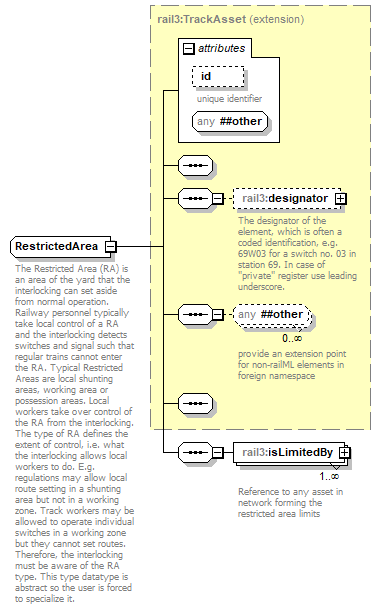 | ||||||||||||||
| namespace | https://www.railml.org/schemas/3.1 | ||||||||||||||
| type | extension of rail3:TrackAsset | ||||||||||||||
| properties |
| ||||||||||||||
| children | rail3:designator rail3:isLimitedBy | ||||||||||||||
| used by |
| ||||||||||||||
| attributes |
| ||||||||||||||
| annotation |
| ||||||||||||||
| source | <xs:complexType name="RestrictedArea" abstract="true"> <xs:annotation> <xs:documentation>The Restricted Area (RA) is an area of the yard that the interlocking can set aside from normal operation. Railway personnel typically take local control of a RA and the interlocking detects switches and signal such that regular trains cannot enter the RA. Typical Restricted Areas are local shunting areas, working area or possession areas. Local workers take over control of the RA from the interlocking. The type of RA defines the extent of control, i.e. what the interlocking allows local workers to do. E.g. regulations may allow local route setting in a shunting area but not in a working zone. Track workers may be allowed to operate individual switches in a working zone but they cannot set routes. Therefore, the interlocking must be aware of the RA type. This type datatype is abstract so the user is forced to specialize it.</xs:documentation> </xs:annotation> <xs:complexContent> <xs:extension base="rail3:TrackAsset"> <xs:sequence> <xs:element name="isLimitedBy" type="rail3:EntityILref" minOccurs="1" maxOccurs="unbounded"> <xs:annotation> <xs:documentation>Reference to any asset in network forming the restricted area limits</xs:documentation> </xs:annotation> </xs:element> </xs:sequence> </xs:extension> </xs:complexContent> </xs:complexType> |
element RestrictedArea/isLimitedBy
| diagram | 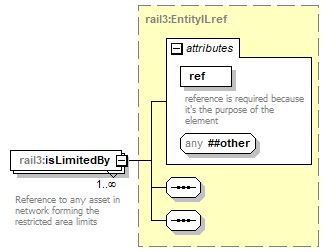 | ||||||||||||||
| namespace | https://www.railml.org/schemas/3.1 | ||||||||||||||
| type | rail3:EntityILref | ||||||||||||||
| properties |
| ||||||||||||||
| attributes |
| ||||||||||||||
| annotation |
| ||||||||||||||
| source | <xs:element name="isLimitedBy" type="rail3:EntityILref" minOccurs="1" maxOccurs="unbounded"> <xs:annotation> <xs:documentation>Reference to any asset in network forming the restricted area limits</xs:documentation> </xs:annotation> </xs:element> |
complexType RestrictedAreas
| diagram |  | ||
| namespace | https://www.railml.org/schemas/3.1 | ||
| children | rail3:ownsRestrictedArea | ||
| annotation |
| ||
| source | <xs:complexType name="RestrictedAreas"> <xs:annotation> <xs:documentation>container element for all instances of RestrictedArea elements</xs:documentation> </xs:annotation> <xs:sequence minOccurs="0" maxOccurs="1"> <xs:element name="ownsRestrictedArea" type="rail3:RestrictedArea" minOccurs="1" maxOccurs="unbounded"/> </xs:sequence> </xs:complexType> |
element RestrictedAreas/ownsRestrictedArea
| diagram | 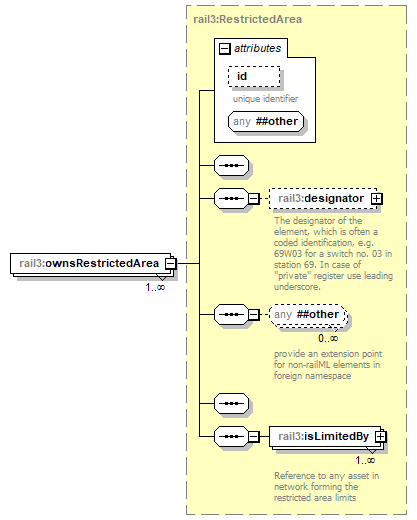 | ||||||||||||||
| namespace | https://www.railml.org/schemas/3.1 | ||||||||||||||
| type | rail3:RestrictedArea | ||||||||||||||
| properties |
| ||||||||||||||
| children | rail3:designator rail3:isLimitedBy | ||||||||||||||
| attributes |
| ||||||||||||||
| source | <xs:element name="ownsRestrictedArea" type="rail3:RestrictedArea" minOccurs="1" maxOccurs="unbounded"/> |
complexType Route
| diagram |  | ||||||||||||||||||||||||||||||||||||||||||||||||||||||
| namespace | https://www.railml.org/schemas/3.1 | ||||||||||||||||||||||||||||||||||||||||||||||||||||||
| type | extension of rail3:TrackAsset | ||||||||||||||||||||||||||||||||||||||||||||||||||||||
| properties |
| ||||||||||||||||||||||||||||||||||||||||||||||||||||||
| children | rail3:designator rail3:handlesRouteType rail3:routeActivationSection rail3:facingSwitchInPosition rail3:hasTvdSection rail3:routeEntry rail3:hasReleaseGroup rail3:switchPositionInDepartureTrack rail3:routeExit rail3:additionalRelation | ||||||||||||||||||||||||||||||||||||||||||||||||||||||
| used by |
| ||||||||||||||||||||||||||||||||||||||||||||||||||||||
| attributes |
| ||||||||||||||||||||||||||||||||||||||||||||||||||||||
| annotation |
| ||||||||||||||||||||||||||||||||||||||||||||||||||||||
| source | <xs:complexType name="Route"> <xs:annotation> <xs:documentation>We define a route as an entry- and exit plus the positions of intermediate switches. If there are no switches in the route, no switch positions can be defined. If one or more switches are encountered en route, either facing or trailing, the positions of these switches must be given. There can be multiple routes from entry to exit depending on the positions of the intermediate switches. The user is free to create different routes with the same entry,exit and same switch positions that differ only by the classifier. This allows one to distinguish for example a traction-route from no-traction-route</xs:documentation> </xs:annotation> <xs:complexContent> <xs:extension base="rail3:TrackAsset"> <xs:sequence> <xs:element name="handlesRouteType" type="rail3:EntityILref" minOccurs="0" maxOccurs="unbounded"> <xs:annotation> <xs:documentation>The reference to the IM specific route type. This implies particular characteristics of the route dependent on the IM operational rules.</xs:documentation> </xs:annotation> </xs:element> <xs:element name="routeActivationSection" type="rail3:RouteActivationSection" minOccurs="0" maxOccurs="unbounded"> <xs:annotation> <xs:documentation>Description of the route activation, i.e. automatic setting or locking when the route entry is approached.</xs:documentation> </xs:annotation> </xs:element> <xs:element name="facingSwitchInPosition" type="rail3:SwitchAndPosition" minOccurs="0" maxOccurs="unbounded"> <xs:annotation> <xs:documentation>The tuple for each facing switch in the running path to unambiguously define the route containing the reference to the switch and its position.</xs:documentation> </xs:annotation> </xs:element> <xs:element name="hasTvdSection" type="rail3:EntityILref" minOccurs="0" maxOccurs="unbounded"> <xs:annotation> <xs:documentation>The reference to TVD section(s) within the running path of the route.</xs:documentation> </xs:annotation> </xs:element> <xs:element name="routeEntry" type="rail3:RouteEntry" minOccurs="1" maxOccurs="1"> <xs:annotation> <xs:documentation>Description of the start point of the route. This is normally a signal.</xs:documentation> </xs:annotation> </xs:element> <xs:element name="hasReleaseGroup" type="rail3:EntityILref" minOccurs="0" maxOccurs="unbounded"> <xs:annotation> <xs:documentation>The references to any partial routes which are to be released together within a group.</xs:documentation> </xs:annotation> </xs:element> <xs:element name="switchPositionInDepartureTrack" type="rail3:SwitchAndPosition" minOccurs="0" maxOccurs="unbounded"> <xs:annotation> <xs:documentation>The tuple for any switch in the track in rear of the start signal required for this route containing the reference to the switch and its position.</xs:documentation> </xs:annotation> </xs:element> <xs:element name="routeExit" type="rail3:RouteExit" minOccurs="1" maxOccurs="1"> <xs:annotation> <xs:documentation>Description of the route destination point. In most cases the route destination is a signal or a buffer stop. </xs:documentation> </xs:annotation> </xs:element> <xs:element name="additionalRelation" type="rail3:EntityILref" minOccurs="0" maxOccurs="unbounded"> <xs:annotation> <xs:documentation>reference to any additional relation needed for signalling of this route</xs:documentation> </xs:annotation> </xs:element> </xs:sequence> <xs:attribute name="locksAutomatically" type="xs:boolean" use="optional"> <xs:annotation> <xs:documentation>If true, the interlocking locks this route automatically and immediately after it was cleared. The operator has to intervene if he wishes to call another route. Automatikfahrstrasse in German, trace automatique in French. Note that this functionality is often part of the control system in which case this attribute should be omitted.</xs:documentation> </xs:annotation> </xs:attribute> <xs:attribute name="processingDelay" type="xs:duration" use="optional"> <xs:annotation> <xs:documentation>The delay in seconds between the moment the interlocking receives the route call and the moment the route the interlocking reports back that the route is locked, i.e. the processing time for setting that route.</xs:documentation> </xs:annotation> </xs:attribute> <xs:attribute name="proceedAspectDelay" type="xs:duration" use="optional"> <xs:annotation> <xs:documentation>The delay for the signal before it will change from closed to any proceed aspect.</xs:documentation> </xs:annotation> </xs:attribute> <xs:attribute name="signalClosureDelay" type="xs:duration" use="optional"> <xs:annotation> <xs:documentation>The delay for the signal after the conditions for proceed aspect are removed and the physical closure of the signal.</xs:documentation> </xs:annotation> </xs:attribute> <xs:attribute name="approachReleaseDelay" type="xs:duration" use="optional"> <xs:annotation> <xs:documentation>The delay between the request from signalman to release an already approached (definitely locked) route and the real release of associated elements of the route.</xs:documentation> </xs:annotation> </xs:attribute> </xs:extension> </xs:complexContent> </xs:complexType> |
attribute Route/@locksAutomatically
| type | xs:boolean | ||
| properties |
| ||
| annotation |
| ||
| source | <xs:attribute name="locksAutomatically" type="xs:boolean" use="optional"> <xs:annotation> <xs:documentation>If true, the interlocking locks this route automatically and immediately after it was cleared. The operator has to intervene if he wishes to call another route. Automatikfahrstrasse in German, trace automatique in French. Note that this functionality is often part of the control system in which case this attribute should be omitted.</xs:documentation> </xs:annotation> </xs:attribute> |
attribute Route/@processingDelay
| type | xs:duration | ||
| properties |
| ||
| annotation |
| ||
| source | <xs:attribute name="processingDelay" type="xs:duration" use="optional"> <xs:annotation> <xs:documentation>The delay in seconds between the moment the interlocking receives the route call and the moment the route the interlocking reports back that the route is locked, i.e. the processing time for setting that route.</xs:documentation> </xs:annotation> </xs:attribute> |
attribute Route/@proceedAspectDelay
| type | xs:duration | ||
| properties |
| ||
| annotation |
| ||
| source | <xs:attribute name="proceedAspectDelay" type="xs:duration" use="optional"> <xs:annotation> <xs:documentation>The delay for the signal before it will change from closed to any proceed aspect.</xs:documentation> </xs:annotation> </xs:attribute> |
attribute Route/@signalClosureDelay
| type | xs:duration | ||
| properties |
| ||
| annotation |
| ||
| source | <xs:attribute name="signalClosureDelay" type="xs:duration" use="optional"> <xs:annotation> <xs:documentation>The delay for the signal after the conditions for proceed aspect are removed and the physical closure of the signal.</xs:documentation> </xs:annotation> </xs:attribute> |
attribute Route/@approachReleaseDelay
| type | xs:duration | ||
| properties |
| ||
| annotation |
| ||
| source | <xs:attribute name="approachReleaseDelay" type="xs:duration" use="optional"> <xs:annotation> <xs:documentation>The delay between the request from signalman to release an already approached (definitely locked) route and the real release of associated elements of the route.</xs:documentation> </xs:annotation> </xs:attribute> |
element Route/handlesRouteType
| diagram | 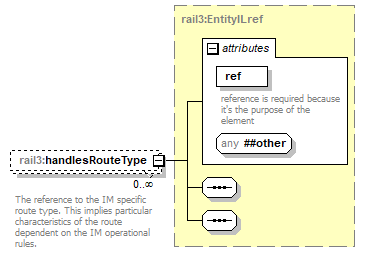 | ||||||||||||||
| namespace | https://www.railml.org/schemas/3.1 | ||||||||||||||
| type | rail3:EntityILref | ||||||||||||||
| properties |
| ||||||||||||||
| attributes |
| ||||||||||||||
| annotation |
| ||||||||||||||
| source | <xs:element name="handlesRouteType" type="rail3:EntityILref" minOccurs="0" maxOccurs="unbounded"> <xs:annotation> <xs:documentation>The reference to the IM specific route type. This implies particular characteristics of the route dependent on the IM operational rules.</xs:documentation> </xs:annotation> </xs:element> |
element Route/routeActivationSection
| diagram | 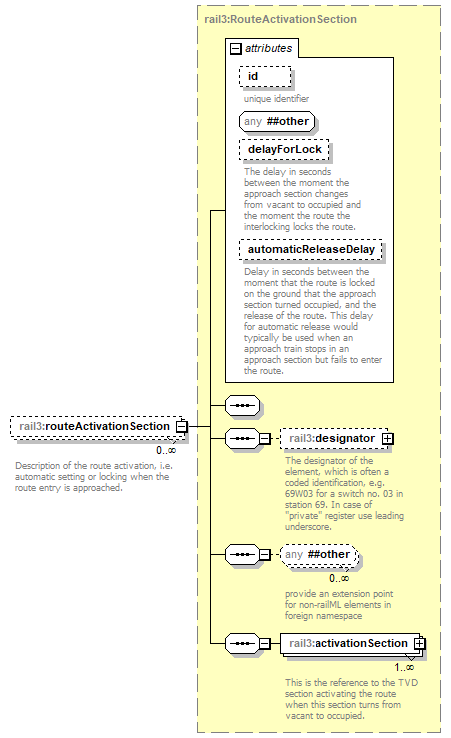 | ||||||||||||||||||||||||||||||
| namespace | https://www.railml.org/schemas/3.1 | ||||||||||||||||||||||||||||||
| type | rail3:RouteActivationSection | ||||||||||||||||||||||||||||||
| properties |
| ||||||||||||||||||||||||||||||
| children | rail3:designator rail3:activationSection | ||||||||||||||||||||||||||||||
| attributes |
| ||||||||||||||||||||||||||||||
| annotation |
| ||||||||||||||||||||||||||||||
| source | <xs:element name="routeActivationSection" type="rail3:RouteActivationSection" minOccurs="0" maxOccurs="unbounded"> <xs:annotation> <xs:documentation>Description of the route activation, i.e. automatic setting or locking when the route entry is approached.</xs:documentation> </xs:annotation> </xs:element> |
element Route/facingSwitchInPosition
| diagram | 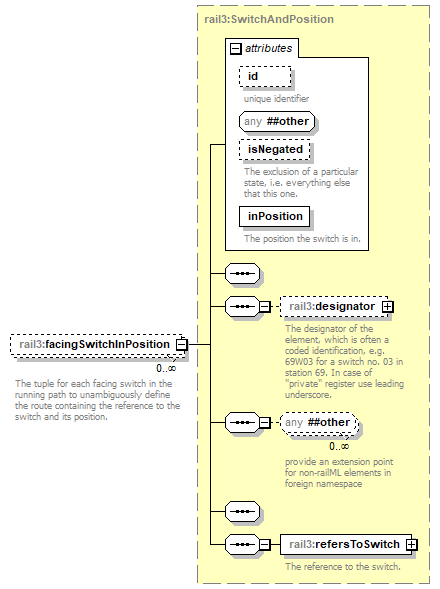 | ||||||||||||||||||||||||||||||
| namespace | https://www.railml.org/schemas/3.1 | ||||||||||||||||||||||||||||||
| type | rail3:SwitchAndPosition | ||||||||||||||||||||||||||||||
| properties |
| ||||||||||||||||||||||||||||||
| children | rail3:designator rail3:refersToSwitch | ||||||||||||||||||||||||||||||
| attributes |
| ||||||||||||||||||||||||||||||
| annotation |
| ||||||||||||||||||||||||||||||
| source | <xs:element name="facingSwitchInPosition" type="rail3:SwitchAndPosition" minOccurs="0" maxOccurs="unbounded"> <xs:annotation> <xs:documentation>The tuple for each facing switch in the running path to unambiguously define the route containing the reference to the switch and its position.</xs:documentation> </xs:annotation> </xs:element> |
element Route/hasTvdSection
| diagram | 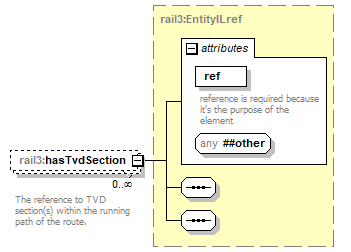 | ||||||||||||||
| namespace | https://www.railml.org/schemas/3.1 | ||||||||||||||
| type | rail3:EntityILref | ||||||||||||||
| properties |
| ||||||||||||||
| attributes |
| ||||||||||||||
| annotation |
| ||||||||||||||
| source | <xs:element name="hasTvdSection" type="rail3:EntityILref" minOccurs="0" maxOccurs="unbounded"> <xs:annotation> <xs:documentation>The reference to TVD section(s) within the running path of the route.</xs:documentation> </xs:annotation> </xs:element> |
element Route/routeEntry
| diagram | 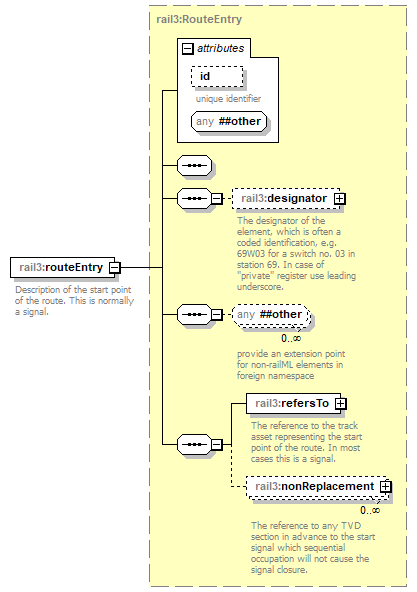 | ||||||||||||||
| namespace | https://www.railml.org/schemas/3.1 | ||||||||||||||
| type | rail3:RouteEntry | ||||||||||||||
| properties |
| ||||||||||||||
| children | rail3:designator rail3:refersTo rail3:nonReplacement | ||||||||||||||
| attributes |
| ||||||||||||||
| annotation |
| ||||||||||||||
| source | <xs:element name="routeEntry" type="rail3:RouteEntry" minOccurs="1" maxOccurs="1"> <xs:annotation> <xs:documentation>Description of the start point of the route. This is normally a signal.</xs:documentation> </xs:annotation> </xs:element> |
element Route/hasReleaseGroup
| diagram | 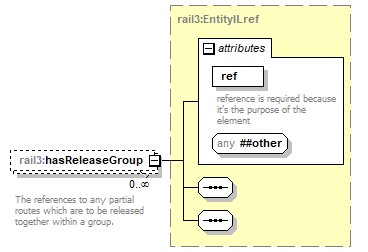 | ||||||||||||||
| namespace | https://www.railml.org/schemas/3.1 | ||||||||||||||
| type | rail3:EntityILref | ||||||||||||||
| properties |
| ||||||||||||||
| attributes |
| ||||||||||||||
| annotation |
| ||||||||||||||
| source | <xs:element name="hasReleaseGroup" type="rail3:EntityILref" minOccurs="0" maxOccurs="unbounded"> <xs:annotation> <xs:documentation>The references to any partial routes which are to be released together within a group.</xs:documentation> </xs:annotation> </xs:element> |
element Route/switchPositionInDepartureTrack
| diagram | 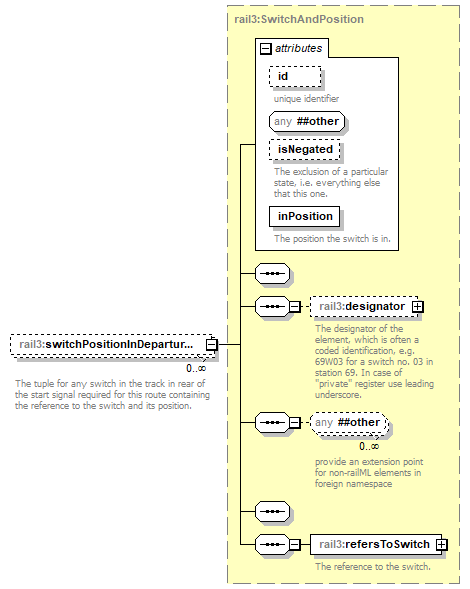 | ||||||||||||||||||||||||||||||
| namespace | https://www.railml.org/schemas/3.1 | ||||||||||||||||||||||||||||||
| type | rail3:SwitchAndPosition | ||||||||||||||||||||||||||||||
| properties |
| ||||||||||||||||||||||||||||||
| children | rail3:designator rail3:refersToSwitch | ||||||||||||||||||||||||||||||
| attributes |
| ||||||||||||||||||||||||||||||
| annotation |
| ||||||||||||||||||||||||||||||
| source | <xs:element name="switchPositionInDepartureTrack" type="rail3:SwitchAndPosition" minOccurs="0" maxOccurs="unbounded"> <xs:annotation> <xs:documentation>The tuple for any switch in the track in rear of the start signal required for this route containing the reference to the switch and its position.</xs:documentation> </xs:annotation> </xs:element> |
element Route/routeExit
| diagram | 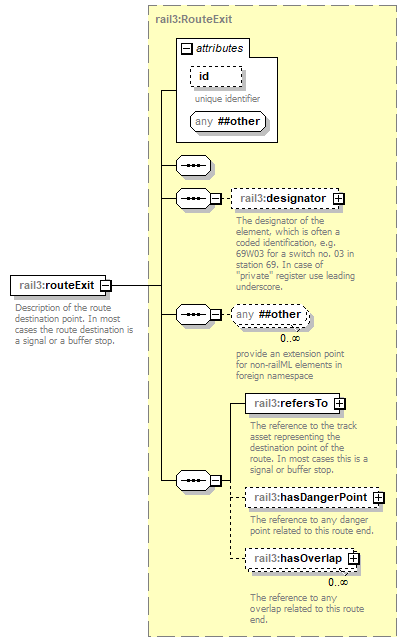 | ||||||||||||||
| namespace | https://www.railml.org/schemas/3.1 | ||||||||||||||
| type | rail3:RouteExit | ||||||||||||||
| properties |
| ||||||||||||||
| children | rail3:designator rail3:refersTo rail3:hasDangerPoint rail3:hasOverlap | ||||||||||||||
| attributes |
| ||||||||||||||
| annotation |
| ||||||||||||||
| source | <xs:element name="routeExit" type="rail3:RouteExit" minOccurs="1" maxOccurs="1"> <xs:annotation> <xs:documentation>Description of the route destination point. In most cases the route destination is a signal or a buffer stop. </xs:documentation> </xs:annotation> </xs:element> |
element Route/additionalRelation
| diagram | 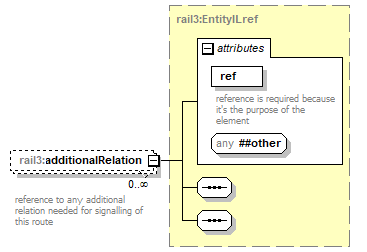 | ||||||||||||||
| namespace | https://www.railml.org/schemas/3.1 | ||||||||||||||
| type | rail3:EntityILref | ||||||||||||||
| properties |
| ||||||||||||||
| attributes |
| ||||||||||||||
| annotation |
| ||||||||||||||
| source | <xs:element name="additionalRelation" type="rail3:EntityILref" minOccurs="0" maxOccurs="unbounded"> <xs:annotation> <xs:documentation>reference to any additional relation needed for signalling of this route</xs:documentation> </xs:annotation> </xs:element> |
complexType RouteActivationSection
| diagram | 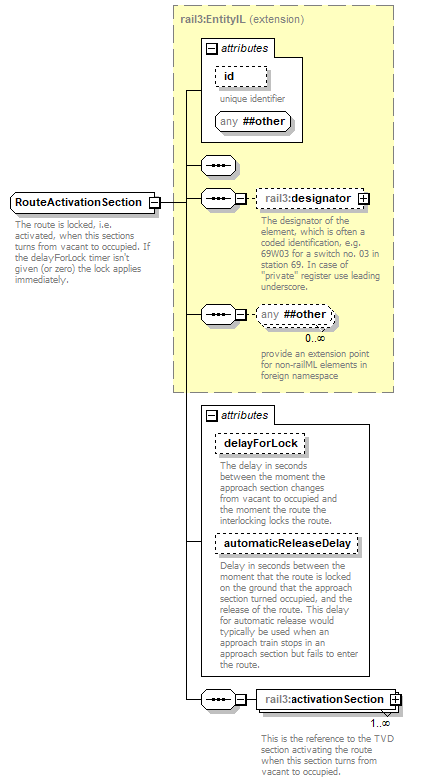 | ||||||||||||||||||||||||||||||
| namespace | https://www.railml.org/schemas/3.1 | ||||||||||||||||||||||||||||||
| type | extension of rail3:EntityIL | ||||||||||||||||||||||||||||||
| properties |
| ||||||||||||||||||||||||||||||
| children | rail3:designator rail3:activationSection | ||||||||||||||||||||||||||||||
| used by |
| ||||||||||||||||||||||||||||||
| attributes |
| ||||||||||||||||||||||||||||||
| annotation |
| ||||||||||||||||||||||||||||||
| source | <xs:complexType name="RouteActivationSection"> <xs:annotation> <xs:documentation>The route is locked, i.e. activated, when this sections turns from vacant to occupied. If the delayForLock timer isn't given (or zero) the lock applies immediately.</xs:documentation> </xs:annotation> <xs:complexContent> <xs:extension base="rail3:EntityIL"> <xs:sequence> <xs:element name="activationSection" type="rail3:EntityILref" minOccurs="1" maxOccurs="unbounded"> <xs:annotation> <xs:documentation>This is the reference to the TVD section activating the route when this section turns from vacant to occupied.</xs:documentation> </xs:annotation> </xs:element> </xs:sequence> <xs:attribute name="delayForLock" type="xs:duration" use="optional"> <xs:annotation> <xs:documentation>The delay in seconds between the moment the approach section changes from vacant to occupied and the moment the route the interlocking locks the route.</xs:documentation> </xs:annotation> </xs:attribute> <xs:attribute name="automaticReleaseDelay" type="xs:duration" use="optional"> <xs:annotation> <xs:documentation>Delay in seconds between the moment that the route is locked on the ground that the approach section turned occupied, and the release of the route. This delay for automatic release would typically be used when an approach train stops in an approach section but fails to enter the route.</xs:documentation> </xs:annotation> </xs:attribute> </xs:extension> </xs:complexContent> </xs:complexType> |
attribute RouteActivationSection/@delayForLock
| type | xs:duration | ||
| properties |
| ||
| annotation |
| ||
| source | <xs:attribute name="delayForLock" type="xs:duration" use="optional"> <xs:annotation> <xs:documentation>The delay in seconds between the moment the approach section changes from vacant to occupied and the moment the route the interlocking locks the route.</xs:documentation> </xs:annotation> </xs:attribute> |
attribute RouteActivationSection/@automaticReleaseDelay
| type | xs:duration | ||
| properties |
| ||
| annotation |
| ||
| source | <xs:attribute name="automaticReleaseDelay" type="xs:duration" use="optional"> <xs:annotation> <xs:documentation>Delay in seconds between the moment that the route is locked on the ground that the approach section turned occupied, and the release of the route. This delay for automatic release would typically be used when an approach train stops in an approach section but fails to enter the route.</xs:documentation> </xs:annotation> </xs:attribute> |
element RouteActivationSection/activationSection
| diagram | 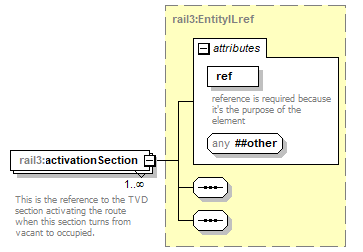 | ||||||||||||||
| namespace | https://www.railml.org/schemas/3.1 | ||||||||||||||
| type | rail3:EntityILref | ||||||||||||||
| properties |
| ||||||||||||||
| attributes |
| ||||||||||||||
| annotation |
| ||||||||||||||
| source | <xs:element name="activationSection" type="rail3:EntityILref" minOccurs="1" maxOccurs="unbounded"> <xs:annotation> <xs:documentation>This is the reference to the TVD section activating the route when this section turns from vacant to occupied.</xs:documentation> </xs:annotation> </xs:element> |
complexType RouteEntry
| diagram | 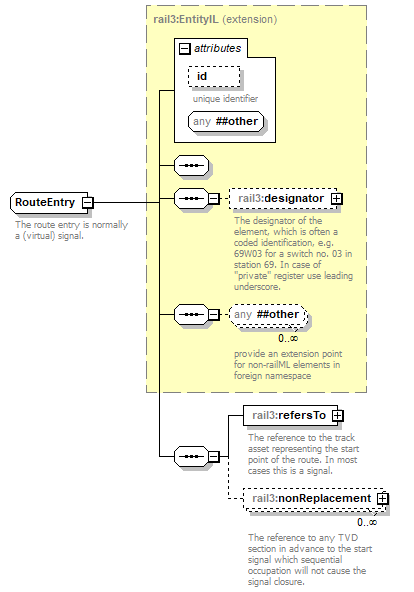 | ||||||||||||||
| namespace | https://www.railml.org/schemas/3.1 | ||||||||||||||
| type | extension of rail3:EntityIL | ||||||||||||||
| properties |
| ||||||||||||||
| children | rail3:designator rail3:refersTo rail3:nonReplacement | ||||||||||||||
| used by |
| ||||||||||||||
| attributes |
| ||||||||||||||
| annotation |
| ||||||||||||||
| source | <xs:complexType name="RouteEntry"> <xs:annotation> <xs:documentation>The route entry is normally a (virtual) signal.</xs:documentation> </xs:annotation> <xs:complexContent> <xs:extension base="rail3:EntityIL"> <xs:sequence> <xs:element name="refersTo" type="rail3:EntityILref" minOccurs="1" maxOccurs="1"> <xs:annotation> <xs:documentation>The reference to the track asset representing the start point of the route. In most cases this is a signal.</xs:documentation> </xs:annotation> </xs:element> <xs:element name="nonReplacement" type="rail3:EntityILref" minOccurs="0" maxOccurs="unbounded"> <xs:annotation> <xs:documentation>The reference to any TVD section in advance to the start signal which sequential occupation will not cause the signal closure.</xs:documentation> </xs:annotation> </xs:element> </xs:sequence> </xs:extension> </xs:complexContent> </xs:complexType> |
element RouteEntry/refersTo
| diagram | 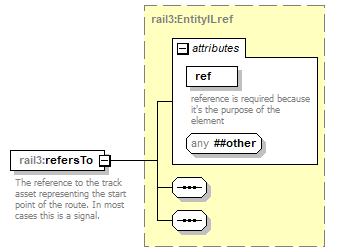 | ||||||||||||||
| namespace | https://www.railml.org/schemas/3.1 | ||||||||||||||
| type | rail3:EntityILref | ||||||||||||||
| properties |
| ||||||||||||||
| attributes |
| ||||||||||||||
| annotation |
| ||||||||||||||
| source | <xs:element name="refersTo" type="rail3:EntityILref" minOccurs="1" maxOccurs="1"> <xs:annotation> <xs:documentation>The reference to the track asset representing the start point of the route. In most cases this is a signal.</xs:documentation> </xs:annotation> </xs:element> |
element RouteEntry/nonReplacement
| diagram | 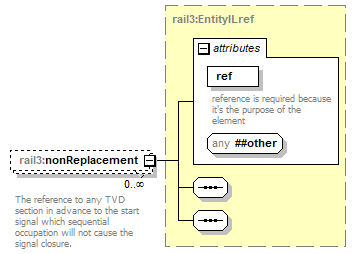 | ||||||||||||||
| namespace | https://www.railml.org/schemas/3.1 | ||||||||||||||
| type | rail3:EntityILref | ||||||||||||||
| properties |
| ||||||||||||||
| attributes |
| ||||||||||||||
| annotation |
| ||||||||||||||
| source | <xs:element name="nonReplacement" type="rail3:EntityILref" minOccurs="0" maxOccurs="unbounded"> <xs:annotation> <xs:documentation>The reference to any TVD section in advance to the start signal which sequential occupation will not cause the signal closure.</xs:documentation> </xs:annotation> </xs:element> |
complexType RouteExit
| diagram | 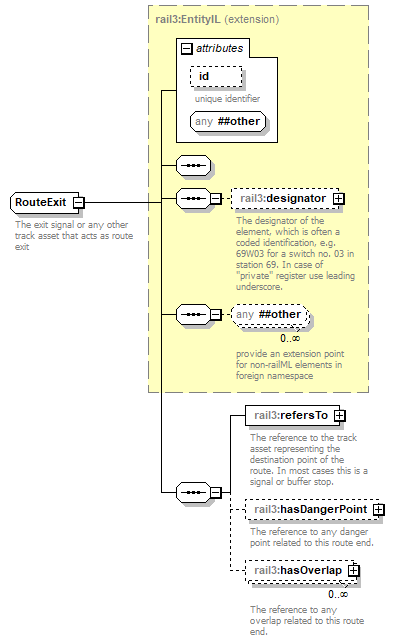 | ||||||||||||||
| namespace | https://www.railml.org/schemas/3.1 | ||||||||||||||
| type | extension of rail3:EntityIL | ||||||||||||||
| properties |
| ||||||||||||||
| children | rail3:designator rail3:refersTo rail3:hasDangerPoint rail3:hasOverlap | ||||||||||||||
| used by |
| ||||||||||||||
| attributes |
| ||||||||||||||
| annotation |
| ||||||||||||||
| source | <xs:complexType name="RouteExit"> <xs:annotation> <xs:documentation>The exit signal or any other track asset that acts as route exit</xs:documentation> </xs:annotation> <xs:complexContent> <xs:extension base="rail3:EntityIL"> <xs:sequence> <xs:element name="refersTo" type="rail3:EntityILref" minOccurs="1" maxOccurs="1"> <xs:annotation> <xs:documentation>The reference to the track asset representing the destination point of the route. In most cases this is a signal or buffer stop.</xs:documentation> </xs:annotation> </xs:element> <xs:element name="hasDangerPoint" type="rail3:EntityILref" minOccurs="0" maxOccurs="1"> <xs:annotation> <xs:documentation>The reference to any danger point related to this route end.</xs:documentation> </xs:annotation> </xs:element> <xs:element name="hasOverlap" type="rail3:EntityILref" minOccurs="0" maxOccurs="unbounded"> <xs:annotation> <xs:documentation>The reference to any overlap related to this route end.</xs:documentation> </xs:annotation> </xs:element> </xs:sequence> </xs:extension> </xs:complexContent> </xs:complexType> |
element RouteExit/refersTo
| diagram | 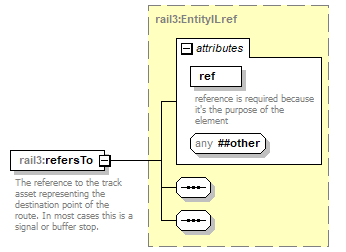 | ||||||||||||||
| namespace | https://www.railml.org/schemas/3.1 | ||||||||||||||
| type | rail3:EntityILref | ||||||||||||||
| properties |
| ||||||||||||||
| attributes |
| ||||||||||||||
| annotation |
| ||||||||||||||
| source | <xs:element name="refersTo" type="rail3:EntityILref" minOccurs="1" maxOccurs="1"> <xs:annotation> <xs:documentation>The reference to the track asset representing the destination point of the route. In most cases this is a signal or buffer stop.</xs:documentation> </xs:annotation> </xs:element> |
element RouteExit/hasDangerPoint
| diagram | 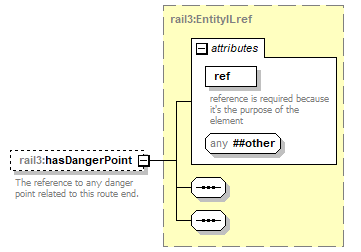 | ||||||||||||||
| namespace | https://www.railml.org/schemas/3.1 | ||||||||||||||
| type | rail3:EntityILref | ||||||||||||||
| properties |
| ||||||||||||||
| attributes |
| ||||||||||||||
| annotation |
| ||||||||||||||
| source | <xs:element name="hasDangerPoint" type="rail3:EntityILref" minOccurs="0" maxOccurs="1"> <xs:annotation> <xs:documentation>The reference to any danger point related to this route end.</xs:documentation> </xs:annotation> </xs:element> |
element RouteExit/hasOverlap
| diagram | 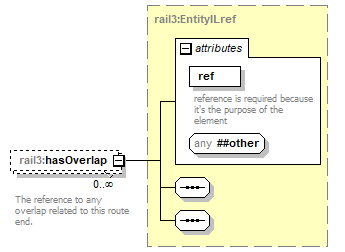 | ||||||||||||||
| namespace | https://www.railml.org/schemas/3.1 | ||||||||||||||
| type | rail3:EntityILref | ||||||||||||||
| properties |
| ||||||||||||||
| attributes |
| ||||||||||||||
| annotation |
| ||||||||||||||
| source | <xs:element name="hasOverlap" type="rail3:EntityILref" minOccurs="0" maxOccurs="unbounded"> <xs:annotation> <xs:documentation>The reference to any overlap related to this route end.</xs:documentation> </xs:annotation> </xs:element> |
complexType RouteRelation
| diagram | 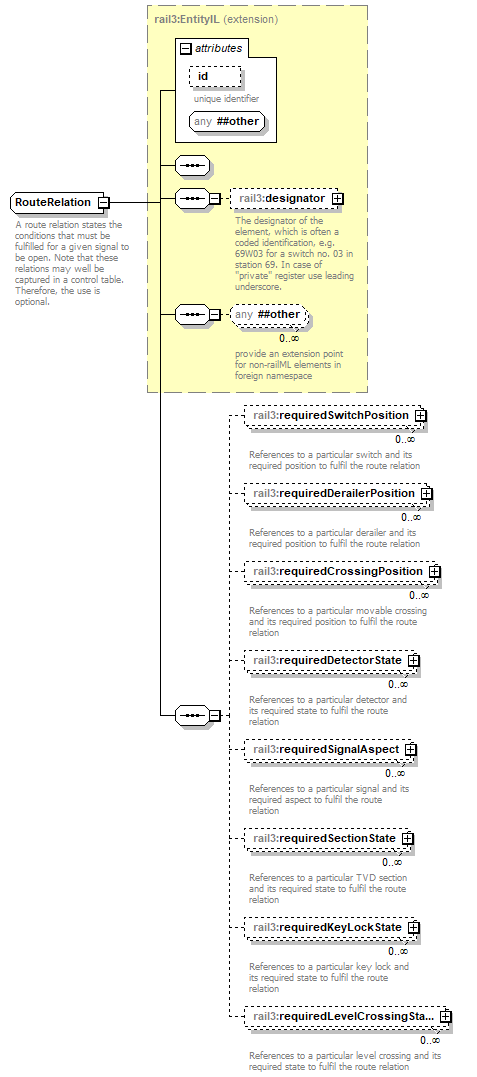 | ||||||||||||||
| namespace | https://www.railml.org/schemas/3.1 | ||||||||||||||
| type | extension of rail3:EntityIL | ||||||||||||||
| properties |
| ||||||||||||||
| children | rail3:designator rail3:requiredSwitchPosition rail3:requiredDerailerPosition rail3:requiredCrossingPosition rail3:requiredDetectorState rail3:requiredSignalAspect rail3:requiredSectionState rail3:requiredKeyLockState rail3:requiredLevelCrossingState | ||||||||||||||
| used by |
| ||||||||||||||
| attributes |
| ||||||||||||||
| annotation |
| ||||||||||||||
| source | <xs:complexType name="RouteRelation"> <xs:annotation> <xs:documentation>A route relation states the conditions that must be fulfilled for a given signal to be open. Note that these relations may well be captured in a control table. Therefore, the use is optional.</xs:documentation> </xs:annotation> <xs:complexContent> <xs:extension base="rail3:EntityIL"> <xs:sequence> <xs:element name="requiredSwitchPosition" type="rail3:SwitchAndGivenPosition" minOccurs="0" maxOccurs="unbounded"> <xs:annotation> <xs:documentation>References to a particular switch and its required position to fulfil the route relation</xs:documentation> </xs:annotation> </xs:element> <xs:element name="requiredDerailerPosition" type="rail3:DerailerAndGivenPosition" minOccurs="0" maxOccurs="unbounded"> <xs:annotation> <xs:documentation>References to a particular derailer and its required position to fulfil the route relation</xs:documentation> </xs:annotation> </xs:element> <xs:element name="requiredCrossingPosition" type="rail3:CrossingAndGivenPosition" minOccurs="0" maxOccurs="unbounded"> <xs:annotation> <xs:documentation>References to a particular movable crossing and its required position to fulfil the route relation</xs:documentation> </xs:annotation> </xs:element> <xs:element name="requiredDetectorState" type="rail3:DetectorAndGivenState" minOccurs="0" maxOccurs="unbounded"> <xs:annotation> <xs:documentation>References to a particular detector and its required state to fulfil the route relation</xs:documentation> </xs:annotation> </xs:element> <xs:element name="requiredSignalAspect" type="rail3:SignalAndGivenAspect" minOccurs="0" maxOccurs="unbounded"> <xs:annotation> <xs:documentation>References to a particular signal and its required aspect to fulfil the route relation</xs:documentation> </xs:annotation> </xs:element> <xs:element name="requiredSectionState" type="rail3:SectionAndGivenVacancy" minOccurs="0" maxOccurs="unbounded"> <xs:annotation> <xs:documentation>References to a particular TVD section and its required state to fulfil the route relation</xs:documentation> </xs:annotation> </xs:element> <xs:element name="requiredKeyLockState" type="rail3:LockAndGivenState" minOccurs="0" maxOccurs="unbounded"> <xs:annotation> <xs:documentation>References to a particular key lock and its required state to fulfil the route relation</xs:documentation> </xs:annotation> </xs:element> <xs:element name="requiredLevelCrossingState" type="rail3:LevelCrossingAndGivenState" minOccurs="0" maxOccurs="unbounded"> <xs:annotation> <xs:documentation>References to a particular level crossing and its required state to fulfil the route relation</xs:documentation> </xs:annotation> </xs:element> </xs:sequence> </xs:extension> </xs:complexContent> </xs:complexType> |
element RouteRelation/requiredSwitchPosition
| diagram | 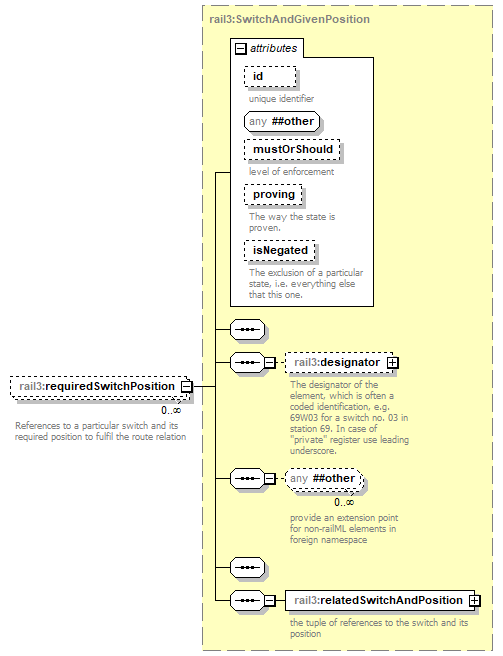 | ||||||||||||||||||||||||||||||||||||||
| namespace | https://www.railml.org/schemas/3.1 | ||||||||||||||||||||||||||||||||||||||
| type | rail3:SwitchAndGivenPosition | ||||||||||||||||||||||||||||||||||||||
| properties |
| ||||||||||||||||||||||||||||||||||||||
| children | rail3:designator rail3:relatedSwitchAndPosition | ||||||||||||||||||||||||||||||||||||||
| attributes |
| ||||||||||||||||||||||||||||||||||||||
| annotation |
| ||||||||||||||||||||||||||||||||||||||
| source | <xs:element name="requiredSwitchPosition" type="rail3:SwitchAndGivenPosition" minOccurs="0" maxOccurs="unbounded"> <xs:annotation> <xs:documentation>References to a particular switch and its required position to fulfil the route relation</xs:documentation> </xs:annotation> </xs:element> |
element RouteRelation/requiredDerailerPosition
| diagram | 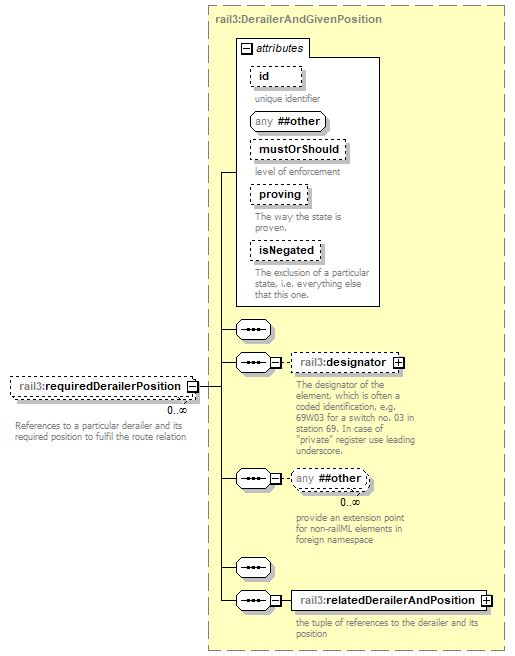 | ||||||||||||||||||||||||||||||||||||||
| namespace | https://www.railml.org/schemas/3.1 | ||||||||||||||||||||||||||||||||||||||
| type | rail3:DerailerAndGivenPosition | ||||||||||||||||||||||||||||||||||||||
| properties |
| ||||||||||||||||||||||||||||||||||||||
| children | rail3:designator rail3:relatedDerailerAndPosition | ||||||||||||||||||||||||||||||||||||||
| attributes |
| ||||||||||||||||||||||||||||||||||||||
| annotation |
| ||||||||||||||||||||||||||||||||||||||
| source | <xs:element name="requiredDerailerPosition" type="rail3:DerailerAndGivenPosition" minOccurs="0" maxOccurs="unbounded"> <xs:annotation> <xs:documentation>References to a particular derailer and its required position to fulfil the route relation</xs:documentation> </xs:annotation> </xs:element> |
element RouteRelation/requiredCrossingPosition
| diagram | 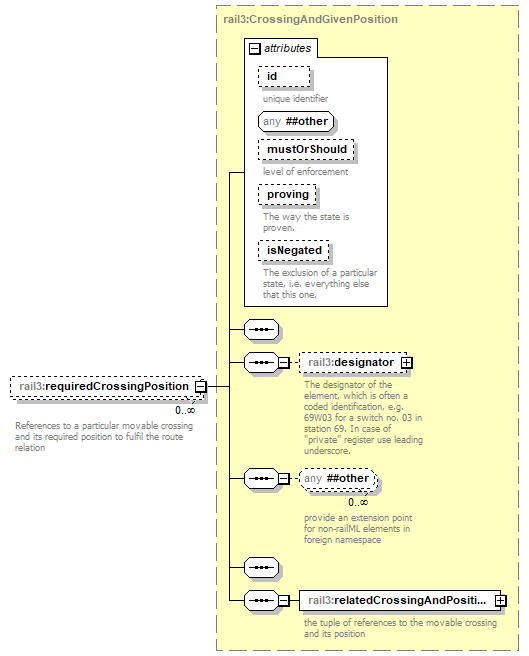 | ||||||||||||||||||||||||||||||||||||||
| namespace | https://www.railml.org/schemas/3.1 | ||||||||||||||||||||||||||||||||||||||
| type | rail3:CrossingAndGivenPosition | ||||||||||||||||||||||||||||||||||||||
| properties |
| ||||||||||||||||||||||||||||||||||||||
| children | rail3:designator rail3:relatedCrossingAndPosition | ||||||||||||||||||||||||||||||||||||||
| attributes |
| ||||||||||||||||||||||||||||||||||||||
| annotation |
| ||||||||||||||||||||||||||||||||||||||
| source | <xs:element name="requiredCrossingPosition" type="rail3:CrossingAndGivenPosition" minOccurs="0" maxOccurs="unbounded"> <xs:annotation> <xs:documentation>References to a particular movable crossing and its required position to fulfil the route relation</xs:documentation> </xs:annotation> </xs:element> |
element RouteRelation/requiredDetectorState
| diagram | 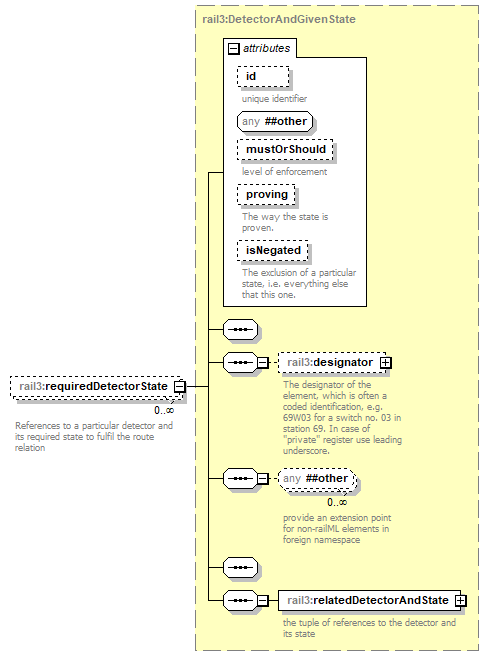 | ||||||||||||||||||||||||||||||||||||||
| namespace | https://www.railml.org/schemas/3.1 | ||||||||||||||||||||||||||||||||||||||
| type | rail3:DetectorAndGivenState | ||||||||||||||||||||||||||||||||||||||
| properties |
| ||||||||||||||||||||||||||||||||||||||
| children | rail3:designator rail3:relatedDetectorAndState | ||||||||||||||||||||||||||||||||||||||
| attributes |
| ||||||||||||||||||||||||||||||||||||||
| annotation |
| ||||||||||||||||||||||||||||||||||||||
| source | <xs:element name="requiredDetectorState" type="rail3:DetectorAndGivenState" minOccurs="0" maxOccurs="unbounded"> <xs:annotation> <xs:documentation>References to a particular detector and its required state to fulfil the route relation</xs:documentation> </xs:annotation> </xs:element> |
element RouteRelation/requiredSignalAspect
| diagram | 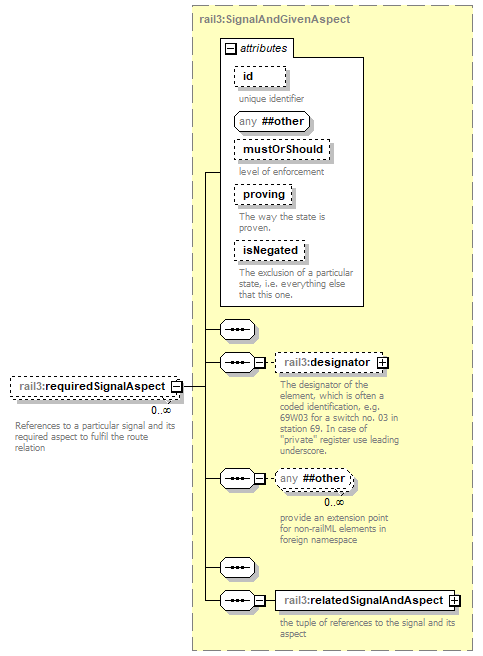 | ||||||||||||||||||||||||||||||||||||||
| namespace | https://www.railml.org/schemas/3.1 | ||||||||||||||||||||||||||||||||||||||
| type | rail3:SignalAndGivenAspect | ||||||||||||||||||||||||||||||||||||||
| properties |
| ||||||||||||||||||||||||||||||||||||||
| children | rail3:designator rail3:relatedSignalAndAspect | ||||||||||||||||||||||||||||||||||||||
| attributes |
| ||||||||||||||||||||||||||||||||||||||
| annotation |
| ||||||||||||||||||||||||||||||||||||||
| source | <xs:element name="requiredSignalAspect" type="rail3:SignalAndGivenAspect" minOccurs="0" maxOccurs="unbounded"> <xs:annotation> <xs:documentation>References to a particular signal and its required aspect to fulfil the route relation</xs:documentation> </xs:annotation> </xs:element> |
element RouteRelation/requiredSectionState
| diagram | 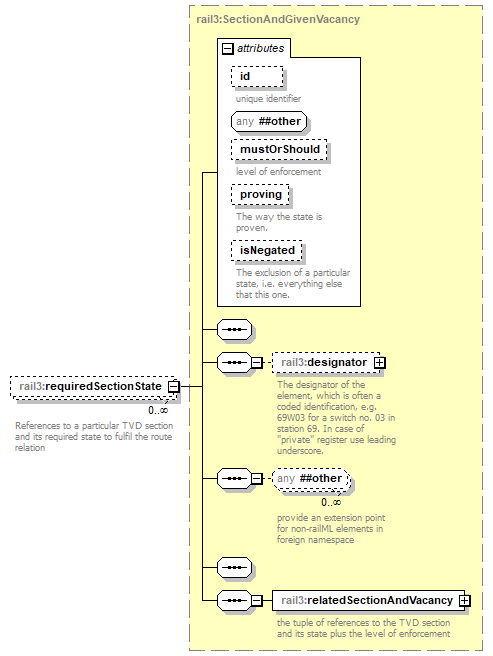 | ||||||||||||||||||||||||||||||||||||||
| namespace | https://www.railml.org/schemas/3.1 | ||||||||||||||||||||||||||||||||||||||
| type | rail3:SectionAndGivenVacancy | ||||||||||||||||||||||||||||||||||||||
| properties |
| ||||||||||||||||||||||||||||||||||||||
| children | rail3:designator rail3:relatedSectionAndVacancy | ||||||||||||||||||||||||||||||||||||||
| attributes |
| ||||||||||||||||||||||||||||||||||||||
| annotation |
| ||||||||||||||||||||||||||||||||||||||
| source | <xs:element name="requiredSectionState" type="rail3:SectionAndGivenVacancy" minOccurs="0" maxOccurs="unbounded"> <xs:annotation> <xs:documentation>References to a particular TVD section and its required state to fulfil the route relation</xs:documentation> </xs:annotation> </xs:element> |
element RouteRelation/requiredKeyLockState
| diagram | 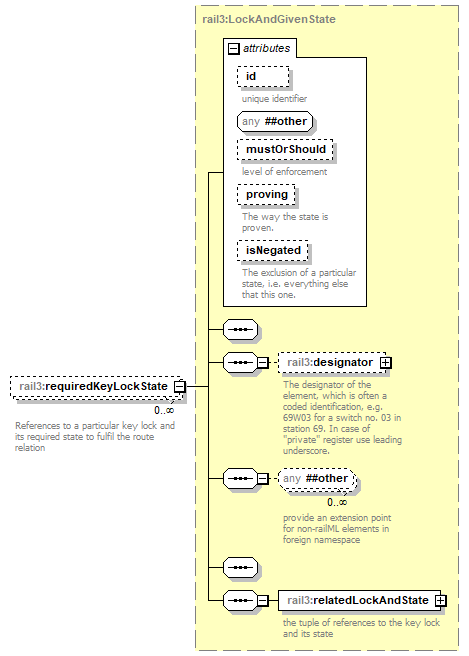 | ||||||||||||||||||||||||||||||||||||||
| namespace | https://www.railml.org/schemas/3.1 | ||||||||||||||||||||||||||||||||||||||
| type | rail3:LockAndGivenState | ||||||||||||||||||||||||||||||||||||||
| properties |
| ||||||||||||||||||||||||||||||||||||||
| children | rail3:designator rail3:relatedLockAndState | ||||||||||||||||||||||||||||||||||||||
| attributes |
| ||||||||||||||||||||||||||||||||||||||
| annotation |
| ||||||||||||||||||||||||||||||||||||||
| source | <xs:element name="requiredKeyLockState" type="rail3:LockAndGivenState" minOccurs="0" maxOccurs="unbounded"> <xs:annotation> <xs:documentation>References to a particular key lock and its required state to fulfil the route relation</xs:documentation> </xs:annotation> </xs:element> |
element RouteRelation/requiredLevelCrossingState
| diagram | 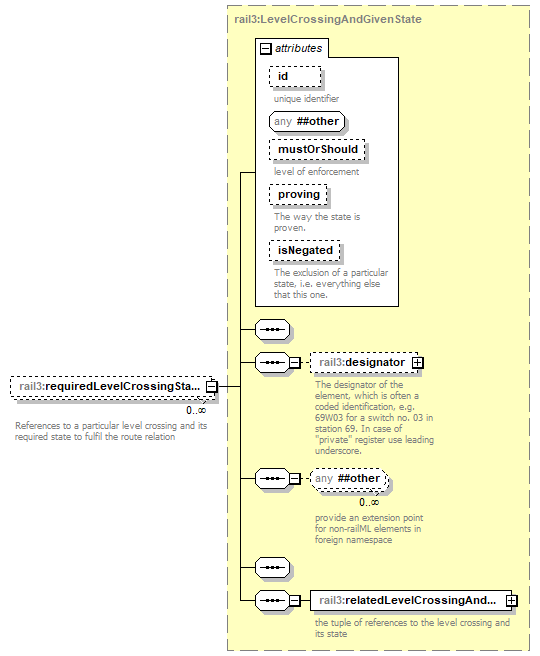 | ||||||||||||||||||||||||||||||||||||||
| namespace | https://www.railml.org/schemas/3.1 | ||||||||||||||||||||||||||||||||||||||
| type | rail3:LevelCrossingAndGivenState | ||||||||||||||||||||||||||||||||||||||
| properties |
| ||||||||||||||||||||||||||||||||||||||
| children | rail3:designator rail3:relatedLevelCrossingAndState | ||||||||||||||||||||||||||||||||||||||
| attributes |
| ||||||||||||||||||||||||||||||||||||||
| annotation |
| ||||||||||||||||||||||||||||||||||||||
| source | <xs:element name="requiredLevelCrossingState" type="rail3:LevelCrossingAndGivenState" minOccurs="0" maxOccurs="unbounded"> <xs:annotation> <xs:documentation>References to a particular level crossing and its required state to fulfil the route relation</xs:documentation> </xs:annotation> </xs:element> |
complexType RouteRelations
| diagram |  | ||
| namespace | https://www.railml.org/schemas/3.1 | ||
| children | rail3:routeRelation | ||
| used by |
| ||
| annotation |
| ||
| source | <xs:complexType name="RouteRelations"> <xs:annotation> <xs:documentation>container element for all RouteRelation elements</xs:documentation> </xs:annotation> <xs:sequence minOccurs="0" maxOccurs="1"> <xs:element name="routeRelation" type="rail3:RouteRelation" minOccurs="1" maxOccurs="unbounded"> <xs:annotation> <xs:documentation>states the conditions that must be fulfilled for a given signal to be open</xs:documentation> </xs:annotation> </xs:element> </xs:sequence> </xs:complexType> |
element RouteRelations/routeRelation
| diagram | 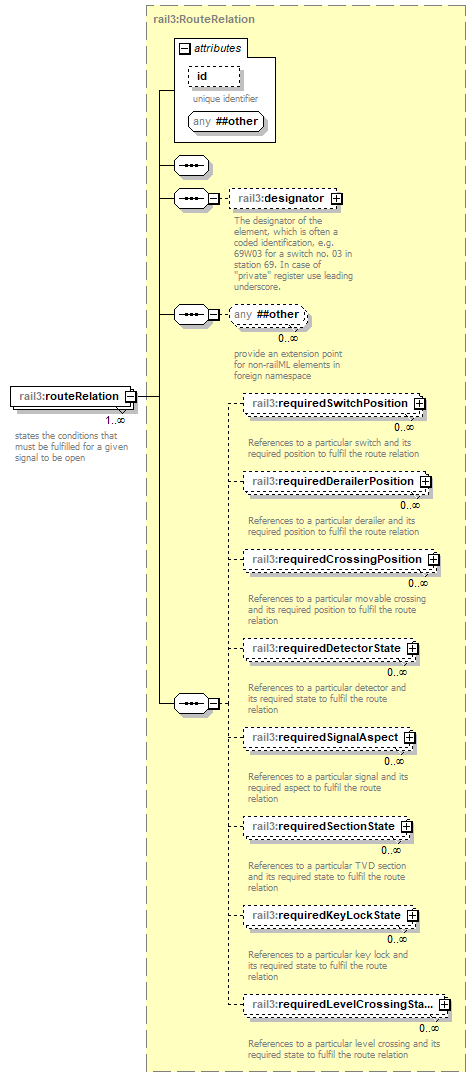 | ||||||||||||||
| namespace | https://www.railml.org/schemas/3.1 | ||||||||||||||
| type | rail3:RouteRelation | ||||||||||||||
| properties |
| ||||||||||||||
| children | rail3:designator rail3:requiredSwitchPosition rail3:requiredDerailerPosition rail3:requiredCrossingPosition rail3:requiredDetectorState rail3:requiredSignalAspect rail3:requiredSectionState rail3:requiredKeyLockState rail3:requiredLevelCrossingState | ||||||||||||||
| attributes |
| ||||||||||||||
| annotation |
| ||||||||||||||
| source | <xs:element name="routeRelation" type="rail3:RouteRelation" minOccurs="1" maxOccurs="unbounded"> <xs:annotation> <xs:documentation>states the conditions that must be fulfilled for a given signal to be open</xs:documentation> </xs:annotation> </xs:element> |
complexType RouteReleaseGroupAhead
| diagram | 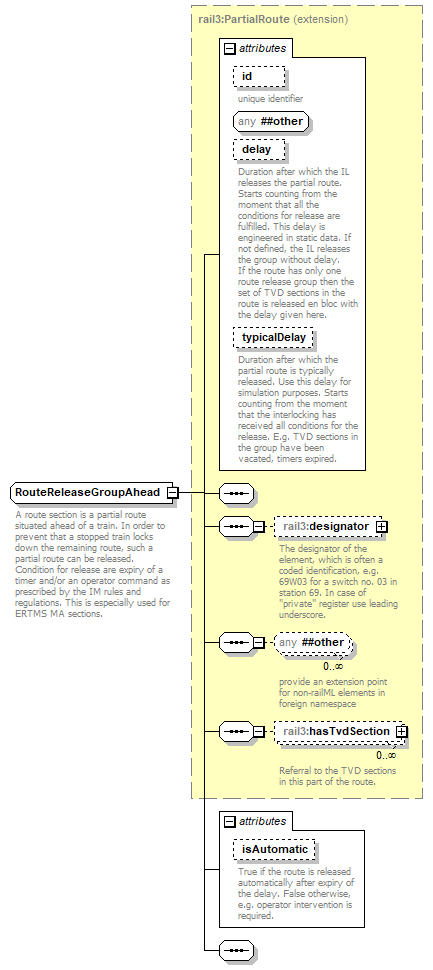 | ||||||||||||||||||||||||||||||||||||||
| namespace | https://www.railml.org/schemas/3.1 | ||||||||||||||||||||||||||||||||||||||
| type | extension of rail3:PartialRoute | ||||||||||||||||||||||||||||||||||||||
| properties |
| ||||||||||||||||||||||||||||||||||||||
| children | rail3:designator rail3:hasTvdSection | ||||||||||||||||||||||||||||||||||||||
| used by |
| ||||||||||||||||||||||||||||||||||||||
| attributes |
| ||||||||||||||||||||||||||||||||||||||
| annotation |
| ||||||||||||||||||||||||||||||||||||||
| source | <xs:complexType name="RouteReleaseGroupAhead"> <xs:annotation> <xs:documentation>A route section is a partial route situated ahead of a train. In order to prevent that a stopped train locks down the remaining route, such a partial route can be released. Condition for release are expiry of a timer and/or an operator command as prescribed by the IM rules and regulations. This is especially used for ERTMS MA sections.</xs:documentation> </xs:annotation> <xs:complexContent> <xs:extension base="rail3:PartialRoute"> <xs:sequence/> <xs:attribute name="isAutomatic" type="xs:boolean" use="optional"> <xs:annotation> <xs:documentation>True if the route is released automatically after expiry of the delay. False otherwise, e.g. operator intervention is required.</xs:documentation> </xs:annotation> </xs:attribute> </xs:extension> </xs:complexContent> </xs:complexType> |
attribute RouteReleaseGroupAhead/@isAutomatic
| type | xs:boolean | ||
| properties |
| ||
| annotation |
| ||
| source | <xs:attribute name="isAutomatic" type="xs:boolean" use="optional"> <xs:annotation> <xs:documentation>True if the route is released automatically after expiry of the delay. False otherwise, e.g. operator intervention is required.</xs:documentation> </xs:annotation> </xs:attribute> |
complexType RouteReleaseGroupRear
| diagram | 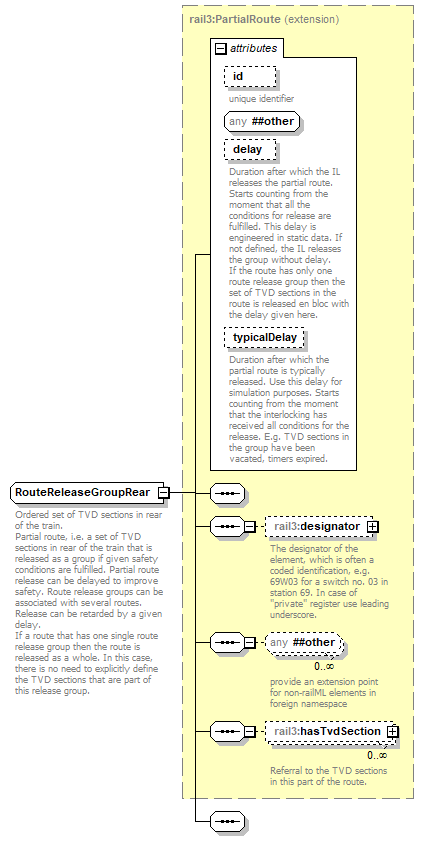 | ||||||||||||||||||||||||||||||
| namespace | https://www.railml.org/schemas/3.1 | ||||||||||||||||||||||||||||||
| type | extension of rail3:PartialRoute | ||||||||||||||||||||||||||||||
| properties |
| ||||||||||||||||||||||||||||||
| children | rail3:designator rail3:hasTvdSection | ||||||||||||||||||||||||||||||
| used by |
| ||||||||||||||||||||||||||||||
| attributes |
| ||||||||||||||||||||||||||||||
| annotation |
| ||||||||||||||||||||||||||||||
| source | <xs:complexType name="RouteReleaseGroupRear"> <xs:annotation> <xs:documentation>Ordered set of TVD sections in rear of the train. Partial route, i.e. a set of TVD sections in rear of the train that is released as a group if given safety conditions are fulfilled. Partial route release can be delayed to improve safety. Route release groups can be associated with several routes. Release can be retarded by a given delay. If a route that has one single route release group then the route is released as a whole. In this case, there is no need to explicitly define the TVD sections that are part of this release group.</xs:documentation> </xs:annotation> <xs:complexContent> <xs:extension base="rail3:PartialRoute"> <xs:sequence/> </xs:extension> </xs:complexContent> </xs:complexType> |
complexType RouteReleaseGroupsAhead
| diagram |  | ||
| namespace | https://www.railml.org/schemas/3.1 | ||
| children | rail3:routeReleaseGroupAhead | ||
| used by |
| ||
| source | <xs:complexType name="RouteReleaseGroupsAhead"> <xs:sequence> <xs:element name="routeReleaseGroupAhead" type="rail3:RouteReleaseGroupAhead" minOccurs="1" maxOccurs="unbounded"> <xs:annotation> <xs:documentation>One or more TVD sections as part of the route which can be released in a group ahead of the train in standstill.</xs:documentation> </xs:annotation> </xs:element> </xs:sequence> </xs:complexType> |
element RouteReleaseGroupsAhead/routeReleaseGroupAhead
| diagram | 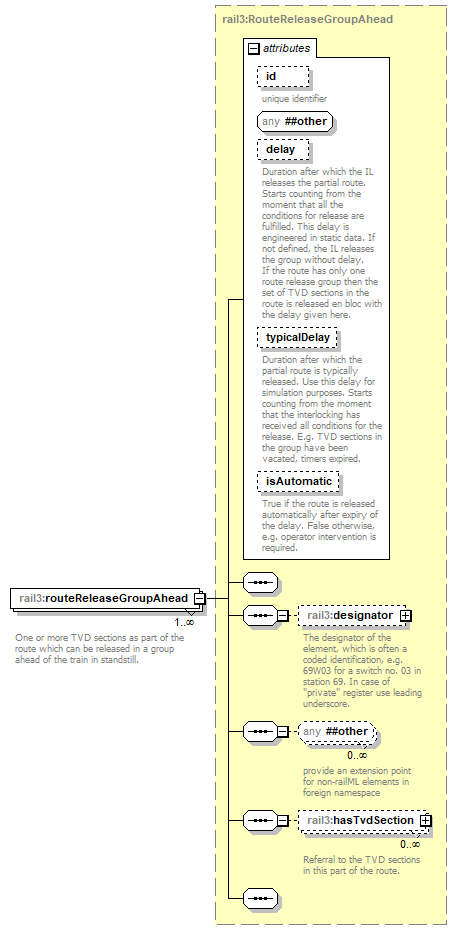 | ||||||||||||||||||||||||||||||||||||||
| namespace | https://www.railml.org/schemas/3.1 | ||||||||||||||||||||||||||||||||||||||
| type | rail3:RouteReleaseGroupAhead | ||||||||||||||||||||||||||||||||||||||
| properties |
| ||||||||||||||||||||||||||||||||||||||
| children | rail3:designator rail3:hasTvdSection | ||||||||||||||||||||||||||||||||||||||
| attributes |
| ||||||||||||||||||||||||||||||||||||||
| annotation |
| ||||||||||||||||||||||||||||||||||||||
| source | <xs:element name="routeReleaseGroupAhead" type="rail3:RouteReleaseGroupAhead" minOccurs="1" maxOccurs="unbounded"> <xs:annotation> <xs:documentation>One or more TVD sections as part of the route which can be released in a group ahead of the train in standstill.</xs:documentation> </xs:annotation> </xs:element> |
complexType RouteReleaseGroupsRear
| diagram |  | ||
| namespace | https://www.railml.org/schemas/3.1 | ||
| children | rail3:routeReleaseGroupRear | ||
| used by |
| ||
| source | <xs:complexType name="RouteReleaseGroupsRear"> <xs:sequence> <xs:element name="routeReleaseGroupRear" type="rail3:RouteReleaseGroupRear" minOccurs="1" maxOccurs="unbounded"> <xs:annotation> <xs:documentation>One or more TVD sections as part of the route which can be released in a group in rear of passing train.</xs:documentation> </xs:annotation> </xs:element> </xs:sequence> </xs:complexType> |
element RouteReleaseGroupsRear/routeReleaseGroupRear
| diagram | 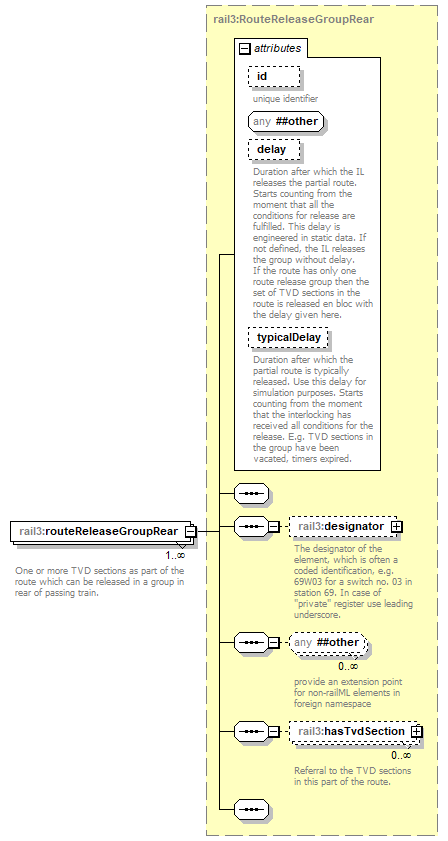 | ||||||||||||||||||||||||||||||
| namespace | https://www.railml.org/schemas/3.1 | ||||||||||||||||||||||||||||||
| type | rail3:RouteReleaseGroupRear | ||||||||||||||||||||||||||||||
| properties |
| ||||||||||||||||||||||||||||||
| children | rail3:designator rail3:hasTvdSection | ||||||||||||||||||||||||||||||
| attributes |
| ||||||||||||||||||||||||||||||
| annotation |
| ||||||||||||||||||||||||||||||
| source | <xs:element name="routeReleaseGroupRear" type="rail3:RouteReleaseGroupRear" minOccurs="1" maxOccurs="unbounded"> <xs:annotation> <xs:documentation>One or more TVD sections as part of the route which can be released in a group in rear of passing train.</xs:documentation> </xs:annotation> </xs:element> |
complexType Routes
| diagram |  | ||
| namespace | https://www.railml.org/schemas/3.1 | ||
| children | rail3:route | ||
| used by |
| ||
| annotation |
| ||
| source | <xs:complexType name="Routes"> <xs:annotation> <xs:documentation>container element for all Route elements</xs:documentation> </xs:annotation> <xs:sequence minOccurs="0" maxOccurs="1"> <xs:element name="route" type="rail3:Route" minOccurs="1" maxOccurs="unbounded"> <xs:annotation> <xs:documentation>path for train movements in railway network secured by interlocking system</xs:documentation> </xs:annotation> </xs:element> </xs:sequence> </xs:complexType> |
element Routes/route
| diagram |  | ||||||||||||||||||||||||||||||||||||||||||||||||||||||
| namespace | https://www.railml.org/schemas/3.1 | ||||||||||||||||||||||||||||||||||||||||||||||||||||||
| type | rail3:Route | ||||||||||||||||||||||||||||||||||||||||||||||||||||||
| properties |
| ||||||||||||||||||||||||||||||||||||||||||||||||||||||
| children | rail3:designator rail3:handlesRouteType rail3:routeActivationSection rail3:facingSwitchInPosition rail3:hasTvdSection rail3:routeEntry rail3:hasReleaseGroup rail3:switchPositionInDepartureTrack rail3:routeExit rail3:additionalRelation | ||||||||||||||||||||||||||||||||||||||||||||||||||||||
| attributes |
| ||||||||||||||||||||||||||||||||||||||||||||||||||||||
| annotation |
| ||||||||||||||||||||||||||||||||||||||||||||||||||||||
| source | <xs:element name="route" type="rail3:Route" minOccurs="1" maxOccurs="unbounded"> <xs:annotation> <xs:documentation>path for train movements in railway network secured by interlocking system</xs:documentation> </xs:annotation> </xs:element> |
complexType SectionAndGivenVacancy
| diagram | 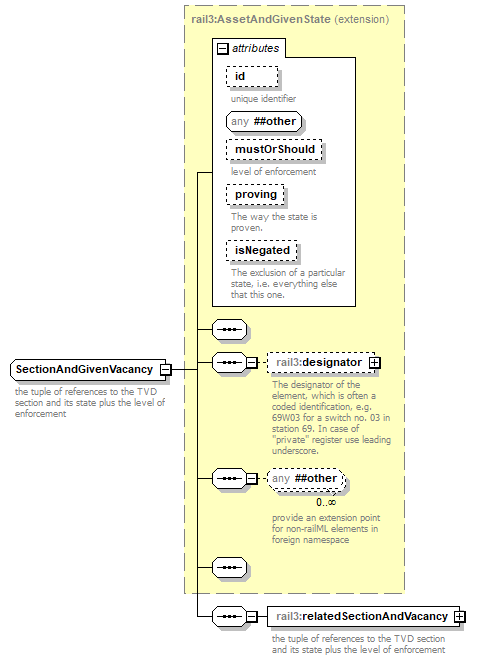 | ||||||||||||||||||||||||||||||||||||||
| namespace | https://www.railml.org/schemas/3.1 | ||||||||||||||||||||||||||||||||||||||
| type | extension of rail3:AssetAndGivenState | ||||||||||||||||||||||||||||||||||||||
| properties |
| ||||||||||||||||||||||||||||||||||||||
| children | rail3:designator rail3:relatedSectionAndVacancy | ||||||||||||||||||||||||||||||||||||||
| used by |
| ||||||||||||||||||||||||||||||||||||||
| attributes |
| ||||||||||||||||||||||||||||||||||||||
| annotation |
| ||||||||||||||||||||||||||||||||||||||
| source | <xs:complexType name="SectionAndGivenVacancy"> <xs:annotation> <xs:documentation>the tuple of references to the TVD section and its state plus the level of enforcement</xs:documentation> </xs:annotation> <xs:complexContent> <xs:extension base="rail3:AssetAndGivenState"> <xs:sequence> <xs:element name="relatedSectionAndVacancy" type="rail3:SectionAndVacancy" minOccurs="1" maxOccurs="1"> <xs:annotation> <xs:documentation>the tuple of references to the TVD section and its state plus the level of enforcement</xs:documentation> </xs:annotation> </xs:element> </xs:sequence> </xs:extension> </xs:complexContent> </xs:complexType> |
element SectionAndGivenVacancy/relatedSectionAndVacancy
| diagram | 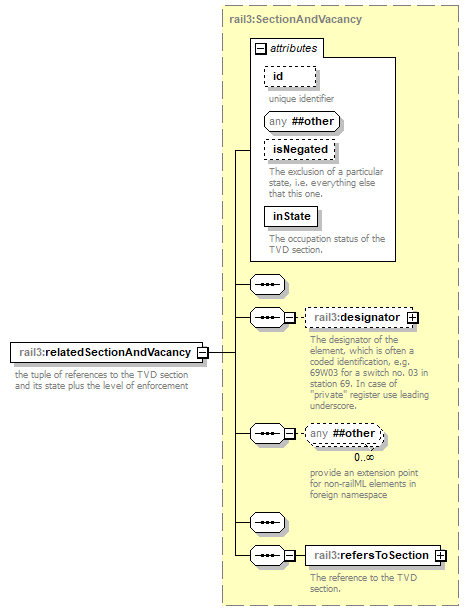 | ||||||||||||||||||||||||||||||
| namespace | https://www.railml.org/schemas/3.1 | ||||||||||||||||||||||||||||||
| type | rail3:SectionAndVacancy | ||||||||||||||||||||||||||||||
| properties |
| ||||||||||||||||||||||||||||||
| children | rail3:designator rail3:refersToSection | ||||||||||||||||||||||||||||||
| attributes |
| ||||||||||||||||||||||||||||||
| annotation |
| ||||||||||||||||||||||||||||||
| source | <xs:element name="relatedSectionAndVacancy" type="rail3:SectionAndVacancy" minOccurs="1" maxOccurs="1"> <xs:annotation> <xs:documentation>the tuple of references to the TVD section and its state plus the level of enforcement</xs:documentation> </xs:annotation> </xs:element> |
complexType SectionAndVacancy
| diagram | 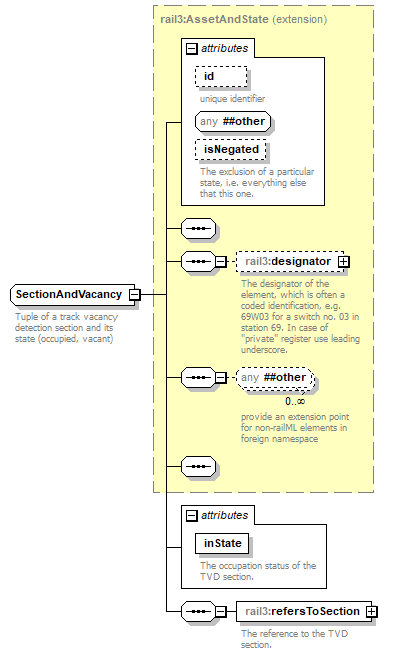 | ||||||||||||||||||||||||||||||
| namespace | https://www.railml.org/schemas/3.1 | ||||||||||||||||||||||||||||||
| type | extension of rail3:AssetAndState | ||||||||||||||||||||||||||||||
| properties |
| ||||||||||||||||||||||||||||||
| children | rail3:designator rail3:refersToSection | ||||||||||||||||||||||||||||||
| used by |
| ||||||||||||||||||||||||||||||
| attributes |
| ||||||||||||||||||||||||||||||
| annotation |
| ||||||||||||||||||||||||||||||
| source | <xs:complexType name="SectionAndVacancy"> <xs:annotation> <xs:documentation>Tuple of a track vacancy detection section and its state (occupied, vacant)</xs:documentation> </xs:annotation> <xs:complexContent> <xs:extension base="rail3:AssetAndState"> <xs:sequence> <xs:element name="refersToSection" type="rail3:EntityILref" minOccurs="1" maxOccurs="1"> <xs:annotation> <xs:documentation>The reference to the TVD section.</xs:documentation> </xs:annotation> </xs:element> </xs:sequence> <xs:attribute name="inState" type="rail3:tSectionVacancy" use="required"> <xs:annotation> <xs:documentation>The occupation status of the TVD section.</xs:documentation> </xs:annotation> </xs:attribute> </xs:extension> </xs:complexContent> </xs:complexType> |
attribute SectionAndVacancy/@inState
| type | rail3:tSectionVacancy | ||||||||||||
| properties |
| ||||||||||||
| facets |
| ||||||||||||
| annotation |
| ||||||||||||
| source | <xs:attribute name="inState" type="rail3:tSectionVacancy" use="required"> <xs:annotation> <xs:documentation>The occupation status of the TVD section.</xs:documentation> </xs:annotation> </xs:attribute> |
element SectionAndVacancy/refersToSection
| diagram | 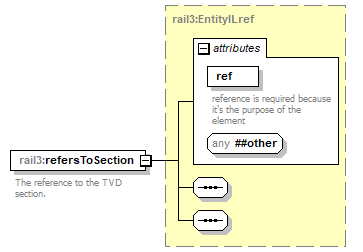 | ||||||||||||||
| namespace | https://www.railml.org/schemas/3.1 | ||||||||||||||
| type | rail3:EntityILref | ||||||||||||||
| properties |
| ||||||||||||||
| attributes |
| ||||||||||||||
| annotation |
| ||||||||||||||
| source | <xs:element name="refersToSection" type="rail3:EntityILref" minOccurs="1" maxOccurs="1"> <xs:annotation> <xs:documentation>The reference to the TVD section.</xs:documentation> </xs:annotation> </xs:element> |
complexType ShuntingZone
| diagram | 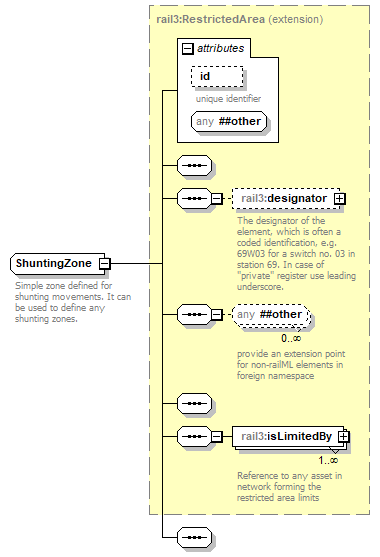 | ||||||||||||||
| namespace | https://www.railml.org/schemas/3.1 | ||||||||||||||
| type | extension of rail3:RestrictedArea | ||||||||||||||
| properties |
| ||||||||||||||
| children | rail3:designator rail3:isLimitedBy | ||||||||||||||
| used by |
| ||||||||||||||
| attributes |
| ||||||||||||||
| annotation |
| ||||||||||||||
| source | <xs:complexType name="ShuntingZone"> <xs:annotation> <xs:documentation>Simple zone defined for shunting movements. It can be used to define any shunting zones.</xs:documentation> </xs:annotation> <xs:complexContent> <xs:extension base="rail3:RestrictedArea"> <xs:sequence/> </xs:extension> </xs:complexContent> </xs:complexType> |
complexType ShuntingZones
| diagram |  | ||
| namespace | https://www.railml.org/schemas/3.1 | ||
| children | rail3:shuntingZone | ||
| used by |
| ||
| source | <xs:complexType name="ShuntingZones"> <xs:sequence> <xs:element name="shuntingZone" type="rail3:ShuntingZone" minOccurs="1" maxOccurs="unbounded"> <xs:annotation> <xs:documentation>Simple zone defined for shunting movements.</xs:documentation> </xs:annotation> </xs:element> </xs:sequence> </xs:complexType> |
element ShuntingZones/shuntingZone
| diagram | 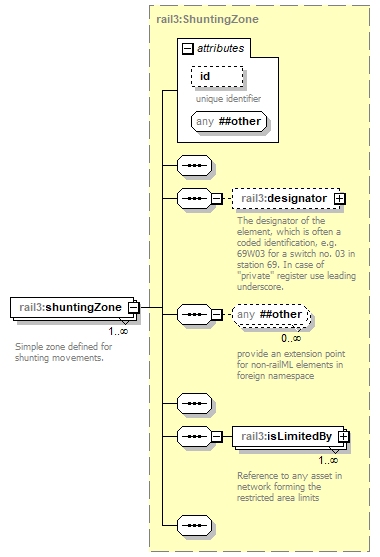 | ||||||||||||||
| namespace | https://www.railml.org/schemas/3.1 | ||||||||||||||
| type | rail3:ShuntingZone | ||||||||||||||
| properties |
| ||||||||||||||
| children | rail3:designator rail3:isLimitedBy | ||||||||||||||
| attributes |
| ||||||||||||||
| annotation |
| ||||||||||||||
| source | <xs:element name="shuntingZone" type="rail3:ShuntingZone" minOccurs="1" maxOccurs="unbounded"> <xs:annotation> <xs:documentation>Simple zone defined for shunting movements.</xs:documentation> </xs:annotation> </xs:element> |
complexType SignalAndAspect
| diagram | 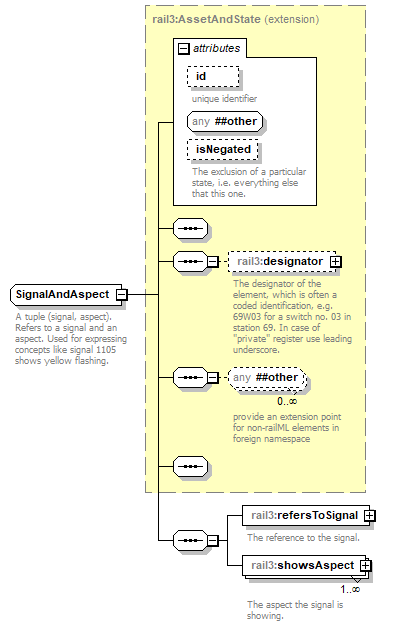 | ||||||||||||||||||||||
| namespace | https://www.railml.org/schemas/3.1 | ||||||||||||||||||||||
| type | extension of rail3:AssetAndState | ||||||||||||||||||||||
| properties |
| ||||||||||||||||||||||
| children | rail3:designator rail3:refersToSignal rail3:showsAspect | ||||||||||||||||||||||
| used by |
| ||||||||||||||||||||||
| attributes |
| ||||||||||||||||||||||
| annotation |
| ||||||||||||||||||||||
| source | <xs:complexType name="SignalAndAspect"> <xs:annotation> <xs:documentation>A tuple (signal, aspect). Refers to a signal and an aspect. Used for expressing concepts like signal 1105 shows yellow flashing.</xs:documentation> </xs:annotation> <xs:complexContent> <xs:extension base="rail3:AssetAndState"> <xs:sequence> <xs:element name="refersToSignal" type="rail3:EntityILref" minOccurs="1" maxOccurs="1"> <xs:annotation> <xs:documentation>The reference to the signal.</xs:documentation> </xs:annotation> </xs:element> <xs:element name="showsAspect" type="rail3:EntityILref" minOccurs="1" maxOccurs="unbounded"> <xs:annotation> <xs:documentation>The aspect the signal is showing.</xs:documentation> </xs:annotation> </xs:element> </xs:sequence> </xs:extension> </xs:complexContent> </xs:complexType> |
element SignalAndAspect/refersToSignal
| diagram | 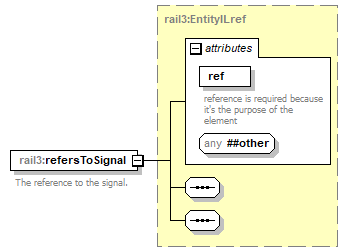 | ||||||||||||||
| namespace | https://www.railml.org/schemas/3.1 | ||||||||||||||
| type | rail3:EntityILref | ||||||||||||||
| properties |
| ||||||||||||||
| attributes |
| ||||||||||||||
| annotation |
| ||||||||||||||
| source | <xs:element name="refersToSignal" type="rail3:EntityILref" minOccurs="1" maxOccurs="1"> <xs:annotation> <xs:documentation>The reference to the signal.</xs:documentation> </xs:annotation> </xs:element> |
element SignalAndAspect/showsAspect
| diagram | 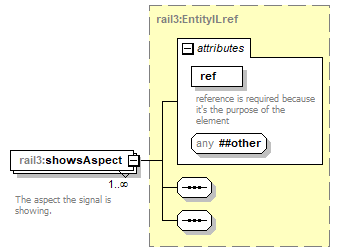 | ||||||||||||||
| namespace | https://www.railml.org/schemas/3.1 | ||||||||||||||
| type | rail3:EntityILref | ||||||||||||||
| properties |
| ||||||||||||||
| attributes |
| ||||||||||||||
| annotation |
| ||||||||||||||
| source | <xs:element name="showsAspect" type="rail3:EntityILref" minOccurs="1" maxOccurs="unbounded"> <xs:annotation> <xs:documentation>The aspect the signal is showing.</xs:documentation> </xs:annotation> </xs:element> |
complexType SignalAndGivenAspect
| diagram | 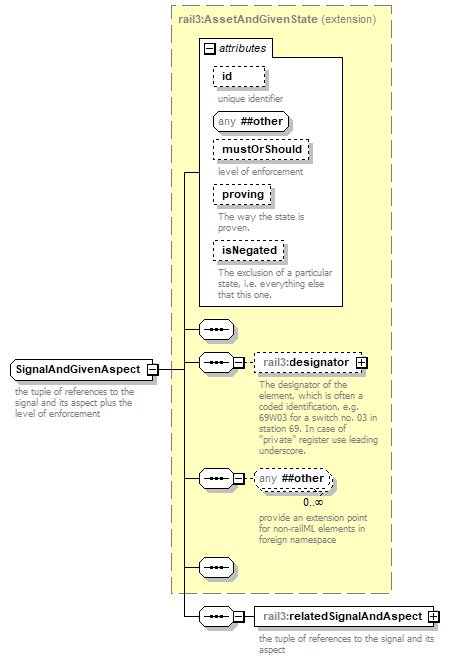 | ||||||||||||||||||||||||||||||||||||||
| namespace | https://www.railml.org/schemas/3.1 | ||||||||||||||||||||||||||||||||||||||
| type | extension of rail3:AssetAndGivenState | ||||||||||||||||||||||||||||||||||||||
| properties |
| ||||||||||||||||||||||||||||||||||||||
| children | rail3:designator rail3:relatedSignalAndAspect | ||||||||||||||||||||||||||||||||||||||
| used by |
| ||||||||||||||||||||||||||||||||||||||
| attributes |
| ||||||||||||||||||||||||||||||||||||||
| annotation |
| ||||||||||||||||||||||||||||||||||||||
| source | <xs:complexType name="SignalAndGivenAspect"> <xs:annotation> <xs:documentation>the tuple of references to the signal and its aspect plus the level of enforcement</xs:documentation> </xs:annotation> <xs:complexContent> <xs:extension base="rail3:AssetAndGivenState"> <xs:sequence> <xs:element name="relatedSignalAndAspect" type="rail3:SignalAndAspect" minOccurs="1" maxOccurs="1"> <xs:annotation> <xs:documentation>the tuple of references to the signal and its aspect</xs:documentation> </xs:annotation> </xs:element> </xs:sequence> </xs:extension> </xs:complexContent> </xs:complexType> |
element SignalAndGivenAspect/relatedSignalAndAspect
| diagram | 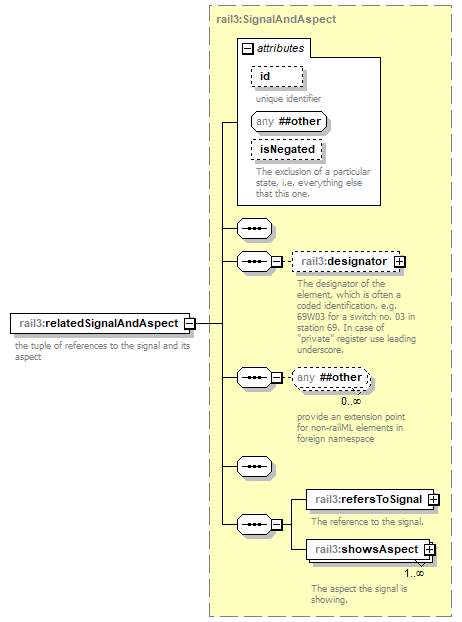 | ||||||||||||||||||||||
| namespace | https://www.railml.org/schemas/3.1 | ||||||||||||||||||||||
| type | rail3:SignalAndAspect | ||||||||||||||||||||||
| properties |
| ||||||||||||||||||||||
| children | rail3:designator rail3:refersToSignal rail3:showsAspect | ||||||||||||||||||||||
| attributes |
| ||||||||||||||||||||||
| annotation |
| ||||||||||||||||||||||
| source | <xs:element name="relatedSignalAndAspect" type="rail3:SignalAndAspect" minOccurs="1" maxOccurs="1"> <xs:annotation> <xs:documentation>the tuple of references to the signal and its aspect</xs:documentation> </xs:annotation> </xs:element> |
complexType SignalBox
| diagram | 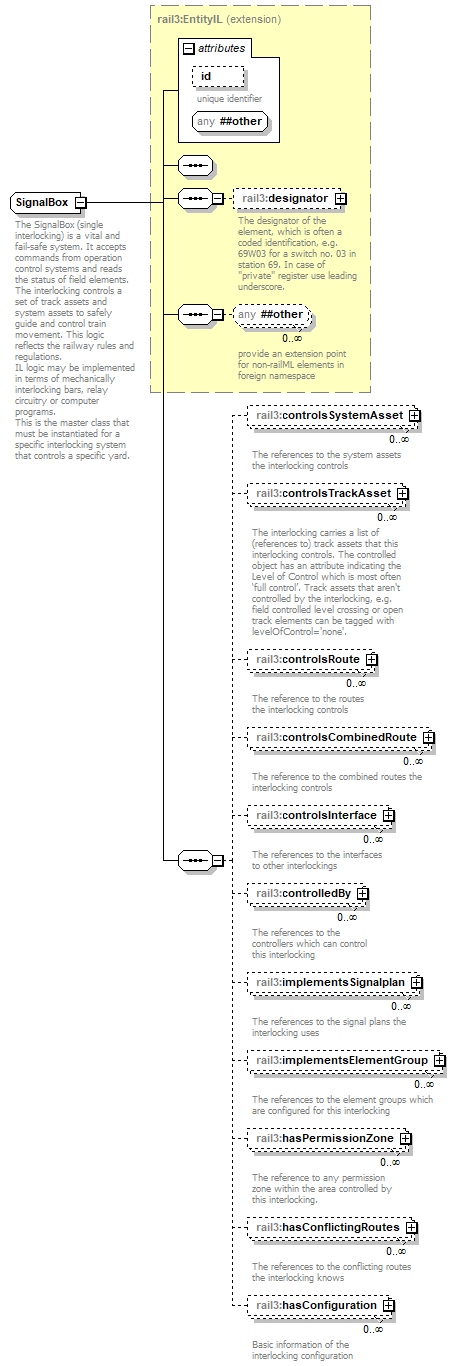 | ||||||||||||||
| namespace | https://www.railml.org/schemas/3.1 | ||||||||||||||
| type | extension of rail3:EntityIL | ||||||||||||||
| properties |
| ||||||||||||||
| children | rail3:designator rail3:controlsSystemAsset rail3:controlsTrackAsset rail3:controlsRoute rail3:controlsCombinedRoute rail3:controlsInterface rail3:controlledBy rail3:implementsSignalplan rail3:implementsElementGroup rail3:hasPermissionZone rail3:hasConflictingRoutes rail3:hasConfiguration | ||||||||||||||
| used by |
| ||||||||||||||
| attributes |
| ||||||||||||||
| annotation |
| ||||||||||||||
| source | <xs:complexType name="SignalBox"> <xs:annotation> <xs:documentation>The SignalBox (single interlocking) is a vital and fail-safe system. It accepts commands from operation control systems and reads the status of field elements. The interlocking controls a set of track assets and system assets to safely guide and control train movement. This logic reflects the railway rules and regulations. IL logic may be implemented in terms of mechanically interlocking bars, relay circuitry or computer programs. This is the master class that must be instantiated for a specific interlocking system that controls a specific yard.</xs:documentation> </xs:annotation> <xs:complexContent> <xs:extension base="rail3:EntityIL"> <xs:sequence> <xs:element name="controlsSystemAsset" type="rail3:SystemAssetConnectedToIL" minOccurs="0" maxOccurs="unbounded"> <xs:annotation> <xs:documentation>The references to the system assets the interlocking controls</xs:documentation> </xs:annotation> </xs:element> <xs:element name="controlsTrackAsset" type="rail3:TrackAssetConnectedToIL" minOccurs="0" maxOccurs="unbounded"> <xs:annotation> <xs:documentation>The interlocking carries a list of (references to) track assets that this interlocking controls. The controlled object has an attribute indicating the Level of Control which is most often ‘full control’. Track assets that aren't controlled by the interlocking, e.g. field controlled level crossing or open track elements can be tagged with levelOfControl='none'. </xs:documentation> </xs:annotation> </xs:element> <xs:element name="controlsRoute" type="rail3:EntityILref" minOccurs="0" maxOccurs="unbounded"> <xs:annotation> <xs:documentation>The reference to the routes the interlocking controls</xs:documentation> </xs:annotation> </xs:element> <xs:element name="controlsCombinedRoute" type="rail3:EntityILref" minOccurs="0" maxOccurs="unbounded"> <xs:annotation> <xs:documentation>The reference to the combined routes the interlocking controls</xs:documentation> </xs:annotation> </xs:element> <xs:element name="controlsInterface" type="rail3:InterlockingInterface" minOccurs="0" maxOccurs="unbounded"> <xs:annotation> <xs:documentation>The references to the interfaces to other interlockings</xs:documentation> </xs:annotation> </xs:element> <xs:element name="controlledBy" type="rail3:EntityILref" minOccurs="0" maxOccurs="unbounded"> <xs:annotation> <xs:documentation>The references to the controllers which can control this interlocking</xs:documentation> </xs:annotation> </xs:element> <xs:element name="implementsSignalplan" type="rail3:SignalPlan" minOccurs="0" maxOccurs="unbounded"> <xs:annotation> <xs:documentation>The references to the signal plans the interlocking uses</xs:documentation> </xs:annotation> </xs:element> <xs:element name="implementsElementGroup" type="rail3:ElementGroup" minOccurs="0" maxOccurs="unbounded"> <xs:annotation> <xs:documentation>The references to the element groups which are configured for this interlocking</xs:documentation> </xs:annotation> </xs:element> <xs:element name="hasPermissionZone" type="rail3:EntityILref" minOccurs="0" maxOccurs="unbounded"> <xs:annotation> <xs:documentation>The reference to any permission zone within the area controlled by this interlocking.</xs:documentation> </xs:annotation> </xs:element> <xs:element name="hasConflictingRoutes" type="rail3:EntityILref" minOccurs="0" maxOccurs="unbounded"> <xs:annotation> <xs:documentation>The references to the conflicting routes the interlocking knows</xs:documentation> </xs:annotation> </xs:element> <xs:element name="hasConfiguration" type="rail3:Configuration" minOccurs="0" maxOccurs="unbounded"> <xs:annotation> <xs:documentation>Basic information of the interlocking configuration</xs:documentation> </xs:annotation> </xs:element> </xs:sequence> </xs:extension> </xs:complexContent> </xs:complexType> |
element SignalBox/controlsSystemAsset
| diagram | 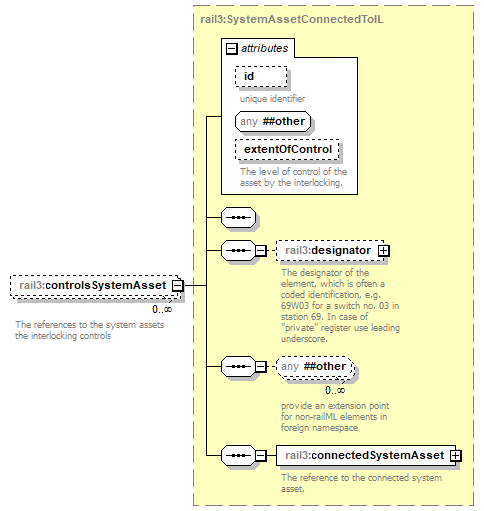 | ||||||||||||||||||||||
| namespace | https://www.railml.org/schemas/3.1 | ||||||||||||||||||||||
| type | rail3:SystemAssetConnectedToIL | ||||||||||||||||||||||
| properties |
| ||||||||||||||||||||||
| children | rail3:designator rail3:connectedSystemAsset | ||||||||||||||||||||||
| attributes |
| ||||||||||||||||||||||
| annotation |
| ||||||||||||||||||||||
| source | <xs:element name="controlsSystemAsset" type="rail3:SystemAssetConnectedToIL" minOccurs="0" maxOccurs="unbounded"> <xs:annotation> <xs:documentation>The references to the system assets the interlocking controls</xs:documentation> </xs:annotation> </xs:element> |
element SignalBox/controlsTrackAsset
| diagram | 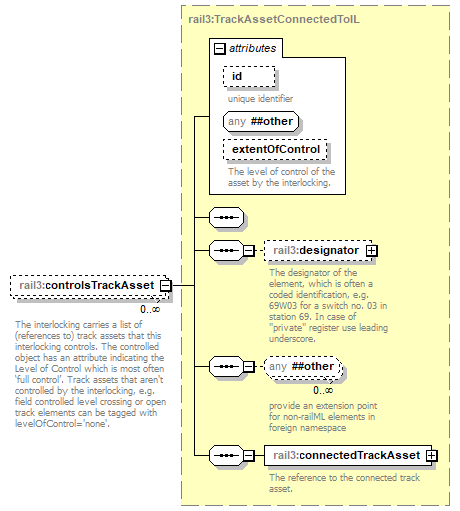 | ||||||||||||||||||||||
| namespace | https://www.railml.org/schemas/3.1 | ||||||||||||||||||||||
| type | rail3:TrackAssetConnectedToIL | ||||||||||||||||||||||
| properties |
| ||||||||||||||||||||||
| children | rail3:designator rail3:connectedTrackAsset | ||||||||||||||||||||||
| attributes |
| ||||||||||||||||||||||
| annotation |
| ||||||||||||||||||||||
| source | <xs:element name="controlsTrackAsset" type="rail3:TrackAssetConnectedToIL" minOccurs="0" maxOccurs="unbounded"> <xs:annotation> <xs:documentation>The interlocking carries a list of (references to) track assets that this interlocking controls. The controlled object has an attribute indicating the Level of Control which is most often ‘full control’. Track assets that aren't controlled by the interlocking, e.g. field controlled level crossing or open track elements can be tagged with levelOfControl='none'. </xs:documentation> </xs:annotation> </xs:element> |
element SignalBox/controlsRoute
| diagram | 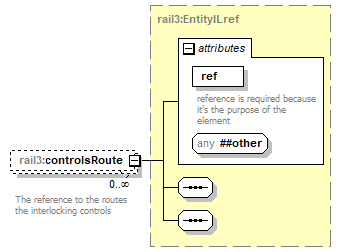 | ||||||||||||||
| namespace | https://www.railml.org/schemas/3.1 | ||||||||||||||
| type | rail3:EntityILref | ||||||||||||||
| properties |
| ||||||||||||||
| attributes |
| ||||||||||||||
| annotation |
| ||||||||||||||
| source | <xs:element name="controlsRoute" type="rail3:EntityILref" minOccurs="0" maxOccurs="unbounded"> <xs:annotation> <xs:documentation>The reference to the routes the interlocking controls</xs:documentation> </xs:annotation> </xs:element> |
element SignalBox/controlsCombinedRoute
| diagram | 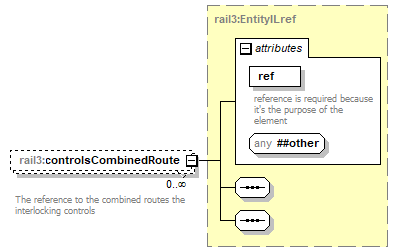 | ||||||||||||||
| namespace | https://www.railml.org/schemas/3.1 | ||||||||||||||
| type | rail3:EntityILref | ||||||||||||||
| properties |
| ||||||||||||||
| attributes |
| ||||||||||||||
| annotation |
| ||||||||||||||
| source | <xs:element name="controlsCombinedRoute" type="rail3:EntityILref" minOccurs="0" maxOccurs="unbounded"> <xs:annotation> <xs:documentation>The reference to the combined routes the interlocking controls</xs:documentation> </xs:annotation> </xs:element> |
element SignalBox/controlsInterface
| diagram | 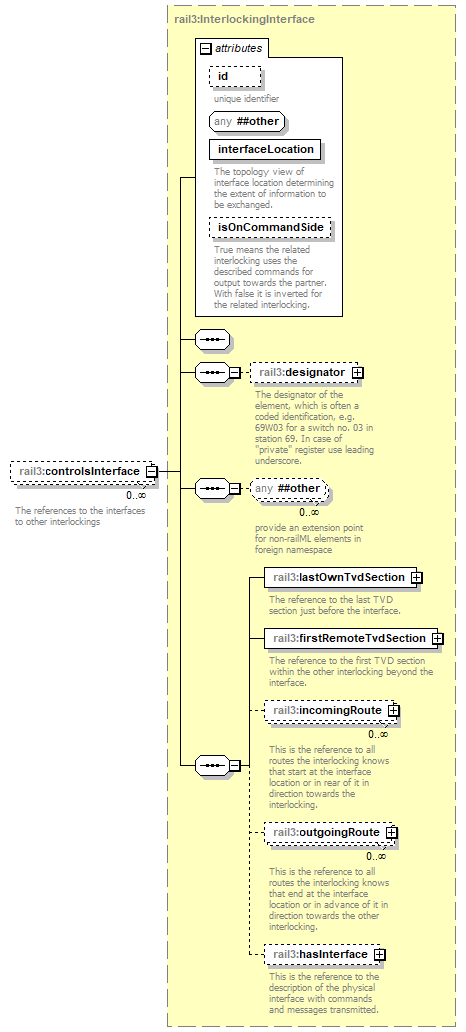 | ||||||||||||||||||||||||||||||
| namespace | https://www.railml.org/schemas/3.1 | ||||||||||||||||||||||||||||||
| type | rail3:InterlockingInterface | ||||||||||||||||||||||||||||||
| properties |
| ||||||||||||||||||||||||||||||
| children | rail3:designator rail3:lastOwnTvdSection rail3:firstRemoteTvdSection rail3:incomingRoute rail3:outgoingRoute rail3:hasInterface | ||||||||||||||||||||||||||||||
| attributes |
| ||||||||||||||||||||||||||||||
| annotation |
| ||||||||||||||||||||||||||||||
| source | <xs:element name="controlsInterface" type="rail3:InterlockingInterface" minOccurs="0" maxOccurs="unbounded"> <xs:annotation> <xs:documentation>The references to the interfaces to other interlockings</xs:documentation> </xs:annotation> </xs:element> |
element SignalBox/controlledBy
| diagram | 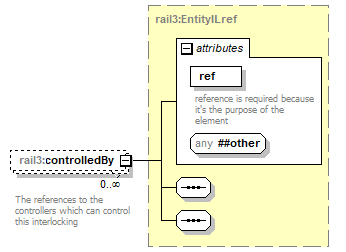 | ||||||||||||||
| namespace | https://www.railml.org/schemas/3.1 | ||||||||||||||
| type | rail3:EntityILref | ||||||||||||||
| properties |
| ||||||||||||||
| attributes |
| ||||||||||||||
| annotation |
| ||||||||||||||
| source | <xs:element name="controlledBy" type="rail3:EntityILref" minOccurs="0" maxOccurs="unbounded"> <xs:annotation> <xs:documentation>The references to the controllers which can control this interlocking</xs:documentation> </xs:annotation> </xs:element> |
element SignalBox/implementsSignalplan
| diagram | 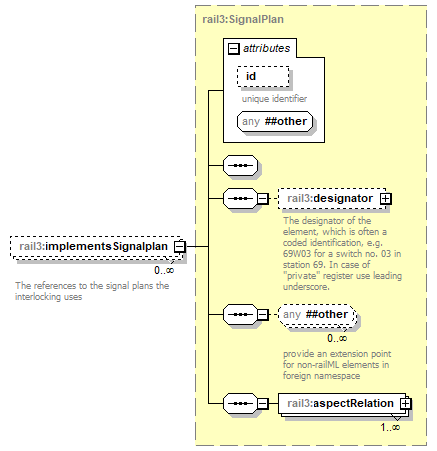 | ||||||||||||||
| namespace | https://www.railml.org/schemas/3.1 | ||||||||||||||
| type | rail3:SignalPlan | ||||||||||||||
| properties |
| ||||||||||||||
| children | rail3:designator rail3:aspectRelation | ||||||||||||||
| attributes |
| ||||||||||||||
| annotation |
| ||||||||||||||
| source | <xs:element name="implementsSignalplan" type="rail3:SignalPlan" minOccurs="0" maxOccurs="unbounded"> <xs:annotation> <xs:documentation>The references to the signal plans the interlocking uses</xs:documentation> </xs:annotation> </xs:element> |
element SignalBox/implementsElementGroup
| diagram | 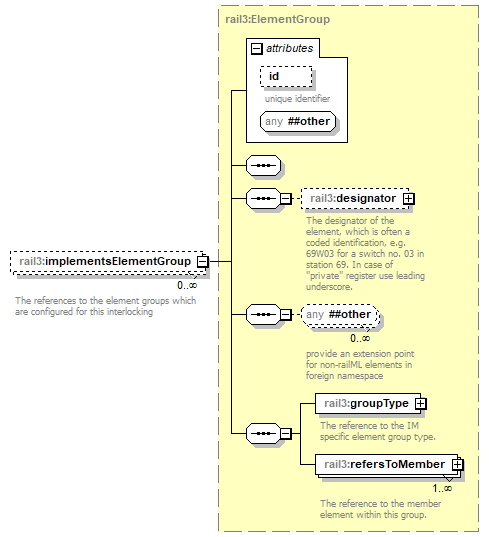 | ||||||||||||||
| namespace | https://www.railml.org/schemas/3.1 | ||||||||||||||
| type | rail3:ElementGroup | ||||||||||||||
| properties |
| ||||||||||||||
| children | rail3:designator rail3:groupType rail3:refersToMember | ||||||||||||||
| attributes |
| ||||||||||||||
| annotation |
| ||||||||||||||
| source | <xs:element name="implementsElementGroup" type="rail3:ElementGroup" minOccurs="0" maxOccurs="unbounded"> <xs:annotation> <xs:documentation>The references to the element groups which are configured for this interlocking</xs:documentation> </xs:annotation> </xs:element> |
element SignalBox/hasPermissionZone
| diagram | 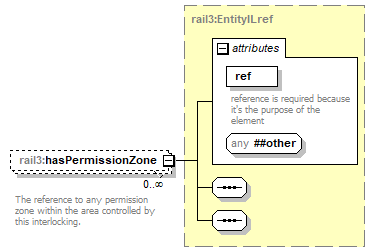 | ||||||||||||||
| namespace | https://www.railml.org/schemas/3.1 | ||||||||||||||
| type | rail3:EntityILref | ||||||||||||||
| properties |
| ||||||||||||||
| attributes |
| ||||||||||||||
| annotation |
| ||||||||||||||
| source | <xs:element name="hasPermissionZone" type="rail3:EntityILref" minOccurs="0" maxOccurs="unbounded"> <xs:annotation> <xs:documentation>The reference to any permission zone within the area controlled by this interlocking.</xs:documentation> </xs:annotation> </xs:element> |
element SignalBox/hasConflictingRoutes
| diagram |  | ||||||||||||||
| namespace | https://www.railml.org/schemas/3.1 | ||||||||||||||
| type | rail3:EntityILref | ||||||||||||||
| properties |
| ||||||||||||||
| attributes |
| ||||||||||||||
| annotation |
| ||||||||||||||
| source | <xs:element name="hasConflictingRoutes" type="rail3:EntityILref" minOccurs="0" maxOccurs="unbounded"> <xs:annotation> <xs:documentation>The references to the conflicting routes the interlocking knows</xs:documentation> </xs:annotation> </xs:element> |
element SignalBox/hasConfiguration
| diagram | 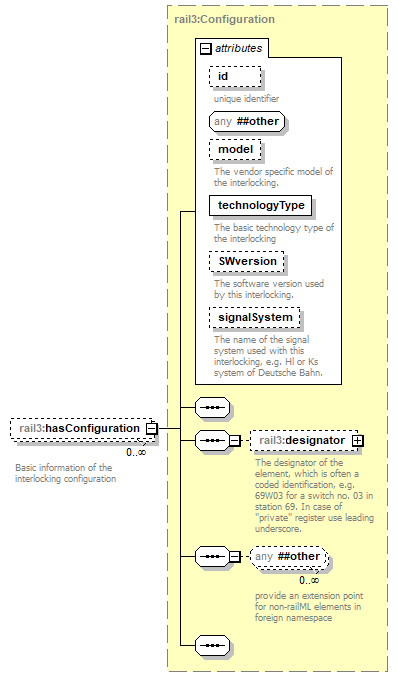 | ||||||||||||||||||||||||||||||||||||||||||||||
| namespace | https://www.railml.org/schemas/3.1 | ||||||||||||||||||||||||||||||||||||||||||||||
| type | rail3:Configuration | ||||||||||||||||||||||||||||||||||||||||||||||
| properties |
| ||||||||||||||||||||||||||||||||||||||||||||||
| children | rail3:designator | ||||||||||||||||||||||||||||||||||||||||||||||
| attributes |
| ||||||||||||||||||||||||||||||||||||||||||||||
| annotation |
| ||||||||||||||||||||||||||||||||||||||||||||||
| source | <xs:element name="hasConfiguration" type="rail3:Configuration" minOccurs="0" maxOccurs="unbounded"> <xs:annotation> <xs:documentation>Basic information of the interlocking configuration</xs:documentation> </xs:annotation> </xs:element> |
complexType SignalBoxes
| diagram |  | ||
| namespace | https://www.railml.org/schemas/3.1 | ||
| children | rail3:signalBox | ||
| used by |
| ||
| annotation |
| ||
| source | <xs:complexType name="SignalBoxes"> <xs:annotation> <xs:documentation>container element for all signalBox elements</xs:documentation> </xs:annotation> <xs:sequence> <xs:element name="signalBox" type="rail3:SignalBox" minOccurs="1" maxOccurs="unbounded"> <xs:annotation> <xs:documentation>Container with the characteristics of an individual interlocking system.</xs:documentation> </xs:annotation> </xs:element> </xs:sequence> </xs:complexType> |
element SignalBoxes/signalBox
| diagram |  | ||||||||||||||
| namespace | https://www.railml.org/schemas/3.1 | ||||||||||||||
| type | rail3:SignalBox | ||||||||||||||
| properties |
| ||||||||||||||
| children | rail3:designator rail3:controlsSystemAsset rail3:controlsTrackAsset rail3:controlsRoute rail3:controlsCombinedRoute rail3:controlsInterface rail3:controlledBy rail3:implementsSignalplan rail3:implementsElementGroup rail3:hasPermissionZone rail3:hasConflictingRoutes rail3:hasConfiguration | ||||||||||||||
| attributes |
| ||||||||||||||
| annotation |
| ||||||||||||||
| source | <xs:element name="signalBox" type="rail3:SignalBox" minOccurs="1" maxOccurs="unbounded"> <xs:annotation> <xs:documentation>Container with the characteristics of an individual interlocking system.</xs:documentation> </xs:annotation> </xs:element> |
complexType SignalDelayTime
| diagram | 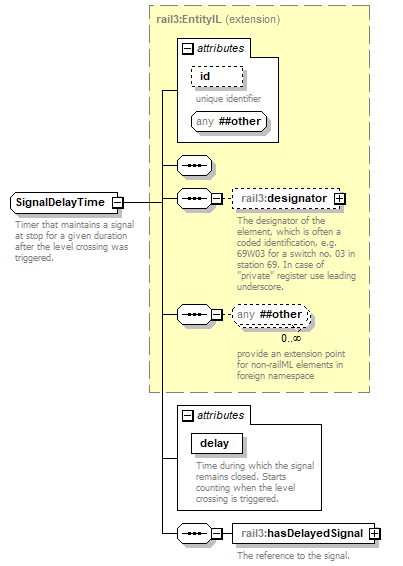 | ||||||||||||||||||||||
| namespace | https://www.railml.org/schemas/3.1 | ||||||||||||||||||||||
| type | extension of rail3:EntityIL | ||||||||||||||||||||||
| properties |
| ||||||||||||||||||||||
| children | rail3:designator rail3:hasDelayedSignal | ||||||||||||||||||||||
| used by |
| ||||||||||||||||||||||
| attributes |
| ||||||||||||||||||||||
| annotation |
| ||||||||||||||||||||||
| source | <xs:complexType name="SignalDelayTime"> <xs:annotation> <xs:documentation>Timer that maintains a signal at stop for a given duration after the level crossing was triggered.</xs:documentation> </xs:annotation> <xs:complexContent> <xs:extension base="rail3:EntityIL"> <xs:sequence> <xs:element name="hasDelayedSignal" type="rail3:EntityILref" minOccurs="1" maxOccurs="1"> <xs:annotation> <xs:documentation>The reference to the signal.</xs:documentation> </xs:annotation> </xs:element> </xs:sequence> <xs:attribute name="delay" type="xs:duration" use="required"> <xs:annotation> <xs:documentation>Time during which the signal remains closed. Starts counting when the level crossing is triggered.</xs:documentation> </xs:annotation> </xs:attribute> </xs:extension> </xs:complexContent> </xs:complexType> |
attribute SignalDelayTime/@delay
| type | xs:duration | ||
| properties |
| ||
| annotation |
| ||
| source | <xs:attribute name="delay" type="xs:duration" use="required"> <xs:annotation> <xs:documentation>Time during which the signal remains closed. Starts counting when the level crossing is triggered.</xs:documentation> </xs:annotation> </xs:attribute> |
element SignalDelayTime/hasDelayedSignal
| diagram | 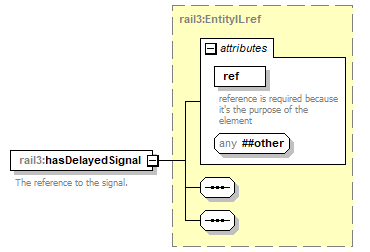 | ||||||||||||||
| namespace | https://www.railml.org/schemas/3.1 | ||||||||||||||
| type | rail3:EntityILref | ||||||||||||||
| properties |
| ||||||||||||||
| attributes |
| ||||||||||||||
| annotation |
| ||||||||||||||
| source | <xs:element name="hasDelayedSignal" type="rail3:EntityILref" minOccurs="1" maxOccurs="1"> <xs:annotation> <xs:documentation>The reference to the signal.</xs:documentation> </xs:annotation> </xs:element> |
complexType SignalIL
| diagram |  | ||||||||||||||||||||||||||||||||||||||||||||||||||||||||||||||||||||||||||||||||||||||
| namespace | https://www.railml.org/schemas/3.1 | ||||||||||||||||||||||||||||||||||||||||||||||||||||||||||||||||||||||||||||||||||||||
| type | extension of rail3:TrackAsset | ||||||||||||||||||||||||||||||||||||||||||||||||||||||||||||||||||||||||||||||||||||||
| properties |
| ||||||||||||||||||||||||||||||||||||||||||||||||||||||||||||||||||||||||||||||||||||||
| children | rail3:designator rail3:refersTo rail3:protectsBlockExit | ||||||||||||||||||||||||||||||||||||||||||||||||||||||||||||||||||||||||||||||||||||||
| used by |
| ||||||||||||||||||||||||||||||||||||||||||||||||||||||||||||||||||||||||||||||||||||||
| attributes |
| ||||||||||||||||||||||||||||||||||||||||||||||||||||||||||||||||||||||||||||||||||||||
| annotation |
| ||||||||||||||||||||||||||||||||||||||||||||||||||||||||||||||||||||||||||||||||||||||
| source | <xs:complexType name="SignalIL"> <xs:annotation> <xs:documentation>A signal has an identity attribute, a reference to a signal or sign defined in the RTM scheme. A sign (or ETCS markerboard) indicating a speed change may well be modelled as a signal because the interlocking is likely to issue a different speed code at that sign</xs:documentation> </xs:annotation> <xs:complexContent> <xs:extension base="rail3:TrackAsset"> <xs:sequence> <xs:element name="refersTo" type="rail3:EntityILref" minOccurs="1" maxOccurs="1"> <xs:annotation> <xs:documentation>The reference to the physical trackside signal.</xs:documentation> </xs:annotation> </xs:element> <xs:element name="protectsBlockExit" type="rail3:EntityILref" minOccurs="0" maxOccurs="1"/> </xs:sequence> <xs:attribute name="releaseSpeed" type="rail3:tSpeedKmPerHour" use="optional"> <xs:annotation> <xs:documentation>Release speed in km/h from controlled braking curve.</xs:documentation> </xs:annotation> </xs:attribute> <xs:attribute name="malfunctionSpeed" type="rail3:tSpeedKmPerHour" use="optional"> <xs:annotation> <xs:documentation>This constant indicates the maximum speed in km/h with which a train may travel past a failed signal. The malfunctioning signal cannot be opened.</xs:documentation> </xs:annotation> </xs:attribute> <xs:attribute name="approachSpeed" type="rail3:tSpeedKmPerHour" use="optional"> <xs:annotation> <xs:documentation>The maximum speed in km/h with which a train can approach the signal. This matches the Ka of the previous (=upstream) signal or speed sign. This is suitable for defining the line speed profile.</xs:documentation> </xs:annotation> </xs:attribute> <xs:attribute name="passingSpeed" type="rail3:tSpeedKmPerHour" use="optional"> <xs:annotation> <xs:documentation>Maximum speed in km/h beyond the signal. This is suitable for defining the line speed profile.</xs:documentation> </xs:annotation> </xs:attribute> <xs:attribute name="releaseDelay" type="xs:duration" use="optional"> <xs:annotation> <xs:documentation>Time to elapse between receiving the revocation command and before route release.</xs:documentation> </xs:annotation> </xs:attribute> <xs:attribute name="function" type="rail3:tSignalFunctionListExt" use="optional"> <xs:annotation> <xs:documentation>Function of the signal for usage by the interlocking. This is in addition to signalType in infrastructure.</xs:documentation> </xs:annotation> </xs:attribute> <xs:attribute name="isVirtual" type="xs:boolean" use="required"> <xs:annotation> <xs:documentation>Often, users label signals virtual. A virtual signal can be a dummy-signal that is a software object in the interlocking but has no physical trackside presence. Such virtual signals can be useful for modelling speed steps; there need not be a physical signal but the interlocking enforces a different speed at the position of the virtual signal. The other way round, stand-alone boards that are not wired to the interlocking can be labelled virtual. Such stand-alone signals are of interest to simulations because when they affect driver behaviour thus influence train runs.</xs:documentation> </xs:annotation> </xs:attribute> <xs:attribute name="callOnAspectTime" type="xs:duration" use="optional"> <xs:annotation> <xs:documentation>time for duration to show call-on aspect on this signal</xs:documentation> </xs:annotation> </xs:attribute> <xs:attribute name="sightDistance" type="rail3:tLengthM" use="optional"> <xs:annotation> <xs:documentation>The distance in metres the signal is visible in advance by the train driver. This might influence reaction times on changing aspects for simulation.</xs:documentation> </xs:annotation> </xs:attribute> </xs:extension> </xs:complexContent> </xs:complexType> |
attribute SignalIL/@releaseSpeed
| type | rail3:tSpeedKmPerHour | ||
| properties |
| ||
| annotation |
| ||
| source | <xs:attribute name="releaseSpeed" type="rail3:tSpeedKmPerHour" use="optional"> <xs:annotation> <xs:documentation>Release speed in km/h from controlled braking curve.</xs:documentation> </xs:annotation> </xs:attribute> |
attribute SignalIL/@malfunctionSpeed
| type | rail3:tSpeedKmPerHour | ||
| properties |
| ||
| annotation |
| ||
| source | <xs:attribute name="malfunctionSpeed" type="rail3:tSpeedKmPerHour" use="optional"> <xs:annotation> <xs:documentation>This constant indicates the maximum speed in km/h with which a train may travel past a failed signal. The malfunctioning signal cannot be opened.</xs:documentation> </xs:annotation> </xs:attribute> |
attribute SignalIL/@approachSpeed
| type | rail3:tSpeedKmPerHour | ||
| properties |
| ||
| annotation |
| ||
| source | <xs:attribute name="approachSpeed" type="rail3:tSpeedKmPerHour" use="optional"> <xs:annotation> <xs:documentation>The maximum speed in km/h with which a train can approach the signal. This matches the Ka of the previous (=upstream) signal or speed sign. This is suitable for defining the line speed profile.</xs:documentation> </xs:annotation> </xs:attribute> |
attribute SignalIL/@passingSpeed
| type | rail3:tSpeedKmPerHour | ||
| properties |
| ||
| annotation |
| ||
| source | <xs:attribute name="passingSpeed" type="rail3:tSpeedKmPerHour" use="optional"> <xs:annotation> <xs:documentation>Maximum speed in km/h beyond the signal. This is suitable for defining the line speed profile.</xs:documentation> </xs:annotation> </xs:attribute> |
attribute SignalIL/@releaseDelay
| type | xs:duration | ||
| properties |
| ||
| annotation |
| ||
| source | <xs:attribute name="releaseDelay" type="xs:duration" use="optional"> <xs:annotation> <xs:documentation>Time to elapse between receiving the revocation command and before route release.</xs:documentation> </xs:annotation> </xs:attribute> |
attribute SignalIL/@function
| type | rail3:tSignalFunctionListExt | ||
| properties |
| ||
| annotation |
| ||
| source | <xs:attribute name="function" type="rail3:tSignalFunctionListExt" use="optional"> <xs:annotation> <xs:documentation>Function of the signal for usage by the interlocking. This is in addition to signalType in infrastructure.</xs:documentation> </xs:annotation> </xs:attribute> |
attribute SignalIL/@isVirtual
| type | xs:boolean | ||
| properties |
| ||
| annotation |
| ||
| source | <xs:attribute name="isVirtual" type="xs:boolean" use="required"> <xs:annotation> <xs:documentation>Often, users label signals virtual. A virtual signal can be a dummy-signal that is a software object in the interlocking but has no physical trackside presence. Such virtual signals can be useful for modelling speed steps; there need not be a physical signal but the interlocking enforces a different speed at the position of the virtual signal. The other way round, stand-alone boards that are not wired to the interlocking can be labelled virtual. Such stand-alone signals are of interest to simulations because when they affect driver behaviour thus influence train runs.</xs:documentation> </xs:annotation> </xs:attribute> |
attribute SignalIL/@callOnAspectTime
| type | xs:duration | ||
| properties |
| ||
| annotation |
| ||
| source | <xs:attribute name="callOnAspectTime" type="xs:duration" use="optional"> <xs:annotation> <xs:documentation>time for duration to show call-on aspect on this signal</xs:documentation> </xs:annotation> </xs:attribute> |
attribute SignalIL/@sightDistance
| type | rail3:tLengthM | ||
| properties |
| ||
| annotation |
| ||
| source | <xs:attribute name="sightDistance" type="rail3:tLengthM" use="optional"> <xs:annotation> <xs:documentation>The distance in metres the signal is visible in advance by the train driver. This might influence reaction times on changing aspects for simulation.</xs:documentation> </xs:annotation> </xs:attribute> |
element SignalIL/refersTo
| diagram | 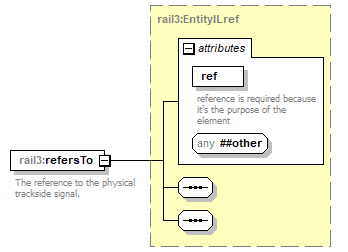 | ||||||||||||||
| namespace | https://www.railml.org/schemas/3.1 | ||||||||||||||
| type | rail3:EntityILref | ||||||||||||||
| properties |
| ||||||||||||||
| attributes |
| ||||||||||||||
| annotation |
| ||||||||||||||
| source | <xs:element name="refersTo" type="rail3:EntityILref" minOccurs="1" maxOccurs="1"> <xs:annotation> <xs:documentation>The reference to the physical trackside signal.</xs:documentation> </xs:annotation> </xs:element> |
element SignalIL/protectsBlockExit
| diagram | 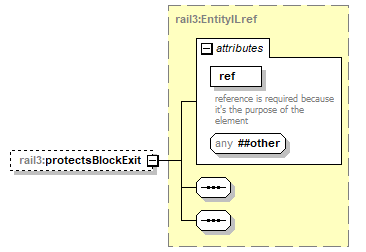 | ||||||||||||||
| namespace | https://www.railml.org/schemas/3.1 | ||||||||||||||
| type | rail3:EntityILref | ||||||||||||||
| properties |
| ||||||||||||||
| attributes |
| ||||||||||||||
| source | <xs:element name="protectsBlockExit" type="rail3:EntityILref" minOccurs="0" maxOccurs="1"/> |
complexType SignalPlan
| diagram | 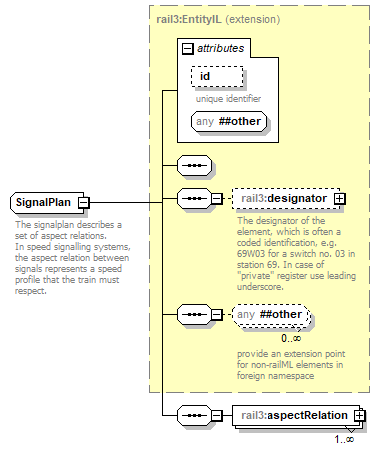 | ||||||||||||||
| namespace | https://www.railml.org/schemas/3.1 | ||||||||||||||
| type | extension of rail3:EntityIL | ||||||||||||||
| properties |
| ||||||||||||||
| children | rail3:designator rail3:aspectRelation | ||||||||||||||
| used by |
| ||||||||||||||
| attributes |
| ||||||||||||||
| annotation |
| ||||||||||||||
| source | <xs:complexType name="SignalPlan"> <xs:annotation> <xs:documentation>The signalplan describes a set of aspect relations. In speed signalling systems, the aspect relation between signals represents a speed profile that the train must respect.</xs:documentation> </xs:annotation> <xs:complexContent> <xs:extension base="rail3:EntityIL"> <xs:sequence> <xs:element name="aspectRelation" type="rail3:AspectRelation" minOccurs="1" maxOccurs="unbounded"/> </xs:sequence> </xs:extension> </xs:complexContent> </xs:complexType> |
element SignalPlan/aspectRelation
| diagram | 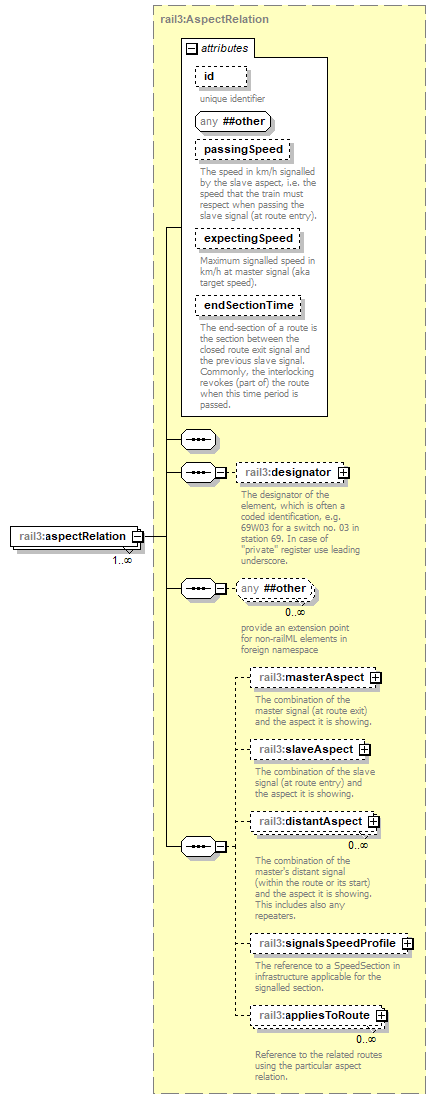 | ||||||||||||||||||||||||||||||||||||||
| namespace | https://www.railml.org/schemas/3.1 | ||||||||||||||||||||||||||||||||||||||
| type | rail3:AspectRelation | ||||||||||||||||||||||||||||||||||||||
| properties |
| ||||||||||||||||||||||||||||||||||||||
| children | rail3:designator rail3:masterAspect rail3:slaveAspect rail3:distantAspect rail3:signalsSpeedProfile rail3:appliesToRoute | ||||||||||||||||||||||||||||||||||||||
| attributes |
| ||||||||||||||||||||||||||||||||||||||
| source | <xs:element name="aspectRelation" type="rail3:AspectRelation" minOccurs="1" maxOccurs="unbounded"/> |
complexType SignalsIL
| diagram | 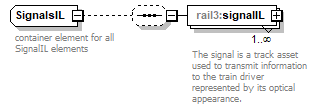 | ||
| namespace | https://www.railml.org/schemas/3.1 | ||
| children | rail3:signalIL | ||
| used by |
| ||
| annotation |
| ||
| source | <xs:complexType name="SignalsIL"> <xs:annotation> <xs:documentation>container element for all SignalIL elements</xs:documentation> </xs:annotation> <xs:sequence minOccurs="0" maxOccurs="1"> <xs:element name="signalIL" type="rail3:SignalIL" minOccurs="1" maxOccurs="unbounded"> <xs:annotation> <xs:documentation>The signal is a track asset used to transmit information to the train driver represented by its optical appearance.</xs:documentation> </xs:annotation> </xs:element> </xs:sequence> </xs:complexType> |
element SignalsIL/signalIL
| diagram |  | ||||||||||||||||||||||||||||||||||||||||||||||||||||||||||||||||||||||||||||||||||||||
| namespace | https://www.railml.org/schemas/3.1 | ||||||||||||||||||||||||||||||||||||||||||||||||||||||||||||||||||||||||||||||||||||||
| type | rail3:SignalIL | ||||||||||||||||||||||||||||||||||||||||||||||||||||||||||||||||||||||||||||||||||||||
| properties |
| ||||||||||||||||||||||||||||||||||||||||||||||||||||||||||||||||||||||||||||||||||||||
| children | rail3:designator rail3:refersTo rail3:protectsBlockExit | ||||||||||||||||||||||||||||||||||||||||||||||||||||||||||||||||||||||||||||||||||||||
| attributes |
| ||||||||||||||||||||||||||||||||||||||||||||||||||||||||||||||||||||||||||||||||||||||
| annotation |
| ||||||||||||||||||||||||||||||||||||||||||||||||||||||||||||||||||||||||||||||||||||||
| source | <xs:element name="signalIL" type="rail3:SignalIL" minOccurs="1" maxOccurs="unbounded"> <xs:annotation> <xs:documentation>The signal is a track asset used to transmit information to the train driver represented by its optical appearance.</xs:documentation> </xs:annotation> </xs:element> |
complexType SignalWithAspect
| diagram | 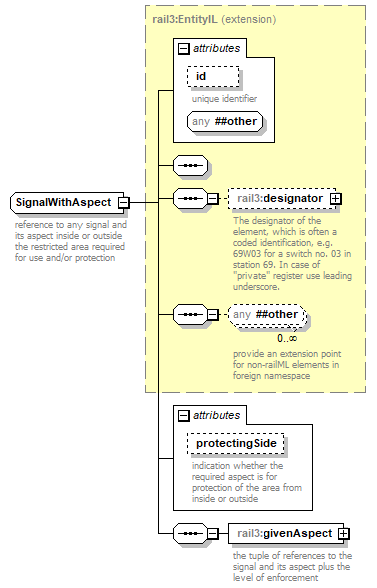 | ||||||||||||||||||||||
| namespace | https://www.railml.org/schemas/3.1 | ||||||||||||||||||||||
| type | extension of rail3:EntityIL | ||||||||||||||||||||||
| properties |
| ||||||||||||||||||||||
| children | rail3:designator rail3:givenAspect | ||||||||||||||||||||||
| used by |
| ||||||||||||||||||||||
| attributes |
| ||||||||||||||||||||||
| annotation |
| ||||||||||||||||||||||
| source | <xs:complexType name="SignalWithAspect"> <xs:annotation> <xs:documentation>reference to any signal and its aspect inside or outside the restricted area required for use and/or protection</xs:documentation> </xs:annotation> <xs:complexContent> <xs:extension base="rail3:EntityIL"> <xs:sequence> <xs:element name="givenAspect" type="rail3:SignalAndGivenAspect" minOccurs="1" maxOccurs="1"> <xs:annotation> <xs:documentation>the tuple of references to the signal and its aspect plus the level of enforcement</xs:documentation> </xs:annotation> </xs:element> </xs:sequence> <xs:attribute name="protectingSide" type="rail3:tProtectingSideList" use="optional"> <xs:annotation> <xs:documentation>indication whether the required aspect is for protection of the area from inside or outside</xs:documentation> </xs:annotation> </xs:attribute> </xs:extension> </xs:complexContent> </xs:complexType> |
attribute SignalWithAspect/@protectingSide
| type | rail3:tProtectingSideList | ||||||||||||
| properties |
| ||||||||||||
| facets |
| ||||||||||||
| annotation |
| ||||||||||||
| source | <xs:attribute name="protectingSide" type="rail3:tProtectingSideList" use="optional"> <xs:annotation> <xs:documentation>indication whether the required aspect is for protection of the area from inside or outside</xs:documentation> </xs:annotation> </xs:attribute> |
element SignalWithAspect/givenAspect
| diagram | 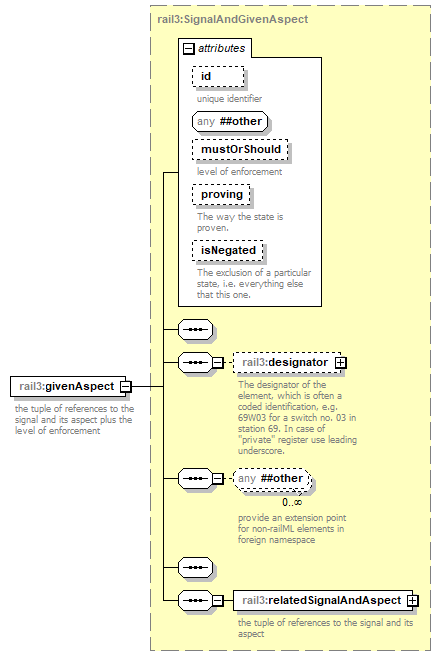 | ||||||||||||||||||||||||||||||||||||||
| namespace | https://www.railml.org/schemas/3.1 | ||||||||||||||||||||||||||||||||||||||
| type | rail3:SignalAndGivenAspect | ||||||||||||||||||||||||||||||||||||||
| properties |
| ||||||||||||||||||||||||||||||||||||||
| children | rail3:designator rail3:relatedSignalAndAspect | ||||||||||||||||||||||||||||||||||||||
| attributes |
| ||||||||||||||||||||||||||||||||||||||
| annotation |
| ||||||||||||||||||||||||||||||||||||||
| source | <xs:element name="givenAspect" type="rail3:SignalAndGivenAspect" minOccurs="1" maxOccurs="1"> <xs:annotation> <xs:documentation>the tuple of references to the signal and its aspect plus the level of enforcement</xs:documentation> </xs:annotation> </xs:element> |
complexType SwitchAndGivenPosition
| diagram | 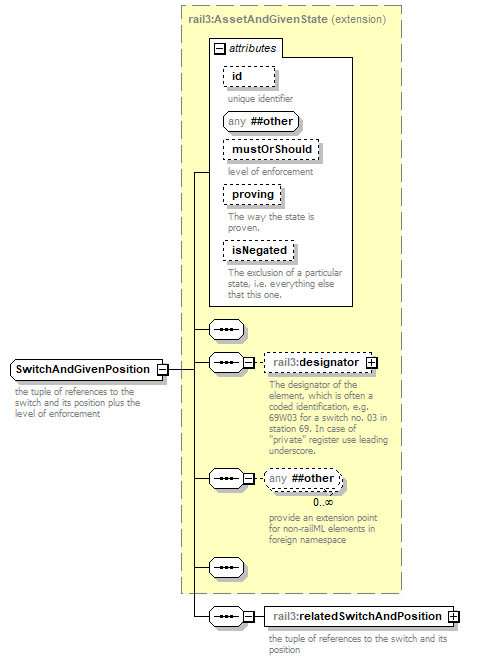 | ||||||||||||||||||||||||||||||||||||||
| namespace | https://www.railml.org/schemas/3.1 | ||||||||||||||||||||||||||||||||||||||
| type | extension of rail3:AssetAndGivenState | ||||||||||||||||||||||||||||||||||||||
| properties |
| ||||||||||||||||||||||||||||||||||||||
| children | rail3:designator rail3:relatedSwitchAndPosition | ||||||||||||||||||||||||||||||||||||||
| used by |
| ||||||||||||||||||||||||||||||||||||||
| attributes |
| ||||||||||||||||||||||||||||||||||||||
| annotation |
| ||||||||||||||||||||||||||||||||||||||
| source | <xs:complexType name="SwitchAndGivenPosition"> <xs:annotation> <xs:documentation>the tuple of references to the switch and its position plus the level of enforcement</xs:documentation> </xs:annotation> <xs:complexContent> <xs:extension base="rail3:AssetAndGivenState"> <xs:sequence> <xs:element name="relatedSwitchAndPosition" type="rail3:SwitchAndPosition" minOccurs="1" maxOccurs="1"> <xs:annotation> <xs:documentation>the tuple of references to the switch and its position</xs:documentation> </xs:annotation> </xs:element> </xs:sequence> </xs:extension> </xs:complexContent> </xs:complexType> |
element SwitchAndGivenPosition/relatedSwitchAndPosition
| diagram | 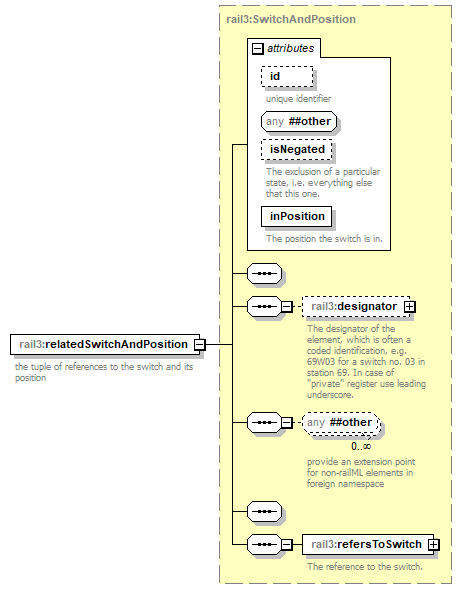 | ||||||||||||||||||||||||||||||
| namespace | https://www.railml.org/schemas/3.1 | ||||||||||||||||||||||||||||||
| type | rail3:SwitchAndPosition | ||||||||||||||||||||||||||||||
| properties |
| ||||||||||||||||||||||||||||||
| children | rail3:designator rail3:refersToSwitch | ||||||||||||||||||||||||||||||
| attributes |
| ||||||||||||||||||||||||||||||
| annotation |
| ||||||||||||||||||||||||||||||
| source | <xs:element name="relatedSwitchAndPosition" type="rail3:SwitchAndPosition" minOccurs="1" maxOccurs="1"> <xs:annotation> <xs:documentation>the tuple of references to the switch and its position</xs:documentation> </xs:annotation> </xs:element> |
complexType SwitchAndPosition
| diagram | 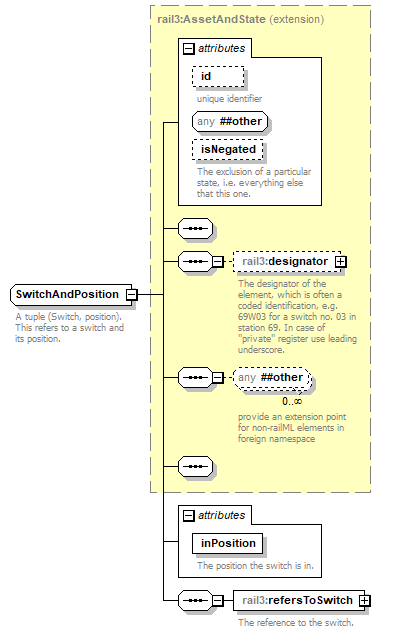 | ||||||||||||||||||||||||||||||
| namespace | https://www.railml.org/schemas/3.1 | ||||||||||||||||||||||||||||||
| type | extension of rail3:AssetAndState | ||||||||||||||||||||||||||||||
| properties |
| ||||||||||||||||||||||||||||||
| children | rail3:designator rail3:refersToSwitch | ||||||||||||||||||||||||||||||
| used by |
| ||||||||||||||||||||||||||||||
| attributes |
| ||||||||||||||||||||||||||||||
| annotation |
| ||||||||||||||||||||||||||||||
| source | <xs:complexType name="SwitchAndPosition"> <xs:annotation> <xs:documentation>A tuple (Switch, position). This refers to a switch and its position.</xs:documentation> </xs:annotation> <xs:complexContent> <xs:extension base="rail3:AssetAndState"> <xs:sequence> <xs:element name="refersToSwitch" type="rail3:EntityILref" minOccurs="1" maxOccurs="1"> <xs:annotation> <xs:documentation>The reference to the switch.</xs:documentation> </xs:annotation> </xs:element> </xs:sequence> <xs:attribute name="inPosition" type="rail3:tSwitchPosition" use="required"> <xs:annotation> <xs:documentation>The position the switch is in.</xs:documentation> </xs:annotation> </xs:attribute> </xs:extension> </xs:complexContent> </xs:complexType> |
attribute SwitchAndPosition/@inPosition
| type | rail3:tSwitchPosition | |||||||||
| properties |
| |||||||||
| facets |
| |||||||||
| annotation |
| |||||||||
| source | <xs:attribute name="inPosition" type="rail3:tSwitchPosition" use="required"> <xs:annotation> <xs:documentation>The position the switch is in.</xs:documentation> </xs:annotation> </xs:attribute> |
element SwitchAndPosition/refersToSwitch
| diagram | 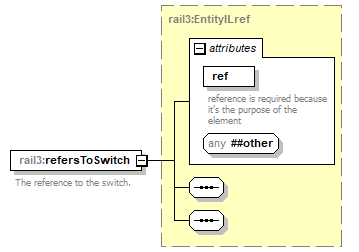 | ||||||||||||||
| namespace | https://www.railml.org/schemas/3.1 | ||||||||||||||
| type | rail3:EntityILref | ||||||||||||||
| properties |
| ||||||||||||||
| attributes |
| ||||||||||||||
| annotation |
| ||||||||||||||
| source | <xs:element name="refersToSwitch" type="rail3:EntityILref" minOccurs="1" maxOccurs="1"> <xs:annotation> <xs:documentation>The reference to the switch.</xs:documentation> </xs:annotation> </xs:element> |
complexType SwitchesIL
| diagram | 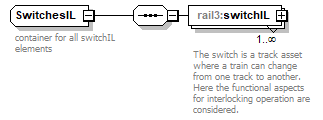 | ||
| namespace | https://www.railml.org/schemas/3.1 | ||
| children | rail3:switchIL | ||
| used by |
| ||
| annotation |
| ||
| source | <xs:complexType name="SwitchesIL"> <xs:annotation> <xs:documentation>container for all switchIL elements</xs:documentation> </xs:annotation> <xs:sequence> <xs:element name="switchIL" type="rail3:SwitchIL" minOccurs="1" maxOccurs="unbounded"> <xs:annotation> <xs:documentation>The switch is a track asset where a train can change from one track to another. Here the functional aspects for interlocking operation are considered.</xs:documentation> </xs:annotation> </xs:element> </xs:sequence> </xs:complexType> |
element SwitchesIL/switchIL
| diagram |  | ||||||||||||||||||||||||||||||||||||||||||||||||||||||||||||||||||||||
| namespace | https://www.railml.org/schemas/3.1 | ||||||||||||||||||||||||||||||||||||||||||||||||||||||||||||||||||||||
| type | rail3:SwitchIL | ||||||||||||||||||||||||||||||||||||||||||||||||||||||||||||||||||||||
| properties |
| ||||||||||||||||||||||||||||||||||||||||||||||||||||||||||||||||||||||
| children | rail3:designator rail3:refersTo rail3:hasGaugeClearanceMarker rail3:hasTvdSection rail3:connectedToPowerSupply rail3:relatedMovableElement rail3:hasFoulingTrainDetectors rail3:branchLeft rail3:branchRight rail3:hasPositionRestriction | ||||||||||||||||||||||||||||||||||||||||||||||||||||||||||||||||||||||
| attributes |
| ||||||||||||||||||||||||||||||||||||||||||||||||||||||||||||||||||||||
| annotation |
| ||||||||||||||||||||||||||||||||||||||||||||||||||||||||||||||||||||||
| source | <xs:element name="switchIL" type="rail3:SwitchIL" minOccurs="1" maxOccurs="unbounded"> <xs:annotation> <xs:documentation>The switch is a track asset where a train can change from one track to another. Here the functional aspects for interlocking operation are considered.</xs:documentation> </xs:annotation> </xs:element> |
complexType SwitchIL
| diagram |  | ||||||||||||||||||||||||||||||||||||||||||||||||||||||||||||||||||||||
| namespace | https://www.railml.org/schemas/3.1 | ||||||||||||||||||||||||||||||||||||||||||||||||||||||||||||||||||||||
| type | extension of rail3:MovableElement | ||||||||||||||||||||||||||||||||||||||||||||||||||||||||||||||||||||||
| properties |
| ||||||||||||||||||||||||||||||||||||||||||||||||||||||||||||||||||||||
| children | rail3:designator rail3:refersTo rail3:hasGaugeClearanceMarker rail3:hasTvdSection rail3:connectedToPowerSupply rail3:relatedMovableElement rail3:hasFoulingTrainDetectors rail3:branchLeft rail3:branchRight rail3:hasPositionRestriction | ||||||||||||||||||||||||||||||||||||||||||||||||||||||||||||||||||||||
| used by |
| ||||||||||||||||||||||||||||||||||||||||||||||||||||||||||||||||||||||
| attributes |
| ||||||||||||||||||||||||||||||||||||||||||||||||||||||||||||||||||||||
| annotation |
| ||||||||||||||||||||||||||||||||||||||||||||||||||||||||||||||||||||||
| source | <xs:complexType name="SwitchIL"> <xs:annotation> <xs:documentation>Extends the infrastructure::switch for IXL purposes. The graph model from RailTopoModel allows the definition of connections between tracks. Thus, one can include or exclude connections between tracks. The name SwitchIL is chosen to reconcile US nomenclature and to avoid a naming conflict with infrastructure domain.</xs:documentation> </xs:annotation> <xs:complexContent> <xs:extension base="rail3:MovableElement"> <xs:sequence> <xs:element name="hasFoulingTrainDetectors" type="rail3:EntityILref" minOccurs="0" maxOccurs="unbounded"> <xs:annotation> <xs:documentation>This is the reference to any train detection device in infrastructure which is located to close to the switch, i.e. the gauge of the switch is not clear when the associated neighbouring TVD section is occupied.</xs:documentation> </xs:annotation> </xs:element> <xs:element name="branchLeft" type="rail3:EntityILref" minOccurs="1" maxOccurs="1"> <xs:annotation> <xs:documentation>This is the reference to the underlying track section in infrastructure of the left branch.</xs:documentation> </xs:annotation> </xs:element> <xs:element name="branchRight" type="rail3:EntityILref" minOccurs="1" maxOccurs="1"> <xs:annotation> <xs:documentation>This is the reference to the underlying track section in infrastructure of the right branch.</xs:documentation> </xs:annotation> </xs:element> <xs:element name="hasPositionRestriction" type="rail3:SwitchPositionRestriction" minOccurs="0" maxOccurs="1"> <xs:annotation> <xs:documentation>It defines the position the switch shall have in dependency of the position of the related element.</xs:documentation> </xs:annotation> </xs:element> </xs:sequence> <xs:attribute name="preferredPosition" type="rail3:tSwitchPosition" use="optional"> <xs:annotation> <xs:documentation>This is the preferred position of the switch which it is switched to when not in use or in case of both positions required for flank protection.</xs:documentation> </xs:annotation> </xs:attribute> </xs:extension> </xs:complexContent> </xs:complexType> |
attribute SwitchIL/@preferredPosition
| type | rail3:tSwitchPosition | |||||||||
| properties |
| |||||||||
| facets |
| |||||||||
| annotation |
| |||||||||
| source | <xs:attribute name="preferredPosition" type="rail3:tSwitchPosition" use="optional"> <xs:annotation> <xs:documentation>This is the preferred position of the switch which it is switched to when not in use or in case of both positions required for flank protection.</xs:documentation> </xs:annotation> </xs:attribute> |
element SwitchIL/hasFoulingTrainDetectors
| diagram | 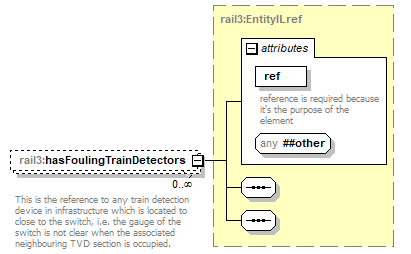 | ||||||||||||||
| namespace | https://www.railml.org/schemas/3.1 | ||||||||||||||
| type | rail3:EntityILref | ||||||||||||||
| properties |
| ||||||||||||||
| attributes |
| ||||||||||||||
| annotation |
| ||||||||||||||
| source | <xs:element name="hasFoulingTrainDetectors" type="rail3:EntityILref" minOccurs="0" maxOccurs="unbounded"> <xs:annotation> <xs:documentation>This is the reference to any train detection device in infrastructure which is located to close to the switch, i.e. the gauge of the switch is not clear when the associated neighbouring TVD section is occupied.</xs:documentation> </xs:annotation> </xs:element> |
element SwitchIL/branchLeft
| diagram | 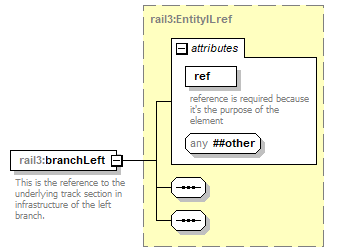 | ||||||||||||||
| namespace | https://www.railml.org/schemas/3.1 | ||||||||||||||
| type | rail3:EntityILref | ||||||||||||||
| properties |
| ||||||||||||||
| attributes |
| ||||||||||||||
| annotation |
| ||||||||||||||
| source | <xs:element name="branchLeft" type="rail3:EntityILref" minOccurs="1" maxOccurs="1"> <xs:annotation> <xs:documentation>This is the reference to the underlying track section in infrastructure of the left branch.</xs:documentation> </xs:annotation> </xs:element> |
element SwitchIL/branchRight
| diagram | 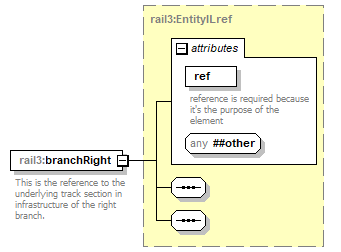 | ||||||||||||||
| namespace | https://www.railml.org/schemas/3.1 | ||||||||||||||
| type | rail3:EntityILref | ||||||||||||||
| properties |
| ||||||||||||||
| attributes |
| ||||||||||||||
| annotation |
| ||||||||||||||
| source | <xs:element name="branchRight" type="rail3:EntityILref" minOccurs="1" maxOccurs="1"> <xs:annotation> <xs:documentation>This is the reference to the underlying track section in infrastructure of the right branch.</xs:documentation> </xs:annotation> </xs:element> |
element SwitchIL/hasPositionRestriction
| diagram | 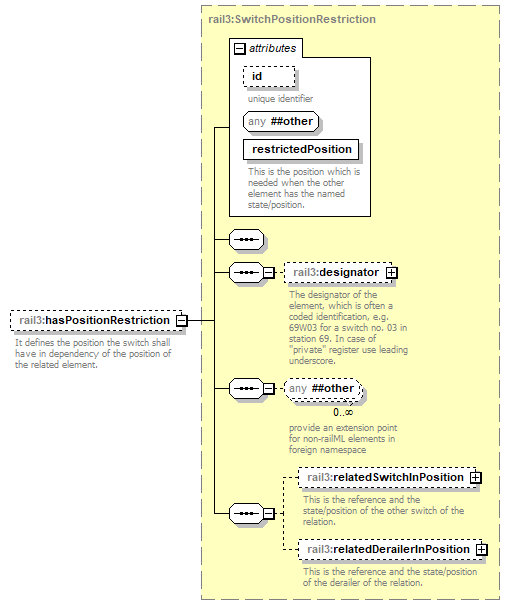 | ||||||||||||||||||||||
| namespace | https://www.railml.org/schemas/3.1 | ||||||||||||||||||||||
| type | rail3:SwitchPositionRestriction | ||||||||||||||||||||||
| properties |
| ||||||||||||||||||||||
| children | rail3:designator rail3:relatedSwitchInPosition rail3:relatedDerailerInPosition | ||||||||||||||||||||||
| attributes |
| ||||||||||||||||||||||
| annotation |
| ||||||||||||||||||||||
| source | <xs:element name="hasPositionRestriction" type="rail3:SwitchPositionRestriction" minOccurs="0" maxOccurs="1"> <xs:annotation> <xs:documentation>It defines the position the switch shall have in dependency of the position of the related element.</xs:documentation> </xs:annotation> </xs:element> |
complexType SwitchInPosition
| diagram | 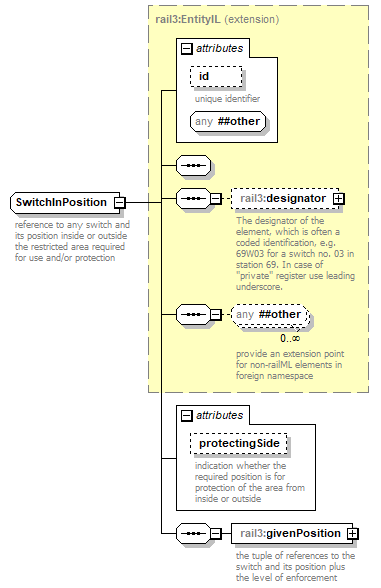 | ||||||||||||||||||||||
| namespace | https://www.railml.org/schemas/3.1 | ||||||||||||||||||||||
| type | extension of rail3:EntityIL | ||||||||||||||||||||||
| properties |
| ||||||||||||||||||||||
| children | rail3:designator rail3:givenPosition | ||||||||||||||||||||||
| used by |
| ||||||||||||||||||||||
| attributes |
| ||||||||||||||||||||||
| annotation |
| ||||||||||||||||||||||
| source | <xs:complexType name="SwitchInPosition"> <xs:annotation> <xs:documentation>reference to any switch and its position inside or outside the restricted area required for use and/or protection</xs:documentation> </xs:annotation> <xs:complexContent> <xs:extension base="rail3:EntityIL"> <xs:sequence> <xs:element name="givenPosition" type="rail3:SwitchAndGivenPosition" minOccurs="1" maxOccurs="1"> <xs:annotation> <xs:documentation>the tuple of references to the switch and its position plus the level of enforcement</xs:documentation> </xs:annotation> </xs:element> </xs:sequence> <xs:attribute name="protectingSide" type="rail3:tProtectingSideList" use="optional"> <xs:annotation> <xs:documentation>indication whether the required position is for protection of the area from inside or outside</xs:documentation> </xs:annotation> </xs:attribute> </xs:extension> </xs:complexContent> </xs:complexType> |
attribute SwitchInPosition/@protectingSide
| type | rail3:tProtectingSideList | ||||||||||||
| properties |
| ||||||||||||
| facets |
| ||||||||||||
| annotation |
| ||||||||||||
| source | <xs:attribute name="protectingSide" type="rail3:tProtectingSideList" use="optional"> <xs:annotation> <xs:documentation>indication whether the required position is for protection of the area from inside or outside</xs:documentation> </xs:annotation> </xs:attribute> |
element SwitchInPosition/givenPosition
| diagram | 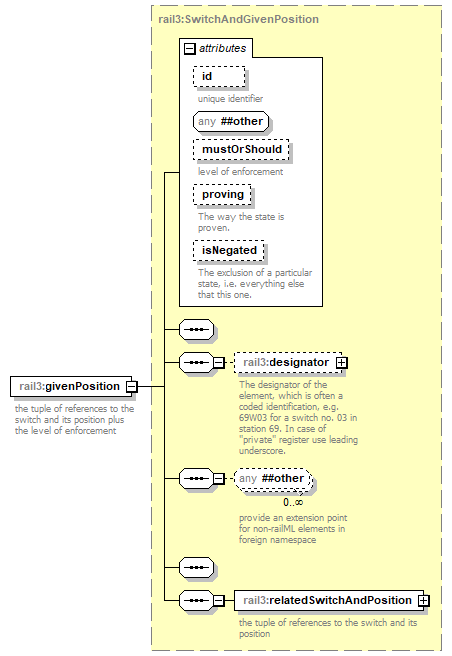 | ||||||||||||||||||||||||||||||||||||||
| namespace | https://www.railml.org/schemas/3.1 | ||||||||||||||||||||||||||||||||||||||
| type | rail3:SwitchAndGivenPosition | ||||||||||||||||||||||||||||||||||||||
| properties |
| ||||||||||||||||||||||||||||||||||||||
| children | rail3:designator rail3:relatedSwitchAndPosition | ||||||||||||||||||||||||||||||||||||||
| attributes |
| ||||||||||||||||||||||||||||||||||||||
| annotation |
| ||||||||||||||||||||||||||||||||||||||
| source | <xs:element name="givenPosition" type="rail3:SwitchAndGivenPosition" minOccurs="1" maxOccurs="1"> <xs:annotation> <xs:documentation>the tuple of references to the switch and its position plus the level of enforcement</xs:documentation> </xs:annotation> </xs:element> |
complexType SwitchPositionRestriction
| diagram | 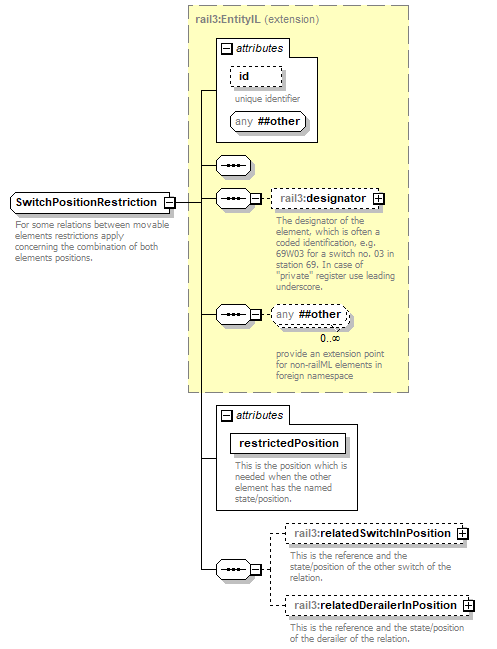 | ||||||||||||||||||||||
| namespace | https://www.railml.org/schemas/3.1 | ||||||||||||||||||||||
| type | extension of rail3:EntityIL | ||||||||||||||||||||||
| properties |
| ||||||||||||||||||||||
| children | rail3:designator rail3:relatedSwitchInPosition rail3:relatedDerailerInPosition | ||||||||||||||||||||||
| used by |
| ||||||||||||||||||||||
| attributes |
| ||||||||||||||||||||||
| annotation |
| ||||||||||||||||||||||
| source | <xs:complexType name="SwitchPositionRestriction"> <xs:annotation> <xs:documentation>For some relations between movable elements restrictions apply concerning the combination of both elements positions.</xs:documentation> </xs:annotation> <xs:complexContent> <xs:extension base="rail3:EntityIL"> <xs:sequence> <xs:element name="relatedSwitchInPosition" type="rail3:SwitchAndPosition" minOccurs="0" maxOccurs="1"> <xs:annotation> <xs:documentation>This is the reference and the state/position of the other switch of the relation.</xs:documentation> </xs:annotation> </xs:element> <xs:element name="relatedDerailerInPosition" type="rail3:DerailerAndPosition" minOccurs="0" maxOccurs="1"> <xs:annotation> <xs:documentation>This is the reference and the state/position of the derailer of the relation.</xs:documentation> </xs:annotation> </xs:element> </xs:sequence> <xs:attribute name="restrictedPosition" type="rail3:tSwitchPosition" use="required"> <xs:annotation> <xs:documentation>This is the position which is needed when the other element has the named state/position.</xs:documentation> </xs:annotation> </xs:attribute> </xs:extension> </xs:complexContent> </xs:complexType> |
attribute SwitchPositionRestriction/@restrictedPosition
| type | rail3:tSwitchPosition | |||||||||
| properties |
| |||||||||
| facets |
| |||||||||
| annotation |
| |||||||||
| source | <xs:attribute name="restrictedPosition" type="rail3:tSwitchPosition" use="required"> <xs:annotation> <xs:documentation>This is the position which is needed when the other element has the named state/position.</xs:documentation> </xs:annotation> </xs:attribute> |
element SwitchPositionRestriction/relatedSwitchInPosition
| diagram | 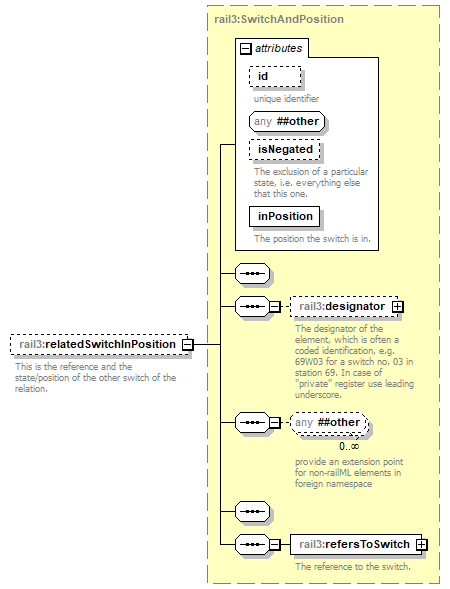 | ||||||||||||||||||||||||||||||
| namespace | https://www.railml.org/schemas/3.1 | ||||||||||||||||||||||||||||||
| type | rail3:SwitchAndPosition | ||||||||||||||||||||||||||||||
| properties |
| ||||||||||||||||||||||||||||||
| children | rail3:designator rail3:refersToSwitch | ||||||||||||||||||||||||||||||
| attributes |
| ||||||||||||||||||||||||||||||
| annotation |
| ||||||||||||||||||||||||||||||
| source | <xs:element name="relatedSwitchInPosition" type="rail3:SwitchAndPosition" minOccurs="0" maxOccurs="1"> <xs:annotation> <xs:documentation>This is the reference and the state/position of the other switch of the relation.</xs:documentation> </xs:annotation> </xs:element> |
element SwitchPositionRestriction/relatedDerailerInPosition
| diagram | 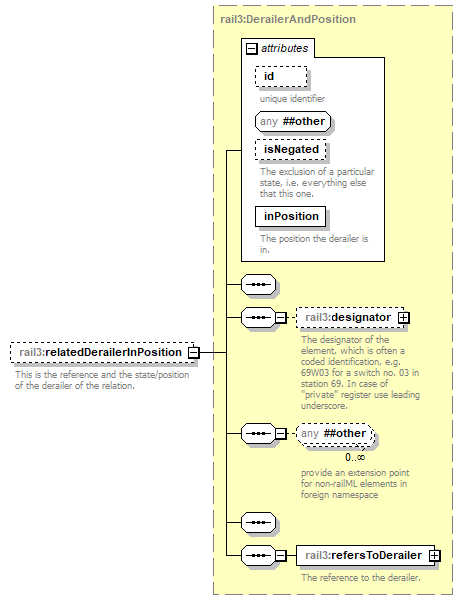 | ||||||||||||||||||||||||||||||
| namespace | https://www.railml.org/schemas/3.1 | ||||||||||||||||||||||||||||||
| type | rail3:DerailerAndPosition | ||||||||||||||||||||||||||||||
| properties |
| ||||||||||||||||||||||||||||||
| children | rail3:designator rail3:refersToDerailer | ||||||||||||||||||||||||||||||
| attributes |
| ||||||||||||||||||||||||||||||
| annotation |
| ||||||||||||||||||||||||||||||
| source | <xs:element name="relatedDerailerInPosition" type="rail3:DerailerAndPosition" minOccurs="0" maxOccurs="1"> <xs:annotation> <xs:documentation>This is the reference and the state/position of the derailer of the relation.</xs:documentation> </xs:annotation> </xs:element> |
complexType SwitchRelatedDelay
| diagram | 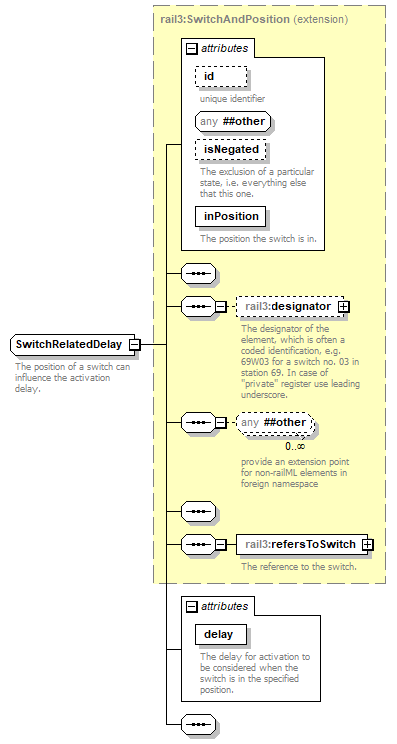 | ||||||||||||||||||||||||||||||||||||||
| namespace | https://www.railml.org/schemas/3.1 | ||||||||||||||||||||||||||||||||||||||
| type | extension of rail3:SwitchAndPosition | ||||||||||||||||||||||||||||||||||||||
| properties |
| ||||||||||||||||||||||||||||||||||||||
| children | rail3:designator rail3:refersToSwitch | ||||||||||||||||||||||||||||||||||||||
| used by |
| ||||||||||||||||||||||||||||||||||||||
| attributes |
| ||||||||||||||||||||||||||||||||||||||
| annotation |
| ||||||||||||||||||||||||||||||||||||||
| source | <xs:complexType name="SwitchRelatedDelay"> <xs:annotation> <xs:documentation>The position of a switch can influence the activation delay.</xs:documentation> </xs:annotation> <xs:complexContent> <xs:extension base="rail3:SwitchAndPosition"> <xs:sequence/> <xs:attribute name="delay" type="xs:duration" use="required"> <xs:annotation> <xs:documentation>The delay for activation to be considered when the switch is in the specified position.</xs:documentation> </xs:annotation> </xs:attribute> </xs:extension> </xs:complexContent> </xs:complexType> |
attribute SwitchRelatedDelay/@delay
| type | xs:duration | ||
| properties |
| ||
| annotation |
| ||
| source | <xs:attribute name="delay" type="xs:duration" use="required"> <xs:annotation> <xs:documentation>The delay for activation to be considered when the switch is in the specified position.</xs:documentation> </xs:annotation> </xs:attribute> |
complexType SystemAssetConnectedToIL
| diagram | 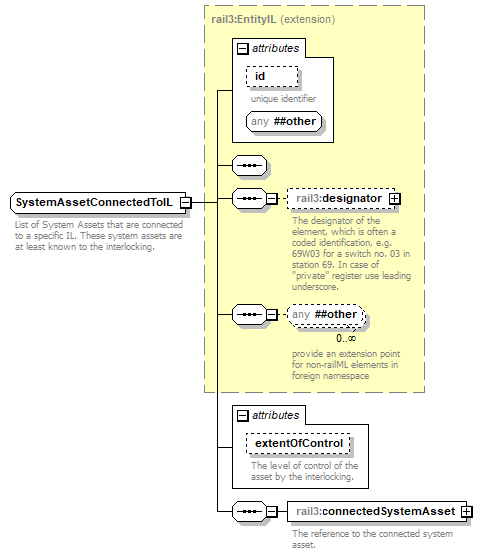 | ||||||||||||||||||||||
| namespace | https://www.railml.org/schemas/3.1 | ||||||||||||||||||||||
| type | extension of rail3:EntityIL | ||||||||||||||||||||||
| properties |
| ||||||||||||||||||||||
| children | rail3:designator rail3:connectedSystemAsset | ||||||||||||||||||||||
| used by |
| ||||||||||||||||||||||
| attributes |
| ||||||||||||||||||||||
| annotation |
| ||||||||||||||||||||||
| source | <xs:complexType name="SystemAssetConnectedToIL"> <xs:annotation> <xs:documentation>List of System Assets that are connected to a specific IL. These system assets are at least known to the interlocking.</xs:documentation> </xs:annotation> <xs:complexContent> <xs:extension base="rail3:EntityIL"> <xs:sequence> <xs:element name="connectedSystemAsset" type="rail3:EntityILref" minOccurs="1" maxOccurs="1"> <xs:annotation> <xs:documentation>The reference to the connected system asset.</xs:documentation> </xs:annotation> </xs:element> </xs:sequence> <xs:attribute name="extentOfControl" type="rail3:tExtentOfControl" use="optional"> <xs:annotation> <xs:documentation>The level of control of the asset by the interlocking.</xs:documentation> </xs:annotation> </xs:attribute> </xs:extension> </xs:complexContent> </xs:complexType> |
attribute SystemAssetConnectedToIL/@extentOfControl
| type | rail3:tExtentOfControl | |||||||||||||||
| properties |
| |||||||||||||||
| facets |
| |||||||||||||||
| annotation |
| |||||||||||||||
| source | <xs:attribute name="extentOfControl" type="rail3:tExtentOfControl" use="optional"> <xs:annotation> <xs:documentation>The level of control of the asset by the interlocking.</xs:documentation> </xs:annotation> </xs:attribute> |
element SystemAssetConnectedToIL/connectedSystemAsset
| diagram | 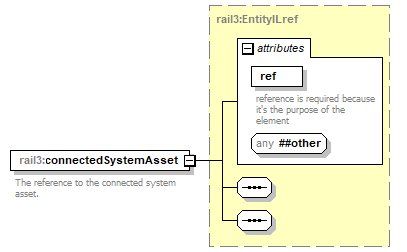 | ||||||||||||||
| namespace | https://www.railml.org/schemas/3.1 | ||||||||||||||
| type | rail3:EntityILref | ||||||||||||||
| properties |
| ||||||||||||||
| attributes |
| ||||||||||||||
| annotation |
| ||||||||||||||
| source | <xs:element name="connectedSystemAsset" type="rail3:EntityILref" minOccurs="1" maxOccurs="1"> <xs:annotation> <xs:documentation>The reference to the connected system asset.</xs:documentation> </xs:annotation> </xs:element> |
complexType tElementWithIDandDesignator
| diagram | 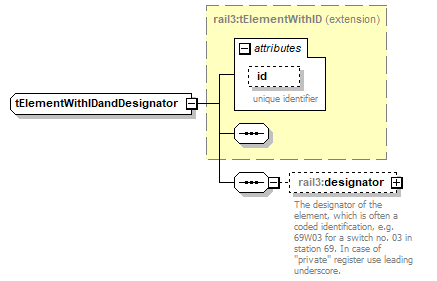 | ||||||||||||||
| namespace | https://www.railml.org/schemas/3.1 | ||||||||||||||
| type | extension of rail3:tElementWithID | ||||||||||||||
| properties |
| ||||||||||||||
| children | rail3:designator | ||||||||||||||
| used by |
| ||||||||||||||
| attributes |
| ||||||||||||||
| source | <xs:complexType name="tElementWithIDandDesignator"> <xs:complexContent> <xs:extension base="rail3:tElementWithID"> <xs:sequence> <xs:element name="designator" type="rail3:Designator" minOccurs="0" maxOccurs="1"> <xs:annotation> <xs:documentation>The designator of the element, which is often a coded identification, e.g. 69W03 for a switch no. 03 in station 69. In case of "private" register use leading underscore.</xs:documentation> </xs:annotation> </xs:element> </xs:sequence> </xs:extension> </xs:complexContent> </xs:complexType> |
element tElementWithIDandDesignator/designator
| diagram | 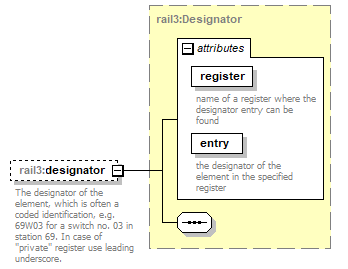 | ||||||||||||||||||||||
| namespace | https://www.railml.org/schemas/3.1 | ||||||||||||||||||||||
| type | rail3:Designator | ||||||||||||||||||||||
| properties |
| ||||||||||||||||||||||
| attributes |
| ||||||||||||||||||||||
| annotation |
| ||||||||||||||||||||||
| source | <xs:element name="designator" type="rail3:Designator" minOccurs="0" maxOccurs="1"> <xs:annotation> <xs:documentation>The designator of the element, which is often a coded identification, e.g. 69W03 for a switch no. 03 in station 69. In case of "private" register use leading underscore.</xs:documentation> </xs:annotation> </xs:element> |
complexType TrackAsset
| diagram | 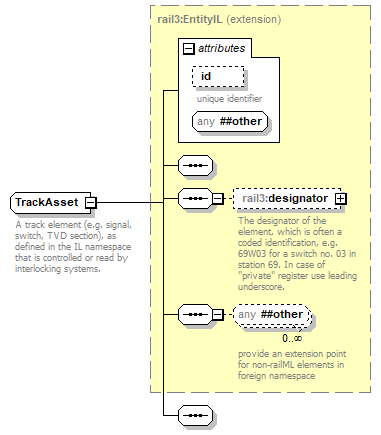 | ||||||||||||||
| namespace | https://www.railml.org/schemas/3.1 | ||||||||||||||
| type | extension of rail3:EntityIL | ||||||||||||||
| properties |
| ||||||||||||||
| children | rail3:designator | ||||||||||||||
| used by |
| ||||||||||||||
| attributes |
| ||||||||||||||
| annotation |
| ||||||||||||||
| source | <xs:complexType name="TrackAsset"> <xs:annotation> <xs:documentation>A track element (e.g. signal, switch, TVD section), as defined in the IL namespace that is controlled or read by interlocking systems.</xs:documentation> </xs:annotation> <xs:complexContent> <xs:extension base="rail3:EntityIL"> <xs:sequence/> </xs:extension> </xs:complexContent> </xs:complexType> |
complexType TrackAssetConnectedToIL
| diagram | 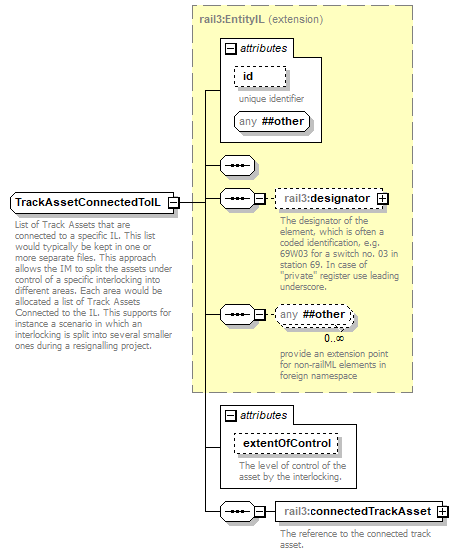 | ||||||||||||||||||||||
| namespace | https://www.railml.org/schemas/3.1 | ||||||||||||||||||||||
| type | extension of rail3:EntityIL | ||||||||||||||||||||||
| properties |
| ||||||||||||||||||||||
| children | rail3:designator rail3:connectedTrackAsset | ||||||||||||||||||||||
| used by |
| ||||||||||||||||||||||
| attributes |
| ||||||||||||||||||||||
| annotation |
| ||||||||||||||||||||||
| source | <xs:complexType name="TrackAssetConnectedToIL"> <xs:annotation> <xs:documentation>List of Track Assets that are connected to a specific IL. This list would typically be kept in one or more separate files. This approach allows the IM to split the assets under control of a specific interlocking into different areas. Each area would be allocated a list of Track Assets Connected to the IL. This supports for instance a scenario in which an interlocking is split into several smaller ones during a resignalling project.</xs:documentation> </xs:annotation> <xs:complexContent> <xs:extension base="rail3:EntityIL"> <xs:sequence> <xs:element name="connectedTrackAsset" type="rail3:EntityILref" minOccurs="1" maxOccurs="1"> <xs:annotation> <xs:documentation>The reference to the connected track asset.</xs:documentation> </xs:annotation> </xs:element> </xs:sequence> <xs:attribute name="extentOfControl" type="rail3:tExtentOfControl" use="optional"> <xs:annotation> <xs:documentation>The level of control of the asset by the interlocking.</xs:documentation> </xs:annotation> </xs:attribute> </xs:extension> </xs:complexContent> </xs:complexType> |
attribute TrackAssetConnectedToIL/@extentOfControl
| type | rail3:tExtentOfControl | |||||||||||||||
| properties |
| |||||||||||||||
| facets |
| |||||||||||||||
| annotation |
| |||||||||||||||
| source | <xs:attribute name="extentOfControl" type="rail3:tExtentOfControl" use="optional"> <xs:annotation> <xs:documentation>The level of control of the asset by the interlocking.</xs:documentation> </xs:annotation> </xs:attribute> |
element TrackAssetConnectedToIL/connectedTrackAsset
| diagram | 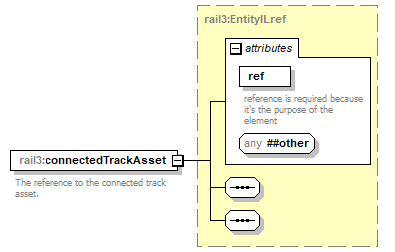 | ||||||||||||||
| namespace | https://www.railml.org/schemas/3.1 | ||||||||||||||
| type | rail3:EntityILref | ||||||||||||||
| properties |
| ||||||||||||||
| attributes |
| ||||||||||||||
| annotation |
| ||||||||||||||
| source | <xs:element name="connectedTrackAsset" type="rail3:EntityILref" minOccurs="1" maxOccurs="1"> <xs:annotation> <xs:documentation>The reference to the connected track asset.</xs:documentation> </xs:annotation> </xs:element> |
complexType TvdSection
| diagram | 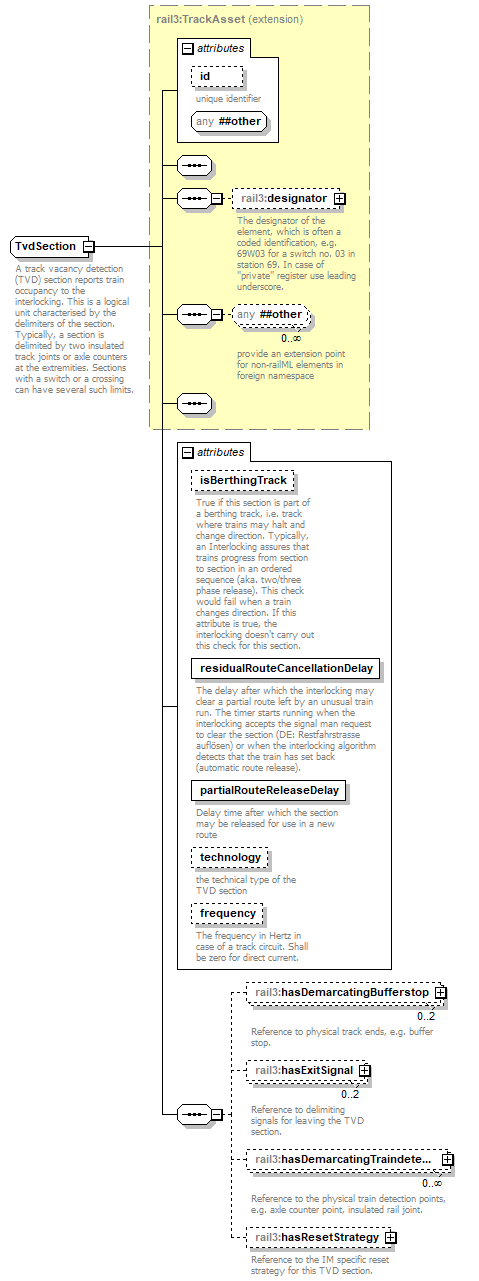 | ||||||||||||||||||||||||||||||||||||||||||||||||||||||
| namespace | https://www.railml.org/schemas/3.1 | ||||||||||||||||||||||||||||||||||||||||||||||||||||||
| type | extension of rail3:TrackAsset | ||||||||||||||||||||||||||||||||||||||||||||||||||||||
| properties |
| ||||||||||||||||||||||||||||||||||||||||||||||||||||||
| children | rail3:designator rail3:hasDemarcatingBufferstop rail3:hasExitSignal rail3:hasDemarcatingTraindetector rail3:hasResetStrategy | ||||||||||||||||||||||||||||||||||||||||||||||||||||||
| used by |
| ||||||||||||||||||||||||||||||||||||||||||||||||||||||
| attributes |
| ||||||||||||||||||||||||||||||||||||||||||||||||||||||
| annotation |
| ||||||||||||||||||||||||||||||||||||||||||||||||||||||
| source | <xs:complexType name="TvdSection"> <xs:annotation> <xs:documentation>A track vacancy detection (TVD) section reports train occupancy to the interlocking. This is a logical unit characterised by the delimiters of the section. Typically, a section is delimited by two insulated track joints or axle counters at the extremities. Sections with a switch or a crossing can have several such limits.</xs:documentation> </xs:annotation> <xs:complexContent> <xs:extension base="rail3:TrackAsset"> <xs:sequence> <xs:element name="hasDemarcatingBufferstop" type="rail3:EntityILref" minOccurs="0" maxOccurs="2"> <xs:annotation> <xs:documentation>Reference to physical track ends, e.g. buffer stop.</xs:documentation> </xs:annotation> </xs:element> <xs:element name="hasExitSignal" type="rail3:EntityILref" minOccurs="0" maxOccurs="2"> <xs:annotation> <xs:documentation>Reference to delimiting signals for leaving the TVD section.</xs:documentation> </xs:annotation> </xs:element> <xs:element name="hasDemarcatingTraindetector" type="rail3:EntityILref" minOccurs="0" maxOccurs="unbounded"> <xs:annotation> <xs:documentation>Reference to the physical train detection points, e.g. axle counter point, insulated rail joint.</xs:documentation> </xs:annotation> </xs:element> <xs:element name="hasResetStrategy" type="rail3:EntityILref" minOccurs="0" maxOccurs="1"> <xs:annotation> <xs:documentation>Reference to the IM specific reset strategy for this TVD section.</xs:documentation> </xs:annotation> </xs:element> </xs:sequence> <xs:attribute name="isBerthingTrack" type="xs:boolean" use="optional"> <xs:annotation> <xs:documentation>True if this section is part of a berthing track, i.e. track where trains may halt and change direction. Typically, an Interlocking assures that trains progress from section to section in an ordered sequence (aka. two/three phase release). This check would fail when a train changes direction. If this attribute is true, the interlocking doesn't carry out this check for this section.</xs:documentation> </xs:annotation> </xs:attribute> <xs:attribute name="residualRouteCancellationDelay" type="xs:duration" use="required"> <xs:annotation> <xs:documentation>The delay after which the interlocking may clear a partial route left by an unusual train run. The timer starts running when the interlocking accepts the signal man request to clear the section (DE: Restfahrstrasse auflösen) or when the interlocking algorithm detects that the train has set back (automatic route release).</xs:documentation> </xs:annotation> </xs:attribute> <xs:attribute name="partialRouteReleaseDelay" type="xs:duration" use="required"> <xs:annotation> <xs:documentation>Delay time after which the section may be released for use in a new route</xs:documentation> </xs:annotation> </xs:attribute> <xs:attribute name="technology" type="rail3:tTvdSectionTechnologyTypeExt" use="optional"> <xs:annotation> <xs:documentation>the technical type of the TVD section</xs:documentation> </xs:annotation> </xs:attribute> <xs:attribute name="frequency" type="rail3:tFrequencyHertz" use="optional"> <xs:annotation> <xs:documentation>The frequency in Hertz in case of a track circuit. Shall be zero for direct current.</xs:documentation> </xs:annotation> </xs:attribute> </xs:extension> </xs:complexContent> </xs:complexType> |
attribute TvdSection/@isBerthingTrack
| type | xs:boolean | ||
| properties |
| ||
| annotation |
| ||
| source | <xs:attribute name="isBerthingTrack" type="xs:boolean" use="optional"> <xs:annotation> <xs:documentation>True if this section is part of a berthing track, i.e. track where trains may halt and change direction. Typically, an Interlocking assures that trains progress from section to section in an ordered sequence (aka. two/three phase release). This check would fail when a train changes direction. If this attribute is true, the interlocking doesn't carry out this check for this section.</xs:documentation> </xs:annotation> </xs:attribute> |
attribute TvdSection/@residualRouteCancellationDelay
| type | xs:duration | ||
| properties |
| ||
| annotation |
| ||
| source | <xs:attribute name="residualRouteCancellationDelay" type="xs:duration" use="required"> <xs:annotation> <xs:documentation>The delay after which the interlocking may clear a partial route left by an unusual train run. The timer starts running when the interlocking accepts the signal man request to clear the section (DE: Restfahrstrasse auflösen) or when the interlocking algorithm detects that the train has set back (automatic route release).</xs:documentation> </xs:annotation> </xs:attribute> |
attribute TvdSection/@partialRouteReleaseDelay
| type | xs:duration | ||
| properties |
| ||
| annotation |
| ||
| source | <xs:attribute name="partialRouteReleaseDelay" type="xs:duration" use="required"> <xs:annotation> <xs:documentation>Delay time after which the section may be released for use in a new route</xs:documentation> </xs:annotation> </xs:attribute> |
attribute TvdSection/@technology
| type | rail3:tTvdSectionTechnologyTypeExt | ||
| properties |
| ||
| annotation |
| ||
| source | <xs:attribute name="technology" type="rail3:tTvdSectionTechnologyTypeExt" use="optional"> <xs:annotation> <xs:documentation>the technical type of the TVD section</xs:documentation> </xs:annotation> </xs:attribute> |
attribute TvdSection/@frequency
| type | rail3:tFrequencyHertz | |||||||||
| properties |
| |||||||||
| facets |
| |||||||||
| annotation |
| |||||||||
| source | <xs:attribute name="frequency" type="rail3:tFrequencyHertz" use="optional"> <xs:annotation> <xs:documentation>The frequency in Hertz in case of a track circuit. Shall be zero for direct current.</xs:documentation> </xs:annotation> </xs:attribute> |
element TvdSection/hasDemarcatingBufferstop
| diagram | 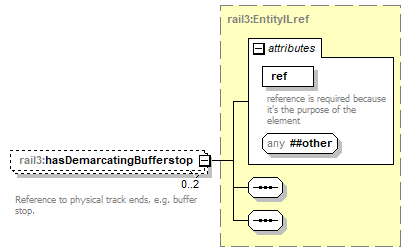 | ||||||||||||||
| namespace | https://www.railml.org/schemas/3.1 | ||||||||||||||
| type | rail3:EntityILref | ||||||||||||||
| properties |
| ||||||||||||||
| attributes |
| ||||||||||||||
| annotation |
| ||||||||||||||
| source | <xs:element name="hasDemarcatingBufferstop" type="rail3:EntityILref" minOccurs="0" maxOccurs="2"> <xs:annotation> <xs:documentation>Reference to physical track ends, e.g. buffer stop.</xs:documentation> </xs:annotation> </xs:element> |
element TvdSection/hasExitSignal
| diagram | 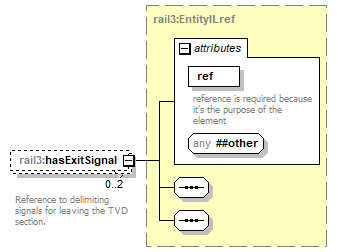 | ||||||||||||||
| namespace | https://www.railml.org/schemas/3.1 | ||||||||||||||
| type | rail3:EntityILref | ||||||||||||||
| properties |
| ||||||||||||||
| attributes |
| ||||||||||||||
| annotation |
| ||||||||||||||
| source | <xs:element name="hasExitSignal" type="rail3:EntityILref" minOccurs="0" maxOccurs="2"> <xs:annotation> <xs:documentation>Reference to delimiting signals for leaving the TVD section.</xs:documentation> </xs:annotation> </xs:element> |
element TvdSection/hasDemarcatingTraindetector
| diagram | 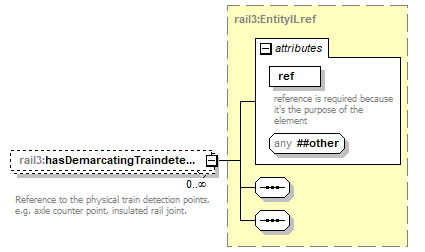 | ||||||||||||||
| namespace | https://www.railml.org/schemas/3.1 | ||||||||||||||
| type | rail3:EntityILref | ||||||||||||||
| properties |
| ||||||||||||||
| attributes |
| ||||||||||||||
| annotation |
| ||||||||||||||
| source | <xs:element name="hasDemarcatingTraindetector" type="rail3:EntityILref" minOccurs="0" maxOccurs="unbounded"> <xs:annotation> <xs:documentation>Reference to the physical train detection points, e.g. axle counter point, insulated rail joint.</xs:documentation> </xs:annotation> </xs:element> |
element TvdSection/hasResetStrategy
| diagram | 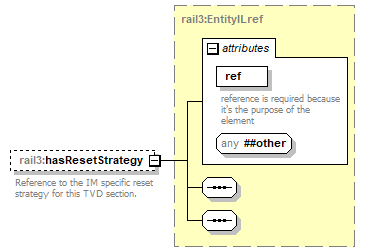 | ||||||||||||||
| namespace | https://www.railml.org/schemas/3.1 | ||||||||||||||
| type | rail3:EntityILref | ||||||||||||||
| properties |
| ||||||||||||||
| attributes |
| ||||||||||||||
| annotation |
| ||||||||||||||
| source | <xs:element name="hasResetStrategy" type="rail3:EntityILref" minOccurs="0" maxOccurs="1"> <xs:annotation> <xs:documentation>Reference to the IM specific reset strategy for this TVD section.</xs:documentation> </xs:annotation> </xs:element> |
complexType TvdSections
| diagram |  | ||
| namespace | https://www.railml.org/schemas/3.1 | ||
| children | rail3:tvdSection | ||
| used by |
| ||
| annotation |
| ||
| source | <xs:complexType name="TvdSections"> <xs:annotation> <xs:documentation>container element for all TvdSection elements</xs:documentation> </xs:annotation> <xs:sequence minOccurs="0" maxOccurs="1"> <xs:element name="tvdSection" type="rail3:TvdSection" minOccurs="1" maxOccurs="unbounded"> <xs:annotation> <xs:documentation>track vacancy detection (TVD) section reports train occupancy to the interlocking</xs:documentation> </xs:annotation> </xs:element> </xs:sequence> </xs:complexType> |
element TvdSections/tvdSection
| diagram | 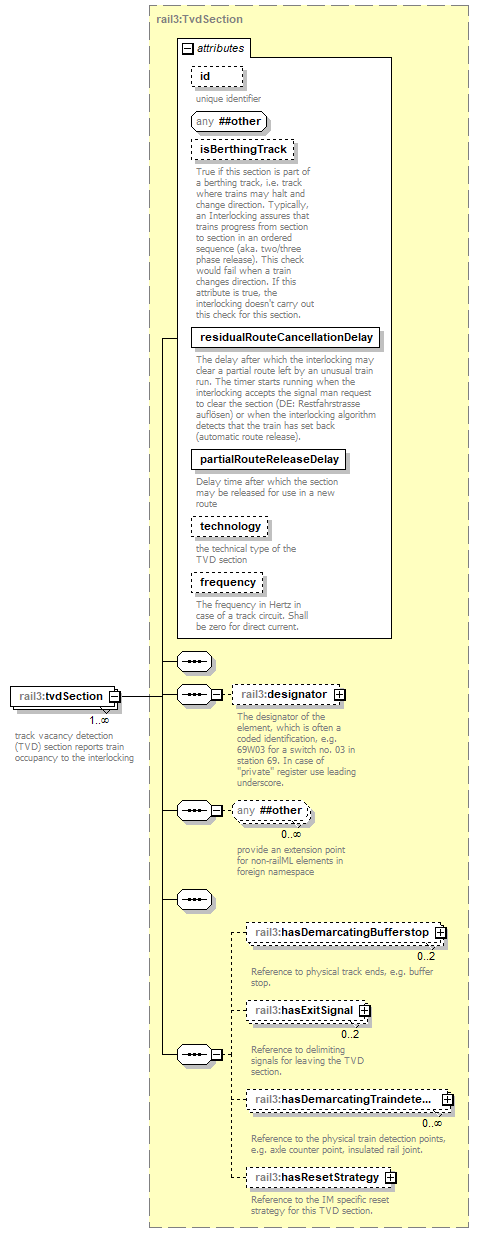 | ||||||||||||||||||||||||||||||||||||||||||||||||||||||
| namespace | https://www.railml.org/schemas/3.1 | ||||||||||||||||||||||||||||||||||||||||||||||||||||||
| type | rail3:TvdSection | ||||||||||||||||||||||||||||||||||||||||||||||||||||||
| properties |
| ||||||||||||||||||||||||||||||||||||||||||||||||||||||
| children | rail3:designator rail3:hasDemarcatingBufferstop rail3:hasExitSignal rail3:hasDemarcatingTraindetector rail3:hasResetStrategy | ||||||||||||||||||||||||||||||||||||||||||||||||||||||
| attributes |
| ||||||||||||||||||||||||||||||||||||||||||||||||||||||
| annotation |
| ||||||||||||||||||||||||||||||||||||||||||||||||||||||
| source | <xs:element name="tvdSection" type="rail3:TvdSection" minOccurs="1" maxOccurs="unbounded"> <xs:annotation> <xs:documentation>track vacancy detection (TVD) section reports train occupancy to the interlocking</xs:documentation> </xs:annotation> </xs:element> |
complexType WorkZone
| diagram | 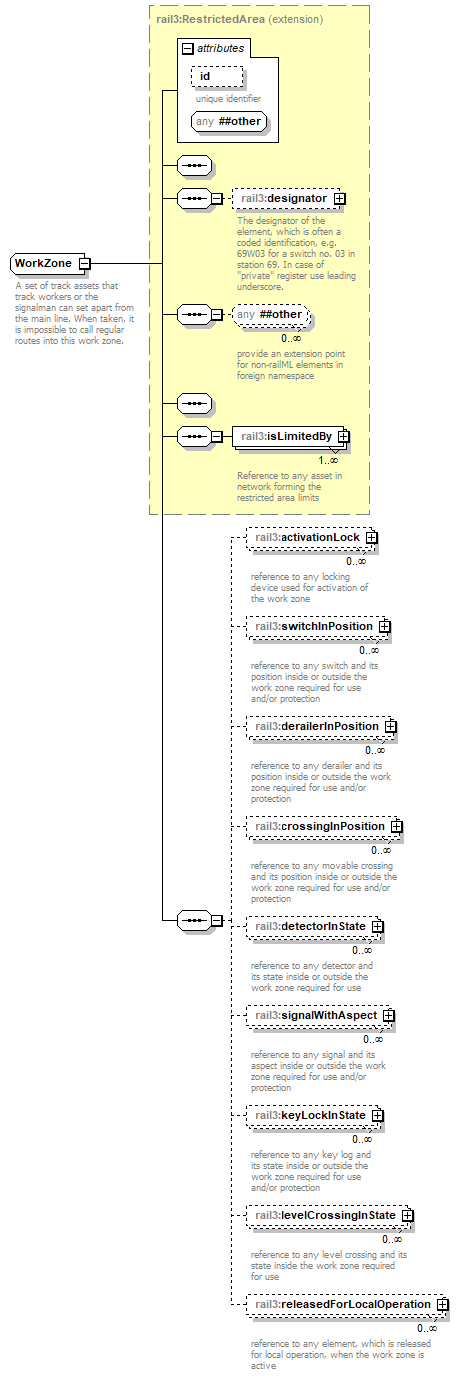 | ||||||||||||||
| namespace | https://www.railml.org/schemas/3.1 | ||||||||||||||
| type | extension of rail3:RestrictedArea | ||||||||||||||
| properties |
| ||||||||||||||
| children | rail3:designator rail3:isLimitedBy rail3:activationLock rail3:switchInPosition rail3:derailerInPosition rail3:crossingInPosition rail3:detectorInState rail3:signalWithAspect rail3:keyLockInState rail3:levelCrossingInState rail3:releasedForLocalOperation | ||||||||||||||
| used by |
| ||||||||||||||
| attributes |
| ||||||||||||||
| annotation |
| ||||||||||||||
| source | <xs:complexType name="WorkZone"> <xs:annotation> <xs:documentation>A set of track assets that track workers or the signalman can set apart from the main line. When taken, it is impossible to call regular routes into this work zone.</xs:documentation> </xs:annotation> <xs:complexContent> <xs:extension base="rail3:RestrictedArea"> <xs:sequence> <xs:element name="activationLock" type="rail3:EntityILref" minOccurs="0" maxOccurs="unbounded"> <xs:annotation> <xs:documentation>reference to any locking device used for activation of the work zone</xs:documentation> </xs:annotation> </xs:element> <xs:element name="switchInPosition" type="rail3:SwitchInPosition" minOccurs="0" maxOccurs="unbounded"> <xs:annotation> <xs:documentation>reference to any switch and its position inside or outside the work zone required for use and/or protection</xs:documentation> </xs:annotation> </xs:element> <xs:element name="derailerInPosition" type="rail3:DerailerInPosition" minOccurs="0" maxOccurs="unbounded"> <xs:annotation> <xs:documentation>reference to any derailer and its position inside or outside the work zone required for use and/or protection</xs:documentation> </xs:annotation> </xs:element> <xs:element name="crossingInPosition" type="rail3:CrossingInPosition" minOccurs="0" maxOccurs="unbounded"> <xs:annotation> <xs:documentation>reference to any movable crossing and its position inside or outside the work zone required for use and/or protection</xs:documentation> </xs:annotation> </xs:element> <xs:element name="detectorInState" type="rail3:DetectorInState" minOccurs="0" maxOccurs="unbounded"> <xs:annotation> <xs:documentation>reference to any detector and its state inside or outside the work zone required for use</xs:documentation> </xs:annotation> </xs:element> <xs:element name="signalWithAspect" type="rail3:SignalWithAspect" minOccurs="0" maxOccurs="unbounded"> <xs:annotation> <xs:documentation>reference to any signal and its aspect inside or outside the work zone required for use and/or protection</xs:documentation> </xs:annotation> </xs:element> <xs:element name="keyLockInState" type="rail3:KeyLockInState" minOccurs="0" maxOccurs="unbounded"> <xs:annotation> <xs:documentation>reference to any key log and its state inside or outside the work zone required for use and/or protection</xs:documentation> </xs:annotation> </xs:element> <xs:element name="levelCrossingInState" type="rail3:LevelCrossingInState" minOccurs="0" maxOccurs="unbounded"> <xs:annotation> <xs:documentation>reference to any level crossing and its state inside the work zone required for use</xs:documentation> </xs:annotation> </xs:element> <xs:element name="releasedForLocalOperation" type="rail3:EntityILref" minOccurs="0" maxOccurs="unbounded"> <xs:annotation> <xs:documentation>reference to any element, which is released for local operation, when the work zone is active</xs:documentation> </xs:annotation> </xs:element> </xs:sequence> </xs:extension> </xs:complexContent> </xs:complexType> |
element WorkZone/activationLock
| diagram | 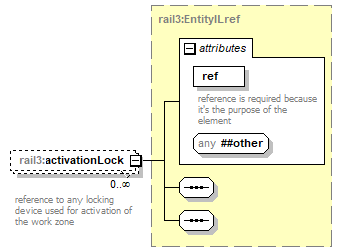 | ||||||||||||||
| namespace | https://www.railml.org/schemas/3.1 | ||||||||||||||
| type | rail3:EntityILref | ||||||||||||||
| properties |
| ||||||||||||||
| attributes |
| ||||||||||||||
| annotation |
| ||||||||||||||
| source | <xs:element name="activationLock" type="rail3:EntityILref" minOccurs="0" maxOccurs="unbounded"> <xs:annotation> <xs:documentation>reference to any locking device used for activation of the work zone</xs:documentation> </xs:annotation> </xs:element> |
element WorkZone/switchInPosition
| diagram | 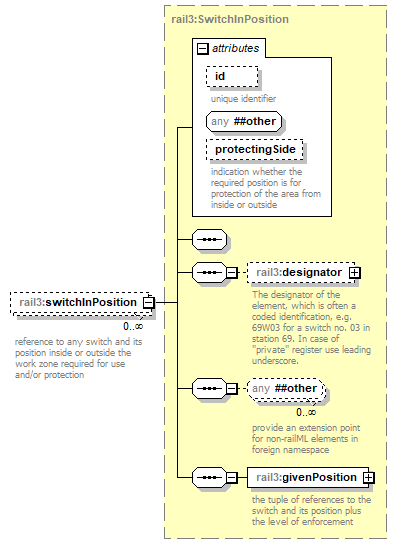 | ||||||||||||||||||||||
| namespace | https://www.railml.org/schemas/3.1 | ||||||||||||||||||||||
| type | rail3:SwitchInPosition | ||||||||||||||||||||||
| properties |
| ||||||||||||||||||||||
| children | rail3:designator rail3:givenPosition | ||||||||||||||||||||||
| attributes |
| ||||||||||||||||||||||
| annotation |
| ||||||||||||||||||||||
| source | <xs:element name="switchInPosition" type="rail3:SwitchInPosition" minOccurs="0" maxOccurs="unbounded"> <xs:annotation> <xs:documentation>reference to any switch and its position inside or outside the work zone required for use and/or protection</xs:documentation> </xs:annotation> </xs:element> |
element WorkZone/derailerInPosition
| diagram | 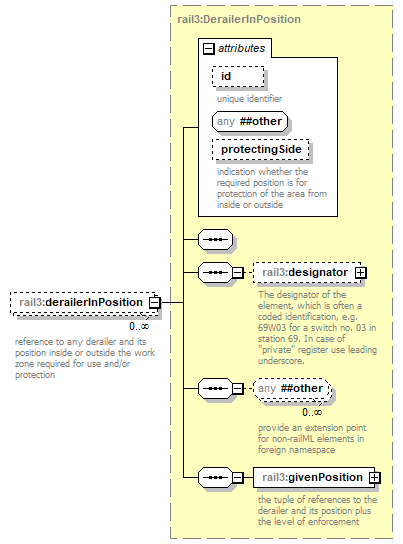 | ||||||||||||||||||||||
| namespace | https://www.railml.org/schemas/3.1 | ||||||||||||||||||||||
| type | rail3:DerailerInPosition | ||||||||||||||||||||||
| properties |
| ||||||||||||||||||||||
| children | rail3:designator rail3:givenPosition | ||||||||||||||||||||||
| attributes |
| ||||||||||||||||||||||
| annotation |
| ||||||||||||||||||||||
| source | <xs:element name="derailerInPosition" type="rail3:DerailerInPosition" minOccurs="0" maxOccurs="unbounded"> <xs:annotation> <xs:documentation>reference to any derailer and its position inside or outside the work zone required for use and/or protection</xs:documentation> </xs:annotation> </xs:element> |
element WorkZone/crossingInPosition
| diagram | 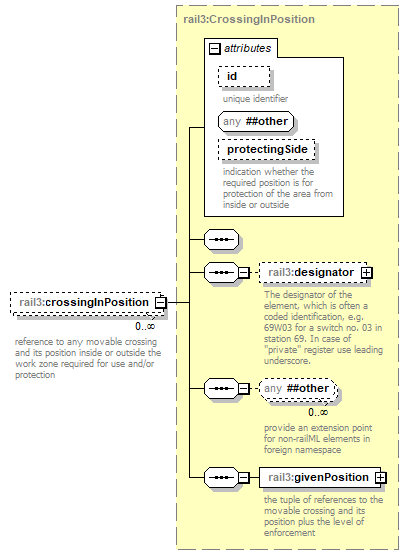 | ||||||||||||||||||||||
| namespace | https://www.railml.org/schemas/3.1 | ||||||||||||||||||||||
| type | rail3:CrossingInPosition | ||||||||||||||||||||||
| properties |
| ||||||||||||||||||||||
| children | rail3:designator rail3:givenPosition | ||||||||||||||||||||||
| attributes |
| ||||||||||||||||||||||
| annotation |
| ||||||||||||||||||||||
| source | <xs:element name="crossingInPosition" type="rail3:CrossingInPosition" minOccurs="0" maxOccurs="unbounded"> <xs:annotation> <xs:documentation>reference to any movable crossing and its position inside or outside the work zone required for use and/or protection</xs:documentation> </xs:annotation> </xs:element> |
element WorkZone/detectorInState
| diagram | 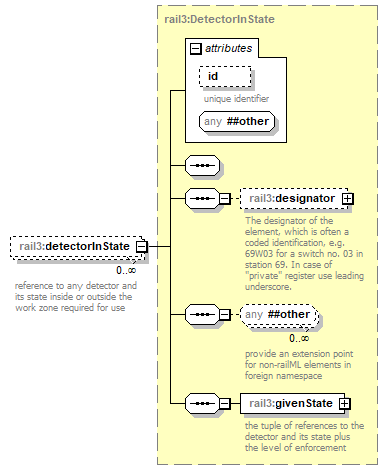 | ||||||||||||||
| namespace | https://www.railml.org/schemas/3.1 | ||||||||||||||
| type | rail3:DetectorInState | ||||||||||||||
| properties |
| ||||||||||||||
| children | rail3:designator rail3:givenState | ||||||||||||||
| attributes |
| ||||||||||||||
| annotation |
| ||||||||||||||
| source | <xs:element name="detectorInState" type="rail3:DetectorInState" minOccurs="0" maxOccurs="unbounded"> <xs:annotation> <xs:documentation>reference to any detector and its state inside or outside the work zone required for use</xs:documentation> </xs:annotation> </xs:element> |
element WorkZone/signalWithAspect
| diagram | 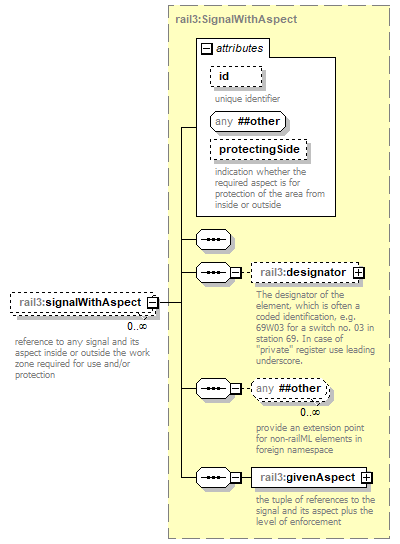 | ||||||||||||||||||||||
| namespace | https://www.railml.org/schemas/3.1 | ||||||||||||||||||||||
| type | rail3:SignalWithAspect | ||||||||||||||||||||||
| properties |
| ||||||||||||||||||||||
| children | rail3:designator rail3:givenAspect | ||||||||||||||||||||||
| attributes |
| ||||||||||||||||||||||
| annotation |
| ||||||||||||||||||||||
| source | <xs:element name="signalWithAspect" type="rail3:SignalWithAspect" minOccurs="0" maxOccurs="unbounded"> <xs:annotation> <xs:documentation>reference to any signal and its aspect inside or outside the work zone required for use and/or protection</xs:documentation> </xs:annotation> </xs:element> |
element WorkZone/keyLockInState
| diagram | 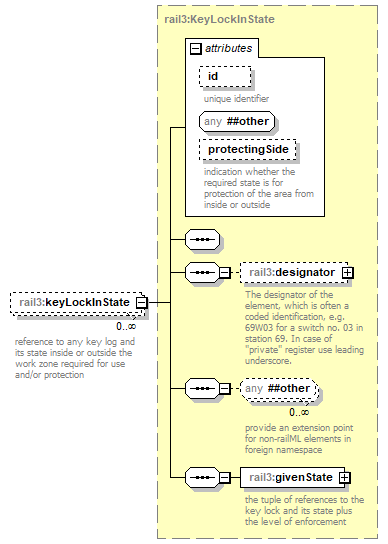 | ||||||||||||||||||||||
| namespace | https://www.railml.org/schemas/3.1 | ||||||||||||||||||||||
| type | rail3:KeyLockInState | ||||||||||||||||||||||
| properties |
| ||||||||||||||||||||||
| children | rail3:designator rail3:givenState | ||||||||||||||||||||||
| attributes |
| ||||||||||||||||||||||
| annotation |
| ||||||||||||||||||||||
| source | <xs:element name="keyLockInState" type="rail3:KeyLockInState" minOccurs="0" maxOccurs="unbounded"> <xs:annotation> <xs:documentation>reference to any key log and its state inside or outside the work zone required for use and/or protection</xs:documentation> </xs:annotation> </xs:element> |
element WorkZone/levelCrossingInState
| diagram | 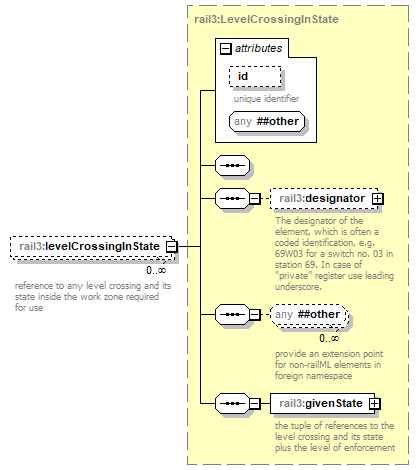 | ||||||||||||||
| namespace | https://www.railml.org/schemas/3.1 | ||||||||||||||
| type | rail3:LevelCrossingInState | ||||||||||||||
| properties |
| ||||||||||||||
| children | rail3:designator rail3:givenState | ||||||||||||||
| attributes |
| ||||||||||||||
| annotation |
| ||||||||||||||
| source | <xs:element name="levelCrossingInState" type="rail3:LevelCrossingInState" minOccurs="0" maxOccurs="unbounded"> <xs:annotation> <xs:documentation>reference to any level crossing and its state inside the work zone required for use</xs:documentation> </xs:annotation> </xs:element> |
element WorkZone/releasedForLocalOperation
| diagram | 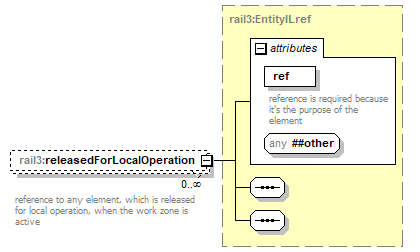 | ||||||||||||||
| namespace | https://www.railml.org/schemas/3.1 | ||||||||||||||
| type | rail3:EntityILref | ||||||||||||||
| properties |
| ||||||||||||||
| attributes |
| ||||||||||||||
| annotation |
| ||||||||||||||
| source | <xs:element name="releasedForLocalOperation" type="rail3:EntityILref" minOccurs="0" maxOccurs="unbounded"> <xs:annotation> <xs:documentation>reference to any element, which is released for local operation, when the work zone is active</xs:documentation> </xs:annotation> </xs:element> |
complexType WorkZones
| diagram |  | ||
| namespace | https://www.railml.org/schemas/3.1 | ||
| children | rail3:workZone | ||
| used by |
| ||
| source | <xs:complexType name="WorkZones"> <xs:sequence> <xs:element name="workZone" type="rail3:WorkZone" minOccurs="1" maxOccurs="unbounded"> <xs:annotation> <xs:documentation>A set of track assets that track workers or the signalman can set apart from the main line.</xs:documentation> </xs:annotation> </xs:element> </xs:sequence> </xs:complexType> |
element WorkZones/workZone
| diagram | 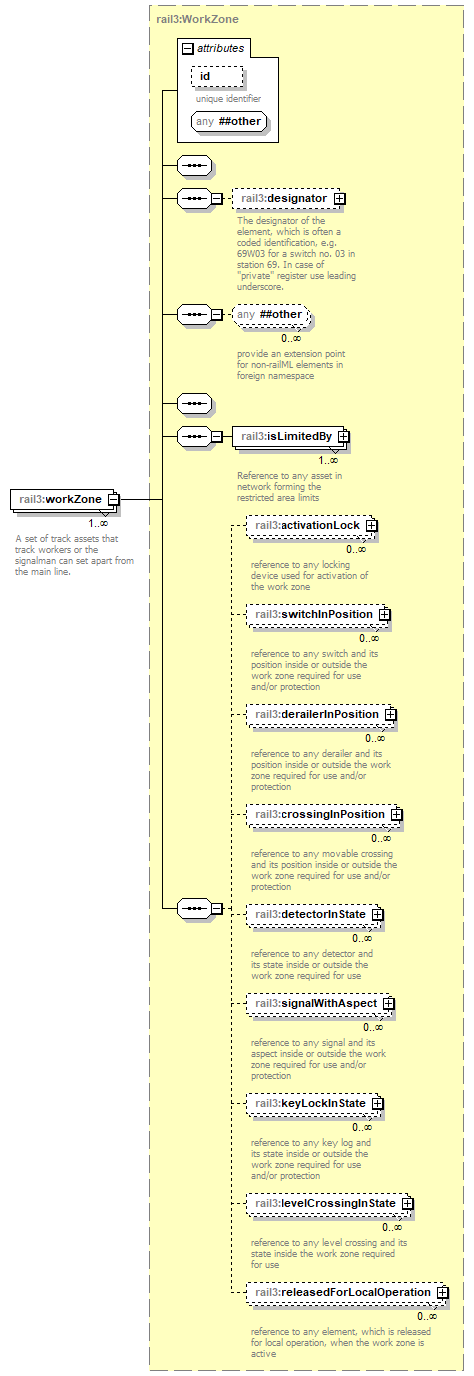 | ||||||||||||||
| namespace | https://www.railml.org/schemas/3.1 | ||||||||||||||
| type | rail3:WorkZone | ||||||||||||||
| properties |
| ||||||||||||||
| children | rail3:designator rail3:isLimitedBy rail3:activationLock rail3:switchInPosition rail3:derailerInPosition rail3:crossingInPosition rail3:detectorInState rail3:signalWithAspect rail3:keyLockInState rail3:levelCrossingInState rail3:releasedForLocalOperation | ||||||||||||||
| attributes |
| ||||||||||||||
| annotation |
| ||||||||||||||
| source | <xs:element name="workZone" type="rail3:WorkZone" minOccurs="1" maxOccurs="unbounded"> <xs:annotation> <xs:documentation>A set of track assets that track workers or the signalman can set apart from the main line.</xs:documentation> </xs:annotation> </xs:element> |
simpleType tAndOr
| namespace | https://www.railml.org/schemas/3.1 | ||||||||||||
| type | restriction of xs:string | ||||||||||||
| properties |
| ||||||||||||
| used by |
| ||||||||||||
| facets |
| ||||||||||||
| annotation |
| ||||||||||||
| source | <xs:simpleType name="tAndOr"> <xs:annotation> <xs:documentation>List of boolean operators for use in constructing boolean conditions. Used for concatenating boolean conditions by means of AND/OR. </xs:documentation> </xs:annotation> <xs:restriction base="xs:string"> <xs:enumeration value="XOR"/> <xs:enumeration value="OR"/> <xs:enumeration value="AND"/> </xs:restriction> </xs:simpleType> |
simpleType tBitPatternAny
| namespace | https://www.railml.org/schemas/3.1 | |||||||||
| type | restriction of xs:string | |||||||||
| properties |
| |||||||||
| used by |
| |||||||||
| facets |
| |||||||||
| annotation |
| |||||||||
| source | <xs:simpleType name="tBitPatternAny"> <xs:annotation> <xs:documentation>string made of "0", "1" or "x" to describe a bit pattern</xs:documentation> </xs:annotation> <xs:restriction base="xs:string"> <xs:minLength value="1"/> <xs:pattern value="[0-1x]*"/> </xs:restriction> </xs:simpleType> |
simpleType tContactState
| namespace | https://www.railml.org/schemas/3.1 | |||||||||
| type | restriction of xs:string | |||||||||
| properties |
| |||||||||
| used by |
| |||||||||
| facets |
| |||||||||
| annotation |
| |||||||||
| source | <xs:simpleType name="tContactState"> <xs:annotation> <xs:documentation>possible states of a contact, bit or command</xs:documentation> </xs:annotation> <xs:restriction base="xs:string"> <xs:enumeration value="closed"/> <xs:enumeration value="open"/> </xs:restriction> </xs:simpleType> |
simpleType tCrossingPosition
| namespace | https://www.railml.org/schemas/3.1 | |||||||||
| type | restriction of xs:string | |||||||||
| properties |
| |||||||||
| used by |
| |||||||||
| facets |
| |||||||||
| annotation |
| |||||||||
| source | <xs:simpleType name="tCrossingPosition"> <xs:annotation> <xs:documentation>typical positions of crossings</xs:documentation> </xs:annotation> <xs:restriction base="xs:string"> <xs:enumeration value="upleft-rightdown"/> <xs:enumeration value="downleft-rightup"/> </xs:restriction> </xs:simpleType> |
simpleType tDerailingPosition
| namespace | https://www.railml.org/schemas/3.1 | |||||||||
| type | restriction of xs:string | |||||||||
| properties |
| |||||||||
| used by |
| |||||||||
| facets |
| |||||||||
| annotation |
| |||||||||
| source | <xs:simpleType name="tDerailingPosition"> <xs:annotation> <xs:documentation>typical positions of a derailing device</xs:documentation> </xs:annotation> <xs:restriction base="xs:string"> <xs:enumeration value="passablePosition"/> <xs:enumeration value="derailingPosition"/> </xs:restriction> </xs:simpleType> |
simpleType tDetectorStates
| namespace | https://www.railml.org/schemas/3.1 | ||||||||||||
| type | restriction of xs:string | ||||||||||||
| properties |
| ||||||||||||
| used by |
| ||||||||||||
| facets |
| ||||||||||||
| annotation |
| ||||||||||||
| source | <xs:simpleType name="tDetectorStates"> <xs:annotation> <xs:documentation>The list of possible detector states.</xs:documentation> </xs:annotation> <xs:restriction base="xs:string"> <xs:enumeration value="inactive"/> <xs:enumeration value="deactivated"/> <xs:enumeration value="activated"/> </xs:restriction> </xs:simpleType> |
simpleType tDetectorTypeList
| namespace | https://www.railml.org/schemas/3.1 | |||||||||||||||||||||||||||||||||||||||
| type | restriction of xs:string | |||||||||||||||||||||||||||||||||||||||
| properties |
| |||||||||||||||||||||||||||||||||||||||
| used by |
| |||||||||||||||||||||||||||||||||||||||
| facets |
| |||||||||||||||||||||||||||||||||||||||
| annotation |
| |||||||||||||||||||||||||||||||||||||||
| source | <xs:simpleType name="tDetectorTypeList"> <xs:annotation> <xs:documentation>The list of possible detector types.</xs:documentation> </xs:annotation> <xs:restriction base="xs:string"> <xs:enumeration value="weighing"/> <xs:enumeration value="loadingGauge"/> <xs:enumeration value="landSlide"/> <xs:enumeration value="intrusion"/> <xs:enumeration value="hotWheelBox"/> <xs:enumeration value="gas"/> <xs:enumeration value="flatWheel"/> <xs:enumeration value="fire"/> <xs:enumeration value="doors"/> <xs:enumeration value="derailment"/> <xs:enumeration value="cranks"/> <xs:enumeration value="avalanche"/> </xs:restriction> </xs:simpleType> |
simpleType tDetectorTypeListExt
| namespace | https://www.railml.org/schemas/3.1 | ||
| type | union of (rail3:tDetectorTypeList, rail3:tOtherEnumerationValue) | ||
| used by |
| ||
| annotation |
| ||
| source | <xs:simpleType name="tDetectorTypeListExt"> <xs:annotation> <xs:documentation>The possible list of detector base types with extension point.</xs:documentation> </xs:annotation> <xs:union memberTypes="rail3:tDetectorTypeList rail3:tOtherEnumerationValue"/> </xs:simpleType> |
simpleType tExtentOfControl
| namespace | https://www.railml.org/schemas/3.1 | |||||||||||||||
| type | restriction of xs:string | |||||||||||||||
| properties |
| |||||||||||||||
| used by |
| |||||||||||||||
| facets |
| |||||||||||||||
| annotation |
| |||||||||||||||
| source | <xs:simpleType name="tExtentOfControl"> <xs:annotation> <xs:documentation>The Extent of Control is one of full control, steering only, notification only or none. Full control implies that the IL controls the element AND reads the element feedback to check the execution of the control. Notification only means that the IL only reads the status of the object in terms of switch position left, controlled or boolean 1 or derailer engaged. Steering only means that the IL emits the control signal without checking for feedback. Note that LoC=none suggests that the IL has no relation at all with the track asset, indicating a modelling error that merits further investigation and/or explanation.</xs:documentation> </xs:annotation> <xs:restriction base="xs:string"> <xs:enumeration value="steeringOnly"/> <xs:enumeration value="none"/> <xs:enumeration value="notificationOnly"/> <xs:enumeration value="fullControl"/> </xs:restriction> </xs:simpleType> |
simpleType tGenericAspectList
| namespace | https://www.railml.org/schemas/3.1 | |||||||||||||||||||||||||||||||||
| type | restriction of xs:string | |||||||||||||||||||||||||||||||||
| properties |
| |||||||||||||||||||||||||||||||||
| used by |
| |||||||||||||||||||||||||||||||||
| facets |
| |||||||||||||||||||||||||||||||||
| annotation |
| |||||||||||||||||||||||||||||||||
| source | <xs:simpleType name="tGenericAspectList"> <xs:annotation> <xs:documentation>list of possible generic signal aspects (generic meaning)</xs:documentation> </xs:annotation> <xs:restriction base="xs:string"> <xs:enumeration value="warning"/> <xs:enumeration value="supplementary"/> <xs:enumeration value="restriction"/> <xs:enumeration value="proceed"/> <xs:enumeration value="limitedProceed"/> <xs:enumeration value="informative"/> <xs:enumeration value="combinedProceed"/> <xs:enumeration value="closed"/> <xs:enumeration value="caution"/> <xs:enumeration value="callOn"/> </xs:restriction> </xs:simpleType> |
simpleType tGenericResetStrategyList
| namespace | https://www.railml.org/schemas/3.1 | ||||||||||||||||||
| type | restriction of xs:string | ||||||||||||||||||
| properties |
| ||||||||||||||||||
| used by |
| ||||||||||||||||||
| facets |
| ||||||||||||||||||
| annotation |
| ||||||||||||||||||
| source | <xs:simpleType name="tGenericResetStrategyList"> <xs:annotation> <xs:documentation>list of generic strategies for resetting a TVD section</xs:documentation> </xs:annotation> <xs:restriction base="xs:string"> <xs:enumeration value="unconditionalReset"/> <xs:enumeration value="sweepRunWithoutConfirmation"/> <xs:enumeration value="sweepRunWithConfirmation"/> <xs:enumeration value="procedure"/> <xs:enumeration value="conditionalReset"/> </xs:restriction> </xs:simpleType> |
simpleType tGenericRouteTypeExt
| namespace | https://www.railml.org/schemas/3.1 | ||
| type | union of (rail3:tGenericRouteTypeList, rail3:tOtherEnumerationValue) | ||
| used by |
| ||
| annotation |
| ||
| source | <xs:simpleType name="tGenericRouteTypeExt"> <xs:annotation> <xs:documentation>The list of possible route types with extension point.</xs:documentation> </xs:annotation> <xs:union memberTypes="rail3:tGenericRouteTypeList rail3:tOtherEnumerationValue"/> </xs:simpleType> |
simpleType tGenericRouteTypeList
| namespace | https://www.railml.org/schemas/3.1 | ||||||||||||||||||||||||
| type | restriction of xs:string | ||||||||||||||||||||||||
| properties |
| ||||||||||||||||||||||||
| used by |
| ||||||||||||||||||||||||
| facets |
| ||||||||||||||||||||||||
| annotation |
| ||||||||||||||||||||||||
| source | <xs:simpleType name="tGenericRouteTypeList"> <xs:annotation> <xs:documentation>list of possible generic route types</xs:documentation> </xs:annotation> <xs:restriction base="xs:string"> <xs:enumeration value="tunnel"/> <xs:enumeration value="siding"/> <xs:enumeration value="shunting"/> <xs:enumeration value="occupied"/> <xs:enumeration value="normal"/> <xs:enumeration value="nonElectrified"/> <xs:enumeration value="callOn"/> </xs:restriction> </xs:simpleType> |
simpleType tGroupingTypes
| namespace | https://www.railml.org/schemas/3.1 | |||||||||||||||||||||||||||
| type | restriction of xs:string | |||||||||||||||||||||||||||
| properties |
| |||||||||||||||||||||||||||
| used by |
| |||||||||||||||||||||||||||
| facets |
| |||||||||||||||||||||||||||
| annotation |
| |||||||||||||||||||||||||||
| source | <xs:simpleType name="tGroupingTypes"> <xs:annotation> <xs:documentation>list of possible generic element groups</xs:documentation> </xs:annotation> <xs:restriction base="xs:string"> <xs:enumeration value="catenary"/> <xs:enumeration value="elementBlocking"/> <xs:enumeration value="automaticRouteSetting"/> <xs:enumeration value="automaticTrainRouting"/> <xs:enumeration value="callOn"/> <xs:enumeration value="emergencyStop"/> <xs:enumeration value="pointStaggering"/> <xs:enumeration value="pointHeating"/> </xs:restriction> </xs:simpleType> |
simpleType tGroupingTypesExt
| namespace | https://www.railml.org/schemas/3.1 | ||
| type | union of (rail3:tGroupingTypes, rail3:tOtherEnumerationValue) | ||
| used by |
| ||
| annotation |
| ||
| source | <xs:simpleType name="tGroupingTypesExt"> <xs:annotation> <xs:documentation>The list of possible element group types with extension point.</xs:documentation> </xs:annotation> <xs:union memberTypes="rail3:tGroupingTypes rail3:tOtherEnumerationValue"/> </xs:simpleType> |
simpleType tIxlInterfaceLocationTypeList
| namespace | https://www.railml.org/schemas/3.1 | ||||||||||||
| type | restriction of xs:string | ||||||||||||
| properties |
| ||||||||||||
| used by |
| ||||||||||||
| facets |
| ||||||||||||
| source | <xs:simpleType name="tIxlInterfaceLocationTypeList"> <xs:restriction base="xs:string"> <xs:enumeration value="atStationBorder"/> <xs:enumeration value="onOpenLine"/> <xs:enumeration value="inStation"/> </xs:restriction> </xs:simpleType> |
simpleType tIxlTechnologyTypeList
| namespace | https://www.railml.org/schemas/3.1 | |||||||||||||||||||||
| type | restriction of xs:string | |||||||||||||||||||||
| properties |
| |||||||||||||||||||||
| used by |
| |||||||||||||||||||||
| facets |
| |||||||||||||||||||||
| source | <xs:simpleType name="tIxlTechnologyTypeList"> <xs:restriction base="xs:string"> <xs:enumeration value="digital"/> <xs:enumeration value="electronic"/> <xs:enumeration value="relay"/> <xs:enumeration value="electromechanical"/> <xs:enumeration value="mechanical"/> <xs:enumeration value="manual"/> </xs:restriction> </xs:simpleType> |
simpleType tIxlTechnologyTypeListExt
| namespace | https://www.railml.org/schemas/3.1 | ||
| type | union of (rail3:tIxlTechnologyTypeList, rail3:tOtherEnumerationValue) | ||
| used by |
| ||
| annotation |
| ||
| source | <xs:simpleType name="tIxlTechnologyTypeListExt"> <xs:annotation> <xs:documentation>The list of possible interlocking technologies with extension point.</xs:documentation> </xs:annotation> <xs:union memberTypes="rail3:tIxlTechnologyTypeList rail3:tOtherEnumerationValue"/> </xs:simpleType> |
simpleType tLevelCrossingControlTypes
| namespace | https://www.railml.org/schemas/3.1 | ||||||||||||
| type | restriction of xs:string | ||||||||||||
| properties |
| ||||||||||||
| used by |
| ||||||||||||
| facets |
| ||||||||||||
| annotation |
| ||||||||||||
| source | <xs:simpleType name="tLevelCrossingControlTypes"> <xs:annotation> <xs:documentation>list of possible types for controlling a level crossing w.r.t. interlocking operation</xs:documentation> </xs:annotation> <xs:restriction base="xs:string"> <xs:enumeration value="autonomous"/> <xs:enumeration value="fullControlled"/> <xs:enumeration value="halfControlled"/> </xs:restriction> </xs:simpleType> |
simpleType tLevelCrossingState
| namespace | https://www.railml.org/schemas/3.1 | ||||||||||||||||||
| type | restriction of xs:string | ||||||||||||||||||
| properties |
| ||||||||||||||||||
| used by |
| ||||||||||||||||||
| facets |
| ||||||||||||||||||
| annotation |
| ||||||||||||||||||
| source | <xs:simpleType name="tLevelCrossingState"> <xs:annotation> <xs:documentation>typical states of level crossings</xs:documentation> </xs:annotation> <xs:restriction base="xs:string"> <xs:enumeration value="unknown"/> <xs:enumeration value="closing"/> <xs:enumeration value="opening"/> <xs:enumeration value="closed"/> <xs:enumeration value="open"/> </xs:restriction> </xs:simpleType> |
simpleType tLockState
| namespace | https://www.railml.org/schemas/3.1 | |||||||||
| type | restriction of xs:string | |||||||||
| properties |
| |||||||||
| used by |
| |||||||||
| facets |
| |||||||||
| annotation |
| |||||||||
| source | <xs:simpleType name="tLockState"> <xs:annotation> <xs:documentation>typical states of locking instruments (Masterlock, KeyReleaseInstrument)</xs:documentation> </xs:annotation> <xs:restriction base="xs:string"> <xs:enumeration value="released"/> <xs:enumeration value="locked"/> </xs:restriction> </xs:simpleType> |
simpleType tMustOrShould
| namespace | https://www.railml.org/schemas/3.1 | ||||||||||||
| type | restriction of xs:string | ||||||||||||
| properties |
| ||||||||||||
| used by |
| ||||||||||||
| facets |
| ||||||||||||
| annotation |
| ||||||||||||
| source | <xs:simpleType name="tMustOrShould"> <xs:annotation> <xs:documentation>Use this to distinguish hard or soft required states. E.g a called-for switch should be in the given position whilst a flank protection switch must be in the given position. The interlocking normally controls an element into a required position. The enforce-policy expresses what the interlocking must do with the element. enforce=must means that the condition is fulfilled only when the element acquires the given status, enforce=should means that this given status is the preferred status but no conditio sine qua non, finally enforce=none means that the interlocking is not given a desired status; in other words the IL can ignore the given status.</xs:documentation> </xs:annotation> <xs:restriction base="xs:string"> <xs:enumeration value="none"/> <xs:enumeration value="should"/> <xs:enumeration value="must"/> </xs:restriction> </xs:simpleType> |
simpleType tOverlapReleaseCondition
| namespace | https://www.railml.org/schemas/3.1 | ||||||||||||
| type | restriction of xs:string | ||||||||||||
| properties |
| ||||||||||||
| used by |
| ||||||||||||
| facets |
| ||||||||||||
| source | <xs:simpleType name="tOverlapReleaseCondition"> <xs:restriction base="xs:string"> <xs:enumeration value="trainInitiatedTrigger"/> <xs:enumeration value="startTimerAfterVacating"/> <xs:enumeration value="startTimerUponOccupation"/> </xs:restriction> </xs:simpleType> |
simpleType tProtectingSideList
| namespace | https://www.railml.org/schemas/3.1 | ||||||||||||
| type | restriction of xs:string | ||||||||||||
| properties |
| ||||||||||||
| used by |
| ||||||||||||
| facets |
| ||||||||||||
| annotation |
| ||||||||||||
| source | <xs:simpleType name="tProtectingSideList"> <xs:annotation> <xs:documentation>list of protection positions related to the area</xs:documentation> </xs:annotation> <xs:restriction base="xs:string"> <xs:enumeration value="none"/> <xs:enumeration value="outside"/> <xs:enumeration value="inside"/> </xs:restriction> </xs:simpleType> |
simpleType tProving
| namespace | https://www.railml.org/schemas/3.1 | ||||||||||||
| type | restriction of xs:string | ||||||||||||
| properties |
| ||||||||||||
| used by |
| ||||||||||||
| facets |
| ||||||||||||
| annotation |
| ||||||||||||
| source | <xs:simpleType name="tProving"> <xs:annotation> <xs:documentation>The list of proving ways.</xs:documentation> </xs:annotation> <xs:restriction base="xs:string"> <xs:enumeration value="staffAcknowledged"/> <xs:enumeration value="continuously"/> <xs:enumeration value="oneOff"/> </xs:restriction> </xs:simpleType> |
simpleType tRouteConflictTypes
| namespace | https://www.railml.org/schemas/3.1 | ||||||||||||||||||
| type | restriction of xs:string | ||||||||||||||||||
| properties |
| ||||||||||||||||||
| used by |
| ||||||||||||||||||
| facets |
| ||||||||||||||||||
| source | <xs:simpleType name="tRouteConflictTypes"> <xs:restriction base="xs:string"> <xs:enumeration value="overlappingTVDsection"/> <xs:enumeration value="conflictingSwitchPosition"/> <xs:enumeration value="conflictingStatus"/> <xs:enumeration value="conflictingOverlap"/> <xs:enumeration value="conflictingHeadProtection"/> </xs:restriction> </xs:simpleType> |
simpleType tRouteConflictTypesExt
| namespace | https://www.railml.org/schemas/3.1 | ||
| type | union of (rail3:tRouteConflictTypes, rail3:tOtherEnumerationValue) | ||
| used by |
| ||
| source | <xs:simpleType name="tRouteConflictTypesExt"> <xs:union memberTypes="rail3:tRouteConflictTypes rail3:tOtherEnumerationValue"/> </xs:simpleType> |
simpleType tSectionVacancy
| namespace | https://www.railml.org/schemas/3.1 | ||||||||||||
| type | restriction of xs:string | ||||||||||||
| properties |
| ||||||||||||
| used by |
| ||||||||||||
| facets |
| ||||||||||||
| annotation |
| ||||||||||||
| source | <xs:simpleType name="tSectionVacancy"> <xs:annotation> <xs:documentation>typical states of TVD sections</xs:documentation> </xs:annotation> <xs:restriction base="xs:string"> <xs:enumeration value="unknown"/> <xs:enumeration value="vacant"/> <xs:enumeration value="occupied"/> </xs:restriction> </xs:simpleType> |
simpleType tSignalFunctionList
| namespace | https://www.railml.org/schemas/3.1 | ||||||||||||||||||||||||||||||||||||
| type | restriction of xs:string | ||||||||||||||||||||||||||||||||||||
| properties |
| ||||||||||||||||||||||||||||||||||||
| used by |
| ||||||||||||||||||||||||||||||||||||
| facets |
| ||||||||||||||||||||||||||||||||||||
| annotation |
| ||||||||||||||||||||||||||||||||||||
| source | <xs:simpleType name="tSignalFunctionList"> <xs:annotation> <xs:documentation>List of possible signal functions</xs:documentation> </xs:annotation> <xs:restriction base="xs:string"> <xs:enumeration value="main"/> <xs:enumeration value="repeater"/> <xs:enumeration value="distant"/> <xs:enumeration value="shunting"/> <xs:enumeration value="barrage"/> <xs:enumeration value="block"/> <xs:enumeration value="junction"/> <xs:enumeration value="exit"/> <xs:enumeration value="intermediateStop"/> <xs:enumeration value="intermediate"/> <xs:enumeration value="entry"/> </xs:restriction> </xs:simpleType> |
simpleType tSignalFunctionListExt
| namespace | https://www.railml.org/schemas/3.1 | ||
| type | union of (rail3:tSignalFunctionList, rail3:tOtherEnumerationValue) | ||
| used by |
| ||
| source | <xs:simpleType name="tSignalFunctionListExt"> <xs:union memberTypes="rail3:tSignalFunctionList rail3:tOtherEnumerationValue"/> </xs:simpleType> |
simpleType tSignalVoltageModes
| namespace | https://www.railml.org/schemas/3.1 | |||||||||||||||
| type | restriction of xs:string | |||||||||||||||
| properties |
| |||||||||||||||
| used by |
| |||||||||||||||
| facets |
| |||||||||||||||
| source | <xs:simpleType name="tSignalVoltageModes"> <xs:restriction base="xs:string"> <xs:enumeration value="none"/> <xs:enumeration value="nightOnly"/> <xs:enumeration value="manual"/> <xs:enumeration value="automatic"/> </xs:restriction> </xs:simpleType> |
simpleType tSwitchPosition
| namespace | https://www.railml.org/schemas/3.1 | |||||||||
| type | restriction of xs:string | |||||||||
| properties |
| |||||||||
| used by |
| |||||||||
| facets |
| |||||||||
| annotation |
| |||||||||
| source | <xs:simpleType name="tSwitchPosition"> <xs:annotation> <xs:documentation>typical positions of a point/switch</xs:documentation> </xs:annotation> <xs:restriction base="xs:string"> <xs:enumeration value="right"/> <xs:enumeration value="left"/> </xs:restriction> </xs:simpleType> |
simpleType tTvdSectionTechnologyType
| namespace | https://www.railml.org/schemas/3.1 | |||||||||
| type | restriction of xs:string | |||||||||
| properties |
| |||||||||
| used by |
| |||||||||
| facets |
| |||||||||
| source | <xs:simpleType name="tTvdSectionTechnologyType"> <xs:restriction base="xs:string"> <xs:enumeration value="trackCircuit"/> <xs:enumeration value="axleCounter"/> </xs:restriction> </xs:simpleType> |
simpleType tTvdSectionTechnologyTypeExt
| namespace | https://www.railml.org/schemas/3.1 | ||
| type | union of (rail3:tTvdSectionTechnologyType, rail3:tOtherEnumerationValue) | ||
| used by |
| ||
| source | <xs:simpleType name="tTvdSectionTechnologyTypeExt"> <xs:union memberTypes="rail3:tTvdSectionTechnologyType rail3:tOtherEnumerationValue"/> </xs:simpleType> |
complexType AreaProjection
| diagram | 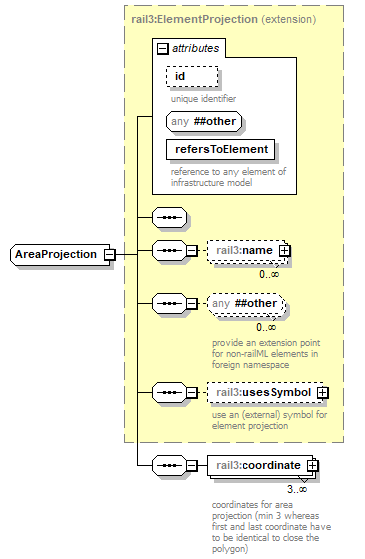 | ||||||||||||||||||||||
| namespace | https://www.railml.org/schemas/3.1 | ||||||||||||||||||||||
| type | extension of rail3:ElementProjection | ||||||||||||||||||||||
| properties |
| ||||||||||||||||||||||
| children | rail3:name rail3:usesSymbol rail3:coordinate | ||||||||||||||||||||||
| used by |
| ||||||||||||||||||||||
| attributes |
| ||||||||||||||||||||||
| source | <xs:complexType name="AreaProjection"> <xs:complexContent> <xs:extension base="rail3:ElementProjection"> <xs:sequence> <xs:element name="coordinate" type="rail3:ProjectionCoordinate" minOccurs="3" maxOccurs="unbounded"> <xs:annotation> <xs:documentation>coordinates for area projection (min 3 whereas first and last coordinate have to be identical to close the polygon)</xs:documentation> </xs:annotation> </xs:element> </xs:sequence> </xs:extension> </xs:complexContent> </xs:complexType> |
element AreaProjection/coordinate
| diagram | 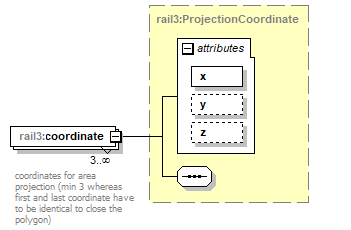 | ||||||||||||||||||||||||
| namespace | https://www.railml.org/schemas/3.1 | ||||||||||||||||||||||||
| type | rail3:ProjectionCoordinate | ||||||||||||||||||||||||
| properties |
| ||||||||||||||||||||||||
| attributes |
| ||||||||||||||||||||||||
| annotation |
| ||||||||||||||||||||||||
| source | <xs:element name="coordinate" type="rail3:ProjectionCoordinate" minOccurs="3" maxOccurs="unbounded"> <xs:annotation> <xs:documentation>coordinates for area projection (min 3 whereas first and last coordinate have to be identical to close the polygon)</xs:documentation> </xs:annotation> </xs:element> |
complexType Balise
| diagram |  | ||||||||||||||||||||||||||||||||||||||||||||||||||||||
| namespace | https://www.railml.org/schemas/3.1 | ||||||||||||||||||||||||||||||||||||||||||||||||||||||
| type | extension of rail3:FunctionalInfrastructureEntity | ||||||||||||||||||||||||||||||||||||||||||||||||||||||
| properties |
| ||||||||||||||||||||||||||||||||||||||||||||||||||||||
| children | rail3:name rail3:isValid rail3:areaLocation rail3:linearLocation rail3:spotLocation rail3:gmlLocations rail3:networkLocation rail3:designator rail3:external | ||||||||||||||||||||||||||||||||||||||||||||||||||||||
| used by |
| ||||||||||||||||||||||||||||||||||||||||||||||||||||||
| attributes |
| ||||||||||||||||||||||||||||||||||||||||||||||||||||||
| source | <xs:complexType name="Balise"> <xs:complexContent> <xs:extension base="rail3:FunctionalInfrastructureEntity"> <xs:sequence/> <xs:attribute name="type" type="rail3:tBaliseType" use="optional"> <xs:annotation> <xs:documentation>type of balise: fixed or transparent</xs:documentation> </xs:annotation> </xs:attribute> <xs:attribute name="belongsToParent" type="rail3:tRef" use="optional"> <xs:annotation> <xs:documentation>reference to the (one and only) parent balise (group)</xs:documentation> </xs:annotation> </xs:attribute> <xs:attribute name="basedOnTemplate" type="rail3:tRef" use="optional"> <xs:annotation> <xs:documentation>reference to a generic balise (group)</xs:documentation> </xs:annotation> </xs:attribute> <xs:attribute name="isBaliseGroup" type="xs:boolean" use="optional"> <xs:annotation> <xs:documentation>indicate whether the <balise> represents a balise group</xs:documentation> </xs:annotation> </xs:attribute> <xs:attribute name="baliseGroupType" type="rail3:tBaliseGroupTypeExt" use="optional"> <xs:annotation> <xs:documentation>type of balise group: fixed, transparent or infill</xs:documentation> </xs:annotation> </xs:attribute> </xs:extension> </xs:complexContent> </xs:complexType> |
attribute Balise/@type
| type | rail3:tBaliseType | |||||||||
| properties |
| |||||||||
| facets |
| |||||||||
| annotation |
| |||||||||
| source | <xs:attribute name="type" type="rail3:tBaliseType" use="optional"> <xs:annotation> <xs:documentation>type of balise: fixed or transparent</xs:documentation> </xs:annotation> </xs:attribute> |
attribute Balise/@belongsToParent
| type | rail3:tRef | ||
| properties |
| ||
| annotation |
| ||
| source | <xs:attribute name="belongsToParent" type="rail3:tRef" use="optional"> <xs:annotation> <xs:documentation>reference to the (one and only) parent balise (group)</xs:documentation> </xs:annotation> </xs:attribute> |
attribute Balise/@basedOnTemplate
| type | rail3:tRef | ||
| properties |
| ||
| annotation |
| ||
| source | <xs:attribute name="basedOnTemplate" type="rail3:tRef" use="optional"> <xs:annotation> <xs:documentation>reference to a generic balise (group)</xs:documentation> </xs:annotation> </xs:attribute> |
attribute Balise/@isBaliseGroup
| type | xs:boolean | ||
| properties |
| ||
| annotation |
| ||
| source | <xs:attribute name="isBaliseGroup" type="xs:boolean" use="optional"> <xs:annotation> <xs:documentation>indicate whether the <balise> represents a balise group</xs:documentation> </xs:annotation> </xs:attribute> |
attribute Balise/@baliseGroupType
| type | rail3:tBaliseGroupTypeExt | ||
| properties |
| ||
| annotation |
| ||
| source | <xs:attribute name="baliseGroupType" type="rail3:tBaliseGroupTypeExt" use="optional"> <xs:annotation> <xs:documentation>type of balise group: fixed, transparent or infill</xs:documentation> </xs:annotation> </xs:attribute> |
complexType Balises
| diagram |  | ||
| namespace | https://www.railml.org/schemas/3.1 | ||
| children | rail3:balise | ||
| used by |
| ||
| source | <xs:complexType name="Balises"> <xs:sequence> <xs:element name="balise" type="rail3:Balise" minOccurs="0" maxOccurs="unbounded"/> </xs:sequence> </xs:complexType> |
element Balises/balise
| diagram |  | ||||||||||||||||||||||||||||||||||||||||||||||||||||||
| namespace | https://www.railml.org/schemas/3.1 | ||||||||||||||||||||||||||||||||||||||||||||||||||||||
| type | rail3:Balise | ||||||||||||||||||||||||||||||||||||||||||||||||||||||
| properties |
| ||||||||||||||||||||||||||||||||||||||||||||||||||||||
| children | rail3:name rail3:isValid rail3:areaLocation rail3:linearLocation rail3:spotLocation rail3:gmlLocations rail3:networkLocation rail3:designator rail3:external | ||||||||||||||||||||||||||||||||||||||||||||||||||||||
| attributes |
| ||||||||||||||||||||||||||||||||||||||||||||||||||||||
| source | <xs:element name="balise" type="rail3:Balise" minOccurs="0" maxOccurs="unbounded"/> |
complexType Border
| diagram | 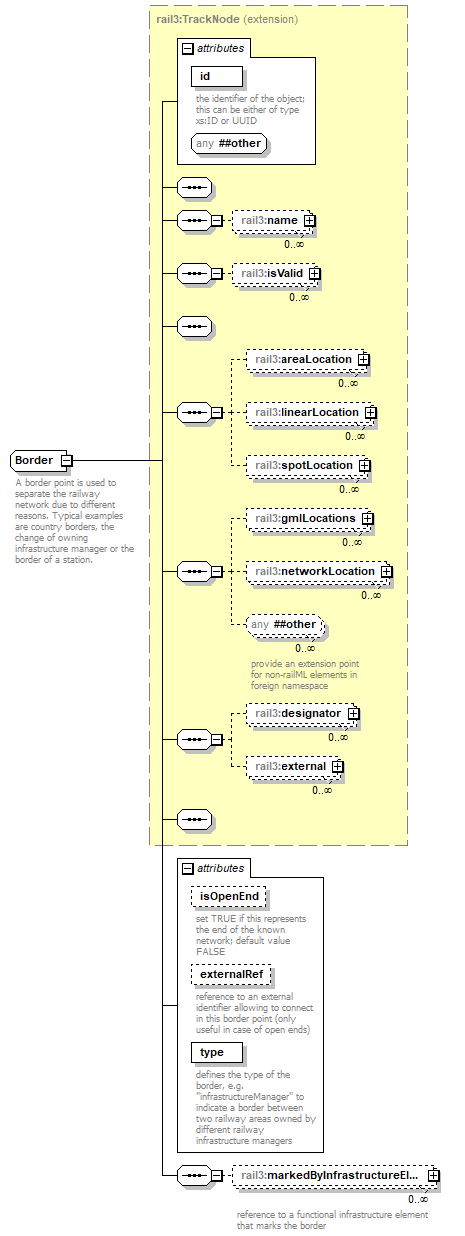 | ||||||||||||||||||||||||||||||||||||||
| namespace | https://www.railml.org/schemas/3.1 | ||||||||||||||||||||||||||||||||||||||
| type | extension of rail3:TrackNode | ||||||||||||||||||||||||||||||||||||||
| properties |
| ||||||||||||||||||||||||||||||||||||||
| children | rail3:name rail3:isValid rail3:areaLocation rail3:linearLocation rail3:spotLocation rail3:gmlLocations rail3:networkLocation rail3:designator rail3:external rail3:markedByInfrastructureElement | ||||||||||||||||||||||||||||||||||||||
| used by |
| ||||||||||||||||||||||||||||||||||||||
| attributes |
| ||||||||||||||||||||||||||||||||||||||
| annotation |
| ||||||||||||||||||||||||||||||||||||||
| source | <xs:complexType name="Border"> <xs:annotation> <xs:documentation>A border point is used to separate the railway network due to different reasons. Typical examples are country borders, the change of owning infrastructure manager or the border of a station.</xs:documentation> </xs:annotation> <xs:complexContent> <xs:extension base="rail3:TrackNode"> <xs:sequence> <xs:element name="markedByInfrastructureElement" type="rail3:tElementWithIDref" minOccurs="0" maxOccurs="unbounded"> <xs:annotation> <xs:documentation>reference to a functional infrastructure element that marks the border</xs:documentation> </xs:annotation> </xs:element> </xs:sequence> <xs:attribute name="isOpenEnd" type="xs:boolean" use="optional"> <xs:annotation> <xs:documentation>set TRUE if this represents the end of the known network; default value FALSE</xs:documentation> </xs:annotation> </xs:attribute> <xs:attribute name="externalRef" type="xs:string" use="optional"> <xs:annotation> <xs:documentation>reference to an external identifier allowing to connect in this border point (only useful in case of open ends)</xs:documentation> </xs:annotation> </xs:attribute> <xs:attribute name="type" type="rail3:tBorderTypeExt" use="required"> <xs:annotation> <xs:documentation>defines the type of the border, e.g. "infrastructureManager" to indicate a border between two railway areas owned by different railway infrastructure managers</xs:documentation> </xs:annotation> </xs:attribute> </xs:extension> </xs:complexContent> </xs:complexType> |
attribute Border/@isOpenEnd
| type | xs:boolean | ||
| properties |
| ||
| annotation |
| ||
| source | <xs:attribute name="isOpenEnd" type="xs:boolean" use="optional"> <xs:annotation> <xs:documentation>set TRUE if this represents the end of the known network; default value FALSE</xs:documentation> </xs:annotation> </xs:attribute> |
attribute Border/@externalRef
| type | xs:string | ||
| properties |
| ||
| annotation |
| ||
| source | <xs:attribute name="externalRef" type="xs:string" use="optional"> <xs:annotation> <xs:documentation>reference to an external identifier allowing to connect in this border point (only useful in case of open ends)</xs:documentation> </xs:annotation> </xs:attribute> |
attribute Border/@type
| type | rail3:tBorderTypeExt | ||
| properties |
| ||
| annotation |
| ||
| source | <xs:attribute name="type" type="rail3:tBorderTypeExt" use="required"> <xs:annotation> <xs:documentation>defines the type of the border, e.g. "infrastructureManager" to indicate a border between two railway areas owned by different railway infrastructure managers</xs:documentation> </xs:annotation> </xs:attribute> |
element Border/markedByInfrastructureElement
| diagram | 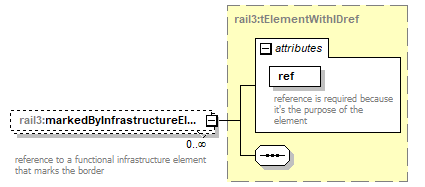 | ||||||||||||||
| namespace | https://www.railml.org/schemas/3.1 | ||||||||||||||
| type | rail3:tElementWithIDref | ||||||||||||||
| properties |
| ||||||||||||||
| attributes |
| ||||||||||||||
| annotation |
| ||||||||||||||
| source | <xs:element name="markedByInfrastructureElement" type="rail3:tElementWithIDref" minOccurs="0" maxOccurs="unbounded"> <xs:annotation> <xs:documentation>reference to a functional infrastructure element that marks the border</xs:documentation> </xs:annotation> </xs:element> |
complexType Borders
| diagram |  | ||
| namespace | https://www.railml.org/schemas/3.1 | ||
| children | rail3:border | ||
| used by |
| ||
| source | <xs:complexType name="Borders"> <xs:sequence> <xs:element name="border" type="rail3:Border" minOccurs="1" maxOccurs="unbounded"/> </xs:sequence> </xs:complexType> |
element Borders/border
| diagram | 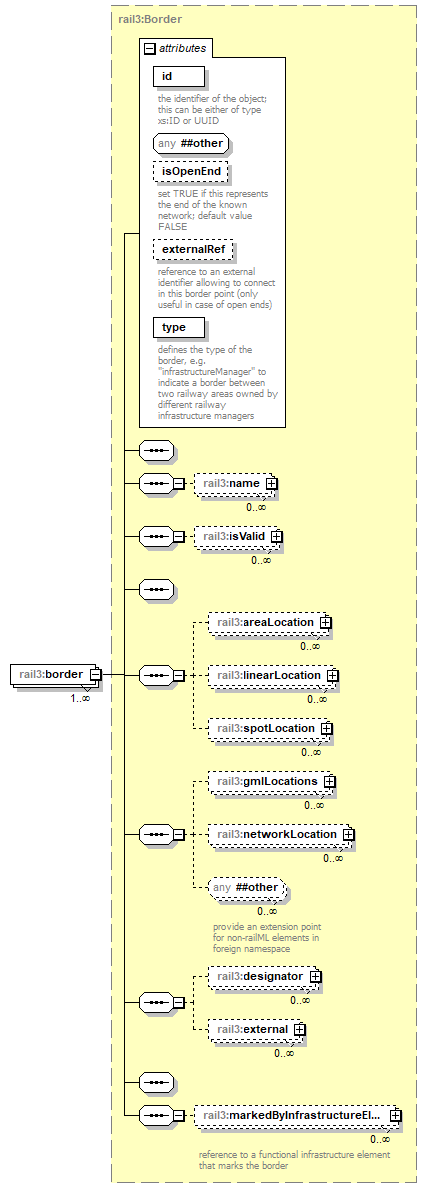 | ||||||||||||||||||||||||||||||||||||||
| namespace | https://www.railml.org/schemas/3.1 | ||||||||||||||||||||||||||||||||||||||
| type | rail3:Border | ||||||||||||||||||||||||||||||||||||||
| properties |
| ||||||||||||||||||||||||||||||||||||||
| children | rail3:name rail3:isValid rail3:areaLocation rail3:linearLocation rail3:spotLocation rail3:gmlLocations rail3:networkLocation rail3:designator rail3:external rail3:markedByInfrastructureElement | ||||||||||||||||||||||||||||||||||||||
| attributes |
| ||||||||||||||||||||||||||||||||||||||
| source | <xs:element name="border" type="rail3:Border" minOccurs="1" maxOccurs="unbounded"/> |
complexType BufferStop
| diagram | 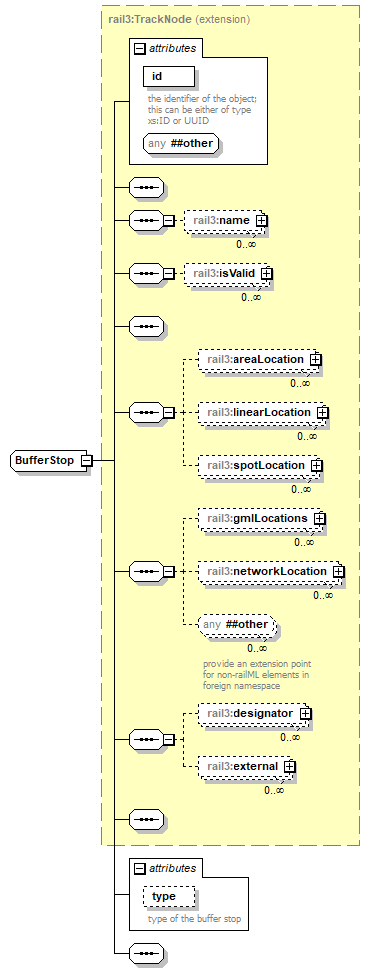 | ||||||||||||||||||||||
| namespace | https://www.railml.org/schemas/3.1 | ||||||||||||||||||||||
| type | extension of rail3:TrackNode | ||||||||||||||||||||||
| properties |
| ||||||||||||||||||||||
| children | rail3:name rail3:isValid rail3:areaLocation rail3:linearLocation rail3:spotLocation rail3:gmlLocations rail3:networkLocation rail3:designator rail3:external | ||||||||||||||||||||||
| used by |
| ||||||||||||||||||||||
| attributes |
| ||||||||||||||||||||||
| source | <xs:complexType name="BufferStop"> <xs:complexContent> <xs:extension base="rail3:TrackNode"> <xs:sequence/> <xs:attribute name="type" type="rail3:tBufferStopType" use="optional"> <xs:annotation> <xs:documentation>type of the buffer stop</xs:documentation> </xs:annotation> </xs:attribute> </xs:extension> </xs:complexContent> </xs:complexType> |
attribute BufferStop/@type
| type | rail3:tBufferStopType | |||||||||||||||
| properties |
| |||||||||||||||
| facets |
| |||||||||||||||
| annotation |
| |||||||||||||||
| source | <xs:attribute name="type" type="rail3:tBufferStopType" use="optional"> <xs:annotation> <xs:documentation>type of the buffer stop</xs:documentation> </xs:annotation> </xs:attribute> |
complexType BufferStops
| diagram |  | ||
| namespace | https://www.railml.org/schemas/3.1 | ||
| children | rail3:bufferStop | ||
| used by |
| ||
| source | <xs:complexType name="BufferStops"> <xs:sequence> <xs:element name="bufferStop" type="rail3:BufferStop" minOccurs="1" maxOccurs="unbounded"/> </xs:sequence> </xs:complexType> |
element BufferStops/bufferStop
| diagram | 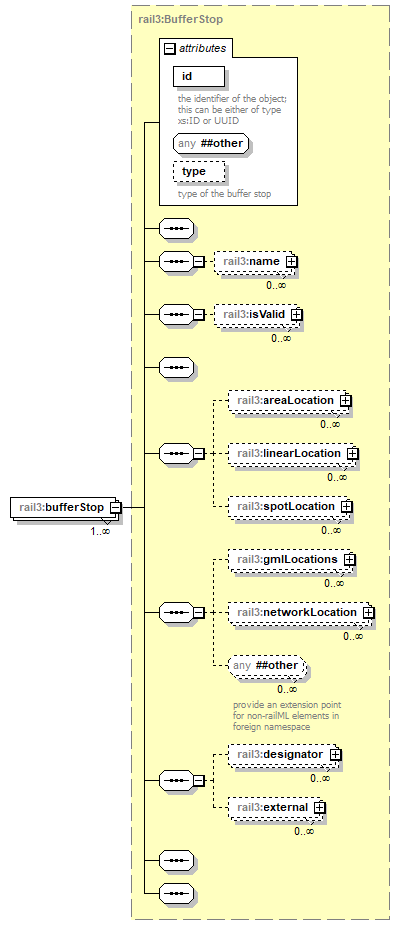 | ||||||||||||||||||||||
| namespace | https://www.railml.org/schemas/3.1 | ||||||||||||||||||||||
| type | rail3:BufferStop | ||||||||||||||||||||||
| properties |
| ||||||||||||||||||||||
| children | rail3:name rail3:isValid rail3:areaLocation rail3:linearLocation rail3:spotLocation rail3:gmlLocations rail3:networkLocation rail3:designator rail3:external | ||||||||||||||||||||||
| attributes |
| ||||||||||||||||||||||
| source | <xs:element name="bufferStop" type="rail3:BufferStop" minOccurs="1" maxOccurs="unbounded"/> |
complexType ContactWire
| diagram | 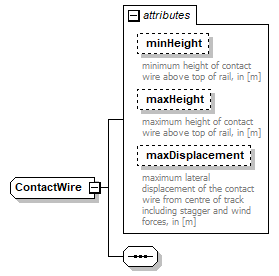 | ||||||||||||||||||||||||||||||
| namespace | https://www.railml.org/schemas/3.1 | ||||||||||||||||||||||||||||||
| used by |
| ||||||||||||||||||||||||||||||
| attributes |
| ||||||||||||||||||||||||||||||
| source | <xs:complexType name="ContactWire"> <xs:sequence/> <xs:attribute name="minHeight" type="rail3:tLengthM" use="optional"> <xs:annotation> <xs:documentation>minimum height of contact wire above top of rail, in [m]</xs:documentation> </xs:annotation> </xs:attribute> <xs:attribute name="maxHeight" type="rail3:tLengthM" use="optional"> <xs:annotation> <xs:documentation>maximum height of contact wire above top of rail, in [m]</xs:documentation> </xs:annotation> </xs:attribute> <xs:attribute name="maxDisplacement" type="rail3:tLengthM" use="optional"> <xs:annotation> <xs:documentation>maximum lateral displacement of the contact wire from centre of track including stagger and wind forces, in [m]</xs:documentation> </xs:annotation> </xs:attribute> </xs:complexType> |
attribute ContactWire/@minHeight
| type | rail3:tLengthM | ||
| properties |
| ||
| annotation |
| ||
| source | <xs:attribute name="minHeight" type="rail3:tLengthM" use="optional"> <xs:annotation> <xs:documentation>minimum height of contact wire above top of rail, in [m]</xs:documentation> </xs:annotation> </xs:attribute> |
attribute ContactWire/@maxHeight
| type | rail3:tLengthM | ||
| properties |
| ||
| annotation |
| ||
| source | <xs:attribute name="maxHeight" type="rail3:tLengthM" use="optional"> <xs:annotation> <xs:documentation>maximum height of contact wire above top of rail, in [m]</xs:documentation> </xs:annotation> </xs:attribute> |
attribute ContactWire/@maxDisplacement
| type | rail3:tLengthM | ||
| properties |
| ||
| annotation |
| ||
| source | <xs:attribute name="maxDisplacement" type="rail3:tLengthM" use="optional"> <xs:annotation> <xs:documentation>maximum lateral displacement of the contact wire from centre of track including stagger and wind forces, in [m]</xs:documentation> </xs:annotation> </xs:attribute> |
complexType CrossedElement
| diagram | 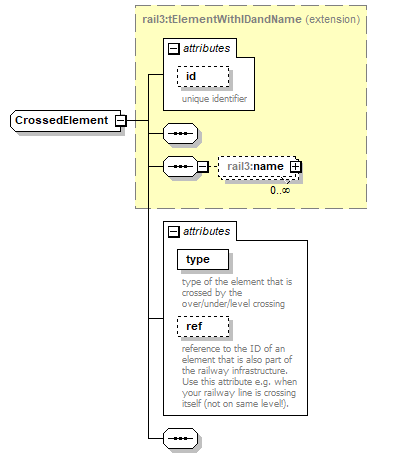 | ||||||||||||||||||||||||||||||
| namespace | https://www.railml.org/schemas/3.1 | ||||||||||||||||||||||||||||||
| type | extension of rail3:tElementWithIDandName | ||||||||||||||||||||||||||||||
| properties |
| ||||||||||||||||||||||||||||||
| children | rail3:name | ||||||||||||||||||||||||||||||
| used by |
| ||||||||||||||||||||||||||||||
| attributes |
| ||||||||||||||||||||||||||||||
| source | <xs:complexType name="CrossedElement"> <xs:complexContent> <xs:extension base="rail3:tElementWithIDandName"> <xs:sequence/> <xs:attribute name="type" type="rail3:tCrossedElementTypeExt" use="required"> <xs:annotation> <xs:documentation>type of the element that is crossed by the over/under/level crossing</xs:documentation> </xs:annotation> </xs:attribute> <xs:attribute name="ref" type="rail3:tRef" use="optional"> <xs:annotation> <xs:documentation>reference to the ID of an element that is also part of the railway infrastructure. Use this attribute e.g. when your railway line is crossing itself (not on same level!).</xs:documentation> </xs:annotation> </xs:attribute> </xs:extension> </xs:complexContent> </xs:complexType> |
attribute CrossedElement/@type
| type | rail3:tCrossedElementTypeExt | ||
| properties |
| ||
| annotation |
| ||
| source | <xs:attribute name="type" type="rail3:tCrossedElementTypeExt" use="required"> <xs:annotation> <xs:documentation>type of the element that is crossed by the over/under/level crossing</xs:documentation> </xs:annotation> </xs:attribute> |
attribute CrossedElement/@ref
| type | rail3:tRef | ||
| properties |
| ||
| annotation |
| ||
| source | <xs:attribute name="ref" type="rail3:tRef" use="optional"> <xs:annotation> <xs:documentation>reference to the ID of an element that is also part of the railway infrastructure. Use this attribute e.g. when your railway line is crossing itself (not on same level!).</xs:documentation> </xs:annotation> </xs:attribute> |
complexType Crossing
| diagram | 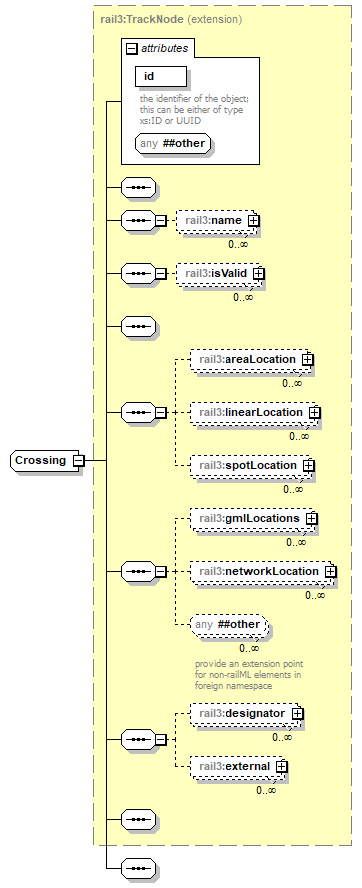 | ||||||||||||||
| namespace | https://www.railml.org/schemas/3.1 | ||||||||||||||
| type | extension of rail3:TrackNode | ||||||||||||||
| properties |
| ||||||||||||||
| children | rail3:name rail3:isValid rail3:areaLocation rail3:linearLocation rail3:spotLocation rail3:gmlLocations rail3:networkLocation rail3:designator rail3:external | ||||||||||||||
| used by |
| ||||||||||||||
| attributes |
| ||||||||||||||
| source | <xs:complexType name="Crossing"> <xs:complexContent> <xs:extension base="rail3:TrackNode"> <xs:sequence/> </xs:extension> </xs:complexContent> </xs:complexType> |
complexType Crossings
| diagram |  | ||
| namespace | https://www.railml.org/schemas/3.1 | ||
| children | rail3:crossing | ||
| used by |
| ||
| source | <xs:complexType name="Crossings"> <xs:sequence> <xs:element name="crossing" type="rail3:Crossing" minOccurs="1" maxOccurs="unbounded"/> </xs:sequence> </xs:complexType> |
element Crossings/crossing
| diagram | 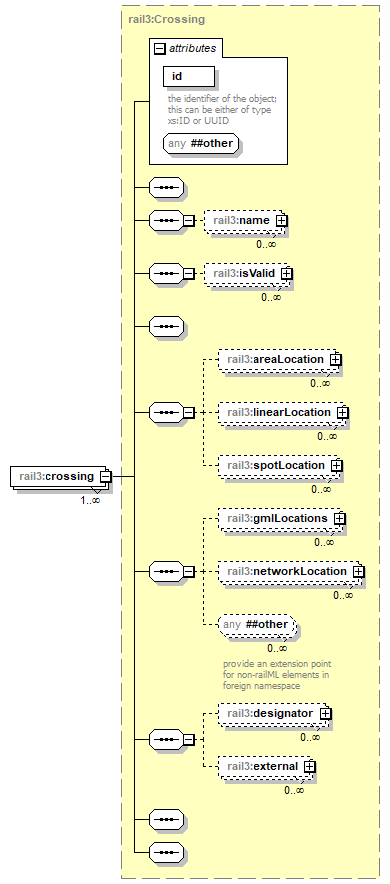 | ||||||||||||||
| namespace | https://www.railml.org/schemas/3.1 | ||||||||||||||
| type | rail3:Crossing | ||||||||||||||
| properties |
| ||||||||||||||
| children | rail3:name rail3:isValid rail3:areaLocation rail3:linearLocation rail3:spotLocation rail3:gmlLocations rail3:networkLocation rail3:designator rail3:external | ||||||||||||||
| attributes |
| ||||||||||||||
| source | <xs:element name="crossing" type="rail3:Crossing" minOccurs="1" maxOccurs="unbounded"/> |
complexType DerailerIS
| diagram | 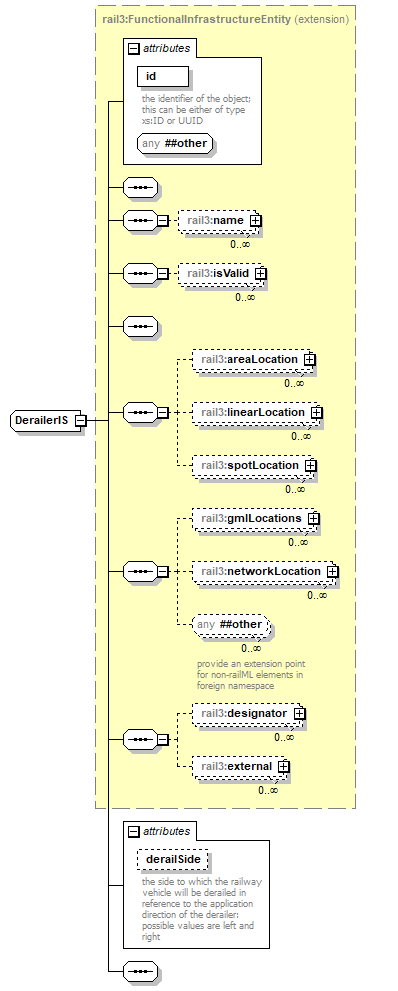 | ||||||||||||||||||||||
| namespace | https://www.railml.org/schemas/3.1 | ||||||||||||||||||||||
| type | extension of rail3:FunctionalInfrastructureEntity | ||||||||||||||||||||||
| properties |
| ||||||||||||||||||||||
| children | rail3:name rail3:isValid rail3:areaLocation rail3:linearLocation rail3:spotLocation rail3:gmlLocations rail3:networkLocation rail3:designator rail3:external | ||||||||||||||||||||||
| used by |
| ||||||||||||||||||||||
| attributes |
| ||||||||||||||||||||||
| source | <xs:complexType name="DerailerIS"> <xs:complexContent> <xs:extension base="rail3:FunctionalInfrastructureEntity"> <xs:sequence/> <xs:attribute name="derailSide" type="rail3:tSide" use="optional"> <xs:annotation> <xs:documentation>the side to which the railway vehicle will be derailed in reference to the application direction of the derailer: possible values are left and right</xs:documentation> </xs:annotation> </xs:attribute> </xs:extension> </xs:complexContent> </xs:complexType> |
attribute DerailerIS/@derailSide
| type | rail3:tSide | |||||||||
| properties |
| |||||||||
| facets |
| |||||||||
| annotation |
| |||||||||
| source | <xs:attribute name="derailSide" type="rail3:tSide" use="optional"> <xs:annotation> <xs:documentation>the side to which the railway vehicle will be derailed in reference to the application direction of the derailer: possible values are left and right</xs:documentation> </xs:annotation> </xs:attribute> |
complexType DerailersIS
| diagram |  | ||
| namespace | https://www.railml.org/schemas/3.1 | ||
| children | rail3:derailerIS | ||
| used by |
| ||
| source | <xs:complexType name="DerailersIS"> <xs:sequence> <xs:element name="derailerIS" type="rail3:DerailerIS" minOccurs="1" maxOccurs="unbounded"/> </xs:sequence> </xs:complexType> |
element DerailersIS/derailerIS
| diagram | 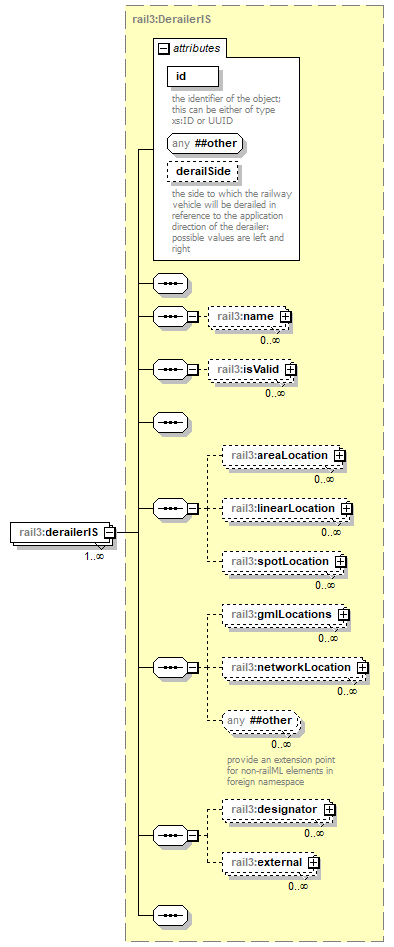 | ||||||||||||||||||||||
| namespace | https://www.railml.org/schemas/3.1 | ||||||||||||||||||||||
| type | rail3:DerailerIS | ||||||||||||||||||||||
| properties |
| ||||||||||||||||||||||
| children | rail3:name rail3:isValid rail3:areaLocation rail3:linearLocation rail3:spotLocation rail3:gmlLocations rail3:networkLocation rail3:designator rail3:external | ||||||||||||||||||||||
| attributes |
| ||||||||||||||||||||||
| source | <xs:element name="derailerIS" type="rail3:DerailerIS" minOccurs="1" maxOccurs="unbounded"/> |
complexType Electrifications
| diagram |  | ||
| namespace | https://www.railml.org/schemas/3.1 | ||
| children | rail3:electrificationSection | ||
| used by |
| ||
| annotation |
| ||
| source | <xs:complexType name="Electrifications"> <xs:annotation> <xs:documentation>umbrella element for all electrification elements</xs:documentation> </xs:annotation> <xs:sequence> <xs:element name="electrificationSection" type="rail3:ElectrificationSection" minOccurs="1" maxOccurs="unbounded"/> </xs:sequence> </xs:complexType> |
element Electrifications/electrificationSection
| diagram |  | ||||||||||||||||||||||||||||||||||||||
| namespace | https://www.railml.org/schemas/3.1 | ||||||||||||||||||||||||||||||||||||||
| type | rail3:ElectrificationSection | ||||||||||||||||||||||||||||||||||||||
| properties |
| ||||||||||||||||||||||||||||||||||||||
| children | rail3:name rail3:isValid rail3:areaLocation rail3:linearLocation rail3:spotLocation rail3:gmlLocations rail3:networkLocation rail3:designator rail3:external rail3:electrificationSystemRef rail3:energyCatenary rail3:energyPantograph rail3:energyRollingstock rail3:hasContactWire rail3:pantographSpacing rail3:phaseSeparationSection rail3:systemSeparationSection | ||||||||||||||||||||||||||||||||||||||
| attributes |
| ||||||||||||||||||||||||||||||||||||||
| source | <xs:element name="electrificationSection" type="rail3:ElectrificationSection" minOccurs="1" maxOccurs="unbounded"/> |
complexType ElectrificationSection
| diagram |  | ||||||||||||||||||||||||||||||||||||||
| namespace | https://www.railml.org/schemas/3.1 | ||||||||||||||||||||||||||||||||||||||
| type | extension of rail3:FunctionalInfrastructureEntity | ||||||||||||||||||||||||||||||||||||||
| properties |
| ||||||||||||||||||||||||||||||||||||||
| children | rail3:name rail3:isValid rail3:areaLocation rail3:linearLocation rail3:spotLocation rail3:gmlLocations rail3:networkLocation rail3:designator rail3:external rail3:electrificationSystemRef rail3:energyCatenary rail3:energyPantograph rail3:energyRollingstock rail3:hasContactWire rail3:pantographSpacing rail3:phaseSeparationSection rail3:systemSeparationSection | ||||||||||||||||||||||||||||||||||||||
| used by |
| ||||||||||||||||||||||||||||||||||||||
| attributes |
| ||||||||||||||||||||||||||||||||||||||
| source | <xs:complexType name="ElectrificationSection"> <xs:complexContent> <xs:extension base="rail3:FunctionalInfrastructureEntity"> <xs:sequence> <xs:element name="electrificationSystemRef" type="rail3:tElementWithIDref" minOccurs="0" maxOccurs="1"> <xs:annotation> <xs:documentation>reference to the electrification system</xs:documentation> </xs:annotation> </xs:element> <xs:element name="energyCatenary" type="rail3:EnergyCatenary" minOccurs="0" maxOccurs="1"> <xs:annotation> <xs:documentation>child element summarizing the catenary energy parameters</xs:documentation> </xs:annotation> </xs:element> <xs:element name="energyPantograph" type="rail3:EnergyPantograph" minOccurs="0" maxOccurs="1"> <xs:annotation> <xs:documentation>child element summarizing the pantograph energy parameters</xs:documentation> </xs:annotation> </xs:element> <xs:element name="energyRollingstock" type="rail3:EnergyRollingstock" minOccurs="0" maxOccurs="1"> <xs:annotation> <xs:documentation>child element summarizing the rollingstock energy parameters</xs:documentation> </xs:annotation> </xs:element> <xs:element name="hasContactWire" type="rail3:ContactWire" minOccurs="0" maxOccurs="1"> <xs:annotation> <xs:documentation>child element summarizing the construction details of the contact wire</xs:documentation> </xs:annotation> </xs:element> <xs:element name="pantographSpacing" type="rail3:PantographSpacing" minOccurs="0" maxOccurs="unbounded"> <xs:annotation> <xs:documentation>child element summarizing the pantograph spacing parameters</xs:documentation> </xs:annotation> </xs:element> <xs:element name="phaseSeparationSection" type="rail3:PhaseSeparationSection" minOccurs="0" maxOccurs="unbounded"> <xs:annotation> <xs:documentation>child element summarizing the phase separation parameters</xs:documentation> </xs:annotation> </xs:element> <xs:element name="systemSeparationSection" type="rail3:SystemSeparationSection" minOccurs="0" maxOccurs="unbounded"> <xs:annotation> <xs:documentation>child element summarizing the electrification system separation parameters</xs:documentation> </xs:annotation> </xs:element> </xs:sequence> <xs:attribute name="contactLineType" type="rail3:tContactLineType" use="required"> <xs:annotation> <xs:documentation>type of the installed contact line (most common: overhead)</xs:documentation> </xs:annotation> </xs:attribute> <xs:attribute name="isInsulatedSection" type="xs:boolean" use="optional"> <xs:annotation> <xs:documentation>set true if the described electrification section is an insulated section</xs:documentation> </xs:annotation> </xs:attribute> <xs:attribute name="belongsToParent" type="rail3:tRef" use="optional"> <xs:annotation> <xs:documentation>reference to the (one and only) parent electrification section</xs:documentation> </xs:annotation> </xs:attribute> </xs:extension> </xs:complexContent> </xs:complexType> |
attribute ElectrificationSection/@contactLineType
| type | rail3:tContactLineType | |||||||||||||||||||||
| properties |
| |||||||||||||||||||||
| facets |
| |||||||||||||||||||||
| annotation |
| |||||||||||||||||||||
| source | <xs:attribute name="contactLineType" type="rail3:tContactLineType" use="required"> <xs:annotation> <xs:documentation>type of the installed contact line (most common: overhead)</xs:documentation> </xs:annotation> </xs:attribute> |
attribute ElectrificationSection/@isInsulatedSection
| type | xs:boolean | ||
| properties |
| ||
| annotation |
| ||
| source | <xs:attribute name="isInsulatedSection" type="xs:boolean" use="optional"> <xs:annotation> <xs:documentation>set true if the described electrification section is an insulated section</xs:documentation> </xs:annotation> </xs:attribute> |
attribute ElectrificationSection/@belongsToParent
| type | rail3:tRef | ||
| properties |
| ||
| annotation |
| ||
| source | <xs:attribute name="belongsToParent" type="rail3:tRef" use="optional"> <xs:annotation> <xs:documentation>reference to the (one and only) parent electrification section</xs:documentation> </xs:annotation> </xs:attribute> |
element ElectrificationSection/electrificationSystemRef
| diagram | 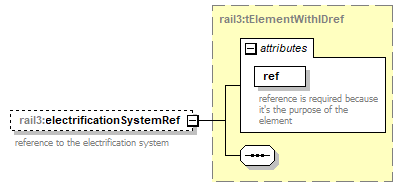 | ||||||||||||||
| namespace | https://www.railml.org/schemas/3.1 | ||||||||||||||
| type | rail3:tElementWithIDref | ||||||||||||||
| properties |
| ||||||||||||||
| attributes |
| ||||||||||||||
| annotation |
| ||||||||||||||
| source | <xs:element name="electrificationSystemRef" type="rail3:tElementWithIDref" minOccurs="0" maxOccurs="1"> <xs:annotation> <xs:documentation>reference to the electrification system</xs:documentation> </xs:annotation> </xs:element> |
element ElectrificationSection/energyCatenary
| diagram | 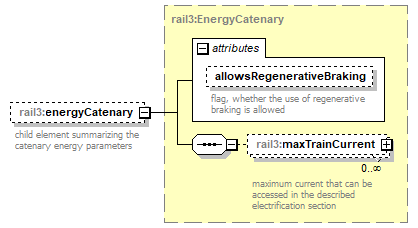 | ||||||||||||||
| namespace | https://www.railml.org/schemas/3.1 | ||||||||||||||
| type | rail3:EnergyCatenary | ||||||||||||||
| properties |
| ||||||||||||||
| children | rail3:maxTrainCurrent | ||||||||||||||
| attributes |
| ||||||||||||||
| annotation |
| ||||||||||||||
| source | <xs:element name="energyCatenary" type="rail3:EnergyCatenary" minOccurs="0" maxOccurs="1"> <xs:annotation> <xs:documentation>child element summarizing the catenary energy parameters</xs:documentation> </xs:annotation> </xs:element> |
element ElectrificationSection/energyPantograph
| diagram | 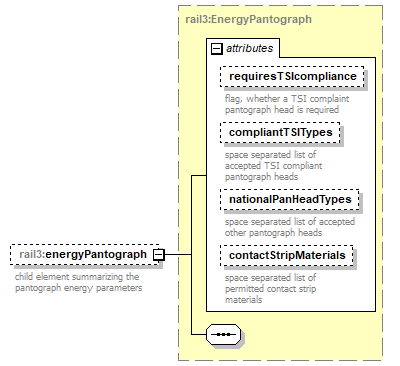 | ||||||||||||||||||||||||||||||||||||||
| namespace | https://www.railml.org/schemas/3.1 | ||||||||||||||||||||||||||||||||||||||
| type | rail3:EnergyPantograph | ||||||||||||||||||||||||||||||||||||||
| properties |
| ||||||||||||||||||||||||||||||||||||||
| attributes |
| ||||||||||||||||||||||||||||||||||||||
| annotation |
| ||||||||||||||||||||||||||||||||||||||
| source | <xs:element name="energyPantograph" type="rail3:EnergyPantograph" minOccurs="0" maxOccurs="1"> <xs:annotation> <xs:documentation>child element summarizing the pantograph energy parameters</xs:documentation> </xs:annotation> </xs:element> |
element ElectrificationSection/energyRollingstock
| diagram | 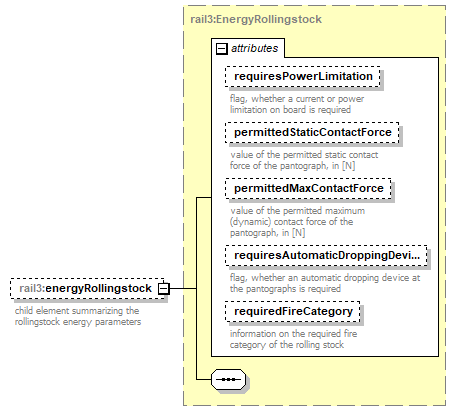 | ||||||||||||||||||||||||||||||||||||||||||||||
| namespace | https://www.railml.org/schemas/3.1 | ||||||||||||||||||||||||||||||||||||||||||||||
| type | rail3:EnergyRollingstock | ||||||||||||||||||||||||||||||||||||||||||||||
| properties |
| ||||||||||||||||||||||||||||||||||||||||||||||
| attributes |
| ||||||||||||||||||||||||||||||||||||||||||||||
| annotation |
| ||||||||||||||||||||||||||||||||||||||||||||||
| source | <xs:element name="energyRollingstock" type="rail3:EnergyRollingstock" minOccurs="0" maxOccurs="1"> <xs:annotation> <xs:documentation>child element summarizing the rollingstock energy parameters</xs:documentation> </xs:annotation> </xs:element> |
element ElectrificationSection/hasContactWire
| diagram | 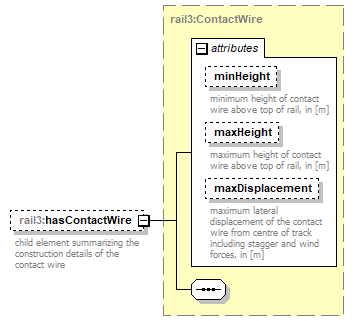 | ||||||||||||||||||||||||||||||
| namespace | https://www.railml.org/schemas/3.1 | ||||||||||||||||||||||||||||||
| type | rail3:ContactWire | ||||||||||||||||||||||||||||||
| properties |
| ||||||||||||||||||||||||||||||
| attributes |
| ||||||||||||||||||||||||||||||
| annotation |
| ||||||||||||||||||||||||||||||
| source | <xs:element name="hasContactWire" type="rail3:ContactWire" minOccurs="0" maxOccurs="1"> <xs:annotation> <xs:documentation>child element summarizing the construction details of the contact wire</xs:documentation> </xs:annotation> </xs:element> |
element ElectrificationSection/pantographSpacing
| diagram | 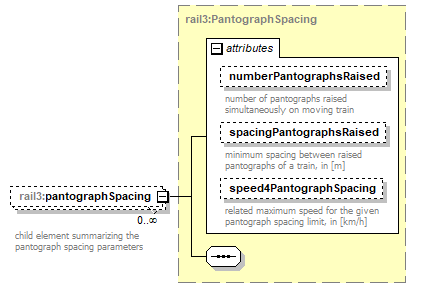 | ||||||||||||||||||||||||||||||
| namespace | https://www.railml.org/schemas/3.1 | ||||||||||||||||||||||||||||||
| type | rail3:PantographSpacing | ||||||||||||||||||||||||||||||
| properties |
| ||||||||||||||||||||||||||||||
| attributes |
| ||||||||||||||||||||||||||||||
| annotation |
| ||||||||||||||||||||||||||||||
| source | <xs:element name="pantographSpacing" type="rail3:PantographSpacing" minOccurs="0" maxOccurs="unbounded"> <xs:annotation> <xs:documentation>child element summarizing the pantograph spacing parameters</xs:documentation> </xs:annotation> </xs:element> |
element ElectrificationSection/phaseSeparationSection
| diagram | 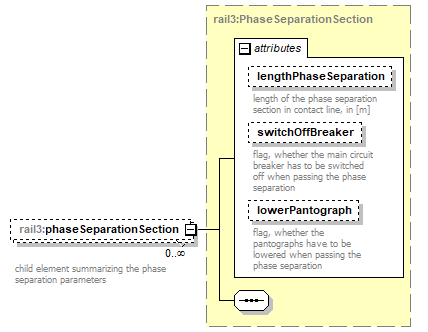 | ||||||||||||||||||||||||||||||
| namespace | https://www.railml.org/schemas/3.1 | ||||||||||||||||||||||||||||||
| type | rail3:PhaseSeparationSection | ||||||||||||||||||||||||||||||
| properties |
| ||||||||||||||||||||||||||||||
| attributes |
| ||||||||||||||||||||||||||||||
| annotation |
| ||||||||||||||||||||||||||||||
| source | <xs:element name="phaseSeparationSection" type="rail3:PhaseSeparationSection" minOccurs="0" maxOccurs="unbounded"> <xs:annotation> <xs:documentation>child element summarizing the phase separation parameters</xs:documentation> </xs:annotation> </xs:element> |
element ElectrificationSection/systemSeparationSection
| diagram | 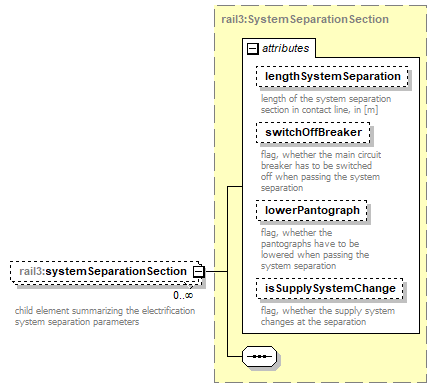 | ||||||||||||||||||||||||||||||||||||||
| namespace | https://www.railml.org/schemas/3.1 | ||||||||||||||||||||||||||||||||||||||
| type | rail3:SystemSeparationSection | ||||||||||||||||||||||||||||||||||||||
| properties |
| ||||||||||||||||||||||||||||||||||||||
| attributes |
| ||||||||||||||||||||||||||||||||||||||
| annotation |
| ||||||||||||||||||||||||||||||||||||||
| source | <xs:element name="systemSeparationSection" type="rail3:SystemSeparationSection" minOccurs="0" maxOccurs="unbounded"> <xs:annotation> <xs:documentation>child element summarizing the electrification system separation parameters</xs:documentation> </xs:annotation> </xs:element> |
complexType ElementProjection
| diagram | 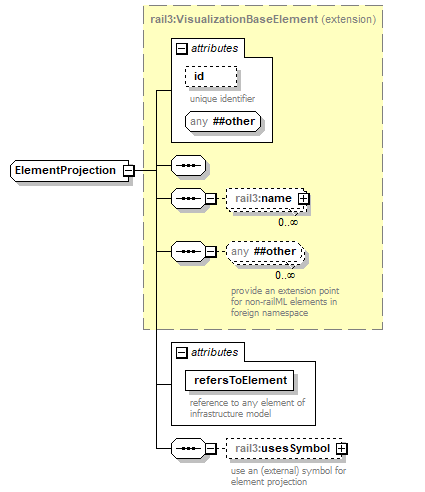 | ||||||||||||||||||||||
| namespace | https://www.railml.org/schemas/3.1 | ||||||||||||||||||||||
| type | extension of rail3:VisualizationBaseElement | ||||||||||||||||||||||
| properties |
| ||||||||||||||||||||||
| children | rail3:name rail3:usesSymbol | ||||||||||||||||||||||
| used by |
| ||||||||||||||||||||||
| attributes |
| ||||||||||||||||||||||
| source | <xs:complexType name="ElementProjection"> <xs:complexContent> <xs:extension base="rail3:VisualizationBaseElement"> <xs:sequence> <xs:element name="usesSymbol" type="rail3:ElementProjectionSymbol" minOccurs="0" maxOccurs="1"> <xs:annotation> <xs:documentation>use an (external) symbol for element projection</xs:documentation> </xs:annotation> </xs:element> </xs:sequence> <xs:attribute name="refersToElement" type="rail3:tRef" use="required"> <xs:annotation> <xs:documentation>reference to any element of infrastructure model</xs:documentation> </xs:annotation> </xs:attribute> </xs:extension> </xs:complexContent> </xs:complexType> |
attribute ElementProjection/@refersToElement
| type | rail3:tRef | ||
| properties |
| ||
| annotation |
| ||
| source | <xs:attribute name="refersToElement" type="rail3:tRef" use="required"> <xs:annotation> <xs:documentation>reference to any element of infrastructure model</xs:documentation> </xs:annotation> </xs:attribute> |
element ElementProjection/usesSymbol
| diagram | 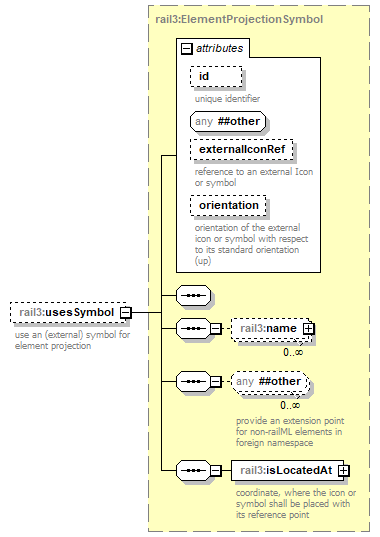 | ||||||||||||||||||||||||||||||
| namespace | https://www.railml.org/schemas/3.1 | ||||||||||||||||||||||||||||||
| type | rail3:ElementProjectionSymbol | ||||||||||||||||||||||||||||||
| properties |
| ||||||||||||||||||||||||||||||
| children | rail3:name rail3:isLocatedAt | ||||||||||||||||||||||||||||||
| attributes |
| ||||||||||||||||||||||||||||||
| annotation |
| ||||||||||||||||||||||||||||||
| source | <xs:element name="usesSymbol" type="rail3:ElementProjectionSymbol" minOccurs="0" maxOccurs="1"> <xs:annotation> <xs:documentation>use an (external) symbol for element projection</xs:documentation> </xs:annotation> </xs:element> |
complexType ElementProjectionSymbol
| diagram | 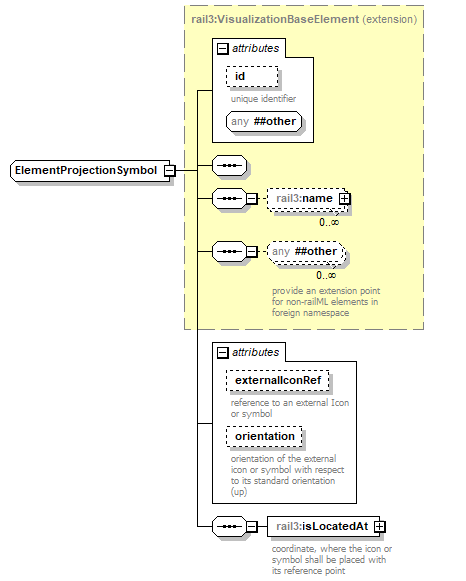 | ||||||||||||||||||||||||||||||
| namespace | https://www.railml.org/schemas/3.1 | ||||||||||||||||||||||||||||||
| type | extension of rail3:VisualizationBaseElement | ||||||||||||||||||||||||||||||
| properties |
| ||||||||||||||||||||||||||||||
| children | rail3:name rail3:isLocatedAt | ||||||||||||||||||||||||||||||
| used by |
| ||||||||||||||||||||||||||||||
| attributes |
| ||||||||||||||||||||||||||||||
| source | <xs:complexType name="ElementProjectionSymbol"> <xs:complexContent> <xs:extension base="rail3:VisualizationBaseElement"> <xs:sequence> <xs:element name="isLocatedAt" type="rail3:ProjectionCoordinate" minOccurs="1" maxOccurs="1"> <xs:annotation> <xs:documentation>coordinate, where the icon or symbol shall be placed with its reference point</xs:documentation> </xs:annotation> </xs:element> </xs:sequence> <xs:attribute name="externalIconRef" type="xs:string" use="optional"> <xs:annotation> <xs:documentation>reference to an external Icon or symbol</xs:documentation> </xs:annotation> </xs:attribute> <xs:attribute name="orientation" type="rail3:tElementProjectionSymbolOrientationExt" use="optional"> <xs:annotation> <xs:documentation>orientation of the external icon or symbol with respect to its standard orientation (up)</xs:documentation> </xs:annotation> </xs:attribute> </xs:extension> </xs:complexContent> </xs:complexType> |
attribute ElementProjectionSymbol/@externalIconRef
| type | xs:string | ||
| properties |
| ||
| annotation |
| ||
| source | <xs:attribute name="externalIconRef" type="xs:string" use="optional"> <xs:annotation> <xs:documentation>reference to an external Icon or symbol</xs:documentation> </xs:annotation> </xs:attribute> |
attribute ElementProjectionSymbol/@orientation
| type | rail3:tElementProjectionSymbolOrientationExt | ||
| properties |
| ||
| annotation |
| ||
| source | <xs:attribute name="orientation" type="rail3:tElementProjectionSymbolOrientationExt" use="optional"> <xs:annotation> <xs:documentation>orientation of the external icon or symbol with respect to its standard orientation (up)</xs:documentation> </xs:annotation> </xs:attribute> |
element ElementProjectionSymbol/isLocatedAt
| diagram | 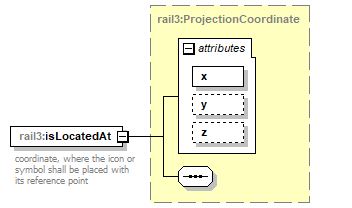 | ||||||||||||||||||||||||
| namespace | https://www.railml.org/schemas/3.1 | ||||||||||||||||||||||||
| type | rail3:ProjectionCoordinate | ||||||||||||||||||||||||
| properties |
| ||||||||||||||||||||||||
| attributes |
| ||||||||||||||||||||||||
| annotation |
| ||||||||||||||||||||||||
| source | <xs:element name="isLocatedAt" type="rail3:ProjectionCoordinate" minOccurs="1" maxOccurs="1"> <xs:annotation> <xs:documentation>coordinate, where the icon or symbol shall be placed with its reference point</xs:documentation> </xs:annotation> </xs:element> |
complexType ElementState
| diagram | 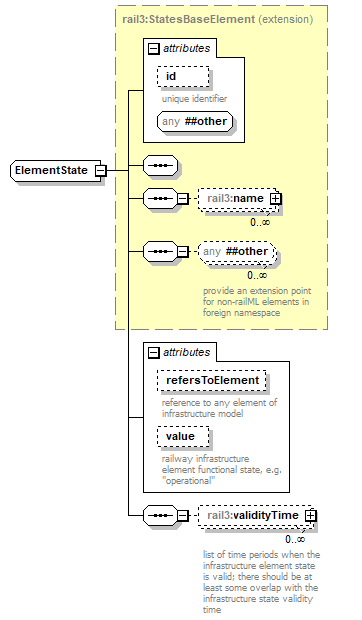 | ||||||||||||||||||||||||||||||
| namespace | https://www.railml.org/schemas/3.1 | ||||||||||||||||||||||||||||||
| type | extension of rail3:StatesBaseElement | ||||||||||||||||||||||||||||||
| properties |
| ||||||||||||||||||||||||||||||
| children | rail3:name rail3:validityTime | ||||||||||||||||||||||||||||||
| used by |
| ||||||||||||||||||||||||||||||
| attributes |
| ||||||||||||||||||||||||||||||
| source | <xs:complexType name="ElementState"> <xs:complexContent> <xs:extension base="rail3:StatesBaseElement"> <xs:sequence> <xs:element name="validityTime" type="rail3:Period" minOccurs="0" maxOccurs="unbounded"> <xs:annotation> <xs:documentation>list of time periods when the infrastructure element state is valid; there should be at least some overlap with the infrastructure state validity time</xs:documentation> </xs:annotation> </xs:element> </xs:sequence> <xs:attribute name="refersToElement" type="rail3:tRef" use="optional"> <xs:annotation> <xs:documentation>reference to any element of infrastructure model</xs:documentation> </xs:annotation> </xs:attribute> <xs:attribute name="value" type="rail3:tInfrastructureStateExt" use="optional"> <xs:annotation> <xs:documentation>railway infrastructure element functional state, e.g. "operational"</xs:documentation> </xs:annotation> </xs:attribute> </xs:extension> </xs:complexContent> </xs:complexType> |
attribute ElementState/@refersToElement
| type | rail3:tRef | ||
| properties |
| ||
| annotation |
| ||
| source | <xs:attribute name="refersToElement" type="rail3:tRef" use="optional"> <xs:annotation> <xs:documentation>reference to any element of infrastructure model</xs:documentation> </xs:annotation> </xs:attribute> |
attribute ElementState/@value
| type | rail3:tInfrastructureStateExt | ||
| properties |
| ||
| annotation |
| ||
| source | <xs:attribute name="value" type="rail3:tInfrastructureStateExt" use="optional"> <xs:annotation> <xs:documentation>railway infrastructure element functional state, e.g. "operational"</xs:documentation> </xs:annotation> </xs:attribute> |
element ElementState/validityTime
| diagram | 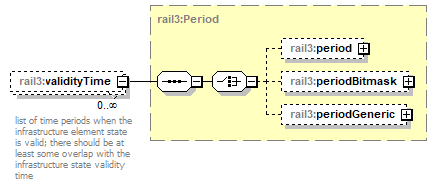 | ||||||
| namespace | https://www.railml.org/schemas/3.1 | ||||||
| type | rail3:Period | ||||||
| properties |
| ||||||
| children | rail3:period rail3:periodBitmask rail3:periodGeneric | ||||||
| annotation |
| ||||||
| source | <xs:element name="validityTime" type="rail3:Period" minOccurs="0" maxOccurs="unbounded"> <xs:annotation> <xs:documentation>list of time periods when the infrastructure element state is valid; there should be at least some overlap with the infrastructure state validity time</xs:documentation> </xs:annotation> </xs:element> |
complexType EnergyCatenary
| diagram | 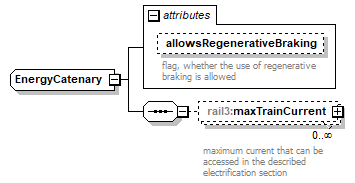 | ||||||||||||||
| namespace | https://www.railml.org/schemas/3.1 | ||||||||||||||
| children | rail3:maxTrainCurrent | ||||||||||||||
| used by |
| ||||||||||||||
| attributes |
| ||||||||||||||
| source | <xs:complexType name="EnergyCatenary"> <xs:sequence> <xs:element name="maxTrainCurrent" type="rail3:MaxTrainCurrent" minOccurs="0" maxOccurs="unbounded"> <xs:annotation> <xs:documentation>maximum current that can be accessed in the described electrification section</xs:documentation> </xs:annotation> </xs:element> </xs:sequence> <xs:attribute name="allowsRegenerativeBraking" type="xs:boolean" use="optional"> <xs:annotation> <xs:documentation>flag, whether the use of regenerative braking is allowed</xs:documentation> </xs:annotation> </xs:attribute> </xs:complexType> |
attribute EnergyCatenary/@allowsRegenerativeBraking
| type | xs:boolean | ||
| properties |
| ||
| annotation |
| ||
| source | <xs:attribute name="allowsRegenerativeBraking" type="xs:boolean" use="optional"> <xs:annotation> <xs:documentation>flag, whether the use of regenerative braking is allowed</xs:documentation> </xs:annotation> </xs:attribute> |
element EnergyCatenary/maxTrainCurrent
| diagram | 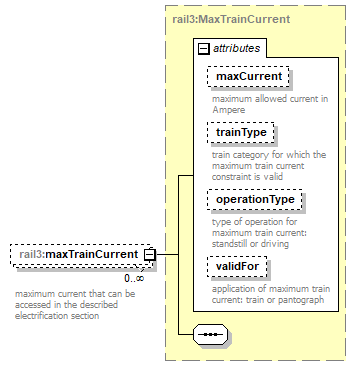 | ||||||||||||||||||||||||||||||||||||||
| namespace | https://www.railml.org/schemas/3.1 | ||||||||||||||||||||||||||||||||||||||
| type | rail3:MaxTrainCurrent | ||||||||||||||||||||||||||||||||||||||
| properties |
| ||||||||||||||||||||||||||||||||||||||
| attributes |
| ||||||||||||||||||||||||||||||||||||||
| annotation |
| ||||||||||||||||||||||||||||||||||||||
| source | <xs:element name="maxTrainCurrent" type="rail3:MaxTrainCurrent" minOccurs="0" maxOccurs="unbounded"> <xs:annotation> <xs:documentation>maximum current that can be accessed in the described electrification section</xs:documentation> </xs:annotation> </xs:element> |
complexType EnergyPantograph
| diagram | 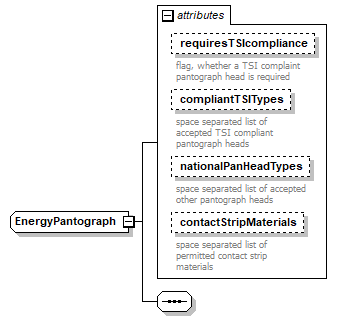 | ||||||||||||||||||||||||||||||||||||||
| namespace | https://www.railml.org/schemas/3.1 | ||||||||||||||||||||||||||||||||||||||
| used by |
| ||||||||||||||||||||||||||||||||||||||
| attributes |
| ||||||||||||||||||||||||||||||||||||||
| source | <xs:complexType name="EnergyPantograph"> <xs:sequence/> <xs:attribute name="requiresTSIcompliance" type="xs:boolean" use="optional"> <xs:annotation> <xs:documentation>flag, whether a TSI complaint pantograph head is required</xs:documentation> </xs:annotation> </xs:attribute> <xs:attribute name="compliantTSITypes" type="rail3:tTSIPantoHeadTypeList" use="optional"> <xs:annotation> <xs:documentation>space separated list of accepted TSI compliant pantograph heads</xs:documentation> </xs:annotation> </xs:attribute> <xs:attribute name="nationalPanHeadTypes" type="rail3:tPantoHeadTypeList" use="optional"> <xs:annotation> <xs:documentation>space separated list of accepted other pantograph heads</xs:documentation> </xs:annotation> </xs:attribute> <xs:attribute name="contactStripMaterials" type="rail3:tContactStripMaterialList" use="optional"> <xs:annotation> <xs:documentation>space separated list of permitted contact strip materials</xs:documentation> </xs:annotation> </xs:attribute> </xs:complexType> |
attribute EnergyPantograph/@requiresTSIcompliance
| type | xs:boolean | ||
| properties |
| ||
| annotation |
| ||
| source | <xs:attribute name="requiresTSIcompliance" type="xs:boolean" use="optional"> <xs:annotation> <xs:documentation>flag, whether a TSI complaint pantograph head is required</xs:documentation> </xs:annotation> </xs:attribute> |
attribute EnergyPantograph/@compliantTSITypes
| type | rail3:tTSIPantoHeadTypeList | ||
| properties |
| ||
| annotation |
| ||
| source | <xs:attribute name="compliantTSITypes" type="rail3:tTSIPantoHeadTypeList" use="optional"> <xs:annotation> <xs:documentation>space separated list of accepted TSI compliant pantograph heads</xs:documentation> </xs:annotation> </xs:attribute> |
attribute EnergyPantograph/@nationalPanHeadTypes
| type | rail3:tPantoHeadTypeList | ||
| properties |
| ||
| annotation |
| ||
| source | <xs:attribute name="nationalPanHeadTypes" type="rail3:tPantoHeadTypeList" use="optional"> <xs:annotation> <xs:documentation>space separated list of accepted other pantograph heads</xs:documentation> </xs:annotation> </xs:attribute> |
attribute EnergyPantograph/@contactStripMaterials
| type | rail3:tContactStripMaterialList | ||
| properties |
| ||
| annotation |
| ||
| source | <xs:attribute name="contactStripMaterials" type="rail3:tContactStripMaterialList" use="optional"> <xs:annotation> <xs:documentation>space separated list of permitted contact strip materials</xs:documentation> </xs:annotation> </xs:attribute> |
complexType EnergyRollingstock
| diagram | 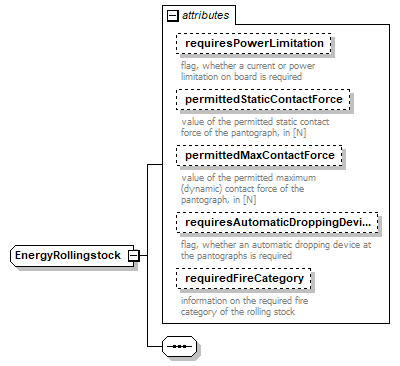 | ||||||||||||||||||||||||||||||||||||||||||||||
| namespace | https://www.railml.org/schemas/3.1 | ||||||||||||||||||||||||||||||||||||||||||||||
| used by |
| ||||||||||||||||||||||||||||||||||||||||||||||
| attributes |
| ||||||||||||||||||||||||||||||||||||||||||||||
| source | <xs:complexType name="EnergyRollingstock"> <xs:sequence/> <xs:attribute name="requiresPowerLimitation" type="xs:boolean" use="optional"> <xs:annotation> <xs:documentation>flag, whether a current or power limitation on board is required</xs:documentation> </xs:annotation> </xs:attribute> <xs:attribute name="permittedStaticContactForce" type="rail3:tForceN" use="optional"> <xs:annotation> <xs:documentation>value of the permitted static contact force of the pantograph, in [N]</xs:documentation> </xs:annotation> </xs:attribute> <xs:attribute name="permittedMaxContactForce" type="rail3:tForceN" use="optional"> <xs:annotation> <xs:documentation>value of the permitted maximum (dynamic) contact force of the pantograph, in [N]</xs:documentation> </xs:annotation> </xs:attribute> <xs:attribute name="requiresAutomaticDroppingDevice" type="xs:boolean" use="optional"> <xs:annotation> <xs:documentation>flag, whether an automatic dropping device at the pantographs is required</xs:documentation> </xs:annotation> </xs:attribute> <xs:attribute name="requiredFireCategory" type="rail3:tRSFireCategoryType" use="optional"> <xs:annotation> <xs:documentation>information on the required fire category of the rolling stock</xs:documentation> </xs:annotation> </xs:attribute> </xs:complexType> |
attribute EnergyRollingstock/@requiresPowerLimitation
| type | xs:boolean | ||
| properties |
| ||
| annotation |
| ||
| source | <xs:attribute name="requiresPowerLimitation" type="xs:boolean" use="optional"> <xs:annotation> <xs:documentation>flag, whether a current or power limitation on board is required</xs:documentation> </xs:annotation> </xs:attribute> |
attribute EnergyRollingstock/@permittedStaticContactForce
| type | rail3:tForceN | ||
| properties |
| ||
| annotation |
| ||
| source | <xs:attribute name="permittedStaticContactForce" type="rail3:tForceN" use="optional"> <xs:annotation> <xs:documentation>value of the permitted static contact force of the pantograph, in [N]</xs:documentation> </xs:annotation> </xs:attribute> |
attribute EnergyRollingstock/@permittedMaxContactForce
| type | rail3:tForceN | ||
| properties |
| ||
| annotation |
| ||
| source | <xs:attribute name="permittedMaxContactForce" type="rail3:tForceN" use="optional"> <xs:annotation> <xs:documentation>value of the permitted maximum (dynamic) contact force of the pantograph, in [N]</xs:documentation> </xs:annotation> </xs:attribute> |
attribute EnergyRollingstock/@requiresAutomaticDroppingDevice
| type | xs:boolean | ||
| properties |
| ||
| annotation |
| ||
| source | <xs:attribute name="requiresAutomaticDroppingDevice" type="xs:boolean" use="optional"> <xs:annotation> <xs:documentation>flag, whether an automatic dropping device at the pantographs is required</xs:documentation> </xs:annotation> </xs:attribute> |
attribute EnergyRollingstock/@requiredFireCategory
| type | rail3:tRSFireCategoryType | ||||||||||||
| properties |
| ||||||||||||
| facets |
| ||||||||||||
| annotation |
| ||||||||||||
| source | <xs:attribute name="requiredFireCategory" type="rail3:tRSFireCategoryType" use="optional"> <xs:annotation> <xs:documentation>information on the required fire category of the rolling stock</xs:documentation> </xs:annotation> </xs:attribute> |
complexType EntityIS
| diagram | 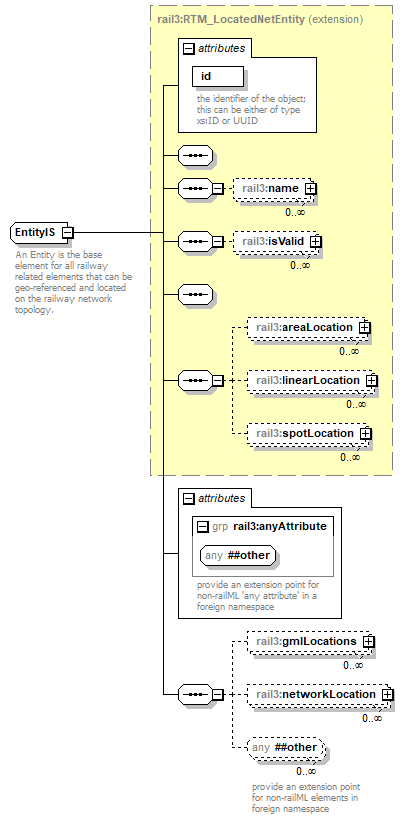 | ||||||||||||||
| namespace | https://www.railml.org/schemas/3.1 | ||||||||||||||
| type | extension of rail3:RTM_LocatedNetEntity | ||||||||||||||
| properties |
| ||||||||||||||
| children | rail3:name rail3:isValid rail3:areaLocation rail3:linearLocation rail3:spotLocation rail3:gmlLocations rail3:networkLocation | ||||||||||||||
| used by |
| ||||||||||||||
| attributes |
| ||||||||||||||
| annotation |
| ||||||||||||||
| source | <xs:complexType name="EntityIS" abstract="true"> <xs:annotation> <xs:documentation>An Entity is the base element for all railway related elements that can be geo-referenced and located on the railway network topology.</xs:documentation> </xs:annotation> <xs:complexContent> <xs:extension base="rail3:RTM_LocatedNetEntity"> <xs:sequence> <xs:element name="gmlLocations" type="rail3:GmlLocations" minOccurs="0" maxOccurs="unbounded"/> <xs:element name="networkLocation" type="rail3:LocationNetwork" minOccurs="0" maxOccurs="unbounded"/> <xs:any namespace="##other" processContents="strict" minOccurs="0" maxOccurs="unbounded"> <xs:annotation> <xs:documentation>provide an extension point for non-railML elements in foreign namespace</xs:documentation> </xs:annotation> </xs:any> </xs:sequence> <xs:attributeGroup ref="rail3:anyAttribute"/> </xs:extension> </xs:complexContent> </xs:complexType> |
element EntityIS/gmlLocations
| diagram | 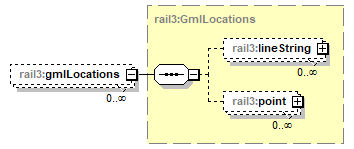 | ||||||
| namespace | https://www.railml.org/schemas/3.1 | ||||||
| type | rail3:GmlLocations | ||||||
| properties |
| ||||||
| children | rail3:lineString rail3:point | ||||||
| source | <xs:element name="gmlLocations" type="rail3:GmlLocations" minOccurs="0" maxOccurs="unbounded"/> |
element EntityIS/networkLocation
| diagram | 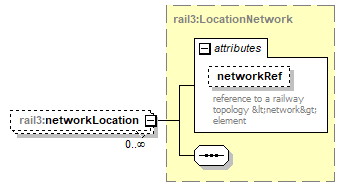 | ||||||||||||||
| namespace | https://www.railml.org/schemas/3.1 | ||||||||||||||
| type | rail3:LocationNetwork | ||||||||||||||
| properties |
| ||||||||||||||
| attributes |
| ||||||||||||||
| source | <xs:element name="networkLocation" type="rail3:LocationNetwork" minOccurs="0" maxOccurs="unbounded"/> |
complexType FunctionalInfrastructure
| diagram |  | ||
| namespace | https://www.railml.org/schemas/3.1 | ||
| children | rail3:balises rail3:borders rail3:bufferStops rail3:crossings rail3:derailersIS rail3:electrifications rail3:keyLocksIS rail3:levelCrossingsIS rail3:lines rail3:loadingGauges rail3:operationalPoints rail3:overCrossings rail3:platforms rail3:restrictionAreas rail3:serviceSections rail3:signalsIS rail3:speeds rail3:stoppingPlaces rail3:switchesIS rail3:tracks rail3:trackBeds rail3:trackGauges rail3:trainDetectionElements rail3:trainProtectionElements rail3:trainRadios rail3:underCrossings rail3:weightLimits | ||
| used by |
| ||
| annotation |
| ||
| source | <xs:complexType name="FunctionalInfrastructure"> <xs:annotation> <xs:documentation>This is the top level element for railML3 functional infrastructure model.</xs:documentation> </xs:annotation> <xs:sequence> <xs:element name="balises" type="rail3:Balises" minOccurs="0" maxOccurs="1"> <xs:annotation> <xs:documentation>container element for all balise (and balise group) elements</xs:documentation> </xs:annotation> </xs:element> <xs:element name="borders" type="rail3:Borders" minOccurs="0" maxOccurs="1"> <xs:annotation> <xs:documentation>container element for all border elements</xs:documentation> </xs:annotation> </xs:element> <xs:element name="bufferStops" type="rail3:BufferStops" minOccurs="0" maxOccurs="1"> <xs:annotation> <xs:documentation>container element for all bufferStop elements</xs:documentation> </xs:annotation> </xs:element> <xs:element name="crossings" type="rail3:Crossings" minOccurs="0" maxOccurs="1"> <xs:annotation> <xs:documentation>container element for all crossing elements</xs:documentation> </xs:annotation> </xs:element> <xs:element name="derailersIS" type="rail3:DerailersIS" minOccurs="0" maxOccurs="1"> <xs:annotation> <xs:documentation>container element for all derailer elements</xs:documentation> </xs:annotation> </xs:element> <xs:element name="electrifications" type="rail3:Electrifications" minOccurs="0" maxOccurs="1"> <xs:annotation> <xs:documentation>container element for all electrification elements incl. electrification system components</xs:documentation> </xs:annotation> </xs:element> <xs:element name="keyLocksIS" type="rail3:KeyLocksIS" minOccurs="0" maxOccurs="1"> <xs:annotation> <xs:documentation>container element for all keyLock elements</xs:documentation> </xs:annotation> </xs:element> <xs:element name="levelCrossingsIS" type="rail3:LevelCrossingsIS" minOccurs="0" maxOccurs="1"> <xs:annotation> <xs:documentation>container element for all levelCrossing elements</xs:documentation> </xs:annotation> </xs:element> <xs:element name="lines" type="rail3:Lines" minOccurs="0" maxOccurs="1"> <xs:annotation> <xs:documentation>container element for all line (section) elements</xs:documentation> </xs:annotation> </xs:element> <xs:element name="loadingGauges" type="rail3:LoadingGauges" minOccurs="0" maxOccurs="1"> <xs:annotation> <xs:documentation>container element for all loadingGauge elements</xs:documentation> </xs:annotation> </xs:element> <xs:element name="operationalPoints" type="rail3:OperationalPoints" minOccurs="0" maxOccurs="1"> <xs:annotation> <xs:documentation>container element for all operationalPoint elements</xs:documentation> </xs:annotation> </xs:element> <xs:element name="overCrossings" type="rail3:OverCrossings" minOccurs="0" maxOccurs="1"> <xs:annotation> <xs:documentation>container element for all overCrossing elements</xs:documentation> </xs:annotation> </xs:element> <xs:element name="platforms" type="rail3:Platforms" minOccurs="0" maxOccurs="1"> <xs:annotation> <xs:documentation>container element for all platform (and platform edge) elements</xs:documentation> </xs:annotation> </xs:element> <xs:element name="restrictionAreas" type="rail3:RestrictionAreas" minOccurs="0" maxOccurs="1"> <xs:annotation> <xs:documentation>container element for all restrictionArea elements</xs:documentation> </xs:annotation> </xs:element> <xs:element name="serviceSections" type="rail3:ServiceSections" minOccurs="0" maxOccurs="1"> <xs:annotation> <xs:documentation>container element for all serviceSection elements</xs:documentation> </xs:annotation> </xs:element> <xs:element name="signalsIS" type="rail3:SignalsIS" minOccurs="0" maxOccurs="1"> <xs:annotation> <xs:documentation>container element for all signal (and panel) elements</xs:documentation> </xs:annotation> </xs:element> <xs:element name="speeds" type="rail3:Speeds" minOccurs="0" maxOccurs="1"> <xs:annotation> <xs:documentation>container element for all line/track speed related elements</xs:documentation> </xs:annotation> </xs:element> <xs:element name="stoppingPlaces" type="rail3:StoppingPlaces" minOccurs="0" maxOccurs="1"> <xs:annotation> <xs:documentation>container element for all stoppingPlace elements</xs:documentation> </xs:annotation> </xs:element> <xs:element name="switchesIS" type="rail3:SwitchesIS" minOccurs="0" maxOccurs="1"> <xs:annotation> <xs:documentation>container element for all switch elements</xs:documentation> </xs:annotation> </xs:element> <xs:element name="tracks" type="rail3:Tracks" minOccurs="0" maxOccurs="1"> <xs:annotation> <xs:documentation>container element for all track elements</xs:documentation> </xs:annotation> </xs:element> <xs:element name="trackBeds" type="rail3:TrackBeds" minOccurs="0" maxOccurs="1"> <xs:annotation> <xs:documentation>container element for all trackBed elements</xs:documentation> </xs:annotation> </xs:element> <xs:element name="trackGauges" type="rail3:TrackGauges" minOccurs="0" maxOccurs="1"> <xs:annotation> <xs:documentation>container element for all trackGauge elements</xs:documentation> </xs:annotation> </xs:element> <xs:element name="trainDetectionElements" type="rail3:TrainDetectionElements" minOccurs="0" maxOccurs="1"> <xs:annotation> <xs:documentation>container element for all trainDetectionElement elements</xs:documentation> </xs:annotation> </xs:element> <xs:element name="trainProtectionElements" type="rail3:TrainProtectionElements" minOccurs="0" maxOccurs="1"> <xs:annotation> <xs:documentation>container element for all trainProtectionElement elements</xs:documentation> </xs:annotation> </xs:element> <xs:element name="trainRadios" type="rail3:TrainRadios" minOccurs="0" maxOccurs="1"> <xs:annotation> <xs:documentation>container element for all trainRadio elements</xs:documentation> </xs:annotation> </xs:element> <xs:element name="underCrossings" type="rail3:UnderCrossings" minOccurs="0" maxOccurs="1"> <xs:annotation> <xs:documentation>container element for all underCrossing elements</xs:documentation> </xs:annotation> </xs:element> <xs:element name="weightLimits" type="rail3:WeightLimits" minOccurs="0" maxOccurs="1"> <xs:annotation> <xs:documentation>container element for all weightLimit (axle load, meterload) elements</xs:documentation> </xs:annotation> </xs:element> <xs:any namespace="##other" processContents="strict" minOccurs="0" maxOccurs="unbounded"> <xs:annotation> <xs:documentation>provide an extension point for non-railML elements in foreign namespace</xs:documentation> </xs:annotation> </xs:any> </xs:sequence> </xs:complexType> |
element FunctionalInfrastructure/balises
| diagram | 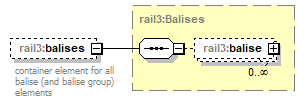 | ||||||
| namespace | https://www.railml.org/schemas/3.1 | ||||||
| type | rail3:Balises | ||||||
| properties |
| ||||||
| children | rail3:balise | ||||||
| annotation |
| ||||||
| source | <xs:element name="balises" type="rail3:Balises" minOccurs="0" maxOccurs="1"> <xs:annotation> <xs:documentation>container element for all balise (and balise group) elements</xs:documentation> </xs:annotation> </xs:element> |
element FunctionalInfrastructure/borders
| diagram |  | ||||||
| namespace | https://www.railml.org/schemas/3.1 | ||||||
| type | rail3:Borders | ||||||
| properties |
| ||||||
| children | rail3:border | ||||||
| annotation |
| ||||||
| source | <xs:element name="borders" type="rail3:Borders" minOccurs="0" maxOccurs="1"> <xs:annotation> <xs:documentation>container element for all border elements</xs:documentation> </xs:annotation> </xs:element> |
element FunctionalInfrastructure/bufferStops
| diagram |  | ||||||
| namespace | https://www.railml.org/schemas/3.1 | ||||||
| type | rail3:BufferStops | ||||||
| properties |
| ||||||
| children | rail3:bufferStop | ||||||
| annotation |
| ||||||
| source | <xs:element name="bufferStops" type="rail3:BufferStops" minOccurs="0" maxOccurs="1"> <xs:annotation> <xs:documentation>container element for all bufferStop elements</xs:documentation> </xs:annotation> </xs:element> |
element FunctionalInfrastructure/crossings
| diagram |  | ||||||
| namespace | https://www.railml.org/schemas/3.1 | ||||||
| type | rail3:Crossings | ||||||
| properties |
| ||||||
| children | rail3:crossing | ||||||
| annotation |
| ||||||
| source | <xs:element name="crossings" type="rail3:Crossings" minOccurs="0" maxOccurs="1"> <xs:annotation> <xs:documentation>container element for all crossing elements</xs:documentation> </xs:annotation> </xs:element> |
element FunctionalInfrastructure/derailersIS
| diagram |  | ||||||
| namespace | https://www.railml.org/schemas/3.1 | ||||||
| type | rail3:DerailersIS | ||||||
| properties |
| ||||||
| children | rail3:derailerIS | ||||||
| annotation |
| ||||||
| source | <xs:element name="derailersIS" type="rail3:DerailersIS" minOccurs="0" maxOccurs="1"> <xs:annotation> <xs:documentation>container element for all derailer elements</xs:documentation> </xs:annotation> </xs:element> |
element FunctionalInfrastructure/electrifications
| diagram |  | ||||||
| namespace | https://www.railml.org/schemas/3.1 | ||||||
| type | rail3:Electrifications | ||||||
| properties |
| ||||||
| children | rail3:electrificationSection | ||||||
| annotation |
| ||||||
| source | <xs:element name="electrifications" type="rail3:Electrifications" minOccurs="0" maxOccurs="1"> <xs:annotation> <xs:documentation>container element for all electrification elements incl. electrification system components</xs:documentation> </xs:annotation> </xs:element> |
element FunctionalInfrastructure/keyLocksIS
| diagram |  | ||||||
| namespace | https://www.railml.org/schemas/3.1 | ||||||
| type | rail3:KeyLocksIS | ||||||
| properties |
| ||||||
| children | rail3:keyLockIS | ||||||
| annotation |
| ||||||
| source | <xs:element name="keyLocksIS" type="rail3:KeyLocksIS" minOccurs="0" maxOccurs="1"> <xs:annotation> <xs:documentation>container element for all keyLock elements</xs:documentation> </xs:annotation> </xs:element> |
element FunctionalInfrastructure/levelCrossingsIS
| diagram |  | ||||||
| namespace | https://www.railml.org/schemas/3.1 | ||||||
| type | rail3:LevelCrossingsIS | ||||||
| properties |
| ||||||
| children | rail3:levelCrossingIS | ||||||
| annotation |
| ||||||
| source | <xs:element name="levelCrossingsIS" type="rail3:LevelCrossingsIS" minOccurs="0" maxOccurs="1"> <xs:annotation> <xs:documentation>container element for all levelCrossing elements</xs:documentation> </xs:annotation> </xs:element> |
element FunctionalInfrastructure/lines
| diagram |  | ||||||
| namespace | https://www.railml.org/schemas/3.1 | ||||||
| type | rail3:Lines | ||||||
| properties |
| ||||||
| children | rail3:line | ||||||
| annotation |
| ||||||
| source | <xs:element name="lines" type="rail3:Lines" minOccurs="0" maxOccurs="1"> <xs:annotation> <xs:documentation>container element for all line (section) elements</xs:documentation> </xs:annotation> </xs:element> |
element FunctionalInfrastructure/loadingGauges
| diagram |  | ||||||
| namespace | https://www.railml.org/schemas/3.1 | ||||||
| type | rail3:LoadingGauges | ||||||
| properties |
| ||||||
| children | rail3:loadingGauge | ||||||
| annotation |
| ||||||
| source | <xs:element name="loadingGauges" type="rail3:LoadingGauges" minOccurs="0" maxOccurs="1"> <xs:annotation> <xs:documentation>container element for all loadingGauge elements</xs:documentation> </xs:annotation> </xs:element> |
element FunctionalInfrastructure/operationalPoints
| diagram |  | ||||||
| namespace | https://www.railml.org/schemas/3.1 | ||||||
| type | rail3:OperationalPoints | ||||||
| properties |
| ||||||
| children | rail3:operationalPoint | ||||||
| annotation |
| ||||||
| source | <xs:element name="operationalPoints" type="rail3:OperationalPoints" minOccurs="0" maxOccurs="1"> <xs:annotation> <xs:documentation>container element for all operationalPoint elements</xs:documentation> </xs:annotation> </xs:element> |
element FunctionalInfrastructure/overCrossings
| diagram |  | ||||||
| namespace | https://www.railml.org/schemas/3.1 | ||||||
| type | rail3:OverCrossings | ||||||
| properties |
| ||||||
| children | rail3:overCrossing | ||||||
| annotation |
| ||||||
| source | <xs:element name="overCrossings" type="rail3:OverCrossings" minOccurs="0" maxOccurs="1"> <xs:annotation> <xs:documentation>container element for all overCrossing elements</xs:documentation> </xs:annotation> </xs:element> |
element FunctionalInfrastructure/platforms
| diagram |  | ||||||
| namespace | https://www.railml.org/schemas/3.1 | ||||||
| type | rail3:Platforms | ||||||
| properties |
| ||||||
| children | rail3:platform | ||||||
| annotation |
| ||||||
| source | <xs:element name="platforms" type="rail3:Platforms" minOccurs="0" maxOccurs="1"> <xs:annotation> <xs:documentation>container element for all platform (and platform edge) elements</xs:documentation> </xs:annotation> </xs:element> |
element FunctionalInfrastructure/restrictionAreas
| diagram |  | ||||||
| namespace | https://www.railml.org/schemas/3.1 | ||||||
| type | rail3:RestrictionAreas | ||||||
| properties |
| ||||||
| children | rail3:restrictionArea | ||||||
| annotation |
| ||||||
| source | <xs:element name="restrictionAreas" type="rail3:RestrictionAreas" minOccurs="0" maxOccurs="1"> <xs:annotation> <xs:documentation>container element for all restrictionArea elements</xs:documentation> </xs:annotation> </xs:element> |
element FunctionalInfrastructure/serviceSections
| diagram |  | ||||||
| namespace | https://www.railml.org/schemas/3.1 | ||||||
| type | rail3:ServiceSections | ||||||
| properties |
| ||||||
| children | rail3:serviceSection | ||||||
| annotation |
| ||||||
| source | <xs:element name="serviceSections" type="rail3:ServiceSections" minOccurs="0" maxOccurs="1"> <xs:annotation> <xs:documentation>container element for all serviceSection elements</xs:documentation> </xs:annotation> </xs:element> |
element FunctionalInfrastructure/signalsIS
| diagram |  | ||||||
| namespace | https://www.railml.org/schemas/3.1 | ||||||
| type | rail3:SignalsIS | ||||||
| properties |
| ||||||
| children | rail3:signalIS | ||||||
| annotation |
| ||||||
| source | <xs:element name="signalsIS" type="rail3:SignalsIS" minOccurs="0" maxOccurs="1"> <xs:annotation> <xs:documentation>container element for all signal (and panel) elements</xs:documentation> </xs:annotation> </xs:element> |
element FunctionalInfrastructure/speeds
| diagram |  | ||||||
| namespace | https://www.railml.org/schemas/3.1 | ||||||
| type | rail3:Speeds | ||||||
| properties |
| ||||||
| children | rail3:speedSection | ||||||
| annotation |
| ||||||
| source | <xs:element name="speeds" type="rail3:Speeds" minOccurs="0" maxOccurs="1"> <xs:annotation> <xs:documentation>container element for all line/track speed related elements</xs:documentation> </xs:annotation> </xs:element> |
element FunctionalInfrastructure/stoppingPlaces
| diagram |  | ||||||
| namespace | https://www.railml.org/schemas/3.1 | ||||||
| type | rail3:StoppingPlaces | ||||||
| properties |
| ||||||
| children | rail3:stoppingPlace | ||||||
| annotation |
| ||||||
| source | <xs:element name="stoppingPlaces" type="rail3:StoppingPlaces" minOccurs="0" maxOccurs="1"> <xs:annotation> <xs:documentation>container element for all stoppingPlace elements</xs:documentation> </xs:annotation> </xs:element> |
element FunctionalInfrastructure/switchesIS
| diagram |  | ||||||
| namespace | https://www.railml.org/schemas/3.1 | ||||||
| type | rail3:SwitchesIS | ||||||
| properties |
| ||||||
| children | rail3:switchIS | ||||||
| annotation |
| ||||||
| source | <xs:element name="switchesIS" type="rail3:SwitchesIS" minOccurs="0" maxOccurs="1"> <xs:annotation> <xs:documentation>container element for all switch elements</xs:documentation> </xs:annotation> </xs:element> |
element FunctionalInfrastructure/tracks
| diagram |  | ||||||
| namespace | https://www.railml.org/schemas/3.1 | ||||||
| type | rail3:Tracks | ||||||
| properties |
| ||||||
| children | rail3:track | ||||||
| annotation |
| ||||||
| source | <xs:element name="tracks" type="rail3:Tracks" minOccurs="0" maxOccurs="1"> <xs:annotation> <xs:documentation>container element for all track elements</xs:documentation> </xs:annotation> </xs:element> |
element FunctionalInfrastructure/trackBeds
| diagram |  | ||||||
| namespace | https://www.railml.org/schemas/3.1 | ||||||
| type | rail3:TrackBeds | ||||||
| properties |
| ||||||
| children | rail3:trackBed | ||||||
| annotation |
| ||||||
| source | <xs:element name="trackBeds" type="rail3:TrackBeds" minOccurs="0" maxOccurs="1"> <xs:annotation> <xs:documentation>container element for all trackBed elements</xs:documentation> </xs:annotation> </xs:element> |
element FunctionalInfrastructure/trackGauges
| diagram |  | ||||||
| namespace | https://www.railml.org/schemas/3.1 | ||||||
| type | rail3:TrackGauges | ||||||
| properties |
| ||||||
| children | rail3:trackGauge | ||||||
| annotation |
| ||||||
| source | <xs:element name="trackGauges" type="rail3:TrackGauges" minOccurs="0" maxOccurs="1"> <xs:annotation> <xs:documentation>container element for all trackGauge elements</xs:documentation> </xs:annotation> </xs:element> |
element FunctionalInfrastructure/trainDetectionElements
| diagram |  | ||||||
| namespace | https://www.railml.org/schemas/3.1 | ||||||
| type | rail3:TrainDetectionElements | ||||||
| properties |
| ||||||
| children | rail3:trainDetectionElement | ||||||
| annotation |
| ||||||
| source | <xs:element name="trainDetectionElements" type="rail3:TrainDetectionElements" minOccurs="0" maxOccurs="1"> <xs:annotation> <xs:documentation>container element for all trainDetectionElement elements</xs:documentation> </xs:annotation> </xs:element> |
element FunctionalInfrastructure/trainProtectionElements
| diagram |  | ||||||
| namespace | https://www.railml.org/schemas/3.1 | ||||||
| type | rail3:TrainProtectionElements | ||||||
| properties |
| ||||||
| children | rail3:trainProtectionElement | ||||||
| annotation |
| ||||||
| source | <xs:element name="trainProtectionElements" type="rail3:TrainProtectionElements" minOccurs="0" maxOccurs="1"> <xs:annotation> <xs:documentation>container element for all trainProtectionElement elements</xs:documentation> </xs:annotation> </xs:element> |
element FunctionalInfrastructure/trainRadios
| diagram |  | ||||||
| namespace | https://www.railml.org/schemas/3.1 | ||||||
| type | rail3:TrainRadios | ||||||
| properties |
| ||||||
| children | rail3:trainRadio | ||||||
| annotation |
| ||||||
| source | <xs:element name="trainRadios" type="rail3:TrainRadios" minOccurs="0" maxOccurs="1"> <xs:annotation> <xs:documentation>container element for all trainRadio elements</xs:documentation> </xs:annotation> </xs:element> |
element FunctionalInfrastructure/underCrossings
| diagram |  | ||||||
| namespace | https://www.railml.org/schemas/3.1 | ||||||
| type | rail3:UnderCrossings | ||||||
| properties |
| ||||||
| children | rail3:underCrossing | ||||||
| annotation |
| ||||||
| source | <xs:element name="underCrossings" type="rail3:UnderCrossings" minOccurs="0" maxOccurs="1"> <xs:annotation> <xs:documentation>container element for all underCrossing elements</xs:documentation> </xs:annotation> </xs:element> |
element FunctionalInfrastructure/weightLimits
| diagram |  | ||||||
| namespace | https://www.railml.org/schemas/3.1 | ||||||
| type | rail3:WeightLimits | ||||||
| properties |
| ||||||
| children | rail3:weightLimit | ||||||
| annotation |
| ||||||
| source | <xs:element name="weightLimits" type="rail3:WeightLimits" minOccurs="0" maxOccurs="1"> <xs:annotation> <xs:documentation>container element for all weightLimit (axle load, meterload) elements</xs:documentation> </xs:annotation> </xs:element> |
complexType FunctionalInfrastructureEntity
| diagram | 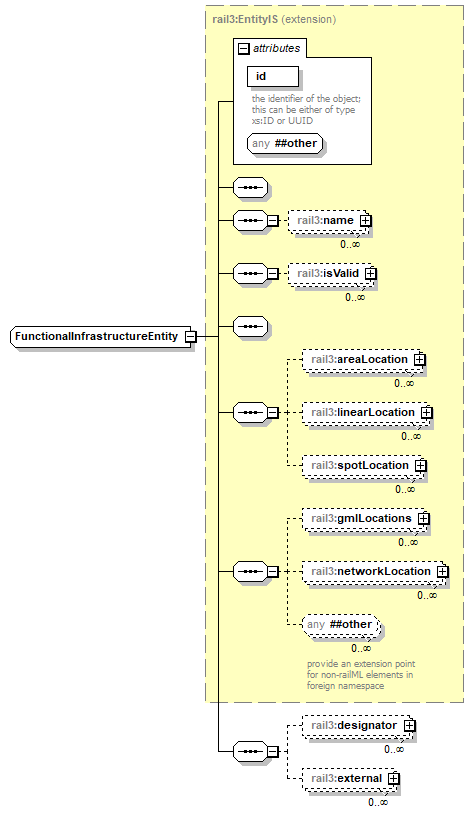 | ||||||||||||||
| namespace | https://www.railml.org/schemas/3.1 | ||||||||||||||
| type | extension of rail3:EntityIS | ||||||||||||||
| properties |
| ||||||||||||||
| children | rail3:name rail3:isValid rail3:areaLocation rail3:linearLocation rail3:spotLocation rail3:gmlLocations rail3:networkLocation rail3:designator rail3:external | ||||||||||||||
| used by |
| ||||||||||||||
| attributes |
| ||||||||||||||
| source | <xs:complexType name="FunctionalInfrastructureEntity" abstract="true"> <xs:complexContent> <xs:extension base="rail3:EntityIS"> <xs:sequence> <xs:element name="designator" type="rail3:Designator" minOccurs="0" maxOccurs="unbounded"/> <xs:element name="external" type="rail3:External" minOccurs="0" maxOccurs="unbounded"/> </xs:sequence> </xs:extension> </xs:complexContent> </xs:complexType> |
element FunctionalInfrastructureEntity/designator
| diagram | 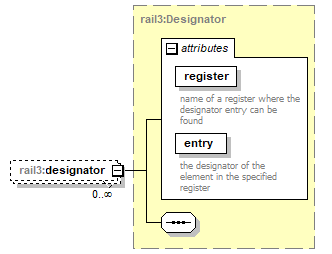 | ||||||||||||||||||||||
| namespace | https://www.railml.org/schemas/3.1 | ||||||||||||||||||||||
| type | rail3:Designator | ||||||||||||||||||||||
| properties |
| ||||||||||||||||||||||
| attributes |
| ||||||||||||||||||||||
| source | <xs:element name="designator" type="rail3:Designator" minOccurs="0" maxOccurs="unbounded"/> |
element FunctionalInfrastructureEntity/external
| diagram | 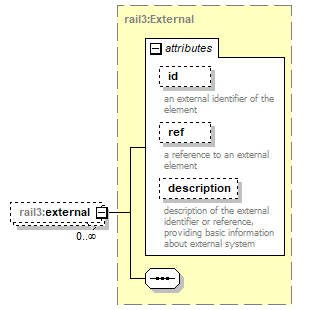 | ||||||||||||||||||||||||||||||
| namespace | https://www.railml.org/schemas/3.1 | ||||||||||||||||||||||||||||||
| type | rail3:External | ||||||||||||||||||||||||||||||
| properties |
| ||||||||||||||||||||||||||||||
| attributes |
| ||||||||||||||||||||||||||||||
| source | <xs:element name="external" type="rail3:External" minOccurs="0" maxOccurs="unbounded"/> |
complexType Geometry
| diagram | 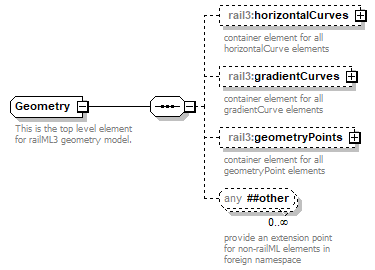 | ||
| namespace | https://www.railml.org/schemas/3.1 | ||
| children | rail3:horizontalCurves rail3:gradientCurves rail3:geometryPoints | ||
| used by |
| ||
| annotation |
| ||
| source | <xs:complexType name="Geometry"> <xs:annotation> <xs:documentation>This is the top level element for railML3 geometry model.</xs:documentation> </xs:annotation> <xs:sequence> <xs:element name="horizontalCurves" type="rail3:HorizontalCurves" minOccurs="0" maxOccurs="1"> <xs:annotation> <xs:documentation>container element for all horizontalCurve elements</xs:documentation> </xs:annotation> </xs:element> <xs:element name="gradientCurves" type="rail3:GradientCurves" minOccurs="0" maxOccurs="1"> <xs:annotation> <xs:documentation>container element for all gradientCurve elements</xs:documentation> </xs:annotation> </xs:element> <xs:element name="geometryPoints" type="rail3:GeometryPoints" minOccurs="0" maxOccurs="1"> <xs:annotation> <xs:documentation>container element for all geometryPoint elements</xs:documentation> </xs:annotation> </xs:element> <xs:any namespace="##other" processContents="strict" minOccurs="0" maxOccurs="unbounded"> <xs:annotation> <xs:documentation>provide an extension point for non-railML elements in foreign namespace</xs:documentation> </xs:annotation> </xs:any> </xs:sequence> </xs:complexType> |
element Geometry/horizontalCurves
| diagram |  | ||||||
| namespace | https://www.railml.org/schemas/3.1 | ||||||
| type | rail3:HorizontalCurves | ||||||
| properties |
| ||||||
| children | rail3:horizontalCurve | ||||||
| annotation |
| ||||||
| source | <xs:element name="horizontalCurves" type="rail3:HorizontalCurves" minOccurs="0" maxOccurs="1"> <xs:annotation> <xs:documentation>container element for all horizontalCurve elements</xs:documentation> </xs:annotation> </xs:element> |
element Geometry/gradientCurves
| diagram |  | ||||||
| namespace | https://www.railml.org/schemas/3.1 | ||||||
| type | rail3:GradientCurves | ||||||
| properties |
| ||||||
| children | rail3:gradientCurve | ||||||
| annotation |
| ||||||
| source | <xs:element name="gradientCurves" type="rail3:GradientCurves" minOccurs="0" maxOccurs="1"> <xs:annotation> <xs:documentation>container element for all gradientCurve elements</xs:documentation> </xs:annotation> </xs:element> |
element Geometry/geometryPoints
| diagram |  | ||||||
| namespace | https://www.railml.org/schemas/3.1 | ||||||
| type | rail3:GeometryPoints | ||||||
| properties |
| ||||||
| children | rail3:geometryPoint | ||||||
| annotation |
| ||||||
| source | <xs:element name="geometryPoints" type="rail3:GeometryPoints" minOccurs="0" maxOccurs="1"> <xs:annotation> <xs:documentation>container element for all geometryPoint elements</xs:documentation> </xs:annotation> </xs:element> |
complexType GeometryCurve
| diagram | 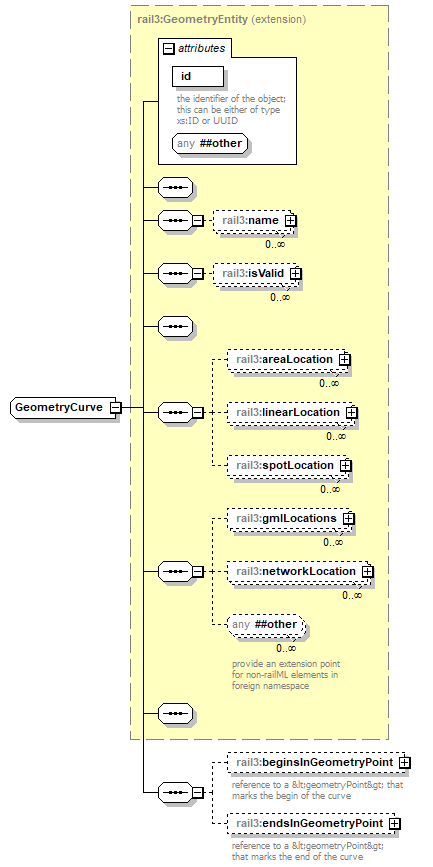 | ||||||||||||||
| namespace | https://www.railml.org/schemas/3.1 | ||||||||||||||
| type | extension of rail3:GeometryEntity | ||||||||||||||
| properties |
| ||||||||||||||
| children | rail3:name rail3:isValid rail3:areaLocation rail3:linearLocation rail3:spotLocation rail3:gmlLocations rail3:networkLocation rail3:beginsInGeometryPoint rail3:endsInGeometryPoint | ||||||||||||||
| used by |
| ||||||||||||||
| attributes |
| ||||||||||||||
| source | <xs:complexType name="GeometryCurve" abstract="true"> <xs:complexContent> <xs:extension base="rail3:GeometryEntity"> <xs:sequence> <xs:element name="beginsInGeometryPoint" type="rail3:tElementWithIDref" minOccurs="0" maxOccurs="1"> <xs:annotation> <xs:documentation>reference to a <geometryPoint> that marks the begin of the curve</xs:documentation> </xs:annotation> </xs:element> <xs:element name="endsInGeometryPoint" type="rail3:tElementWithIDref" minOccurs="0" maxOccurs="1"> <xs:annotation> <xs:documentation>reference to a <geometryPoint> that marks the end of the curve</xs:documentation> </xs:annotation> </xs:element> </xs:sequence> </xs:extension> </xs:complexContent> </xs:complexType> |
element GeometryCurve/beginsInGeometryPoint
| diagram | 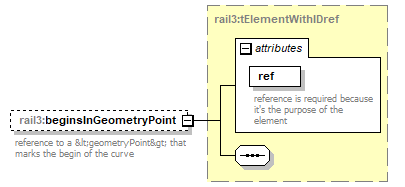 | ||||||||||||||
| namespace | https://www.railml.org/schemas/3.1 | ||||||||||||||
| type | rail3:tElementWithIDref | ||||||||||||||
| properties |
| ||||||||||||||
| attributes |
| ||||||||||||||
| annotation |
| ||||||||||||||
| source | <xs:element name="beginsInGeometryPoint" type="rail3:tElementWithIDref" minOccurs="0" maxOccurs="1"> <xs:annotation> <xs:documentation>reference to a <geometryPoint> that marks the begin of the curve</xs:documentation> </xs:annotation> </xs:element> |
element GeometryCurve/endsInGeometryPoint
| diagram | 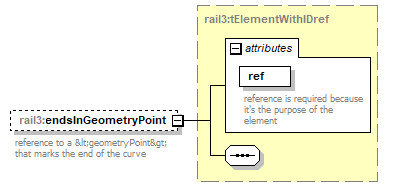 | ||||||||||||||
| namespace | https://www.railml.org/schemas/3.1 | ||||||||||||||
| type | rail3:tElementWithIDref | ||||||||||||||
| properties |
| ||||||||||||||
| attributes |
| ||||||||||||||
| annotation |
| ||||||||||||||
| source | <xs:element name="endsInGeometryPoint" type="rail3:tElementWithIDref" minOccurs="0" maxOccurs="1"> <xs:annotation> <xs:documentation>reference to a <geometryPoint> that marks the end of the curve</xs:documentation> </xs:annotation> </xs:element> |
complexType GeometryEntity
| diagram | 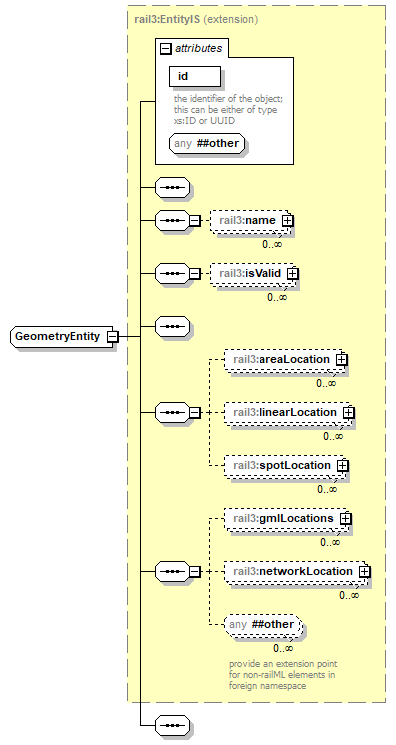 | ||||||||||||||
| namespace | https://www.railml.org/schemas/3.1 | ||||||||||||||
| type | extension of rail3:EntityIS | ||||||||||||||
| properties |
| ||||||||||||||
| children | rail3:name rail3:isValid rail3:areaLocation rail3:linearLocation rail3:spotLocation rail3:gmlLocations rail3:networkLocation | ||||||||||||||
| used by |
| ||||||||||||||
| attributes |
| ||||||||||||||
| source | <xs:complexType name="GeometryEntity" abstract="true"> <xs:complexContent> <xs:extension base="rail3:EntityIS"> <xs:sequence/> </xs:extension> </xs:complexContent> </xs:complexType> |
complexType GeometryPoint
| diagram | 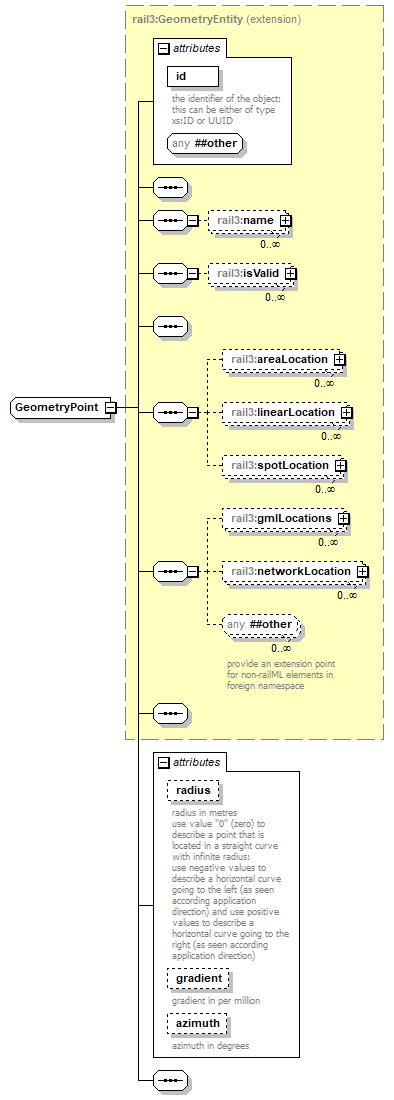 | ||||||||||||||||||||||||||||||||||||||
| namespace | https://www.railml.org/schemas/3.1 | ||||||||||||||||||||||||||||||||||||||
| type | extension of rail3:GeometryEntity | ||||||||||||||||||||||||||||||||||||||
| properties |
| ||||||||||||||||||||||||||||||||||||||
| children | rail3:name rail3:isValid rail3:areaLocation rail3:linearLocation rail3:spotLocation rail3:gmlLocations rail3:networkLocation | ||||||||||||||||||||||||||||||||||||||
| used by |
| ||||||||||||||||||||||||||||||||||||||
| attributes |
| ||||||||||||||||||||||||||||||||||||||
| source | <xs:complexType name="GeometryPoint"> <xs:complexContent> <xs:extension base="rail3:GeometryEntity"> <xs:sequence/> <xs:attribute name="radius" type="rail3:tLengthM" use="optional"> <xs:annotation> <xs:documentation>radius in metres use value "0" (zero) to describe a point that is located in a straight curve with infinite radius; use negative values to describe a horizontal curve going to the left (as seen according application direction) and use positive values to describe a horizontal curve going to the right (as seen according application direction)</xs:documentation> </xs:annotation> </xs:attribute> <xs:attribute name="gradient" type="rail3:tGradientPerMille" use="optional"> <xs:annotation> <xs:documentation>gradient in per million</xs:documentation> </xs:annotation> </xs:attribute> <xs:attribute name="azimuth" type="rail3:tAngleDeg" use="optional"> <xs:annotation> <xs:documentation>azimuth in degrees</xs:documentation> </xs:annotation> </xs:attribute> </xs:extension> </xs:complexContent> </xs:complexType> |
attribute GeometryPoint/@radius
| type | rail3:tLengthM | ||
| properties |
| ||
| annotation |
| ||
| source | <xs:attribute name="radius" type="rail3:tLengthM" use="optional"> <xs:annotation> <xs:documentation>radius in metres use value "0" (zero) to describe a point that is located in a straight curve with infinite radius; use negative values to describe a horizontal curve going to the left (as seen according application direction) and use positive values to describe a horizontal curve going to the right (as seen according application direction)</xs:documentation> </xs:annotation> </xs:attribute> |
attribute GeometryPoint/@gradient
| type | rail3:tGradientPerMille | ||
| properties |
| ||
| annotation |
| ||
| source | <xs:attribute name="gradient" type="rail3:tGradientPerMille" use="optional"> <xs:annotation> <xs:documentation>gradient in per million</xs:documentation> </xs:annotation> </xs:attribute> |
attribute GeometryPoint/@azimuth
| type | rail3:tAngleDeg | ||
| properties |
| ||
| annotation |
| ||
| source | <xs:attribute name="azimuth" type="rail3:tAngleDeg" use="optional"> <xs:annotation> <xs:documentation>azimuth in degrees</xs:documentation> </xs:annotation> </xs:attribute> |
complexType GeometryPoints
| diagram |  | ||
| namespace | https://www.railml.org/schemas/3.1 | ||
| children | rail3:geometryPoint | ||
| used by |
| ||
| source | <xs:complexType name="GeometryPoints"> <xs:sequence> <xs:element name="geometryPoint" type="rail3:GeometryPoint" minOccurs="1" maxOccurs="unbounded"/> </xs:sequence> </xs:complexType> |
element GeometryPoints/geometryPoint
| diagram | 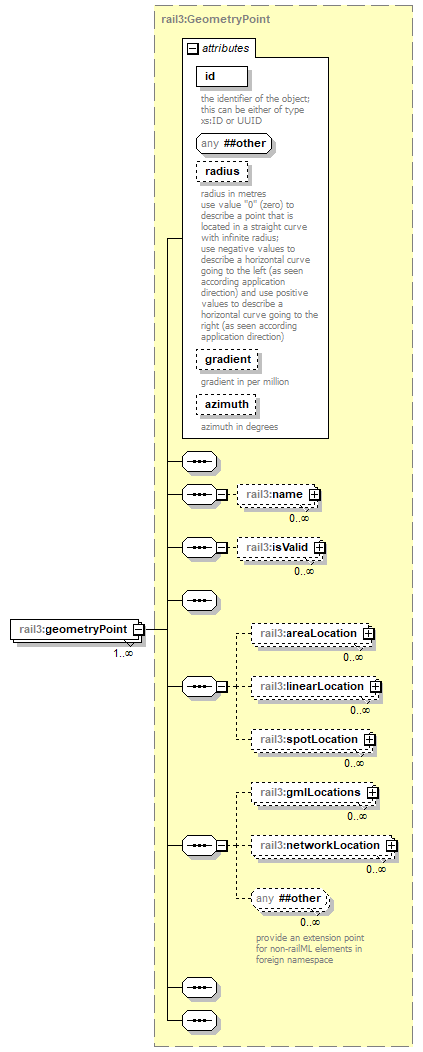 | ||||||||||||||||||||||||||||||||||||||
| namespace | https://www.railml.org/schemas/3.1 | ||||||||||||||||||||||||||||||||||||||
| type | rail3:GeometryPoint | ||||||||||||||||||||||||||||||||||||||
| properties |
| ||||||||||||||||||||||||||||||||||||||
| children | rail3:name rail3:isValid rail3:areaLocation rail3:linearLocation rail3:spotLocation rail3:gmlLocations rail3:networkLocation | ||||||||||||||||||||||||||||||||||||||
| attributes |
| ||||||||||||||||||||||||||||||||||||||
| source | <xs:element name="geometryPoint" type="rail3:GeometryPoint" minOccurs="1" maxOccurs="unbounded"/> |
complexType GmlLocations
| diagram | 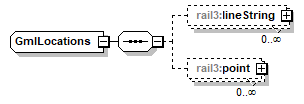 | ||
| namespace | https://www.railml.org/schemas/3.1 | ||
| children | rail3:lineString rail3:point | ||
| used by |
| ||
| source | <xs:complexType name="GmlLocations"> <xs:sequence> <xs:element name="lineString" type="rail3:LineTypeCoordinate" minOccurs="0" maxOccurs="unbounded"/> <xs:element name="point" type="rail3:PointTypeCoordinate" minOccurs="0" maxOccurs="unbounded"/> </xs:sequence> </xs:complexType> |
element GmlLocations/lineString
| diagram | 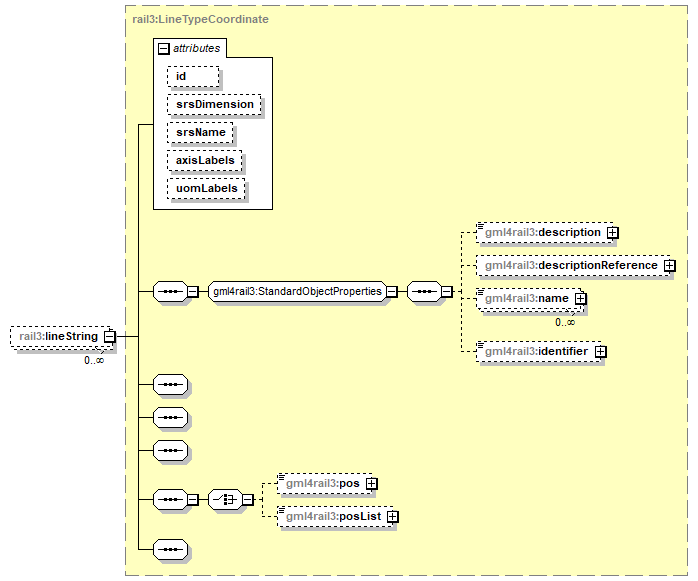 | ||||||||||||||||||||||||||||||||||||
| namespace | https://www.railml.org/schemas/3.1 | ||||||||||||||||||||||||||||||||||||
| type | rail3:LineTypeCoordinate | ||||||||||||||||||||||||||||||||||||
| properties |
| ||||||||||||||||||||||||||||||||||||
| children | gml4rail3:description gml4rail3:descriptionReference gml4rail3:name gml4rail3:identifier gml4rail3:pos gml4rail3:posList | ||||||||||||||||||||||||||||||||||||
| attributes |
| ||||||||||||||||||||||||||||||||||||
| source | <xs:element name="lineString" type="rail3:LineTypeCoordinate" minOccurs="0" maxOccurs="unbounded"/> |
element GmlLocations/point
| diagram | 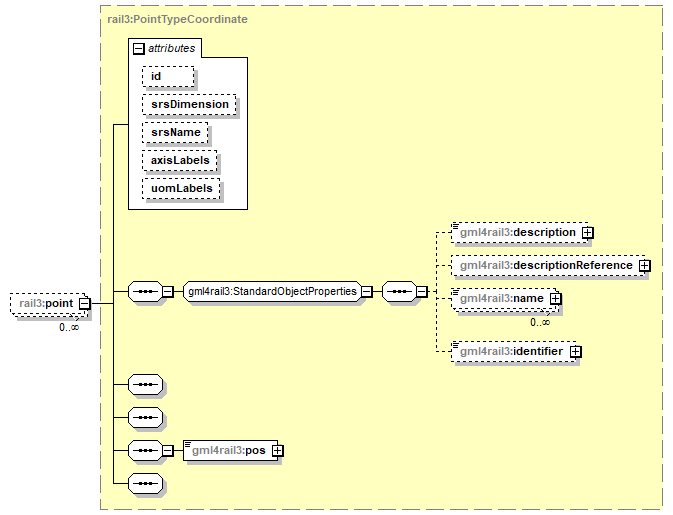 | ||||||||||||||||||||||||||||||||||||
| namespace | https://www.railml.org/schemas/3.1 | ||||||||||||||||||||||||||||||||||||
| type | rail3:PointTypeCoordinate | ||||||||||||||||||||||||||||||||||||
| properties |
| ||||||||||||||||||||||||||||||||||||
| children | gml4rail3:description gml4rail3:descriptionReference gml4rail3:name gml4rail3:identifier gml4rail3:pos | ||||||||||||||||||||||||||||||||||||
| attributes |
| ||||||||||||||||||||||||||||||||||||
| source | <xs:element name="point" type="rail3:PointTypeCoordinate" minOccurs="0" maxOccurs="unbounded"/> |
complexType GradientCurve
| diagram |  | ||||||||||||||||||||||||||||||||||||||||||||||||||||||
| namespace | https://www.railml.org/schemas/3.1 | ||||||||||||||||||||||||||||||||||||||||||||||||||||||
| type | extension of rail3:GeometryCurve | ||||||||||||||||||||||||||||||||||||||||||||||||||||||
| properties |
| ||||||||||||||||||||||||||||||||||||||||||||||||||||||
| children | rail3:name rail3:isValid rail3:areaLocation rail3:linearLocation rail3:spotLocation rail3:gmlLocations rail3:networkLocation rail3:beginsInGeometryPoint rail3:endsInGeometryPoint | ||||||||||||||||||||||||||||||||||||||||||||||||||||||
| used by |
| ||||||||||||||||||||||||||||||||||||||||||||||||||||||
| attributes |
| ||||||||||||||||||||||||||||||||||||||||||||||||||||||
| source | <xs:complexType name="GradientCurve"> <xs:complexContent> <xs:extension base="rail3:GeometryCurve"> <xs:sequence/> <xs:attribute name="curveType" type="rail3:tGradientCurveType" use="required"> <xs:annotation> <xs:documentation>type of vertical curve, e.g. arc or straight</xs:documentation> </xs:annotation> </xs:attribute> <xs:attribute name="gradient" type="rail3:tGradientPerMille" use="optional"> <xs:annotation> <xs:documentation>constant gradient of the gradient curve in per million; positive values indicate an upward slope (rise), negative values indicate a downward slope (fall)</xs:documentation> </xs:annotation> </xs:attribute> <xs:attribute name="deltaGradient" type="rail3:tGradientPerMille" use="optional"> <xs:annotation> <xs:documentation>change of gradient of the gradient curve in per million; use this attribute if the gradient value of the gradient curve is not constant, but changing; the delta gradient shall be calculated as difference of gradient at the end and gradient at the beginning of the gradient curve</xs:documentation> </xs:annotation> </xs:attribute> <xs:attribute name="radius" type="rail3:tLengthM" use="optional"> <xs:annotation> <xs:documentation>radius of the gradient curve in metres; use negative values to describe the arc curve of a valley and use positive values to describe the arc curve of a hill</xs:documentation> </xs:annotation> </xs:attribute> <xs:attribute name="length" type="rail3:tLengthM" use="optional"> <xs:annotation> <xs:documentation>length of the gradient curve in metres; use this attribute in particular to define the arc length</xs:documentation> </xs:annotation> </xs:attribute> </xs:extension> </xs:complexContent> </xs:complexType> |
attribute GradientCurve/@curveType
| type | rail3:tGradientCurveType | ||||||||||||||||||
| properties |
| ||||||||||||||||||
| facets |
| ||||||||||||||||||
| annotation |
| ||||||||||||||||||
| source | <xs:attribute name="curveType" type="rail3:tGradientCurveType" use="required"> <xs:annotation> <xs:documentation>type of vertical curve, e.g. arc or straight</xs:documentation> </xs:annotation> </xs:attribute> |
attribute GradientCurve/@gradient
| type | rail3:tGradientPerMille | ||
| properties |
| ||
| annotation |
| ||
| source | <xs:attribute name="gradient" type="rail3:tGradientPerMille" use="optional"> <xs:annotation> <xs:documentation>constant gradient of the gradient curve in per million; positive values indicate an upward slope (rise), negative values indicate a downward slope (fall)</xs:documentation> </xs:annotation> </xs:attribute> |
attribute GradientCurve/@deltaGradient
| type | rail3:tGradientPerMille | ||
| properties |
| ||
| annotation |
| ||
| source | <xs:attribute name="deltaGradient" type="rail3:tGradientPerMille" use="optional"> <xs:annotation> <xs:documentation>change of gradient of the gradient curve in per million; use this attribute if the gradient value of the gradient curve is not constant, but changing; the delta gradient shall be calculated as difference of gradient at the end and gradient at the beginning of the gradient curve</xs:documentation> </xs:annotation> </xs:attribute> |
attribute GradientCurve/@radius
| type | rail3:tLengthM | ||
| properties |
| ||
| annotation |
| ||
| source | <xs:attribute name="radius" type="rail3:tLengthM" use="optional"> <xs:annotation> <xs:documentation>radius of the gradient curve in metres; use negative values to describe the arc curve of a valley and use positive values to describe the arc curve of a hill</xs:documentation> </xs:annotation> </xs:attribute> |
attribute GradientCurve/@length
| type | rail3:tLengthM | ||
| properties |
| ||
| annotation |
| ||
| source | <xs:attribute name="length" type="rail3:tLengthM" use="optional"> <xs:annotation> <xs:documentation>length of the gradient curve in metres; use this attribute in particular to define the arc length</xs:documentation> </xs:annotation> </xs:attribute> |
complexType GradientCurves
| diagram |  | ||
| namespace | https://www.railml.org/schemas/3.1 | ||
| children | rail3:gradientCurve | ||
| used by |
| ||
| source | <xs:complexType name="GradientCurves"> <xs:sequence> <xs:element name="gradientCurve" type="rail3:GradientCurve" minOccurs="1" maxOccurs="unbounded"/> </xs:sequence> </xs:complexType> |
element GradientCurves/gradientCurve
| diagram |  | ||||||||||||||||||||||||||||||||||||||||||||||||||||||
| namespace | https://www.railml.org/schemas/3.1 | ||||||||||||||||||||||||||||||||||||||||||||||||||||||
| type | rail3:GradientCurve | ||||||||||||||||||||||||||||||||||||||||||||||||||||||
| properties |
| ||||||||||||||||||||||||||||||||||||||||||||||||||||||
| children | rail3:name rail3:isValid rail3:areaLocation rail3:linearLocation rail3:spotLocation rail3:gmlLocations rail3:networkLocation rail3:beginsInGeometryPoint rail3:endsInGeometryPoint | ||||||||||||||||||||||||||||||||||||||||||||||||||||||
| attributes |
| ||||||||||||||||||||||||||||||||||||||||||||||||||||||
| source | <xs:element name="gradientCurve" type="rail3:GradientCurve" minOccurs="1" maxOccurs="unbounded"/> |
complexType HorizontalCurve
| diagram |  | ||||||||||||||||||||||||||||||||||||||||||||||||||||||
| namespace | https://www.railml.org/schemas/3.1 | ||||||||||||||||||||||||||||||||||||||||||||||||||||||
| type | extension of rail3:GeometryCurve | ||||||||||||||||||||||||||||||||||||||||||||||||||||||
| properties |
| ||||||||||||||||||||||||||||||||||||||||||||||||||||||
| children | rail3:name rail3:isValid rail3:areaLocation rail3:linearLocation rail3:spotLocation rail3:gmlLocations rail3:networkLocation rail3:beginsInGeometryPoint rail3:endsInGeometryPoint | ||||||||||||||||||||||||||||||||||||||||||||||||||||||
| used by |
| ||||||||||||||||||||||||||||||||||||||||||||||||||||||
| attributes |
| ||||||||||||||||||||||||||||||||||||||||||||||||||||||
| source | <xs:complexType name="HorizontalCurve"> <xs:complexContent> <xs:extension base="rail3:GeometryCurve"> <xs:sequence/> <xs:attribute name="curveType" type="rail3:tHorizontalCurveTypeExt" use="required"> <xs:annotation> <xs:documentation>type of the horizontal curve, e.g. arc or clothoide or straight</xs:documentation> </xs:annotation> </xs:attribute> <xs:attribute name="azimuth" type="rail3:tAngleDeg" use="optional"> <xs:annotation> <xs:documentation>constant azimuth (direction angle) of the horizontal curve in degrees; Direction "north" has an azimuth of 0 degrees, "east" 90, "south" 180 and "west" 270 degrees.</xs:documentation> </xs:annotation> </xs:attribute> <xs:attribute name="deltaAzimuth" type="rail3:tAngleDeg" use="optional"> <xs:annotation> <xs:documentation>change of azimuth of the horizontal curve in degrees; use this attribute if the azimuth of the horizontal curve is not constant, but changing; delta azimuth shall be calculated as difference of azimuth value at the end and the azimuth value at the beginning of the horizontal curve.</xs:documentation> </xs:annotation> </xs:attribute> <xs:attribute name="radius" type="rail3:tLengthM" use="optional"> <xs:annotation> <xs:documentation>radius of the horizontal curve in meters; use value "0" (zero) to describe straight curves with infinite radius; use negative values to describe a horizontal curve going to the left (as seen from begin of curve) and use positive values to describe a horizontal curve going to the right (as seen from begin of curve)</xs:documentation> </xs:annotation> </xs:attribute> <xs:attribute name="length" type="rail3:tLengthM" use="optional"> <xs:annotation> <xs:documentation>length of the horizontal curve in metres; for arcs and transition curves (e.g. clothoides) this attribute defines the arc length</xs:documentation> </xs:annotation> </xs:attribute> </xs:extension> </xs:complexContent> </xs:complexType> |
attribute HorizontalCurve/@curveType
| type | rail3:tHorizontalCurveTypeExt | ||
| properties |
| ||
| annotation |
| ||
| source | <xs:attribute name="curveType" type="rail3:tHorizontalCurveTypeExt" use="required"> <xs:annotation> <xs:documentation>type of the horizontal curve, e.g. arc or clothoide or straight</xs:documentation> </xs:annotation> </xs:attribute> |
attribute HorizontalCurve/@azimuth
| type | rail3:tAngleDeg | ||
| properties |
| ||
| annotation |
| ||
| source | <xs:attribute name="azimuth" type="rail3:tAngleDeg" use="optional"> <xs:annotation> <xs:documentation>constant azimuth (direction angle) of the horizontal curve in degrees; Direction "north" has an azimuth of 0 degrees, "east" 90, "south" 180 and "west" 270 degrees.</xs:documentation> </xs:annotation> </xs:attribute> |
attribute HorizontalCurve/@deltaAzimuth
| type | rail3:tAngleDeg | ||
| properties |
| ||
| annotation |
| ||
| source | <xs:attribute name="deltaAzimuth" type="rail3:tAngleDeg" use="optional"> <xs:annotation> <xs:documentation>change of azimuth of the horizontal curve in degrees; use this attribute if the azimuth of the horizontal curve is not constant, but changing; delta azimuth shall be calculated as difference of azimuth value at the end and the azimuth value at the beginning of the horizontal curve.</xs:documentation> </xs:annotation> </xs:attribute> |
attribute HorizontalCurve/@radius
| type | rail3:tLengthM | ||
| properties |
| ||
| annotation |
| ||
| source | <xs:attribute name="radius" type="rail3:tLengthM" use="optional"> <xs:annotation> <xs:documentation>radius of the horizontal curve in meters; use value "0" (zero) to describe straight curves with infinite radius; use negative values to describe a horizontal curve going to the left (as seen from begin of curve) and use positive values to describe a horizontal curve going to the right (as seen from begin of curve)</xs:documentation> </xs:annotation> </xs:attribute> |
attribute HorizontalCurve/@length
| type | rail3:tLengthM | ||
| properties |
| ||
| annotation |
| ||
| source | <xs:attribute name="length" type="rail3:tLengthM" use="optional"> <xs:annotation> <xs:documentation>length of the horizontal curve in metres; for arcs and transition curves (e.g. clothoides) this attribute defines the arc length</xs:documentation> </xs:annotation> </xs:attribute> |
complexType HorizontalCurves
| diagram |  | ||
| namespace | https://www.railml.org/schemas/3.1 | ||
| children | rail3:horizontalCurve | ||
| used by |
| ||
| source | <xs:complexType name="HorizontalCurves"> <xs:sequence> <xs:element name="horizontalCurve" type="rail3:HorizontalCurve" minOccurs="1" maxOccurs="unbounded"/> </xs:sequence> </xs:complexType> |
element HorizontalCurves/horizontalCurve
| diagram |  | ||||||||||||||||||||||||||||||||||||||||||||||||||||||
| namespace | https://www.railml.org/schemas/3.1 | ||||||||||||||||||||||||||||||||||||||||||||||||||||||
| type | rail3:HorizontalCurve | ||||||||||||||||||||||||||||||||||||||||||||||||||||||
| properties |
| ||||||||||||||||||||||||||||||||||||||||||||||||||||||
| children | rail3:name rail3:isValid rail3:areaLocation rail3:linearLocation rail3:spotLocation rail3:gmlLocations rail3:networkLocation rail3:beginsInGeometryPoint rail3:endsInGeometryPoint | ||||||||||||||||||||||||||||||||||||||||||||||||||||||
| attributes |
| ||||||||||||||||||||||||||||||||||||||||||||||||||||||
| source | <xs:element name="horizontalCurve" type="rail3:HorizontalCurve" minOccurs="1" maxOccurs="unbounded"/> |
complexType Infrastructure
| diagram | 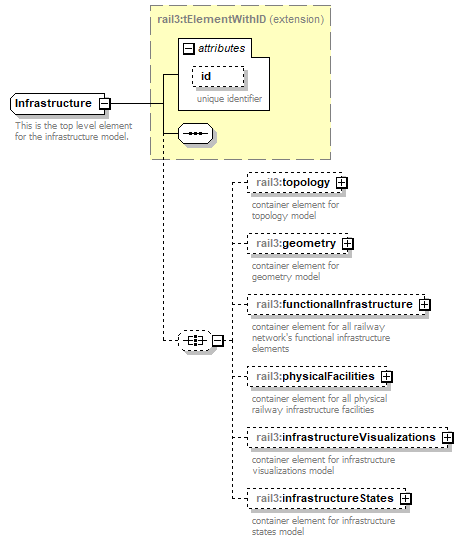 | ||||||||||||||
| namespace | https://www.railml.org/schemas/3.1 | ||||||||||||||
| type | extension of rail3:tElementWithID | ||||||||||||||
| properties |
| ||||||||||||||
| children | rail3:topology rail3:geometry rail3:functionalInfrastructure rail3:physicalFacilities rail3:infrastructureVisualizations rail3:infrastructureStates | ||||||||||||||
| used by |
| ||||||||||||||
| attributes |
| ||||||||||||||
| annotation |
| ||||||||||||||
| source | <xs:complexType name="Infrastructure"> <xs:annotation> <xs:documentation>This is the top level element for the infrastructure model.</xs:documentation> </xs:annotation> <xs:complexContent> <xs:extension base="rail3:tElementWithID"> <xs:all minOccurs="0" maxOccurs="1"> <xs:element name="topology" type="rail3:Topology" minOccurs="0" maxOccurs="1"> <xs:annotation> <xs:documentation>container element for topology model</xs:documentation> </xs:annotation> </xs:element> <xs:element name="geometry" type="rail3:Geometry" minOccurs="0" maxOccurs="1"> <xs:annotation> <xs:documentation>container element for geometry model</xs:documentation> </xs:annotation> </xs:element> <xs:element name="functionalInfrastructure" type="rail3:FunctionalInfrastructure" minOccurs="0" maxOccurs="1"> <xs:annotation> <xs:documentation>container element for all railway network's functional infrastructure elements</xs:documentation> </xs:annotation> </xs:element> <xs:element name="physicalFacilities" type="rail3:PhysicalFacilities" minOccurs="0" maxOccurs="1"> <xs:annotation> <xs:documentation>container element for all physical railway infrastructure facilities</xs:documentation> </xs:annotation> </xs:element> <xs:element name="infrastructureVisualizations" type="rail3:InfrastructureVisualizations" minOccurs="0" maxOccurs="1"> <xs:annotation> <xs:documentation>container element for infrastructure visualizations model</xs:documentation> </xs:annotation> </xs:element> <xs:element name="infrastructureStates" type="rail3:InfrastructureStates" minOccurs="0" maxOccurs="1"> <xs:annotation> <xs:documentation>container element for infrastructure states model</xs:documentation> </xs:annotation> </xs:element> </xs:all> </xs:extension> </xs:complexContent> </xs:complexType> |
element Infrastructure/topology
| diagram | 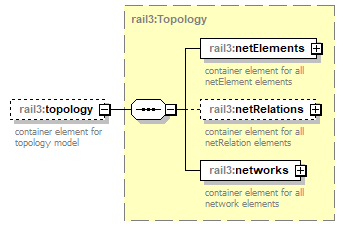 | ||||||
| namespace | https://www.railml.org/schemas/3.1 | ||||||
| type | rail3:Topology | ||||||
| properties |
| ||||||
| children | rail3:netElements rail3:netRelations rail3:networks | ||||||
| annotation |
| ||||||
| source | <xs:element name="topology" type="rail3:Topology" minOccurs="0" maxOccurs="1"> <xs:annotation> <xs:documentation>container element for topology model</xs:documentation> </xs:annotation> </xs:element> |
element Infrastructure/geometry
| diagram | 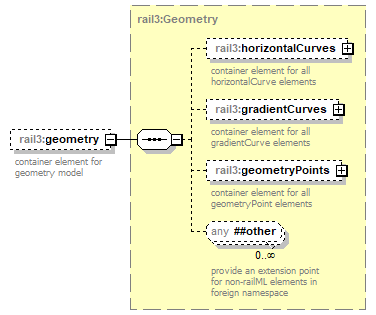 | ||||||
| namespace | https://www.railml.org/schemas/3.1 | ||||||
| type | rail3:Geometry | ||||||
| properties |
| ||||||
| children | rail3:horizontalCurves rail3:gradientCurves rail3:geometryPoints | ||||||
| annotation |
| ||||||
| source | <xs:element name="geometry" type="rail3:Geometry" minOccurs="0" maxOccurs="1"> <xs:annotation> <xs:documentation>container element for geometry model</xs:documentation> </xs:annotation> </xs:element> |
element Infrastructure/functionalInfrastructure
| diagram |  | ||||||
| namespace | https://www.railml.org/schemas/3.1 | ||||||
| type | rail3:FunctionalInfrastructure | ||||||
| properties |
| ||||||
| children | rail3:balises rail3:borders rail3:bufferStops rail3:crossings rail3:derailersIS rail3:electrifications rail3:keyLocksIS rail3:levelCrossingsIS rail3:lines rail3:loadingGauges rail3:operationalPoints rail3:overCrossings rail3:platforms rail3:restrictionAreas rail3:serviceSections rail3:signalsIS rail3:speeds rail3:stoppingPlaces rail3:switchesIS rail3:tracks rail3:trackBeds rail3:trackGauges rail3:trainDetectionElements rail3:trainProtectionElements rail3:trainRadios rail3:underCrossings rail3:weightLimits | ||||||
| annotation |
| ||||||
| source | <xs:element name="functionalInfrastructure" type="rail3:FunctionalInfrastructure" minOccurs="0" maxOccurs="1"> <xs:annotation> <xs:documentation>container element for all railway network's functional infrastructure elements</xs:documentation> </xs:annotation> </xs:element> |
element Infrastructure/physicalFacilities
| diagram | 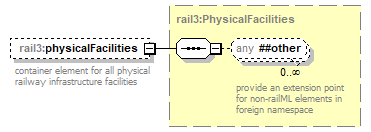 | ||||||
| namespace | https://www.railml.org/schemas/3.1 | ||||||
| type | rail3:PhysicalFacilities | ||||||
| properties |
| ||||||
| annotation |
| ||||||
| source | <xs:element name="physicalFacilities" type="rail3:PhysicalFacilities" minOccurs="0" maxOccurs="1"> <xs:annotation> <xs:documentation>container element for all physical railway infrastructure facilities</xs:documentation> </xs:annotation> </xs:element> |
element Infrastructure/infrastructureVisualizations
| diagram |  | ||||||
| namespace | https://www.railml.org/schemas/3.1 | ||||||
| type | rail3:InfrastructureVisualizations | ||||||
| properties |
| ||||||
| children | rail3:visualization | ||||||
| annotation |
| ||||||
| source | <xs:element name="infrastructureVisualizations" type="rail3:InfrastructureVisualizations" minOccurs="0" maxOccurs="1"> <xs:annotation> <xs:documentation>container element for infrastructure visualizations model</xs:documentation> </xs:annotation> </xs:element> |
element Infrastructure/infrastructureStates
| diagram |  | ||||||
| namespace | https://www.railml.org/schemas/3.1 | ||||||
| type | rail3:InfrastructureStates | ||||||
| properties |
| ||||||
| children | rail3:infrastructureState | ||||||
| annotation |
| ||||||
| source | <xs:element name="infrastructureStates" type="rail3:InfrastructureStates" minOccurs="0" maxOccurs="1"> <xs:annotation> <xs:documentation>container element for infrastructure states model</xs:documentation> </xs:annotation> </xs:element> |
complexType InfrastructureState
| diagram | 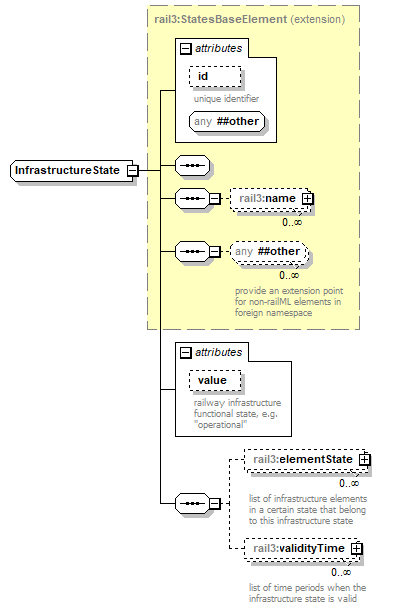 | ||||||||||||||||||||||
| namespace | https://www.railml.org/schemas/3.1 | ||||||||||||||||||||||
| type | extension of rail3:StatesBaseElement | ||||||||||||||||||||||
| properties |
| ||||||||||||||||||||||
| children | rail3:name rail3:elementState rail3:validityTime | ||||||||||||||||||||||
| used by |
| ||||||||||||||||||||||
| attributes |
| ||||||||||||||||||||||
| source | <xs:complexType name="InfrastructureState"> <xs:complexContent> <xs:extension base="rail3:StatesBaseElement"> <xs:sequence> <xs:element name="elementState" type="rail3:ElementState" minOccurs="0" maxOccurs="unbounded"> <xs:annotation> <xs:documentation>list of infrastructure elements in a certain state that belong to this infrastructure state</xs:documentation> </xs:annotation> </xs:element> <xs:element name="validityTime" type="rail3:Period" minOccurs="0" maxOccurs="unbounded"> <xs:annotation> <xs:documentation>list of time periods when the infrastructure state is valid</xs:documentation> </xs:annotation> </xs:element> </xs:sequence> <xs:attribute name="value" type="rail3:tInfrastructureStateExt" use="optional"> <xs:annotation> <xs:documentation>railway infrastructure functional state, e.g. "operational"</xs:documentation> </xs:annotation> </xs:attribute> </xs:extension> </xs:complexContent> </xs:complexType> |
attribute InfrastructureState/@value
| type | rail3:tInfrastructureStateExt | ||
| properties |
| ||
| annotation |
| ||
| source | <xs:attribute name="value" type="rail3:tInfrastructureStateExt" use="optional"> <xs:annotation> <xs:documentation>railway infrastructure functional state, e.g. "operational"</xs:documentation> </xs:annotation> </xs:attribute> |
element InfrastructureState/elementState
| diagram | 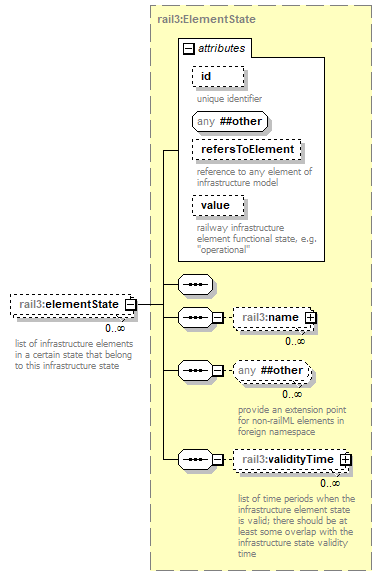 | ||||||||||||||||||||||||||||||
| namespace | https://www.railml.org/schemas/3.1 | ||||||||||||||||||||||||||||||
| type | rail3:ElementState | ||||||||||||||||||||||||||||||
| properties |
| ||||||||||||||||||||||||||||||
| children | rail3:name rail3:validityTime | ||||||||||||||||||||||||||||||
| attributes |
| ||||||||||||||||||||||||||||||
| annotation |
| ||||||||||||||||||||||||||||||
| source | <xs:element name="elementState" type="rail3:ElementState" minOccurs="0" maxOccurs="unbounded"> <xs:annotation> <xs:documentation>list of infrastructure elements in a certain state that belong to this infrastructure state</xs:documentation> </xs:annotation> </xs:element> |
element InfrastructureState/validityTime
| diagram | 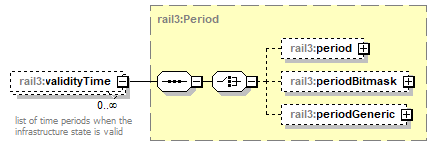 | ||||||
| namespace | https://www.railml.org/schemas/3.1 | ||||||
| type | rail3:Period | ||||||
| properties |
| ||||||
| children | rail3:period rail3:periodBitmask rail3:periodGeneric | ||||||
| annotation |
| ||||||
| source | <xs:element name="validityTime" type="rail3:Period" minOccurs="0" maxOccurs="unbounded"> <xs:annotation> <xs:documentation>list of time periods when the infrastructure state is valid</xs:documentation> </xs:annotation> </xs:element> |
complexType InfrastructureStates
| diagram |  | ||
| namespace | https://www.railml.org/schemas/3.1 | ||
| children | rail3:infrastructureState | ||
| used by |
| ||
| source | <xs:complexType name="InfrastructureStates"> <xs:sequence> <xs:element name="infrastructureState" type="rail3:InfrastructureState" minOccurs="1" maxOccurs="unbounded"> <xs:annotation> <xs:documentation>state of (a part of) the functional infrastructure regarding its availability and usability</xs:documentation> </xs:annotation> </xs:element> </xs:sequence> </xs:complexType> |
element InfrastructureStates/infrastructureState
| diagram | 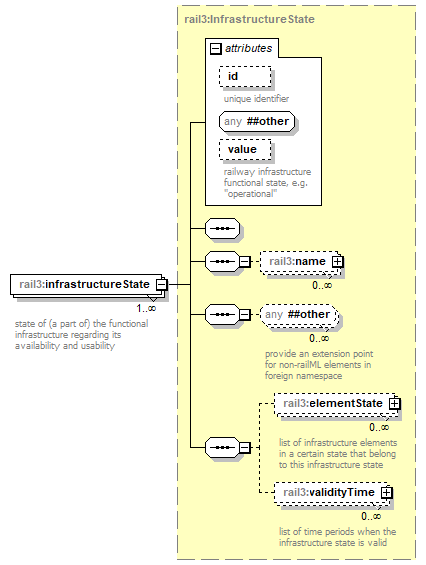 | ||||||||||||||||||||||
| namespace | https://www.railml.org/schemas/3.1 | ||||||||||||||||||||||
| type | rail3:InfrastructureState | ||||||||||||||||||||||
| properties |
| ||||||||||||||||||||||
| children | rail3:name rail3:elementState rail3:validityTime | ||||||||||||||||||||||
| attributes |
| ||||||||||||||||||||||
| annotation |
| ||||||||||||||||||||||
| source | <xs:element name="infrastructureState" type="rail3:InfrastructureState" minOccurs="1" maxOccurs="unbounded"> <xs:annotation> <xs:documentation>state of (a part of) the functional infrastructure regarding its availability and usability</xs:documentation> </xs:annotation> </xs:element> |
complexType InfrastructureVisualizations
| diagram |  | ||
| namespace | https://www.railml.org/schemas/3.1 | ||
| children | rail3:visualization | ||
| used by |
| ||
| source | <xs:complexType name="InfrastructureVisualizations"> <xs:sequence> <xs:element name="visualization" type="rail3:Visualization" minOccurs="1" maxOccurs="unbounded"> <xs:annotation> <xs:documentation>visualization of (a part of) a railway infrastructure, e.g. on a screen or a schematic map</xs:documentation> </xs:annotation> </xs:element> </xs:sequence> </xs:complexType> |
element InfrastructureVisualizations/visualization
| diagram | 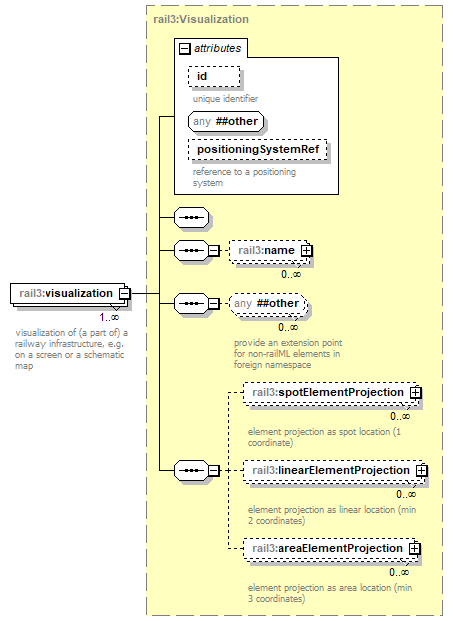 | ||||||||||||||||||||||
| namespace | https://www.railml.org/schemas/3.1 | ||||||||||||||||||||||
| type | rail3:Visualization | ||||||||||||||||||||||
| properties |
| ||||||||||||||||||||||
| children | rail3:name rail3:spotElementProjection rail3:linearElementProjection rail3:areaElementProjection | ||||||||||||||||||||||
| attributes |
| ||||||||||||||||||||||
| annotation |
| ||||||||||||||||||||||
| source | <xs:element name="visualization" type="rail3:Visualization" minOccurs="1" maxOccurs="unbounded"> <xs:annotation> <xs:documentation>visualization of (a part of) a railway infrastructure, e.g. on a screen or a schematic map</xs:documentation> </xs:annotation> </xs:element> |
complexType KeyLockIS
| diagram | 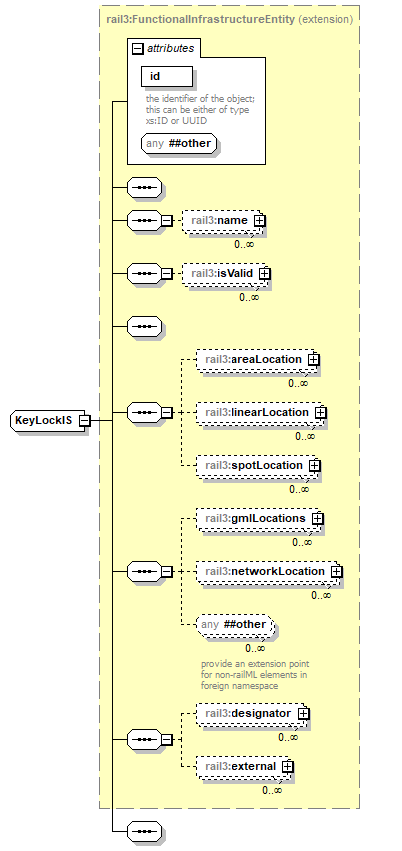 | ||||||||||||||
| namespace | https://www.railml.org/schemas/3.1 | ||||||||||||||
| type | extension of rail3:FunctionalInfrastructureEntity | ||||||||||||||
| properties |
| ||||||||||||||
| children | rail3:name rail3:isValid rail3:areaLocation rail3:linearLocation rail3:spotLocation rail3:gmlLocations rail3:networkLocation rail3:designator rail3:external | ||||||||||||||
| used by |
| ||||||||||||||
| attributes |
| ||||||||||||||
| source | <xs:complexType name="KeyLockIS"> <xs:complexContent> <xs:extension base="rail3:FunctionalInfrastructureEntity"> <xs:sequence/> </xs:extension> </xs:complexContent> </xs:complexType> |
complexType KeyLocksIS
| diagram |  | ||
| namespace | https://www.railml.org/schemas/3.1 | ||
| children | rail3:keyLockIS | ||
| used by |
| ||
| source | <xs:complexType name="KeyLocksIS"> <xs:sequence> <xs:element name="keyLockIS" type="rail3:KeyLockIS" minOccurs="1" maxOccurs="unbounded"/> </xs:sequence> </xs:complexType> |
element KeyLocksIS/keyLockIS
| diagram | 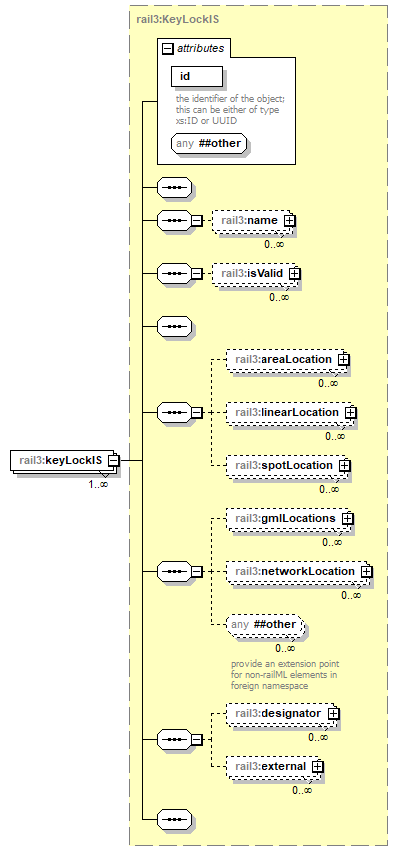 | ||||||||||||||
| namespace | https://www.railml.org/schemas/3.1 | ||||||||||||||
| type | rail3:KeyLockIS | ||||||||||||||
| properties |
| ||||||||||||||
| children | rail3:name rail3:isValid rail3:areaLocation rail3:linearLocation rail3:spotLocation rail3:gmlLocations rail3:networkLocation rail3:designator rail3:external | ||||||||||||||
| attributes |
| ||||||||||||||
| source | <xs:element name="keyLockIS" type="rail3:KeyLockIS" minOccurs="1" maxOccurs="unbounded"/> |
complexType Length
| diagram | 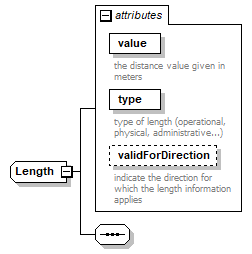 | ||||||||||||||||||||||||||||||
| namespace | https://www.railml.org/schemas/3.1 | ||||||||||||||||||||||||||||||
| used by |
| ||||||||||||||||||||||||||||||
| attributes |
| ||||||||||||||||||||||||||||||
| source | <xs:complexType name="Length"> <xs:sequence/> <xs:attribute name="value" type="rail3:tLengthM" use="required"> <xs:annotation> <xs:documentation>the distance value given in meters</xs:documentation> </xs:annotation> </xs:attribute> <xs:attribute name="type" type="rail3:tLengthTypeExt" use="required"> <xs:annotation> <xs:documentation>type of length (operational, physical, administrative...)</xs:documentation> </xs:annotation> </xs:attribute> <xs:attribute name="validForDirection" type="rail3:tExtendedDirection" use="optional"> <xs:annotation> <xs:documentation>indicate the direction for which the length information applies</xs:documentation> </xs:annotation> </xs:attribute> </xs:complexType> |
attribute Length/@value
| type | rail3:tLengthM | ||
| properties |
| ||
| annotation |
| ||
| source | <xs:attribute name="value" type="rail3:tLengthM" use="required"> <xs:annotation> <xs:documentation>the distance value given in meters</xs:documentation> </xs:annotation> </xs:attribute> |
attribute Length/@type
| type | rail3:tLengthTypeExt | ||
| properties |
| ||
| annotation |
| ||
| source | <xs:attribute name="type" type="rail3:tLengthTypeExt" use="required"> <xs:annotation> <xs:documentation>type of length (operational, physical, administrative...)</xs:documentation> </xs:annotation> </xs:attribute> |
attribute Length/@validForDirection
| type | rail3:tExtendedDirection | ||||||||||||
| properties |
| ||||||||||||
| facets |
| ||||||||||||
| annotation |
| ||||||||||||
| source | <xs:attribute name="validForDirection" type="rail3:tExtendedDirection" use="optional"> <xs:annotation> <xs:documentation>indicate the direction for which the length information applies</xs:documentation> </xs:annotation> </xs:attribute> |
complexType LevelCrossingIS
| diagram |  | ||||||||||||||||||||||||||||||||||||||||||||||||||||||||||||||
| namespace | https://www.railml.org/schemas/3.1 | ||||||||||||||||||||||||||||||||||||||||||||||||||||||||||||||
| type | extension of rail3:XCrossing | ||||||||||||||||||||||||||||||||||||||||||||||||||||||||||||||
| properties |
| ||||||||||||||||||||||||||||||||||||||||||||||||||||||||||||||
| children | rail3:name rail3:isValid rail3:areaLocation rail3:linearLocation rail3:spotLocation rail3:gmlLocations rail3:networkLocation rail3:designator rail3:external rail3:crossesElement rail3:protection | ||||||||||||||||||||||||||||||||||||||||||||||||||||||||||||||
| used by |
| ||||||||||||||||||||||||||||||||||||||||||||||||||||||||||||||
| attributes |
| ||||||||||||||||||||||||||||||||||||||||||||||||||||||||||||||
| source | <xs:complexType name="LevelCrossingIS"> <xs:complexContent> <xs:extension base="rail3:XCrossing"> <xs:sequence> <xs:element name="protection" type="rail3:LevelCrossingProtection" minOccurs="0" maxOccurs="1"> <xs:annotation> <xs:documentation>summary of technical protection of the level crossing</xs:documentation> </xs:annotation> </xs:element> </xs:sequence> <xs:attribute name="obstacleDetection" type="rail3:tLevelCrossingObstacleDetection" use="optional"> <xs:annotation> <xs:documentation>obstacle detection: automatic (technical system, e.g. radar) or manual (e.g. by operator); missing attribute means that the information is not known</xs:documentation> </xs:annotation> </xs:attribute> <xs:attribute name="opensOnDemand" type="xs:boolean" use="optional"> <xs:annotation> <xs:documentation>set TRUE if the level crossing is closed for road users by default and gates are only opened on demand; missing attribute means that the information is not known</xs:documentation> </xs:annotation> </xs:attribute> <xs:attribute name="activation" type="rail3:tLevelCrossingActivation" use="optional"> <xs:annotation> <xs:documentation>describes how the level crossing is being activated; missing attribute means that the information is not known</xs:documentation> </xs:annotation> </xs:attribute> <xs:attribute name="supervision" type="rail3:tLevelCrossingSupervision" use="optional"> <xs:annotation> <xs:documentation>describes how the state of the level crossing is being supervised; missing attribute means that the information is not known</xs:documentation> </xs:annotation> </xs:attribute> <xs:attribute name="belongsToParent" type="rail3:tRef" use="optional"> <xs:annotation> <xs:documentation>reference to the (one and only) parent level crossing</xs:documentation> </xs:annotation> </xs:attribute> <xs:attribute name="basedOnTemplate" type="rail3:tRef" use="optional"> <xs:annotation> <xs:documentation>reference to a template level crossing</xs:documentation> </xs:annotation> </xs:attribute> </xs:extension> </xs:complexContent> </xs:complexType> |
attribute LevelCrossingIS/@obstacleDetection
| type | rail3:tLevelCrossingObstacleDetection | ||||||||||||||||||
| properties |
| ||||||||||||||||||
| facets |
| ||||||||||||||||||
| annotation |
| ||||||||||||||||||
| source | <xs:attribute name="obstacleDetection" type="rail3:tLevelCrossingObstacleDetection" use="optional"> <xs:annotation> <xs:documentation>obstacle detection: automatic (technical system, e.g. radar) or manual (e.g. by operator); missing attribute means that the information is not known</xs:documentation> </xs:annotation> </xs:attribute> |
attribute LevelCrossingIS/@opensOnDemand
| type | xs:boolean | ||
| properties |
| ||
| annotation |
| ||
| source | <xs:attribute name="opensOnDemand" type="xs:boolean" use="optional"> <xs:annotation> <xs:documentation>set TRUE if the level crossing is closed for road users by default and gates are only opened on demand; missing attribute means that the information is not known</xs:documentation> </xs:annotation> </xs:attribute> |
attribute LevelCrossingIS/@activation
| type | rail3:tLevelCrossingActivation | ||||||||||||||||||||||||||||
| properties |
| ||||||||||||||||||||||||||||
| facets |
| ||||||||||||||||||||||||||||
| annotation |
| ||||||||||||||||||||||||||||
| source | <xs:attribute name="activation" type="rail3:tLevelCrossingActivation" use="optional"> <xs:annotation> <xs:documentation>describes how the level crossing is being activated; missing attribute means that the information is not known</xs:documentation> </xs:annotation> </xs:attribute> |
attribute LevelCrossingIS/@supervision
| type | rail3:tLevelCrossingSupervision | |||||||||||||||||||||||
| properties |
| |||||||||||||||||||||||
| facets |
| |||||||||||||||||||||||
| annotation |
| |||||||||||||||||||||||
| source | <xs:attribute name="supervision" type="rail3:tLevelCrossingSupervision" use="optional"> <xs:annotation> <xs:documentation>describes how the state of the level crossing is being supervised; missing attribute means that the information is not known</xs:documentation> </xs:annotation> </xs:attribute> |
attribute LevelCrossingIS/@belongsToParent
| type | rail3:tRef | ||
| properties |
| ||
| annotation |
| ||
| source | <xs:attribute name="belongsToParent" type="rail3:tRef" use="optional"> <xs:annotation> <xs:documentation>reference to the (one and only) parent level crossing</xs:documentation> </xs:annotation> </xs:attribute> |
attribute LevelCrossingIS/@basedOnTemplate
| type | rail3:tRef | ||
| properties |
| ||
| annotation |
| ||
| source | <xs:attribute name="basedOnTemplate" type="rail3:tRef" use="optional"> <xs:annotation> <xs:documentation>reference to a template level crossing</xs:documentation> </xs:annotation> </xs:attribute> |
element LevelCrossingIS/protection
| diagram | 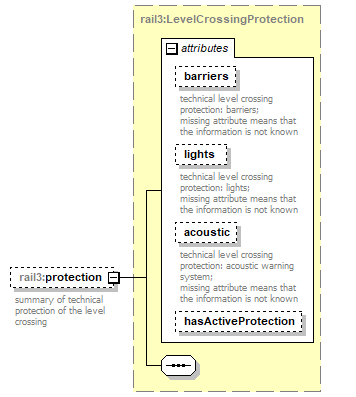 | ||||||||||||||||||||||||||||||||||||
| namespace | https://www.railml.org/schemas/3.1 | ||||||||||||||||||||||||||||||||||||
| type | rail3:LevelCrossingProtection | ||||||||||||||||||||||||||||||||||||
| properties |
| ||||||||||||||||||||||||||||||||||||
| attributes |
| ||||||||||||||||||||||||||||||||||||
| annotation |
| ||||||||||||||||||||||||||||||||||||
| source | <xs:element name="protection" type="rail3:LevelCrossingProtection" minOccurs="0" maxOccurs="1"> <xs:annotation> <xs:documentation>summary of technical protection of the level crossing</xs:documentation> </xs:annotation> </xs:element> |
complexType LevelCrossingProtection
| diagram | 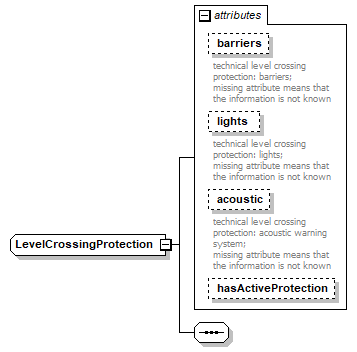 | ||||||||||||||||||||||||||||||||||||
| namespace | https://www.railml.org/schemas/3.1 | ||||||||||||||||||||||||||||||||||||
| used by |
| ||||||||||||||||||||||||||||||||||||
| attributes |
| ||||||||||||||||||||||||||||||||||||
| source | <xs:complexType name="LevelCrossingProtection"> <xs:sequence/> <xs:attribute name="barriers" type="rail3:tLevelCrossingProtectionBarrierExt" use="optional"> <xs:annotation> <xs:documentation>technical level crossing protection: barriers; missing attribute means that the information is not known</xs:documentation> </xs:annotation> </xs:attribute> <xs:attribute name="lights" type="rail3:tLevelCrossingProtectionLightsExt" use="optional"> <xs:annotation> <xs:documentation>technical level crossing protection: lights; missing attribute means that the information is not known</xs:documentation> </xs:annotation> </xs:attribute> <xs:attribute name="acoustic" type="rail3:tLevelCrossingProtectionAcousticExt" use="optional"> <xs:annotation> <xs:documentation>technical level crossing protection: acoustic warning system; missing attribute means that the information is not known</xs:documentation> </xs:annotation> </xs:attribute> <xs:attribute name="hasActiveProtection" type="xs:boolean" use="optional"/> </xs:complexType> |
attribute LevelCrossingProtection/@barriers
| type | rail3:tLevelCrossingProtectionBarrierExt | ||
| properties |
| ||
| annotation |
| ||
| source | <xs:attribute name="barriers" type="rail3:tLevelCrossingProtectionBarrierExt" use="optional"> <xs:annotation> <xs:documentation>technical level crossing protection: barriers; missing attribute means that the information is not known</xs:documentation> </xs:annotation> </xs:attribute> |
attribute LevelCrossingProtection/@lights
| type | rail3:tLevelCrossingProtectionLightsExt | ||
| properties |
| ||
| annotation |
| ||
| source | <xs:attribute name="lights" type="rail3:tLevelCrossingProtectionLightsExt" use="optional"> <xs:annotation> <xs:documentation>technical level crossing protection: lights; missing attribute means that the information is not known</xs:documentation> </xs:annotation> </xs:attribute> |
attribute LevelCrossingProtection/@acoustic
| type | rail3:tLevelCrossingProtectionAcousticExt | ||
| properties |
| ||
| annotation |
| ||
| source | <xs:attribute name="acoustic" type="rail3:tLevelCrossingProtectionAcousticExt" use="optional"> <xs:annotation> <xs:documentation>technical level crossing protection: acoustic warning system; missing attribute means that the information is not known</xs:documentation> </xs:annotation> </xs:attribute> |
attribute LevelCrossingProtection/@hasActiveProtection
| type | xs:boolean | ||
| properties |
| ||
| source | <xs:attribute name="hasActiveProtection" type="xs:boolean" use="optional"/> |
complexType LevelCrossingsIS
| diagram |  | ||
| namespace | https://www.railml.org/schemas/3.1 | ||
| children | rail3:levelCrossingIS | ||
| used by |
| ||
| source | <xs:complexType name="LevelCrossingsIS"> <xs:sequence> <xs:element name="levelCrossingIS" type="rail3:LevelCrossingIS" minOccurs="1" maxOccurs="unbounded"/> </xs:sequence> </xs:complexType> |
element LevelCrossingsIS/levelCrossingIS
| diagram |  | ||||||||||||||||||||||||||||||||||||||||||||||||||||||||||||||
| namespace | https://www.railml.org/schemas/3.1 | ||||||||||||||||||||||||||||||||||||||||||||||||||||||||||||||
| type | rail3:LevelCrossingIS | ||||||||||||||||||||||||||||||||||||||||||||||||||||||||||||||
| properties |
| ||||||||||||||||||||||||||||||||||||||||||||||||||||||||||||||
| children | rail3:name rail3:isValid rail3:areaLocation rail3:linearLocation rail3:spotLocation rail3:gmlLocations rail3:networkLocation rail3:designator rail3:external rail3:crossesElement rail3:protection | ||||||||||||||||||||||||||||||||||||||||||||||||||||||||||||||
| attributes |
| ||||||||||||||||||||||||||||||||||||||||||||||||||||||||||||||
| source | <xs:element name="levelCrossingIS" type="rail3:LevelCrossingIS" minOccurs="1" maxOccurs="unbounded"/> |
complexType Line
| diagram |  | ||||||||||||||||||||||||||||||||||||||||||||||||||||||
| namespace | https://www.railml.org/schemas/3.1 | ||||||||||||||||||||||||||||||||||||||||||||||||||||||
| type | extension of rail3:FunctionalInfrastructureEntity | ||||||||||||||||||||||||||||||||||||||||||||||||||||||
| properties |
| ||||||||||||||||||||||||||||||||||||||||||||||||||||||
| children | rail3:name rail3:isValid rail3:areaLocation rail3:linearLocation rail3:spotLocation rail3:gmlLocations rail3:networkLocation rail3:designator rail3:external rail3:beginsInOP rail3:endsInOP rail3:length rail3:lineTrafficCode rail3:lineCombinedTransportCode rail3:lineLayout rail3:linePerformance | ||||||||||||||||||||||||||||||||||||||||||||||||||||||
| used by |
| ||||||||||||||||||||||||||||||||||||||||||||||||||||||
| attributes |
| ||||||||||||||||||||||||||||||||||||||||||||||||||||||
| annotation |
| ||||||||||||||||||||||||||||||||||||||||||||||||||||||
| source | <xs:complexType name="Line"> <xs:annotation> <xs:documentation>A line is a sequence of one or more line sections forming a route, which connects operational points and which may consist of several tracks used for regular railway operation.</xs:documentation> </xs:annotation> <xs:complexContent> <xs:extension base="rail3:FunctionalInfrastructureEntity"> <xs:sequence> <xs:element name="beginsInOP" type="rail3:tElementWithIDref" minOccurs="0" maxOccurs="1"> <xs:annotation> <xs:documentation>reference to the operational point where the line (section) begins</xs:documentation> </xs:annotation> </xs:element> <xs:element name="endsInOP" type="rail3:tElementWithIDref" minOccurs="0" maxOccurs="1"> <xs:annotation> <xs:documentation>reference to the operational point where the line (section) ends</xs:documentation> </xs:annotation> </xs:element> <xs:element name="length" type="rail3:Length" minOccurs="0" maxOccurs="unbounded"> <xs:annotation> <xs:documentation>length of the line (section)</xs:documentation> </xs:annotation> </xs:element> <xs:element name="lineTrafficCode" type="rail3:LineTrafficCode" minOccurs="0" maxOccurs="unbounded"> <xs:annotation> <xs:documentation>TSI category of line as defined in TSI INF section 4.2.1; There should be one code for each type of traffic (passenger, freight) allowed on that line</xs:documentation> </xs:annotation> </xs:element> <xs:element name="lineCombinedTransportCode" type="rail3:LineCombinedTransportCode" minOccurs="0" maxOccurs="unbounded"> <xs:annotation> <xs:documentation>standard combined transport profile number as defined in UIC Code 596-6</xs:documentation> </xs:annotation> </xs:element> <xs:element name="lineLayout" type="rail3:LineLayout" minOccurs="0" maxOccurs="1"> <xs:annotation> <xs:documentation>child element summarizing the line layout parameters</xs:documentation> </xs:annotation> </xs:element> <xs:element name="linePerformance" type="rail3:LinePerformance" minOccurs="0" maxOccurs="1"> <xs:annotation> <xs:documentation>child element summarizing the line performance parameters</xs:documentation> </xs:annotation> </xs:element> </xs:sequence> <xs:attribute name="infrastructureManagerRef" type="rail3:tRef" use="optional"> <xs:annotation> <xs:documentation>reference to the infrastructure manager who owns the line (section) (see common/organizationalUnits)</xs:documentation> </xs:annotation> </xs:attribute> <xs:attribute name="lineCategory" type="rail3:tLineCategoryExt" use="optional"> <xs:annotation> <xs:documentation>the category of the line according to the EU regulation EN 15528 (A, B1, B2, C2, ..., E5; other national values are also possible)</xs:documentation> </xs:annotation> </xs:attribute> <xs:attribute name="lineType" type="rail3:tLineType" use="optional"> <xs:annotation> <xs:documentation>this attribute is for distinguishing between main line and branch lines</xs:documentation> </xs:annotation> </xs:attribute> <xs:attribute name="belongsToParent" type="rail3:tRef" use="optional"> <xs:annotation> <xs:documentation>reference to the (one and only) parent line (section)</xs:documentation> </xs:annotation> </xs:attribute> <xs:attribute name="basedOnTemplate" type="rail3:tRef" use="optional"> <xs:annotation> <xs:documentation>reference to a generic line (section)</xs:documentation> </xs:annotation> </xs:attribute> </xs:extension> </xs:complexContent> </xs:complexType> |
attribute Line/@infrastructureManagerRef
| type | rail3:tRef | ||
| properties |
| ||
| annotation |
| ||
| source | <xs:attribute name="infrastructureManagerRef" type="rail3:tRef" use="optional"> <xs:annotation> <xs:documentation>reference to the infrastructure manager who owns the line (section) (see common/organizationalUnits)</xs:documentation> </xs:annotation> </xs:attribute> |
attribute Line/@lineCategory
| type | rail3:tLineCategoryExt | ||
| properties |
| ||
| annotation |
| ||
| source | <xs:attribute name="lineCategory" type="rail3:tLineCategoryExt" use="optional"> <xs:annotation> <xs:documentation>the category of the line according to the EU regulation EN 15528 (A, B1, B2, C2, ..., E5; other national values are also possible)</xs:documentation> </xs:annotation> </xs:attribute> |
attribute Line/@lineType
| type | rail3:tLineType | |||||||||||||
| properties |
| |||||||||||||
| facets |
| |||||||||||||
| annotation |
| |||||||||||||
| source | <xs:attribute name="lineType" type="rail3:tLineType" use="optional"> <xs:annotation> <xs:documentation>this attribute is for distinguishing between main line and branch lines</xs:documentation> </xs:annotation> </xs:attribute> |
attribute Line/@belongsToParent
| type | rail3:tRef | ||
| properties |
| ||
| annotation |
| ||
| source | <xs:attribute name="belongsToParent" type="rail3:tRef" use="optional"> <xs:annotation> <xs:documentation>reference to the (one and only) parent line (section)</xs:documentation> </xs:annotation> </xs:attribute> |
attribute Line/@basedOnTemplate
| type | rail3:tRef | ||
| properties |
| ||
| annotation |
| ||
| source | <xs:attribute name="basedOnTemplate" type="rail3:tRef" use="optional"> <xs:annotation> <xs:documentation>reference to a generic line (section)</xs:documentation> </xs:annotation> </xs:attribute> |
element Line/beginsInOP
| diagram | 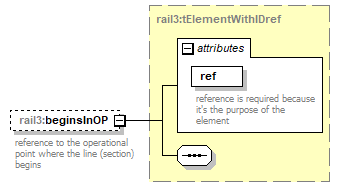 | ||||||||||||||
| namespace | https://www.railml.org/schemas/3.1 | ||||||||||||||
| type | rail3:tElementWithIDref | ||||||||||||||
| properties |
| ||||||||||||||
| attributes |
| ||||||||||||||
| annotation |
| ||||||||||||||
| source | <xs:element name="beginsInOP" type="rail3:tElementWithIDref" minOccurs="0" maxOccurs="1"> <xs:annotation> <xs:documentation>reference to the operational point where the line (section) begins</xs:documentation> </xs:annotation> </xs:element> |
element Line/endsInOP
| diagram | 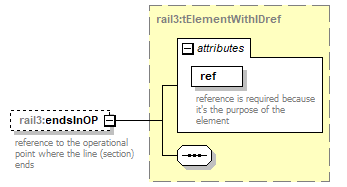 | ||||||||||||||
| namespace | https://www.railml.org/schemas/3.1 | ||||||||||||||
| type | rail3:tElementWithIDref | ||||||||||||||
| properties |
| ||||||||||||||
| attributes |
| ||||||||||||||
| annotation |
| ||||||||||||||
| source | <xs:element name="endsInOP" type="rail3:tElementWithIDref" minOccurs="0" maxOccurs="1"> <xs:annotation> <xs:documentation>reference to the operational point where the line (section) ends</xs:documentation> </xs:annotation> </xs:element> |
element Line/length
| diagram | 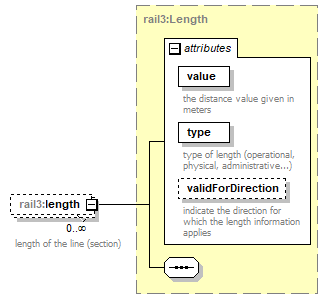 | ||||||||||||||||||||||||||||||
| namespace | https://www.railml.org/schemas/3.1 | ||||||||||||||||||||||||||||||
| type | rail3:Length | ||||||||||||||||||||||||||||||
| properties |
| ||||||||||||||||||||||||||||||
| attributes |
| ||||||||||||||||||||||||||||||
| annotation |
| ||||||||||||||||||||||||||||||
| source | <xs:element name="length" type="rail3:Length" minOccurs="0" maxOccurs="unbounded"> <xs:annotation> <xs:documentation>length of the line (section)</xs:documentation> </xs:annotation> </xs:element> |
element Line/lineTrafficCode
| diagram | 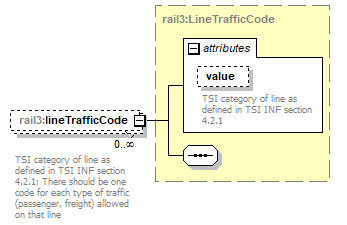 | ||||||||||||||
| namespace | https://www.railml.org/schemas/3.1 | ||||||||||||||
| type | rail3:LineTrafficCode | ||||||||||||||
| properties |
| ||||||||||||||
| attributes |
| ||||||||||||||
| annotation |
| ||||||||||||||
| source | <xs:element name="lineTrafficCode" type="rail3:LineTrafficCode" minOccurs="0" maxOccurs="unbounded"> <xs:annotation> <xs:documentation>TSI category of line as defined in TSI INF section 4.2.1; There should be one code for each type of traffic (passenger, freight) allowed on that line</xs:documentation> </xs:annotation> </xs:element> |
element Line/lineCombinedTransportCode
| diagram | 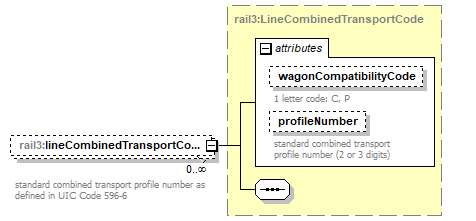 | ||||||||||||||||||||||
| namespace | https://www.railml.org/schemas/3.1 | ||||||||||||||||||||||
| type | rail3:LineCombinedTransportCode | ||||||||||||||||||||||
| properties |
| ||||||||||||||||||||||
| attributes |
| ||||||||||||||||||||||
| annotation |
| ||||||||||||||||||||||
| source | <xs:element name="lineCombinedTransportCode" type="rail3:LineCombinedTransportCode" minOccurs="0" maxOccurs="unbounded"> <xs:annotation> <xs:documentation>standard combined transport profile number as defined in UIC Code 596-6</xs:documentation> </xs:annotation> </xs:element> |
element Line/lineLayout
| diagram | 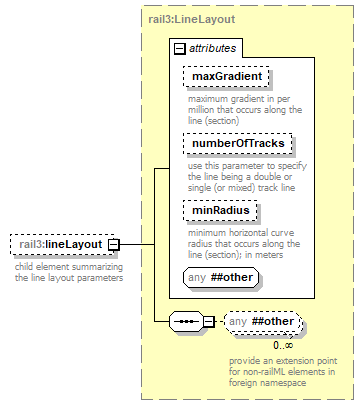 | ||||||||||||||||||||||||||||||
| namespace | https://www.railml.org/schemas/3.1 | ||||||||||||||||||||||||||||||
| type | rail3:LineLayout | ||||||||||||||||||||||||||||||
| properties |
| ||||||||||||||||||||||||||||||
| attributes |
| ||||||||||||||||||||||||||||||
| annotation |
| ||||||||||||||||||||||||||||||
| source | <xs:element name="lineLayout" type="rail3:LineLayout" minOccurs="0" maxOccurs="1"> <xs:annotation> <xs:documentation>child element summarizing the line layout parameters</xs:documentation> </xs:annotation> </xs:element> |
element Line/linePerformance
| diagram | 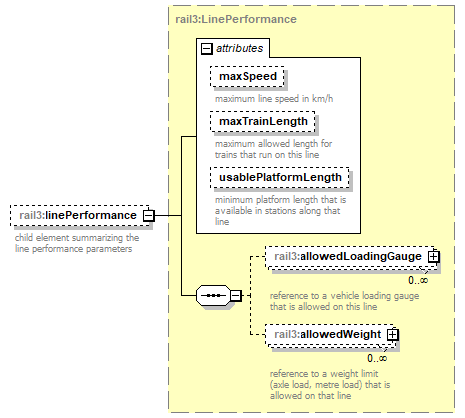 | ||||||||||||||||||||||||||||||
| namespace | https://www.railml.org/schemas/3.1 | ||||||||||||||||||||||||||||||
| type | rail3:LinePerformance | ||||||||||||||||||||||||||||||
| properties |
| ||||||||||||||||||||||||||||||
| children | rail3:allowedLoadingGauge rail3:allowedWeight | ||||||||||||||||||||||||||||||
| attributes |
| ||||||||||||||||||||||||||||||
| annotation |
| ||||||||||||||||||||||||||||||
| source | <xs:element name="linePerformance" type="rail3:LinePerformance" minOccurs="0" maxOccurs="1"> <xs:annotation> <xs:documentation>child element summarizing the line performance parameters</xs:documentation> </xs:annotation> </xs:element> |
complexType LinearProjection
| diagram | 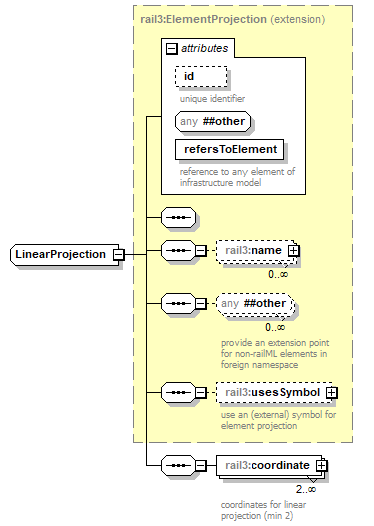 | ||||||||||||||||||||||
| namespace | https://www.railml.org/schemas/3.1 | ||||||||||||||||||||||
| type | extension of rail3:ElementProjection | ||||||||||||||||||||||
| properties |
| ||||||||||||||||||||||
| children | rail3:name rail3:usesSymbol rail3:coordinate | ||||||||||||||||||||||
| used by |
| ||||||||||||||||||||||
| attributes |
| ||||||||||||||||||||||
| source | <xs:complexType name="LinearProjection"> <xs:complexContent> <xs:extension base="rail3:ElementProjection"> <xs:sequence> <xs:element name="coordinate" type="rail3:ProjectionCoordinate" minOccurs="2" maxOccurs="unbounded"> <xs:annotation> <xs:documentation>coordinates for linear projection (min 2)</xs:documentation> </xs:annotation> </xs:element> </xs:sequence> </xs:extension> </xs:complexContent> </xs:complexType> |
element LinearProjection/coordinate
| diagram | 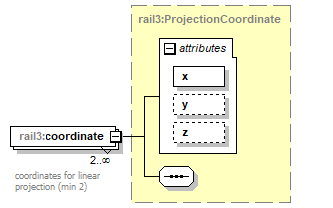 | ||||||||||||||||||||||||
| namespace | https://www.railml.org/schemas/3.1 | ||||||||||||||||||||||||
| type | rail3:ProjectionCoordinate | ||||||||||||||||||||||||
| properties |
| ||||||||||||||||||||||||
| attributes |
| ||||||||||||||||||||||||
| annotation |
| ||||||||||||||||||||||||
| source | <xs:element name="coordinate" type="rail3:ProjectionCoordinate" minOccurs="2" maxOccurs="unbounded"> <xs:annotation> <xs:documentation>coordinates for linear projection (min 2)</xs:documentation> </xs:annotation> </xs:element> |
complexType LineCombinedTransportCode
| diagram | 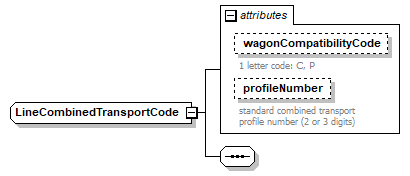 | ||||||||||||||||||||||
| namespace | https://www.railml.org/schemas/3.1 | ||||||||||||||||||||||
| used by |
| ||||||||||||||||||||||
| attributes |
| ||||||||||||||||||||||
| source | <xs:complexType name="LineCombinedTransportCode"> <xs:sequence/> <xs:attribute name="wagonCompatibilityCode" type="xs:string" use="optional"> <xs:annotation> <xs:documentation>1 letter code: C, P</xs:documentation> </xs:annotation> </xs:attribute> <xs:attribute name="profileNumber" type="xs:integer" use="optional"> <xs:annotation> <xs:documentation>standard combined transport profile number (2 or 3 digits)</xs:documentation> </xs:annotation> </xs:attribute> </xs:complexType> |
attribute LineCombinedTransportCode/@wagonCompatibilityCode
| type | xs:string | ||
| properties |
| ||
| annotation |
| ||
| source | <xs:attribute name="wagonCompatibilityCode" type="xs:string" use="optional"> <xs:annotation> <xs:documentation>1 letter code: C, P</xs:documentation> </xs:annotation> </xs:attribute> |
attribute LineCombinedTransportCode/@profileNumber
| type | xs:integer | ||
| properties |
| ||
| annotation |
| ||
| source | <xs:attribute name="profileNumber" type="xs:integer" use="optional"> <xs:annotation> <xs:documentation>standard combined transport profile number (2 or 3 digits)</xs:documentation> </xs:annotation> </xs:attribute> |
complexType LineLayout
| diagram | 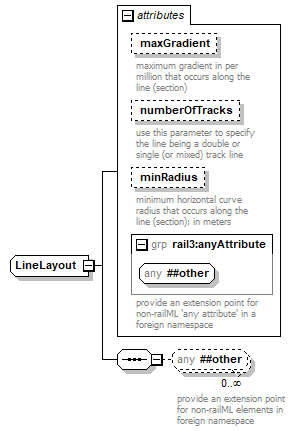 | ||||||||||||||||||||||||||||||
| namespace | https://www.railml.org/schemas/3.1 | ||||||||||||||||||||||||||||||
| used by |
| ||||||||||||||||||||||||||||||
| attributes |
| ||||||||||||||||||||||||||||||
| source | <xs:complexType name="LineLayout"> <xs:sequence> <xs:any namespace="##other" processContents="strict" minOccurs="0" maxOccurs="unbounded"> <xs:annotation> <xs:documentation>provide an extension point for non-railML elements in foreign namespace</xs:documentation> </xs:annotation> </xs:any> </xs:sequence> <xs:attribute name="maxGradient" type="rail3:tGradientPerMille" use="optional"> <xs:annotation> <xs:documentation>maximum gradient in per million that occurs along the line (section)</xs:documentation> </xs:annotation> </xs:attribute> <xs:attribute name="numberOfTracks" type="rail3:tNumberOfTracks" use="optional"> <xs:annotation> <xs:documentation>use this parameter to specify the line being a double or single (or mixed) track line</xs:documentation> </xs:annotation> </xs:attribute> <xs:attribute name="minRadius" type="rail3:tLengthM" use="optional"> <xs:annotation> <xs:documentation>minimum horizontal curve radius that occurs along the line (section); in meters</xs:documentation> </xs:annotation> </xs:attribute> <xs:attributeGroup ref="rail3:anyAttribute"/> </xs:complexType> |
attribute LineLayout/@maxGradient
| type | rail3:tGradientPerMille | ||
| properties |
| ||
| annotation |
| ||
| source | <xs:attribute name="maxGradient" type="rail3:tGradientPerMille" use="optional"> <xs:annotation> <xs:documentation>maximum gradient in per million that occurs along the line (section)</xs:documentation> </xs:annotation> </xs:attribute> |
attribute LineLayout/@numberOfTracks
| type | rail3:tNumberOfTracks | |||||||||||||||||||||||
| properties |
| |||||||||||||||||||||||
| facets |
| |||||||||||||||||||||||
| annotation |
| |||||||||||||||||||||||
| source | <xs:attribute name="numberOfTracks" type="rail3:tNumberOfTracks" use="optional"> <xs:annotation> <xs:documentation>use this parameter to specify the line being a double or single (or mixed) track line</xs:documentation> </xs:annotation> </xs:attribute> |
attribute LineLayout/@minRadius
| type | rail3:tLengthM | ||
| properties |
| ||
| annotation |
| ||
| source | <xs:attribute name="minRadius" type="rail3:tLengthM" use="optional"> <xs:annotation> <xs:documentation>minimum horizontal curve radius that occurs along the line (section); in meters</xs:documentation> </xs:annotation> </xs:attribute> |
complexType LinePerformance
| diagram | 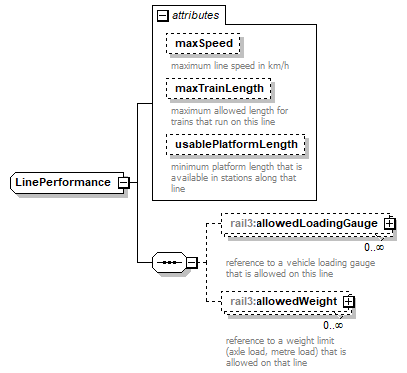 | ||||||||||||||||||||||||||||||
| namespace | https://www.railml.org/schemas/3.1 | ||||||||||||||||||||||||||||||
| children | rail3:allowedLoadingGauge rail3:allowedWeight | ||||||||||||||||||||||||||||||
| used by |
| ||||||||||||||||||||||||||||||
| attributes |
| ||||||||||||||||||||||||||||||
| source | <xs:complexType name="LinePerformance"> <xs:sequence> <xs:element name="allowedLoadingGauge" type="rail3:tElementWithIDref" minOccurs="0" maxOccurs="unbounded"> <xs:annotation> <xs:documentation>reference to a vehicle loading gauge that is allowed on this line</xs:documentation> </xs:annotation> </xs:element> <xs:element name="allowedWeight" type="rail3:tElementWithIDref" minOccurs="0" maxOccurs="unbounded"> <xs:annotation> <xs:documentation>reference to a weight limit (axle load, metre load) that is allowed on that line</xs:documentation> </xs:annotation> </xs:element> </xs:sequence> <xs:attribute name="maxSpeed" type="rail3:tSpeedKmPerHour" use="optional"> <xs:annotation> <xs:documentation>maximum line speed in km/h</xs:documentation> </xs:annotation> </xs:attribute> <xs:attribute name="maxTrainLength" type="rail3:tLengthM" use="optional"> <xs:annotation> <xs:documentation>maximum allowed length for trains that run on this line</xs:documentation> </xs:annotation> </xs:attribute> <xs:attribute name="usablePlatformLength" type="rail3:tLengthM" use="optional"> <xs:annotation> <xs:documentation>minimum platform length that is available in stations along that line</xs:documentation> </xs:annotation> </xs:attribute> </xs:complexType> |
attribute LinePerformance/@maxSpeed
| type | rail3:tSpeedKmPerHour | ||
| properties |
| ||
| annotation |
| ||
| source | <xs:attribute name="maxSpeed" type="rail3:tSpeedKmPerHour" use="optional"> <xs:annotation> <xs:documentation>maximum line speed in km/h</xs:documentation> </xs:annotation> </xs:attribute> |
attribute LinePerformance/@maxTrainLength
| type | rail3:tLengthM | ||
| properties |
| ||
| annotation |
| ||
| source | <xs:attribute name="maxTrainLength" type="rail3:tLengthM" use="optional"> <xs:annotation> <xs:documentation>maximum allowed length for trains that run on this line</xs:documentation> </xs:annotation> </xs:attribute> |
attribute LinePerformance/@usablePlatformLength
| type | rail3:tLengthM | ||
| properties |
| ||
| annotation |
| ||
| source | <xs:attribute name="usablePlatformLength" type="rail3:tLengthM" use="optional"> <xs:annotation> <xs:documentation>minimum platform length that is available in stations along that line</xs:documentation> </xs:annotation> </xs:attribute> |
element LinePerformance/allowedLoadingGauge
| diagram | 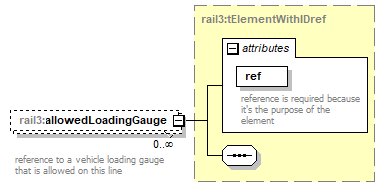 | ||||||||||||||
| namespace | https://www.railml.org/schemas/3.1 | ||||||||||||||
| type | rail3:tElementWithIDref | ||||||||||||||
| properties |
| ||||||||||||||
| attributes |
| ||||||||||||||
| annotation |
| ||||||||||||||
| source | <xs:element name="allowedLoadingGauge" type="rail3:tElementWithIDref" minOccurs="0" maxOccurs="unbounded"> <xs:annotation> <xs:documentation>reference to a vehicle loading gauge that is allowed on this line</xs:documentation> </xs:annotation> </xs:element> |
element LinePerformance/allowedWeight
| diagram | 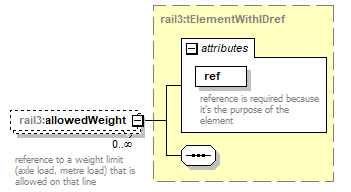 | ||||||||||||||
| namespace | https://www.railml.org/schemas/3.1 | ||||||||||||||
| type | rail3:tElementWithIDref | ||||||||||||||
| properties |
| ||||||||||||||
| attributes |
| ||||||||||||||
| annotation |
| ||||||||||||||
| source | <xs:element name="allowedWeight" type="rail3:tElementWithIDref" minOccurs="0" maxOccurs="unbounded"> <xs:annotation> <xs:documentation>reference to a weight limit (axle load, metre load) that is allowed on that line</xs:documentation> </xs:annotation> </xs:element> |
complexType Lines
| diagram |  | ||
| namespace | https://www.railml.org/schemas/3.1 | ||
| children | rail3:line | ||
| used by |
| ||
| source | <xs:complexType name="Lines"> <xs:sequence> <xs:element name="line" type="rail3:Line" minOccurs="1" maxOccurs="unbounded"/> </xs:sequence> </xs:complexType> |
element Lines/line
| diagram |  | ||||||||||||||||||||||||||||||||||||||||||||||||||||||
| namespace | https://www.railml.org/schemas/3.1 | ||||||||||||||||||||||||||||||||||||||||||||||||||||||
| type | rail3:Line | ||||||||||||||||||||||||||||||||||||||||||||||||||||||
| properties |
| ||||||||||||||||||||||||||||||||||||||||||||||||||||||
| children | rail3:name rail3:isValid rail3:areaLocation rail3:linearLocation rail3:spotLocation rail3:gmlLocations rail3:networkLocation rail3:designator rail3:external rail3:beginsInOP rail3:endsInOP rail3:length rail3:lineTrafficCode rail3:lineCombinedTransportCode rail3:lineLayout rail3:linePerformance | ||||||||||||||||||||||||||||||||||||||||||||||||||||||
| attributes |
| ||||||||||||||||||||||||||||||||||||||||||||||||||||||
| source | <xs:element name="line" type="rail3:Line" minOccurs="1" maxOccurs="unbounded"/> |
complexType LineTrafficCode
| diagram | 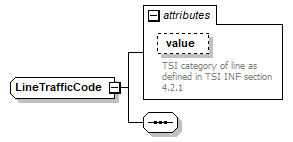 | ||||||||||||||
| namespace | https://www.railml.org/schemas/3.1 | ||||||||||||||
| used by |
| ||||||||||||||
| attributes |
| ||||||||||||||
| source | <xs:complexType name="LineTrafficCode"> <xs:sequence/> <xs:attribute name="value" type="rail3:tLineTrafficCodeExt" use="optional"> <xs:annotation> <xs:documentation>TSI category of line as defined in TSI INF section 4.2.1</xs:documentation> </xs:annotation> </xs:attribute> </xs:complexType> |
attribute LineTrafficCode/@value
| type | rail3:tLineTrafficCodeExt | ||
| properties |
| ||
| annotation |
| ||
| source | <xs:attribute name="value" type="rail3:tLineTrafficCodeExt" use="optional"> <xs:annotation> <xs:documentation>TSI category of line as defined in TSI INF section 4.2.1</xs:documentation> </xs:annotation> </xs:attribute> |
complexType LineTypeCoordinate
| diagram | 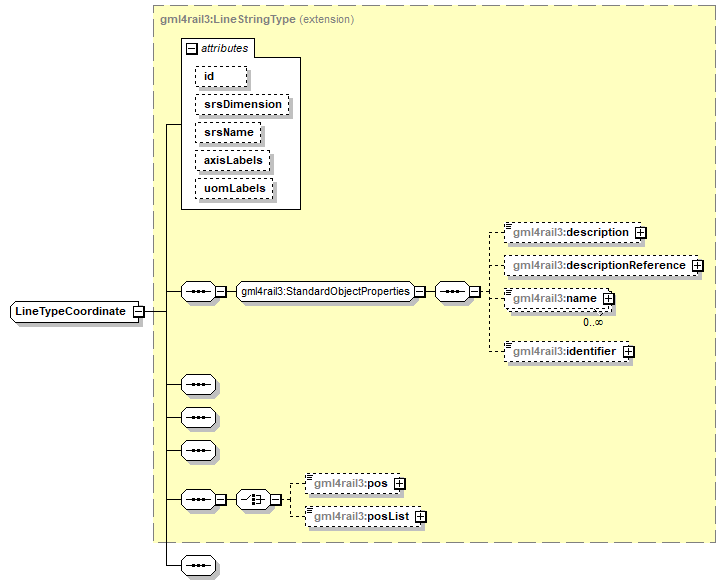 | ||||||||||||||||||||||||||||||||||||
| namespace | https://www.railml.org/schemas/3.1 | ||||||||||||||||||||||||||||||||||||
| type | extension of gml4rail3:LineStringType | ||||||||||||||||||||||||||||||||||||
| properties |
| ||||||||||||||||||||||||||||||||||||
| children | gml4rail3:description gml4rail3:descriptionReference gml4rail3:name gml4rail3:identifier gml4rail3:pos gml4rail3:posList | ||||||||||||||||||||||||||||||||||||
| used by |
| ||||||||||||||||||||||||||||||||||||
| attributes |
| ||||||||||||||||||||||||||||||||||||
| source | <xs:complexType name="LineTypeCoordinate"> <xs:complexContent> <xs:extension base="gml4rail3:LineStringType"> <xs:sequence/> </xs:extension> </xs:complexContent> </xs:complexType> |
complexType LoadingGauge
| diagram | 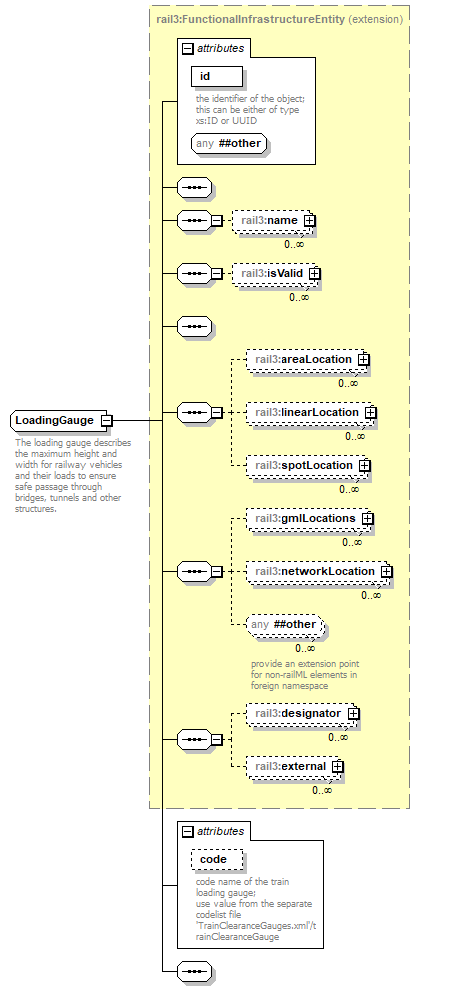 | ||||||||||||||||||||||
| namespace | https://www.railml.org/schemas/3.1 | ||||||||||||||||||||||
| type | extension of rail3:FunctionalInfrastructureEntity | ||||||||||||||||||||||
| properties |
| ||||||||||||||||||||||
| children | rail3:name rail3:isValid rail3:areaLocation rail3:linearLocation rail3:spotLocation rail3:gmlLocations rail3:networkLocation rail3:designator rail3:external | ||||||||||||||||||||||
| used by |
| ||||||||||||||||||||||
| attributes |
| ||||||||||||||||||||||
| annotation |
| ||||||||||||||||||||||
| source | <xs:complexType name="LoadingGauge"> <xs:annotation> <xs:documentation>The loading gauge describes the maximum height and width for railway vehicles and their loads to ensure safe passage through bridges, tunnels and other structures.</xs:documentation> </xs:annotation> <xs:complexContent> <xs:extension base="rail3:FunctionalInfrastructureEntity"> <xs:sequence/> <xs:attribute name="code" type="xs:string" use="optional"> <xs:annotation> <xs:documentation>code name of the train loading gauge; use value from the separate codelist file 'TrainClearanceGauges.xml'/trainClearanceGauge</xs:documentation> </xs:annotation> </xs:attribute> </xs:extension> </xs:complexContent> </xs:complexType> |
attribute LoadingGauge/@code
| type | xs:string | ||
| properties |
| ||
| annotation |
| ||
| source | <xs:attribute name="code" type="xs:string" use="optional"> <xs:annotation> <xs:documentation>code name of the train loading gauge; use value from the separate codelist file 'TrainClearanceGauges.xml'/trainClearanceGauge</xs:documentation> </xs:annotation> </xs:attribute> |
complexType LoadingGauges
| diagram |  | ||
| namespace | https://www.railml.org/schemas/3.1 | ||
| children | rail3:loadingGauge | ||
| used by |
| ||
| annotation |
| ||
| source | <xs:complexType name="LoadingGauges"> <xs:annotation> <xs:documentation>umbrella element for all loadingGauge elements</xs:documentation> </xs:annotation> <xs:sequence> <xs:element name="loadingGauge" type="rail3:LoadingGauge" minOccurs="1" maxOccurs="unbounded"/> </xs:sequence> </xs:complexType> |
element LoadingGauges/loadingGauge
| diagram | 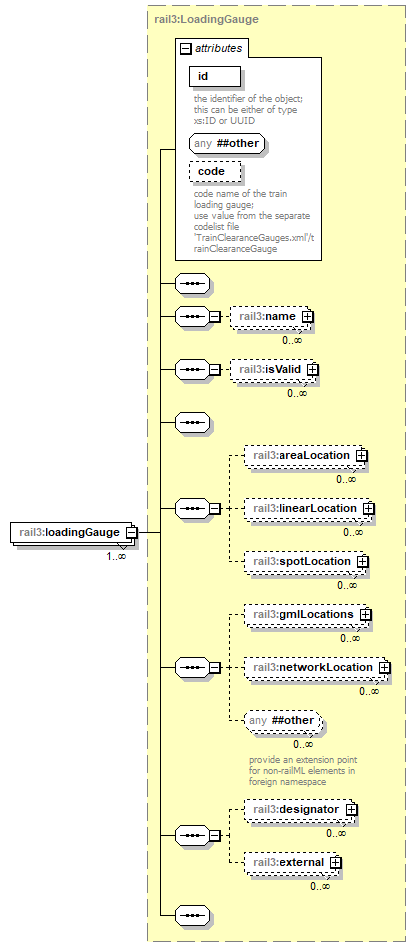 | ||||||||||||||||||||||
| namespace | https://www.railml.org/schemas/3.1 | ||||||||||||||||||||||
| type | rail3:LoadingGauge | ||||||||||||||||||||||
| properties |
| ||||||||||||||||||||||
| children | rail3:name rail3:isValid rail3:areaLocation rail3:linearLocation rail3:spotLocation rail3:gmlLocations rail3:networkLocation rail3:designator rail3:external | ||||||||||||||||||||||
| attributes |
| ||||||||||||||||||||||
| source | <xs:element name="loadingGauge" type="rail3:LoadingGauge" minOccurs="1" maxOccurs="unbounded"/> |
complexType LocationNetwork
| diagram | 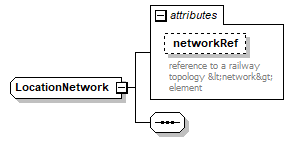 | ||||||||||||||
| namespace | https://www.railml.org/schemas/3.1 | ||||||||||||||
| used by |
| ||||||||||||||
| attributes |
| ||||||||||||||
| source | <xs:complexType name="LocationNetwork"> <xs:sequence/> <xs:attribute name="networkRef" type="rail3:tRef" use="optional"> <xs:annotation> <xs:documentation>reference to a railway topology <network> element</xs:documentation> </xs:annotation> </xs:attribute> </xs:complexType> |
attribute LocationNetwork/@networkRef
| type | rail3:tRef | ||
| properties |
| ||
| annotation |
| ||
| source | <xs:attribute name="networkRef" type="rail3:tRef" use="optional"> <xs:annotation> <xs:documentation>reference to a railway topology <network> element</xs:documentation> </xs:annotation> </xs:attribute> |
complexType MaxTrainCurrent
| diagram | 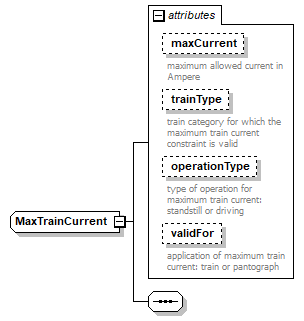 | ||||||||||||||||||||||||||||||||||||||
| namespace | https://www.railml.org/schemas/3.1 | ||||||||||||||||||||||||||||||||||||||
| used by |
| ||||||||||||||||||||||||||||||||||||||
| attributes |
| ||||||||||||||||||||||||||||||||||||||
| source | <xs:complexType name="MaxTrainCurrent"> <xs:sequence/> <xs:attribute name="maxCurrent" type="rail3:tCurrentAmpere" use="optional"> <xs:annotation> <xs:documentation>maximum allowed current in Ampere</xs:documentation> </xs:annotation> </xs:attribute> <xs:attribute name="trainType" type="rail3:tOperationalTrainType" use="optional"> <xs:annotation> <xs:documentation>train category for which the maximum train current constraint is valid</xs:documentation> </xs:annotation> </xs:attribute> <xs:attribute name="operationType" type="xs:int" use="optional"> <xs:annotation> <xs:documentation>type of operation for maximum train current: standstill or driving</xs:documentation> </xs:annotation> </xs:attribute> <xs:attribute name="validFor" type="xs:int" use="optional"> <xs:annotation> <xs:documentation>application of maximum train current: train or pantograph</xs:documentation> </xs:annotation> </xs:attribute> </xs:complexType> |
attribute MaxTrainCurrent/@maxCurrent
| type | rail3:tCurrentAmpere | ||
| properties |
| ||
| annotation |
| ||
| source | <xs:attribute name="maxCurrent" type="rail3:tCurrentAmpere" use="optional"> <xs:annotation> <xs:documentation>maximum allowed current in Ampere</xs:documentation> </xs:annotation> </xs:attribute> |
attribute MaxTrainCurrent/@trainType
| type | rail3:tOperationalTrainType | |||||||||||||||
| properties |
| |||||||||||||||
| facets |
| |||||||||||||||
| annotation |
| |||||||||||||||
| source | <xs:attribute name="trainType" type="rail3:tOperationalTrainType" use="optional"> <xs:annotation> <xs:documentation>train category for which the maximum train current constraint is valid</xs:documentation> </xs:annotation> </xs:attribute> |
attribute MaxTrainCurrent/@operationType
| type | xs:int | ||
| properties |
| ||
| annotation |
| ||
| source | <xs:attribute name="operationType" type="xs:int" use="optional"> <xs:annotation> <xs:documentation>type of operation for maximum train current: standstill or driving</xs:documentation> </xs:annotation> </xs:attribute> |
attribute MaxTrainCurrent/@validFor
| type | xs:int | ||
| properties |
| ||
| annotation |
| ||
| source | <xs:attribute name="validFor" type="xs:int" use="optional"> <xs:annotation> <xs:documentation>application of maximum train current: train or pantograph</xs:documentation> </xs:annotation> </xs:attribute> |
complexType NetElement
| diagram | 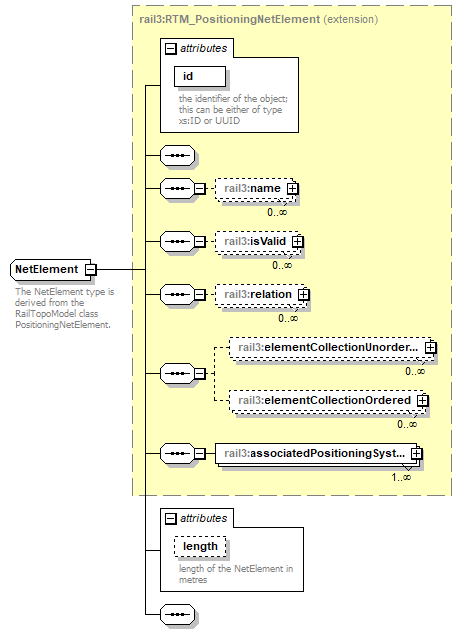 | ||||||||||||||||||||||
| namespace | https://www.railml.org/schemas/3.1 | ||||||||||||||||||||||
| type | extension of rail3:RTM_PositioningNetElement | ||||||||||||||||||||||
| properties |
| ||||||||||||||||||||||
| children | rail3:name rail3:isValid rail3:relation rail3:elementCollectionUnordered rail3:elementCollectionOrdered rail3:associatedPositioningSystem | ||||||||||||||||||||||
| used by |
| ||||||||||||||||||||||
| attributes |
| ||||||||||||||||||||||
| annotation |
| ||||||||||||||||||||||
| source | <xs:complexType name="NetElement"> <xs:annotation> <xs:documentation>The NetElement type is derived from the RailTopoModel class PositioningNetElement.</xs:documentation> </xs:annotation> <xs:complexContent> <xs:extension base="rail3:RTM_PositioningNetElement"> <xs:sequence/> <xs:attribute name="length" type="rail3:tLengthM" use="optional"> <xs:annotation> <xs:documentation>length of the NetElement in metres</xs:documentation> </xs:annotation> </xs:attribute> </xs:extension> </xs:complexContent> </xs:complexType> |
attribute NetElement/@length
| type | rail3:tLengthM | ||
| properties |
| ||
| annotation |
| ||
| source | <xs:attribute name="length" type="rail3:tLengthM" use="optional"> <xs:annotation> <xs:documentation>length of the NetElement in metres</xs:documentation> </xs:annotation> </xs:attribute> |
complexType NetElements
| diagram |  | ||
| namespace | https://www.railml.org/schemas/3.1 | ||
| children | rail3:netElement | ||
| used by |
| ||
| source | <xs:complexType name="NetElements"> <xs:sequence> <xs:element name="netElement" type="rail3:NetElement" minOccurs="1" maxOccurs="unbounded"/> </xs:sequence> </xs:complexType> |
element NetElements/netElement
| diagram | 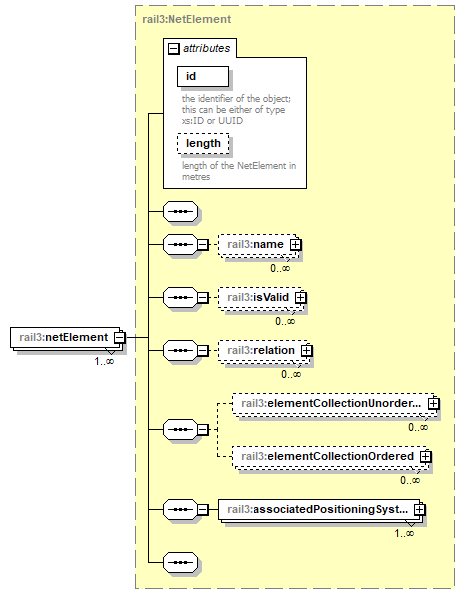 | ||||||||||||||||||||||
| namespace | https://www.railml.org/schemas/3.1 | ||||||||||||||||||||||
| type | rail3:NetElement | ||||||||||||||||||||||
| properties |
| ||||||||||||||||||||||
| children | rail3:name rail3:isValid rail3:relation rail3:elementCollectionUnordered rail3:elementCollectionOrdered rail3:associatedPositioningSystem | ||||||||||||||||||||||
| attributes |
| ||||||||||||||||||||||
| source | <xs:element name="netElement" type="rail3:NetElement" minOccurs="1" maxOccurs="unbounded"/> |
complexType NetRelation
| diagram | 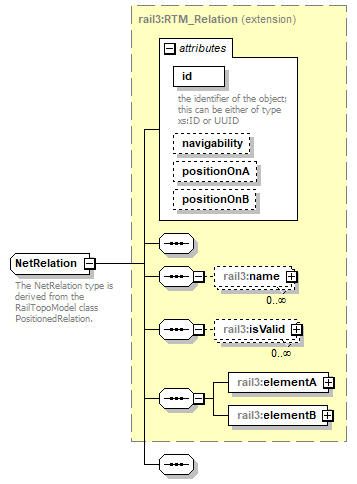 | ||||||||||||||||||||||||||||||||
| namespace | https://www.railml.org/schemas/3.1 | ||||||||||||||||||||||||||||||||
| type | extension of rail3:RTM_Relation | ||||||||||||||||||||||||||||||||
| properties |
| ||||||||||||||||||||||||||||||||
| children | rail3:name rail3:isValid rail3:elementA rail3:elementB | ||||||||||||||||||||||||||||||||
| used by |
| ||||||||||||||||||||||||||||||||
| attributes |
| ||||||||||||||||||||||||||||||||
| annotation |
| ||||||||||||||||||||||||||||||||
| source | <xs:complexType name="NetRelation"> <xs:annotation> <xs:documentation>The NetRelation type is derived from the RailTopoModel class PositionedRelation.</xs:documentation> </xs:annotation> <xs:complexContent> <xs:extension base="rail3:RTM_Relation"> <xs:sequence/> </xs:extension> </xs:complexContent> </xs:complexType> |
complexType NetRelations
| diagram |  | ||
| namespace | https://www.railml.org/schemas/3.1 | ||
| children | rail3:netRelation | ||
| used by |
| ||
| source | <xs:complexType name="NetRelations"> <xs:sequence> <xs:element name="netRelation" type="rail3:NetRelation" minOccurs="1" maxOccurs="unbounded"/> </xs:sequence> </xs:complexType> |
element NetRelations/netRelation
| diagram | 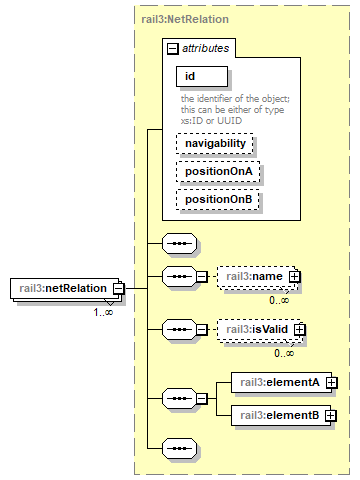 | ||||||||||||||||||||||||||||||||
| namespace | https://www.railml.org/schemas/3.1 | ||||||||||||||||||||||||||||||||
| type | rail3:NetRelation | ||||||||||||||||||||||||||||||||
| properties |
| ||||||||||||||||||||||||||||||||
| children | rail3:name rail3:isValid rail3:elementA rail3:elementB | ||||||||||||||||||||||||||||||||
| attributes |
| ||||||||||||||||||||||||||||||||
| source | <xs:element name="netRelation" type="rail3:NetRelation" minOccurs="1" maxOccurs="unbounded"/> |
complexType Network
| diagram | 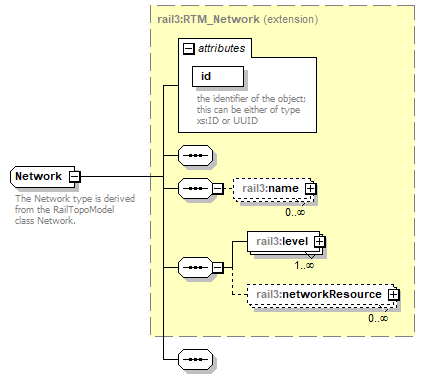 | ||||||||||||||
| namespace | https://www.railml.org/schemas/3.1 | ||||||||||||||
| type | extension of rail3:RTM_Network | ||||||||||||||
| properties |
| ||||||||||||||
| children | rail3:name rail3:level rail3:networkResource | ||||||||||||||
| used by |
| ||||||||||||||
| attributes |
| ||||||||||||||
| annotation |
| ||||||||||||||
| source | <xs:complexType name="Network"> <xs:annotation> <xs:documentation>The Network type is derived from the RailTopoModel class Network.</xs:documentation> </xs:annotation> <xs:complexContent> <xs:extension base="rail3:RTM_Network"> <xs:sequence/> </xs:extension> </xs:complexContent> </xs:complexType> |
complexType Networks
| diagram |  | ||
| namespace | https://www.railml.org/schemas/3.1 | ||
| children | rail3:network | ||
| used by |
| ||
| source | <xs:complexType name="Networks"> <xs:sequence> <xs:element name="network" type="rail3:Network" minOccurs="1" maxOccurs="unbounded"/> </xs:sequence> </xs:complexType> |
element Networks/network
| diagram | 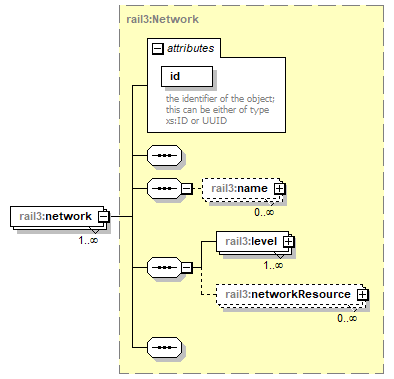 | ||||||||||||||
| namespace | https://www.railml.org/schemas/3.1 | ||||||||||||||
| type | rail3:Network | ||||||||||||||
| properties |
| ||||||||||||||
| children | rail3:name rail3:level rail3:networkResource | ||||||||||||||
| attributes |
| ||||||||||||||
| source | <xs:element name="network" type="rail3:Network" minOccurs="1" maxOccurs="unbounded"/> |
complexType OpenEnd
| diagram | 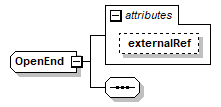 | ||||||||||||
| namespace | https://www.railml.org/schemas/3.1 | ||||||||||||
| attributes |
| ||||||||||||
| source | <xs:complexType name="OpenEnd"> <xs:sequence/> <xs:attribute name="externalRef" type="xs:string" use="optional"/> </xs:complexType> |
attribute OpenEnd/@externalRef
| type | xs:string | ||
| properties |
| ||
| source | <xs:attribute name="externalRef" type="xs:string" use="optional"/> |
complexType OpEquipment
| diagram | 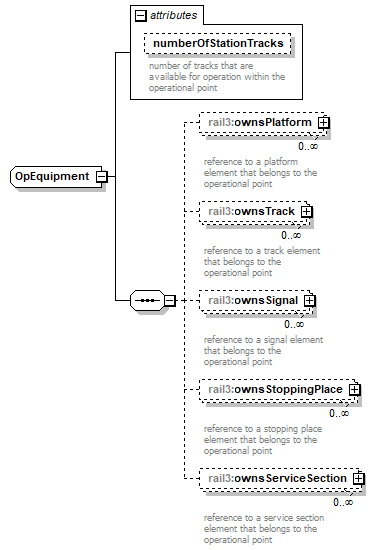 | ||||||||||||||
| namespace | https://www.railml.org/schemas/3.1 | ||||||||||||||
| children | rail3:ownsPlatform rail3:ownsTrack rail3:ownsSignal rail3:ownsStoppingPlace rail3:ownsServiceSection | ||||||||||||||
| used by |
| ||||||||||||||
| attributes |
| ||||||||||||||
| source | <xs:complexType name="OpEquipment"> <xs:sequence> <xs:element name="ownsPlatform" type="rail3:tElementWithIDref" minOccurs="0" maxOccurs="unbounded"> <xs:annotation> <xs:documentation>reference to a platform element that belongs to the operational point</xs:documentation> </xs:annotation> </xs:element> <xs:element name="ownsTrack" type="rail3:tElementWithIDref" minOccurs="0" maxOccurs="unbounded"> <xs:annotation> <xs:documentation>reference to a track element that belongs to the operational point</xs:documentation> </xs:annotation> </xs:element> <xs:element name="ownsSignal" type="rail3:tElementWithIDref" minOccurs="0" maxOccurs="unbounded"> <xs:annotation> <xs:documentation>reference to a signal element that belongs to the operational point</xs:documentation> </xs:annotation> </xs:element> <xs:element name="ownsStoppingPlace" type="rail3:tElementWithIDref" minOccurs="0" maxOccurs="unbounded"> <xs:annotation> <xs:documentation>reference to a stopping place element that belongs to the operational point</xs:documentation> </xs:annotation> </xs:element> <xs:element name="ownsServiceSection" type="rail3:tElementWithIDref" minOccurs="0" maxOccurs="unbounded"> <xs:annotation> <xs:documentation>reference to a service section element that belongs to the operational point</xs:documentation> </xs:annotation> </xs:element> </xs:sequence> <xs:attribute name="numberOfStationTracks" type="xs:positiveInteger" use="optional"> <xs:annotation> <xs:documentation>number of tracks that are available for operation within the operational point</xs:documentation> </xs:annotation> </xs:attribute> </xs:complexType> |
attribute OpEquipment/@numberOfStationTracks
| type | xs:positiveInteger | ||
| properties |
| ||
| annotation |
| ||
| source | <xs:attribute name="numberOfStationTracks" type="xs:positiveInteger" use="optional"> <xs:annotation> <xs:documentation>number of tracks that are available for operation within the operational point</xs:documentation> </xs:annotation> </xs:attribute> |
element OpEquipment/ownsPlatform
| diagram | 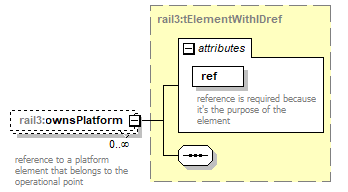 | ||||||||||||||
| namespace | https://www.railml.org/schemas/3.1 | ||||||||||||||
| type | rail3:tElementWithIDref | ||||||||||||||
| properties |
| ||||||||||||||
| attributes |
| ||||||||||||||
| annotation |
| ||||||||||||||
| source | <xs:element name="ownsPlatform" type="rail3:tElementWithIDref" minOccurs="0" maxOccurs="unbounded"> <xs:annotation> <xs:documentation>reference to a platform element that belongs to the operational point</xs:documentation> </xs:annotation> </xs:element> |
element OpEquipment/ownsTrack
| diagram | 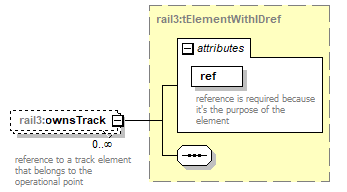 | ||||||||||||||
| namespace | https://www.railml.org/schemas/3.1 | ||||||||||||||
| type | rail3:tElementWithIDref | ||||||||||||||
| properties |
| ||||||||||||||
| attributes |
| ||||||||||||||
| annotation |
| ||||||||||||||
| source | <xs:element name="ownsTrack" type="rail3:tElementWithIDref" minOccurs="0" maxOccurs="unbounded"> <xs:annotation> <xs:documentation>reference to a track element that belongs to the operational point</xs:documentation> </xs:annotation> </xs:element> |
element OpEquipment/ownsSignal
| diagram | 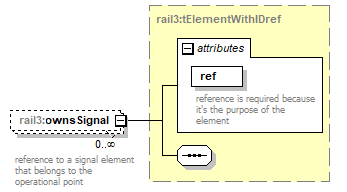 | ||||||||||||||
| namespace | https://www.railml.org/schemas/3.1 | ||||||||||||||
| type | rail3:tElementWithIDref | ||||||||||||||
| properties |
| ||||||||||||||
| attributes |
| ||||||||||||||
| annotation |
| ||||||||||||||
| source | <xs:element name="ownsSignal" type="rail3:tElementWithIDref" minOccurs="0" maxOccurs="unbounded"> <xs:annotation> <xs:documentation>reference to a signal element that belongs to the operational point</xs:documentation> </xs:annotation> </xs:element> |
element OpEquipment/ownsStoppingPlace
| diagram | 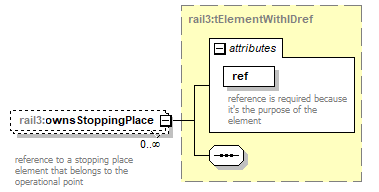 | ||||||||||||||
| namespace | https://www.railml.org/schemas/3.1 | ||||||||||||||
| type | rail3:tElementWithIDref | ||||||||||||||
| properties |
| ||||||||||||||
| attributes |
| ||||||||||||||
| annotation |
| ||||||||||||||
| source | <xs:element name="ownsStoppingPlace" type="rail3:tElementWithIDref" minOccurs="0" maxOccurs="unbounded"> <xs:annotation> <xs:documentation>reference to a stopping place element that belongs to the operational point</xs:documentation> </xs:annotation> </xs:element> |
element OpEquipment/ownsServiceSection
| diagram | 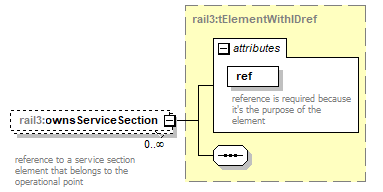 | ||||||||||||||
| namespace | https://www.railml.org/schemas/3.1 | ||||||||||||||
| type | rail3:tElementWithIDref | ||||||||||||||
| properties |
| ||||||||||||||
| attributes |
| ||||||||||||||
| annotation |
| ||||||||||||||
| source | <xs:element name="ownsServiceSection" type="rail3:tElementWithIDref" minOccurs="0" maxOccurs="unbounded"> <xs:annotation> <xs:documentation>reference to a service section element that belongs to the operational point</xs:documentation> </xs:annotation> </xs:element> |
complexType OperationalPoint
| diagram |  | ||||||||||||||||||||||||||||||||||||||
| namespace | https://www.railml.org/schemas/3.1 | ||||||||||||||||||||||||||||||||||||||
| type | extension of rail3:FunctionalInfrastructureEntity | ||||||||||||||||||||||||||||||||||||||
| properties |
| ||||||||||||||||||||||||||||||||||||||
| children | rail3:name rail3:isValid rail3:areaLocation rail3:linearLocation rail3:spotLocation rail3:gmlLocations rail3:networkLocation rail3:designator rail3:external rail3:infrastructureManagerRef rail3:connectedToLine rail3:limitedByBorder rail3:opEquipment rail3:opOperations | ||||||||||||||||||||||||||||||||||||||
| used by |
| ||||||||||||||||||||||||||||||||||||||
| attributes |
| ||||||||||||||||||||||||||||||||||||||
| annotation |
| ||||||||||||||||||||||||||||||||||||||
| source | <xs:complexType name="OperationalPoint"> <xs:annotation> <xs:documentation>The OperationalPoint defines a point in the railway network that is essential for railway operation. Typical examples for railway operational points are stations, block signals or stopping points. Operational points allow an interaction between the railway operator and the train driver.</xs:documentation> </xs:annotation> <xs:complexContent> <xs:extension base="rail3:FunctionalInfrastructureEntity"> <xs:sequence> <xs:element name="infrastructureManagerRef" type="rail3:tElementWithIDref" minOccurs="0" maxOccurs="unbounded"/> <xs:element name="connectedToLine" type="rail3:tElementWithIDref" minOccurs="0" maxOccurs="unbounded"> <xs:annotation> <xs:documentation>reference to a railway line (section) that is connected with this operational point</xs:documentation> </xs:annotation> </xs:element> <xs:element name="limitedByBorder" type="rail3:tElementWithIDref" minOccurs="0" maxOccurs="unbounded"> <xs:annotation> <xs:documentation>reference to a border element that delimits the operational point</xs:documentation> </xs:annotation> </xs:element> <xs:element name="opEquipment" type="rail3:OpEquipment" minOccurs="0" maxOccurs="1"> <xs:annotation> <xs:documentation>child element summarizing the equipment of the operational point</xs:documentation> </xs:annotation> </xs:element> <xs:element name="opOperations" type="rail3:OpOperations" minOccurs="0" maxOccurs="1"> <xs:annotation> <xs:documentation>child element summarizing the operational aspects of the operational point</xs:documentation> </xs:annotation> </xs:element> </xs:sequence> <xs:attribute name="belongsToParent" type="rail3:tRef" use="optional"> <xs:annotation> <xs:documentation>references the one and only parent operational point of this operational point</xs:documentation> </xs:annotation> </xs:attribute> <xs:attribute name="basedOnTemplate" type="rail3:tRef" use="optional"> <xs:annotation> <xs:documentation>references a generic operational point</xs:documentation> </xs:annotation> </xs:attribute> <xs:attribute name="timezone" type="xs:string" use="optional"> <xs:annotation> <xs:documentation>the timezone of the operational point as defined in the tz database, e.g. "Europe/Berlin"</xs:documentation> </xs:annotation> </xs:attribute> </xs:extension> </xs:complexContent> </xs:complexType> |
attribute OperationalPoint/@belongsToParent
| type | rail3:tRef | ||
| properties |
| ||
| annotation |
| ||
| source | <xs:attribute name="belongsToParent" type="rail3:tRef" use="optional"> <xs:annotation> <xs:documentation>references the one and only parent operational point of this operational point</xs:documentation> </xs:annotation> </xs:attribute> |
attribute OperationalPoint/@basedOnTemplate
| type | rail3:tRef | ||
| properties |
| ||
| annotation |
| ||
| source | <xs:attribute name="basedOnTemplate" type="rail3:tRef" use="optional"> <xs:annotation> <xs:documentation>references a generic operational point</xs:documentation> </xs:annotation> </xs:attribute> |
attribute OperationalPoint/@timezone
| type | xs:string | ||
| properties |
| ||
| annotation |
| ||
| source | <xs:attribute name="timezone" type="xs:string" use="optional"> <xs:annotation> <xs:documentation>the timezone of the operational point as defined in the tz database, e.g. "Europe/Berlin"</xs:documentation> </xs:annotation> </xs:attribute> |
element OperationalPoint/infrastructureManagerRef
| diagram | 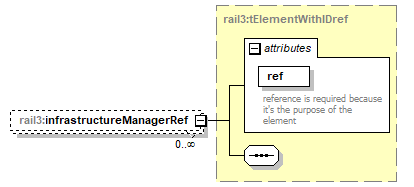 | ||||||||||||||
| namespace | https://www.railml.org/schemas/3.1 | ||||||||||||||
| type | rail3:tElementWithIDref | ||||||||||||||
| properties |
| ||||||||||||||
| attributes |
| ||||||||||||||
| source | <xs:element name="infrastructureManagerRef" type="rail3:tElementWithIDref" minOccurs="0" maxOccurs="unbounded"/> |
element OperationalPoint/connectedToLine
| diagram | 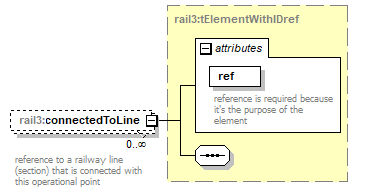 | ||||||||||||||
| namespace | https://www.railml.org/schemas/3.1 | ||||||||||||||
| type | rail3:tElementWithIDref | ||||||||||||||
| properties |
| ||||||||||||||
| attributes |
| ||||||||||||||
| annotation |
| ||||||||||||||
| source | <xs:element name="connectedToLine" type="rail3:tElementWithIDref" minOccurs="0" maxOccurs="unbounded"> <xs:annotation> <xs:documentation>reference to a railway line (section) that is connected with this operational point</xs:documentation> </xs:annotation> </xs:element> |
element OperationalPoint/limitedByBorder
| diagram | 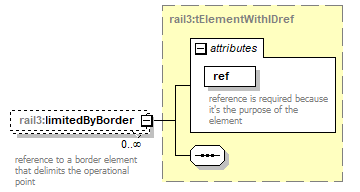 | ||||||||||||||
| namespace | https://www.railml.org/schemas/3.1 | ||||||||||||||
| type | rail3:tElementWithIDref | ||||||||||||||
| properties |
| ||||||||||||||
| attributes |
| ||||||||||||||
| annotation |
| ||||||||||||||
| source | <xs:element name="limitedByBorder" type="rail3:tElementWithIDref" minOccurs="0" maxOccurs="unbounded"> <xs:annotation> <xs:documentation>reference to a border element that delimits the operational point</xs:documentation> </xs:annotation> </xs:element> |
element OperationalPoint/opEquipment
| diagram | 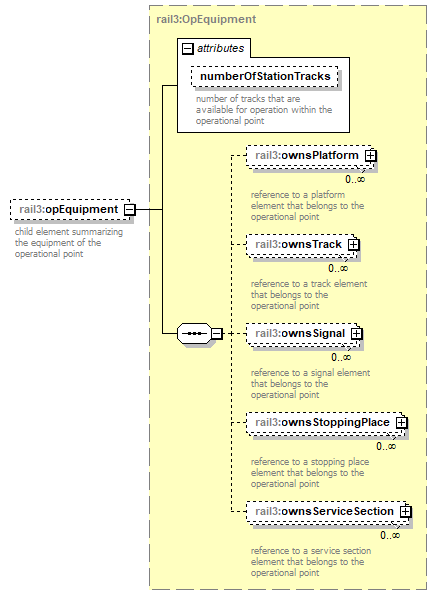 | ||||||||||||||
| namespace | https://www.railml.org/schemas/3.1 | ||||||||||||||
| type | rail3:OpEquipment | ||||||||||||||
| properties |
| ||||||||||||||
| children | rail3:ownsPlatform rail3:ownsTrack rail3:ownsSignal rail3:ownsStoppingPlace rail3:ownsServiceSection | ||||||||||||||
| attributes |
| ||||||||||||||
| annotation |
| ||||||||||||||
| source | <xs:element name="opEquipment" type="rail3:OpEquipment" minOccurs="0" maxOccurs="1"> <xs:annotation> <xs:documentation>child element summarizing the equipment of the operational point</xs:documentation> </xs:annotation> </xs:element> |
element OperationalPoint/opOperations
| diagram |  | ||||||
| namespace | https://www.railml.org/schemas/3.1 | ||||||
| type | rail3:OpOperations | ||||||
| properties |
| ||||||
| children | rail3:opOperation | ||||||
| annotation |
| ||||||
| source | <xs:element name="opOperations" type="rail3:OpOperations" minOccurs="0" maxOccurs="1"> <xs:annotation> <xs:documentation>child element summarizing the operational aspects of the operational point</xs:documentation> </xs:annotation> </xs:element> |
complexType OperationalPoints
| diagram |  | ||
| namespace | https://www.railml.org/schemas/3.1 | ||
| children | rail3:operationalPoint | ||
| used by |
| ||
| source | <xs:complexType name="OperationalPoints"> <xs:sequence> <xs:element name="operationalPoint" type="rail3:OperationalPoint" minOccurs="1" maxOccurs="unbounded"/> </xs:sequence> </xs:complexType> |
element OperationalPoints/operationalPoint
| diagram | 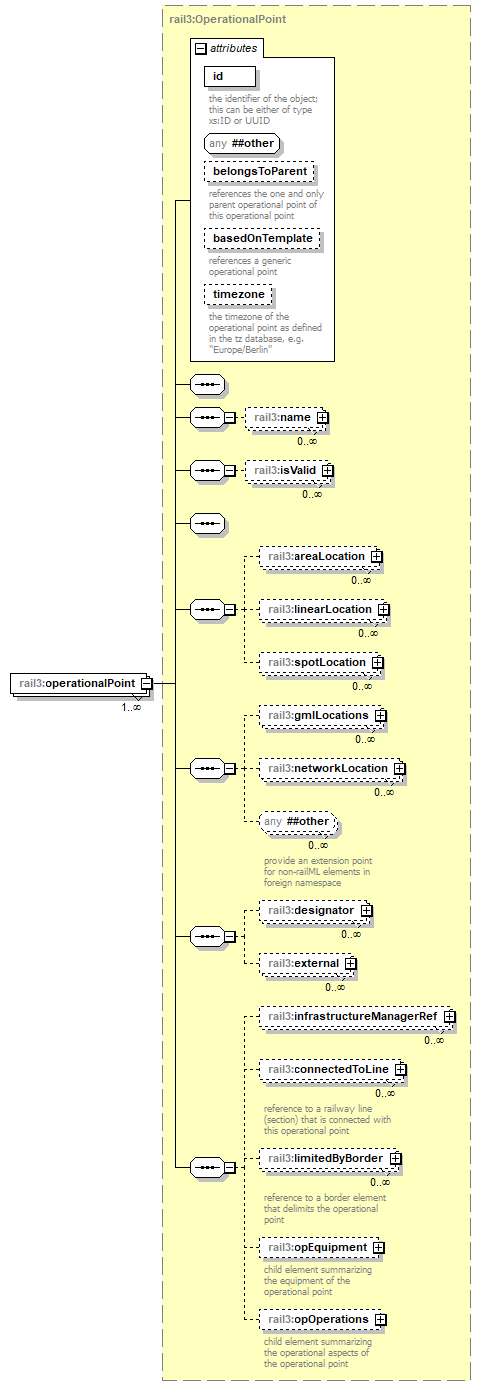 | ||||||||||||||||||||||||||||||||||||||
| namespace | https://www.railml.org/schemas/3.1 | ||||||||||||||||||||||||||||||||||||||
| type | rail3:OperationalPoint | ||||||||||||||||||||||||||||||||||||||
| properties |
| ||||||||||||||||||||||||||||||||||||||
| children | rail3:name rail3:isValid rail3:areaLocation rail3:linearLocation rail3:spotLocation rail3:gmlLocations rail3:networkLocation rail3:designator rail3:external rail3:infrastructureManagerRef rail3:connectedToLine rail3:limitedByBorder rail3:opEquipment rail3:opOperations | ||||||||||||||||||||||||||||||||||||||
| attributes |
| ||||||||||||||||||||||||||||||||||||||
| source | <xs:element name="operationalPoint" type="rail3:OperationalPoint" minOccurs="1" maxOccurs="unbounded"/> |
complexType OpOperation
| diagram | 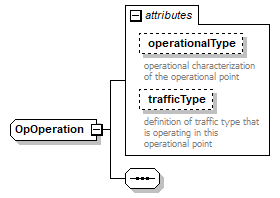 | ||||||||||||||||||||||
| namespace | https://www.railml.org/schemas/3.1 | ||||||||||||||||||||||
| used by |
| ||||||||||||||||||||||
| attributes |
| ||||||||||||||||||||||
| source | <xs:complexType name="OpOperation"> <xs:sequence/> <xs:attribute name="operationalType" type="rail3:tOpOperationalTypeExt" use="optional"> <xs:annotation> <xs:documentation>operational characterization of the operational point</xs:documentation> </xs:annotation> </xs:attribute> <xs:attribute name="trafficType" type="rail3:tOpTrafficTypeExt" use="optional"> <xs:annotation> <xs:documentation>definition of traffic type that is operating in this operational point</xs:documentation> </xs:annotation> </xs:attribute> </xs:complexType> |
attribute OpOperation/@operationalType
| type | rail3:tOpOperationalTypeExt | ||
| properties |
| ||
| annotation |
| ||
| source | <xs:attribute name="operationalType" type="rail3:tOpOperationalTypeExt" use="optional"> <xs:annotation> <xs:documentation>operational characterization of the operational point</xs:documentation> </xs:annotation> </xs:attribute> |
attribute OpOperation/@trafficType
| type | rail3:tOpTrafficTypeExt | ||
| properties |
| ||
| annotation |
| ||
| source | <xs:attribute name="trafficType" type="rail3:tOpTrafficTypeExt" use="optional"> <xs:annotation> <xs:documentation>definition of traffic type that is operating in this operational point</xs:documentation> </xs:annotation> </xs:attribute> |
complexType OpOperations
| diagram |  | ||
| namespace | https://www.railml.org/schemas/3.1 | ||
| children | rail3:opOperation | ||
| used by |
| ||
| source | <xs:complexType name="OpOperations"> <xs:sequence> <xs:element name="opOperation" type="rail3:OpOperation" minOccurs="1" maxOccurs="unbounded"> <xs:annotation> <xs:documentation>railway operation</xs:documentation> </xs:annotation> </xs:element> </xs:sequence> </xs:complexType> |
element OpOperations/opOperation
| diagram | 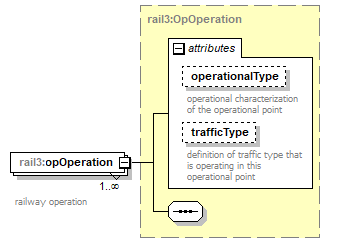 | ||||||||||||||||||||||
| namespace | https://www.railml.org/schemas/3.1 | ||||||||||||||||||||||
| type | rail3:OpOperation | ||||||||||||||||||||||
| properties |
| ||||||||||||||||||||||
| attributes |
| ||||||||||||||||||||||
| annotation |
| ||||||||||||||||||||||
| source | <xs:element name="opOperation" type="rail3:OpOperation" minOccurs="1" maxOccurs="unbounded"> <xs:annotation> <xs:documentation>railway operation</xs:documentation> </xs:annotation> </xs:element> |
complexType OverCrossing
| diagram | 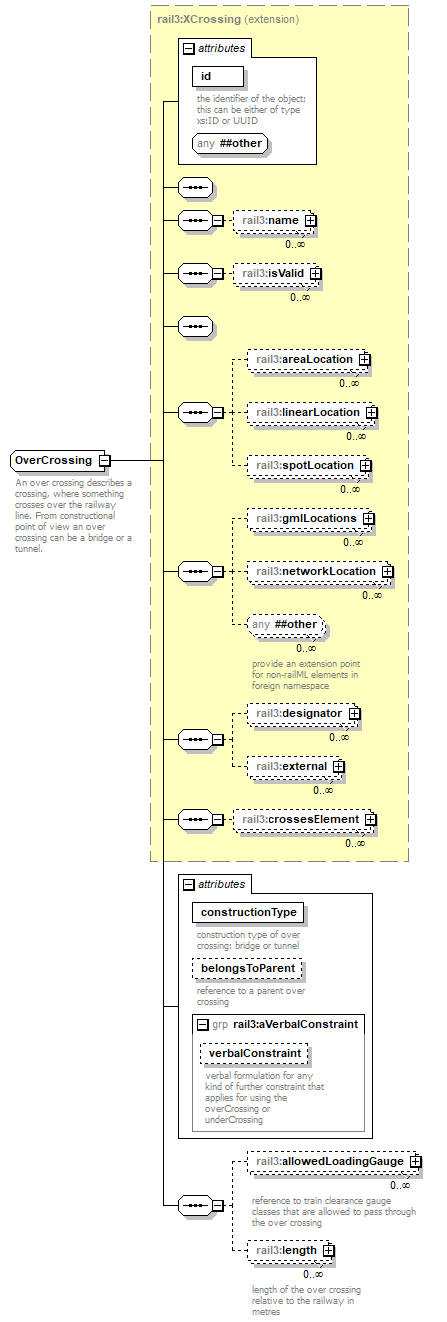 | ||||||||||||||||||||||||||||||||||||||
| namespace | https://www.railml.org/schemas/3.1 | ||||||||||||||||||||||||||||||||||||||
| type | extension of rail3:XCrossing | ||||||||||||||||||||||||||||||||||||||
| properties |
| ||||||||||||||||||||||||||||||||||||||
| children | rail3:name rail3:isValid rail3:areaLocation rail3:linearLocation rail3:spotLocation rail3:gmlLocations rail3:networkLocation rail3:designator rail3:external rail3:crossesElement rail3:allowedLoadingGauge rail3:length | ||||||||||||||||||||||||||||||||||||||
| used by |
| ||||||||||||||||||||||||||||||||||||||
| attributes |
| ||||||||||||||||||||||||||||||||||||||
| annotation |
| ||||||||||||||||||||||||||||||||||||||
| source | <xs:complexType name="OverCrossing"> <xs:annotation> <xs:documentation>An over crossing describes a crossing, where something crosses over the railway line. From constructional point of view an over crossing can be a bridge or a tunnel.</xs:documentation> </xs:annotation> <xs:complexContent> <xs:extension base="rail3:XCrossing"> <xs:sequence> <xs:element name="allowedLoadingGauge" type="rail3:tElementWithIDref" minOccurs="0" maxOccurs="unbounded"> <xs:annotation> <xs:documentation>reference to train clearance gauge classes that are allowed to pass through the over crossing</xs:documentation> </xs:annotation> </xs:element> <xs:element name="length" type="rail3:Length" minOccurs="0" maxOccurs="unbounded"> <xs:annotation> <xs:documentation>length of the over crossing relative to the railway in metres</xs:documentation> </xs:annotation> </xs:element> </xs:sequence> <xs:attribute name="constructionType" type="rail3:tCrossingConstructionTypeExt" use="required"> <xs:annotation> <xs:documentation>construction type of over crossing: bridge or tunnel</xs:documentation> </xs:annotation> </xs:attribute> <xs:attribute name="belongsToParent" type="rail3:tRef" use="optional"> <xs:annotation> <xs:documentation>reference to a parent over crossing</xs:documentation> </xs:annotation> </xs:attribute> <xs:attributeGroup ref="rail3:aVerbalConstraint"/> </xs:extension> </xs:complexContent> </xs:complexType> |
attribute OverCrossing/@constructionType
| type | rail3:tCrossingConstructionTypeExt | ||
| properties |
| ||
| annotation |
| ||
| source | <xs:attribute name="constructionType" type="rail3:tCrossingConstructionTypeExt" use="required"> <xs:annotation> <xs:documentation>construction type of over crossing: bridge or tunnel</xs:documentation> </xs:annotation> </xs:attribute> |
attribute OverCrossing/@belongsToParent
| type | rail3:tRef | ||
| properties |
| ||
| annotation |
| ||
| source | <xs:attribute name="belongsToParent" type="rail3:tRef" use="optional"> <xs:annotation> <xs:documentation>reference to a parent over crossing</xs:documentation> </xs:annotation> </xs:attribute> |
element OverCrossing/allowedLoadingGauge
| diagram | 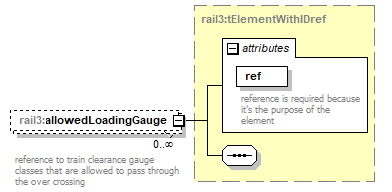 | ||||||||||||||
| namespace | https://www.railml.org/schemas/3.1 | ||||||||||||||
| type | rail3:tElementWithIDref | ||||||||||||||
| properties |
| ||||||||||||||
| attributes |
| ||||||||||||||
| annotation |
| ||||||||||||||
| source | <xs:element name="allowedLoadingGauge" type="rail3:tElementWithIDref" minOccurs="0" maxOccurs="unbounded"> <xs:annotation> <xs:documentation>reference to train clearance gauge classes that are allowed to pass through the over crossing</xs:documentation> </xs:annotation> </xs:element> |
element OverCrossing/length
| diagram | 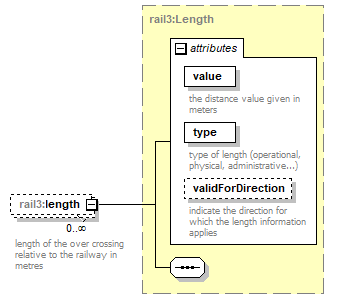 | ||||||||||||||||||||||||||||||
| namespace | https://www.railml.org/schemas/3.1 | ||||||||||||||||||||||||||||||
| type | rail3:Length | ||||||||||||||||||||||||||||||
| properties |
| ||||||||||||||||||||||||||||||
| attributes |
| ||||||||||||||||||||||||||||||
| annotation |
| ||||||||||||||||||||||||||||||
| source | <xs:element name="length" type="rail3:Length" minOccurs="0" maxOccurs="unbounded"> <xs:annotation> <xs:documentation>length of the over crossing relative to the railway in metres</xs:documentation> </xs:annotation> </xs:element> |
complexType OverCrossings
| diagram |  | ||
| namespace | https://www.railml.org/schemas/3.1 | ||
| children | rail3:overCrossing | ||
| used by |
| ||
| source | <xs:complexType name="OverCrossings"> <xs:sequence> <xs:element name="overCrossing" type="rail3:OverCrossing" minOccurs="1" maxOccurs="unbounded"/> </xs:sequence> </xs:complexType> |
element OverCrossings/overCrossing
| diagram | 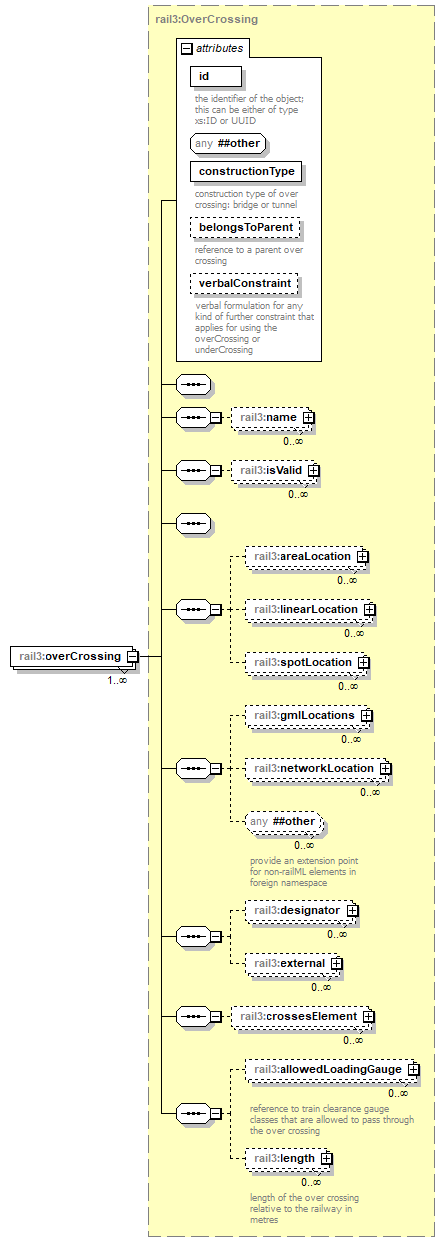 | ||||||||||||||||||||||||||||||||||||||
| namespace | https://www.railml.org/schemas/3.1 | ||||||||||||||||||||||||||||||||||||||
| type | rail3:OverCrossing | ||||||||||||||||||||||||||||||||||||||
| properties |
| ||||||||||||||||||||||||||||||||||||||
| children | rail3:name rail3:isValid rail3:areaLocation rail3:linearLocation rail3:spotLocation rail3:gmlLocations rail3:networkLocation rail3:designator rail3:external rail3:crossesElement rail3:allowedLoadingGauge rail3:length | ||||||||||||||||||||||||||||||||||||||
| attributes |
| ||||||||||||||||||||||||||||||||||||||
| source | <xs:element name="overCrossing" type="rail3:OverCrossing" minOccurs="1" maxOccurs="unbounded"/> |
complexType PantographSpacing
| diagram | 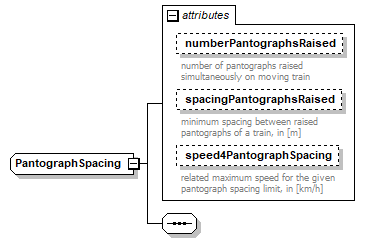 | ||||||||||||||||||||||||||||||
| namespace | https://www.railml.org/schemas/3.1 | ||||||||||||||||||||||||||||||
| used by |
| ||||||||||||||||||||||||||||||
| attributes |
| ||||||||||||||||||||||||||||||
| source | <xs:complexType name="PantographSpacing"> <xs:sequence/> <xs:attribute name="numberPantographsRaised" type="xs:integer" use="optional"> <xs:annotation> <xs:documentation>number of pantographs raised simultaneously on moving train</xs:documentation> </xs:annotation> </xs:attribute> <xs:attribute name="spacingPantographsRaised" type="rail3:tLengthM" use="optional"> <xs:annotation> <xs:documentation>minimum spacing between raised pantographs of a train, in [m]</xs:documentation> </xs:annotation> </xs:attribute> <xs:attribute name="speed4PantographSpacing" type="rail3:tSpeedKmPerHour" use="optional"> <xs:annotation> <xs:documentation>related maximum speed for the given pantograph spacing limit, in [km/h]</xs:documentation> </xs:annotation> </xs:attribute> </xs:complexType> |
attribute PantographSpacing/@numberPantographsRaised
| type | xs:integer | ||
| properties |
| ||
| annotation |
| ||
| source | <xs:attribute name="numberPantographsRaised" type="xs:integer" use="optional"> <xs:annotation> <xs:documentation>number of pantographs raised simultaneously on moving train</xs:documentation> </xs:annotation> </xs:attribute> |
attribute PantographSpacing/@spacingPantographsRaised
| type | rail3:tLengthM | ||
| properties |
| ||
| annotation |
| ||
| source | <xs:attribute name="spacingPantographsRaised" type="rail3:tLengthM" use="optional"> <xs:annotation> <xs:documentation>minimum spacing between raised pantographs of a train, in [m]</xs:documentation> </xs:annotation> </xs:attribute> |
attribute PantographSpacing/@speed4PantographSpacing
| type | rail3:tSpeedKmPerHour | ||
| properties |
| ||
| annotation |
| ||
| source | <xs:attribute name="speed4PantographSpacing" type="rail3:tSpeedKmPerHour" use="optional"> <xs:annotation> <xs:documentation>related maximum speed for the given pantograph spacing limit, in [km/h]</xs:documentation> </xs:annotation> </xs:attribute> |
complexType PhaseSeparationSection
| diagram | 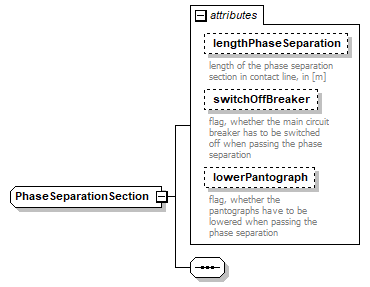 | ||||||||||||||||||||||||||||||
| namespace | https://www.railml.org/schemas/3.1 | ||||||||||||||||||||||||||||||
| used by |
| ||||||||||||||||||||||||||||||
| attributes |
| ||||||||||||||||||||||||||||||
| source | <xs:complexType name="PhaseSeparationSection"> <xs:sequence/> <xs:attribute name="lengthPhaseSeparation" type="rail3:tLengthM" use="optional"> <xs:annotation> <xs:documentation>length of the phase separation section in contact line, in [m]</xs:documentation> </xs:annotation> </xs:attribute> <xs:attribute name="switchOffBreaker" type="xs:boolean" use="optional"> <xs:annotation> <xs:documentation>flag, whether the main circuit breaker has to be switched off when passing the phase separation</xs:documentation> </xs:annotation> </xs:attribute> <xs:attribute name="lowerPantograph" type="xs:boolean" use="optional"> <xs:annotation> <xs:documentation>flag, whether the pantographs have to be lowered when passing the phase separation</xs:documentation> </xs:annotation> </xs:attribute> </xs:complexType> |
attribute PhaseSeparationSection/@lengthPhaseSeparation
| type | rail3:tLengthM | ||
| properties |
| ||
| annotation |
| ||
| source | <xs:attribute name="lengthPhaseSeparation" type="rail3:tLengthM" use="optional"> <xs:annotation> <xs:documentation>length of the phase separation section in contact line, in [m]</xs:documentation> </xs:annotation> </xs:attribute> |
attribute PhaseSeparationSection/@switchOffBreaker
| type | xs:boolean | ||
| properties |
| ||
| annotation |
| ||
| source | <xs:attribute name="switchOffBreaker" type="xs:boolean" use="optional"> <xs:annotation> <xs:documentation>flag, whether the main circuit breaker has to be switched off when passing the phase separation</xs:documentation> </xs:annotation> </xs:attribute> |
attribute PhaseSeparationSection/@lowerPantograph
| type | xs:boolean | ||
| properties |
| ||
| annotation |
| ||
| source | <xs:attribute name="lowerPantograph" type="xs:boolean" use="optional"> <xs:annotation> <xs:documentation>flag, whether the pantographs have to be lowered when passing the phase separation</xs:documentation> </xs:annotation> </xs:attribute> |
complexType PhysicalFacilities
| diagram |  | ||
| namespace | https://www.railml.org/schemas/3.1 | ||
| used by |
| ||
| annotation |
| ||
| source | <xs:complexType name="PhysicalFacilities"> <xs:annotation> <xs:documentation>This is the top level element for railML3 physical facilities infrastructure model. It is currently empty, but allows for specific extensions via the any element</xs:documentation> </xs:annotation> <xs:sequence> <xs:any namespace="##other" processContents="strict" minOccurs="0" maxOccurs="unbounded"> <xs:annotation> <xs:documentation>provide an extension point for non-railML elements in foreign namespace</xs:documentation> </xs:annotation> </xs:any> </xs:sequence> </xs:complexType> |
complexType Platform
| diagram |  | ||||||||||||||||||||||||||||||||||||||
| namespace | https://www.railml.org/schemas/3.1 | ||||||||||||||||||||||||||||||||||||||
| type | extension of rail3:FunctionalInfrastructureEntity | ||||||||||||||||||||||||||||||||||||||
| properties |
| ||||||||||||||||||||||||||||||||||||||
| children | rail3:name rail3:isValid rail3:areaLocation rail3:linearLocation rail3:spotLocation rail3:gmlLocations rail3:networkLocation rail3:designator rail3:external rail3:ownsPlatformEdge rail3:width rail3:length | ||||||||||||||||||||||||||||||||||||||
| used by |
| ||||||||||||||||||||||||||||||||||||||
| attributes |
| ||||||||||||||||||||||||||||||||||||||
| source | <xs:complexType name="Platform"> <xs:complexContent> <xs:extension base="rail3:FunctionalInfrastructureEntity"> <xs:sequence> <xs:element name="ownsPlatformEdge" type="rail3:tElementWithIDref" minOccurs="0" maxOccurs="unbounded"> <xs:annotation> <xs:documentation>reference to platform edge that belongs to this platform</xs:documentation> </xs:annotation> </xs:element> <xs:element name="width" type="rail3:Length" minOccurs="0" maxOccurs="unbounded"> <xs:annotation> <xs:documentation>width of the platform</xs:documentation> </xs:annotation> </xs:element> <xs:element name="length" type="rail3:Length" minOccurs="0" maxOccurs="unbounded"> <xs:annotation> <xs:documentation>length of the platform (edge)</xs:documentation> </xs:annotation> </xs:element> </xs:sequence> <xs:attribute name="belongsToParent" type="rail3:tRef" use="optional"> <xs:annotation> <xs:documentation>reference to a parent platform (edge); use this attribute for grouping of platform edges with different parameters (e.g. different heights)</xs:documentation> </xs:annotation> </xs:attribute> <xs:attribute name="basedOnTemplate" type="rail3:tRef" use="optional"> <xs:annotation> <xs:documentation>reference to a template platform (edge)</xs:documentation> </xs:annotation> </xs:attribute> <xs:attribute name="height" type="rail3:tLengthM" use="optional"> <xs:annotation> <xs:documentation>the height of the platform edge in metres</xs:documentation> </xs:annotation> </xs:attribute> </xs:extension> </xs:complexContent> </xs:complexType> |
attribute Platform/@belongsToParent
| type | rail3:tRef | ||
| properties |
| ||
| annotation |
| ||
| source | <xs:attribute name="belongsToParent" type="rail3:tRef" use="optional"> <xs:annotation> <xs:documentation>reference to a parent platform (edge); use this attribute for grouping of platform edges with different parameters (e.g. different heights)</xs:documentation> </xs:annotation> </xs:attribute> |
attribute Platform/@basedOnTemplate
| type | rail3:tRef | ||
| properties |
| ||
| annotation |
| ||
| source | <xs:attribute name="basedOnTemplate" type="rail3:tRef" use="optional"> <xs:annotation> <xs:documentation>reference to a template platform (edge)</xs:documentation> </xs:annotation> </xs:attribute> |
attribute Platform/@height
| type | rail3:tLengthM | ||
| properties |
| ||
| annotation |
| ||
| source | <xs:attribute name="height" type="rail3:tLengthM" use="optional"> <xs:annotation> <xs:documentation>the height of the platform edge in metres</xs:documentation> </xs:annotation> </xs:attribute> |
element Platform/ownsPlatformEdge
| diagram | 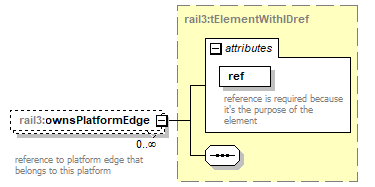 | ||||||||||||||
| namespace | https://www.railml.org/schemas/3.1 | ||||||||||||||
| type | rail3:tElementWithIDref | ||||||||||||||
| properties |
| ||||||||||||||
| attributes |
| ||||||||||||||
| annotation |
| ||||||||||||||
| source | <xs:element name="ownsPlatformEdge" type="rail3:tElementWithIDref" minOccurs="0" maxOccurs="unbounded"> <xs:annotation> <xs:documentation>reference to platform edge that belongs to this platform</xs:documentation> </xs:annotation> </xs:element> |
element Platform/width
| diagram | 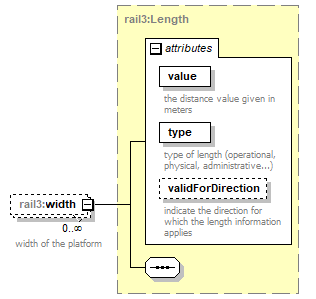 | ||||||||||||||||||||||||||||||
| namespace | https://www.railml.org/schemas/3.1 | ||||||||||||||||||||||||||||||
| type | rail3:Length | ||||||||||||||||||||||||||||||
| properties |
| ||||||||||||||||||||||||||||||
| attributes |
| ||||||||||||||||||||||||||||||
| annotation |
| ||||||||||||||||||||||||||||||
| source | <xs:element name="width" type="rail3:Length" minOccurs="0" maxOccurs="unbounded"> <xs:annotation> <xs:documentation>width of the platform</xs:documentation> </xs:annotation> </xs:element> |
element Platform/length
| diagram | 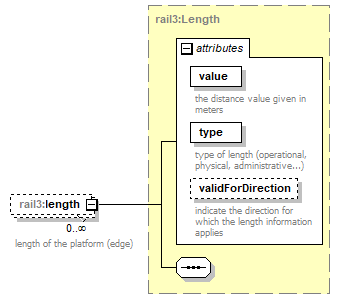 | ||||||||||||||||||||||||||||||
| namespace | https://www.railml.org/schemas/3.1 | ||||||||||||||||||||||||||||||
| type | rail3:Length | ||||||||||||||||||||||||||||||
| properties |
| ||||||||||||||||||||||||||||||
| attributes |
| ||||||||||||||||||||||||||||||
| annotation |
| ||||||||||||||||||||||||||||||
| source | <xs:element name="length" type="rail3:Length" minOccurs="0" maxOccurs="unbounded"> <xs:annotation> <xs:documentation>length of the platform (edge)</xs:documentation> </xs:annotation> </xs:element> |
complexType Platforms
| diagram |  | ||
| namespace | https://www.railml.org/schemas/3.1 | ||
| children | rail3:platform | ||
| used by |
| ||
| source | <xs:complexType name="Platforms"> <xs:sequence> <xs:element name="platform" type="rail3:Platform" minOccurs="1" maxOccurs="unbounded"/> </xs:sequence> </xs:complexType> |
element Platforms/platform
| diagram |  | ||||||||||||||||||||||||||||||||||||||
| namespace | https://www.railml.org/schemas/3.1 | ||||||||||||||||||||||||||||||||||||||
| type | rail3:Platform | ||||||||||||||||||||||||||||||||||||||
| properties |
| ||||||||||||||||||||||||||||||||||||||
| children | rail3:name rail3:isValid rail3:areaLocation rail3:linearLocation rail3:spotLocation rail3:gmlLocations rail3:networkLocation rail3:designator rail3:external rail3:ownsPlatformEdge rail3:width rail3:length | ||||||||||||||||||||||||||||||||||||||
| attributes |
| ||||||||||||||||||||||||||||||||||||||
| source | <xs:element name="platform" type="rail3:Platform" minOccurs="1" maxOccurs="unbounded"/> |
complexType PointTypeCoordinate
| diagram | 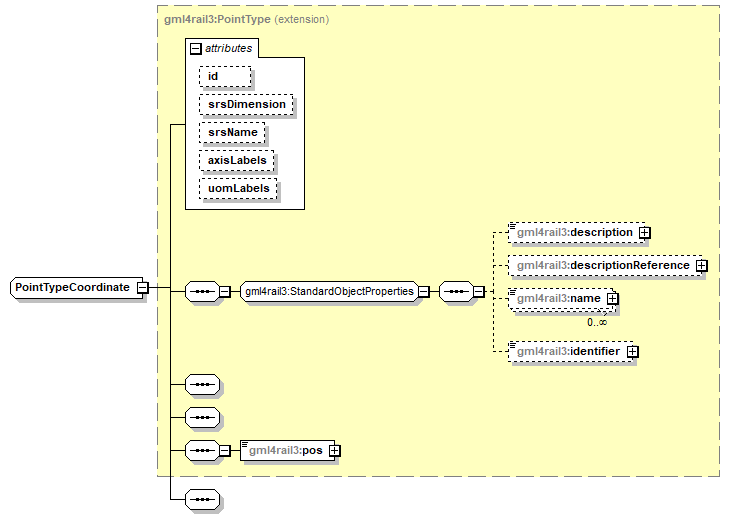 | ||||||||||||||||||||||||||||||||||||
| namespace | https://www.railml.org/schemas/3.1 | ||||||||||||||||||||||||||||||||||||
| type | extension of gml4rail3:PointType | ||||||||||||||||||||||||||||||||||||
| properties |
| ||||||||||||||||||||||||||||||||||||
| children | gml4rail3:description gml4rail3:descriptionReference gml4rail3:name gml4rail3:identifier gml4rail3:pos | ||||||||||||||||||||||||||||||||||||
| used by |
| ||||||||||||||||||||||||||||||||||||
| attributes |
| ||||||||||||||||||||||||||||||||||||
| source | <xs:complexType name="PointTypeCoordinate"> <xs:complexContent> <xs:extension base="gml4rail3:PointType"> <xs:sequence/> </xs:extension> </xs:complexContent> </xs:complexType> |
complexType ProjectionCoordinate
| diagram | 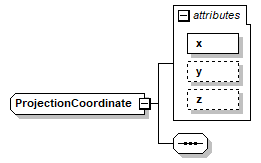 | ||||||||||||||||||||||||
| namespace | https://www.railml.org/schemas/3.1 | ||||||||||||||||||||||||
| used by |
| ||||||||||||||||||||||||
| attributes |
| ||||||||||||||||||||||||
| source | <xs:complexType name="ProjectionCoordinate"> <xs:sequence/> <xs:attribute name="x" type="xs:decimal" use="required"/> <xs:attribute name="y" type="xs:decimal" use="optional"/> <xs:attribute name="z" type="xs:decimal" use="optional"/> </xs:complexType> |
attribute ProjectionCoordinate/@x
| type | xs:decimal | ||
| properties |
| ||
| source | <xs:attribute name="x" type="xs:decimal" use="required"/> |
attribute ProjectionCoordinate/@y
| type | xs:decimal | ||
| properties |
| ||
| source | <xs:attribute name="y" type="xs:decimal" use="optional"/> |
attribute ProjectionCoordinate/@z
| type | xs:decimal | ||
| properties |
| ||
| source | <xs:attribute name="z" type="xs:decimal" use="optional"/> |
complexType RestrictionArea
| diagram | 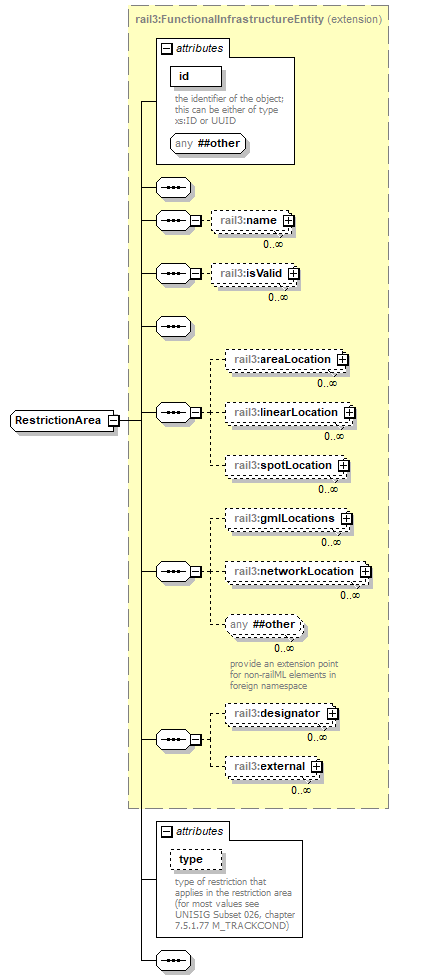 | ||||||||||||||||||||||
| namespace | https://www.railml.org/schemas/3.1 | ||||||||||||||||||||||
| type | extension of rail3:FunctionalInfrastructureEntity | ||||||||||||||||||||||
| properties |
| ||||||||||||||||||||||
| children | rail3:name rail3:isValid rail3:areaLocation rail3:linearLocation rail3:spotLocation rail3:gmlLocations rail3:networkLocation rail3:designator rail3:external | ||||||||||||||||||||||
| used by |
| ||||||||||||||||||||||
| attributes |
| ||||||||||||||||||||||
| source | <xs:complexType name="RestrictionArea"> <xs:complexContent> <xs:extension base="rail3:FunctionalInfrastructureEntity"> <xs:sequence/> <xs:attribute name="type" type="rail3:tRestrictionAreaTypeExt" use="optional"> <xs:annotation> <xs:documentation>type of restriction that applies in the restriction area (for most values see UNISIG Subset 026, chapter 7.5.1.77 M_TRACKCOND)</xs:documentation> </xs:annotation> </xs:attribute> </xs:extension> </xs:complexContent> </xs:complexType> |
attribute RestrictionArea/@type
| type | rail3:tRestrictionAreaTypeExt | ||
| properties |
| ||
| annotation |
| ||
| source | <xs:attribute name="type" type="rail3:tRestrictionAreaTypeExt" use="optional"> <xs:annotation> <xs:documentation>type of restriction that applies in the restriction area (for most values see UNISIG Subset 026, chapter 7.5.1.77 M_TRACKCOND)</xs:documentation> </xs:annotation> </xs:attribute> |
complexType RestrictionAreas
| diagram |  | ||
| namespace | https://www.railml.org/schemas/3.1 | ||
| children | rail3:restrictionArea | ||
| used by |
| ||
| source | <xs:complexType name="RestrictionAreas"> <xs:sequence> <xs:element name="restrictionArea" type="rail3:RestrictionArea" minOccurs="1" maxOccurs="unbounded"/> </xs:sequence> </xs:complexType> |
element RestrictionAreas/restrictionArea
| diagram | 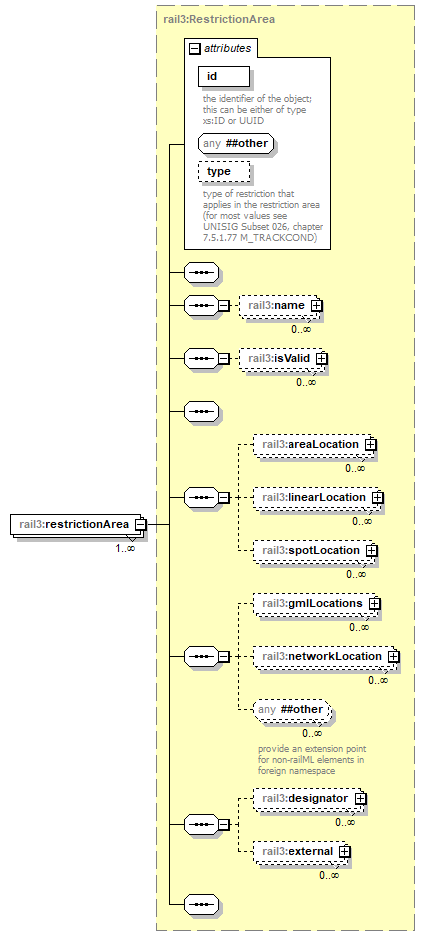 | ||||||||||||||||||||||
| namespace | https://www.railml.org/schemas/3.1 | ||||||||||||||||||||||
| type | rail3:RestrictionArea | ||||||||||||||||||||||
| properties |
| ||||||||||||||||||||||
| children | rail3:name rail3:isValid rail3:areaLocation rail3:linearLocation rail3:spotLocation rail3:gmlLocations rail3:networkLocation rail3:designator rail3:external | ||||||||||||||||||||||
| attributes |
| ||||||||||||||||||||||
| source | <xs:element name="restrictionArea" type="rail3:RestrictionArea" minOccurs="1" maxOccurs="unbounded"/> |
complexType ServiceSection
| diagram |  | ||||||||||||||||||||||||||||||||||||||||||||||||||||||||||||||||||||||||||||||||||||||||||||||||||||||||||||||
| namespace | https://www.railml.org/schemas/3.1 | ||||||||||||||||||||||||||||||||||||||||||||||||||||||||||||||||||||||||||||||||||||||||||||||||||||||||||||||
| type | extension of rail3:FunctionalInfrastructureEntity | ||||||||||||||||||||||||||||||||||||||||||||||||||||||||||||||||||||||||||||||||||||||||||||||||||||||||||||||
| properties |
| ||||||||||||||||||||||||||||||||||||||||||||||||||||||||||||||||||||||||||||||||||||||||||||||||||||||||||||||
| children | rail3:name rail3:isValid rail3:areaLocation rail3:linearLocation rail3:spotLocation rail3:gmlLocations rail3:networkLocation rail3:designator rail3:external | ||||||||||||||||||||||||||||||||||||||||||||||||||||||||||||||||||||||||||||||||||||||||||||||||||||||||||||||
| used by |
| ||||||||||||||||||||||||||||||||||||||||||||||||||||||||||||||||||||||||||||||||||||||||||||||||||||||||||||||
| attributes |
| ||||||||||||||||||||||||||||||||||||||||||||||||||||||||||||||||||||||||||||||||||||||||||||||||||||||||||||||
| source | <xs:complexType name="ServiceSection"> <xs:complexContent> <xs:extension base="rail3:FunctionalInfrastructureEntity"> <xs:sequence/> <xs:attribute name="belongsToParent" type="rail3:tRef" use="optional"> <xs:annotation> <xs:documentation>reference to the (one and only) parent service section</xs:documentation> </xs:annotation> </xs:attribute> <xs:attributeGroup ref="rail3:aServiceSection"/> </xs:extension> </xs:complexContent> </xs:complexType> |
attribute ServiceSection/@belongsToParent
| type | rail3:tRef | ||
| properties |
| ||
| annotation |
| ||
| source | <xs:attribute name="belongsToParent" type="rail3:tRef" use="optional"> <xs:annotation> <xs:documentation>reference to the (one and only) parent service section</xs:documentation> </xs:annotation> </xs:attribute> |
complexType ServiceSections
| diagram |  | ||
| namespace | https://www.railml.org/schemas/3.1 | ||
| children | rail3:serviceSection | ||
| used by |
| ||
| source | <xs:complexType name="ServiceSections"> <xs:sequence> <xs:element name="serviceSection" type="rail3:ServiceSection" minOccurs="1" maxOccurs="unbounded"/> </xs:sequence> </xs:complexType> |
element ServiceSections/serviceSection
| diagram |  | ||||||||||||||||||||||||||||||||||||||||||||||||||||||||||||||||||||||||||||||||||||||||||||||||||||||||||||||
| namespace | https://www.railml.org/schemas/3.1 | ||||||||||||||||||||||||||||||||||||||||||||||||||||||||||||||||||||||||||||||||||||||||||||||||||||||||||||||
| type | rail3:ServiceSection | ||||||||||||||||||||||||||||||||||||||||||||||||||||||||||||||||||||||||||||||||||||||||||||||||||||||||||||||
| properties |
| ||||||||||||||||||||||||||||||||||||||||||||||||||||||||||||||||||||||||||||||||||||||||||||||||||||||||||||||
| children | rail3:name rail3:isValid rail3:areaLocation rail3:linearLocation rail3:spotLocation rail3:gmlLocations rail3:networkLocation rail3:designator rail3:external | ||||||||||||||||||||||||||||||||||||||||||||||||||||||||||||||||||||||||||||||||||||||||||||||||||||||||||||||
| attributes |
| ||||||||||||||||||||||||||||||||||||||||||||||||||||||||||||||||||||||||||||||||||||||||||||||||||||||||||||||
| source | <xs:element name="serviceSection" type="rail3:ServiceSection" minOccurs="1" maxOccurs="unbounded"/> |
complexType SignalAnnouncement
| diagram | 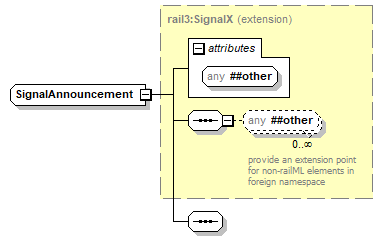 | ||||||
| namespace | https://www.railml.org/schemas/3.1 | ||||||
| type | extension of rail3:SignalX | ||||||
| properties |
| ||||||
| used by |
| ||||||
| attributes |
| ||||||
| source | <xs:complexType name="SignalAnnouncement"> <xs:complexContent> <xs:extension base="rail3:SignalX"> <xs:sequence/> </xs:extension> </xs:complexContent> </xs:complexType> |
complexType SignalCatenary
| diagram | 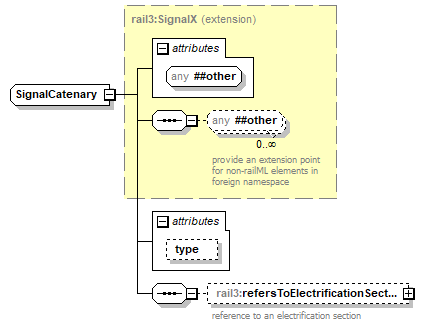 | ||||||||||||
| namespace | https://www.railml.org/schemas/3.1 | ||||||||||||
| type | extension of rail3:SignalX | ||||||||||||
| properties |
| ||||||||||||
| children | rail3:refersToElectrificationSection | ||||||||||||
| used by |
| ||||||||||||
| attributes |
| ||||||||||||
| source | <xs:complexType name="SignalCatenary"> <xs:complexContent> <xs:extension base="rail3:SignalX"> <xs:sequence> <xs:element name="refersToElectrificationSection" type="rail3:tElementWithIDref" minOccurs="0" maxOccurs="1"> <xs:annotation> <xs:documentation>reference to an electrification section</xs:documentation> </xs:annotation> </xs:element> </xs:sequence> <xs:attribute name="type" type="rail3:tSignalCatenaryType" use="optional"/> </xs:extension> </xs:complexContent> </xs:complexType> |
attribute SignalCatenary/@type
| type | rail3:tSignalCatenaryType | |||||||||
| properties |
| |||||||||
| facets |
| |||||||||
| source | <xs:attribute name="type" type="rail3:tSignalCatenaryType" use="optional"/> |
element SignalCatenary/refersToElectrificationSection
| diagram | 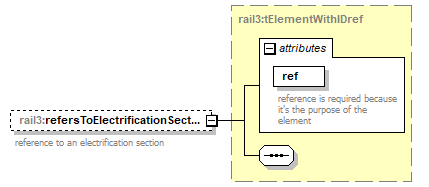 | ||||||||||||||
| namespace | https://www.railml.org/schemas/3.1 | ||||||||||||||
| type | rail3:tElementWithIDref | ||||||||||||||
| properties |
| ||||||||||||||
| attributes |
| ||||||||||||||
| annotation |
| ||||||||||||||
| source | <xs:element name="refersToElectrificationSection" type="rail3:tElementWithIDref" minOccurs="0" maxOccurs="1"> <xs:annotation> <xs:documentation>reference to an electrification section</xs:documentation> </xs:annotation> </xs:element> |
complexType SignalConstruction
| diagram | 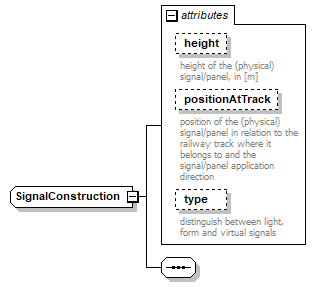 | ||||||||||||||||||||||||||||||
| namespace | https://www.railml.org/schemas/3.1 | ||||||||||||||||||||||||||||||
| used by |
| ||||||||||||||||||||||||||||||
| attributes |
| ||||||||||||||||||||||||||||||
| source | <xs:complexType name="SignalConstruction"> <xs:sequence/> <xs:attribute name="height" type="rail3:tLengthM" use="optional"> <xs:annotation> <xs:documentation>height of the (physical) signal/panel, in [m]</xs:documentation> </xs:annotation> </xs:attribute> <xs:attribute name="positionAtTrack" type="rail3:tWiderTrackPosition" use="optional"> <xs:annotation> <xs:documentation>position of the (physical) signal/panel in relation to the railway track where it belongs to and the signal/panel application direction</xs:documentation> </xs:annotation> </xs:attribute> <xs:attribute name="type" type="rail3:tSignalConstructionType" use="optional"> <xs:annotation> <xs:documentation>distinguish between light, form and virtual signals</xs:documentation> </xs:annotation> </xs:attribute> </xs:complexType> |
attribute SignalConstruction/@height
| type | rail3:tLengthM | ||
| properties |
| ||
| annotation |
| ||
| source | <xs:attribute name="height" type="rail3:tLengthM" use="optional"> <xs:annotation> <xs:documentation>height of the (physical) signal/panel, in [m]</xs:documentation> </xs:annotation> </xs:attribute> |
attribute SignalConstruction/@positionAtTrack
| type | rail3:tWiderTrackPosition | ||||||||||||
| properties |
| ||||||||||||
| facets |
| ||||||||||||
| annotation |
| ||||||||||||
| source | <xs:attribute name="positionAtTrack" type="rail3:tWiderTrackPosition" use="optional"> <xs:annotation> <xs:documentation>position of the (physical) signal/panel in relation to the railway track where it belongs to and the signal/panel application direction</xs:documentation> </xs:annotation> </xs:attribute> |
attribute SignalConstruction/@type
| type | rail3:tSignalConstructionType | ||||||||||||||||||||||||||||
| properties |
| ||||||||||||||||||||||||||||
| facets |
| ||||||||||||||||||||||||||||
| annotation |
| ||||||||||||||||||||||||||||
| source | <xs:attribute name="type" type="rail3:tSignalConstructionType" use="optional"> <xs:annotation> <xs:documentation>distinguish between light, form and virtual signals</xs:documentation> </xs:annotation> </xs:attribute> |
complexType SignalDanger
| diagram | 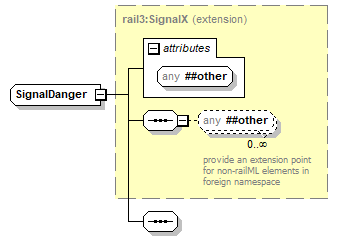 | ||||||
| namespace | https://www.railml.org/schemas/3.1 | ||||||
| type | extension of rail3:SignalX | ||||||
| properties |
| ||||||
| used by |
| ||||||
| attributes |
| ||||||
| source | <xs:complexType name="SignalDanger"> <xs:complexContent> <xs:extension base="rail3:SignalX"> <xs:sequence/> </xs:extension> </xs:complexContent> </xs:complexType> |
complexType SignalEtcs
| diagram | 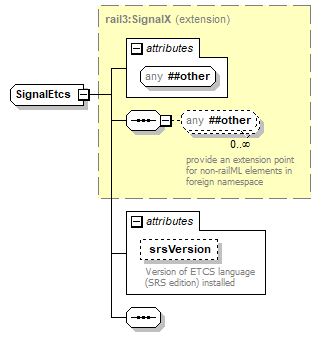 | ||||||||||||||
| namespace | https://www.railml.org/schemas/3.1 | ||||||||||||||
| type | extension of rail3:SignalX | ||||||||||||||
| properties |
| ||||||||||||||
| used by |
| ||||||||||||||
| attributes |
| ||||||||||||||
| source | <xs:complexType name="SignalEtcs"> <xs:complexContent> <xs:extension base="rail3:SignalX"> <xs:sequence/> <xs:attribute name="srsVersion" type="xs:string" use="optional"> <xs:annotation> <xs:documentation>Version of ETCS language (SRS edition) installed</xs:documentation> </xs:annotation> </xs:attribute> </xs:extension> </xs:complexContent> </xs:complexType> |
attribute SignalEtcs/@srsVersion
| type | xs:string | ||
| properties |
| ||
| annotation |
| ||
| source | <xs:attribute name="srsVersion" type="xs:string" use="optional"> <xs:annotation> <xs:documentation>Version of ETCS language (SRS edition) installed</xs:documentation> </xs:annotation> </xs:attribute> |
complexType SignalInformation
| diagram | 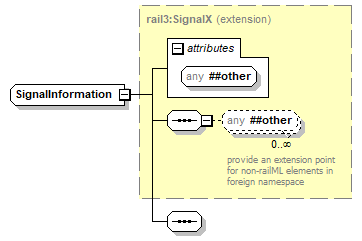 | ||||||
| namespace | https://www.railml.org/schemas/3.1 | ||||||
| type | extension of rail3:SignalX | ||||||
| properties |
| ||||||
| used by |
| ||||||
| attributes |
| ||||||
| source | <xs:complexType name="SignalInformation"> <xs:complexContent> <xs:extension base="rail3:SignalX"> <xs:sequence/> </xs:extension> </xs:complexContent> </xs:complexType> |
complexType SignalIS
| diagram |  | ||||||||||||||||||||||||||||||||||||||
| namespace | https://www.railml.org/schemas/3.1 | ||||||||||||||||||||||||||||||||||||||
| type | extension of rail3:FunctionalInfrastructureEntity | ||||||||||||||||||||||||||||||||||||||
| properties |
| ||||||||||||||||||||||||||||||||||||||
| children | rail3:name rail3:isValid rail3:areaLocation rail3:linearLocation rail3:spotLocation rail3:gmlLocations rail3:networkLocation rail3:designator rail3:external rail3:isAnnouncementSignal rail3:isCatenarySignal rail3:isDangerSignal rail3:isEtcsSignal rail3:isInformationSignal rail3:isLevelCrossingSignal rail3:isMilepost rail3:isSpeedSignal rail3:isStopPost rail3:isTrainMovementSignal rail3:isTrainRadioSignal rail3:isVehicleEquipmentSignal rail3:connectedWithBaliseGroup rail3:signalConstruction | ||||||||||||||||||||||||||||||||||||||
| used by |
| ||||||||||||||||||||||||||||||||||||||
| attributes |
| ||||||||||||||||||||||||||||||||||||||
| source | <xs:complexType name="SignalIS"> <xs:complexContent> <xs:extension base="rail3:FunctionalInfrastructureEntity"> <xs:sequence> <xs:element name="isAnnouncementSignal" type="rail3:SignalAnnouncement" minOccurs="0" maxOccurs="1"/> <xs:element name="isCatenarySignal" type="rail3:SignalCatenary" minOccurs="0" maxOccurs="1"> <xs:annotation> <xs:documentation>use this child element to specify the catenary signal/sign in more detail</xs:documentation> </xs:annotation> </xs:element> <xs:element name="isDangerSignal" type="rail3:SignalDanger" minOccurs="0" maxOccurs="1"/> <xs:element name="isEtcsSignal" type="rail3:SignalEtcs" minOccurs="0" maxOccurs="1"> <xs:annotation> <xs:documentation>use this child element to specify the ETCS signal in more detail</xs:documentation> </xs:annotation> </xs:element> <xs:element name="isInformationSignal" type="rail3:SignalInformation" minOccurs="0" maxOccurs="1"/> <xs:element name="isLevelCrossingSignal" type="rail3:SignalLevelCrossing" minOccurs="0" maxOccurs="1"> <xs:annotation> <xs:documentation>use this child element to specify the level crossing signal in more detail</xs:documentation> </xs:annotation> </xs:element> <xs:element name="isMilepost" type="rail3:SignalMilepost" minOccurs="0" maxOccurs="1"> <xs:annotation> <xs:documentation>use this child element to specify the milepost marker in more detail</xs:documentation> </xs:annotation> </xs:element> <xs:element name="isSpeedSignal" type="rail3:SignalSpeed" minOccurs="0" maxOccurs="1"> <xs:annotation> <xs:documentation>use this child element to specify the speed signal in more detail</xs:documentation> </xs:annotation> </xs:element> <xs:element name="isStopPost" type="rail3:SignalStopPost" minOccurs="0" maxOccurs="1"> <xs:annotation> <xs:documentation>use this child element to specify the stop post in more detail</xs:documentation> </xs:annotation> </xs:element> <xs:element name="isTrainMovementSignal" type="rail3:SignalTrainMovement" minOccurs="0" maxOccurs="1"/> <xs:element name="isTrainRadioSignal" type="rail3:SignalRadio" minOccurs="0" maxOccurs="1"/> <xs:element name="isVehicleEquipmentSignal" type="rail3:SignalVehicleEquipment" minOccurs="0" maxOccurs="1"/> <xs:element name="connectedWithBaliseGroup" type="rail3:tElementWithIDref" minOccurs="0" maxOccurs="unbounded"> <xs:annotation> <xs:documentation>reference to a balise (group) that is connected with this signal</xs:documentation> </xs:annotation> </xs:element> <xs:element name="signalConstruction" type="rail3:SignalConstruction" minOccurs="0" maxOccurs="1"> <xs:annotation> <xs:documentation>child element for construction details of the (physical) signal</xs:documentation> </xs:annotation> </xs:element> </xs:sequence> <xs:attribute name="isSwitchable" type="xs:boolean" use="optional"> <xs:annotation> <xs:documentation>set TRUE if the signal is able to show several signal aspects, set FALSE if the signal is a static panel that always shows the same signal aspect</xs:documentation> </xs:annotation> </xs:attribute> <xs:attribute name="belongsToParent" type="rail3:tRef" use="optional"> <xs:annotation> <xs:documentation>reference to the (one and only) parent signal this signal belongs to</xs:documentation> </xs:annotation> </xs:attribute> <xs:attribute name="basedOnTemplate" type="rail3:tRef" use="optional"> <xs:annotation> <xs:documentation>reference to a generic signal</xs:documentation> </xs:annotation> </xs:attribute> </xs:extension> </xs:complexContent> </xs:complexType> |
attribute SignalIS/@isSwitchable
| type | xs:boolean | ||
| properties |
| ||
| annotation |
| ||
| source | <xs:attribute name="isSwitchable" type="xs:boolean" use="optional"> <xs:annotation> <xs:documentation>set TRUE if the signal is able to show several signal aspects, set FALSE if the signal is a static panel that always shows the same signal aspect</xs:documentation> </xs:annotation> </xs:attribute> |
attribute SignalIS/@belongsToParent
| type | rail3:tRef | ||
| properties |
| ||
| annotation |
| ||
| source | <xs:attribute name="belongsToParent" type="rail3:tRef" use="optional"> <xs:annotation> <xs:documentation>reference to the (one and only) parent signal this signal belongs to</xs:documentation> </xs:annotation> </xs:attribute> |
attribute SignalIS/@basedOnTemplate
| type | rail3:tRef | ||
| properties |
| ||
| annotation |
| ||
| source | <xs:attribute name="basedOnTemplate" type="rail3:tRef" use="optional"> <xs:annotation> <xs:documentation>reference to a generic signal</xs:documentation> </xs:annotation> </xs:attribute> |
element SignalIS/isAnnouncementSignal
| diagram | 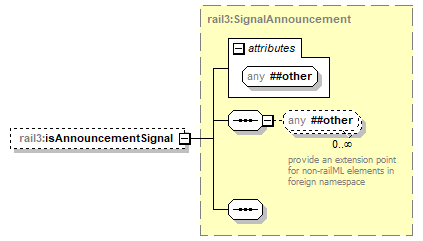 | ||||||
| namespace | https://www.railml.org/schemas/3.1 | ||||||
| type | rail3:SignalAnnouncement | ||||||
| properties |
| ||||||
| attributes |
| ||||||
| source | <xs:element name="isAnnouncementSignal" type="rail3:SignalAnnouncement" minOccurs="0" maxOccurs="1"/> |
element SignalIS/isCatenarySignal
| diagram | 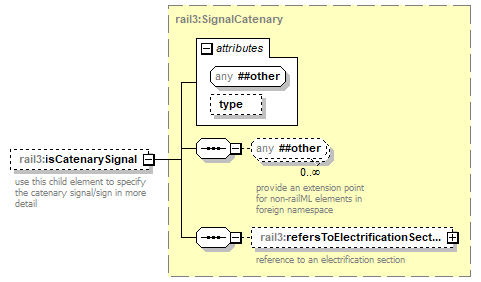 | ||||||||||||
| namespace | https://www.railml.org/schemas/3.1 | ||||||||||||
| type | rail3:SignalCatenary | ||||||||||||
| properties |
| ||||||||||||
| children | rail3:refersToElectrificationSection | ||||||||||||
| attributes |
| ||||||||||||
| annotation |
| ||||||||||||
| source | <xs:element name="isCatenarySignal" type="rail3:SignalCatenary" minOccurs="0" maxOccurs="1"> <xs:annotation> <xs:documentation>use this child element to specify the catenary signal/sign in more detail</xs:documentation> </xs:annotation> </xs:element> |
element SignalIS/isDangerSignal
| diagram | 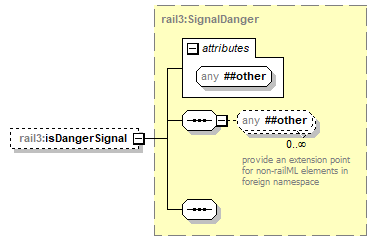 | ||||||
| namespace | https://www.railml.org/schemas/3.1 | ||||||
| type | rail3:SignalDanger | ||||||
| properties |
| ||||||
| attributes |
| ||||||
| source | <xs:element name="isDangerSignal" type="rail3:SignalDanger" minOccurs="0" maxOccurs="1"/> |
element SignalIS/isEtcsSignal
| diagram | 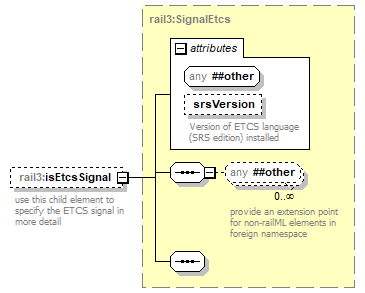 | ||||||||||||||
| namespace | https://www.railml.org/schemas/3.1 | ||||||||||||||
| type | rail3:SignalEtcs | ||||||||||||||
| properties |
| ||||||||||||||
| attributes |
| ||||||||||||||
| annotation |
| ||||||||||||||
| source | <xs:element name="isEtcsSignal" type="rail3:SignalEtcs" minOccurs="0" maxOccurs="1"> <xs:annotation> <xs:documentation>use this child element to specify the ETCS signal in more detail</xs:documentation> </xs:annotation> </xs:element> |
element SignalIS/isInformationSignal
| diagram | 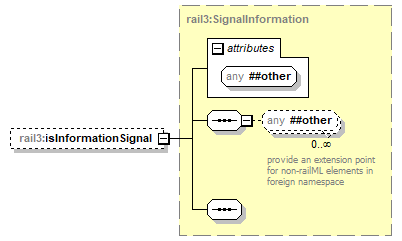 | ||||||
| namespace | https://www.railml.org/schemas/3.1 | ||||||
| type | rail3:SignalInformation | ||||||
| properties |
| ||||||
| attributes |
| ||||||
| source | <xs:element name="isInformationSignal" type="rail3:SignalInformation" minOccurs="0" maxOccurs="1"/> |
element SignalIS/isLevelCrossingSignal
| diagram | 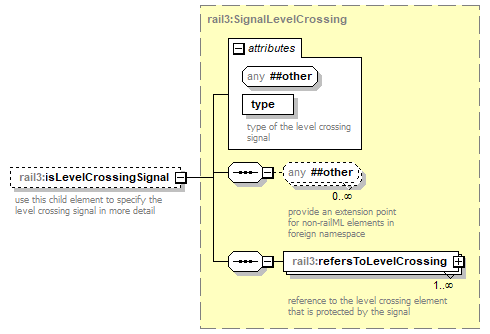 | ||||||||||||||
| namespace | https://www.railml.org/schemas/3.1 | ||||||||||||||
| type | rail3:SignalLevelCrossing | ||||||||||||||
| properties |
| ||||||||||||||
| children | rail3:refersToLevelCrossing | ||||||||||||||
| attributes |
| ||||||||||||||
| annotation |
| ||||||||||||||
| source | <xs:element name="isLevelCrossingSignal" type="rail3:SignalLevelCrossing" minOccurs="0" maxOccurs="1"> <xs:annotation> <xs:documentation>use this child element to specify the level crossing signal in more detail</xs:documentation> </xs:annotation> </xs:element> |
element SignalIS/isMilepost
| diagram | 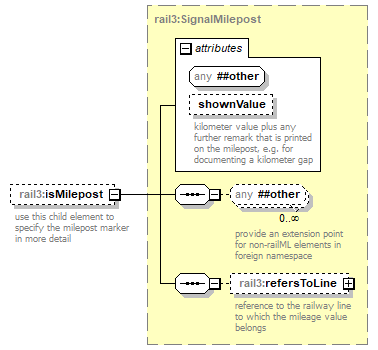 | ||||||||||||||
| namespace | https://www.railml.org/schemas/3.1 | ||||||||||||||
| type | rail3:SignalMilepost | ||||||||||||||
| properties |
| ||||||||||||||
| children | rail3:refersToLine | ||||||||||||||
| attributes |
| ||||||||||||||
| annotation |
| ||||||||||||||
| source | <xs:element name="isMilepost" type="rail3:SignalMilepost" minOccurs="0" maxOccurs="1"> <xs:annotation> <xs:documentation>use this child element to specify the milepost marker in more detail</xs:documentation> </xs:annotation> </xs:element> |
element SignalIS/isSpeedSignal
| diagram | 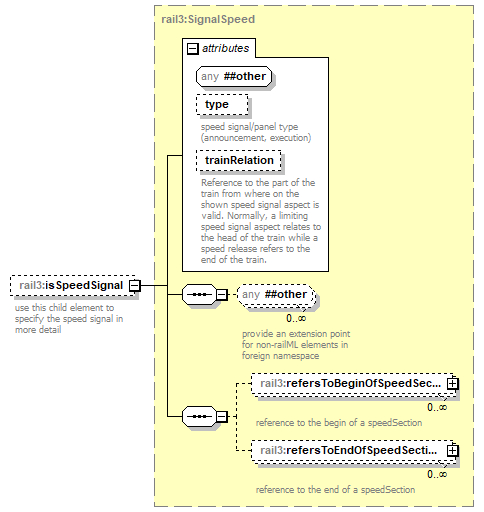 | ||||||||||||||||||||||
| namespace | https://www.railml.org/schemas/3.1 | ||||||||||||||||||||||
| type | rail3:SignalSpeed | ||||||||||||||||||||||
| properties |
| ||||||||||||||||||||||
| children | rail3:refersToBeginOfSpeedSection rail3:refersToEndOfSpeedSection | ||||||||||||||||||||||
| attributes |
| ||||||||||||||||||||||
| annotation |
| ||||||||||||||||||||||
| source | <xs:element name="isSpeedSignal" type="rail3:SignalSpeed" minOccurs="0" maxOccurs="1"> <xs:annotation> <xs:documentation>use this child element to specify the speed signal in more detail</xs:documentation> </xs:annotation> </xs:element> |
element SignalIS/isStopPost
| diagram | 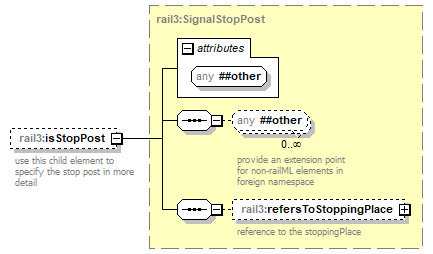 | ||||||
| namespace | https://www.railml.org/schemas/3.1 | ||||||
| type | rail3:SignalStopPost | ||||||
| properties |
| ||||||
| children | rail3:refersToStoppingPlace | ||||||
| attributes |
| ||||||
| annotation |
| ||||||
| source | <xs:element name="isStopPost" type="rail3:SignalStopPost" minOccurs="0" maxOccurs="1"> <xs:annotation> <xs:documentation>use this child element to specify the stop post in more detail</xs:documentation> </xs:annotation> </xs:element> |
element SignalIS/isTrainMovementSignal
| diagram | 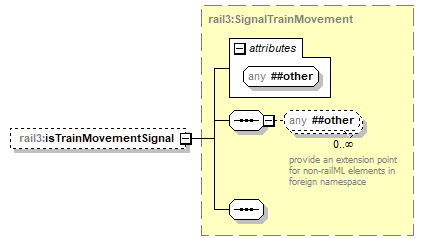 | ||||||
| namespace | https://www.railml.org/schemas/3.1 | ||||||
| type | rail3:SignalTrainMovement | ||||||
| properties |
| ||||||
| attributes |
| ||||||
| source | <xs:element name="isTrainMovementSignal" type="rail3:SignalTrainMovement" minOccurs="0" maxOccurs="1"/> |
element SignalIS/isTrainRadioSignal
| diagram | 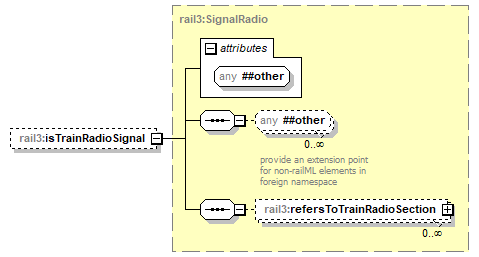 | ||||||
| namespace | https://www.railml.org/schemas/3.1 | ||||||
| type | rail3:SignalRadio | ||||||
| properties |
| ||||||
| children | rail3:refersToTrainRadioSection | ||||||
| attributes |
| ||||||
| source | <xs:element name="isTrainRadioSignal" type="rail3:SignalRadio" minOccurs="0" maxOccurs="1"/> |
element SignalIS/isVehicleEquipmentSignal
| diagram | 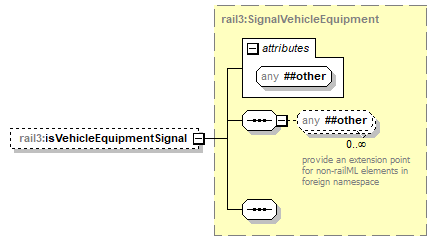 | ||||||
| namespace | https://www.railml.org/schemas/3.1 | ||||||
| type | rail3:SignalVehicleEquipment | ||||||
| properties |
| ||||||
| attributes |
| ||||||
| source | <xs:element name="isVehicleEquipmentSignal" type="rail3:SignalVehicleEquipment" minOccurs="0" maxOccurs="1"/> |
element SignalIS/connectedWithBaliseGroup
| diagram | 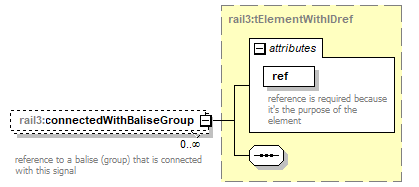 | ||||||||||||||
| namespace | https://www.railml.org/schemas/3.1 | ||||||||||||||
| type | rail3:tElementWithIDref | ||||||||||||||
| properties |
| ||||||||||||||
| attributes |
| ||||||||||||||
| annotation |
| ||||||||||||||
| source | <xs:element name="connectedWithBaliseGroup" type="rail3:tElementWithIDref" minOccurs="0" maxOccurs="unbounded"> <xs:annotation> <xs:documentation>reference to a balise (group) that is connected with this signal</xs:documentation> </xs:annotation> </xs:element> |
element SignalIS/signalConstruction
| diagram | 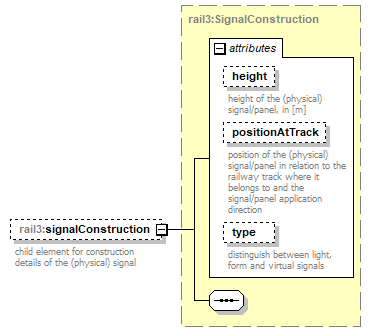 | ||||||||||||||||||||||||||||||
| namespace | https://www.railml.org/schemas/3.1 | ||||||||||||||||||||||||||||||
| type | rail3:SignalConstruction | ||||||||||||||||||||||||||||||
| properties |
| ||||||||||||||||||||||||||||||
| attributes |
| ||||||||||||||||||||||||||||||
| annotation |
| ||||||||||||||||||||||||||||||
| source | <xs:element name="signalConstruction" type="rail3:SignalConstruction" minOccurs="0" maxOccurs="1"> <xs:annotation> <xs:documentation>child element for construction details of the (physical) signal</xs:documentation> </xs:annotation> </xs:element> |
complexType SignalLevelCrossing
| diagram | 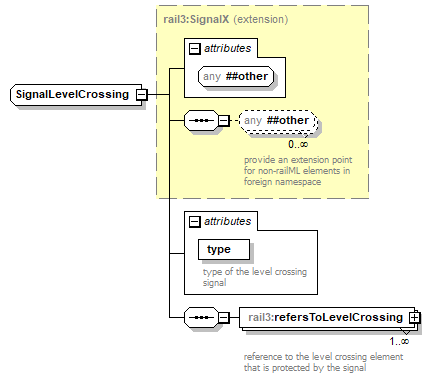 | ||||||||||||||
| namespace | https://www.railml.org/schemas/3.1 | ||||||||||||||
| type | extension of rail3:SignalX | ||||||||||||||
| properties |
| ||||||||||||||
| children | rail3:refersToLevelCrossing | ||||||||||||||
| used by |
| ||||||||||||||
| attributes |
| ||||||||||||||
| source | <xs:complexType name="SignalLevelCrossing"> <xs:complexContent> <xs:extension base="rail3:SignalX"> <xs:sequence> <xs:element name="refersToLevelCrossing" type="rail3:tElementWithIDref" minOccurs="1" maxOccurs="unbounded"> <xs:annotation> <xs:documentation>reference to the level crossing element that is protected by the signal</xs:documentation> </xs:annotation> </xs:element> </xs:sequence> <xs:attribute name="type" type="rail3:tSignalLevelCrossingType" use="required"> <xs:annotation> <xs:documentation>type of the level crossing signal</xs:documentation> </xs:annotation> </xs:attribute> </xs:extension> </xs:complexContent> </xs:complexType> |
attribute SignalLevelCrossing/@type
| type | rail3:tSignalLevelCrossingType | ||||||||||||||||||||||||||||
| properties |
| ||||||||||||||||||||||||||||
| facets |
| ||||||||||||||||||||||||||||
| annotation |
| ||||||||||||||||||||||||||||
| source | <xs:attribute name="type" type="rail3:tSignalLevelCrossingType" use="required"> <xs:annotation> <xs:documentation>type of the level crossing signal</xs:documentation> </xs:annotation> </xs:attribute> |
element SignalLevelCrossing/refersToLevelCrossing
| diagram | 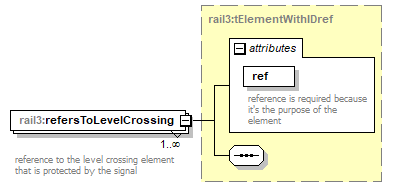 | ||||||||||||||
| namespace | https://www.railml.org/schemas/3.1 | ||||||||||||||
| type | rail3:tElementWithIDref | ||||||||||||||
| properties |
| ||||||||||||||
| attributes |
| ||||||||||||||
| annotation |
| ||||||||||||||
| source | <xs:element name="refersToLevelCrossing" type="rail3:tElementWithIDref" minOccurs="1" maxOccurs="unbounded"> <xs:annotation> <xs:documentation>reference to the level crossing element that is protected by the signal</xs:documentation> </xs:annotation> </xs:element> |
complexType SignalMilepost
| diagram | 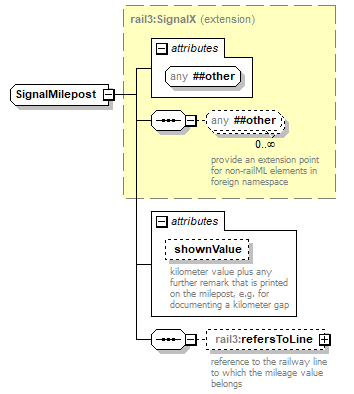 | ||||||||||||||
| namespace | https://www.railml.org/schemas/3.1 | ||||||||||||||
| type | extension of rail3:SignalX | ||||||||||||||
| properties |
| ||||||||||||||
| children | rail3:refersToLine | ||||||||||||||
| used by |
| ||||||||||||||
| attributes |
| ||||||||||||||
| source | <xs:complexType name="SignalMilepost"> <xs:complexContent> <xs:extension base="rail3:SignalX"> <xs:sequence> <xs:element name="refersToLine" type="rail3:tElementWithIDref" minOccurs="0" maxOccurs="1"> <xs:annotation> <xs:documentation>reference to the railway line to which the mileage value belongs</xs:documentation> </xs:annotation> </xs:element> </xs:sequence> <xs:attribute name="shownValue" type="xs:string" use="optional"> <xs:annotation> <xs:documentation>kilometer value plus any further remark that is printed on the milepost, e.g. for documenting a kilometer gap</xs:documentation> </xs:annotation> </xs:attribute> </xs:extension> </xs:complexContent> </xs:complexType> |
attribute SignalMilepost/@shownValue
| type | xs:string | ||
| properties |
| ||
| annotation |
| ||
| source | <xs:attribute name="shownValue" type="xs:string" use="optional"> <xs:annotation> <xs:documentation>kilometer value plus any further remark that is printed on the milepost, e.g. for documenting a kilometer gap</xs:documentation> </xs:annotation> </xs:attribute> |
element SignalMilepost/refersToLine
| diagram | 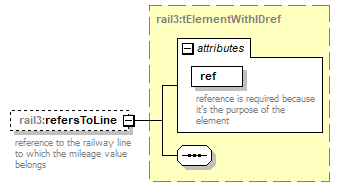 | ||||||||||||||
| namespace | https://www.railml.org/schemas/3.1 | ||||||||||||||
| type | rail3:tElementWithIDref | ||||||||||||||
| properties |
| ||||||||||||||
| attributes |
| ||||||||||||||
| annotation |
| ||||||||||||||
| source | <xs:element name="refersToLine" type="rail3:tElementWithIDref" minOccurs="0" maxOccurs="1"> <xs:annotation> <xs:documentation>reference to the railway line to which the mileage value belongs</xs:documentation> </xs:annotation> </xs:element> |
complexType SignalRadio
| diagram | 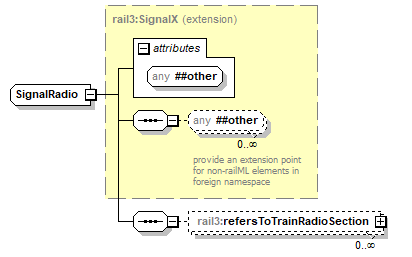 | ||||||
| namespace | https://www.railml.org/schemas/3.1 | ||||||
| type | extension of rail3:SignalX | ||||||
| properties |
| ||||||
| children | rail3:refersToTrainRadioSection | ||||||
| used by |
| ||||||
| attributes |
| ||||||
| source | <xs:complexType name="SignalRadio"> <xs:complexContent> <xs:extension base="rail3:SignalX"> <xs:sequence> <xs:element name="refersToTrainRadioSection" type="rail3:tElementWithIDref" minOccurs="0" maxOccurs="unbounded"/> </xs:sequence> </xs:extension> </xs:complexContent> </xs:complexType> |
element SignalRadio/refersToTrainRadioSection
| diagram | 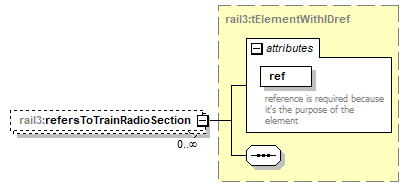 | ||||||||||||||
| namespace | https://www.railml.org/schemas/3.1 | ||||||||||||||
| type | rail3:tElementWithIDref | ||||||||||||||
| properties |
| ||||||||||||||
| attributes |
| ||||||||||||||
| source | <xs:element name="refersToTrainRadioSection" type="rail3:tElementWithIDref" minOccurs="0" maxOccurs="unbounded"/> |
complexType SignalsIS
| diagram |  | ||
| namespace | https://www.railml.org/schemas/3.1 | ||
| children | rail3:signalIS | ||
| used by |
| ||
| source | <xs:complexType name="SignalsIS"> <xs:sequence> <xs:element name="signalIS" type="rail3:SignalIS" minOccurs="1" maxOccurs="unbounded"/> </xs:sequence> </xs:complexType> |
element SignalsIS/signalIS
| diagram |  | ||||||||||||||||||||||||||||||||||||||
| namespace | https://www.railml.org/schemas/3.1 | ||||||||||||||||||||||||||||||||||||||
| type | rail3:SignalIS | ||||||||||||||||||||||||||||||||||||||
| properties |
| ||||||||||||||||||||||||||||||||||||||
| children | rail3:name rail3:isValid rail3:areaLocation rail3:linearLocation rail3:spotLocation rail3:gmlLocations rail3:networkLocation rail3:designator rail3:external rail3:isAnnouncementSignal rail3:isCatenarySignal rail3:isDangerSignal rail3:isEtcsSignal rail3:isInformationSignal rail3:isLevelCrossingSignal rail3:isMilepost rail3:isSpeedSignal rail3:isStopPost rail3:isTrainMovementSignal rail3:isTrainRadioSignal rail3:isVehicleEquipmentSignal rail3:connectedWithBaliseGroup rail3:signalConstruction | ||||||||||||||||||||||||||||||||||||||
| attributes |
| ||||||||||||||||||||||||||||||||||||||
| source | <xs:element name="signalIS" type="rail3:SignalIS" minOccurs="1" maxOccurs="unbounded"/> |
complexType SignalSpeed
| diagram | 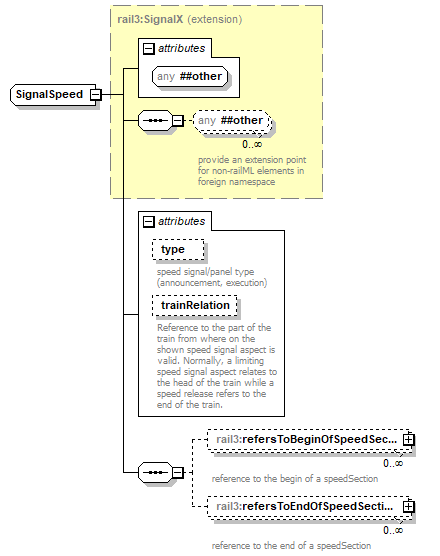 | ||||||||||||||||||||||
| namespace | https://www.railml.org/schemas/3.1 | ||||||||||||||||||||||
| type | extension of rail3:SignalX | ||||||||||||||||||||||
| properties |
| ||||||||||||||||||||||
| children | rail3:refersToBeginOfSpeedSection rail3:refersToEndOfSpeedSection | ||||||||||||||||||||||
| used by |
| ||||||||||||||||||||||
| attributes |
| ||||||||||||||||||||||
| source | <xs:complexType name="SignalSpeed"> <xs:complexContent> <xs:extension base="rail3:SignalX"> <xs:sequence> <xs:element name="refersToBeginOfSpeedSection" type="rail3:tElementWithIDref" minOccurs="0" maxOccurs="unbounded"> <xs:annotation> <xs:documentation>reference to the begin of a speedSection</xs:documentation> </xs:annotation> </xs:element> <xs:element name="refersToEndOfSpeedSection" type="rail3:tElementWithIDref" minOccurs="0" maxOccurs="unbounded"> <xs:annotation> <xs:documentation>reference to the end of a speedSection</xs:documentation> </xs:annotation> </xs:element> </xs:sequence> <xs:attribute name="type" type="rail3:tSignalSpeedType" use="optional"> <xs:annotation> <xs:documentation>speed signal/panel type (announcement, execution)</xs:documentation> </xs:annotation> </xs:attribute> <xs:attribute name="trainRelation" type="rail3:tTrainRelation" use="optional"> <xs:annotation> <xs:documentation>Reference to the part of the train from where on the shown speed signal aspect is valid. Normally, a limiting speed signal aspect relates to the head of the train while a speed release refers to the end of the train.</xs:documentation> </xs:annotation> </xs:attribute> </xs:extension> </xs:complexContent> </xs:complexType> |
attribute SignalSpeed/@type
| type | rail3:tSignalSpeedType | |||||||||||||
| properties |
| |||||||||||||
| facets |
| |||||||||||||
| annotation |
| |||||||||||||
| source | <xs:attribute name="type" type="rail3:tSignalSpeedType" use="optional"> <xs:annotation> <xs:documentation>speed signal/panel type (announcement, execution)</xs:documentation> </xs:annotation> </xs:attribute> |
attribute SignalSpeed/@trainRelation
| type | rail3:tTrainRelation | ||||||||||||
| properties |
| ||||||||||||
| facets |
| ||||||||||||
| annotation |
| ||||||||||||
| source | <xs:attribute name="trainRelation" type="rail3:tTrainRelation" use="optional"> <xs:annotation> <xs:documentation>Reference to the part of the train from where on the shown speed signal aspect is valid. Normally, a limiting speed signal aspect relates to the head of the train while a speed release refers to the end of the train.</xs:documentation> </xs:annotation> </xs:attribute> |
element SignalSpeed/refersToBeginOfSpeedSection
| diagram | 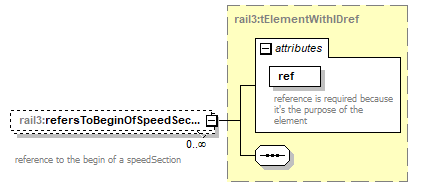 | ||||||||||||||
| namespace | https://www.railml.org/schemas/3.1 | ||||||||||||||
| type | rail3:tElementWithIDref | ||||||||||||||
| properties |
| ||||||||||||||
| attributes |
| ||||||||||||||
| annotation |
| ||||||||||||||
| source | <xs:element name="refersToBeginOfSpeedSection" type="rail3:tElementWithIDref" minOccurs="0" maxOccurs="unbounded"> <xs:annotation> <xs:documentation>reference to the begin of a speedSection</xs:documentation> </xs:annotation> </xs:element> |
element SignalSpeed/refersToEndOfSpeedSection
| diagram | 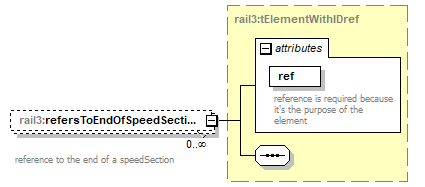 | ||||||||||||||
| namespace | https://www.railml.org/schemas/3.1 | ||||||||||||||
| type | rail3:tElementWithIDref | ||||||||||||||
| properties |
| ||||||||||||||
| attributes |
| ||||||||||||||
| annotation |
| ||||||||||||||
| source | <xs:element name="refersToEndOfSpeedSection" type="rail3:tElementWithIDref" minOccurs="0" maxOccurs="unbounded"> <xs:annotation> <xs:documentation>reference to the end of a speedSection</xs:documentation> </xs:annotation> </xs:element> |
complexType SignalStopPost
| diagram | 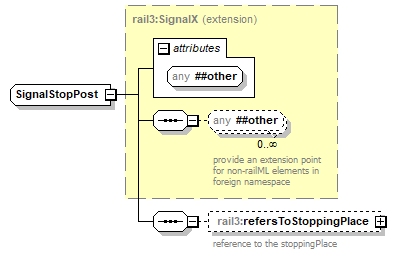 | ||||||
| namespace | https://www.railml.org/schemas/3.1 | ||||||
| type | extension of rail3:SignalX | ||||||
| properties |
| ||||||
| children | rail3:refersToStoppingPlace | ||||||
| used by |
| ||||||
| attributes |
| ||||||
| source | <xs:complexType name="SignalStopPost"> <xs:complexContent> <xs:extension base="rail3:SignalX"> <xs:sequence> <xs:element name="refersToStoppingPlace" type="rail3:tElementWithIDref" minOccurs="0" maxOccurs="1"> <xs:annotation> <xs:documentation>reference to the stoppingPlace</xs:documentation> </xs:annotation> </xs:element> </xs:sequence> </xs:extension> </xs:complexContent> </xs:complexType> |
element SignalStopPost/refersToStoppingPlace
| diagram | 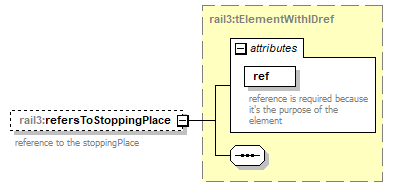 | ||||||||||||||
| namespace | https://www.railml.org/schemas/3.1 | ||||||||||||||
| type | rail3:tElementWithIDref | ||||||||||||||
| properties |
| ||||||||||||||
| attributes |
| ||||||||||||||
| annotation |
| ||||||||||||||
| source | <xs:element name="refersToStoppingPlace" type="rail3:tElementWithIDref" minOccurs="0" maxOccurs="1"> <xs:annotation> <xs:documentation>reference to the stoppingPlace</xs:documentation> </xs:annotation> </xs:element> |
complexType SignalTrainMovement
| diagram | 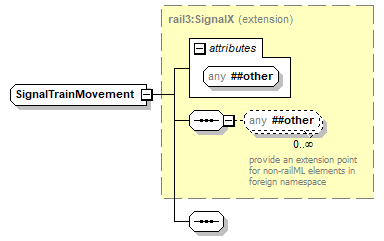 | ||||||
| namespace | https://www.railml.org/schemas/3.1 | ||||||
| type | extension of rail3:SignalX | ||||||
| properties |
| ||||||
| used by |
| ||||||
| attributes |
| ||||||
| source | <xs:complexType name="SignalTrainMovement"> <xs:complexContent> <xs:extension base="rail3:SignalX"> <xs:sequence/> </xs:extension> </xs:complexContent> </xs:complexType> |
complexType SignalVehicleEquipment
| diagram | 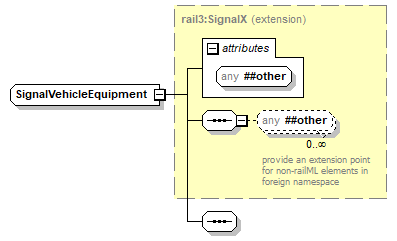 | ||||||
| namespace | https://www.railml.org/schemas/3.1 | ||||||
| type | extension of rail3:SignalX | ||||||
| properties |
| ||||||
| used by |
| ||||||
| attributes |
| ||||||
| source | <xs:complexType name="SignalVehicleEquipment"> <xs:complexContent> <xs:extension base="rail3:SignalX"> <xs:sequence/> </xs:extension> </xs:complexContent> </xs:complexType> |
complexType SignalX
| diagram | 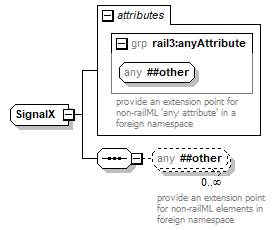 | ||||||
| namespace | https://www.railml.org/schemas/3.1 | ||||||
| properties |
| ||||||
| used by |
| ||||||
| attributes |
| ||||||
| source | <xs:complexType name="SignalX" abstract="true"> <xs:sequence> <xs:any namespace="##other" processContents="strict" minOccurs="0" maxOccurs="unbounded"> <xs:annotation> <xs:documentation>provide an extension point for non-railML elements in foreign namespace</xs:documentation> </xs:annotation> </xs:any> </xs:sequence> <xs:attributeGroup ref="rail3:anyAttribute"/> </xs:complexType> |
complexType Speeds
| diagram |  | ||
| namespace | https://www.railml.org/schemas/3.1 | ||
| children | rail3:speedSection | ||
| used by |
| ||
| source | <xs:complexType name="Speeds"> <xs:sequence> <xs:element name="speedSection" type="rail3:SpeedSection" minOccurs="1" maxOccurs="unbounded"/> </xs:sequence> </xs:complexType> |
element Speeds/speedSection
| diagram | 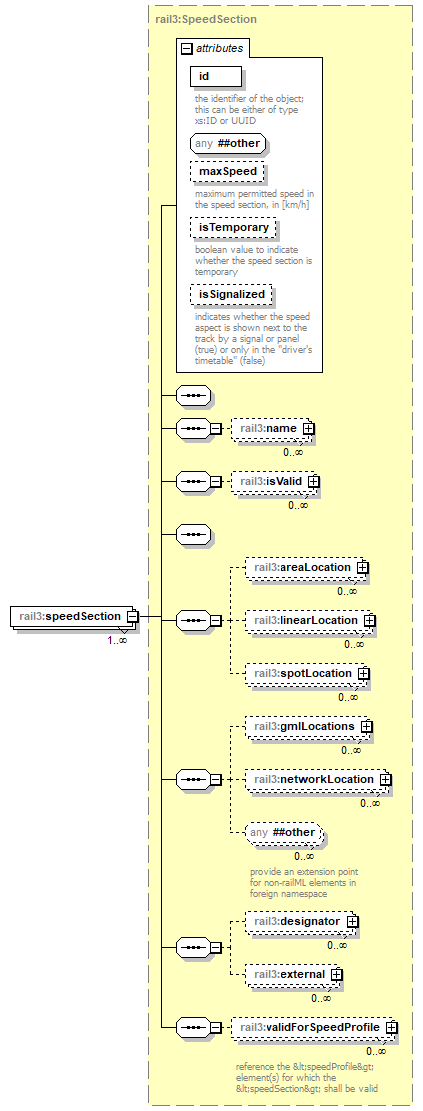 | ||||||||||||||||||||||||||||||||||||||
| namespace | https://www.railml.org/schemas/3.1 | ||||||||||||||||||||||||||||||||||||||
| type | rail3:SpeedSection | ||||||||||||||||||||||||||||||||||||||
| properties |
| ||||||||||||||||||||||||||||||||||||||
| children | rail3:name rail3:isValid rail3:areaLocation rail3:linearLocation rail3:spotLocation rail3:gmlLocations rail3:networkLocation rail3:designator rail3:external rail3:validForSpeedProfile | ||||||||||||||||||||||||||||||||||||||
| attributes |
| ||||||||||||||||||||||||||||||||||||||
| source | <xs:element name="speedSection" type="rail3:SpeedSection" minOccurs="1" maxOccurs="unbounded"/> |
complexType SpeedSection
| diagram | 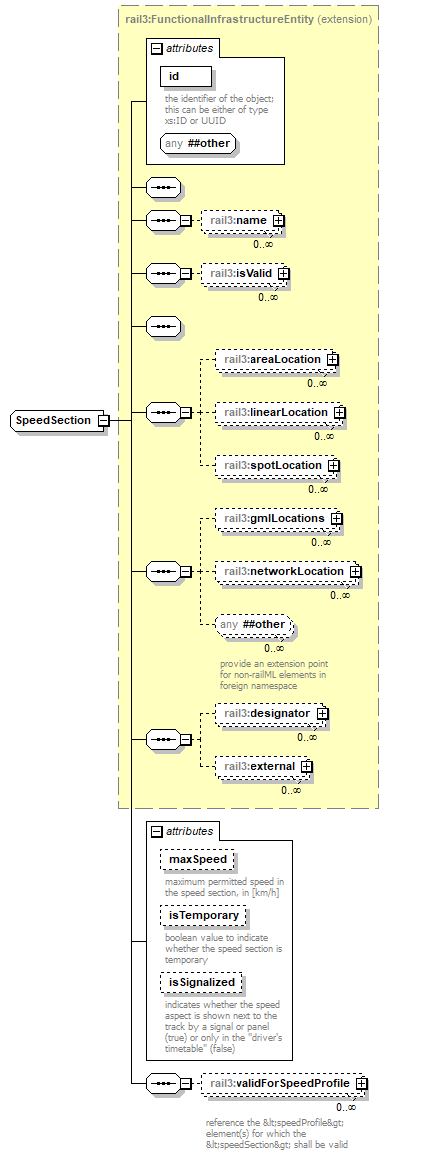 | ||||||||||||||||||||||||||||||||||||||
| namespace | https://www.railml.org/schemas/3.1 | ||||||||||||||||||||||||||||||||||||||
| type | extension of rail3:FunctionalInfrastructureEntity | ||||||||||||||||||||||||||||||||||||||
| properties |
| ||||||||||||||||||||||||||||||||||||||
| children | rail3:name rail3:isValid rail3:areaLocation rail3:linearLocation rail3:spotLocation rail3:gmlLocations rail3:networkLocation rail3:designator rail3:external rail3:validForSpeedProfile | ||||||||||||||||||||||||||||||||||||||
| used by |
| ||||||||||||||||||||||||||||||||||||||
| attributes |
| ||||||||||||||||||||||||||||||||||||||
| source | <xs:complexType name="SpeedSection"> <xs:complexContent> <xs:extension base="rail3:FunctionalInfrastructureEntity"> <xs:sequence> <xs:element name="validForSpeedProfile" type="rail3:tElementWithIDref" minOccurs="0" maxOccurs="unbounded"> <xs:annotation> <xs:documentation>reference the <speedProfile> element(s) for which the <speedSection> shall be valid</xs:documentation> </xs:annotation> </xs:element> </xs:sequence> <xs:attribute name="maxSpeed" type="rail3:tVMax" use="optional"> <xs:annotation> <xs:documentation>maximum permitted speed in the speed section, in [km/h]</xs:documentation> </xs:annotation> </xs:attribute> <xs:attribute name="isTemporary" type="xs:boolean" use="optional"> <xs:annotation> <xs:documentation>boolean value to indicate whether the speed section is temporary</xs:documentation> </xs:annotation> </xs:attribute> <xs:attribute name="isSignalized" type="xs:boolean" use="optional"> <xs:annotation> <xs:documentation>indicates whether the speed aspect is shown next to the track by a signal or panel (true) or only in the "driver's timetable" (false)</xs:documentation> </xs:annotation> </xs:attribute> </xs:extension> </xs:complexContent> </xs:complexType> |
attribute SpeedSection/@maxSpeed
| type | rail3:tVMax | ||
| properties |
| ||
| annotation |
| ||
| source | <xs:attribute name="maxSpeed" type="rail3:tVMax" use="optional"> <xs:annotation> <xs:documentation>maximum permitted speed in the speed section, in [km/h]</xs:documentation> </xs:annotation> </xs:attribute> |
attribute SpeedSection/@isTemporary
| type | xs:boolean | ||
| properties |
| ||
| annotation |
| ||
| source | <xs:attribute name="isTemporary" type="xs:boolean" use="optional"> <xs:annotation> <xs:documentation>boolean value to indicate whether the speed section is temporary</xs:documentation> </xs:annotation> </xs:attribute> |
attribute SpeedSection/@isSignalized
| type | xs:boolean | ||
| properties |
| ||
| annotation |
| ||
| source | <xs:attribute name="isSignalized" type="xs:boolean" use="optional"> <xs:annotation> <xs:documentation>indicates whether the speed aspect is shown next to the track by a signal or panel (true) or only in the "driver's timetable" (false)</xs:documentation> </xs:annotation> </xs:attribute> |
element SpeedSection/validForSpeedProfile
| diagram | 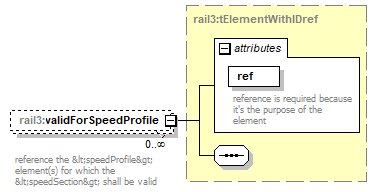 | ||||||||||||||
| namespace | https://www.railml.org/schemas/3.1 | ||||||||||||||
| type | rail3:tElementWithIDref | ||||||||||||||
| properties |
| ||||||||||||||
| attributes |
| ||||||||||||||
| annotation |
| ||||||||||||||
| source | <xs:element name="validForSpeedProfile" type="rail3:tElementWithIDref" minOccurs="0" maxOccurs="unbounded"> <xs:annotation> <xs:documentation>reference the <speedProfile> element(s) for which the <speedSection> shall be valid</xs:documentation> </xs:annotation> </xs:element> |
complexType SpotProjection
| diagram | 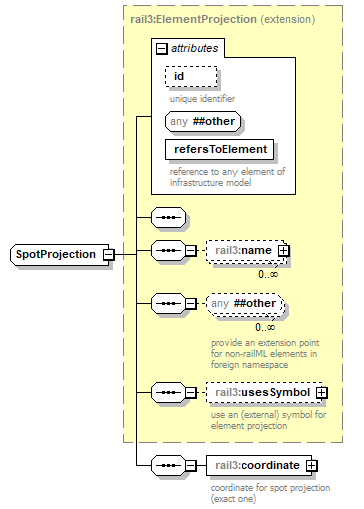 | ||||||||||||||||||||||
| namespace | https://www.railml.org/schemas/3.1 | ||||||||||||||||||||||
| type | extension of rail3:ElementProjection | ||||||||||||||||||||||
| properties |
| ||||||||||||||||||||||
| children | rail3:name rail3:usesSymbol rail3:coordinate | ||||||||||||||||||||||
| used by |
| ||||||||||||||||||||||
| attributes |
| ||||||||||||||||||||||
| source | <xs:complexType name="SpotProjection"> <xs:complexContent> <xs:extension base="rail3:ElementProjection"> <xs:sequence> <xs:element name="coordinate" type="rail3:ProjectionCoordinate" minOccurs="1" maxOccurs="1"> <xs:annotation> <xs:documentation>coordinate for spot projection (exact one)</xs:documentation> </xs:annotation> </xs:element> </xs:sequence> </xs:extension> </xs:complexContent> </xs:complexType> |
element SpotProjection/coordinate
| diagram | 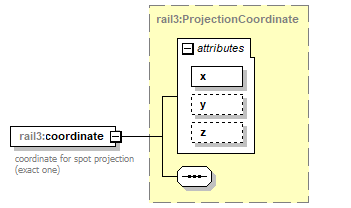 | ||||||||||||||||||||||||
| namespace | https://www.railml.org/schemas/3.1 | ||||||||||||||||||||||||
| type | rail3:ProjectionCoordinate | ||||||||||||||||||||||||
| properties |
| ||||||||||||||||||||||||
| attributes |
| ||||||||||||||||||||||||
| annotation |
| ||||||||||||||||||||||||
| source | <xs:element name="coordinate" type="rail3:ProjectionCoordinate" minOccurs="1" maxOccurs="1"> <xs:annotation> <xs:documentation>coordinate for spot projection (exact one)</xs:documentation> </xs:annotation> </xs:element> |
complexType StatesBaseElement
| diagram | 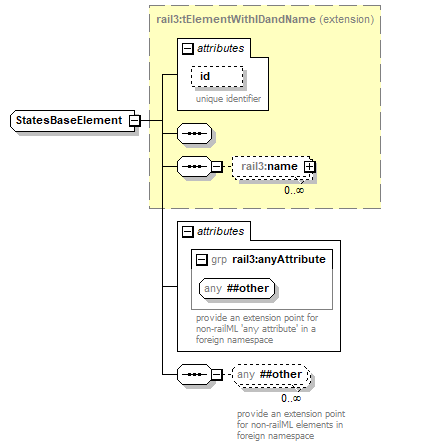 | ||||||||||||||
| namespace | https://www.railml.org/schemas/3.1 | ||||||||||||||
| type | extension of rail3:tElementWithIDandName | ||||||||||||||
| properties |
| ||||||||||||||
| children | rail3:name | ||||||||||||||
| used by |
| ||||||||||||||
| attributes |
| ||||||||||||||
| source | <xs:complexType name="StatesBaseElement"> <xs:complexContent> <xs:extension base="rail3:tElementWithIDandName"> <xs:sequence> <xs:any namespace="##other" processContents="strict" minOccurs="0" maxOccurs="unbounded"> <xs:annotation> <xs:documentation>provide an extension point for non-railML elements in foreign namespace</xs:documentation> </xs:annotation> </xs:any> </xs:sequence> <xs:attributeGroup ref="rail3:anyAttribute"/> </xs:extension> </xs:complexContent> </xs:complexType> |
complexType StoppingPlace
| diagram |  | ||||||||||||||||||||||||||||||||||||||||||||||||||||||||||||||||||||||
| namespace | https://www.railml.org/schemas/3.1 | ||||||||||||||||||||||||||||||||||||||||||||||||||||||||||||||||||||||
| type | extension of rail3:FunctionalInfrastructureEntity | ||||||||||||||||||||||||||||||||||||||||||||||||||||||||||||||||||||||
| properties |
| ||||||||||||||||||||||||||||||||||||||||||||||||||||||||||||||||||||||
| children | rail3:name rail3:isValid rail3:areaLocation rail3:linearLocation rail3:spotLocation rail3:gmlLocations rail3:networkLocation rail3:designator rail3:external rail3:validForTrainMovement | ||||||||||||||||||||||||||||||||||||||||||||||||||||||||||||||||||||||
| used by |
| ||||||||||||||||||||||||||||||||||||||||||||||||||||||||||||||||||||||
| attributes |
| ||||||||||||||||||||||||||||||||||||||||||||||||||||||||||||||||||||||
| source | <xs:complexType name="StoppingPlace"> <xs:complexContent> <xs:extension base="rail3:FunctionalInfrastructureEntity"> <xs:sequence> <xs:element name="validForTrainMovement" type="rail3:TrainMovement" minOccurs="0" maxOccurs="unbounded"> <xs:annotation> <xs:documentation>specify the train movement types for which the stopping place is valid (freight trains, passenger trains, ...)</xs:documentation> </xs:annotation> </xs:element> </xs:sequence> <xs:attributeGroup ref="rail3:aStoppingPlace"/> </xs:extension> </xs:complexContent> </xs:complexType> |
element StoppingPlace/validForTrainMovement
| diagram | 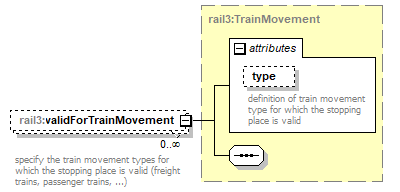 | ||||||||||||||
| namespace | https://www.railml.org/schemas/3.1 | ||||||||||||||
| type | rail3:TrainMovement | ||||||||||||||
| properties |
| ||||||||||||||
| attributes |
| ||||||||||||||
| annotation |
| ||||||||||||||
| source | <xs:element name="validForTrainMovement" type="rail3:TrainMovement" minOccurs="0" maxOccurs="unbounded"> <xs:annotation> <xs:documentation>specify the train movement types for which the stopping place is valid (freight trains, passenger trains, ...)</xs:documentation> </xs:annotation> </xs:element> |
complexType StoppingPlaces
| diagram |  | ||
| namespace | https://www.railml.org/schemas/3.1 | ||
| children | rail3:stoppingPlace | ||
| used by |
| ||
| source | <xs:complexType name="StoppingPlaces"> <xs:sequence> <xs:element name="stoppingPlace" type="rail3:StoppingPlace" minOccurs="1" maxOccurs="unbounded"/> </xs:sequence> </xs:complexType> |
element StoppingPlaces/stoppingPlace
| diagram |  | ||||||||||||||||||||||||||||||||||||||||||||||||||||||||||||||||||||||
| namespace | https://www.railml.org/schemas/3.1 | ||||||||||||||||||||||||||||||||||||||||||||||||||||||||||||||||||||||
| type | rail3:StoppingPlace | ||||||||||||||||||||||||||||||||||||||||||||||||||||||||||||||||||||||
| properties |
| ||||||||||||||||||||||||||||||||||||||||||||||||||||||||||||||||||||||
| children | rail3:name rail3:isValid rail3:areaLocation rail3:linearLocation rail3:spotLocation rail3:gmlLocations rail3:networkLocation rail3:designator rail3:external rail3:validForTrainMovement | ||||||||||||||||||||||||||||||||||||||||||||||||||||||||||||||||||||||
| attributes |
| ||||||||||||||||||||||||||||||||||||||||||||||||||||||||||||||||||||||
| source | <xs:element name="stoppingPlace" type="rail3:StoppingPlace" minOccurs="1" maxOccurs="unbounded"/> |
complexType SwitchCrossingBranch
| diagram | 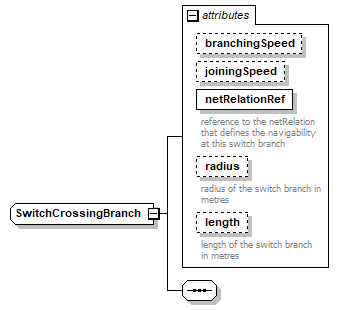 | ||||||||||||||||||||||||||||||||||||||||||
| namespace | https://www.railml.org/schemas/3.1 | ||||||||||||||||||||||||||||||||||||||||||
| used by |
| ||||||||||||||||||||||||||||||||||||||||||
| attributes |
| ||||||||||||||||||||||||||||||||||||||||||
| source | <xs:complexType name="SwitchCrossingBranch"> <xs:sequence/> <xs:attribute name="branchingSpeed" type="rail3:tSpeedKmPerHour" use="optional"/> <xs:attribute name="joiningSpeed" type="rail3:tSpeedKmPerHour" use="optional"/> <xs:attribute name="netRelationRef" type="rail3:tRef" use="required"> <xs:annotation> <xs:documentation>reference to the netRelation that defines the navigability at this switch branch</xs:documentation> </xs:annotation> </xs:attribute> <xs:attribute name="radius" type="rail3:tLengthM" use="optional"> <xs:annotation> <xs:documentation>radius of the switch branch in metres</xs:documentation> </xs:annotation> </xs:attribute> <xs:attribute name="length" type="rail3:tLengthM" use="optional"> <xs:annotation> <xs:documentation>length of the switch branch in metres</xs:documentation> </xs:annotation> </xs:attribute> </xs:complexType> |
attribute SwitchCrossingBranch/@branchingSpeed
| type | rail3:tSpeedKmPerHour | ||
| properties |
| ||
| source | <xs:attribute name="branchingSpeed" type="rail3:tSpeedKmPerHour" use="optional"/> |
attribute SwitchCrossingBranch/@joiningSpeed
| type | rail3:tSpeedKmPerHour | ||
| properties |
| ||
| source | <xs:attribute name="joiningSpeed" type="rail3:tSpeedKmPerHour" use="optional"/> |
attribute SwitchCrossingBranch/@netRelationRef
| type | rail3:tRef | ||
| properties |
| ||
| annotation |
| ||
| source | <xs:attribute name="netRelationRef" type="rail3:tRef" use="required"> <xs:annotation> <xs:documentation>reference to the netRelation that defines the navigability at this switch branch</xs:documentation> </xs:annotation> </xs:attribute> |
attribute SwitchCrossingBranch/@radius
| type | rail3:tLengthM | ||
| properties |
| ||
| annotation |
| ||
| source | <xs:attribute name="radius" type="rail3:tLengthM" use="optional"> <xs:annotation> <xs:documentation>radius of the switch branch in metres</xs:documentation> </xs:annotation> </xs:attribute> |
attribute SwitchCrossingBranch/@length
| type | rail3:tLengthM | ||
| properties |
| ||
| annotation |
| ||
| source | <xs:attribute name="length" type="rail3:tLengthM" use="optional"> <xs:annotation> <xs:documentation>length of the switch branch in metres</xs:documentation> </xs:annotation> </xs:attribute> |
complexType SwitchesIS
| diagram |  | ||
| namespace | https://www.railml.org/schemas/3.1 | ||
| children | rail3:switchIS | ||
| used by |
| ||
| source | <xs:complexType name="SwitchesIS"> <xs:sequence> <xs:element name="switchIS" type="rail3:SwitchIS" minOccurs="1" maxOccurs="unbounded"/> </xs:sequence> </xs:complexType> |
element SwitchesIS/switchIS
| diagram |  | ||||||||||||||||||||||||||||||||||||||||||||||||||||||
| namespace | https://www.railml.org/schemas/3.1 | ||||||||||||||||||||||||||||||||||||||||||||||||||||||
| type | rail3:SwitchIS | ||||||||||||||||||||||||||||||||||||||||||||||||||||||
| properties |
| ||||||||||||||||||||||||||||||||||||||||||||||||||||||
| children | rail3:name rail3:isValid rail3:areaLocation rail3:linearLocation rail3:spotLocation rail3:gmlLocations rail3:networkLocation rail3:designator rail3:external rail3:leftBranch rail3:rightBranch rail3:straightBranch rail3:turningBranch | ||||||||||||||||||||||||||||||||||||||||||||||||||||||
| attributes |
| ||||||||||||||||||||||||||||||||||||||||||||||||||||||
| source | <xs:element name="switchIS" type="rail3:SwitchIS" minOccurs="1" maxOccurs="unbounded"/> |
complexType SwitchIS
| diagram |  | ||||||||||||||||||||||||||||||||||||||||||||||||||||||
| namespace | https://www.railml.org/schemas/3.1 | ||||||||||||||||||||||||||||||||||||||||||||||||||||||
| type | extension of rail3:TrackNode | ||||||||||||||||||||||||||||||||||||||||||||||||||||||
| properties |
| ||||||||||||||||||||||||||||||||||||||||||||||||||||||
| children | rail3:name rail3:isValid rail3:areaLocation rail3:linearLocation rail3:spotLocation rail3:gmlLocations rail3:networkLocation rail3:designator rail3:external rail3:leftBranch rail3:rightBranch rail3:straightBranch rail3:turningBranch | ||||||||||||||||||||||||||||||||||||||||||||||||||||||
| used by |
| ||||||||||||||||||||||||||||||||||||||||||||||||||||||
| attributes |
| ||||||||||||||||||||||||||||||||||||||||||||||||||||||
| source | <xs:complexType name="SwitchIS"> <xs:complexContent> <xs:extension base="rail3:TrackNode"> <xs:sequence> <xs:element name="leftBranch" type="rail3:SwitchCrossingBranch" minOccurs="0" maxOccurs="1"> <xs:annotation> <xs:documentation>left branch of the switch as seen from switch begin (application direction)</xs:documentation> </xs:annotation> </xs:element> <xs:element name="rightBranch" type="rail3:SwitchCrossingBranch" minOccurs="0" maxOccurs="1"> <xs:annotation> <xs:documentation>right branch of the switch as seen from switch begin (application direction)</xs:documentation> </xs:annotation> </xs:element> <xs:element name="straightBranch" type="rail3:SwitchCrossingBranch" minOccurs="0" maxOccurs="2"> <xs:annotation> <xs:documentation>only for switch crossings: straight branch</xs:documentation> </xs:annotation> </xs:element> <xs:element name="turningBranch" type="rail3:SwitchCrossingBranch" minOccurs="0" maxOccurs="2"> <xs:annotation> <xs:documentation>only for switch crossings: turning branch</xs:documentation> </xs:annotation> </xs:element> </xs:sequence> <xs:attribute name="belongsToParent" type="rail3:tRef" use="optional"> <xs:annotation> <xs:documentation>reference to the one an only parent switch of this switch (to be used at switch crossings)</xs:documentation> </xs:annotation> </xs:attribute> <xs:attribute name="type" type="rail3:tSwitchType" use="optional"> <xs:annotation> <xs:documentation>type of the switch</xs:documentation> </xs:annotation> </xs:attribute> <xs:attribute name="continueCourse" type="rail3:tCourse" use="optional"> <xs:annotation> <xs:documentation>defines the switch main track route (as seen from begin of switch, application direction)</xs:documentation> </xs:annotation> </xs:attribute> <xs:attribute name="branchCourse" type="rail3:tCourse" use="optional"> <xs:annotation> <xs:documentation>defines the switch branching track route (as seen from begin of switch, application direction)</xs:documentation> </xs:annotation> </xs:attribute> <xs:attribute name="basedOnTemplate" type="rail3:tRef" use="optional"> <xs:annotation> <xs:documentation>reference to a generic switch</xs:documentation> </xs:annotation> </xs:attribute> </xs:extension> </xs:complexContent> </xs:complexType> |
attribute SwitchIS/@belongsToParent
| type | rail3:tRef | ||
| properties |
| ||
| annotation |
| ||
| source | <xs:attribute name="belongsToParent" type="rail3:tRef" use="optional"> <xs:annotation> <xs:documentation>reference to the one an only parent switch of this switch (to be used at switch crossings)</xs:documentation> </xs:annotation> </xs:attribute> |
attribute SwitchIS/@type
| type | rail3:tSwitchType | ||||||||||||||||||
| properties |
| ||||||||||||||||||
| facets |
| ||||||||||||||||||
| annotation |
| ||||||||||||||||||
| source | <xs:attribute name="type" type="rail3:tSwitchType" use="optional"> <xs:annotation> <xs:documentation>type of the switch</xs:documentation> </xs:annotation> </xs:attribute> |
attribute SwitchIS/@continueCourse
| type | rail3:tCourse | |||||||||
| properties |
| |||||||||
| facets |
| |||||||||
| annotation |
| |||||||||
| source | <xs:attribute name="continueCourse" type="rail3:tCourse" use="optional"> <xs:annotation> <xs:documentation>defines the switch main track route (as seen from begin of switch, application direction)</xs:documentation> </xs:annotation> </xs:attribute> |
attribute SwitchIS/@branchCourse
| type | rail3:tCourse | |||||||||
| properties |
| |||||||||
| facets |
| |||||||||
| annotation |
| |||||||||
| source | <xs:attribute name="branchCourse" type="rail3:tCourse" use="optional"> <xs:annotation> <xs:documentation>defines the switch branching track route (as seen from begin of switch, application direction)</xs:documentation> </xs:annotation> </xs:attribute> |
attribute SwitchIS/@basedOnTemplate
| type | rail3:tRef | ||
| properties |
| ||
| annotation |
| ||
| source | <xs:attribute name="basedOnTemplate" type="rail3:tRef" use="optional"> <xs:annotation> <xs:documentation>reference to a generic switch</xs:documentation> </xs:annotation> </xs:attribute> |
element SwitchIS/leftBranch
| diagram | 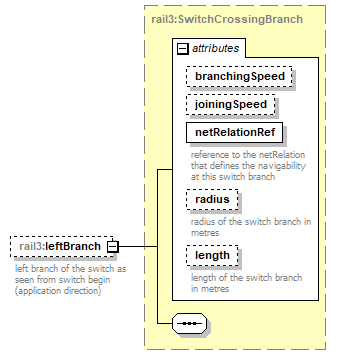 | ||||||||||||||||||||||||||||||||||||||||||
| namespace | https://www.railml.org/schemas/3.1 | ||||||||||||||||||||||||||||||||||||||||||
| type | rail3:SwitchCrossingBranch | ||||||||||||||||||||||||||||||||||||||||||
| properties |
| ||||||||||||||||||||||||||||||||||||||||||
| attributes |
| ||||||||||||||||||||||||||||||||||||||||||
| annotation |
| ||||||||||||||||||||||||||||||||||||||||||
| source | <xs:element name="leftBranch" type="rail3:SwitchCrossingBranch" minOccurs="0" maxOccurs="1"> <xs:annotation> <xs:documentation>left branch of the switch as seen from switch begin (application direction)</xs:documentation> </xs:annotation> </xs:element> |
element SwitchIS/rightBranch
| diagram | 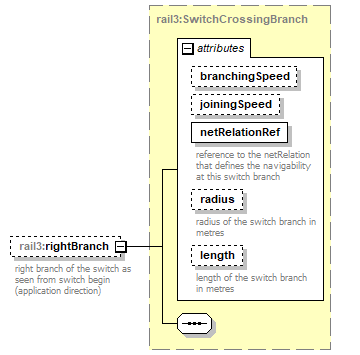 | ||||||||||||||||||||||||||||||||||||||||||
| namespace | https://www.railml.org/schemas/3.1 | ||||||||||||||||||||||||||||||||||||||||||
| type | rail3:SwitchCrossingBranch | ||||||||||||||||||||||||||||||||||||||||||
| properties |
| ||||||||||||||||||||||||||||||||||||||||||
| attributes |
| ||||||||||||||||||||||||||||||||||||||||||
| annotation |
| ||||||||||||||||||||||||||||||||||||||||||
| source | <xs:element name="rightBranch" type="rail3:SwitchCrossingBranch" minOccurs="0" maxOccurs="1"> <xs:annotation> <xs:documentation>right branch of the switch as seen from switch begin (application direction)</xs:documentation> </xs:annotation> </xs:element> |
element SwitchIS/straightBranch
| diagram | 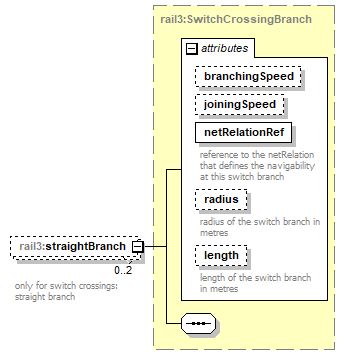 | ||||||||||||||||||||||||||||||||||||||||||
| namespace | https://www.railml.org/schemas/3.1 | ||||||||||||||||||||||||||||||||||||||||||
| type | rail3:SwitchCrossingBranch | ||||||||||||||||||||||||||||||||||||||||||
| properties |
| ||||||||||||||||||||||||||||||||||||||||||
| attributes |
| ||||||||||||||||||||||||||||||||||||||||||
| annotation |
| ||||||||||||||||||||||||||||||||||||||||||
| source | <xs:element name="straightBranch" type="rail3:SwitchCrossingBranch" minOccurs="0" maxOccurs="2"> <xs:annotation> <xs:documentation>only for switch crossings: straight branch</xs:documentation> </xs:annotation> </xs:element> |
element SwitchIS/turningBranch
| diagram | 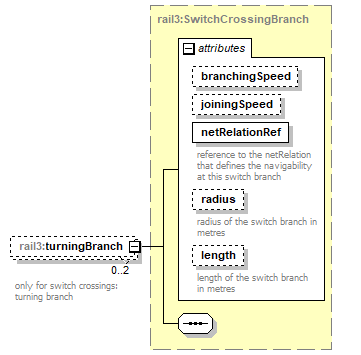 | ||||||||||||||||||||||||||||||||||||||||||
| namespace | https://www.railml.org/schemas/3.1 | ||||||||||||||||||||||||||||||||||||||||||
| type | rail3:SwitchCrossingBranch | ||||||||||||||||||||||||||||||||||||||||||
| properties |
| ||||||||||||||||||||||||||||||||||||||||||
| attributes |
| ||||||||||||||||||||||||||||||||||||||||||
| annotation |
| ||||||||||||||||||||||||||||||||||||||||||
| source | <xs:element name="turningBranch" type="rail3:SwitchCrossingBranch" minOccurs="0" maxOccurs="2"> <xs:annotation> <xs:documentation>only for switch crossings: turning branch</xs:documentation> </xs:annotation> </xs:element> |
complexType SystemSeparationSection
| diagram | 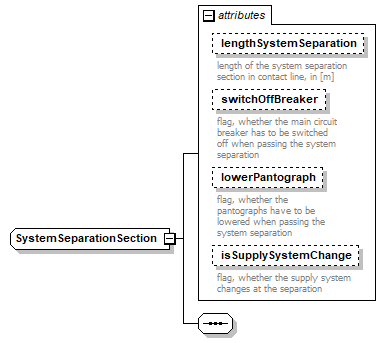 | ||||||||||||||||||||||||||||||||||||||
| namespace | https://www.railml.org/schemas/3.1 | ||||||||||||||||||||||||||||||||||||||
| used by |
| ||||||||||||||||||||||||||||||||||||||
| attributes |
| ||||||||||||||||||||||||||||||||||||||
| source | <xs:complexType name="SystemSeparationSection"> <xs:sequence/> <xs:attribute name="lengthSystemSeparation" type="rail3:tLengthM" use="optional"> <xs:annotation> <xs:documentation>length of the system separation section in contact line, in [m]</xs:documentation> </xs:annotation> </xs:attribute> <xs:attribute name="switchOffBreaker" type="xs:boolean" use="optional"> <xs:annotation> <xs:documentation>flag, whether the main circuit breaker has to be switched off when passing the system separation</xs:documentation> </xs:annotation> </xs:attribute> <xs:attribute name="lowerPantograph" type="xs:boolean" use="optional"> <xs:annotation> <xs:documentation>flag, whether the pantographs have to be lowered when passing the system separation</xs:documentation> </xs:annotation> </xs:attribute> <xs:attribute name="isSupplySystemChange" type="xs:boolean" use="optional"> <xs:annotation> <xs:documentation>flag, whether the supply system changes at the separation</xs:documentation> </xs:annotation> </xs:attribute> </xs:complexType> |
attribute SystemSeparationSection/@lengthSystemSeparation
| type | rail3:tLengthM | ||
| properties |
| ||
| annotation |
| ||
| source | <xs:attribute name="lengthSystemSeparation" type="rail3:tLengthM" use="optional"> <xs:annotation> <xs:documentation>length of the system separation section in contact line, in [m]</xs:documentation> </xs:annotation> </xs:attribute> |
attribute SystemSeparationSection/@switchOffBreaker
| type | xs:boolean | ||
| properties |
| ||
| annotation |
| ||
| source | <xs:attribute name="switchOffBreaker" type="xs:boolean" use="optional"> <xs:annotation> <xs:documentation>flag, whether the main circuit breaker has to be switched off when passing the system separation</xs:documentation> </xs:annotation> </xs:attribute> |
attribute SystemSeparationSection/@lowerPantograph
| type | xs:boolean | ||
| properties |
| ||
| annotation |
| ||
| source | <xs:attribute name="lowerPantograph" type="xs:boolean" use="optional"> <xs:annotation> <xs:documentation>flag, whether the pantographs have to be lowered when passing the system separation</xs:documentation> </xs:annotation> </xs:attribute> |
attribute SystemSeparationSection/@isSupplySystemChange
| type | xs:boolean | ||
| properties |
| ||
| annotation |
| ||
| source | <xs:attribute name="isSupplySystemChange" type="xs:boolean" use="optional"> <xs:annotation> <xs:documentation>flag, whether the supply system changes at the separation</xs:documentation> </xs:annotation> </xs:attribute> |
complexType Topology
| diagram | 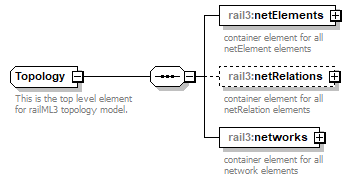 | ||
| namespace | https://www.railml.org/schemas/3.1 | ||
| children | rail3:netElements rail3:netRelations rail3:networks | ||
| used by |
| ||
| annotation |
| ||
| source | <xs:complexType name="Topology"> <xs:annotation> <xs:documentation>This is the top level element for railML3 topology model.</xs:documentation> </xs:annotation> <xs:sequence> <xs:element name="netElements" type="rail3:NetElements" minOccurs="1" maxOccurs="1"> <xs:annotation> <xs:documentation>container element for all netElement elements</xs:documentation> </xs:annotation> </xs:element> <xs:element name="netRelations" type="rail3:NetRelations" minOccurs="0" maxOccurs="1"> <xs:annotation> <xs:documentation>container element for all netRelation elements</xs:documentation> </xs:annotation> </xs:element> <xs:element name="networks" type="rail3:Networks" minOccurs="1" maxOccurs="1"> <xs:annotation> <xs:documentation>container element for all network elements</xs:documentation> </xs:annotation> </xs:element> </xs:sequence> </xs:complexType> |
element Topology/netElements
| diagram |  | ||
| namespace | https://www.railml.org/schemas/3.1 | ||
| type | rail3:NetElements | ||
| properties |
| ||
| children | rail3:netElement | ||
| annotation |
| ||
| source | <xs:element name="netElements" type="rail3:NetElements" minOccurs="1" maxOccurs="1"> <xs:annotation> <xs:documentation>container element for all netElement elements</xs:documentation> </xs:annotation> </xs:element> |
element Topology/netRelations
| diagram |  | ||||||
| namespace | https://www.railml.org/schemas/3.1 | ||||||
| type | rail3:NetRelations | ||||||
| properties |
| ||||||
| children | rail3:netRelation | ||||||
| annotation |
| ||||||
| source | <xs:element name="netRelations" type="rail3:NetRelations" minOccurs="0" maxOccurs="1"> <xs:annotation> <xs:documentation>container element for all netRelation elements</xs:documentation> </xs:annotation> </xs:element> |
element Topology/networks
| diagram |  | ||
| namespace | https://www.railml.org/schemas/3.1 | ||
| type | rail3:Networks | ||
| properties |
| ||
| children | rail3:network | ||
| annotation |
| ||
| source | <xs:element name="networks" type="rail3:Networks" minOccurs="1" maxOccurs="1"> <xs:annotation> <xs:documentation>container element for all network elements</xs:documentation> </xs:annotation> </xs:element> |
complexType Track
| diagram | 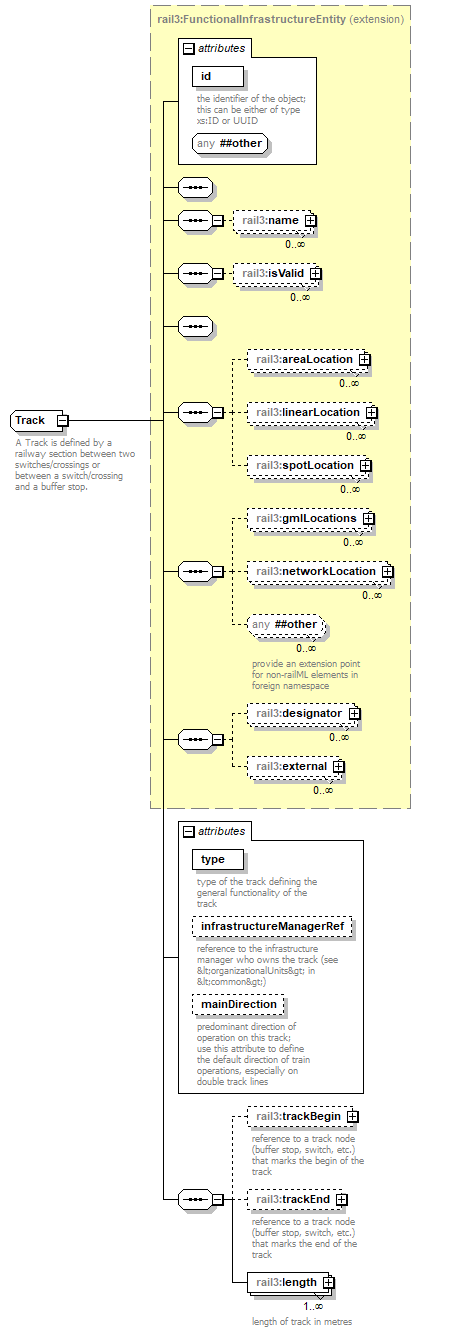 | ||||||||||||||||||||||||||||||||||||||
| namespace | https://www.railml.org/schemas/3.1 | ||||||||||||||||||||||||||||||||||||||
| type | extension of rail3:FunctionalInfrastructureEntity | ||||||||||||||||||||||||||||||||||||||
| properties |
| ||||||||||||||||||||||||||||||||||||||
| children | rail3:name rail3:isValid rail3:areaLocation rail3:linearLocation rail3:spotLocation rail3:gmlLocations rail3:networkLocation rail3:designator rail3:external rail3:trackBegin rail3:trackEnd rail3:length | ||||||||||||||||||||||||||||||||||||||
| used by |
| ||||||||||||||||||||||||||||||||||||||
| attributes |
| ||||||||||||||||||||||||||||||||||||||
| annotation |
| ||||||||||||||||||||||||||||||||||||||
| source | <xs:complexType name="Track"> <xs:annotation> <xs:documentation>A Track is defined by a railway section between two switches/crossings or between a switch/crossing and a buffer stop.</xs:documentation> </xs:annotation> <xs:complexContent> <xs:extension base="rail3:FunctionalInfrastructureEntity"> <xs:sequence> <xs:element name="trackBegin" type="rail3:tElementWithIDref" minOccurs="0" maxOccurs="1"> <xs:annotation> <xs:documentation>reference to a track node (buffer stop, switch, etc.) that marks the begin of the track</xs:documentation> </xs:annotation> </xs:element> <xs:element name="trackEnd" type="rail3:tElementWithIDref" minOccurs="0" maxOccurs="1"> <xs:annotation> <xs:documentation>reference to a track node (buffer stop, switch, etc.) that marks the end of the track</xs:documentation> </xs:annotation> </xs:element> <xs:element name="length" type="rail3:Length" minOccurs="1" maxOccurs="unbounded"> <xs:annotation> <xs:documentation>length of track in metres</xs:documentation> </xs:annotation> </xs:element> </xs:sequence> <xs:attribute name="type" type="rail3:tTrackType" use="required"> <xs:annotation> <xs:documentation>type of the track defining the general functionality of the track</xs:documentation> </xs:annotation> </xs:attribute> <xs:attribute name="infrastructureManagerRef" type="rail3:tRef" use="optional"> <xs:annotation> <xs:documentation>reference to the infrastructure manager who owns the track (see <organizationalUnits> in <common>)</xs:documentation> </xs:annotation> </xs:attribute> <xs:attribute name="mainDirection" type="rail3:tExtendedDirection" use="optional"> <xs:annotation> <xs:documentation>predominant direction of operation on this track; use this attribute to define the default direction of train operations, especially on double track lines</xs:documentation> </xs:annotation> </xs:attribute> </xs:extension> </xs:complexContent> </xs:complexType> |
attribute Track/@type
| type | rail3:tTrackType | |||||||||||||||||||||||
| properties |
| |||||||||||||||||||||||
| facets |
| |||||||||||||||||||||||
| annotation |
| |||||||||||||||||||||||
| source | <xs:attribute name="type" type="rail3:tTrackType" use="required"> <xs:annotation> <xs:documentation>type of the track defining the general functionality of the track</xs:documentation> </xs:annotation> </xs:attribute> |
attribute Track/@infrastructureManagerRef
| type | rail3:tRef | ||
| properties |
| ||
| annotation |
| ||
| source | <xs:attribute name="infrastructureManagerRef" type="rail3:tRef" use="optional"> <xs:annotation> <xs:documentation>reference to the infrastructure manager who owns the track (see <organizationalUnits> in <common>)</xs:documentation> </xs:annotation> </xs:attribute> |
attribute Track/@mainDirection
| type | rail3:tExtendedDirection | ||||||||||||
| properties |
| ||||||||||||
| facets |
| ||||||||||||
| annotation |
| ||||||||||||
| source | <xs:attribute name="mainDirection" type="rail3:tExtendedDirection" use="optional"> <xs:annotation> <xs:documentation>predominant direction of operation on this track; use this attribute to define the default direction of train operations, especially on double track lines</xs:documentation> </xs:annotation> </xs:attribute> |
element Track/trackBegin
| diagram | 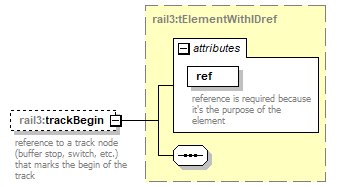 | ||||||||||||||
| namespace | https://www.railml.org/schemas/3.1 | ||||||||||||||
| type | rail3:tElementWithIDref | ||||||||||||||
| properties |
| ||||||||||||||
| attributes |
| ||||||||||||||
| annotation |
| ||||||||||||||
| source | <xs:element name="trackBegin" type="rail3:tElementWithIDref" minOccurs="0" maxOccurs="1"> <xs:annotation> <xs:documentation>reference to a track node (buffer stop, switch, etc.) that marks the begin of the track</xs:documentation> </xs:annotation> </xs:element> |
element Track/trackEnd
| diagram | 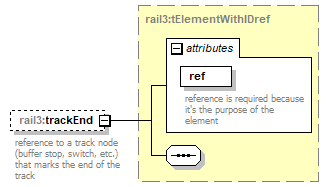 | ||||||||||||||
| namespace | https://www.railml.org/schemas/3.1 | ||||||||||||||
| type | rail3:tElementWithIDref | ||||||||||||||
| properties |
| ||||||||||||||
| attributes |
| ||||||||||||||
| annotation |
| ||||||||||||||
| source | <xs:element name="trackEnd" type="rail3:tElementWithIDref" minOccurs="0" maxOccurs="1"> <xs:annotation> <xs:documentation>reference to a track node (buffer stop, switch, etc.) that marks the end of the track</xs:documentation> </xs:annotation> </xs:element> |
element Track/length
| diagram | 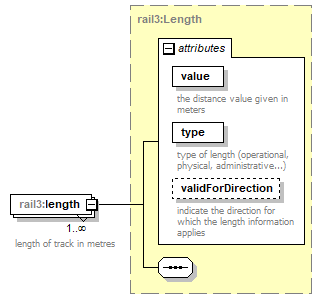 | ||||||||||||||||||||||||||||||
| namespace | https://www.railml.org/schemas/3.1 | ||||||||||||||||||||||||||||||
| type | rail3:Length | ||||||||||||||||||||||||||||||
| properties |
| ||||||||||||||||||||||||||||||
| attributes |
| ||||||||||||||||||||||||||||||
| annotation |
| ||||||||||||||||||||||||||||||
| source | <xs:element name="length" type="rail3:Length" minOccurs="1" maxOccurs="unbounded"> <xs:annotation> <xs:documentation>length of track in metres</xs:documentation> </xs:annotation> </xs:element> |
complexType TrackBed
| diagram | 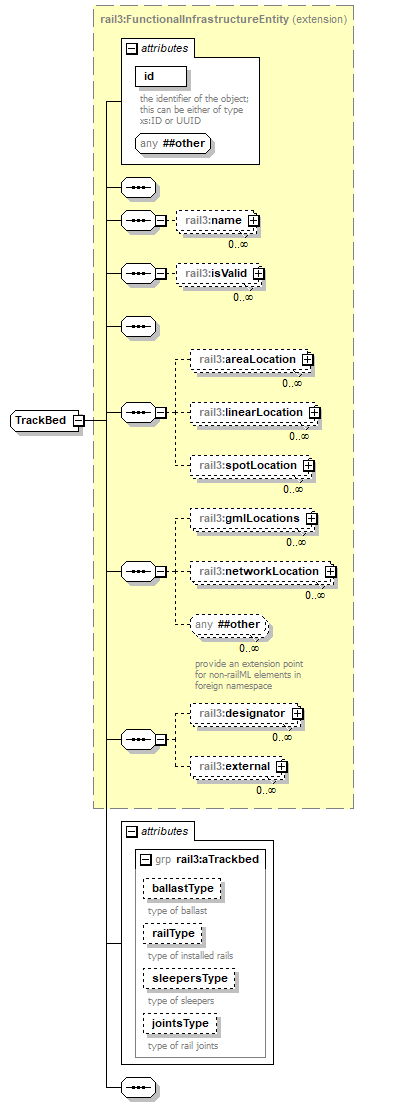 | ||||||||||||||||||||||||||||||||||||||||||||||
| namespace | https://www.railml.org/schemas/3.1 | ||||||||||||||||||||||||||||||||||||||||||||||
| type | extension of rail3:FunctionalInfrastructureEntity | ||||||||||||||||||||||||||||||||||||||||||||||
| properties |
| ||||||||||||||||||||||||||||||||||||||||||||||
| children | rail3:name rail3:isValid rail3:areaLocation rail3:linearLocation rail3:spotLocation rail3:gmlLocations rail3:networkLocation rail3:designator rail3:external | ||||||||||||||||||||||||||||||||||||||||||||||
| used by |
| ||||||||||||||||||||||||||||||||||||||||||||||
| attributes |
| ||||||||||||||||||||||||||||||||||||||||||||||
| source | <xs:complexType name="TrackBed"> <xs:complexContent> <xs:extension base="rail3:FunctionalInfrastructureEntity"> <xs:sequence/> <xs:attributeGroup ref="rail3:aTrackbed"/> </xs:extension> </xs:complexContent> </xs:complexType> |
complexType TrackBeds
| diagram |  | ||
| namespace | https://www.railml.org/schemas/3.1 | ||
| children | rail3:trackBed | ||
| used by |
| ||
| source | <xs:complexType name="TrackBeds"> <xs:sequence> <xs:element name="trackBed" type="rail3:TrackBed" minOccurs="1" maxOccurs="unbounded"/> </xs:sequence> </xs:complexType> |
element TrackBeds/trackBed
| diagram | 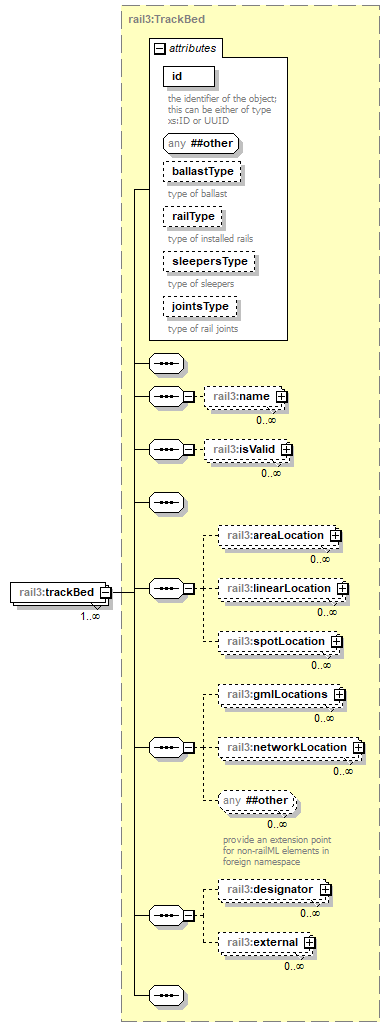 | ||||||||||||||||||||||||||||||||||||||||||||||
| namespace | https://www.railml.org/schemas/3.1 | ||||||||||||||||||||||||||||||||||||||||||||||
| type | rail3:TrackBed | ||||||||||||||||||||||||||||||||||||||||||||||
| properties |
| ||||||||||||||||||||||||||||||||||||||||||||||
| children | rail3:name rail3:isValid rail3:areaLocation rail3:linearLocation rail3:spotLocation rail3:gmlLocations rail3:networkLocation rail3:designator rail3:external | ||||||||||||||||||||||||||||||||||||||||||||||
| attributes |
| ||||||||||||||||||||||||||||||||||||||||||||||
| source | <xs:element name="trackBed" type="rail3:TrackBed" minOccurs="1" maxOccurs="unbounded"/> |
complexType TrackGauge
| diagram | 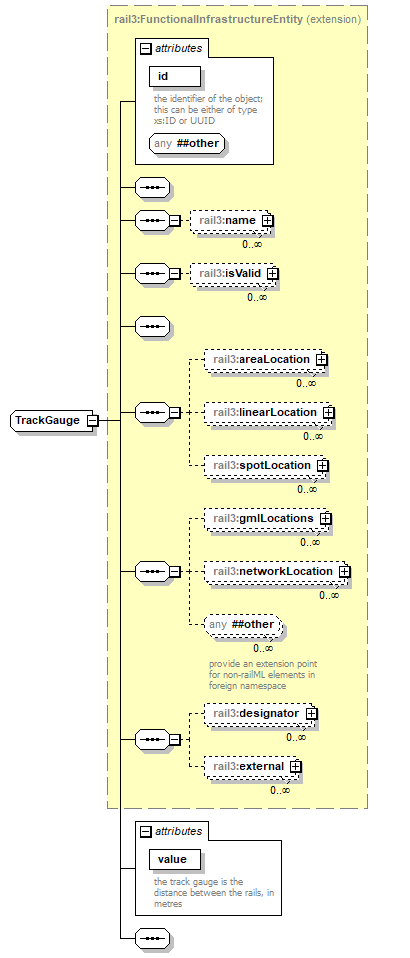 | ||||||||||||||||||||||
| namespace | https://www.railml.org/schemas/3.1 | ||||||||||||||||||||||
| type | extension of rail3:FunctionalInfrastructureEntity | ||||||||||||||||||||||
| properties |
| ||||||||||||||||||||||
| children | rail3:name rail3:isValid rail3:areaLocation rail3:linearLocation rail3:spotLocation rail3:gmlLocations rail3:networkLocation rail3:designator rail3:external | ||||||||||||||||||||||
| used by |
| ||||||||||||||||||||||
| attributes |
| ||||||||||||||||||||||
| source | <xs:complexType name="TrackGauge"> <xs:complexContent> <xs:extension base="rail3:FunctionalInfrastructureEntity"> <xs:sequence/> <xs:attribute name="value" type="rail3:tLengthM" use="required"> <xs:annotation> <xs:documentation>the track gauge is the distance between the rails, in metres</xs:documentation> </xs:annotation> </xs:attribute> </xs:extension> </xs:complexContent> </xs:complexType> |
attribute TrackGauge/@value
| type | rail3:tLengthM | ||
| properties |
| ||
| annotation |
| ||
| source | <xs:attribute name="value" type="rail3:tLengthM" use="required"> <xs:annotation> <xs:documentation>the track gauge is the distance between the rails, in metres</xs:documentation> </xs:annotation> </xs:attribute> |
complexType TrackGauges
| diagram |  | ||
| namespace | https://www.railml.org/schemas/3.1 | ||
| children | rail3:trackGauge | ||
| used by |
| ||
| annotation |
| ||
| source | <xs:complexType name="TrackGauges"> <xs:annotation> <xs:documentation>umbrella element for all trackGauge elements</xs:documentation> </xs:annotation> <xs:sequence> <xs:element name="trackGauge" type="rail3:TrackGauge" minOccurs="1" maxOccurs="unbounded"/> </xs:sequence> </xs:complexType> |
element TrackGauges/trackGauge
| diagram | 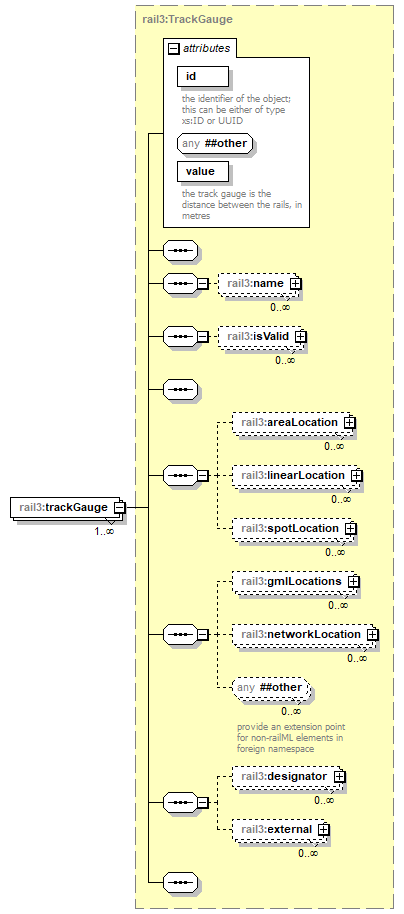 | ||||||||||||||||||||||
| namespace | https://www.railml.org/schemas/3.1 | ||||||||||||||||||||||
| type | rail3:TrackGauge | ||||||||||||||||||||||
| properties |
| ||||||||||||||||||||||
| children | rail3:name rail3:isValid rail3:areaLocation rail3:linearLocation rail3:spotLocation rail3:gmlLocations rail3:networkLocation rail3:designator rail3:external | ||||||||||||||||||||||
| attributes |
| ||||||||||||||||||||||
| source | <xs:element name="trackGauge" type="rail3:TrackGauge" minOccurs="1" maxOccurs="unbounded"/> |
complexType TrackNode
| diagram | 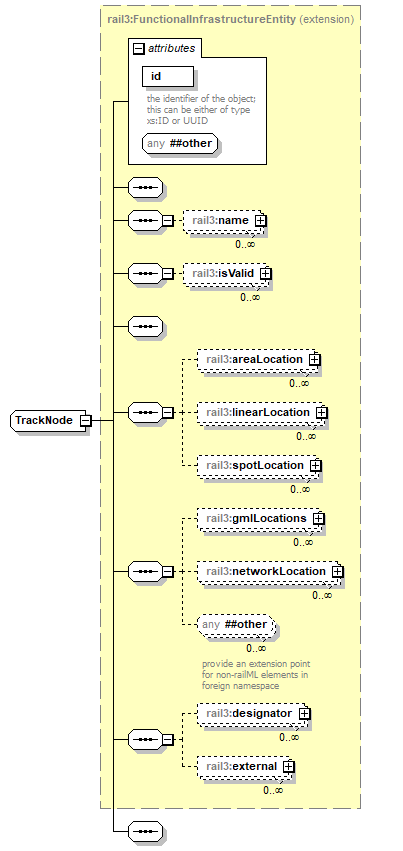 | ||||||||||||||
| namespace | https://www.railml.org/schemas/3.1 | ||||||||||||||
| type | extension of rail3:FunctionalInfrastructureEntity | ||||||||||||||
| properties |
| ||||||||||||||
| children | rail3:name rail3:isValid rail3:areaLocation rail3:linearLocation rail3:spotLocation rail3:gmlLocations rail3:networkLocation rail3:designator rail3:external | ||||||||||||||
| used by |
| ||||||||||||||
| attributes |
| ||||||||||||||
| source | <xs:complexType name="TrackNode" abstract="true"> <xs:complexContent> <xs:extension base="rail3:FunctionalInfrastructureEntity"> <xs:sequence/> </xs:extension> </xs:complexContent> </xs:complexType> |
complexType Tracks
| diagram |  | ||
| namespace | https://www.railml.org/schemas/3.1 | ||
| children | rail3:track | ||
| used by |
| ||
| source | <xs:complexType name="Tracks"> <xs:sequence> <xs:element name="track" type="rail3:Track" minOccurs="1" maxOccurs="unbounded"/> </xs:sequence> </xs:complexType> |
element Tracks/track
| diagram |  | ||||||||||||||||||||||||||||||||||||||
| namespace | https://www.railml.org/schemas/3.1 | ||||||||||||||||||||||||||||||||||||||
| type | rail3:Track | ||||||||||||||||||||||||||||||||||||||
| properties |
| ||||||||||||||||||||||||||||||||||||||
| children | rail3:name rail3:isValid rail3:areaLocation rail3:linearLocation rail3:spotLocation rail3:gmlLocations rail3:networkLocation rail3:designator rail3:external rail3:trackBegin rail3:trackEnd rail3:length | ||||||||||||||||||||||||||||||||||||||
| attributes |
| ||||||||||||||||||||||||||||||||||||||
| source | <xs:element name="track" type="rail3:Track" minOccurs="1" maxOccurs="unbounded"/> |
complexType TrainDetectionElement
| diagram | 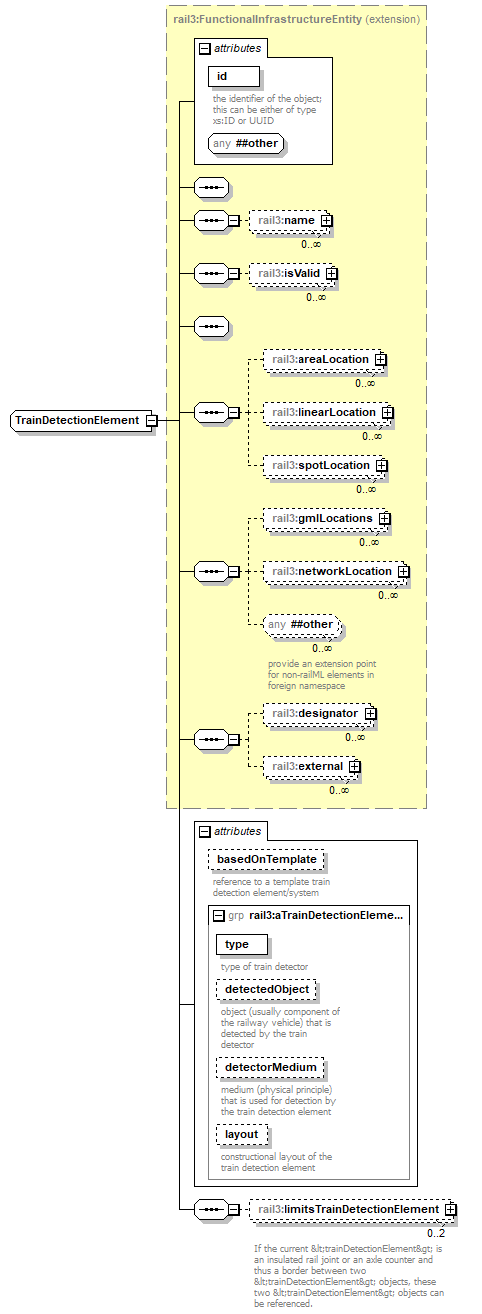 | ||||||||||||||||||||||||||||||||||||||||||||||||||||||
| namespace | https://www.railml.org/schemas/3.1 | ||||||||||||||||||||||||||||||||||||||||||||||||||||||
| type | extension of rail3:FunctionalInfrastructureEntity | ||||||||||||||||||||||||||||||||||||||||||||||||||||||
| properties |
| ||||||||||||||||||||||||||||||||||||||||||||||||||||||
| children | rail3:name rail3:isValid rail3:areaLocation rail3:linearLocation rail3:spotLocation rail3:gmlLocations rail3:networkLocation rail3:designator rail3:external rail3:limitsTrainDetectionElement | ||||||||||||||||||||||||||||||||||||||||||||||||||||||
| used by |
| ||||||||||||||||||||||||||||||||||||||||||||||||||||||
| attributes |
| ||||||||||||||||||||||||||||||||||||||||||||||||||||||
| source | <xs:complexType name="TrainDetectionElement"> <xs:complexContent> <xs:extension base="rail3:FunctionalInfrastructureEntity"> <xs:sequence> <xs:element name="limitsTrainDetectionElement" type="rail3:tElementWithIDref" minOccurs="0" maxOccurs="2"> <xs:annotation> <xs:documentation>If the current <trainDetectionElement> is an insulated rail joint or an axle counter and thus a border between two <trainDetectionElement> objects, these two <trainDetectionElement> objects can be referenced.</xs:documentation> </xs:annotation> </xs:element> </xs:sequence> <xs:attribute name="basedOnTemplate" type="rail3:tRef" use="optional"> <xs:annotation> <xs:documentation>reference to a template train detection element/system</xs:documentation> </xs:annotation> </xs:attribute> <xs:attributeGroup ref="rail3:aTrainDetectionElement"/> </xs:extension> </xs:complexContent> </xs:complexType> |
attribute TrainDetectionElement/@basedOnTemplate
| type | rail3:tRef | ||
| properties |
| ||
| annotation |
| ||
| source | <xs:attribute name="basedOnTemplate" type="rail3:tRef" use="optional"> <xs:annotation> <xs:documentation>reference to a template train detection element/system</xs:documentation> </xs:annotation> </xs:attribute> |
element TrainDetectionElement/limitsTrainDetectionElement
| diagram | 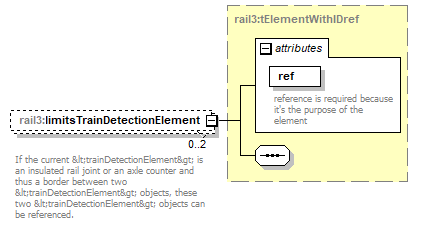 | ||||||||||||||
| namespace | https://www.railml.org/schemas/3.1 | ||||||||||||||
| type | rail3:tElementWithIDref | ||||||||||||||
| properties |
| ||||||||||||||
| attributes |
| ||||||||||||||
| annotation |
| ||||||||||||||
| source | <xs:element name="limitsTrainDetectionElement" type="rail3:tElementWithIDref" minOccurs="0" maxOccurs="2"> <xs:annotation> <xs:documentation>If the current <trainDetectionElement> is an insulated rail joint or an axle counter and thus a border between two <trainDetectionElement> objects, these two <trainDetectionElement> objects can be referenced.</xs:documentation> </xs:annotation> </xs:element> |
complexType TrainDetectionElements
| diagram |  | ||
| namespace | https://www.railml.org/schemas/3.1 | ||
| children | rail3:trainDetectionElement | ||
| used by |
| ||
| source | <xs:complexType name="TrainDetectionElements"> <xs:sequence> <xs:element name="trainDetectionElement" type="rail3:TrainDetectionElement" minOccurs="0" maxOccurs="unbounded"/> </xs:sequence> </xs:complexType> |
element TrainDetectionElements/trainDetectionElement
| diagram | 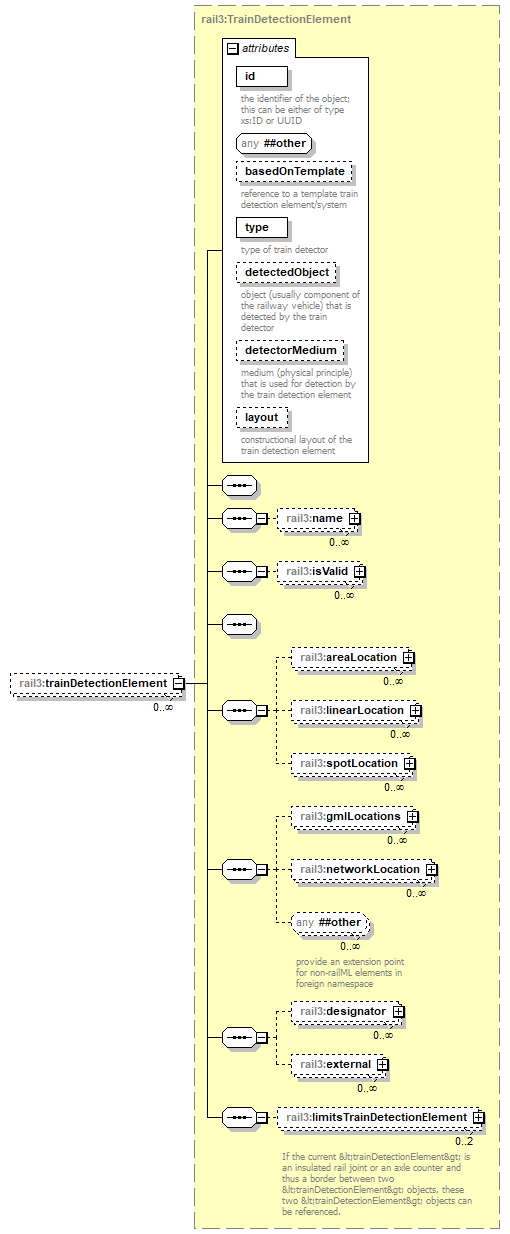 | ||||||||||||||||||||||||||||||||||||||||||||||||||||||
| namespace | https://www.railml.org/schemas/3.1 | ||||||||||||||||||||||||||||||||||||||||||||||||||||||
| type | rail3:TrainDetectionElement | ||||||||||||||||||||||||||||||||||||||||||||||||||||||
| properties |
| ||||||||||||||||||||||||||||||||||||||||||||||||||||||
| children | rail3:name rail3:isValid rail3:areaLocation rail3:linearLocation rail3:spotLocation rail3:gmlLocations rail3:networkLocation rail3:designator rail3:external rail3:limitsTrainDetectionElement | ||||||||||||||||||||||||||||||||||||||||||||||||||||||
| attributes |
| ||||||||||||||||||||||||||||||||||||||||||||||||||||||
| source | <xs:element name="trainDetectionElement" type="rail3:TrainDetectionElement" minOccurs="0" maxOccurs="unbounded"/> |
complexType TrainMovement
| diagram | 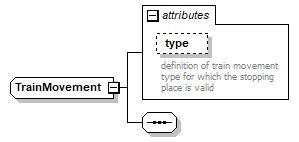 | ||||||||||||||
| namespace | https://www.railml.org/schemas/3.1 | ||||||||||||||
| used by |
| ||||||||||||||
| attributes |
| ||||||||||||||
| source | <xs:complexType name="TrainMovement"> <xs:sequence/> <xs:attribute name="type" type="rail3:tTrainMovementTypeExt" use="optional"> <xs:annotation> <xs:documentation>definition of train movement type for which the stopping place is valid</xs:documentation> </xs:annotation> </xs:attribute> </xs:complexType> |
attribute TrainMovement/@type
| type | rail3:tTrainMovementTypeExt | ||
| properties |
| ||
| annotation |
| ||
| source | <xs:attribute name="type" type="rail3:tTrainMovementTypeExt" use="optional"> <xs:annotation> <xs:documentation>definition of train movement type for which the stopping place is valid</xs:documentation> </xs:annotation> </xs:attribute> |
complexType TrainProtectionElement
| diagram | 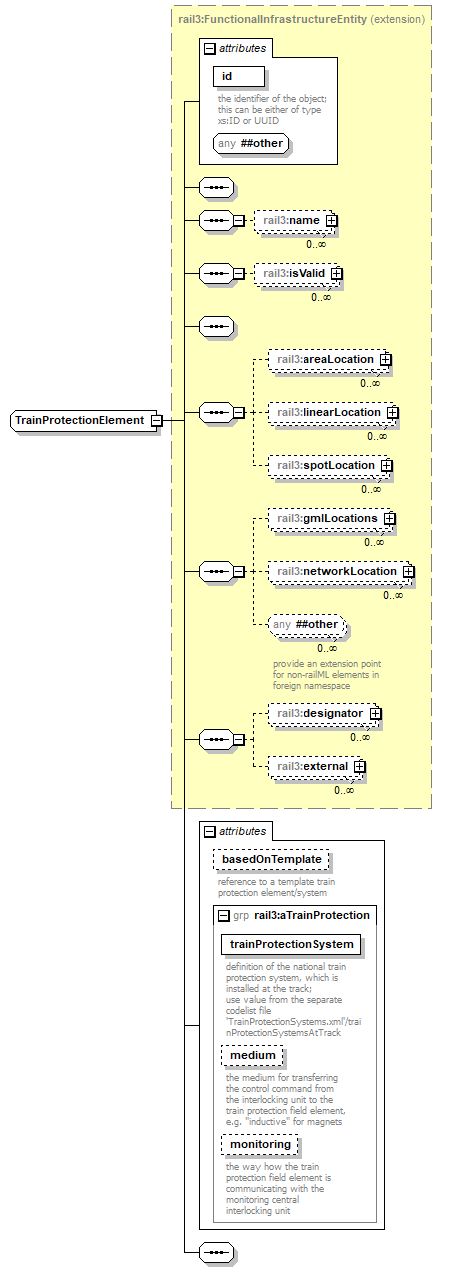 | ||||||||||||||||||||||||||||||||||||||||||||||
| namespace | https://www.railml.org/schemas/3.1 | ||||||||||||||||||||||||||||||||||||||||||||||
| type | extension of rail3:FunctionalInfrastructureEntity | ||||||||||||||||||||||||||||||||||||||||||||||
| properties |
| ||||||||||||||||||||||||||||||||||||||||||||||
| children | rail3:name rail3:isValid rail3:areaLocation rail3:linearLocation rail3:spotLocation rail3:gmlLocations rail3:networkLocation rail3:designator rail3:external | ||||||||||||||||||||||||||||||||||||||||||||||
| used by |
| ||||||||||||||||||||||||||||||||||||||||||||||
| attributes |
| ||||||||||||||||||||||||||||||||||||||||||||||
| source | <xs:complexType name="TrainProtectionElement"> <xs:complexContent> <xs:extension base="rail3:FunctionalInfrastructureEntity"> <xs:sequence/> <xs:attribute name="basedOnTemplate" type="rail3:tRef" use="optional"> <xs:annotation> <xs:documentation>reference to a template train protection element/system</xs:documentation> </xs:annotation> </xs:attribute> <xs:attributeGroup ref="rail3:aTrainProtection"/> </xs:extension> </xs:complexContent> </xs:complexType> |
attribute TrainProtectionElement/@basedOnTemplate
| type | rail3:tRef | ||
| properties |
| ||
| annotation |
| ||
| source | <xs:attribute name="basedOnTemplate" type="rail3:tRef" use="optional"> <xs:annotation> <xs:documentation>reference to a template train protection element/system</xs:documentation> </xs:annotation> </xs:attribute> |
complexType TrainProtectionElements
| diagram |  | ||
| namespace | https://www.railml.org/schemas/3.1 | ||
| children | rail3:trainProtectionElement | ||
| used by |
| ||
| source | <xs:complexType name="TrainProtectionElements"> <xs:sequence> <xs:element name="trainProtectionElement" type="rail3:TrainProtectionElement" minOccurs="0" maxOccurs="unbounded"/> </xs:sequence> </xs:complexType> |
element TrainProtectionElements/trainProtectionElement
| diagram | 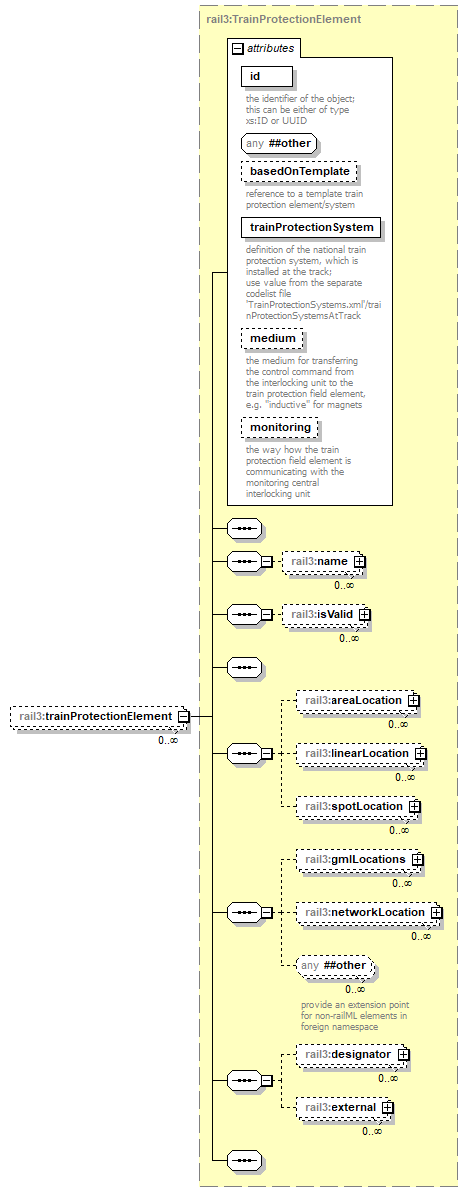 | ||||||||||||||||||||||||||||||||||||||||||||||
| namespace | https://www.railml.org/schemas/3.1 | ||||||||||||||||||||||||||||||||||||||||||||||
| type | rail3:TrainProtectionElement | ||||||||||||||||||||||||||||||||||||||||||||||
| properties |
| ||||||||||||||||||||||||||||||||||||||||||||||
| children | rail3:name rail3:isValid rail3:areaLocation rail3:linearLocation rail3:spotLocation rail3:gmlLocations rail3:networkLocation rail3:designator rail3:external | ||||||||||||||||||||||||||||||||||||||||||||||
| attributes |
| ||||||||||||||||||||||||||||||||||||||||||||||
| source | <xs:element name="trainProtectionElement" type="rail3:TrainProtectionElement" minOccurs="0" maxOccurs="unbounded"/> |
complexType TrainRadio
| diagram |  | ||||||||||||||||||||||||||||||||||||||||||||||||||||||||||||||||||||||
| namespace | https://www.railml.org/schemas/3.1 | ||||||||||||||||||||||||||||||||||||||||||||||||||||||||||||||||||||||
| type | extension of rail3:FunctionalInfrastructureEntity | ||||||||||||||||||||||||||||||||||||||||||||||||||||||||||||||||||||||
| properties |
| ||||||||||||||||||||||||||||||||||||||||||||||||||||||||||||||||||||||
| children | rail3:name rail3:isValid rail3:areaLocation rail3:linearLocation rail3:spotLocation rail3:gmlLocations rail3:networkLocation rail3:designator rail3:external | ||||||||||||||||||||||||||||||||||||||||||||||||||||||||||||||||||||||
| used by |
| ||||||||||||||||||||||||||||||||||||||||||||||||||||||||||||||||||||||
| attributes |
| ||||||||||||||||||||||||||||||||||||||||||||||||||||||||||||||||||||||
| source | <xs:complexType name="TrainRadio"> <xs:complexContent> <xs:extension base="rail3:FunctionalInfrastructureEntity"> <xs:sequence/> <xs:attribute name="supportsBroadcastCalls" type="xs:boolean" use="optional"> <xs:annotation> <xs:documentation>defines whether broadcast call functionality is available</xs:documentation> </xs:annotation> </xs:attribute> <xs:attribute name="supportsDirectMode" type="xs:boolean" use="optional"> <xs:annotation> <xs:documentation>defines whether direct mode train radio is available</xs:documentation> </xs:annotation> </xs:attribute> <xs:attribute name="supportsPublicEmergency" type="xs:boolean" use="optional"> <xs:annotation> <xs:documentation>defines whether public emergency calls are available</xs:documentation> </xs:annotation> </xs:attribute> <xs:attribute name="supportsPublicNetworkRoaming" type="xs:boolean" use="optional"> <xs:annotation> <xs:documentation>defines whether roaming via public networks is available</xs:documentation> </xs:annotation> </xs:attribute> <xs:attribute name="radioSystem" type="rail3:tTrainRadioSystemExt" use="optional"> <xs:annotation> <xs:documentation>the train radio system, e.g. 'GSM-R'</xs:documentation> </xs:annotation> </xs:attribute> <xs:attribute name="supportsTextMessageService" type="xs:boolean" use="optional"> <xs:annotation> <xs:documentation>defines whether text message service (SMS) is available</xs:documentation> </xs:annotation> </xs:attribute> <xs:attribute name="networkSelection" type="rail3:tTrainRadioNetworkSelectionExt" use="optional"> <xs:annotation> <xs:documentation>defines the procedure of train radio network selection</xs:documentation> </xs:annotation> </xs:attribute> </xs:extension> </xs:complexContent> </xs:complexType> |
attribute TrainRadio/@supportsBroadcastCalls
| type | xs:boolean | ||
| properties |
| ||
| annotation |
| ||
| source | <xs:attribute name="supportsBroadcastCalls" type="xs:boolean" use="optional"> <xs:annotation> <xs:documentation>defines whether broadcast call functionality is available</xs:documentation> </xs:annotation> </xs:attribute> |
attribute TrainRadio/@supportsDirectMode
| type | xs:boolean | ||
| properties |
| ||
| annotation |
| ||
| source | <xs:attribute name="supportsDirectMode" type="xs:boolean" use="optional"> <xs:annotation> <xs:documentation>defines whether direct mode train radio is available</xs:documentation> </xs:annotation> </xs:attribute> |
attribute TrainRadio/@supportsPublicEmergency
| type | xs:boolean | ||
| properties |
| ||
| annotation |
| ||
| source | <xs:attribute name="supportsPublicEmergency" type="xs:boolean" use="optional"> <xs:annotation> <xs:documentation>defines whether public emergency calls are available</xs:documentation> </xs:annotation> </xs:attribute> |
attribute TrainRadio/@supportsPublicNetworkRoaming
| type | xs:boolean | ||
| properties |
| ||
| annotation |
| ||
| source | <xs:attribute name="supportsPublicNetworkRoaming" type="xs:boolean" use="optional"> <xs:annotation> <xs:documentation>defines whether roaming via public networks is available</xs:documentation> </xs:annotation> </xs:attribute> |
attribute TrainRadio/@radioSystem
| type | rail3:tTrainRadioSystemExt | ||
| properties |
| ||
| annotation |
| ||
| source | <xs:attribute name="radioSystem" type="rail3:tTrainRadioSystemExt" use="optional"> <xs:annotation> <xs:documentation>the train radio system, e.g. 'GSM-R'</xs:documentation> </xs:annotation> </xs:attribute> |
attribute TrainRadio/@supportsTextMessageService
| type | xs:boolean | ||
| properties |
| ||
| annotation |
| ||
| source | <xs:attribute name="supportsTextMessageService" type="xs:boolean" use="optional"> <xs:annotation> <xs:documentation>defines whether text message service (SMS) is available</xs:documentation> </xs:annotation> </xs:attribute> |
attribute TrainRadio/@networkSelection
| type | rail3:tTrainRadioNetworkSelectionExt | ||
| properties |
| ||
| annotation |
| ||
| source | <xs:attribute name="networkSelection" type="rail3:tTrainRadioNetworkSelectionExt" use="optional"> <xs:annotation> <xs:documentation>defines the procedure of train radio network selection</xs:documentation> </xs:annotation> </xs:attribute> |
complexType TrainRadios
| diagram |  | ||
| namespace | https://www.railml.org/schemas/3.1 | ||
| children | rail3:trainRadio | ||
| used by |
| ||
| annotation |
| ||
| source | <xs:complexType name="TrainRadios"> <xs:annotation> <xs:documentation>umbrella element for all trainRadio elements</xs:documentation> </xs:annotation> <xs:sequence> <xs:element name="trainRadio" type="rail3:TrainRadio" minOccurs="1" maxOccurs="unbounded"/> </xs:sequence> </xs:complexType> |
element TrainRadios/trainRadio
| diagram |  | ||||||||||||||||||||||||||||||||||||||||||||||||||||||||||||||||||||||
| namespace | https://www.railml.org/schemas/3.1 | ||||||||||||||||||||||||||||||||||||||||||||||||||||||||||||||||||||||
| type | rail3:TrainRadio | ||||||||||||||||||||||||||||||||||||||||||||||||||||||||||||||||||||||
| properties |
| ||||||||||||||||||||||||||||||||||||||||||||||||||||||||||||||||||||||
| children | rail3:name rail3:isValid rail3:areaLocation rail3:linearLocation rail3:spotLocation rail3:gmlLocations rail3:networkLocation rail3:designator rail3:external | ||||||||||||||||||||||||||||||||||||||||||||||||||||||||||||||||||||||
| attributes |
| ||||||||||||||||||||||||||||||||||||||||||||||||||||||||||||||||||||||
| source | <xs:element name="trainRadio" type="rail3:TrainRadio" minOccurs="1" maxOccurs="unbounded"/> |
complexType UnderCrossing
| diagram |  | ||||||||||||||||||||||||||||||||||||||
| namespace | https://www.railml.org/schemas/3.1 | ||||||||||||||||||||||||||||||||||||||
| type | extension of rail3:XCrossing | ||||||||||||||||||||||||||||||||||||||
| properties |
| ||||||||||||||||||||||||||||||||||||||
| children | rail3:name rail3:isValid rail3:areaLocation rail3:linearLocation rail3:spotLocation rail3:gmlLocations rail3:networkLocation rail3:designator rail3:external rail3:crossesElement rail3:allowedWeightLimit rail3:length | ||||||||||||||||||||||||||||||||||||||
| used by |
| ||||||||||||||||||||||||||||||||||||||
| attributes |
| ||||||||||||||||||||||||||||||||||||||
| annotation |
| ||||||||||||||||||||||||||||||||||||||
| source | <xs:complexType name="UnderCrossing"> <xs:annotation> <xs:documentation>An under crossing describes a crossing, where something crosses under the railway line. The most common constructional type of an under crossing is a bridge.</xs:documentation> </xs:annotation> <xs:complexContent> <xs:extension base="rail3:XCrossing"> <xs:sequence> <xs:element name="allowedWeightLimit" type="rail3:tElementWithIDref" minOccurs="0" maxOccurs="unbounded"> <xs:annotation> <xs:documentation>reference to weight limit classes that are allowed to pass over this under crossing</xs:documentation> </xs:annotation> </xs:element> <xs:element name="length" type="rail3:Length" minOccurs="0" maxOccurs="unbounded"> <xs:annotation> <xs:documentation>length of the under crossing relative to the railway in metres</xs:documentation> </xs:annotation> </xs:element> </xs:sequence> <xs:attribute name="constructionType" type="rail3:tCrossingConstructionTypeExt" use="required"> <xs:annotation> <xs:documentation>construction type of under crossing: bridge or tunnel</xs:documentation> </xs:annotation> </xs:attribute> <xs:attribute name="belongsToParent" type="rail3:tRef" use="optional"> <xs:annotation> <xs:documentation>reference to a parent under crossing</xs:documentation> </xs:annotation> </xs:attribute> <xs:attributeGroup ref="rail3:aVerbalConstraint"/> </xs:extension> </xs:complexContent> </xs:complexType> |
attribute UnderCrossing/@constructionType
| type | rail3:tCrossingConstructionTypeExt | ||
| properties |
| ||
| annotation |
| ||
| source | <xs:attribute name="constructionType" type="rail3:tCrossingConstructionTypeExt" use="required"> <xs:annotation> <xs:documentation>construction type of under crossing: bridge or tunnel</xs:documentation> </xs:annotation> </xs:attribute> |
attribute UnderCrossing/@belongsToParent
| type | rail3:tRef | ||
| properties |
| ||
| annotation |
| ||
| source | <xs:attribute name="belongsToParent" type="rail3:tRef" use="optional"> <xs:annotation> <xs:documentation>reference to a parent under crossing</xs:documentation> </xs:annotation> </xs:attribute> |
element UnderCrossing/allowedWeightLimit
| diagram | 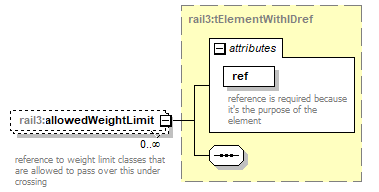 | ||||||||||||||
| namespace | https://www.railml.org/schemas/3.1 | ||||||||||||||
| type | rail3:tElementWithIDref | ||||||||||||||
| properties |
| ||||||||||||||
| attributes |
| ||||||||||||||
| annotation |
| ||||||||||||||
| source | <xs:element name="allowedWeightLimit" type="rail3:tElementWithIDref" minOccurs="0" maxOccurs="unbounded"> <xs:annotation> <xs:documentation>reference to weight limit classes that are allowed to pass over this under crossing</xs:documentation> </xs:annotation> </xs:element> |
element UnderCrossing/length
| diagram | 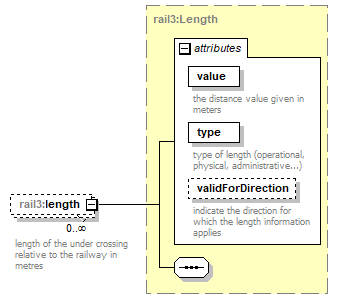 | ||||||||||||||||||||||||||||||
| namespace | https://www.railml.org/schemas/3.1 | ||||||||||||||||||||||||||||||
| type | rail3:Length | ||||||||||||||||||||||||||||||
| properties |
| ||||||||||||||||||||||||||||||
| attributes |
| ||||||||||||||||||||||||||||||
| annotation |
| ||||||||||||||||||||||||||||||
| source | <xs:element name="length" type="rail3:Length" minOccurs="0" maxOccurs="unbounded"> <xs:annotation> <xs:documentation>length of the under crossing relative to the railway in metres</xs:documentation> </xs:annotation> </xs:element> |
complexType UnderCrossings
| diagram |  | ||
| namespace | https://www.railml.org/schemas/3.1 | ||
| children | rail3:underCrossing | ||
| used by |
| ||
| source | <xs:complexType name="UnderCrossings"> <xs:sequence> <xs:element name="underCrossing" type="rail3:UnderCrossing" minOccurs="1" maxOccurs="unbounded"/> </xs:sequence> </xs:complexType> |
element UnderCrossings/underCrossing
| diagram | 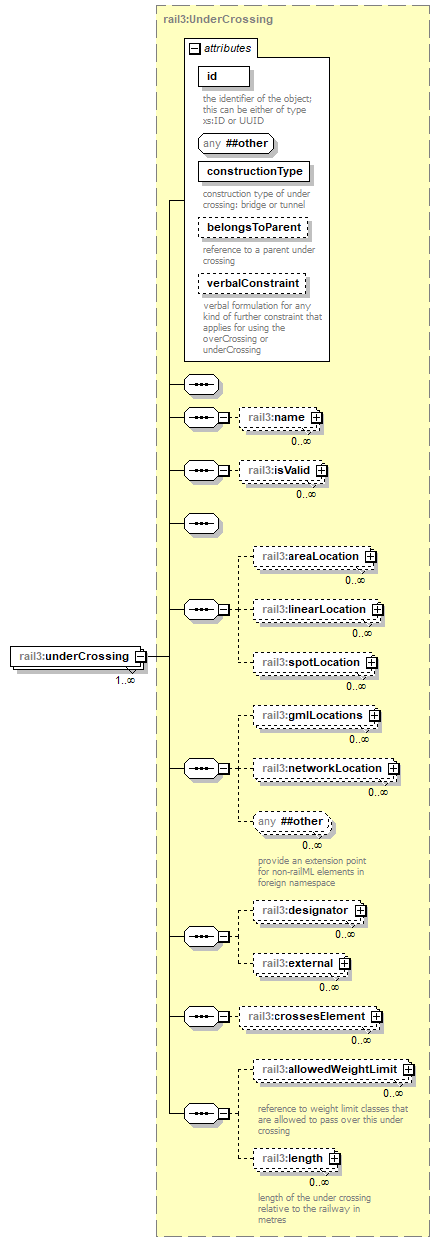 | ||||||||||||||||||||||||||||||||||||||
| namespace | https://www.railml.org/schemas/3.1 | ||||||||||||||||||||||||||||||||||||||
| type | rail3:UnderCrossing | ||||||||||||||||||||||||||||||||||||||
| properties |
| ||||||||||||||||||||||||||||||||||||||
| children | rail3:name rail3:isValid rail3:areaLocation rail3:linearLocation rail3:spotLocation rail3:gmlLocations rail3:networkLocation rail3:designator rail3:external rail3:crossesElement rail3:allowedWeightLimit rail3:length | ||||||||||||||||||||||||||||||||||||||
| attributes |
| ||||||||||||||||||||||||||||||||||||||
| source | <xs:element name="underCrossing" type="rail3:UnderCrossing" minOccurs="1" maxOccurs="unbounded"/> |
complexType Visualization
| diagram | 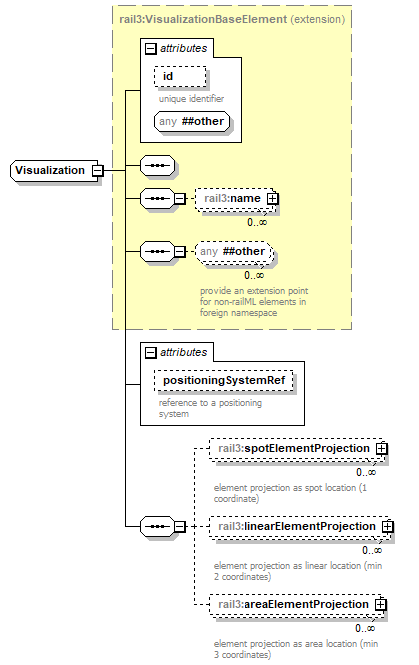 | ||||||||||||||||||||||
| namespace | https://www.railml.org/schemas/3.1 | ||||||||||||||||||||||
| type | extension of rail3:VisualizationBaseElement | ||||||||||||||||||||||
| properties |
| ||||||||||||||||||||||
| children | rail3:name rail3:spotElementProjection rail3:linearElementProjection rail3:areaElementProjection | ||||||||||||||||||||||
| used by |
| ||||||||||||||||||||||
| attributes |
| ||||||||||||||||||||||
| source | <xs:complexType name="Visualization"> <xs:complexContent> <xs:extension base="rail3:VisualizationBaseElement"> <xs:sequence> <xs:element name="spotElementProjection" type="rail3:SpotProjection" minOccurs="0" maxOccurs="unbounded"> <xs:annotation> <xs:documentation>element projection as spot location (1 coordinate)</xs:documentation> </xs:annotation> </xs:element> <xs:element name="linearElementProjection" type="rail3:LinearProjection" minOccurs="0" maxOccurs="unbounded"> <xs:annotation> <xs:documentation>element projection as linear location (min 2 coordinates)</xs:documentation> </xs:annotation> </xs:element> <xs:element name="areaElementProjection" type="rail3:AreaProjection" minOccurs="0" maxOccurs="unbounded"> <xs:annotation> <xs:documentation>element projection as area location (min 3 coordinates)</xs:documentation> </xs:annotation> </xs:element> </xs:sequence> <xs:attribute name="positioningSystemRef" type="rail3:tRef" use="optional"> <xs:annotation> <xs:documentation>reference to a positioning system</xs:documentation> </xs:annotation> </xs:attribute> </xs:extension> </xs:complexContent> </xs:complexType> |
attribute Visualization/@positioningSystemRef
| type | rail3:tRef | ||
| properties |
| ||
| annotation |
| ||
| source | <xs:attribute name="positioningSystemRef" type="rail3:tRef" use="optional"> <xs:annotation> <xs:documentation>reference to a positioning system</xs:documentation> </xs:annotation> </xs:attribute> |
element Visualization/spotElementProjection
| diagram | 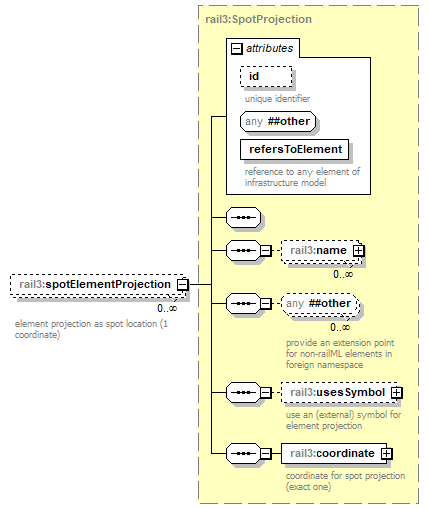 | ||||||||||||||||||||||
| namespace | https://www.railml.org/schemas/3.1 | ||||||||||||||||||||||
| type | rail3:SpotProjection | ||||||||||||||||||||||
| properties |
| ||||||||||||||||||||||
| children | rail3:name rail3:usesSymbol rail3:coordinate | ||||||||||||||||||||||
| attributes |
| ||||||||||||||||||||||
| annotation |
| ||||||||||||||||||||||
| source | <xs:element name="spotElementProjection" type="rail3:SpotProjection" minOccurs="0" maxOccurs="unbounded"> <xs:annotation> <xs:documentation>element projection as spot location (1 coordinate)</xs:documentation> </xs:annotation> </xs:element> |
element Visualization/linearElementProjection
| diagram | 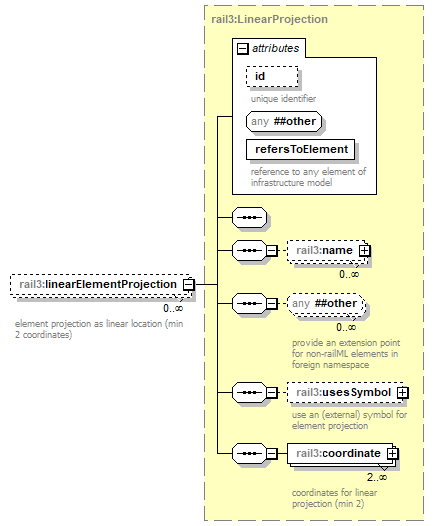 | ||||||||||||||||||||||
| namespace | https://www.railml.org/schemas/3.1 | ||||||||||||||||||||||
| type | rail3:LinearProjection | ||||||||||||||||||||||
| properties |
| ||||||||||||||||||||||
| children | rail3:name rail3:usesSymbol rail3:coordinate | ||||||||||||||||||||||
| attributes |
| ||||||||||||||||||||||
| annotation |
| ||||||||||||||||||||||
| source | <xs:element name="linearElementProjection" type="rail3:LinearProjection" minOccurs="0" maxOccurs="unbounded"> <xs:annotation> <xs:documentation>element projection as linear location (min 2 coordinates)</xs:documentation> </xs:annotation> </xs:element> |
element Visualization/areaElementProjection
| diagram | 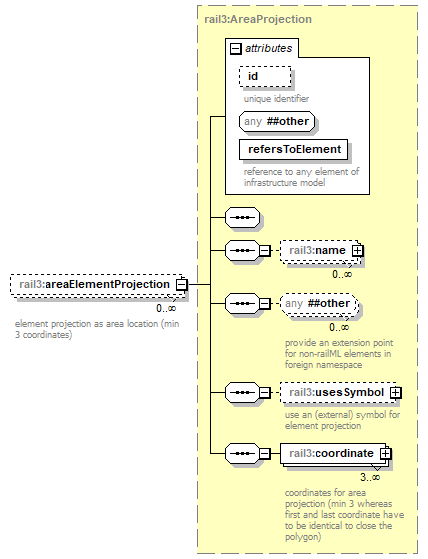 | ||||||||||||||||||||||
| namespace | https://www.railml.org/schemas/3.1 | ||||||||||||||||||||||
| type | rail3:AreaProjection | ||||||||||||||||||||||
| properties |
| ||||||||||||||||||||||
| children | rail3:name rail3:usesSymbol rail3:coordinate | ||||||||||||||||||||||
| attributes |
| ||||||||||||||||||||||
| annotation |
| ||||||||||||||||||||||
| source | <xs:element name="areaElementProjection" type="rail3:AreaProjection" minOccurs="0" maxOccurs="unbounded"> <xs:annotation> <xs:documentation>element projection as area location (min 3 coordinates)</xs:documentation> </xs:annotation> </xs:element> |
complexType VisualizationBaseElement
| diagram | 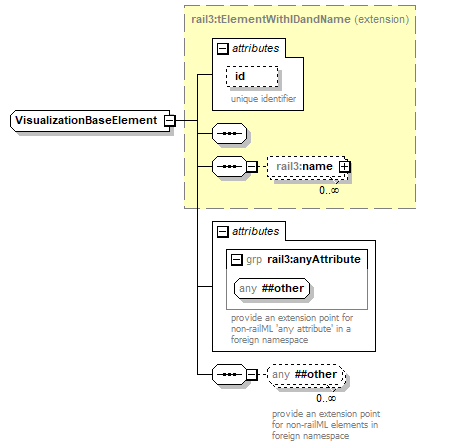 | ||||||||||||||
| namespace | https://www.railml.org/schemas/3.1 | ||||||||||||||
| type | extension of rail3:tElementWithIDandName | ||||||||||||||
| properties |
| ||||||||||||||
| children | rail3:name | ||||||||||||||
| used by |
| ||||||||||||||
| attributes |
| ||||||||||||||
| source | <xs:complexType name="VisualizationBaseElement" abstract="true"> <xs:complexContent> <xs:extension base="rail3:tElementWithIDandName"> <xs:sequence> <xs:any namespace="##other" processContents="strict" minOccurs="0" maxOccurs="unbounded"> <xs:annotation> <xs:documentation>provide an extension point for non-railML elements in foreign namespace</xs:documentation> </xs:annotation> </xs:any> </xs:sequence> <xs:attributeGroup ref="rail3:anyAttribute"/> </xs:extension> </xs:complexContent> </xs:complexType> |
complexType WeightLimit
| diagram | 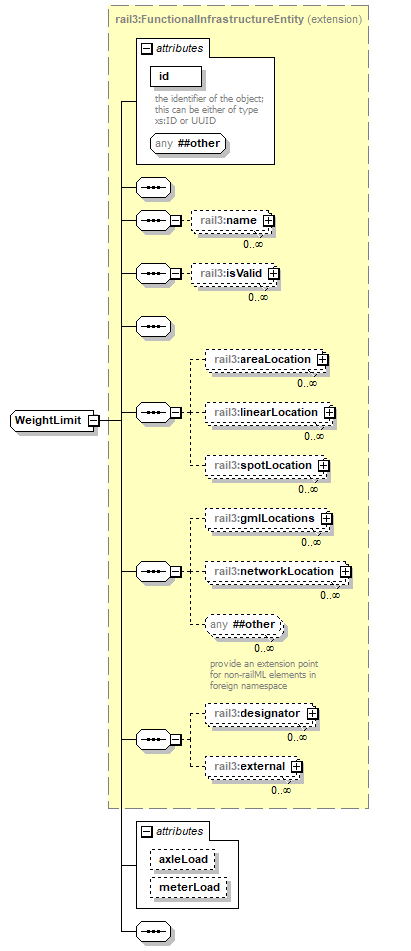 | ||||||||||||||||||||||||||
| namespace | https://www.railml.org/schemas/3.1 | ||||||||||||||||||||||||||
| type | extension of rail3:FunctionalInfrastructureEntity | ||||||||||||||||||||||||||
| properties |
| ||||||||||||||||||||||||||
| children | rail3:name rail3:isValid rail3:areaLocation rail3:linearLocation rail3:spotLocation rail3:gmlLocations rail3:networkLocation rail3:designator rail3:external | ||||||||||||||||||||||||||
| used by |
| ||||||||||||||||||||||||||
| attributes |
| ||||||||||||||||||||||||||
| source | <xs:complexType name="WeightLimit"> <xs:complexContent> <xs:extension base="rail3:FunctionalInfrastructureEntity"> <xs:sequence/> <xs:attribute name="axleLoad" type="rail3:tWeightTons" use="optional"/> <xs:attribute name="meterLoad" type="rail3:tMeterloadTonsPerMeter" use="optional"/> </xs:extension> </xs:complexContent> </xs:complexType> |
attribute WeightLimit/@axleLoad
| type | rail3:tWeightTons | ||
| properties |
| ||
| source | <xs:attribute name="axleLoad" type="rail3:tWeightTons" use="optional"/> |
attribute WeightLimit/@meterLoad
| type | rail3:tMeterloadTonsPerMeter | ||
| properties |
| ||
| source | <xs:attribute name="meterLoad" type="rail3:tMeterloadTonsPerMeter" use="optional"/> |
complexType WeightLimits
| diagram |  | ||
| namespace | https://www.railml.org/schemas/3.1 | ||
| children | rail3:weightLimit | ||
| used by |
| ||
| annotation |
| ||
| source | <xs:complexType name="WeightLimits"> <xs:annotation> <xs:documentation>umbrella element for all weightLimit elements</xs:documentation> </xs:annotation> <xs:sequence> <xs:element name="weightLimit" type="rail3:WeightLimit" minOccurs="1" maxOccurs="unbounded"/> </xs:sequence> </xs:complexType> |
element WeightLimits/weightLimit
| diagram | 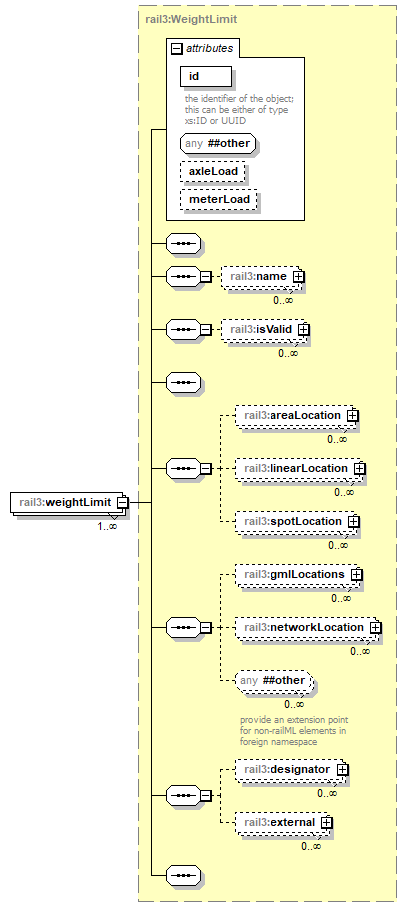 | ||||||||||||||||||||||||||
| namespace | https://www.railml.org/schemas/3.1 | ||||||||||||||||||||||||||
| type | rail3:WeightLimit | ||||||||||||||||||||||||||
| properties |
| ||||||||||||||||||||||||||
| children | rail3:name rail3:isValid rail3:areaLocation rail3:linearLocation rail3:spotLocation rail3:gmlLocations rail3:networkLocation rail3:designator rail3:external | ||||||||||||||||||||||||||
| attributes |
| ||||||||||||||||||||||||||
| source | <xs:element name="weightLimit" type="rail3:WeightLimit" minOccurs="1" maxOccurs="unbounded"/> |
complexType XCrossing
| diagram | 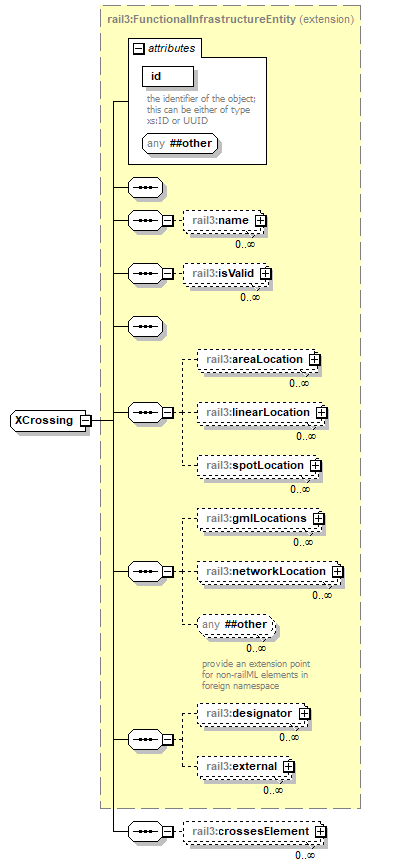 | ||||||||||||||
| namespace | https://www.railml.org/schemas/3.1 | ||||||||||||||
| type | extension of rail3:FunctionalInfrastructureEntity | ||||||||||||||
| properties |
| ||||||||||||||
| children | rail3:name rail3:isValid rail3:areaLocation rail3:linearLocation rail3:spotLocation rail3:gmlLocations rail3:networkLocation rail3:designator rail3:external rail3:crossesElement | ||||||||||||||
| used by |
| ||||||||||||||
| attributes |
| ||||||||||||||
| source | <xs:complexType name="XCrossing" abstract="true"> <xs:complexContent> <xs:extension base="rail3:FunctionalInfrastructureEntity"> <xs:sequence> <xs:element name="crossesElement" type="rail3:CrossedElement" minOccurs="0" maxOccurs="unbounded"/> </xs:sequence> </xs:extension> </xs:complexContent> </xs:complexType> |
element XCrossing/crossesElement
| diagram | 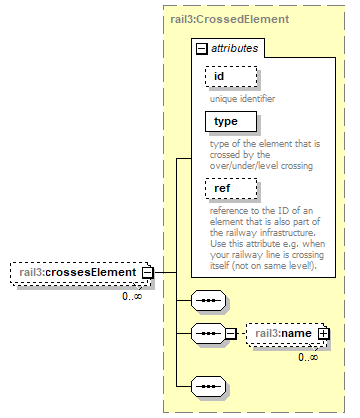 | ||||||||||||||||||||||||||||||
| namespace | https://www.railml.org/schemas/3.1 | ||||||||||||||||||||||||||||||
| type | rail3:CrossedElement | ||||||||||||||||||||||||||||||
| properties |
| ||||||||||||||||||||||||||||||
| children | rail3:name | ||||||||||||||||||||||||||||||
| attributes |
| ||||||||||||||||||||||||||||||
| source | <xs:element name="crossesElement" type="rail3:CrossedElement" minOccurs="0" maxOccurs="unbounded"/> |
simpleType tBaliseGroupType
| namespace | https://www.railml.org/schemas/3.1 | ||||||||||||
| type | restriction of xs:string | ||||||||||||
| properties |
| ||||||||||||
| used by |
| ||||||||||||
| facets |
| ||||||||||||
| source | <xs:simpleType name="tBaliseGroupType"> <xs:restriction base="xs:string"> <xs:enumeration value="signal"/> <xs:enumeration value="infill"/> <xs:enumeration value="fixed"/> </xs:restriction> </xs:simpleType> |
simpleType tBaliseGroupTypeExt
| namespace | https://www.railml.org/schemas/3.1 | ||
| type | union of (rail3:tBaliseGroupType, rail3:tOtherEnumerationValue) | ||
| used by |
| ||
| source | <xs:simpleType name="tBaliseGroupTypeExt"> <xs:union memberTypes="rail3:tBaliseGroupType rail3:tOtherEnumerationValue"/> </xs:simpleType> |
simpleType tBaliseType
| namespace | https://www.railml.org/schemas/3.1 | |||||||||
| type | restriction of xs:string | |||||||||
| properties |
| |||||||||
| used by |
| |||||||||
| facets |
| |||||||||
| source | <xs:simpleType name="tBaliseType"> <xs:restriction base="xs:string"> <xs:enumeration value="transparent"/> <xs:enumeration value="fixed"/> </xs:restriction> </xs:simpleType> |
simpleType tBallastType
| namespace | https://www.railml.org/schemas/3.1 | |||||||||
| type | restriction of xs:string | |||||||||
| properties |
| |||||||||
| used by |
| |||||||||
| facets |
| |||||||||
| source | <xs:simpleType name="tBallastType"> <xs:restriction base="xs:string"> <xs:enumeration value="slabTrack"/> <xs:enumeration value="ballast"/> </xs:restriction> </xs:simpleType> |
simpleType tBorderType
| namespace | https://www.railml.org/schemas/3.1 | |||||||||||||||||||||||||||||||||
| type | restriction of xs:string | |||||||||||||||||||||||||||||||||
| properties |
| |||||||||||||||||||||||||||||||||
| used by |
| |||||||||||||||||||||||||||||||||
| facets |
| |||||||||||||||||||||||||||||||||
| source | <xs:simpleType name="tBorderType"> <xs:restriction base="xs:string"> <xs:enumeration value="tariff"> <xs:annotation> <xs:documentation>border between different tariff zones; Shall also be used for borders between two (or more) transport associations</xs:documentation> </xs:annotation> </xs:enumeration> <xs:enumeration value="station"> <xs:annotation> <xs:documentation>border of a station</xs:documentation> </xs:annotation> </xs:enumeration> <xs:enumeration value="state"> <xs:annotation> <xs:documentation>border of a (federal) state</xs:documentation> </xs:annotation> </xs:enumeration> <xs:enumeration value="infrastructureManager"> <xs:annotation> <xs:documentation>border between infrastructure networks of different infrastructure managers</xs:documentation> </xs:annotation> </xs:enumeration> <xs:enumeration value="country"> <xs:annotation> <xs:documentation>border between different (national) countries</xs:documentation> </xs:annotation> </xs:enumeration> <xs:enumeration value="area"> <xs:annotation> <xs:documentation>border between different areas, e.g. areas that are controlled by different controllers</xs:documentation> </xs:annotation> </xs:enumeration> </xs:restriction> </xs:simpleType> |
simpleType tBorderTypeExt
| namespace | https://www.railml.org/schemas/3.1 | ||
| type | union of (rail3:tBorderType, rail3:tOtherEnumerationValue) | ||
| used by |
| ||
| source | <xs:simpleType name="tBorderTypeExt"> <xs:union memberTypes="rail3:tBorderType rail3:tOtherEnumerationValue"/> </xs:simpleType> |
simpleType tBufferStopType
| namespace | https://www.railml.org/schemas/3.1 | |||||||||||||||
| type | restriction of xs:string | |||||||||||||||
| properties |
| |||||||||||||||
| used by |
| |||||||||||||||
| facets |
| |||||||||||||||
| source | <xs:simpleType name="tBufferStopType"> <xs:restriction base="xs:string"> <xs:enumeration value="sleeperCross"/> <xs:enumeration value="headRamp"/> <xs:enumeration value="fixedBufferStop"/> <xs:enumeration value="brakingBufferStop"/> </xs:restriction> </xs:simpleType> |
simpleType tBufferStopTypeExt
| namespace | https://www.railml.org/schemas/3.1 |
| type | union of (rail3:tBufferStopType, rail3:tOtherEnumerationValue) |
| source | <xs:simpleType name="tBufferStopTypeExt"> <xs:union memberTypes="rail3:tBufferStopType rail3:tOtherEnumerationValue"/> </xs:simpleType> |
simpleType tContactLineType
| namespace | https://www.railml.org/schemas/3.1 | |||||||||||||||||||||
| type | restriction of xs:string | |||||||||||||||||||||
| properties |
| |||||||||||||||||||||
| used by |
| |||||||||||||||||||||
| facets |
| |||||||||||||||||||||
| source | <xs:simpleType name="tContactLineType"> <xs:restriction base="xs:string"> <xs:enumeration value="3rdRailTop"/> <xs:enumeration value="3rdRailSide"/> <xs:enumeration value="3rdRailBottom"/> <xs:enumeration value="sideRail"/> <xs:enumeration value="overhead"/> <xs:enumeration value="none"/> </xs:restriction> </xs:simpleType> |
simpleType tContactLineTypeExt
| namespace | https://www.railml.org/schemas/3.1 |
| type | union of (rail3:tContactLineType, rail3:tOtherEnumerationValue) |
| source | <xs:simpleType name="tContactLineTypeExt"> <xs:union memberTypes="rail3:tContactLineType rail3:tOtherEnumerationValue"/> </xs:simpleType> |
simpleType tContactStripMaterial
| namespace | https://www.railml.org/schemas/3.1 | |||||||||||||||||||||||||||||||||
| type | restriction of xs:string | |||||||||||||||||||||||||||||||||
| properties |
| |||||||||||||||||||||||||||||||||
| used by |
| |||||||||||||||||||||||||||||||||
| facets |
| |||||||||||||||||||||||||||||||||
| source | <xs:simpleType name="tContactStripMaterial"> <xs:restriction base="xs:string"> <xs:enumeration value="other"/> <xs:enumeration value="sinteredCopper"/> <xs:enumeration value="copperCladCarbon"/> <xs:enumeration value="carbonCladdedCopper"/> <xs:enumeration value="carbonAdditiveMaterial"/> <xs:enumeration value="impregnatedCarbon"/> <xs:enumeration value="copperAlloy"/> <xs:enumeration value="copperSteel"/> <xs:enumeration value="plainCarbon"/> <xs:enumeration value="copper"/> </xs:restriction> </xs:simpleType> |
simpleType tContactStripMaterialList
| namespace | https://www.railml.org/schemas/3.1 | ||
| type | list of rail3:tContactStripMaterial | ||
| properties |
| ||
| used by |
| ||
| source | <xs:simpleType name="tContactStripMaterialList"> <xs:list itemType="rail3:tContactStripMaterial"/> </xs:simpleType> |
simpleType tCourse
| namespace | https://www.railml.org/schemas/3.1 | |||||||||
| type | restriction of xs:string | |||||||||
| properties |
| |||||||||
| used by |
| |||||||||
| facets |
| |||||||||
| source | <xs:simpleType name="tCourse"> <xs:restriction base="xs:string"> <xs:enumeration value="right"/> <xs:enumeration value="left"/> </xs:restriction> </xs:simpleType> |
simpleType tCrossedElementType
| namespace | https://www.railml.org/schemas/3.1 | |||||||||||||||||||||||||||||||||||||||
| type | restriction of xs:string | |||||||||||||||||||||||||||||||||||||||
| properties |
| |||||||||||||||||||||||||||||||||||||||
| used by |
| |||||||||||||||||||||||||||||||||||||||
| facets |
| |||||||||||||||||||||||||||||||||||||||
| source | <xs:simpleType name="tCrossedElementType"> <xs:restriction base="xs:string"> <xs:enumeration value="lake"/> <xs:enumeration value="river"/> <xs:enumeration value="valley"/> <xs:enumeration value="ridge"/> <xs:enumeration value="peak"/> <xs:enumeration value="road"/> <xs:enumeration value="motorway"/> <xs:enumeration value="footway"/> <xs:enumeration value="city"/> <xs:enumeration value="area"/> <xs:enumeration value="cycleway"/> <xs:enumeration value="railway"/> </xs:restriction> </xs:simpleType> |
simpleType tCrossedElementTypeExt
| namespace | https://www.railml.org/schemas/3.1 | ||
| type | union of (rail3:tCrossedElementType, rail3:tOtherEnumerationValue) | ||
| used by |
| ||
| source | <xs:simpleType name="tCrossedElementTypeExt"> <xs:union memberTypes="rail3:tCrossedElementType rail3:tOtherEnumerationValue"/> </xs:simpleType> |
simpleType tCrossingConstructionType
| namespace | https://www.railml.org/schemas/3.1 | |||||||||
| type | restriction of xs:string | |||||||||
| properties |
| |||||||||
| used by |
| |||||||||
| facets |
| |||||||||
| source | <xs:simpleType name="tCrossingConstructionType"> <xs:restriction base="xs:string"> <xs:enumeration value="tunnel"/> <xs:enumeration value="bridge"/> </xs:restriction> </xs:simpleType> |
simpleType tCrossingConstructionTypeExt
| namespace | https://www.railml.org/schemas/3.1 | ||
| type | union of (rail3:tCrossingConstructionType, rail3:tOtherEnumerationValue) | ||
| used by |
| ||
| source | <xs:simpleType name="tCrossingConstructionTypeExt"> <xs:union memberTypes="rail3:tCrossingConstructionType rail3:tOtherEnumerationValue"/> </xs:simpleType> |
simpleType tCurrentSystem
| namespace | https://www.railml.org/schemas/3.1 | |||||||||
| type | restriction of xs:string | |||||||||
| properties |
| |||||||||
| facets |
| |||||||||
| source | <xs:simpleType name="tCurrentSystem"> <xs:restriction base="xs:string"> <xs:enumeration value="DC"/> <xs:enumeration value="AC"/> </xs:restriction> </xs:simpleType> |
simpleType tDetectedObject
| namespace | https://www.railml.org/schemas/3.1 | |||||||||||||||
| type | restriction of xs:string | |||||||||||||||
| properties |
| |||||||||||||||
| used by |
| |||||||||||||||
| facets |
| |||||||||||||||
| source | <xs:simpleType name="tDetectedObject"> <xs:restriction base="xs:string"> <xs:enumeration value="wheel"/> <xs:enumeration value="train"/> <xs:enumeration value="endOfTrain"/> <xs:enumeration value="axle"/> </xs:restriction> </xs:simpleType> |
simpleType tDetectorLayout
| namespace | https://www.railml.org/schemas/3.1 | |||||||||||||||||||||
| type | restriction of xs:string | |||||||||||||||||||||
| properties |
| |||||||||||||||||||||
| used by |
| |||||||||||||||||||||
| facets |
| |||||||||||||||||||||
| source | <xs:simpleType name="tDetectorLayout"> <xs:restriction base="xs:string"> <xs:enumeration value="tripleLoop"/> <xs:enumeration value="singleSensor"/> <xs:enumeration value="singleLoop"/> <xs:enumeration value="railCircuitStandAlone"/> <xs:enumeration value="doubleSensor"/> <xs:enumeration value="doubleLoop"/> </xs:restriction> </xs:simpleType> |
simpleType tDetectorMedium
| namespace | https://www.railml.org/schemas/3.1 | ||||||||||||||||||||||||
| type | restriction of xs:string | ||||||||||||||||||||||||
| properties |
| ||||||||||||||||||||||||
| used by |
| ||||||||||||||||||||||||
| facets |
| ||||||||||||||||||||||||
| source | <xs:simpleType name="tDetectorMedium"> <xs:restriction base="xs:string"> <xs:enumeration value="radio"/> <xs:enumeration value="pneumatic"/> <xs:enumeration value="optical"/> <xs:enumeration value="mechanical"/> <xs:enumeration value="magnetic"/> <xs:enumeration value="inductive"/> <xs:enumeration value="hydraulic"/> </xs:restriction> </xs:simpleType> |
simpleType tElementProjectionSymbolOrientation
| namespace | https://www.railml.org/schemas/3.1 | |||||||||||||||||||||||
| type | restriction of xs:string | |||||||||||||||||||||||
| properties |
| |||||||||||||||||||||||
| used by |
| |||||||||||||||||||||||
| facets |
| |||||||||||||||||||||||
| source | <xs:simpleType name="tElementProjectionSymbolOrientation"> <xs:restriction base="xs:string"> <xs:enumeration value="left"> <xs:annotation> <xs:documentation>icon or symbol turned 90 degrees left</xs:documentation> </xs:annotation> </xs:enumeration> <xs:enumeration value="down"> <xs:annotation> <xs:documentation>the icon or symbol is turned 180 degrees</xs:documentation> </xs:annotation> </xs:enumeration> <xs:enumeration value="right"> <xs:annotation> <xs:documentation>icon or symbol turned 90 degrees right</xs:documentation> </xs:annotation> </xs:enumeration> <xs:enumeration value="up"> <xs:annotation> <xs:documentation>standard orientation of icon or symbol</xs:documentation> </xs:annotation> </xs:enumeration> </xs:restriction> </xs:simpleType> |
simpleType tElementProjectionSymbolOrientationExt
| namespace | https://www.railml.org/schemas/3.1 | ||
| type | union of (rail3:tElementProjectionSymbolOrientation, rail3:tOtherEnumerationValue) | ||
| used by |
| ||
| source | <xs:simpleType name="tElementProjectionSymbolOrientationExt"> <xs:union memberTypes="rail3:tElementProjectionSymbolOrientation rail3:tOtherEnumerationValue"/> </xs:simpleType> |
simpleType tExtendedDirection
| namespace | https://www.railml.org/schemas/3.1 | ||||||||||||
| type | restriction of xs:string | ||||||||||||
| properties |
| ||||||||||||
| used by |
| ||||||||||||
| facets |
| ||||||||||||
| source | <xs:simpleType name="tExtendedDirection"> <xs:restriction base="xs:string"> <xs:enumeration value="both"/> <xs:enumeration value="reverse"/> <xs:enumeration value="normal"/> </xs:restriction> </xs:simpleType> |
simpleType tGradientCurveType
| namespace | https://www.railml.org/schemas/3.1 | ||||||||||||||||||
| type | restriction of xs:string | ||||||||||||||||||
| properties |
| ||||||||||||||||||
| used by |
| ||||||||||||||||||
| facets |
| ||||||||||||||||||
| source | <xs:simpleType name="tGradientCurveType"> <xs:restriction base="xs:string"> <xs:enumeration value="mixed"> <xs:annotation> <xs:documentation>an aggregated curve with arcs and straight parts</xs:documentation> </xs:annotation> </xs:enumeration> <xs:enumeration value="straight"> <xs:annotation> <xs:documentation>curve with constant infinite radius (zero curvature)</xs:documentation> </xs:annotation> </xs:enumeration> <xs:enumeration value="arc"> <xs:annotation> <xs:documentation>curve with a constant radius that is not infinite</xs:documentation> </xs:annotation> </xs:enumeration> </xs:restriction> </xs:simpleType> |
simpleType tHorizontalCurveType
| namespace | https://www.railml.org/schemas/3.1 | ||||||||||||||||||||||||||||||||||
| type | restriction of xs:string | ||||||||||||||||||||||||||||||||||
| properties |
| ||||||||||||||||||||||||||||||||||
| used by |
| ||||||||||||||||||||||||||||||||||
| facets |
| ||||||||||||||||||||||||||||||||||
| source | <xs:simpleType name="tHorizontalCurveType"> <xs:restriction base="xs:string"> <xs:enumeration value="straight"> <xs:annotation> <xs:documentation>A straight curve has a constant radius that is infinite.</xs:documentation> </xs:annotation> </xs:enumeration> <xs:enumeration value="sinusoide"/> <xs:enumeration value="doucine"/> <xs:enumeration value="curveWiener"/> <xs:enumeration value="curveBloss"/> <xs:enumeration value="cubicParabola"/> <xs:enumeration value="cosinusoide"/> <xs:enumeration value="clothoide"/> <xs:enumeration value="arc"> <xs:annotation> <xs:documentation>An arc has a constant radius that is not infinite and not zero.</xs:documentation> </xs:annotation> </xs:enumeration> </xs:restriction> </xs:simpleType> |
simpleType tHorizontalCurveTypeExt
| namespace | https://www.railml.org/schemas/3.1 | ||
| type | union of (rail3:tHorizontalCurveType, rail3:tOtherEnumerationValue) | ||
| used by |
| ||
| source | <xs:simpleType name="tHorizontalCurveTypeExt"> <xs:union memberTypes="rail3:tHorizontalCurveType rail3:tOtherEnumerationValue"/> </xs:simpleType> |
simpleType tInfrastructureState
| namespace | https://www.railml.org/schemas/3.1 | ||||||||||||||||||||||||||||
| type | restriction of xs:string | ||||||||||||||||||||||||||||
| properties |
| ||||||||||||||||||||||||||||
| used by |
| ||||||||||||||||||||||||||||
| facets |
| ||||||||||||||||||||||||||||
| source | <xs:simpleType name="tInfrastructureState"> <xs:restriction base="xs:string"> <xs:enumeration value="disabled"> <xs:annotation> <xs:documentation>The element is currently not usable, switched off or deactivated and therefore cannot be used regularly. However, it can be put back into operation at short notice without further construction, acceptance or approval activities.</xs:documentation> </xs:annotation> </xs:enumeration> <xs:enumeration value="closed"> <xs:annotation> <xs:documentation>The element is no longer available, removed, dismantled, or no longer exists. Planning, construction or commissioning activities are absolutely necessary for recommissioning.</xs:documentation> </xs:annotation> </xs:enumeration> <xs:enumeration value="operational"> <xs:annotation> <xs:documentation>The element is operational and can be used regularly.</xs:documentation> </xs:annotation> </xs:enumeration> <xs:enumeration value="conceptual"> <xs:annotation> <xs:documentation>The construction or commissioning of the element is planned for the medium or long term. However, there are still no concrete (planning) activities for the construction of the element beyond the preliminary planning and cost estimation.</xs:documentation> </xs:annotation> </xs:enumeration> <xs:enumeration value="planned"> <xs:annotation> <xs:documentation>The construction or commissioning of the element is planned concretely and at short notice or concrete planning activities for the construction take place, e.g. design, approval or implementation planning, cost calculation, award of contracts. It is not normally possible to use the element.</xs:documentation> </xs:annotation> </xs:enumeration> </xs:restriction> </xs:simpleType> |
simpleType tInfrastructureStateExt
| namespace | https://www.railml.org/schemas/3.1 | ||
| type | union of (rail3:tInfrastructureState, rail3:tOtherEnumerationValue) | ||
| used by |
| ||
| source | <xs:simpleType name="tInfrastructureStateExt"> <xs:union memberTypes="rail3:tInfrastructureState rail3:tOtherEnumerationValue"/> </xs:simpleType> |
simpleType tJointsType
| namespace | https://www.railml.org/schemas/3.1 | ||||||||||||
| type | restriction of xs:string | ||||||||||||
| properties |
| ||||||||||||
| used by |
| ||||||||||||
| facets |
| ||||||||||||
| annotation |
| ||||||||||||
| source | <xs:simpleType name="tJointsType"> <xs:annotation> <xs:documentation>rail joints implementation type</xs:documentation> </xs:annotation> <xs:restriction base="xs:string"> <xs:enumeration value="glued"/> <xs:enumeration value="insulated"/> <xs:enumeration value="welded"/> </xs:restriction> </xs:simpleType> |
simpleType tLengthType
| namespace | https://www.railml.org/schemas/3.1 | |||||||||||||
| type | restriction of xs:string | |||||||||||||
| properties |
| |||||||||||||
| used by |
| |||||||||||||
| facets |
| |||||||||||||
| source | <xs:simpleType name="tLengthType"> <xs:restriction base="xs:string"> <xs:enumeration value="physical"> <xs:annotation> <xs:documentation>physical length value</xs:documentation> </xs:annotation> </xs:enumeration> <xs:enumeration value="operational"> <xs:annotation> <xs:documentation>operational or administrative length value</xs:documentation> </xs:annotation> </xs:enumeration> </xs:restriction> </xs:simpleType> |
simpleType tLengthTypeExt
| namespace | https://www.railml.org/schemas/3.1 | ||
| type | union of (rail3:tLengthType, rail3:tOtherEnumerationValue) | ||
| used by |
| ||
| source | <xs:simpleType name="tLengthTypeExt"> <xs:union memberTypes="rail3:tLengthType rail3:tOtherEnumerationValue"/> </xs:simpleType> |
simpleType tLevelCrossingActivation
| namespace | https://www.railml.org/schemas/3.1 | ||||||||||||||||||||||||||||
| type | restriction of xs:string | ||||||||||||||||||||||||||||
| properties |
| ||||||||||||||||||||||||||||
| used by |
| ||||||||||||||||||||||||||||
| facets |
| ||||||||||||||||||||||||||||
| source | <xs:simpleType name="tLevelCrossingActivation"> <xs:restriction base="xs:string"> <xs:enumeration value="trainAutomatic"> <xs:annotation> <xs:documentation>level crossing is activated automatically from train side</xs:documentation> </xs:annotation> </xs:enumeration> <xs:enumeration value="trainManual"> <xs:annotation> <xs:documentation>level crossing is activated manually from train side (action of train driver required)</xs:documentation> </xs:annotation> </xs:enumeration> <xs:enumeration value="infrastructureAutomatic"> <xs:annotation> <xs:documentation>level crossing is activated automatically from infrastructure side (e.g. via activating rail detector)</xs:documentation> </xs:annotation> </xs:enumeration> <xs:enumeration value="infrastructureManual"> <xs:annotation> <xs:documentation>level crossing is activated manually from infrastructure side (e.g. by a dispatcher)</xs:documentation> </xs:annotation> </xs:enumeration> <xs:enumeration value="none"> <xs:annotation> <xs:documentation>there is no activation of the level crossing protection</xs:documentation> </xs:annotation> </xs:enumeration> </xs:restriction> </xs:simpleType> |
simpleType tLevelCrossingObstacleDetection
| namespace | https://www.railml.org/schemas/3.1 | ||||||||||||||||||
| type | restriction of xs:string | ||||||||||||||||||
| properties |
| ||||||||||||||||||
| used by |
| ||||||||||||||||||
| facets |
| ||||||||||||||||||
| source | <xs:simpleType name="tLevelCrossingObstacleDetection"> <xs:restriction base="xs:string"> <xs:enumeration value="none"> <xs:annotation> <xs:documentation>there is no obstacle detection taking place in the level crossing danger area</xs:documentation> </xs:annotation> </xs:enumeration> <xs:enumeration value="manual"> <xs:annotation> <xs:documentation>obstacle detection in level crossing danger area is done manually (e.g. via dispatcher looking)</xs:documentation> </xs:annotation> </xs:enumeration> <xs:enumeration value="automatic"> <xs:annotation> <xs:documentation>obstacle detection in level crossing danger area is done automatically (e.g. via radar)</xs:documentation> </xs:annotation> </xs:enumeration> </xs:restriction> </xs:simpleType> |
simpleType tLevelCrossingProtectionAcoustic
| namespace | https://www.railml.org/schemas/3.1 | |||||||||||||
| type | restriction of xs:string | |||||||||||||
| properties |
| |||||||||||||
| used by |
| |||||||||||||
| facets |
| |||||||||||||
| source | <xs:simpleType name="tLevelCrossingProtectionAcoustic"> <xs:restriction base="xs:string"> <xs:enumeration value="none"> <xs:annotation> <xs:documentation>no acoustic level crossing protection</xs:documentation> </xs:annotation> </xs:enumeration> <xs:enumeration value="bell"> <xs:annotation> <xs:documentation>acoustic level crossing protection with a bell</xs:documentation> </xs:annotation> </xs:enumeration> </xs:restriction> </xs:simpleType> |
simpleType tLevelCrossingProtectionAcousticExt
| namespace | https://www.railml.org/schemas/3.1 | ||
| type | union of (rail3:tLevelCrossingProtectionAcoustic, rail3:tOtherEnumerationValue) | ||
| used by |
| ||
| source | <xs:simpleType name="tLevelCrossingProtectionAcousticExt"> <xs:union memberTypes="rail3:tLevelCrossingProtectionAcoustic rail3:tOtherEnumerationValue"/> </xs:simpleType> |
simpleType tLevelCrossingProtectionBarrier
| namespace | https://www.railml.org/schemas/3.1 | |||||||||||||||||||||||
| type | restriction of xs:string | |||||||||||||||||||||||
| properties |
| |||||||||||||||||||||||
| used by |
| |||||||||||||||||||||||
| facets |
| |||||||||||||||||||||||
| source | <xs:simpleType name="tLevelCrossingProtectionBarrier"> <xs:restriction base="xs:string"> <xs:enumeration value="none"> <xs:annotation> <xs:documentation>no barriers</xs:documentation> </xs:annotation> </xs:enumeration> <xs:enumeration value="doubleHalfBarrier"> <xs:annotation> <xs:documentation>protection of the level crossing with half barriers on entry and exit side</xs:documentation> </xs:annotation> </xs:enumeration> <xs:enumeration value="singleHalfBarrier"> <xs:annotation> <xs:documentation>protection of the level crossing with half barriers on entry side</xs:documentation> </xs:annotation> </xs:enumeration> <xs:enumeration value="singleFullBarrier"> <xs:annotation> <xs:documentation>protection of the level crossing with full barriers</xs:documentation> </xs:annotation> </xs:enumeration> </xs:restriction> </xs:simpleType> |
simpleType tLevelCrossingProtectionBarrierExt
| namespace | https://www.railml.org/schemas/3.1 | ||
| type | union of (rail3:tLevelCrossingProtectionBarrier, rail3:tOtherEnumerationValue) | ||
| used by |
| ||
| source | <xs:simpleType name="tLevelCrossingProtectionBarrierExt"> <xs:union memberTypes="rail3:tLevelCrossingProtectionBarrier rail3:tOtherEnumerationValue"/> </xs:simpleType> |
simpleType tLevelCrossingProtectionLights
| namespace | https://www.railml.org/schemas/3.1 | ||||||||||||||||||
| type | restriction of xs:string | ||||||||||||||||||
| properties |
| ||||||||||||||||||
| used by |
| ||||||||||||||||||
| facets |
| ||||||||||||||||||
| source | <xs:simpleType name="tLevelCrossingProtectionLights"> <xs:restriction base="xs:string"> <xs:enumeration value="none"> <xs:annotation> <xs:documentation>no visual level crossing protection with lights</xs:documentation> </xs:annotation> </xs:enumeration> <xs:enumeration value="flashing"> <xs:annotation> <xs:documentation>visual level crossing protection with flashing light</xs:documentation> </xs:annotation> </xs:enumeration> <xs:enumeration value="continuous"> <xs:annotation> <xs:documentation>visual level crossing protection with continuous light</xs:documentation> </xs:annotation> </xs:enumeration> </xs:restriction> </xs:simpleType> |
simpleType tLevelCrossingProtectionLightsExt
| namespace | https://www.railml.org/schemas/3.1 | ||
| type | union of (rail3:tLevelCrossingProtectionLights, rail3:tOtherEnumerationValue) | ||
| used by |
| ||
| source | <xs:simpleType name="tLevelCrossingProtectionLightsExt"> <xs:union memberTypes="rail3:tLevelCrossingProtectionLights rail3:tOtherEnumerationValue"/> </xs:simpleType> |
simpleType tLevelCrossingSupervision
| namespace | https://www.railml.org/schemas/3.1 | |||||||||||||||||||||||
| type | restriction of xs:string | |||||||||||||||||||||||
| properties |
| |||||||||||||||||||||||
| used by |
| |||||||||||||||||||||||
| facets |
| |||||||||||||||||||||||
| source | <xs:simpleType name="tLevelCrossingSupervision"> <xs:restriction base="xs:string"> <xs:enumeration value="trainManual"> <xs:annotation> <xs:documentation>level crossing is supervised manually from train side (by train driver)</xs:documentation> </xs:annotation> </xs:enumeration> <xs:enumeration value="infrastructureManual"> <xs:annotation> <xs:documentation>level crossing is supervised manually from infrastructure side (e.g. by dispatcher looking)</xs:documentation> </xs:annotation> </xs:enumeration> <xs:enumeration value="infrastructureAutomatic"> <xs:annotation> <xs:documentation>level crossing is supervised automatically from infrastructure side (e.g. via camera)</xs:documentation> </xs:annotation> </xs:enumeration> <xs:enumeration value="none"> <xs:annotation> <xs:documentation>the level crossing is not supervised</xs:documentation> </xs:annotation> </xs:enumeration> </xs:restriction> </xs:simpleType> |
simpleType tLineCategory
| namespace | https://www.railml.org/schemas/3.1 | |||||||||||||||||||||||||||||||||||||||||||||||||||||||||||||||
| type | restriction of xs:string | |||||||||||||||||||||||||||||||||||||||||||||||||||||||||||||||
| properties |
| |||||||||||||||||||||||||||||||||||||||||||||||||||||||||||||||
| used by |
| |||||||||||||||||||||||||||||||||||||||||||||||||||||||||||||||
| facets |
| |||||||||||||||||||||||||||||||||||||||||||||||||||||||||||||||
| source | <xs:simpleType name="tLineCategory"> <xs:restriction base="xs:string"> <xs:enumeration value="E5"> <xs:annotation> <xs:documentation>axle load: 25.0 t, meter load: 8.8 t/m only valid for freight cars</xs:documentation> </xs:annotation> </xs:enumeration> <xs:enumeration value="E4"> <xs:annotation> <xs:documentation>axle load: 25.0 t, meter load: 8.0 t/m only valid for freight cars</xs:documentation> </xs:annotation> </xs:enumeration> <xs:enumeration value="D4xL"> <xs:annotation> <xs:documentation>only valid for locomotives</xs:documentation> </xs:annotation> </xs:enumeration> <xs:enumeration value="D4"> <xs:annotation> <xs:documentation>axle load: 22.5 t, meter load: 8.0 t/m</xs:documentation> </xs:annotation> </xs:enumeration> <xs:enumeration value="D3"> <xs:annotation> <xs:documentation>axle load: 22.5 t, meter load: 7.2 t/m</xs:documentation> </xs:annotation> </xs:enumeration> <xs:enumeration value="D2"> <xs:annotation> <xs:documentation>axle load: 22.5 t, meter load: 6.4 t/m</xs:documentation> </xs:annotation> </xs:enumeration> <xs:enumeration value="C4"> <xs:annotation> <xs:documentation>axle load: 20.0 t, meter load: 8.0 t/m</xs:documentation> </xs:annotation> </xs:enumeration> <xs:enumeration value="C3"> <xs:annotation> <xs:documentation>axle load: 20.0 t, meter load: 7.2 t/m</xs:documentation> </xs:annotation> </xs:enumeration> <xs:enumeration value="C2"> <xs:annotation> <xs:documentation>axle load: 20.0 t, meter load: 6.4 t/m</xs:documentation> </xs:annotation> </xs:enumeration> <xs:enumeration value="B2"> <xs:annotation> <xs:documentation>axle load: 18.0 t, meter load: 6.4 t/m</xs:documentation> </xs:annotation> </xs:enumeration> <xs:enumeration value="B1"> <xs:annotation> <xs:documentation>axle load: 18.0 t, meter load: 5.0 t/m</xs:documentation> </xs:annotation> </xs:enumeration> <xs:enumeration value="A"> <xs:annotation> <xs:documentation>axle load: 16.0 t, meter load: 5.0 t/m</xs:documentation> </xs:annotation> </xs:enumeration> </xs:restriction> </xs:simpleType> |
simpleType tLineCategoryExt
| namespace | https://www.railml.org/schemas/3.1 | ||
| type | union of (rail3:tLineCategory, rail3:tOtherEnumerationValue) | ||
| used by |
| ||
| source | <xs:simpleType name="tLineCategoryExt"> <xs:union memberTypes="rail3:tLineCategory rail3:tOtherEnumerationValue"/> </xs:simpleType> |
simpleType tLineCoordinateTrack
| namespace | https://www.railml.org/schemas/3.1 | |||||||||
| type | restriction of xs:string | |||||||||
| properties |
| |||||||||
| facets |
| |||||||||
| source | <xs:simpleType name="tLineCoordinateTrack"> <xs:restriction base="xs:string"> <xs:enumeration value="right"/> <xs:enumeration value="left"/> </xs:restriction> </xs:simpleType> |
simpleType tLineTrafficCode
| namespace | https://www.railml.org/schemas/3.1 | |||||||||||||||||||||||||||||||||||||||||||||
| type | restriction of xs:string | |||||||||||||||||||||||||||||||||||||||||||||
| properties |
| |||||||||||||||||||||||||||||||||||||||||||||
| used by |
| |||||||||||||||||||||||||||||||||||||||||||||
| facets |
| |||||||||||||||||||||||||||||||||||||||||||||
| source | <xs:simpleType name="tLineTrafficCode"> <xs:restriction base="xs:string"> <xs:enumeration value="F1600"/> <xs:enumeration value="F1520"/> <xs:enumeration value="F4"/> <xs:enumeration value="F3"/> <xs:enumeration value="F2"/> <xs:enumeration value="F1"/> <xs:enumeration value="P1600"/> <xs:enumeration value="P1520"/> <xs:enumeration value="P6"/> <xs:enumeration value="P5"/> <xs:enumeration value="P4"/> <xs:enumeration value="P3"/> <xs:enumeration value="P2"/> <xs:enumeration value="P1"/> </xs:restriction> </xs:simpleType> |
simpleType tLineTrafficCodeExt
| namespace | https://www.railml.org/schemas/3.1 | ||
| type | union of (rail3:tLineTrafficCode, rail3:tOtherEnumerationValue) | ||
| used by |
| ||
| source | <xs:simpleType name="tLineTrafficCodeExt"> <xs:union memberTypes="rail3:tLineTrafficCode rail3:tOtherEnumerationValue"/> </xs:simpleType> |
simpleType tLineType
| namespace | https://www.railml.org/schemas/3.1 | |||||||||||||
| type | restriction of xs:string | |||||||||||||
| properties |
| |||||||||||||
| used by |
| |||||||||||||
| facets |
| |||||||||||||
| source | <xs:simpleType name="tLineType"> <xs:restriction base="xs:string"> <xs:enumeration value="branchLine"> <xs:annotation> <xs:documentation>A branch line is a railway line which branches off a more important through route, usually a main line. These lines have mainly local traffic only, lower speeds and lower equipment criteria.</xs:documentation> </xs:annotation> </xs:enumeration> <xs:enumeration value="mainLine"> <xs:annotation> <xs:documentation>A main line is an important section of a railway network, which connects cities or hubs and does serve high(er) speed passenger, larger cargo or suburban trains. Normally these lines are equipped with signals, train protection systems and allow higher speeds and axle loads</xs:documentation> </xs:annotation> </xs:enumeration> </xs:restriction> </xs:simpleType> |
simpleType tMaxTrainCurrentOperation
| namespace | https://www.railml.org/schemas/3.1 | |||||||||
| type | restriction of xs:string | |||||||||
| properties |
| |||||||||
| facets |
| |||||||||
| source | <xs:simpleType name="tMaxTrainCurrentOperation"> <xs:restriction base="xs:string"> <xs:enumeration value="standstill"/> <xs:enumeration value="driving"/> </xs:restriction> </xs:simpleType> |
simpleType tMaxTrainCurrentValid
| namespace | https://www.railml.org/schemas/3.1 | |||||||||
| type | restriction of xs:string | |||||||||
| properties |
| |||||||||
| facets |
| |||||||||
| source | <xs:simpleType name="tMaxTrainCurrentValid"> <xs:restriction base="xs:string"> <xs:enumeration value="pantograph"/> <xs:enumeration value="train"/> </xs:restriction> </xs:simpleType> |
simpleType tNumberOfTracks
| namespace | https://www.railml.org/schemas/3.1 | |||||||||||||||||||||||
| type | restriction of xs:string | |||||||||||||||||||||||
| properties |
| |||||||||||||||||||||||
| used by |
| |||||||||||||||||||||||
| facets |
| |||||||||||||||||||||||
| source | <xs:simpleType name="tNumberOfTracks"> <xs:restriction base="xs:string"> <xs:enumeration value="single"> <xs:annotation> <xs:documentation>single track line</xs:documentation> </xs:annotation> </xs:enumeration> <xs:enumeration value="multiple"> <xs:annotation> <xs:documentation>line with more than two tracks</xs:documentation> </xs:annotation> </xs:enumeration> <xs:enumeration value="double"> <xs:annotation> <xs:documentation>double track line</xs:documentation> </xs:annotation> </xs:enumeration> <xs:enumeration value="mixed"> <xs:annotation> <xs:documentation>line with changing number of tracks</xs:documentation> </xs:annotation> </xs:enumeration> </xs:restriction> </xs:simpleType> |
simpleType tOperationalTrainType
| namespace | https://www.railml.org/schemas/3.1 | |||||||||||||||
| type | restriction of xs:string | |||||||||||||||
| properties |
| |||||||||||||||
| used by |
| |||||||||||||||
| facets |
| |||||||||||||||
| source | <xs:simpleType name="tOperationalTrainType"> <xs:restriction base="xs:string"> <xs:enumeration value="all"/> <xs:enumeration value="highspeed"/> <xs:enumeration value="freight"/> <xs:enumeration value="passenger"/> </xs:restriction> </xs:simpleType> |
simpleType tOpOperationalType
| namespace | https://www.railml.org/schemas/3.1 | |||||||||||||||||||||||||||||||||||||||||||
| type | restriction of xs:string | |||||||||||||||||||||||||||||||||||||||||||
| properties |
| |||||||||||||||||||||||||||||||||||||||||||
| used by |
| |||||||||||||||||||||||||||||||||||||||||||
| facets |
| |||||||||||||||||||||||||||||||||||||||||||
| source | <xs:simpleType name="tOpOperationalType"> <xs:restriction base="xs:string"> <xs:enumeration value="depot"> <xs:annotation> <xs:documentation>an operational point where railway vehicles can start and end</xs:documentation> </xs:annotation> </xs:enumeration> <xs:enumeration value="block"> <xs:annotation> <xs:documentation>on operational point where the spacing of trains is monitored; can be a block signal (mainly unstaffed and automated) or a block post (mainly staffed)</xs:documentation> </xs:annotation> </xs:enumeration> <xs:enumeration value="siding"> <xs:annotation> <xs:documentation>an operational point to collect and deliver of cargo wagons to build trains, but not for train operation</xs:documentation> </xs:annotation> </xs:enumeration> <xs:enumeration value="borderPoint"> <xs:annotation> <xs:documentation>operational point is a border point (e.g. at national border)</xs:documentation> </xs:annotation> </xs:enumeration> <xs:enumeration value="crossover"> <xs:annotation> <xs:documentation>a connection between two tracks of a double-track line</xs:documentation> </xs:annotation> </xs:enumeration> <xs:enumeration value="junction"> <xs:annotation> <xs:documentation>joining/splitting of two lines</xs:documentation> </xs:annotation> </xs:enumeration> <xs:enumeration value="station"> <xs:annotation> <xs:documentation>a usual station for beginning, ending, overtaking of trains with passing tracks, etc.</xs:documentation> </xs:annotation> </xs:enumeration> <xs:enumeration value="stoppingPoint"> <xs:annotation> <xs:documentation>an operational point without signals, switches, additional tracks where trains start, stop or end e. g. for passenger exchange</xs:documentation> </xs:annotation> </xs:enumeration> </xs:restriction> </xs:simpleType> |
simpleType tOpOperationalTypeExt
| namespace | https://www.railml.org/schemas/3.1 | ||
| type | union of (rail3:tOpOperationalType, rail3:tOtherEnumerationValue) | ||
| used by |
| ||
| source | <xs:simpleType name="tOpOperationalTypeExt"> <xs:union memberTypes="rail3:tOpOperationalType rail3:tOtherEnumerationValue"/> </xs:simpleType> |
simpleType tOpTrafficType
| namespace | https://www.railml.org/schemas/3.1 | |||||||||||||||||
| type | restriction of xs:string | |||||||||||||||||
| properties |
| |||||||||||||||||
| used by |
| |||||||||||||||||
| facets |
| |||||||||||||||||
| source | <xs:simpleType name="tOpTrafficType"> <xs:restriction base="xs:string"> <xs:enumeration value="operational"> <xs:annotation> <xs:documentation>no passengers, no goods, just staff</xs:documentation> </xs:annotation> </xs:enumeration> <xs:enumeration value="shunting"/> <xs:enumeration value="freight"/> <xs:enumeration value="passenger"/> </xs:restriction> </xs:simpleType> |
simpleType tOpTrafficTypeExt
| namespace | https://www.railml.org/schemas/3.1 | ||
| type | union of (rail3:tOpTrafficType, rail3:tOtherEnumerationValue) | ||
| used by |
| ||
| source | <xs:simpleType name="tOpTrafficTypeExt"> <xs:union memberTypes="rail3:tOpTrafficType rail3:tOtherEnumerationValue"/> </xs:simpleType> |
simpleType tPantoHeadType
| namespace | https://www.railml.org/schemas/3.1 | ||||||||||||||||||||||||||||||||||||
| type | restriction of xs:string | ||||||||||||||||||||||||||||||||||||
| properties |
| ||||||||||||||||||||||||||||||||||||
| used by |
| ||||||||||||||||||||||||||||||||||||
| facets |
| ||||||||||||||||||||||||||||||||||||
| source | <xs:simpleType name="tPantoHeadType"> <xs:restriction base="xs:string"> <xs:enumeration value="other"/> <xs:enumeration value="DC_1450"/> <xs:enumeration value="AC_1450"/> <xs:enumeration value="GB_1600"/> <xs:enumeration value="GB_CTRL_1600"/> <xs:enumeration value="EP_1600"/> <xs:enumeration value="BE_1760"/> <xs:enumeration value="NO_SO_1800"/> <xs:enumeration value="PL_1950"/> <xs:enumeration value="Type2_1950"/> <xs:enumeration value="Type1_1950"/> </xs:restriction> </xs:simpleType> |
simpleType tPantoHeadTypeList
| namespace | https://www.railml.org/schemas/3.1 | ||
| type | list of rail3:tPantoHeadType | ||
| properties |
| ||
| used by |
| ||
| source | <xs:simpleType name="tPantoHeadTypeList"> <xs:list itemType="rail3:tPantoHeadType"/> </xs:simpleType> |
simpleType tPlaneTrackPosition
| namespace | https://www.railml.org/schemas/3.1 | |||||||||
| type | restriction of xs:string | |||||||||
| properties |
| |||||||||
| facets |
| |||||||||
| source | <xs:simpleType name="tPlaneTrackPosition"> <xs:restriction base="xs:string"> <xs:enumeration value="right"/> <xs:enumeration value="left"/> </xs:restriction> </xs:simpleType> |
simpleType tRestrictionAreaType
| namespace | https://www.railml.org/schemas/3.1 | |||||||||||||||||||||||||||||||||||||||||||||
| type | restriction of xs:string | |||||||||||||||||||||||||||||||||||||||||||||
| properties |
| |||||||||||||||||||||||||||||||||||||||||||||
| used by |
| |||||||||||||||||||||||||||||||||||||||||||||
| facets |
| |||||||||||||||||||||||||||||||||||||||||||||
| source | <xs:simpleType name="tRestrictionAreaType"> <xs:restriction base="xs:string"> <xs:enumeration value="radioHole"/> <xs:enumeration value="noRegenerativeBrake"> <xs:annotation> <xs:documentation>it is forbidden to use regenerative braking</xs:documentation> </xs:annotation> </xs:enumeration> <xs:enumeration value="noMagneticShoeBrake"> <xs:annotation> <xs:documentation>it is forbidden to use the magnetic shoe brake</xs:documentation> </xs:annotation> </xs:enumeration> <xs:enumeration value="mainPowerSwitchOff"> <xs:annotation> <xs:documentation>the main power engine has to be switched off</xs:documentation> </xs:annotation> </xs:enumeration> <xs:enumeration value="lowerPantograph"> <xs:annotation> <xs:documentation>the pantograph has to be lowered</xs:documentation> </xs:annotation> </xs:enumeration> <xs:enumeration value="airTightness"/> <xs:enumeration value="noStopping"> <xs:annotation> <xs:documentation>it is forbidden to stop</xs:documentation> </xs:annotation> </xs:enumeration> <xs:enumeration value="noSanding"> <xs:annotation> <xs:documentation>it is forbidden to use sanding for increasing coefficient of adhesion</xs:documentation> </xs:annotation> </xs:enumeration> <xs:enumeration value="noEddyCurrentBrakeForEmergencyBrake"/> <xs:enumeration value="noEddyCurrentBrakeForServiceBrake"/> </xs:restriction> </xs:simpleType> |
simpleType tRestrictionAreaTypeExt
| namespace | https://www.railml.org/schemas/3.1 | ||
| type | union of (rail3:tRestrictionAreaType, rail3:tOtherEnumerationValue) | ||
| used by |
| ||
| source | <xs:simpleType name="tRestrictionAreaTypeExt"> <xs:union memberTypes="rail3:tRestrictionAreaType rail3:tOtherEnumerationValue"/> </xs:simpleType> |
simpleType tRSFireCategoryType
| namespace | https://www.railml.org/schemas/3.1 | ||||||||||||
| type | restriction of xs:string | ||||||||||||
| properties |
| ||||||||||||
| used by |
| ||||||||||||
| facets |
| ||||||||||||
| source | <xs:simpleType name="tRSFireCategoryType"> <xs:restriction base="xs:string"> <xs:enumeration value="none"/> <xs:enumeration value="B"/> <xs:enumeration value="A"/> </xs:restriction> </xs:simpleType> |
simpleType tSide
| namespace | https://www.railml.org/schemas/3.1 | |||||||||
| type | restriction of xs:string | |||||||||
| properties |
| |||||||||
| used by |
| |||||||||
| facets |
| |||||||||
| source | <xs:simpleType name="tSide"> <xs:restriction base="xs:string"> <xs:enumeration value="right"/> <xs:enumeration value="left"/> </xs:restriction> </xs:simpleType> |
simpleType tSignalCatenaryType
| namespace | https://www.railml.org/schemas/3.1 | |||||||||
| type | restriction of xs:string | |||||||||
| properties |
| |||||||||
| used by |
| |||||||||
| facets |
| |||||||||
| source | <xs:simpleType name="tSignalCatenaryType"> <xs:restriction base="xs:string"> <xs:enumeration value="execution"/> <xs:enumeration value="announcement"/> </xs:restriction> </xs:simpleType> |
simpleType tSignalConstructionType
| namespace | https://www.railml.org/schemas/3.1 | ||||||||||||||||||||||||||||
| type | restriction of xs:string | ||||||||||||||||||||||||||||
| properties |
| ||||||||||||||||||||||||||||
| used by |
| ||||||||||||||||||||||||||||
| facets |
| ||||||||||||||||||||||||||||
| source | <xs:simpleType name="tSignalConstructionType"> <xs:restriction base="xs:string"> <xs:enumeration value="pole"> <xs:annotation> <xs:documentation>the signal aspect is expressed via a color code painted on the pole</xs:documentation> </xs:annotation> </xs:enumeration> <xs:enumeration value="board"> <xs:annotation> <xs:documentation>a board is a panel that expresses one (unchangeable) signal aspect</xs:documentation> </xs:annotation> </xs:enumeration> <xs:enumeration value="virtual"> <xs:annotation> <xs:documentation>the signal does not exist physically as infrastructure component, but only virtually</xs:documentation> </xs:annotation> </xs:enumeration> <xs:enumeration value="semaphore"> <xs:annotation> <xs:documentation>a signal, where the signal aspect is expressed by the position of its movable arms</xs:documentation> </xs:annotation> </xs:enumeration> <xs:enumeration value="light"> <xs:annotation> <xs:documentation>a signal with lamps</xs:documentation> </xs:annotation> </xs:enumeration> </xs:restriction> </xs:simpleType> |
simpleType tSignalConstructionTypeExt
| namespace | https://www.railml.org/schemas/3.1 |
| type | union of (rail3:tSignalConstructionType, rail3:tOtherEnumerationValue) |
| source | <xs:simpleType name="tSignalConstructionTypeExt"> <xs:union memberTypes="rail3:tSignalConstructionType rail3:tOtherEnumerationValue"/> </xs:simpleType> |
simpleType tSignalLevelCrossingType
| namespace | https://www.railml.org/schemas/3.1 | ||||||||||||||||||||||||||||
| type | restriction of xs:string | ||||||||||||||||||||||||||||
| properties |
| ||||||||||||||||||||||||||||
| used by |
| ||||||||||||||||||||||||||||
| facets |
| ||||||||||||||||||||||||||||
| source | <xs:simpleType name="tSignalLevelCrossingType"> <xs:restriction base="xs:string"> <xs:enumeration value="supervision"> <xs:annotation> <xs:documentation>final level crossing supervision signal that is located immediately before the level crossing.</xs:documentation> </xs:annotation> </xs:enumeration> <xs:enumeration value="activating"> <xs:annotation> <xs:documentation>Notice (board) indicating the activation point at technically secured level crossings (with warning light and/or barrier).</xs:documentation> </xs:annotation> </xs:enumeration> <xs:enumeration value="announcing"> <xs:annotation> <xs:documentation>Announcement signal which indicates the state of the technical safety at technically secured level crossings (with warning light and/or barrier).</xs:documentation> </xs:annotation> </xs:enumeration> <xs:enumeration value="whistle"> <xs:annotation> <xs:documentation>Whistle board, as a command to the driver to activate the engine whistle.</xs:documentation> </xs:annotation> </xs:enumeration> <xs:enumeration value="bell"> <xs:annotation> <xs:documentation>Bell board as a request to the driver to switch on the engine bell</xs:documentation> </xs:annotation> </xs:enumeration> </xs:restriction> </xs:simpleType> |
simpleType tSignalSpeedType
| namespace | https://www.railml.org/schemas/3.1 | |||||||||||||
| type | restriction of xs:string | |||||||||||||
| properties |
| |||||||||||||
| used by |
| |||||||||||||
| facets |
| |||||||||||||
| source | <xs:simpleType name="tSignalSpeedType"> <xs:restriction base="xs:string"> <xs:enumeration value="execution"> <xs:annotation> <xs:documentation>marking begin of section with changed allowed speed</xs:documentation> </xs:annotation> </xs:enumeration> <xs:enumeration value="announcement"> <xs:annotation> <xs:documentation>announcing a change of allowed speed</xs:documentation> </xs:annotation> </xs:enumeration> </xs:restriction> </xs:simpleType> |
simpleType tSleepersType
| namespace | https://www.railml.org/schemas/3.1 | |||||||||||||||
| type | restriction of xs:string | |||||||||||||||
| properties |
| |||||||||||||||
| used by |
| |||||||||||||||
| facets |
| |||||||||||||||
| source | <xs:simpleType name="tSleepersType"> <xs:restriction base="xs:string"> <xs:enumeration value="composite"/> <xs:enumeration value="steel"/> <xs:enumeration value="concrete"/> <xs:enumeration value="wood"/> </xs:restriction> </xs:simpleType> |
simpleType tSwitchType
| namespace | https://www.railml.org/schemas/3.1 | ||||||||||||||||||
| type | restriction of xs:string | ||||||||||||||||||
| properties |
| ||||||||||||||||||
| used by |
| ||||||||||||||||||
| facets |
| ||||||||||||||||||
| source | <xs:simpleType name="tSwitchType"> <xs:restriction base="xs:string"> <xs:enumeration value="doubleSwitchCrossing"/> <xs:enumeration value="insideCurvedSwitch"/> <xs:enumeration value="ordinarySwitch"/> <xs:enumeration value="outsideCurvedSwitch"/> <xs:enumeration value="singleSwitchCrossing"/> </xs:restriction> </xs:simpleType> |
simpleType tSwitchTypeExt
| namespace | https://www.railml.org/schemas/3.1 |
| type | union of (rail3:tSwitchType, rail3:tOtherEnumerationValue) |
| source | <xs:simpleType name="tSwitchTypeExt"> <xs:union memberTypes="rail3:tSwitchType rail3:tOtherEnumerationValue"/> </xs:simpleType> |
simpleType tTrackType
| namespace | https://www.railml.org/schemas/3.1 | |||||||||||||||||||||||
| type | restriction of xs:string | |||||||||||||||||||||||
| properties |
| |||||||||||||||||||||||
| used by |
| |||||||||||||||||||||||
| facets |
| |||||||||||||||||||||||
| source | <xs:simpleType name="tTrackType"> <xs:restriction base="xs:string"> <xs:enumeration value="mainTrack"> <xs:annotation> <xs:documentation>CH: Hauptgleis (signalisiertes Gleis) CZ: Hlavní kolej DE: durchgehendes Hauptgleis NL: Hoofdspoorweg NO: hovedspor</xs:documentation> </xs:annotation> </xs:enumeration> <xs:enumeration value="secondaryTrack"> <xs:annotation> <xs:documentation>CZ: Spojovací kolej DE: nicht-durchgehendes Hauptgleis NL: Lokaalspoorweg NO: øvrige</xs:documentation> </xs:annotation> </xs:enumeration> <xs:enumeration value="sidingTrack"> <xs:annotation> <xs:documentation>CH: Nebengleis (nicht-signalisiertes Gleis) CZ: Manipulacní koleje DE: Nebengleis NL: Raccordement NO: Sidespor</xs:documentation> </xs:annotation> </xs:enumeration> <xs:enumeration value="connectingTrack"> <xs:annotation> <xs:documentation>CZ: Kolejová spojka DE: Gleisverbindung NO: øvrige</xs:documentation> </xs:annotation> </xs:enumeration> </xs:restriction> </xs:simpleType> |
simpleType tTrainDetectionElementType
| namespace | https://www.railml.org/schemas/3.1 | |||||||||||||||||||||
| type | restriction of xs:string | |||||||||||||||||||||
| properties |
| |||||||||||||||||||||
| used by |
| |||||||||||||||||||||
| facets |
| |||||||||||||||||||||
| source | <xs:simpleType name="tTrainDetectionElementType"> <xs:restriction base="xs:string"> <xs:enumeration value="axleCounter"/> <xs:enumeration value="axleCountingCircuit"/> <xs:enumeration value="clearancePoint"/> <xs:enumeration value="insulatedRailJoint"/> <xs:enumeration value="trackCircuit"/> <xs:enumeration value="virtualClearancePoint"/> </xs:restriction> </xs:simpleType> |
simpleType tTrainMovementType
| namespace | https://www.railml.org/schemas/3.1 | |||||||||||||||
| type | restriction of xs:string | |||||||||||||||
| properties |
| |||||||||||||||
| used by |
| |||||||||||||||
| facets |
| |||||||||||||||
| source | <xs:simpleType name="tTrainMovementType"> <xs:restriction base="xs:string"> <xs:enumeration value="shunting"/> <xs:enumeration value="allTrains"/> <xs:enumeration value="passengerTrains"/> <xs:enumeration value="freightTrains"/> </xs:restriction> </xs:simpleType> |
simpleType tTrainMovementTypeExt
| namespace | https://www.railml.org/schemas/3.1 | ||
| type | union of (rail3:tTrainMovementType, rail3:tOtherEnumerationValue) | ||
| used by |
| ||
| source | <xs:simpleType name="tTrainMovementTypeExt"> <xs:union memberTypes="rail3:tTrainMovementType rail3:tOtherEnumerationValue"/> </xs:simpleType> |
simpleType tTrainProtectionMedium
| namespace | https://www.railml.org/schemas/3.1 | ||||||||||||||||||
| type | restriction of xs:string | ||||||||||||||||||
| properties |
| ||||||||||||||||||
| used by |
| ||||||||||||||||||
| facets |
| ||||||||||||||||||
| annotation |
| ||||||||||||||||||
| source | <xs:simpleType name="tTrainProtectionMedium"> <xs:annotation> <xs:documentation>classification of a train protection system by physical medium; further values may be "electrical", "magnetic" and "optical"?</xs:documentation> </xs:annotation> <xs:restriction base="xs:string"> <xs:enumeration value="cable"/> <xs:enumeration value="rail"/> <xs:enumeration value="radio"/> <xs:enumeration value="inductive"/> <xs:enumeration value="mechanical"/> </xs:restriction> </xs:simpleType> |
simpleType tTrainProtectionMonitoring
| namespace | https://www.railml.org/schemas/3.1 | ||||||||||||
| type | restriction of xs:string | ||||||||||||
| properties |
| ||||||||||||
| used by |
| ||||||||||||
| facets |
| ||||||||||||
| annotation |
| ||||||||||||
| source | <xs:simpleType name="tTrainProtectionMonitoring"> <xs:annotation> <xs:documentation>classification of a train protection system by coverage</xs:documentation> </xs:annotation> <xs:restriction base="xs:string"> <xs:enumeration value="continuous"/> <xs:enumeration value="intermittent"/> <xs:enumeration value="none"/> </xs:restriction> </xs:simpleType> |
simpleType tTrainRadioNetworkSelection
| namespace | https://www.railml.org/schemas/3.1 | ||||||||||||
| type | restriction of xs:string | ||||||||||||
| properties |
| ||||||||||||
| used by |
| ||||||||||||
| facets |
| ||||||||||||
| source | <xs:simpleType name="tTrainRadioNetworkSelection"> <xs:restriction base="xs:string"> <xs:enumeration value="automatically"/> <xs:enumeration value="byBalise"/> <xs:enumeration value="manually"/> </xs:restriction> </xs:simpleType> |
simpleType tTrainRadioNetworkSelectionExt
| namespace | https://www.railml.org/schemas/3.1 | ||
| type | union of (rail3:tTrainRadioNetworkSelection, rail3:tOtherEnumerationValue) | ||
| used by |
| ||
| source | <xs:simpleType name="tTrainRadioNetworkSelectionExt"> <xs:union memberTypes="rail3:tTrainRadioNetworkSelection rail3:tOtherEnumerationValue"/> </xs:simpleType> |
simpleType tTrainRadioSystem
| namespace | https://www.railml.org/schemas/3.1 | |||||||||||||||
| type | restriction of xs:string | |||||||||||||||
| properties |
| |||||||||||||||
| used by |
| |||||||||||||||
| facets |
| |||||||||||||||
| source | <xs:simpleType name="tTrainRadioSystem"> <xs:restriction base="xs:string"> <xs:enumeration value="analogDistantRadio"/> <xs:enumeration value="analogLocalRadio"/> <xs:enumeration value="otherDigitalRadio"/> <xs:enumeration value="GSM-R"/> </xs:restriction> </xs:simpleType> |
simpleType tTrainRadioSystemExt
| namespace | https://www.railml.org/schemas/3.1 | ||
| type | union of (rail3:tTrainRadioSystem, rail3:tOtherEnumerationValue) | ||
| used by |
| ||
| source | <xs:simpleType name="tTrainRadioSystemExt"> <xs:union memberTypes="rail3:tTrainRadioSystem rail3:tOtherEnumerationValue"/> </xs:simpleType> |
simpleType tTrainRelation
| namespace | https://www.railml.org/schemas/3.1 | ||||||||||||
| type | restriction of xs:string | ||||||||||||
| properties |
| ||||||||||||
| used by |
| ||||||||||||
| facets |
| ||||||||||||
| source | <xs:simpleType name="tTrainRelation"> <xs:restriction base="xs:string"> <xs:enumeration value="endOfTrain"/> <xs:enumeration value="midOfTrain"/> <xs:enumeration value="headOfTrain"/> </xs:restriction> </xs:simpleType> |
simpleType tTSIPantoHeadType
| namespace | https://www.railml.org/schemas/3.1 | |||||||||||||||
| type | restriction of xs:string | |||||||||||||||
| properties |
| |||||||||||||||
| used by |
| |||||||||||||||
| facets |
| |||||||||||||||
| source | <xs:simpleType name="tTSIPantoHeadType"> <xs:restriction base="xs:string"> <xs:enumeration value="none"/> <xs:enumeration value="tsi2000_2260"/> <xs:enumeration value="tsi1600"/> <xs:enumeration value="tsi1950"/> </xs:restriction> </xs:simpleType> |
simpleType tTSIPantoHeadTypeList
| namespace | https://www.railml.org/schemas/3.1 | ||
| type | list of rail3:tTSIPantoHeadType | ||
| properties |
| ||
| used by |
| ||
| source | <xs:simpleType name="tTSIPantoHeadTypeList"> <xs:list itemType="rail3:tTSIPantoHeadType"/> </xs:simpleType> |
simpleType tVMax
| namespace | https://www.railml.org/schemas/3.1 | ||
| type | union of (rail3:tVMaxEnd, rail3:tSpeedKmPerHour) | ||
| used by |
| ||
| source | <xs:simpleType name="tVMax"> <xs:union memberTypes="rail3:tVMaxEnd rail3:tSpeedKmPerHour"/> </xs:simpleType> |
simpleType tVMaxEnd
| namespace | https://www.railml.org/schemas/3.1 | ||||||
| type | restriction of xs:string | ||||||
| properties |
| ||||||
| used by |
| ||||||
| facets |
| ||||||
| source | <xs:simpleType name="tVMaxEnd"> <xs:restriction base="xs:string"> <xs:enumeration value="end"/> </xs:restriction> </xs:simpleType> |
simpleType tWiderTrackPosition
| namespace | https://www.railml.org/schemas/3.1 | ||||||||||||
| type | restriction of xs:string | ||||||||||||
| properties |
| ||||||||||||
| used by |
| ||||||||||||
| facets |
| ||||||||||||
| source | <xs:simpleType name="tWiderTrackPosition"> <xs:restriction base="xs:string"> <xs:enumeration value="above"/> <xs:enumeration value="right"/> <xs:enumeration value="left"/> </xs:restriction> </xs:simpleType> |
attributeGroup aServiceSection
| namespace | https://www.railml.org/schemas/3.1 | ||||||||||||||||||||||||||||||||||||||||||||||||||||||||||||||||||||||||||||||||||||||||||||||
| used by |
| ||||||||||||||||||||||||||||||||||||||||||||||||||||||||||||||||||||||||||||||||||||||||||||||
| attributes |
| ||||||||||||||||||||||||||||||||||||||||||||||||||||||||||||||||||||||||||||||||||||||||||||||
| source | <xs:attributeGroup name="aServiceSection"> <xs:attribute name="allowsCleaning" type="xs:boolean" use="optional"> <xs:annotation> <xs:documentation>indicate whether service section is equipped with cleaning facilities</xs:documentation> </xs:annotation> </xs:attribute> <xs:attribute name="allowsFueling" type="xs:boolean" use="optional"> <xs:annotation> <xs:documentation>indicate whether service section is equipped with fueling facilities</xs:documentation> </xs:annotation> </xs:attribute> <xs:attribute name="allowsLoading" type="xs:boolean" use="optional"> <xs:annotation> <xs:documentation>indicate whether service section is equipped with loading facilities</xs:documentation> </xs:annotation> </xs:attribute> <xs:attribute name="allowsMaintenance" type="xs:boolean" use="optional"> <xs:annotation> <xs:documentation>indicate whether service section is equipped with facilities for vehicle maintenance</xs:documentation> </xs:annotation> </xs:attribute> <xs:attribute name="allowsParking" type="xs:boolean" use="optional"> <xs:annotation> <xs:documentation>indicate whether service section allows parking of vehicles</xs:documentation> </xs:annotation> </xs:attribute> <xs:attribute name="allowsPreheating" type="xs:boolean" use="optional"> <xs:annotation> <xs:documentation>indicate whether service section is equipped with preheating facilities</xs:documentation> </xs:annotation> </xs:attribute> <xs:attribute name="hasRamp" type="xs:boolean" use="optional"> <xs:annotation> <xs:documentation>indicate whether service section is equipped with ramps for loading</xs:documentation> </xs:annotation> </xs:attribute> <xs:attribute name="allowsToiletDischarge" type="xs:boolean" use="optional"> <xs:annotation> <xs:documentation>indicate whether service section is equipped with facilities for toilet discharge</xs:documentation> </xs:annotation> </xs:attribute> <xs:attribute name="allowsWaterRestocking" type="xs:boolean" use="optional"> <xs:annotation> <xs:documentation>indicate whether service section is equipped with water restocking facilities</xs:documentation> </xs:annotation> </xs:attribute> <xs:attribute name="allowsSandRestocking" type="xs:boolean" use="optional"> <xs:annotation> <xs:documentation>indicate whether service section is equipped with sand restocking facilities</xs:documentation> </xs:annotation> </xs:attribute> <xs:attribute name="hasElectricSupply" type="xs:boolean" use="optional"> <xs:annotation> <xs:documentation>indicate whether service section is equipped with facilities supplying electricity</xs:documentation> </xs:annotation> </xs:attribute> </xs:attributeGroup> |
attribute aServiceSection/@allowsCleaning
| type | xs:boolean | ||
| properties |
| ||
| annotation |
| ||
| source | <xs:attribute name="allowsCleaning" type="xs:boolean" use="optional"> <xs:annotation> <xs:documentation>indicate whether service section is equipped with cleaning facilities</xs:documentation> </xs:annotation> </xs:attribute> |
attribute aServiceSection/@allowsFueling
| type | xs:boolean | ||
| properties |
| ||
| annotation |
| ||
| source | <xs:attribute name="allowsFueling" type="xs:boolean" use="optional"> <xs:annotation> <xs:documentation>indicate whether service section is equipped with fueling facilities</xs:documentation> </xs:annotation> </xs:attribute> |
attribute aServiceSection/@allowsLoading
| type | xs:boolean | ||
| properties |
| ||
| annotation |
| ||
| source | <xs:attribute name="allowsLoading" type="xs:boolean" use="optional"> <xs:annotation> <xs:documentation>indicate whether service section is equipped with loading facilities</xs:documentation> </xs:annotation> </xs:attribute> |
attribute aServiceSection/@allowsMaintenance
| type | xs:boolean | ||
| properties |
| ||
| annotation |
| ||
| source | <xs:attribute name="allowsMaintenance" type="xs:boolean" use="optional"> <xs:annotation> <xs:documentation>indicate whether service section is equipped with facilities for vehicle maintenance</xs:documentation> </xs:annotation> </xs:attribute> |
attribute aServiceSection/@allowsParking
| type | xs:boolean | ||
| properties |
| ||
| annotation |
| ||
| source | <xs:attribute name="allowsParking" type="xs:boolean" use="optional"> <xs:annotation> <xs:documentation>indicate whether service section allows parking of vehicles</xs:documentation> </xs:annotation> </xs:attribute> |
attribute aServiceSection/@allowsPreheating
| type | xs:boolean | ||
| properties |
| ||
| annotation |
| ||
| source | <xs:attribute name="allowsPreheating" type="xs:boolean" use="optional"> <xs:annotation> <xs:documentation>indicate whether service section is equipped with preheating facilities</xs:documentation> </xs:annotation> </xs:attribute> |
attribute aServiceSection/@hasRamp
| type | xs:boolean | ||
| properties |
| ||
| annotation |
| ||
| source | <xs:attribute name="hasRamp" type="xs:boolean" use="optional"> <xs:annotation> <xs:documentation>indicate whether service section is equipped with ramps for loading</xs:documentation> </xs:annotation> </xs:attribute> |
attribute aServiceSection/@allowsToiletDischarge
| type | xs:boolean | ||
| properties |
| ||
| annotation |
| ||
| source | <xs:attribute name="allowsToiletDischarge" type="xs:boolean" use="optional"> <xs:annotation> <xs:documentation>indicate whether service section is equipped with facilities for toilet discharge</xs:documentation> </xs:annotation> </xs:attribute> |
attribute aServiceSection/@allowsWaterRestocking
| type | xs:boolean | ||
| properties |
| ||
| annotation |
| ||
| source | <xs:attribute name="allowsWaterRestocking" type="xs:boolean" use="optional"> <xs:annotation> <xs:documentation>indicate whether service section is equipped with water restocking facilities</xs:documentation> </xs:annotation> </xs:attribute> |
attribute aServiceSection/@allowsSandRestocking
| type | xs:boolean | ||
| properties |
| ||
| annotation |
| ||
| source | <xs:attribute name="allowsSandRestocking" type="xs:boolean" use="optional"> <xs:annotation> <xs:documentation>indicate whether service section is equipped with sand restocking facilities</xs:documentation> </xs:annotation> </xs:attribute> |
attribute aServiceSection/@hasElectricSupply
| type | xs:boolean | ||
| properties |
| ||
| annotation |
| ||
| source | <xs:attribute name="hasElectricSupply" type="xs:boolean" use="optional"> <xs:annotation> <xs:documentation>indicate whether service section is equipped with facilities supplying electricity</xs:documentation> </xs:annotation> </xs:attribute> |
attributeGroup aStoppingPlace
| namespace | https://www.railml.org/schemas/3.1 | ||||||||||||||||||||||||||||||||||||||||||||||||||||||||||||||
| used by |
| ||||||||||||||||||||||||||||||||||||||||||||||||||||||||||||||
| attributes |
| ||||||||||||||||||||||||||||||||||||||||||||||||||||||||||||||
| source | <xs:attributeGroup name="aStoppingPlace"> <xs:attribute name="isSignalized" type="xs:boolean" use="optional"> <xs:annotation> <xs:documentation>indicates whether the stopping place is marked by a signal or panel (true) or only in the "driver's timetable" (false)</xs:documentation> </xs:annotation> </xs:attribute> <xs:attribute name="trainRelation" type="rail3:tTrainRelation" use="optional"> <xs:annotation> <xs:documentation>Reference to the part of the train from where on the stopping place is valid. Normally, a stopping place relates to the head of the train.</xs:documentation> </xs:annotation> </xs:attribute> <xs:attribute name="platformEdgeRef" type="rail3:tRef" use="optional"> <xs:annotation> <xs:documentation>reference to a platform edge for which the stopping place is relevant</xs:documentation> </xs:annotation> </xs:attribute> <xs:attribute name="trainLength" type="rail3:tLengthM" use="optional"> <xs:annotation> <xs:documentation>set this value if the stopping place is only valid for trains with a certain train length</xs:documentation> </xs:annotation> </xs:attribute> <xs:attribute name="axleCount" type="xs:positiveInteger" use="optional"> <xs:annotation> <xs:documentation>set this value if the stopping place is only valid for trains with a certain number of axles</xs:documentation> </xs:annotation> </xs:attribute> <xs:attribute name="wagonCount" type="xs:positiveInteger" use="optional"> <xs:annotation> <xs:documentation>set this value if the stopping place is only valid for trains with a certain number of wagons</xs:documentation> </xs:annotation> </xs:attribute> <xs:attribute name="verbalConstraint" type="xs:string" use="optional"> <xs:annotation> <xs:documentation>set this value if the stopping place is only valid for trains fulfilling a certain verbal constraint</xs:documentation> </xs:annotation> </xs:attribute> </xs:attributeGroup> |
attribute aStoppingPlace/@isSignalized
| type | xs:boolean | ||
| properties |
| ||
| annotation |
| ||
| source | <xs:attribute name="isSignalized" type="xs:boolean" use="optional"> <xs:annotation> <xs:documentation>indicates whether the stopping place is marked by a signal or panel (true) or only in the "driver's timetable" (false)</xs:documentation> </xs:annotation> </xs:attribute> |
attribute aStoppingPlace/@trainRelation
| type | rail3:tTrainRelation | ||||||||||||
| properties |
| ||||||||||||
| facets |
| ||||||||||||
| annotation |
| ||||||||||||
| source | <xs:attribute name="trainRelation" type="rail3:tTrainRelation" use="optional"> <xs:annotation> <xs:documentation>Reference to the part of the train from where on the stopping place is valid. Normally, a stopping place relates to the head of the train.</xs:documentation> </xs:annotation> </xs:attribute> |
attribute aStoppingPlace/@platformEdgeRef
| type | rail3:tRef | ||
| properties |
| ||
| annotation |
| ||
| source | <xs:attribute name="platformEdgeRef" type="rail3:tRef" use="optional"> <xs:annotation> <xs:documentation>reference to a platform edge for which the stopping place is relevant</xs:documentation> </xs:annotation> </xs:attribute> |
attribute aStoppingPlace/@trainLength
| type | rail3:tLengthM | ||
| properties |
| ||
| annotation |
| ||
| source | <xs:attribute name="trainLength" type="rail3:tLengthM" use="optional"> <xs:annotation> <xs:documentation>set this value if the stopping place is only valid for trains with a certain train length</xs:documentation> </xs:annotation> </xs:attribute> |
attribute aStoppingPlace/@axleCount
| type | xs:positiveInteger | ||
| properties |
| ||
| annotation |
| ||
| source | <xs:attribute name="axleCount" type="xs:positiveInteger" use="optional"> <xs:annotation> <xs:documentation>set this value if the stopping place is only valid for trains with a certain number of axles</xs:documentation> </xs:annotation> </xs:attribute> |
attribute aStoppingPlace/@wagonCount
| type | xs:positiveInteger | ||
| properties |
| ||
| annotation |
| ||
| source | <xs:attribute name="wagonCount" type="xs:positiveInteger" use="optional"> <xs:annotation> <xs:documentation>set this value if the stopping place is only valid for trains with a certain number of wagons</xs:documentation> </xs:annotation> </xs:attribute> |
attribute aStoppingPlace/@verbalConstraint
| type | xs:string | ||
| properties |
| ||
| annotation |
| ||
| source | <xs:attribute name="verbalConstraint" type="xs:string" use="optional"> <xs:annotation> <xs:documentation>set this value if the stopping place is only valid for trains fulfilling a certain verbal constraint</xs:documentation> </xs:annotation> </xs:attribute> |
attributeGroup aTrackbed
| namespace | https://www.railml.org/schemas/3.1 | ||||||||||||||||||||||||||||||||||||||
| used by |
| ||||||||||||||||||||||||||||||||||||||
| attributes |
| ||||||||||||||||||||||||||||||||||||||
| source | <xs:attributeGroup name="aTrackbed"> <xs:attribute name="ballastType" type="rail3:tBallastType" use="optional"> <xs:annotation> <xs:documentation>type of ballast</xs:documentation> </xs:annotation> </xs:attribute> <xs:attribute name="railType" type="xs:string" use="optional"> <xs:annotation> <xs:documentation>type of installed rails</xs:documentation> </xs:annotation> </xs:attribute> <xs:attribute name="sleepersType" type="rail3:tSleepersType" use="optional"> <xs:annotation> <xs:documentation>type of sleepers</xs:documentation> </xs:annotation> </xs:attribute> <xs:attribute name="jointsType" type="rail3:tJointsType" use="optional"> <xs:annotation> <xs:documentation>type of rail joints</xs:documentation> </xs:annotation> </xs:attribute> </xs:attributeGroup> |
attribute aTrackbed/@ballastType
| type | rail3:tBallastType | |||||||||
| properties |
| |||||||||
| facets |
| |||||||||
| annotation |
| |||||||||
| source | <xs:attribute name="ballastType" type="rail3:tBallastType" use="optional"> <xs:annotation> <xs:documentation>type of ballast</xs:documentation> </xs:annotation> </xs:attribute> |
attribute aTrackbed/@railType
| type | xs:string | ||
| properties |
| ||
| annotation |
| ||
| source | <xs:attribute name="railType" type="xs:string" use="optional"> <xs:annotation> <xs:documentation>type of installed rails</xs:documentation> </xs:annotation> </xs:attribute> |
attribute aTrackbed/@sleepersType
| type | rail3:tSleepersType | |||||||||||||||
| properties |
| |||||||||||||||
| facets |
| |||||||||||||||
| annotation |
| |||||||||||||||
| source | <xs:attribute name="sleepersType" type="rail3:tSleepersType" use="optional"> <xs:annotation> <xs:documentation>type of sleepers</xs:documentation> </xs:annotation> </xs:attribute> |
attribute aTrackbed/@jointsType
| type | rail3:tJointsType | ||||||||||||
| properties |
| ||||||||||||
| facets |
| ||||||||||||
| annotation |
| ||||||||||||
| source | <xs:attribute name="jointsType" type="rail3:tJointsType" use="optional"> <xs:annotation> <xs:documentation>type of rail joints</xs:documentation> </xs:annotation> </xs:attribute> |
attributeGroup aTrainDetectionElement
| namespace | https://www.railml.org/schemas/3.1 | ||||||||||||||||||||||||||||||||||||||
| used by |
| ||||||||||||||||||||||||||||||||||||||
| attributes |
| ||||||||||||||||||||||||||||||||||||||
| source | <xs:attributeGroup name="aTrainDetectionElement"> <xs:attribute name="type" type="rail3:tTrainDetectionElementType" use="required"> <xs:annotation> <xs:documentation>type of train detector</xs:documentation> </xs:annotation> </xs:attribute> <xs:attribute name="detectedObject" type="rail3:tDetectedObject" use="optional"> <xs:annotation> <xs:documentation>object (usually component of the railway vehicle) that is detected by the train detector</xs:documentation> </xs:annotation> </xs:attribute> <xs:attribute name="detectorMedium" type="rail3:tDetectorMedium" use="optional"> <xs:annotation> <xs:documentation>medium (physical principle) that is used for detection by the train detection element</xs:documentation> </xs:annotation> </xs:attribute> <xs:attribute name="layout" type="rail3:tDetectorLayout" use="optional"> <xs:annotation> <xs:documentation>constructional layout of the train detection element</xs:documentation> </xs:annotation> </xs:attribute> </xs:attributeGroup> |
attribute aTrainDetectionElement/@type
| type | rail3:tTrainDetectionElementType | |||||||||||||||||||||
| properties |
| |||||||||||||||||||||
| facets |
| |||||||||||||||||||||
| annotation |
| |||||||||||||||||||||
| source | <xs:attribute name="type" type="rail3:tTrainDetectionElementType" use="required"> <xs:annotation> <xs:documentation>type of train detector</xs:documentation> </xs:annotation> </xs:attribute> |
attribute aTrainDetectionElement/@detectedObject
| type | rail3:tDetectedObject | |||||||||||||||
| properties |
| |||||||||||||||
| facets |
| |||||||||||||||
| annotation |
| |||||||||||||||
| source | <xs:attribute name="detectedObject" type="rail3:tDetectedObject" use="optional"> <xs:annotation> <xs:documentation>object (usually component of the railway vehicle) that is detected by the train detector</xs:documentation> </xs:annotation> </xs:attribute> |
attribute aTrainDetectionElement/@detectorMedium
| type | rail3:tDetectorMedium | ||||||||||||||||||||||||
| properties |
| ||||||||||||||||||||||||
| facets |
| ||||||||||||||||||||||||
| annotation |
| ||||||||||||||||||||||||
| source | <xs:attribute name="detectorMedium" type="rail3:tDetectorMedium" use="optional"> <xs:annotation> <xs:documentation>medium (physical principle) that is used for detection by the train detection element</xs:documentation> </xs:annotation> </xs:attribute> |
attribute aTrainDetectionElement/@layout
| type | rail3:tDetectorLayout | |||||||||||||||||||||
| properties |
| |||||||||||||||||||||
| facets |
| |||||||||||||||||||||
| annotation |
| |||||||||||||||||||||
| source | <xs:attribute name="layout" type="rail3:tDetectorLayout" use="optional"> <xs:annotation> <xs:documentation>constructional layout of the train detection element</xs:documentation> </xs:annotation> </xs:attribute> |
attributeGroup aTrainProtection
| namespace | https://www.railml.org/schemas/3.1 | ||||||||||||||||||||||||||||||
| used by |
| ||||||||||||||||||||||||||||||
| attributes |
| ||||||||||||||||||||||||||||||
| source | <xs:attributeGroup name="aTrainProtection"> <xs:attribute name="trainProtectionSystem" type="xs:string" use="required"> <xs:annotation> <xs:documentation>definition of the national train protection system, which is installed at the track; use value from the separate codelist file 'TrainProtectionSystems.xml'/trainProtectionSystemsAtTrack</xs:documentation> </xs:annotation> </xs:attribute> <xs:attribute name="medium" type="rail3:tTrainProtectionMedium" use="optional"> <xs:annotation> <xs:documentation>the medium for transferring the control command from the interlocking unit to the train protection field element, e.g. "inductive" for magnets</xs:documentation> </xs:annotation> </xs:attribute> <xs:attribute name="monitoring" type="rail3:tTrainProtectionMonitoring" use="optional"> <xs:annotation> <xs:documentation>the way how the train protection field element is communicating with the monitoring central interlocking unit</xs:documentation> </xs:annotation> </xs:attribute> </xs:attributeGroup> |
attribute aTrainProtection/@trainProtectionSystem
| type | xs:string | ||
| properties |
| ||
| annotation |
| ||
| source | <xs:attribute name="trainProtectionSystem" type="xs:string" use="required"> <xs:annotation> <xs:documentation>definition of the national train protection system, which is installed at the track; use value from the separate codelist file 'TrainProtectionSystems.xml'/trainProtectionSystemsAtTrack</xs:documentation> </xs:annotation> </xs:attribute> |
attribute aTrainProtection/@medium
| type | rail3:tTrainProtectionMedium | ||||||||||||||||||
| properties |
| ||||||||||||||||||
| facets |
| ||||||||||||||||||
| annotation |
| ||||||||||||||||||
| source | <xs:attribute name="medium" type="rail3:tTrainProtectionMedium" use="optional"> <xs:annotation> <xs:documentation>the medium for transferring the control command from the interlocking unit to the train protection field element, e.g. "inductive" for magnets</xs:documentation> </xs:annotation> </xs:attribute> |
attribute aTrainProtection/@monitoring
| type | rail3:tTrainProtectionMonitoring | ||||||||||||
| properties |
| ||||||||||||
| facets |
| ||||||||||||
| annotation |
| ||||||||||||
| source | <xs:attribute name="monitoring" type="rail3:tTrainProtectionMonitoring" use="optional"> <xs:annotation> <xs:documentation>the way how the train protection field element is communicating with the monitoring central interlocking unit</xs:documentation> </xs:annotation> </xs:attribute> |
attributeGroup aVerbalConstraint
| namespace | https://www.railml.org/schemas/3.1 | ||||||||||||||
| used by |
| ||||||||||||||
| attributes |
| ||||||||||||||
| source | <xs:attributeGroup name="aVerbalConstraint"> <xs:attribute name="verbalConstraint" type="xs:string" use="optional"> <xs:annotation> <xs:documentation>verbal formulation for any kind of further constraint that applies for using the overCrossing or underCrossing</xs:documentation> </xs:annotation> </xs:attribute> </xs:attributeGroup> |
attribute aVerbalConstraint/@verbalConstraint
| type | xs:string | ||
| properties |
| ||
| annotation |
| ||
| source | <xs:attribute name="verbalConstraint" type="xs:string" use="optional"> <xs:annotation> <xs:documentation>verbal formulation for any kind of further constraint that applies for using the overCrossing or underCrossing</xs:documentation> </xs:annotation> </xs:attribute> |
complexType CalendarTimePeriod
| diagram | 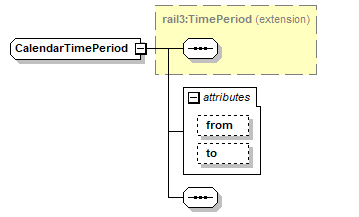 | ||||||||||||||||||
| namespace | https://www.railml.org/schemas/3.1 | ||||||||||||||||||
| type | extension of rail3:TimePeriod | ||||||||||||||||||
| properties |
| ||||||||||||||||||
| used by |
| ||||||||||||||||||
| attributes |
| ||||||||||||||||||
| source | <xs:complexType name="CalendarTimePeriod"> <xs:complexContent> <xs:extension base="rail3:TimePeriod"> <xs:sequence/> <xs:attribute name="from" type="xs:dateTime" use="optional"/> <xs:attribute name="to" type="xs:dateTime" use="optional"/> </xs:extension> </xs:complexContent> </xs:complexType> |
attribute CalendarTimePeriod/@from
| type | xs:dateTime | ||
| properties |
| ||
| source | <xs:attribute name="from" type="xs:dateTime" use="optional"/> |
attribute CalendarTimePeriod/@to
| type | xs:dateTime | ||
| properties |
| ||
| source | <xs:attribute name="to" type="xs:dateTime" use="optional"/> |
complexType CalendarTimePeriodWithBitmask
| diagram | 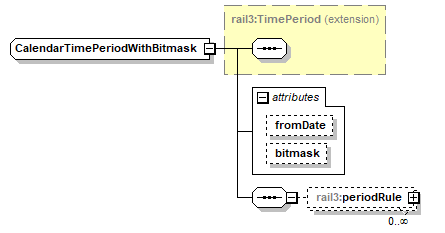 | ||||||||||||||||||
| namespace | https://www.railml.org/schemas/3.1 | ||||||||||||||||||
| type | extension of rail3:TimePeriod | ||||||||||||||||||
| properties |
| ||||||||||||||||||
| children | rail3:periodRule | ||||||||||||||||||
| used by |
| ||||||||||||||||||
| attributes |
| ||||||||||||||||||
| source | <xs:complexType name="CalendarTimePeriodWithBitmask"> <xs:complexContent> <xs:extension base="rail3:TimePeriod"> <xs:sequence> <xs:element name="periodRule" type="rail3:PeriodRule" minOccurs="0" maxOccurs="unbounded"/> </xs:sequence> <xs:attribute name="fromDate" type="xs:date" use="optional"/> <xs:attribute name="bitmask" type="rail3:tBitmaskAny" use="optional"/> </xs:extension> </xs:complexContent> </xs:complexType> |
attribute CalendarTimePeriodWithBitmask/@fromDate
| type | xs:date | ||
| properties |
| ||
| source | <xs:attribute name="fromDate" type="xs:date" use="optional"/> |
attribute CalendarTimePeriodWithBitmask/@bitmask
| type | rail3:tBitmaskAny | ||||||
| properties |
| ||||||
| facets |
| ||||||
| source | <xs:attribute name="bitmask" type="rail3:tBitmaskAny" use="optional"/> |
element CalendarTimePeriodWithBitmask/periodRule
| diagram | 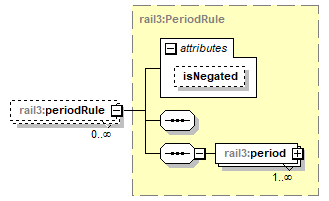 | ||||||||||||
| namespace | https://www.railml.org/schemas/3.1 | ||||||||||||
| type | rail3:PeriodRule | ||||||||||||
| properties |
| ||||||||||||
| children | rail3:period | ||||||||||||
| attributes |
| ||||||||||||
| source | <xs:element name="periodRule" type="rail3:PeriodRule" minOccurs="0" maxOccurs="unbounded"/> |
complexType ClockTimePeriod
| diagram | 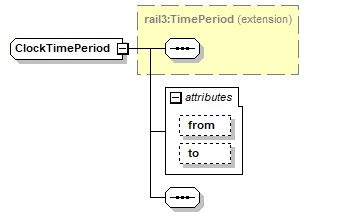 | ||||||||||||||||||
| namespace | https://www.railml.org/schemas/3.1 | ||||||||||||||||||
| type | extension of rail3:TimePeriod | ||||||||||||||||||
| properties |
| ||||||||||||||||||
| used by |
| ||||||||||||||||||
| attributes |
| ||||||||||||||||||
| source | <xs:complexType name="ClockTimePeriod"> <xs:complexContent> <xs:extension base="rail3:TimePeriod"> <xs:sequence/> <xs:attribute name="from" type="xs:time" use="optional"/> <xs:attribute name="to" type="xs:time" use="optional"/> </xs:extension> </xs:complexContent> </xs:complexType> |
attribute ClockTimePeriod/@from
| type | xs:time | ||
| properties |
| ||
| source | <xs:attribute name="from" type="xs:time" use="optional"/> |
attribute ClockTimePeriod/@to
| type | xs:time | ||
| properties |
| ||
| source | <xs:attribute name="to" type="xs:time" use="optional"/> |
complexType Common
| diagram | 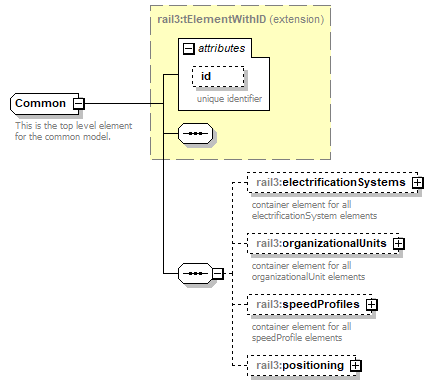 | ||||||||||||||
| namespace | https://www.railml.org/schemas/3.1 | ||||||||||||||
| type | extension of rail3:tElementWithID | ||||||||||||||
| properties |
| ||||||||||||||
| children | rail3:electrificationSystems rail3:organizationalUnits rail3:speedProfiles rail3:positioning | ||||||||||||||
| used by |
| ||||||||||||||
| attributes |
| ||||||||||||||
| annotation |
| ||||||||||||||
| source | <xs:complexType name="Common"> <xs:annotation> <xs:documentation>This is the top level element for the common model.</xs:documentation> </xs:annotation> <xs:complexContent> <xs:extension base="rail3:tElementWithID"> <xs:sequence> <xs:element name="electrificationSystems" type="rail3:ElectrificationSystems" minOccurs="0" maxOccurs="1"> <xs:annotation> <xs:documentation>container element for all electrificationSystem elements</xs:documentation> </xs:annotation> </xs:element> <xs:element name="organizationalUnits" type="rail3:OrganizationalUnits" minOccurs="0" maxOccurs="1"> <xs:annotation> <xs:documentation>container element for all organizationalUnit elements</xs:documentation> </xs:annotation> </xs:element> <xs:element name="speedProfiles" type="rail3:SpeedProfiles" minOccurs="0" maxOccurs="1"> <xs:annotation> <xs:documentation>container element for all speedProfile elements</xs:documentation> </xs:annotation> </xs:element> <xs:element name="positioning" type="rail3:PositioningSystems" minOccurs="0" maxOccurs="1"/> </xs:sequence> </xs:extension> </xs:complexContent> </xs:complexType> |
element Common/electrificationSystems
| diagram |  | ||||||
| namespace | https://www.railml.org/schemas/3.1 | ||||||
| type | rail3:ElectrificationSystems | ||||||
| properties |
| ||||||
| children | rail3:electrificationSystem | ||||||
| annotation |
| ||||||
| source | <xs:element name="electrificationSystems" type="rail3:ElectrificationSystems" minOccurs="0" maxOccurs="1"> <xs:annotation> <xs:documentation>container element for all electrificationSystem elements</xs:documentation> </xs:annotation> </xs:element> |
element Common/organizationalUnits
| diagram | 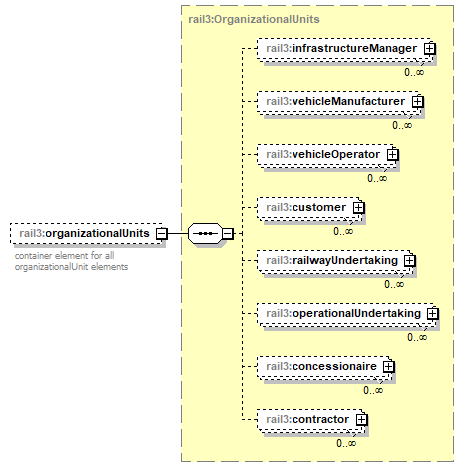 | ||||||
| namespace | https://www.railml.org/schemas/3.1 | ||||||
| type | rail3:OrganizationalUnits | ||||||
| properties |
| ||||||
| children | rail3:infrastructureManager rail3:vehicleManufacturer rail3:vehicleOperator rail3:customer rail3:railwayUndertaking rail3:operationalUndertaking rail3:concessionaire rail3:contractor | ||||||
| annotation |
| ||||||
| source | <xs:element name="organizationalUnits" type="rail3:OrganizationalUnits" minOccurs="0" maxOccurs="1"> <xs:annotation> <xs:documentation>container element for all organizationalUnit elements</xs:documentation> </xs:annotation> </xs:element> |
element Common/speedProfiles
| diagram |  | ||||||
| namespace | https://www.railml.org/schemas/3.1 | ||||||
| type | rail3:SpeedProfiles | ||||||
| properties |
| ||||||
| children | rail3:speedProfile | ||||||
| annotation |
| ||||||
| source | <xs:element name="speedProfiles" type="rail3:SpeedProfiles" minOccurs="0" maxOccurs="1"> <xs:annotation> <xs:documentation>container element for all speedProfile elements</xs:documentation> </xs:annotation> </xs:element> |
element Common/positioning
| diagram | 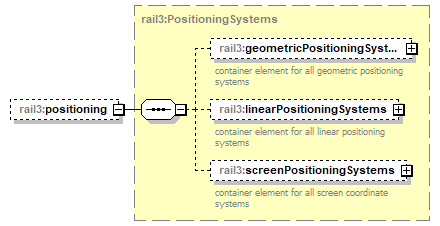 | ||||||
| namespace | https://www.railml.org/schemas/3.1 | ||||||
| type | rail3:PositioningSystems | ||||||
| properties |
| ||||||
| children | rail3:geometricPositioningSystems rail3:linearPositioningSystems rail3:screenPositioningSystems | ||||||
| source | <xs:element name="positioning" type="rail3:PositioningSystems" minOccurs="0" maxOccurs="1"/> |
complexType Concessionaire
| diagram | 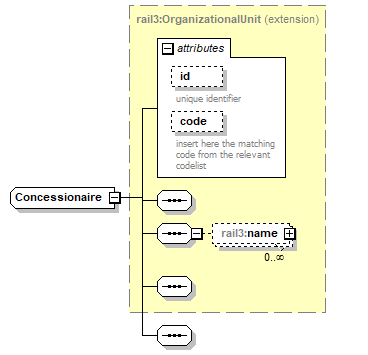 | ||||||||||||||||||||||
| namespace | https://www.railml.org/schemas/3.1 | ||||||||||||||||||||||
| type | extension of rail3:OrganizationalUnit | ||||||||||||||||||||||
| properties |
| ||||||||||||||||||||||
| children | rail3:name | ||||||||||||||||||||||
| used by |
| ||||||||||||||||||||||
| attributes |
| ||||||||||||||||||||||
| source | <xs:complexType name="Concessionaire"> <xs:complexContent> <xs:extension base="rail3:OrganizationalUnit"> <xs:sequence/> </xs:extension> </xs:complexContent> </xs:complexType> |
complexType Contractor
| diagram | 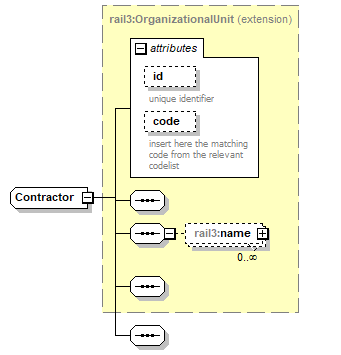 | ||||||||||||||||||||||
| namespace | https://www.railml.org/schemas/3.1 | ||||||||||||||||||||||
| type | extension of rail3:OrganizationalUnit | ||||||||||||||||||||||
| properties |
| ||||||||||||||||||||||
| children | rail3:name | ||||||||||||||||||||||
| used by |
| ||||||||||||||||||||||
| attributes |
| ||||||||||||||||||||||
| source | <xs:complexType name="Contractor"> <xs:complexContent> <xs:extension base="rail3:OrganizationalUnit"> <xs:sequence/> </xs:extension> </xs:complexContent> </xs:complexType> |
complexType Customer
| diagram | 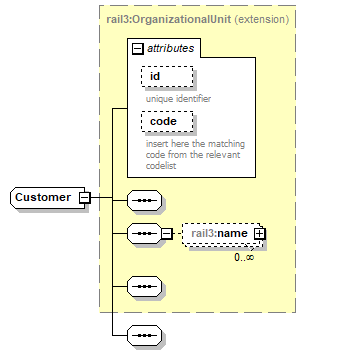 | ||||||||||||||||||||||
| namespace | https://www.railml.org/schemas/3.1 | ||||||||||||||||||||||
| type | extension of rail3:OrganizationalUnit | ||||||||||||||||||||||
| properties |
| ||||||||||||||||||||||
| children | rail3:name | ||||||||||||||||||||||
| used by |
| ||||||||||||||||||||||
| attributes |
| ||||||||||||||||||||||
| source | <xs:complexType name="Customer"> <xs:complexContent> <xs:extension base="rail3:OrganizationalUnit"> <xs:sequence/> </xs:extension> </xs:complexContent> </xs:complexType> |
complexType DateWithBitmask
| diagram | 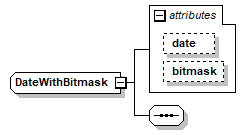 | ||||||||||||||||||
| namespace | https://www.railml.org/schemas/3.1 | ||||||||||||||||||
| used by |
| ||||||||||||||||||
| attributes |
| ||||||||||||||||||
| source | <xs:complexType name="DateWithBitmask"> <xs:sequence/> <xs:attribute name="date" type="xs:date" use="optional"/> <xs:attribute name="bitmask" type="rail3:tBitmaskAny" use="optional"/> </xs:complexType> |
attribute DateWithBitmask/@date
| type | xs:date | ||
| properties |
| ||
| source | <xs:attribute name="date" type="xs:date" use="optional"/> |
attribute DateWithBitmask/@bitmask
| type | rail3:tBitmaskAny | ||||||
| properties |
| ||||||
| facets |
| ||||||
| source | <xs:attribute name="bitmask" type="rail3:tBitmaskAny" use="optional"/> |
complexType Designator
| diagram | 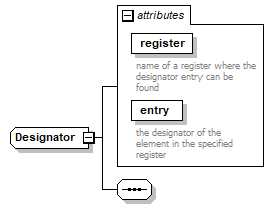 | ||||||||||||||||||||||
| namespace | https://www.railml.org/schemas/3.1 | ||||||||||||||||||||||
| used by |
| ||||||||||||||||||||||
| attributes |
| ||||||||||||||||||||||
| source | <xs:complexType name="Designator"> <xs:sequence/> <xs:attribute name="register" type="xs:string" use="required"> <xs:annotation> <xs:documentation>name of a register where the designator entry can be found</xs:documentation> </xs:annotation> </xs:attribute> <xs:attribute name="entry" type="xs:string" use="required"> <xs:annotation> <xs:documentation>the designator of the element in the specified register</xs:documentation> </xs:annotation> </xs:attribute> </xs:complexType> |
attribute Designator/@register
| type | xs:string | ||
| properties |
| ||
| annotation |
| ||
| source | <xs:attribute name="register" type="xs:string" use="required"> <xs:annotation> <xs:documentation>name of a register where the designator entry can be found</xs:documentation> </xs:annotation> </xs:attribute> |
attribute Designator/@entry
| type | xs:string | ||
| properties |
| ||
| annotation |
| ||
| source | <xs:attribute name="entry" type="xs:string" use="required"> <xs:annotation> <xs:documentation>the designator of the element in the specified register</xs:documentation> </xs:annotation> </xs:attribute> |
complexType ElectrificationSystem
| diagram | 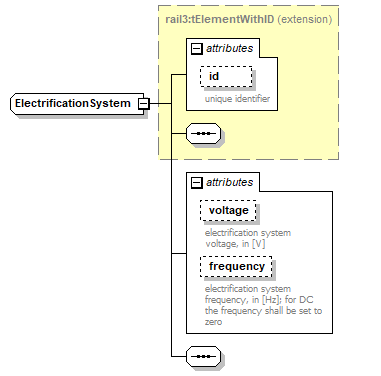 | ||||||||||||||||||||||||||||||
| namespace | https://www.railml.org/schemas/3.1 | ||||||||||||||||||||||||||||||
| type | extension of rail3:tElementWithID | ||||||||||||||||||||||||||||||
| properties |
| ||||||||||||||||||||||||||||||
| used by |
| ||||||||||||||||||||||||||||||
| attributes |
| ||||||||||||||||||||||||||||||
| source | <xs:complexType name="ElectrificationSystem"> <xs:complexContent> <xs:extension base="rail3:tElementWithID"> <xs:sequence/> <xs:attribute name="voltage" type="rail3:tVoltageVolt" use="optional"> <xs:annotation> <xs:documentation>electrification system voltage, in [V]</xs:documentation> </xs:annotation> </xs:attribute> <xs:attribute name="frequency" type="rail3:tFrequencyHertz" use="optional"> <xs:annotation> <xs:documentation>electrification system frequency, in [Hz]; for DC the frequency shall be set to zero</xs:documentation> </xs:annotation> </xs:attribute> </xs:extension> </xs:complexContent> </xs:complexType> |
attribute ElectrificationSystem/@voltage
| type | rail3:tVoltageVolt | ||||||
| properties |
| ||||||
| facets |
| ||||||
| annotation |
| ||||||
| source | <xs:attribute name="voltage" type="rail3:tVoltageVolt" use="optional"> <xs:annotation> <xs:documentation>electrification system voltage, in [V]</xs:documentation> </xs:annotation> </xs:attribute> |
attribute ElectrificationSystem/@frequency
| type | rail3:tFrequencyHertz | |||||||||
| properties |
| |||||||||
| facets |
| |||||||||
| annotation |
| |||||||||
| source | <xs:attribute name="frequency" type="rail3:tFrequencyHertz" use="optional"> <xs:annotation> <xs:documentation>electrification system frequency, in [Hz]; for DC the frequency shall be set to zero</xs:documentation> </xs:annotation> </xs:attribute> |
complexType ElectrificationSystems
| diagram |  | ||
| namespace | https://www.railml.org/schemas/3.1 | ||
| children | rail3:electrificationSystem | ||
| used by |
| ||
| source | <xs:complexType name="ElectrificationSystems"> <xs:sequence> <xs:element name="electrificationSystem" type="rail3:ElectrificationSystem" minOccurs="1" maxOccurs="unbounded"/> </xs:sequence> </xs:complexType> |
element ElectrificationSystems/electrificationSystem
| diagram | 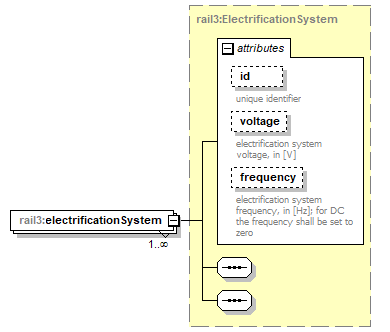 | ||||||||||||||||||||||||||||||
| namespace | https://www.railml.org/schemas/3.1 | ||||||||||||||||||||||||||||||
| type | rail3:ElectrificationSystem | ||||||||||||||||||||||||||||||
| properties |
| ||||||||||||||||||||||||||||||
| attributes |
| ||||||||||||||||||||||||||||||
| source | <xs:element name="electrificationSystem" type="rail3:ElectrificationSystem" minOccurs="1" maxOccurs="unbounded"/> |
complexType ElemBasedPeriodRule
| diagram | 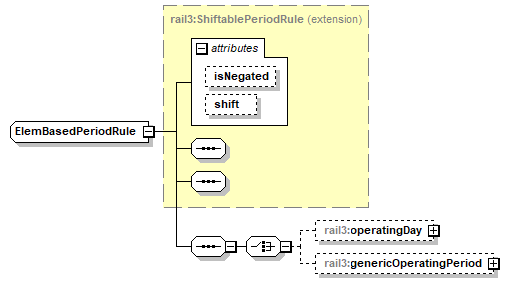 | ||||||||||||||||||
| namespace | https://www.railml.org/schemas/3.1 | ||||||||||||||||||
| type | extension of rail3:ShiftablePeriodRule | ||||||||||||||||||
| properties |
| ||||||||||||||||||
| children | rail3:operatingDay rail3:genericOperatingPeriod | ||||||||||||||||||
| used by |
| ||||||||||||||||||
| attributes |
| ||||||||||||||||||
| source | <xs:complexType name="ElemBasedPeriodRule"> <xs:complexContent> <xs:extension base="rail3:ShiftablePeriodRule"> <xs:sequence> <xs:choice minOccurs="1" maxOccurs="1"> <xs:element name="operatingDay" type="rail3:OperatingDay" minOccurs="0" maxOccurs="1"/> <xs:element name="genericOperatingPeriod" type="rail3:GenericOperatingPeriodDescription" minOccurs="0" maxOccurs="1"/> </xs:choice> </xs:sequence> </xs:extension> </xs:complexContent> </xs:complexType> |
element ElemBasedPeriodRule/operatingDay
| diagram | 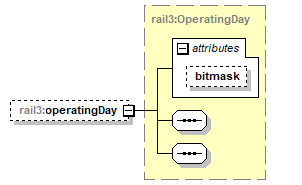 | ||||||||||||
| namespace | https://www.railml.org/schemas/3.1 | ||||||||||||
| type | rail3:OperatingDay | ||||||||||||
| properties |
| ||||||||||||
| attributes |
| ||||||||||||
| source | <xs:element name="operatingDay" type="rail3:OperatingDay" minOccurs="0" maxOccurs="1"/> |
element ElemBasedPeriodRule/genericOperatingPeriod
| diagram | 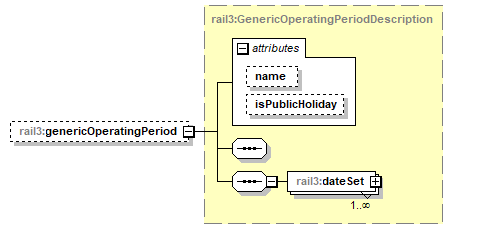 | ||||||||||||||||||
| namespace | https://www.railml.org/schemas/3.1 | ||||||||||||||||||
| type | rail3:GenericOperatingPeriodDescription | ||||||||||||||||||
| properties |
| ||||||||||||||||||
| children | rail3:dateSet | ||||||||||||||||||
| attributes |
| ||||||||||||||||||
| source | <xs:element name="genericOperatingPeriod" type="rail3:GenericOperatingPeriodDescription" minOccurs="0" maxOccurs="1"/> |
complexType External
| diagram | 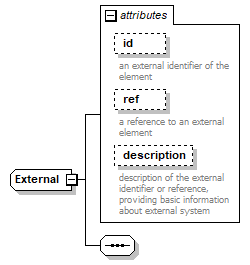 | ||||||||||||||||||||||||||||||
| namespace | https://www.railml.org/schemas/3.1 | ||||||||||||||||||||||||||||||
| used by |
| ||||||||||||||||||||||||||||||
| attributes |
| ||||||||||||||||||||||||||||||
| source | <xs:complexType name="External"> <xs:sequence/> <xs:attribute name="id" type="xs:string" use="optional"> <xs:annotation> <xs:documentation>an external identifier of the element</xs:documentation> </xs:annotation> </xs:attribute> <xs:attribute name="ref" type="xs:string" use="optional"> <xs:annotation> <xs:documentation>a reference to an external element</xs:documentation> </xs:annotation> </xs:attribute> <xs:attribute name="description" type="xs:string" use="optional"> <xs:annotation> <xs:documentation>description of the external identifier or reference, providing basic information about external system</xs:documentation> </xs:annotation> </xs:attribute> </xs:complexType> |
attribute External/@id
| type | xs:string | ||
| properties |
| ||
| annotation |
| ||
| source | <xs:attribute name="id" type="xs:string" use="optional"> <xs:annotation> <xs:documentation>an external identifier of the element</xs:documentation> </xs:annotation> </xs:attribute> |
attribute External/@ref
| type | xs:string | ||
| properties |
| ||
| annotation |
| ||
| source | <xs:attribute name="ref" type="xs:string" use="optional"> <xs:annotation> <xs:documentation>a reference to an external element</xs:documentation> </xs:annotation> </xs:attribute> |
attribute External/@description
| type | xs:string | ||
| properties |
| ||
| annotation |
| ||
| source | <xs:attribute name="description" type="xs:string" use="optional"> <xs:annotation> <xs:documentation>description of the external identifier or reference, providing basic information about external system</xs:documentation> </xs:annotation> </xs:attribute> |
complexType GenericOperatingPeriodDescription
| diagram | 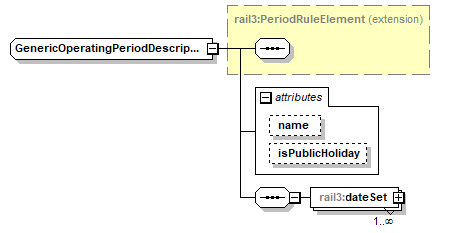 | ||||||||||||||||||
| namespace | https://www.railml.org/schemas/3.1 | ||||||||||||||||||
| type | extension of rail3:PeriodRuleElement | ||||||||||||||||||
| properties |
| ||||||||||||||||||
| children | rail3:dateSet | ||||||||||||||||||
| used by |
| ||||||||||||||||||
| attributes |
| ||||||||||||||||||
| source | <xs:complexType name="GenericOperatingPeriodDescription"> <xs:complexContent> <xs:extension base="rail3:PeriodRuleElement"> <xs:sequence> <xs:element name="dateSet" type="rail3:DateWithBitmask" minOccurs="1" maxOccurs="unbounded"/> </xs:sequence> <xs:attribute name="name" type="xs:string" use="optional"/> <xs:attribute name="isPublicHoliday" type="xs:boolean" use="optional"/> </xs:extension> </xs:complexContent> </xs:complexType> |
attribute GenericOperatingPeriodDescription/@name
| type | xs:string | ||
| properties |
| ||
| source | <xs:attribute name="name" type="xs:string" use="optional"/> |
attribute GenericOperatingPeriodDescription/@isPublicHoliday
| type | xs:boolean | ||
| properties |
| ||
| source | <xs:attribute name="isPublicHoliday" type="xs:boolean" use="optional"/> |
element GenericOperatingPeriodDescription/dateSet
| diagram | 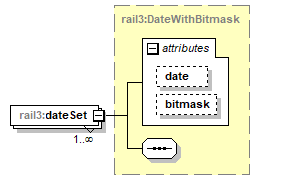 | ||||||||||||||||||
| namespace | https://www.railml.org/schemas/3.1 | ||||||||||||||||||
| type | rail3:DateWithBitmask | ||||||||||||||||||
| properties |
| ||||||||||||||||||
| attributes |
| ||||||||||||||||||
| source | <xs:element name="dateSet" type="rail3:DateWithBitmask" minOccurs="1" maxOccurs="unbounded"/> |
complexType GenericTimePeriod
| diagram |  | ||
| namespace | https://www.railml.org/schemas/3.1 | ||
| type | extension of rail3:TimePeriod | ||
| properties |
| ||
| children | rail3:containedSituation | ||
| used by |
| ||
| source | <xs:complexType name="GenericTimePeriod"> <xs:complexContent> <xs:extension base="rail3:TimePeriod"> <xs:sequence> <xs:element name="containedSituation" type="rail3:TimePeriodRuleSituation" minOccurs="1" maxOccurs="unbounded"/> </xs:sequence> </xs:extension> </xs:complexContent> </xs:complexType> |
element GenericTimePeriod/containedSituation
| diagram | 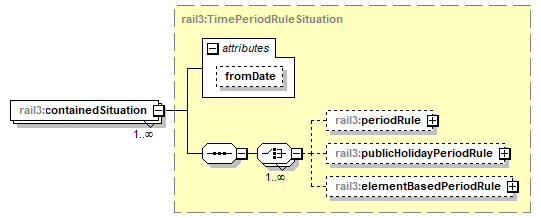 | ||||||||||||
| namespace | https://www.railml.org/schemas/3.1 | ||||||||||||
| type | rail3:TimePeriodRuleSituation | ||||||||||||
| properties |
| ||||||||||||
| children | rail3:periodRule rail3:publicHolidayPeriodRule rail3:elementBasedPeriodRule | ||||||||||||
| attributes |
| ||||||||||||
| source | <xs:element name="containedSituation" type="rail3:TimePeriodRuleSituation" minOccurs="1" maxOccurs="unbounded"/> |
complexType GeometricPositioningSystems
| diagram |  | ||
| namespace | https://www.railml.org/schemas/3.1 | ||
| children | rail3:geometricPositioningSystem | ||
| used by |
| ||
| source | <xs:complexType name="GeometricPositioningSystems"> <xs:sequence> <xs:element name="geometricPositioningSystem" type="rail3:RTM_GeometricPositioningSystem" minOccurs="1" maxOccurs="unbounded"/> </xs:sequence> </xs:complexType> |
element GeometricPositioningSystems/geometricPositioningSystem
| diagram | 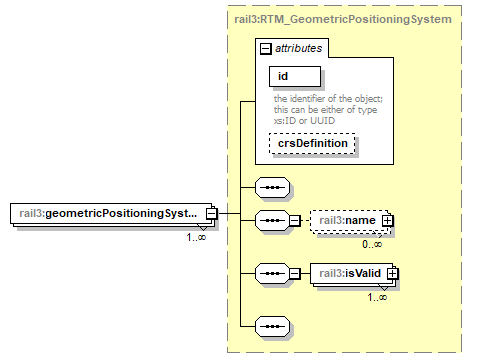 | ||||||||||||||||||||
| namespace | https://www.railml.org/schemas/3.1 | ||||||||||||||||||||
| type | rail3:RTM_GeometricPositioningSystem | ||||||||||||||||||||
| properties |
| ||||||||||||||||||||
| children | rail3:name rail3:isValid | ||||||||||||||||||||
| attributes |
| ||||||||||||||||||||
| source | <xs:element name="geometricPositioningSystem" type="rail3:RTM_GeometricPositioningSystem" minOccurs="1" maxOccurs="unbounded"/> |
complexType InfrastructureManager
| diagram | 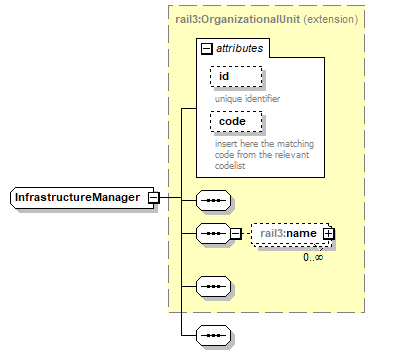 | ||||||||||||||||||||||
| namespace | https://www.railml.org/schemas/3.1 | ||||||||||||||||||||||
| type | extension of rail3:OrganizationalUnit | ||||||||||||||||||||||
| properties |
| ||||||||||||||||||||||
| children | rail3:name | ||||||||||||||||||||||
| used by |
| ||||||||||||||||||||||
| attributes |
| ||||||||||||||||||||||
| source | <xs:complexType name="InfrastructureManager"> <xs:complexContent> <xs:extension base="rail3:OrganizationalUnit"> <xs:sequence/> </xs:extension> </xs:complexContent> </xs:complexType> |
complexType LinearPositioningSystems
| diagram |  | ||
| namespace | https://www.railml.org/schemas/3.1 | ||
| children | rail3:linearPositioningSystem | ||
| used by |
| ||
| source | <xs:complexType name="LinearPositioningSystems"> <xs:sequence> <xs:element name="linearPositioningSystem" type="rail3:RTM_LinearPositioningSystem" minOccurs="1" maxOccurs="unbounded"/> </xs:sequence> </xs:complexType> |
element LinearPositioningSystems/linearPositioningSystem
| diagram | 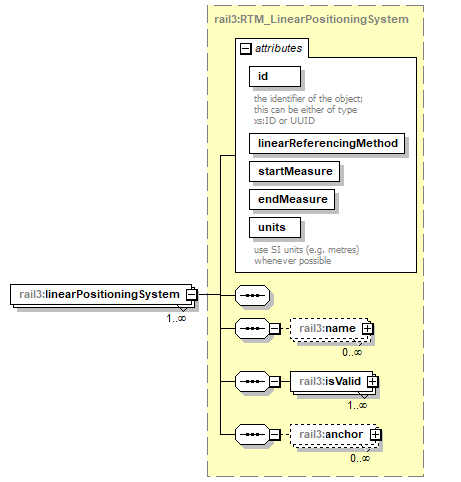 | ||||||||||||||||||||||||||||||||||||||||
| namespace | https://www.railml.org/schemas/3.1 | ||||||||||||||||||||||||||||||||||||||||
| type | rail3:RTM_LinearPositioningSystem | ||||||||||||||||||||||||||||||||||||||||
| properties |
| ||||||||||||||||||||||||||||||||||||||||
| children | rail3:name rail3:isValid rail3:anchor | ||||||||||||||||||||||||||||||||||||||||
| attributes |
| ||||||||||||||||||||||||||||||||||||||||
| source | <xs:element name="linearPositioningSystem" type="rail3:RTM_LinearPositioningSystem" minOccurs="1" maxOccurs="unbounded"/> |
complexType Metadata
| diagram | 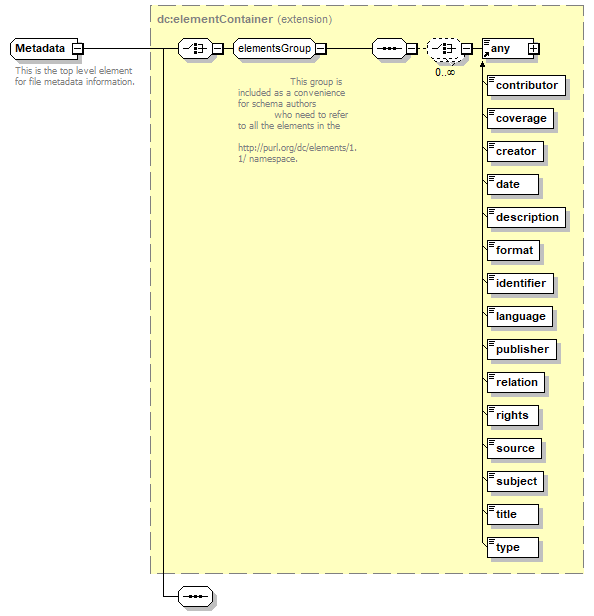 | ||
| namespace | https://www.railml.org/schemas/3.1 | ||
| type | extension of elementContainer | ||
| properties |
| ||
| children | any | ||
| used by |
| ||
| annotation |
| ||
| source | <xs:complexType name="Metadata"> <xs:annotation> <xs:documentation>This is the top level element for file metadata information.</xs:documentation> </xs:annotation> <xs:complexContent> <xs:extension base="dc:elementContainer"> <xs:sequence/> </xs:extension> </xs:complexContent> </xs:complexType> |
complexType Name
| diagram | 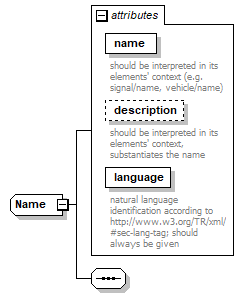 | ||||||||||||||||||||||||||||||
| namespace | https://www.railml.org/schemas/3.1 | ||||||||||||||||||||||||||||||
| used by |
| ||||||||||||||||||||||||||||||
| attributes |
| ||||||||||||||||||||||||||||||
| source | <xs:complexType name="Name"> <xs:sequence/> <xs:attribute name="name" type="xs:string" use="required"> <xs:annotation> <xs:documentation>should be interpreted in its elements' context (e.g. signal/name, vehicle/name)</xs:documentation> </xs:annotation> </xs:attribute> <xs:attribute name="description" type="xs:string" use="optional"> <xs:annotation> <xs:documentation>should be interpreted in its elements' context, substantiates the name</xs:documentation> </xs:annotation> </xs:attribute> <xs:attribute name="language" type="xs:language" use="required"> <xs:annotation> <xs:documentation>natural language identification according to http://www.w3.org/TR/xml/#sec-lang-tag; should always be given</xs:documentation> </xs:annotation> </xs:attribute> </xs:complexType> |
attribute Name/@name
| type | xs:string | ||
| properties |
| ||
| annotation |
| ||
| source | <xs:attribute name="name" type="xs:string" use="required"> <xs:annotation> <xs:documentation>should be interpreted in its elements' context (e.g. signal/name, vehicle/name)</xs:documentation> </xs:annotation> </xs:attribute> |
attribute Name/@description
| type | xs:string | ||
| properties |
| ||
| annotation |
| ||
| source | <xs:attribute name="description" type="xs:string" use="optional"> <xs:annotation> <xs:documentation>should be interpreted in its elements' context, substantiates the name</xs:documentation> </xs:annotation> </xs:attribute> |
attribute Name/@language
| type | xs:language | ||
| properties |
| ||
| annotation |
| ||
| source | <xs:attribute name="language" type="xs:language" use="required"> <xs:annotation> <xs:documentation>natural language identification according to http://www.w3.org/TR/xml/#sec-lang-tag; should always be given</xs:documentation> </xs:annotation> </xs:attribute> |
complexType OperatingDay
| diagram | 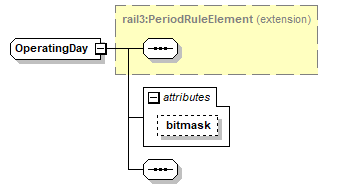 | ||||||||||||
| namespace | https://www.railml.org/schemas/3.1 | ||||||||||||
| type | extension of rail3:PeriodRuleElement | ||||||||||||
| properties |
| ||||||||||||
| used by |
| ||||||||||||
| attributes |
| ||||||||||||
| source | <xs:complexType name="OperatingDay"> <xs:complexContent> <xs:extension base="rail3:PeriodRuleElement"> <xs:sequence/> <xs:attribute name="bitmask" type="rail3:tBitmaskWeek" use="optional"/> </xs:extension> </xs:complexContent> </xs:complexType> |
attribute OperatingDay/@bitmask
| type | rail3:tBitmaskWeek | |||||||||
| properties |
| |||||||||
| facets |
| |||||||||
| source | <xs:attribute name="bitmask" type="rail3:tBitmaskWeek" use="optional"/> |
complexType OperationalUndertaking
| diagram | 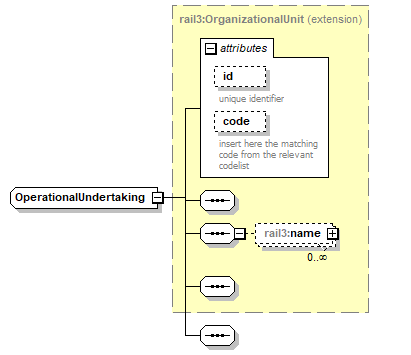 | ||||||||||||||||||||||
| namespace | https://www.railml.org/schemas/3.1 | ||||||||||||||||||||||
| type | extension of rail3:OrganizationalUnit | ||||||||||||||||||||||
| properties |
| ||||||||||||||||||||||
| children | rail3:name | ||||||||||||||||||||||
| used by |
| ||||||||||||||||||||||
| attributes |
| ||||||||||||||||||||||
| source | <xs:complexType name="OperationalUndertaking"> <xs:complexContent> <xs:extension base="rail3:OrganizationalUnit"> <xs:sequence/> </xs:extension> </xs:complexContent> </xs:complexType> |
complexType OrganizationalUnit
| diagram | 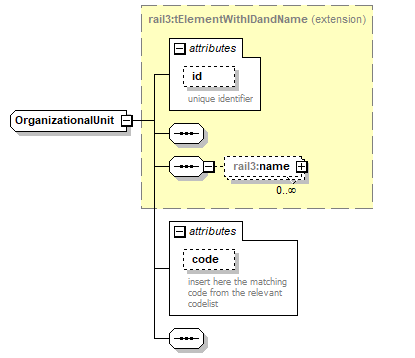 | ||||||||||||||||||||||
| namespace | https://www.railml.org/schemas/3.1 | ||||||||||||||||||||||
| type | extension of rail3:tElementWithIDandName | ||||||||||||||||||||||
| properties |
| ||||||||||||||||||||||
| children | rail3:name | ||||||||||||||||||||||
| used by |
| ||||||||||||||||||||||
| attributes |
| ||||||||||||||||||||||
| source | <xs:complexType name="OrganizationalUnit" abstract="true"> <xs:complexContent> <xs:extension base="rail3:tElementWithIDandName"> <xs:sequence/> <xs:attribute name="code" type="xs:string" use="optional"> <xs:annotation> <xs:documentation>insert here the matching code from the relevant codelist</xs:documentation> </xs:annotation> </xs:attribute> </xs:extension> </xs:complexContent> </xs:complexType> |
attribute OrganizationalUnit/@code
| type | xs:string | ||
| properties |
| ||
| annotation |
| ||
| source | <xs:attribute name="code" type="xs:string" use="optional"> <xs:annotation> <xs:documentation>insert here the matching code from the relevant codelist</xs:documentation> </xs:annotation> </xs:attribute> |
complexType OrganizationalUnits
| diagram | 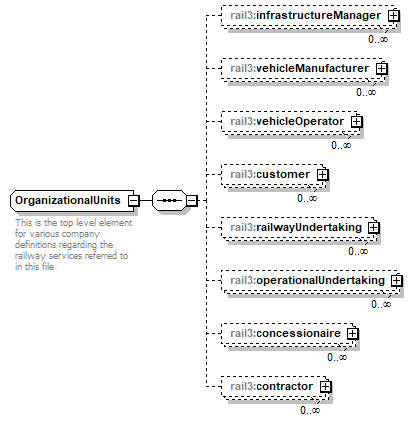 | ||
| namespace | https://www.railml.org/schemas/3.1 | ||
| children | rail3:infrastructureManager rail3:vehicleManufacturer rail3:vehicleOperator rail3:customer rail3:railwayUndertaking rail3:operationalUndertaking rail3:concessionaire rail3:contractor | ||
| used by |
| ||
| annotation |
| ||
| source | <xs:complexType name="OrganizationalUnits"> <xs:annotation> <xs:documentation>This is the top level element for various company definitions regarding the railway services referred to in this file</xs:documentation> </xs:annotation> <xs:sequence> <xs:element name="infrastructureManager" type="rail3:InfrastructureManager" minOccurs="0" maxOccurs="unbounded"/> <xs:element name="vehicleManufacturer" type="rail3:VehicleManufacturer" minOccurs="0" maxOccurs="unbounded"/> <xs:element name="vehicleOperator" type="rail3:VehicleOperator" minOccurs="0" maxOccurs="unbounded"/> <xs:element name="customer" type="rail3:Customer" minOccurs="0" maxOccurs="unbounded"/> <xs:element name="railwayUndertaking" type="rail3:RailwayUndertaking" minOccurs="0" maxOccurs="unbounded"/> <xs:element name="operationalUndertaking" type="rail3:OperationalUndertaking" minOccurs="0" maxOccurs="unbounded"/> <xs:element name="concessionaire" type="rail3:Concessionaire" minOccurs="0" maxOccurs="unbounded"/> <xs:element name="contractor" type="rail3:Contractor" minOccurs="0" maxOccurs="unbounded"/> </xs:sequence> </xs:complexType> |
element OrganizationalUnits/infrastructureManager
| diagram | 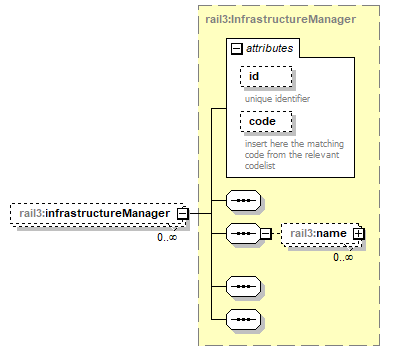 | ||||||||||||||||||||||
| namespace | https://www.railml.org/schemas/3.1 | ||||||||||||||||||||||
| type | rail3:InfrastructureManager | ||||||||||||||||||||||
| properties |
| ||||||||||||||||||||||
| children | rail3:name | ||||||||||||||||||||||
| attributes |
| ||||||||||||||||||||||
| source | <xs:element name="infrastructureManager" type="rail3:InfrastructureManager" minOccurs="0" maxOccurs="unbounded"/> |
element OrganizationalUnits/vehicleManufacturer
| diagram | 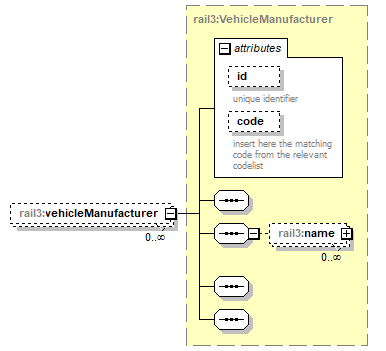 | ||||||||||||||||||||||
| namespace | https://www.railml.org/schemas/3.1 | ||||||||||||||||||||||
| type | rail3:VehicleManufacturer | ||||||||||||||||||||||
| properties |
| ||||||||||||||||||||||
| children | rail3:name | ||||||||||||||||||||||
| attributes |
| ||||||||||||||||||||||
| source | <xs:element name="vehicleManufacturer" type="rail3:VehicleManufacturer" minOccurs="0" maxOccurs="unbounded"/> |
element OrganizationalUnits/vehicleOperator
| diagram | 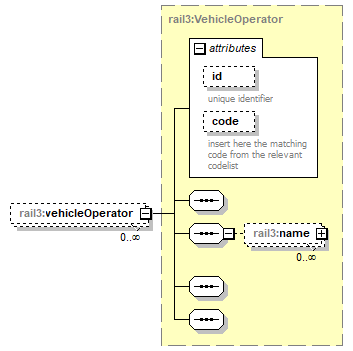 | ||||||||||||||||||||||
| namespace | https://www.railml.org/schemas/3.1 | ||||||||||||||||||||||
| type | rail3:VehicleOperator | ||||||||||||||||||||||
| properties |
| ||||||||||||||||||||||
| children | rail3:name | ||||||||||||||||||||||
| attributes |
| ||||||||||||||||||||||
| source | <xs:element name="vehicleOperator" type="rail3:VehicleOperator" minOccurs="0" maxOccurs="unbounded"/> |
element OrganizationalUnits/customer
| diagram | 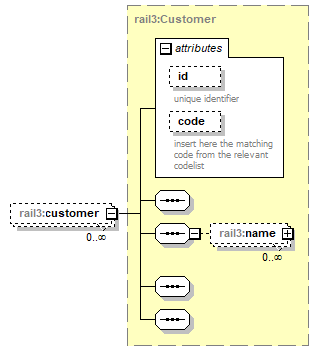 | ||||||||||||||||||||||
| namespace | https://www.railml.org/schemas/3.1 | ||||||||||||||||||||||
| type | rail3:Customer | ||||||||||||||||||||||
| properties |
| ||||||||||||||||||||||
| children | rail3:name | ||||||||||||||||||||||
| attributes |
| ||||||||||||||||||||||
| source | <xs:element name="customer" type="rail3:Customer" minOccurs="0" maxOccurs="unbounded"/> |
element OrganizationalUnits/railwayUndertaking
| diagram | 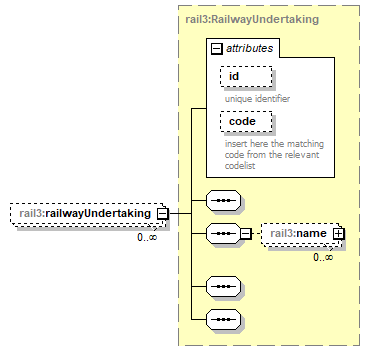 | ||||||||||||||||||||||
| namespace | https://www.railml.org/schemas/3.1 | ||||||||||||||||||||||
| type | rail3:RailwayUndertaking | ||||||||||||||||||||||
| properties |
| ||||||||||||||||||||||
| children | rail3:name | ||||||||||||||||||||||
| attributes |
| ||||||||||||||||||||||
| source | <xs:element name="railwayUndertaking" type="rail3:RailwayUndertaking" minOccurs="0" maxOccurs="unbounded"/> |
element OrganizationalUnits/operationalUndertaking
| diagram | 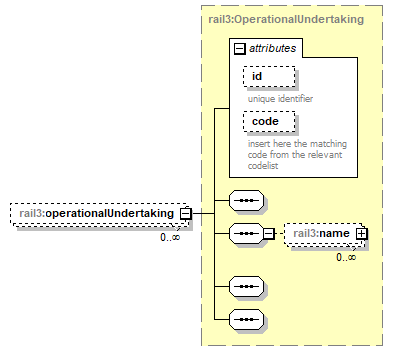 | ||||||||||||||||||||||
| namespace | https://www.railml.org/schemas/3.1 | ||||||||||||||||||||||
| type | rail3:OperationalUndertaking | ||||||||||||||||||||||
| properties |
| ||||||||||||||||||||||
| children | rail3:name | ||||||||||||||||||||||
| attributes |
| ||||||||||||||||||||||
| source | <xs:element name="operationalUndertaking" type="rail3:OperationalUndertaking" minOccurs="0" maxOccurs="unbounded"/> |
element OrganizationalUnits/concessionaire
| diagram | 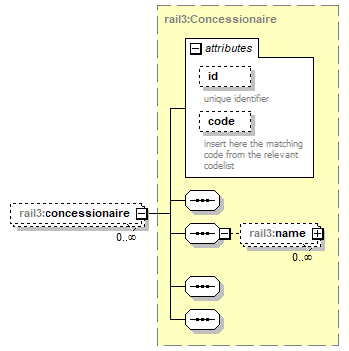 | ||||||||||||||||||||||
| namespace | https://www.railml.org/schemas/3.1 | ||||||||||||||||||||||
| type | rail3:Concessionaire | ||||||||||||||||||||||
| properties |
| ||||||||||||||||||||||
| children | rail3:name | ||||||||||||||||||||||
| attributes |
| ||||||||||||||||||||||
| source | <xs:element name="concessionaire" type="rail3:Concessionaire" minOccurs="0" maxOccurs="unbounded"/> |
element OrganizationalUnits/contractor
| diagram | 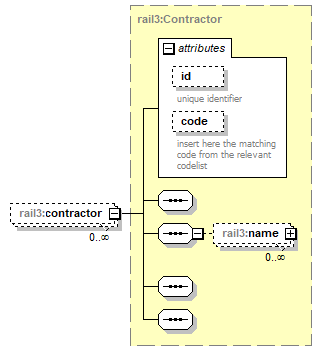 | ||||||||||||||||||||||
| namespace | https://www.railml.org/schemas/3.1 | ||||||||||||||||||||||
| type | rail3:Contractor | ||||||||||||||||||||||
| properties |
| ||||||||||||||||||||||
| children | rail3:name | ||||||||||||||||||||||
| attributes |
| ||||||||||||||||||||||
| source | <xs:element name="contractor" type="rail3:Contractor" minOccurs="0" maxOccurs="unbounded"/> |
complexType Period
| diagram |  | ||
| namespace | https://www.railml.org/schemas/3.1 | ||
| children | rail3:period rail3:periodBitmask rail3:periodGeneric | ||
| used by |
| ||
| source | <xs:complexType name="Period"> <xs:sequence> <xs:choice minOccurs="1" maxOccurs="1"> <xs:element name="period" type="rail3:CalendarTimePeriod" minOccurs="0" maxOccurs="1"/> <xs:element name="periodBitmask" type="rail3:CalendarTimePeriodWithBitmask" minOccurs="0" maxOccurs="1"/> <xs:element name="periodGeneric" type="rail3:GenericTimePeriod" minOccurs="0" maxOccurs="1"/> </xs:choice> </xs:sequence> </xs:complexType> |
element Period/period
| diagram | 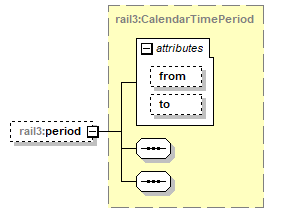 | ||||||||||||||||||
| namespace | https://www.railml.org/schemas/3.1 | ||||||||||||||||||
| type | rail3:CalendarTimePeriod | ||||||||||||||||||
| properties |
| ||||||||||||||||||
| attributes |
| ||||||||||||||||||
| source | <xs:element name="period" type="rail3:CalendarTimePeriod" minOccurs="0" maxOccurs="1"/> |
element Period/periodBitmask
| diagram | 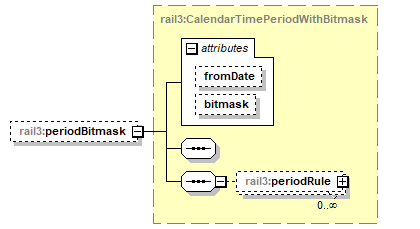 | ||||||||||||||||||
| namespace | https://www.railml.org/schemas/3.1 | ||||||||||||||||||
| type | rail3:CalendarTimePeriodWithBitmask | ||||||||||||||||||
| properties |
| ||||||||||||||||||
| children | rail3:periodRule | ||||||||||||||||||
| attributes |
| ||||||||||||||||||
| source | <xs:element name="periodBitmask" type="rail3:CalendarTimePeriodWithBitmask" minOccurs="0" maxOccurs="1"/> |
element Period/periodGeneric
| diagram |  | ||||||
| namespace | https://www.railml.org/schemas/3.1 | ||||||
| type | rail3:GenericTimePeriod | ||||||
| properties |
| ||||||
| children | rail3:containedSituation | ||||||
| source | <xs:element name="periodGeneric" type="rail3:GenericTimePeriod" minOccurs="0" maxOccurs="1"/> |
complexType PeriodRule
| diagram | 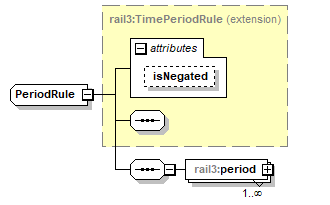 | ||||||||||||
| namespace | https://www.railml.org/schemas/3.1 | ||||||||||||
| type | extension of rail3:TimePeriodRule | ||||||||||||
| properties |
| ||||||||||||
| children | rail3:period | ||||||||||||
| used by |
| ||||||||||||
| attributes |
| ||||||||||||
| source | <xs:complexType name="PeriodRule"> <xs:complexContent> <xs:extension base="rail3:TimePeriodRule"> <xs:sequence> <xs:element name="period" type="rail3:ClockTimePeriod" minOccurs="1" maxOccurs="unbounded"/> </xs:sequence> </xs:extension> </xs:complexContent> </xs:complexType> |
element PeriodRule/period
| diagram | 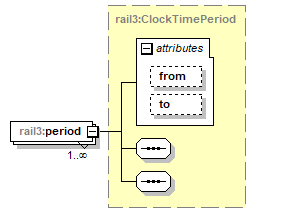 | ||||||||||||||||||
| namespace | https://www.railml.org/schemas/3.1 | ||||||||||||||||||
| type | rail3:ClockTimePeriod | ||||||||||||||||||
| properties |
| ||||||||||||||||||
| attributes |
| ||||||||||||||||||
| source | <xs:element name="period" type="rail3:ClockTimePeriod" minOccurs="1" maxOccurs="unbounded"/> |
complexType PeriodRuleElement
| diagram |  | ||
| namespace | https://www.railml.org/schemas/3.1 | ||
| properties |
| ||
| used by |
| ||
| source | <xs:complexType name="PeriodRuleElement" abstract="true"> <xs:sequence/> </xs:complexType> |
complexType PositioningSystems
| diagram | 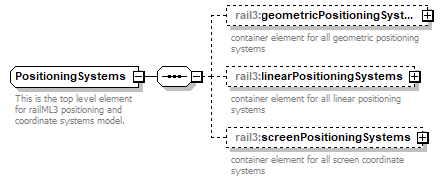 | ||
| namespace | https://www.railml.org/schemas/3.1 | ||
| children | rail3:geometricPositioningSystems rail3:linearPositioningSystems rail3:screenPositioningSystems | ||
| used by |
| ||
| annotation |
| ||
| source | <xs:complexType name="PositioningSystems"> <xs:annotation> <xs:documentation>This is the top level element for railML3 positioning and coordinate systems model.</xs:documentation> </xs:annotation> <xs:sequence> <xs:element name="geometricPositioningSystems" type="rail3:GeometricPositioningSystems" minOccurs="0" maxOccurs="1"> <xs:annotation> <xs:documentation>container element for all geometric positioning systems</xs:documentation> </xs:annotation> </xs:element> <xs:element name="linearPositioningSystems" type="rail3:LinearPositioningSystems" minOccurs="0" maxOccurs="1"> <xs:annotation> <xs:documentation>container element for all linear positioning systems</xs:documentation> </xs:annotation> </xs:element> <xs:element name="screenPositioningSystems" type="rail3:ScreenPositioningSystems" minOccurs="0" maxOccurs="1"> <xs:annotation> <xs:documentation>container element for all screen coordinate systems</xs:documentation> </xs:annotation> </xs:element> </xs:sequence> </xs:complexType> |
element PositioningSystems/geometricPositioningSystems
| diagram |  | ||||||
| namespace | https://www.railml.org/schemas/3.1 | ||||||
| type | rail3:GeometricPositioningSystems | ||||||
| properties |
| ||||||
| children | rail3:geometricPositioningSystem | ||||||
| annotation |
| ||||||
| source | <xs:element name="geometricPositioningSystems" type="rail3:GeometricPositioningSystems" minOccurs="0" maxOccurs="1"> <xs:annotation> <xs:documentation>container element for all geometric positioning systems</xs:documentation> </xs:annotation> </xs:element> |
element PositioningSystems/linearPositioningSystems
| diagram |  | ||||||
| namespace | https://www.railml.org/schemas/3.1 | ||||||
| type | rail3:LinearPositioningSystems | ||||||
| properties |
| ||||||
| children | rail3:linearPositioningSystem | ||||||
| annotation |
| ||||||
| source | <xs:element name="linearPositioningSystems" type="rail3:LinearPositioningSystems" minOccurs="0" maxOccurs="1"> <xs:annotation> <xs:documentation>container element for all linear positioning systems</xs:documentation> </xs:annotation> </xs:element> |
element PositioningSystems/screenPositioningSystems
| diagram |  | ||||||
| namespace | https://www.railml.org/schemas/3.1 | ||||||
| type | rail3:ScreenPositioningSystems | ||||||
| properties |
| ||||||
| children | rail3:screenPositioningSystem | ||||||
| annotation |
| ||||||
| source | <xs:element name="screenPositioningSystems" type="rail3:ScreenPositioningSystems" minOccurs="0" maxOccurs="1"> <xs:annotation> <xs:documentation>container element for all screen coordinate systems</xs:documentation> </xs:annotation> </xs:element> |
complexType PublicHolidayPeriodRule
| diagram | 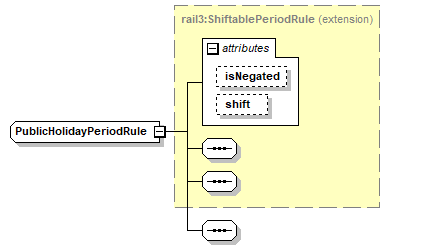 | ||||||||||||||||||
| namespace | https://www.railml.org/schemas/3.1 | ||||||||||||||||||
| type | extension of rail3:ShiftablePeriodRule | ||||||||||||||||||
| properties |
| ||||||||||||||||||
| used by |
| ||||||||||||||||||
| attributes |
| ||||||||||||||||||
| source | <xs:complexType name="PublicHolidayPeriodRule"> <xs:complexContent> <xs:extension base="rail3:ShiftablePeriodRule"> <xs:sequence/> </xs:extension> </xs:complexContent> </xs:complexType> |
complexType RailwayUndertaking
| diagram | 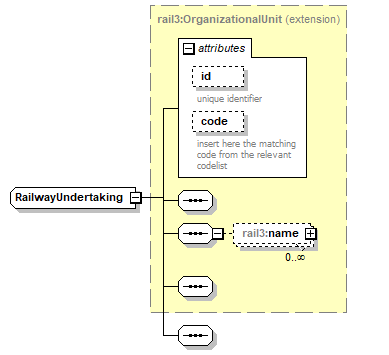 | ||||||||||||||||||||||
| namespace | https://www.railml.org/schemas/3.1 | ||||||||||||||||||||||
| type | extension of rail3:OrganizationalUnit | ||||||||||||||||||||||
| properties |
| ||||||||||||||||||||||
| children | rail3:name | ||||||||||||||||||||||
| used by |
| ||||||||||||||||||||||
| attributes |
| ||||||||||||||||||||||
| source | <xs:complexType name="RailwayUndertaking"> <xs:complexContent> <xs:extension base="rail3:OrganizationalUnit"> <xs:sequence/> </xs:extension> </xs:complexContent> </xs:complexType> |
complexType ScreenPositioningSystem
| diagram | 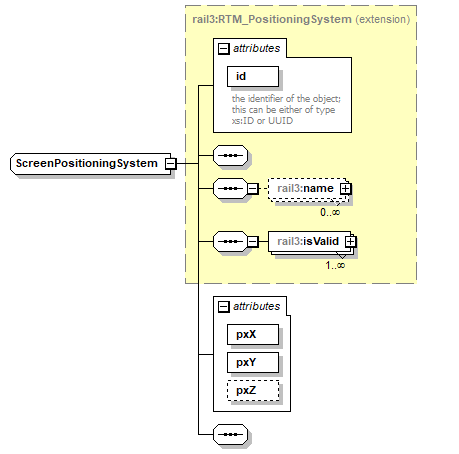 | ||||||||||||||||||||||||||||||||
| namespace | https://www.railml.org/schemas/3.1 | ||||||||||||||||||||||||||||||||
| type | extension of rail3:RTM_PositioningSystem | ||||||||||||||||||||||||||||||||
| properties |
| ||||||||||||||||||||||||||||||||
| children | rail3:name rail3:isValid | ||||||||||||||||||||||||||||||||
| used by |
| ||||||||||||||||||||||||||||||||
| attributes |
| ||||||||||||||||||||||||||||||||
| source | <xs:complexType name="ScreenPositioningSystem"> <xs:complexContent> <xs:extension base="rail3:RTM_PositioningSystem"> <xs:sequence/> <xs:attribute name="pxX" type="xs:positiveInteger" use="required"/> <xs:attribute name="pxY" type="xs:positiveInteger" use="required"/> <xs:attribute name="pxZ" type="xs:positiveInteger" use="optional"/> </xs:extension> </xs:complexContent> </xs:complexType> |
attribute ScreenPositioningSystem/@pxX
| type | xs:positiveInteger | ||
| properties |
| ||
| source | <xs:attribute name="pxX" type="xs:positiveInteger" use="required"/> |
attribute ScreenPositioningSystem/@pxY
| type | xs:positiveInteger | ||
| properties |
| ||
| source | <xs:attribute name="pxY" type="xs:positiveInteger" use="required"/> |
attribute ScreenPositioningSystem/@pxZ
| type | xs:positiveInteger | ||
| properties |
| ||
| source | <xs:attribute name="pxZ" type="xs:positiveInteger" use="optional"/> |
complexType ScreenPositioningSystems
| diagram |  | ||
| namespace | https://www.railml.org/schemas/3.1 | ||
| children | rail3:screenPositioningSystem | ||
| used by |
| ||
| source | <xs:complexType name="ScreenPositioningSystems"> <xs:sequence> <xs:element name="screenPositioningSystem" type="rail3:ScreenPositioningSystem" minOccurs="1" maxOccurs="unbounded"/> </xs:sequence> </xs:complexType> |
element ScreenPositioningSystems/screenPositioningSystem
| diagram | 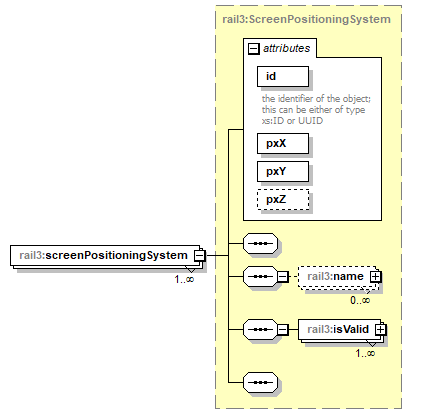 | ||||||||||||||||||||||||||||||||
| namespace | https://www.railml.org/schemas/3.1 | ||||||||||||||||||||||||||||||||
| type | rail3:ScreenPositioningSystem | ||||||||||||||||||||||||||||||||
| properties |
| ||||||||||||||||||||||||||||||||
| children | rail3:name rail3:isValid | ||||||||||||||||||||||||||||||||
| attributes |
| ||||||||||||||||||||||||||||||||
| source | <xs:element name="screenPositioningSystem" type="rail3:ScreenPositioningSystem" minOccurs="1" maxOccurs="unbounded"/> |
complexType ShiftablePeriodRule
| diagram | 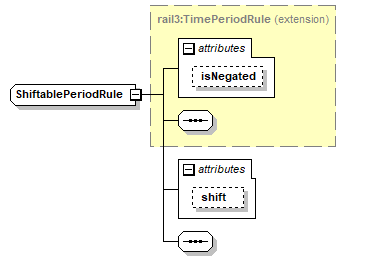 | ||||||||||||||||||
| namespace | https://www.railml.org/schemas/3.1 | ||||||||||||||||||
| type | extension of rail3:TimePeriodRule | ||||||||||||||||||
| properties |
| ||||||||||||||||||
| used by |
| ||||||||||||||||||
| attributes |
| ||||||||||||||||||
| source | <xs:complexType name="ShiftablePeriodRule"> <xs:complexContent> <xs:extension base="rail3:TimePeriodRule"> <xs:sequence/> <xs:attribute name="shift" type="xs:integer" use="optional"/> </xs:extension> </xs:complexContent> </xs:complexType> |
attribute ShiftablePeriodRule/@shift
| type | xs:integer | ||
| properties |
| ||
| source | <xs:attribute name="shift" type="xs:integer" use="optional"/> |
complexType SpeedProfile
| diagram | 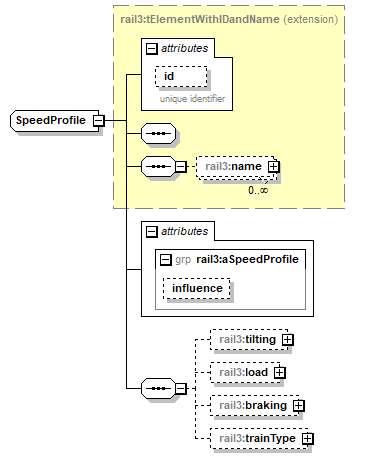 | ||||||||||||||||||||
| namespace | https://www.railml.org/schemas/3.1 | ||||||||||||||||||||
| type | extension of rail3:tElementWithIDandName | ||||||||||||||||||||
| properties |
| ||||||||||||||||||||
| children | rail3:name rail3:tilting rail3:load rail3:braking rail3:trainType | ||||||||||||||||||||
| used by |
| ||||||||||||||||||||
| attributes |
| ||||||||||||||||||||
| source | <xs:complexType name="SpeedProfile"> <xs:complexContent> <xs:extension base="rail3:tElementWithIDandName"> <xs:sequence> <xs:element name="tilting" type="rail3:SpeedProfileTilting" minOccurs="0" maxOccurs="1"/> <xs:element name="load" type="rail3:SpeedProfileLoad" minOccurs="0" maxOccurs="1"/> <xs:element name="braking" type="rail3:SpeedProfileBraking" minOccurs="0" maxOccurs="1"/> <xs:element name="trainType" type="rail3:SpeedProfileTrainType" minOccurs="0" maxOccurs="1"/> </xs:sequence> <xs:attributeGroup ref="rail3:aSpeedProfile"/> </xs:extension> </xs:complexContent> </xs:complexType> |
element SpeedProfile/tilting
| diagram | 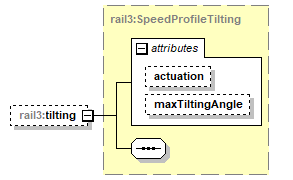 | ||||||||||||||||||
| namespace | https://www.railml.org/schemas/3.1 | ||||||||||||||||||
| type | rail3:SpeedProfileTilting | ||||||||||||||||||
| properties |
| ||||||||||||||||||
| attributes |
| ||||||||||||||||||
| source | <xs:element name="tilting" type="rail3:SpeedProfileTilting" minOccurs="0" maxOccurs="1"/> |
element SpeedProfile/load
| diagram | 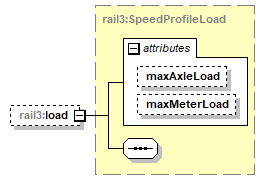 | ||||||||||||||||||
| namespace | https://www.railml.org/schemas/3.1 | ||||||||||||||||||
| type | rail3:SpeedProfileLoad | ||||||||||||||||||
| properties |
| ||||||||||||||||||
| attributes |
| ||||||||||||||||||
| source | <xs:element name="load" type="rail3:SpeedProfileLoad" minOccurs="0" maxOccurs="1"/> |
element SpeedProfile/braking
| diagram | 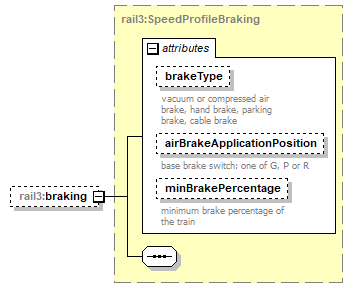 | ||||||||||||||||||||||||||||||
| namespace | https://www.railml.org/schemas/3.1 | ||||||||||||||||||||||||||||||
| type | rail3:SpeedProfileBraking | ||||||||||||||||||||||||||||||
| properties |
| ||||||||||||||||||||||||||||||
| attributes |
| ||||||||||||||||||||||||||||||
| source | <xs:element name="braking" type="rail3:SpeedProfileBraking" minOccurs="0" maxOccurs="1"/> |
element SpeedProfile/trainType
| diagram | 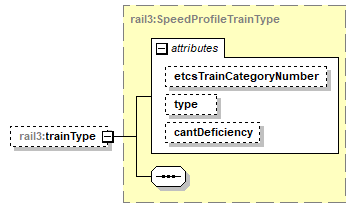 | ||||||||||||||||||||||||
| namespace | https://www.railml.org/schemas/3.1 | ||||||||||||||||||||||||
| type | rail3:SpeedProfileTrainType | ||||||||||||||||||||||||
| properties |
| ||||||||||||||||||||||||
| attributes |
| ||||||||||||||||||||||||
| source | <xs:element name="trainType" type="rail3:SpeedProfileTrainType" minOccurs="0" maxOccurs="1"/> |
complexType SpeedProfileBraking
| diagram | 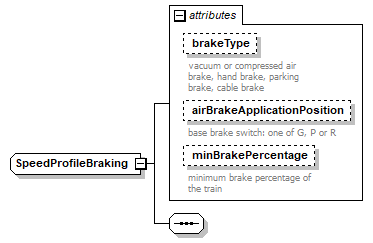 | ||||||||||||||||||||||||||||||
| namespace | https://www.railml.org/schemas/3.1 | ||||||||||||||||||||||||||||||
| used by |
| ||||||||||||||||||||||||||||||
| attributes |
| ||||||||||||||||||||||||||||||
| source | <xs:complexType name="SpeedProfileBraking"> <xs:sequence/> <xs:attribute name="brakeType" type="rail3:tBrakeTypeExt" use="optional"> <xs:annotation> <xs:documentation>vacuum or compressed air brake, hand brake, parking brake, cable brake</xs:documentation> </xs:annotation> </xs:attribute> <xs:attribute name="airBrakeApplicationPosition" type="rail3:tAirBrakeApplicationDirection" use="optional"> <xs:annotation> <xs:documentation>base brake switch: one of G, P or R</xs:documentation> </xs:annotation> </xs:attribute> <xs:attribute name="minBrakePercentage" type="rail3:tBrakePercentage" use="optional"> <xs:annotation> <xs:documentation>minimum brake percentage of the train</xs:documentation> </xs:annotation> </xs:attribute> </xs:complexType> |
attribute SpeedProfileBraking/@brakeType
| type | rail3:tBrakeTypeExt | ||
| properties |
| ||
| annotation |
| ||
| source | <xs:attribute name="brakeType" type="rail3:tBrakeTypeExt" use="optional"> <xs:annotation> <xs:documentation>vacuum or compressed air brake, hand brake, parking brake, cable brake</xs:documentation> </xs:annotation> </xs:attribute> |
attribute SpeedProfileBraking/@airBrakeApplicationPosition
| type | rail3:tAirBrakeApplicationDirection | |||||||||||||||||||||
| properties |
| |||||||||||||||||||||
| facets |
| |||||||||||||||||||||
| annotation |
| |||||||||||||||||||||
| source | <xs:attribute name="airBrakeApplicationPosition" type="rail3:tAirBrakeApplicationDirection" use="optional"> <xs:annotation> <xs:documentation>base brake switch: one of G, P or R</xs:documentation> </xs:annotation> </xs:attribute> |
attribute SpeedProfileBraking/@minBrakePercentage
| type | rail3:tBrakePercentage | |||||||||
| properties |
| |||||||||
| facets |
| |||||||||
| annotation |
| |||||||||
| source | <xs:attribute name="minBrakePercentage" type="rail3:tBrakePercentage" use="optional"> <xs:annotation> <xs:documentation>minimum brake percentage of the train</xs:documentation> </xs:annotation> </xs:attribute> |
complexType SpeedProfileLoad
| diagram | 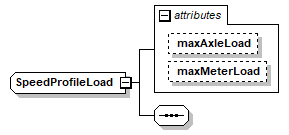 | ||||||||||||||||||
| namespace | https://www.railml.org/schemas/3.1 | ||||||||||||||||||
| used by |
| ||||||||||||||||||
| attributes |
| ||||||||||||||||||
| source | <xs:complexType name="SpeedProfileLoad"> <xs:sequence/> <xs:attribute name="maxAxleLoad" type="rail3:tWeightTons" use="optional"/> <xs:attribute name="maxMeterLoad" type="rail3:tMeterloadTonsPerMeter" use="optional"/> </xs:complexType> |
attribute SpeedProfileLoad/@maxAxleLoad
| type | rail3:tWeightTons | ||
| properties |
| ||
| source | <xs:attribute name="maxAxleLoad" type="rail3:tWeightTons" use="optional"/> |
attribute SpeedProfileLoad/@maxMeterLoad
| type | rail3:tMeterloadTonsPerMeter | ||
| properties |
| ||
| source | <xs:attribute name="maxMeterLoad" type="rail3:tMeterloadTonsPerMeter" use="optional"/> |
complexType SpeedProfiles
| diagram |  | ||
| namespace | https://www.railml.org/schemas/3.1 | ||
| children | rail3:speedProfile | ||
| used by |
| ||
| source | <xs:complexType name="SpeedProfiles"> <xs:sequence> <xs:element name="speedProfile" type="rail3:SpeedProfile" minOccurs="1" maxOccurs="unbounded"/> </xs:sequence> </xs:complexType> |
element SpeedProfiles/speedProfile
| diagram | 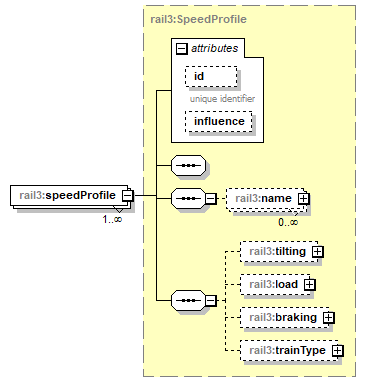 | ||||||||||||||||||||
| namespace | https://www.railml.org/schemas/3.1 | ||||||||||||||||||||
| type | rail3:SpeedProfile | ||||||||||||||||||||
| properties |
| ||||||||||||||||||||
| children | rail3:name rail3:tilting rail3:load rail3:braking rail3:trainType | ||||||||||||||||||||
| attributes |
| ||||||||||||||||||||
| source | <xs:element name="speedProfile" type="rail3:SpeedProfile" minOccurs="1" maxOccurs="unbounded"/> |
complexType SpeedProfileTilting
| diagram | 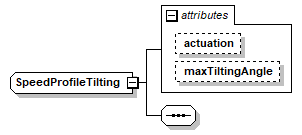 | ||||||||||||||||||
| namespace | https://www.railml.org/schemas/3.1 | ||||||||||||||||||
| used by |
| ||||||||||||||||||
| attributes |
| ||||||||||||||||||
| source | <xs:complexType name="SpeedProfileTilting"> <xs:sequence/> <xs:attribute name="actuation" type="rail3:tTiltingActuationType" use="optional"/> <xs:attribute name="maxTiltingAngle" type="rail3:tAngleDegQuadrant" use="optional"/> </xs:complexType> |
attribute SpeedProfileTilting/@actuation
| type | rail3:tTiltingActuationType | |||||||||||||||
| properties |
| |||||||||||||||
| facets |
| |||||||||||||||
| source | <xs:attribute name="actuation" type="rail3:tTiltingActuationType" use="optional"/> |
attribute SpeedProfileTilting/@maxTiltingAngle
| type | rail3:tAngleDegQuadrant | ||
| properties |
| ||
| source | <xs:attribute name="maxTiltingAngle" type="rail3:tAngleDegQuadrant" use="optional"/> |
complexType SpeedProfileTrainType
| diagram | 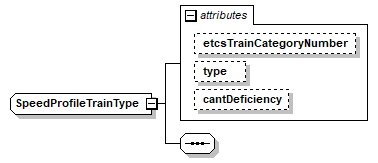 | ||||||||||||||||||||||||
| namespace | https://www.railml.org/schemas/3.1 | ||||||||||||||||||||||||
| used by |
| ||||||||||||||||||||||||
| attributes |
| ||||||||||||||||||||||||
| source | <xs:complexType name="SpeedProfileTrainType"> <xs:sequence/> <xs:attribute name="etcsTrainCategoryNumber" type="rail3:tEtcsTrainCategoryNumber" use="optional"/> <xs:attribute name="type" type="rail3:tTrainType" use="optional"/> <xs:attribute name="cantDeficiency" type="rail3:tCantDeficiency" use="optional"/> </xs:complexType> |
attribute SpeedProfileTrainType/@etcsTrainCategoryNumber
| type | rail3:tEtcsTrainCategoryNumber | |||||||||
| properties |
| |||||||||
| facets |
| |||||||||
| source | <xs:attribute name="etcsTrainCategoryNumber" type="rail3:tEtcsTrainCategoryNumber" use="optional"/> |
attribute SpeedProfileTrainType/@type
| type | rail3:tTrainType | ||||||||||||
| properties |
| ||||||||||||
| facets |
| ||||||||||||
| source | <xs:attribute name="type" type="rail3:tTrainType" use="optional"/> |
attribute SpeedProfileTrainType/@cantDeficiency
| type | rail3:tCantDeficiency | |||||||||
| properties |
| |||||||||
| facets |
| |||||||||
| source | <xs:attribute name="cantDeficiency" type="rail3:tCantDeficiency" use="optional"/> |
complexType tElementBitmaskAny
| diagram | 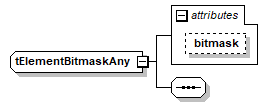 | ||||||||||||
| namespace | https://www.railml.org/schemas/3.1 | ||||||||||||
| attributes |
| ||||||||||||
| source | <xs:complexType name="tElementBitmaskAny"> <xs:sequence/> <xs:attribute name="bitmask" type="rail3:tBitmaskAny" use="optional"/> </xs:complexType> |
attribute tElementBitmaskAny/@bitmask
| type | rail3:tBitmaskAny | ||||||
| properties |
| ||||||
| facets |
| ||||||
| source | <xs:attribute name="bitmask" type="rail3:tBitmaskAny" use="optional"/> |
complexType tElementBitmaskWeek
| diagram | 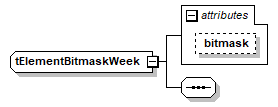 | ||||||||||||
| namespace | https://www.railml.org/schemas/3.1 | ||||||||||||
| attributes |
| ||||||||||||
| source | <xs:complexType name="tElementBitmaskWeek"> <xs:sequence/> <xs:attribute name="bitmask" type="rail3:tBitmaskWeek" use="optional"/> </xs:complexType> |
attribute tElementBitmaskWeek/@bitmask
| type | rail3:tBitmaskWeek | |||||||||
| properties |
| |||||||||
| facets |
| |||||||||
| source | <xs:attribute name="bitmask" type="rail3:tBitmaskWeek" use="optional"/> |
complexType tElementTimeStamp
| diagram | 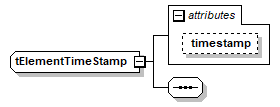 | ||||||||||||
| namespace | https://www.railml.org/schemas/3.1 | ||||||||||||
| attributes |
| ||||||||||||
| source | <xs:complexType name="tElementTimeStamp"> <xs:sequence/> <xs:attribute name="timestamp" type="xs:dateTime" use="optional"/> </xs:complexType> |
attribute tElementTimeStamp/@timestamp
| type | xs:dateTime | ||
| properties |
| ||
| source | <xs:attribute name="timestamp" type="xs:dateTime" use="optional"/> |
complexType tElementWithID
| diagram | 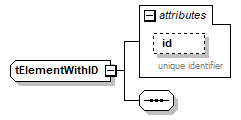 | ||||||||||||||
| namespace | https://www.railml.org/schemas/3.1 | ||||||||||||||
| properties |
| ||||||||||||||
| used by |
| ||||||||||||||
| attributes |
| ||||||||||||||
| source | <xs:complexType name="tElementWithID" abstract="true"> <xs:sequence/> <xs:attribute name="id" type="rail3:tID" use="optional"> <xs:annotation> <xs:documentation>unique identifier</xs:documentation> </xs:annotation> </xs:attribute> </xs:complexType> |
attribute tElementWithID/@id
| type | rail3:tID | ||
| properties |
| ||
| annotation |
| ||
| source | <xs:attribute name="id" type="rail3:tID" use="optional"> <xs:annotation> <xs:documentation>unique identifier</xs:documentation> </xs:annotation> </xs:attribute> |
complexType tElementWithIDandCode
| diagram | 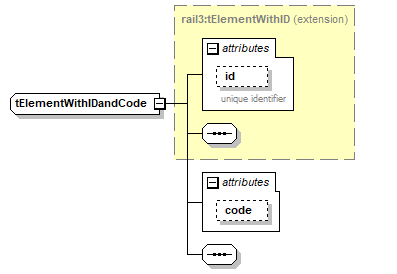 | ||||||||||||||||||||
| namespace | https://www.railml.org/schemas/3.1 | ||||||||||||||||||||
| type | extension of rail3:tElementWithID | ||||||||||||||||||||
| properties |
| ||||||||||||||||||||
| attributes |
| ||||||||||||||||||||
| source | <xs:complexType name="tElementWithIDandCode"> <xs:complexContent> <xs:extension base="rail3:tElementWithID"> <xs:sequence/> <xs:attribute name="code" type="xs:string" use="optional"/> </xs:extension> </xs:complexContent> </xs:complexType> |
attribute tElementWithIDandCode/@code
| type | xs:string | ||
| properties |
| ||
| source | <xs:attribute name="code" type="xs:string" use="optional"/> |
complexType tElementWithIDandName
| diagram | 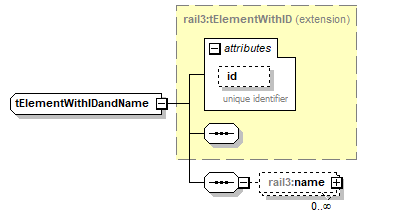 | ||||||||||||||
| namespace | https://www.railml.org/schemas/3.1 | ||||||||||||||
| type | extension of rail3:tElementWithID | ||||||||||||||
| properties |
| ||||||||||||||
| children | rail3:name | ||||||||||||||
| used by |
| ||||||||||||||
| attributes |
| ||||||||||||||
| source | <xs:complexType name="tElementWithIDandName" abstract="true"> <xs:complexContent> <xs:extension base="rail3:tElementWithID"> <xs:sequence> <xs:element name="name" type="rail3:Name" minOccurs="0" maxOccurs="unbounded"/> </xs:sequence> </xs:extension> </xs:complexContent> </xs:complexType> |
element tElementWithIDandName/name
| diagram | 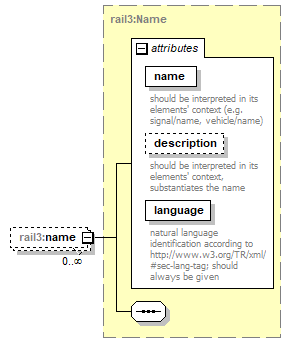 | ||||||||||||||||||||||||||||||
| namespace | https://www.railml.org/schemas/3.1 | ||||||||||||||||||||||||||||||
| type | rail3:Name | ||||||||||||||||||||||||||||||
| properties |
| ||||||||||||||||||||||||||||||
| attributes |
| ||||||||||||||||||||||||||||||
| source | <xs:element name="name" type="rail3:Name" minOccurs="0" maxOccurs="unbounded"/> |
complexType tElementWithIDref
| diagram | 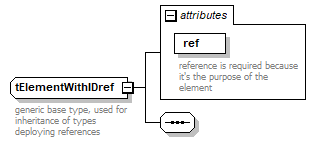 | ||||||||||||||
| namespace | https://www.railml.org/schemas/3.1 | ||||||||||||||
| used by |
| ||||||||||||||
| attributes |
| ||||||||||||||
| annotation |
| ||||||||||||||
| source | <xs:complexType name="tElementWithIDref"> <xs:annotation> <xs:documentation>generic base type, used for inheritance of types deploying references</xs:documentation> </xs:annotation> <xs:sequence/> <xs:attribute name="ref" type="rail3:tRef" use="required"> <xs:annotation> <xs:documentation>reference is required because it's the purpose of the element</xs:documentation> </xs:annotation> </xs:attribute> </xs:complexType> |
attribute tElementWithIDref/@ref
| type | rail3:tRef | ||
| properties |
| ||
| annotation |
| ||
| source | <xs:attribute name="ref" type="rail3:tRef" use="required"> <xs:annotation> <xs:documentation>reference is required because it's the purpose of the element</xs:documentation> </xs:annotation> </xs:attribute> |
complexType TimePeriod
| diagram |  | ||
| namespace | https://www.railml.org/schemas/3.1 | ||
| properties |
| ||
| used by |
| ||
| source | <xs:complexType name="TimePeriod" abstract="true"> <xs:sequence/> </xs:complexType> |
complexType TimePeriodRule
| diagram | 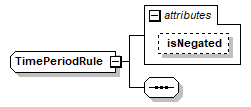 | ||||||||||||
| namespace | https://www.railml.org/schemas/3.1 | ||||||||||||
| properties |
| ||||||||||||
| used by |
| ||||||||||||
| attributes |
| ||||||||||||
| source | <xs:complexType name="TimePeriodRule" abstract="true"> <xs:sequence/> <xs:attribute name="isNegated" type="xs:boolean" use="optional"/> </xs:complexType> |
attribute TimePeriodRule/@isNegated
| type | xs:boolean | ||
| properties |
| ||
| source | <xs:attribute name="isNegated" type="xs:boolean" use="optional"/> |
complexType TimePeriodRuleSituation
| diagram | 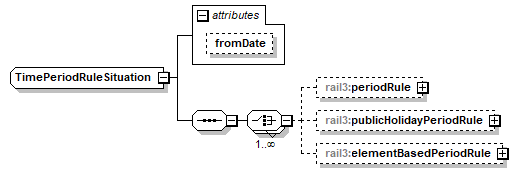 | ||||||||||||
| namespace | https://www.railml.org/schemas/3.1 | ||||||||||||
| children | rail3:periodRule rail3:publicHolidayPeriodRule rail3:elementBasedPeriodRule | ||||||||||||
| used by |
| ||||||||||||
| attributes |
| ||||||||||||
| source | <xs:complexType name="TimePeriodRuleSituation"> <xs:sequence> <xs:choice minOccurs="1" maxOccurs="unbounded"> <xs:element name="periodRule" type="rail3:PeriodRule" minOccurs="0" maxOccurs="1"/> <xs:element name="publicHolidayPeriodRule" type="rail3:PublicHolidayPeriodRule" minOccurs="0" maxOccurs="1"/> <xs:element name="elementBasedPeriodRule" type="rail3:ElemBasedPeriodRule" minOccurs="0" maxOccurs="1"/> </xs:choice> </xs:sequence> <xs:attribute name="fromDate" type="xs:date" use="optional"/> </xs:complexType> |
attribute TimePeriodRuleSituation/@fromDate
| type | xs:date | ||
| properties |
| ||
| source | <xs:attribute name="fromDate" type="xs:date" use="optional"/> |
element TimePeriodRuleSituation/periodRule
| diagram | 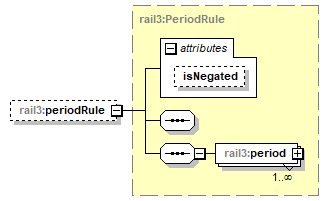 | ||||||||||||
| namespace | https://www.railml.org/schemas/3.1 | ||||||||||||
| type | rail3:PeriodRule | ||||||||||||
| properties |
| ||||||||||||
| children | rail3:period | ||||||||||||
| attributes |
| ||||||||||||
| source | <xs:element name="periodRule" type="rail3:PeriodRule" minOccurs="0" maxOccurs="1"/> |
element TimePeriodRuleSituation/publicHolidayPeriodRule
| diagram | 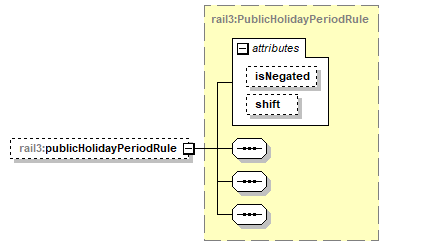 | ||||||||||||||||||
| namespace | https://www.railml.org/schemas/3.1 | ||||||||||||||||||
| type | rail3:PublicHolidayPeriodRule | ||||||||||||||||||
| properties |
| ||||||||||||||||||
| attributes |
| ||||||||||||||||||
| source | <xs:element name="publicHolidayPeriodRule" type="rail3:PublicHolidayPeriodRule" minOccurs="0" maxOccurs="1"/> |
element TimePeriodRuleSituation/elementBasedPeriodRule
| diagram | 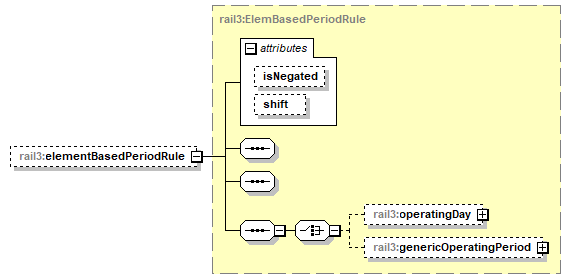 | ||||||||||||||||||
| namespace | https://www.railml.org/schemas/3.1 | ||||||||||||||||||
| type | rail3:ElemBasedPeriodRule | ||||||||||||||||||
| properties |
| ||||||||||||||||||
| children | rail3:operatingDay rail3:genericOperatingPeriod | ||||||||||||||||||
| attributes |
| ||||||||||||||||||
| source | <xs:element name="elementBasedPeriodRule" type="rail3:ElemBasedPeriodRule" minOccurs="0" maxOccurs="1"/> |
complexType TimeStamp
| diagram | 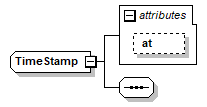 | ||||||||||||
| namespace | https://www.railml.org/schemas/3.1 | ||||||||||||
| attributes |
| ||||||||||||
| source | <xs:complexType name="TimeStamp"> <xs:sequence/> <xs:attribute name="at" type="xs:dateTime" use="optional"/> </xs:complexType> |
attribute TimeStamp/@at
| type | xs:dateTime | ||
| properties |
| ||
| source | <xs:attribute name="at" type="xs:dateTime" use="optional"/> |
complexType VehicleManufacturer
| diagram | 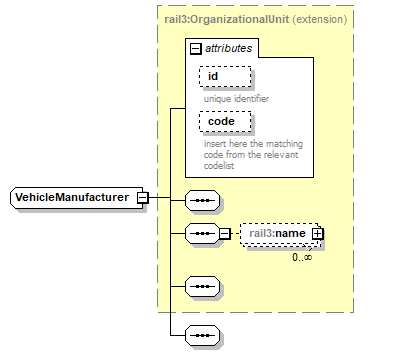 | ||||||||||||||||||||||
| namespace | https://www.railml.org/schemas/3.1 | ||||||||||||||||||||||
| type | extension of rail3:OrganizationalUnit | ||||||||||||||||||||||
| properties |
| ||||||||||||||||||||||
| children | rail3:name | ||||||||||||||||||||||
| used by |
| ||||||||||||||||||||||
| attributes |
| ||||||||||||||||||||||
| source | <xs:complexType name="VehicleManufacturer"> <xs:complexContent> <xs:extension base="rail3:OrganizationalUnit"> <xs:sequence/> </xs:extension> </xs:complexContent> </xs:complexType> |
complexType VehicleOperator
| diagram | 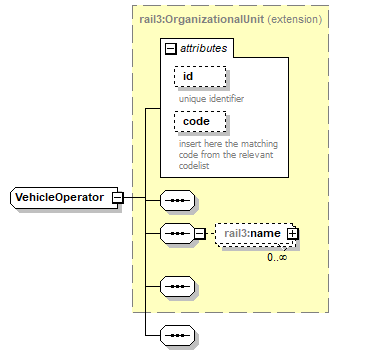 | ||||||||||||||||||||||
| namespace | https://www.railml.org/schemas/3.1 | ||||||||||||||||||||||
| type | extension of rail3:OrganizationalUnit | ||||||||||||||||||||||
| properties |
| ||||||||||||||||||||||
| children | rail3:name | ||||||||||||||||||||||
| used by |
| ||||||||||||||||||||||
| attributes |
| ||||||||||||||||||||||
| source | <xs:complexType name="VehicleOperator"> <xs:complexContent> <xs:extension base="rail3:OrganizationalUnit"> <xs:sequence/> </xs:extension> </xs:complexContent> </xs:complexType> |
simpleType tAcceleration
| namespace | https://www.railml.org/schemas/3.1 | ||
| type | xs:decimal | ||
| properties |
| ||
| used by |
| ||
| annotation |
| ||
| source | <xs:simpleType name="tAcceleration"> <xs:annotation> <xs:documentation>applies as basic type for inheritance, should not be used directly because of missing unit of measure</xs:documentation> </xs:annotation> <xs:restriction base="xs:decimal"/> </xs:simpleType> |
simpleType tAccelerationMeterPerSquareSec
| namespace | https://www.railml.org/schemas/3.1 | ||
| type | rail3:tAcceleration | ||
| properties |
| ||
| annotation |
| ||
| source | <xs:simpleType name="tAccelerationMeterPerSquareSec"> <xs:annotation> <xs:documentation>generic type for acceleration values measured in metres per square second</xs:documentation> </xs:annotation> <xs:restriction base="rail3:tAcceleration"/> </xs:simpleType> |
simpleType tAirBrakeApplicationDirection
| namespace | https://www.railml.org/schemas/3.1 | |||||||||||||||||||||
| type | restriction of xs:string | |||||||||||||||||||||
| properties |
| |||||||||||||||||||||
| used by |
| |||||||||||||||||||||
| facets |
| |||||||||||||||||||||
| source | <xs:simpleType name="tAirBrakeApplicationDirection"> <xs:restriction base="xs:string"> <xs:enumeration value="R"> <xs:annotation> <xs:documentation>Rapid</xs:documentation> </xs:annotation> </xs:enumeration> <xs:enumeration value="P"> <xs:annotation> <xs:documentation>Passenger</xs:documentation> </xs:annotation> </xs:enumeration> <xs:enumeration value="N/A"/> <xs:enumeration value="G"> <xs:annotation> <xs:documentation>Goods</xs:documentation> </xs:annotation> </xs:enumeration> </xs:restriction> </xs:simpleType> |
simpleType tAngleDeg
| namespace | https://www.railml.org/schemas/3.1 | ||||
| type | xs:decimal | ||||
| properties |
| ||||
| used by |
| ||||
| annotation |
| ||||
| source | <xs:simpleType name="tAngleDeg"> <xs:annotation> <xs:documentation>applies as basic type for inheritance, should not be used directly because of missing unit of measure</xs:documentation> </xs:annotation> <xs:restriction base="xs:decimal"/> </xs:simpleType> |
simpleType tAngleDegQuadrant
| namespace | https://www.railml.org/schemas/3.1 | ||
| type | rail3:tAngleDeg | ||
| properties |
| ||
| used by |
| ||
| annotation |
| ||
| source | <xs:simpleType name="tAngleDegQuadrant"> <xs:annotation> <xs:documentation>generic type for angle values measured in degree, allowing 0 ... +90</xs:documentation> </xs:annotation> <xs:restriction base="rail3:tAngleDeg"/> </xs:simpleType> |
simpleType tArea
| namespace | https://www.railml.org/schemas/3.1 | ||
| type | xs:decimal | ||
| properties |
| ||
| used by |
| ||
| annotation |
| ||
| source | <xs:simpleType name="tArea"> <xs:annotation> <xs:documentation>applies as basic type for inheritance, should not be used directly because of missing unit of measure</xs:documentation> </xs:annotation> <xs:restriction base="xs:decimal"/> </xs:simpleType> |
simpleType tAreaSquareM
| namespace | https://www.railml.org/schemas/3.1 | ||
| type | rail3:tArea | ||
| properties |
| ||
| annotation |
| ||
| source | <xs:simpleType name="tAreaSquareM"> <xs:annotation> <xs:documentation>generic type for area values measured in square metres</xs:documentation> </xs:annotation> <xs:restriction base="rail3:tArea"/> </xs:simpleType> |
simpleType tAreaSquareMM
| namespace | https://www.railml.org/schemas/3.1 | ||
| type | rail3:tArea | ||
| properties |
| ||
| annotation |
| ||
| source | <xs:simpleType name="tAreaSquareMM"> <xs:annotation> <xs:documentation>generic type for area values measured in square millimetres</xs:documentation> </xs:annotation> <xs:restriction base="rail3:tArea"/> </xs:simpleType> |
simpleType tBitmaskAny
| namespace | https://www.railml.org/schemas/3.1 | ||||||
| type | restriction of xs:string | ||||||
| properties |
| ||||||
| used by |
| ||||||
| facets |
| ||||||
| source | <xs:simpleType name="tBitmaskAny"> <xs:restriction base="xs:string"> <xs:pattern value="[0-1]*"/> </xs:restriction> </xs:simpleType> |
simpleType tBitmaskWeek
| namespace | https://www.railml.org/schemas/3.1 | |||||||||
| type | restriction of xs:string | |||||||||
| properties |
| |||||||||
| used by |
| |||||||||
| facets |
| |||||||||
| source | <xs:simpleType name="tBitmaskWeek"> <xs:restriction base="xs:string"> <xs:length value="7"/> <xs:pattern value="[0-1]{7}"/> </xs:restriction> </xs:simpleType> |
simpleType tBrakePercentage
| namespace | https://www.railml.org/schemas/3.1 | |||||||||
| type | restriction of xs:integer | |||||||||
| properties |
| |||||||||
| used by |
| |||||||||
| facets |
| |||||||||
| annotation |
| |||||||||
| source | <xs:simpleType name="tBrakePercentage"> <xs:annotation> <xs:documentation>Brake percentage as value of braking performance in relation to vehicle weight</xs:documentation> </xs:annotation> <xs:restriction base="xs:integer"> <xs:maxInclusive value="225"/> <xs:minInclusive value="6"/> </xs:restriction> </xs:simpleType> |
simpleType tBrakeType
| namespace | https://www.railml.org/schemas/3.1 | |||||||||||||||||||||||||||
| type | restriction of xs:string | |||||||||||||||||||||||||||
| properties |
| |||||||||||||||||||||||||||
| used by |
| |||||||||||||||||||||||||||
| facets |
| |||||||||||||||||||||||||||
| source | <xs:simpleType name="tBrakeType"> <xs:restriction base="xs:string"> <xs:enumeration value="none"/> <xs:enumeration value="compressedAirBrake"> <xs:annotation> <xs:documentation>de: Druckluftbremse</xs:documentation> </xs:annotation> </xs:enumeration> <xs:enumeration value="vacuumAirBrake"> <xs:annotation> <xs:documentation>de: Saugluftbremse</xs:documentation> </xs:annotation> </xs:enumeration> <xs:enumeration value="cableBrake"> <xs:annotation> <xs:documentation>de: Seilzugbremse</xs:documentation> </xs:annotation> </xs:enumeration> <xs:enumeration value="parkingBrake"/> <xs:enumeration value="handBrake"/> </xs:restriction> </xs:simpleType> |
simpleType tBrakeTypeExt
| namespace | https://www.railml.org/schemas/3.1 | ||
| type | union of (rail3:tOtherEnumerationValue, rail3:tBrakeType) | ||
| used by |
| ||
| source | <xs:simpleType name="tBrakeTypeExt"> <xs:union memberTypes="rail3:tOtherEnumerationValue rail3:tBrakeType"/> </xs:simpleType> |
simpleType tCantDeficiency
| namespace | https://www.railml.org/schemas/3.1 | |||||||||
| type | restriction of xs:integer | |||||||||
| properties |
| |||||||||
| used by |
| |||||||||
| facets |
| |||||||||
| source | <xs:simpleType name="tCantDeficiency"> <xs:restriction base="xs:integer"> <xs:maxInclusive value="300"/> <xs:minInclusive value="80"/> </xs:restriction> </xs:simpleType> |
simpleType tCurrent
| namespace | https://www.railml.org/schemas/3.1 | ||
| type | xs:decimal | ||
| properties |
| ||
| used by |
| ||
| source | <xs:simpleType name="tCurrent"> <xs:restriction base="xs:decimal"/> </xs:simpleType> |
simpleType tCurrentAmpere
| namespace | https://www.railml.org/schemas/3.1 | ||
| type | rail3:tCurrent | ||
| properties |
| ||
| used by |
| ||
| source | <xs:simpleType name="tCurrentAmpere"> <xs:restriction base="rail3:tCurrent"/> </xs:simpleType> |
simpleType tEtcsTrainCategoryNumber
| namespace | https://www.railml.org/schemas/3.1 | |||||||||
| type | restriction of xs:integer | |||||||||
| properties |
| |||||||||
| used by |
| |||||||||
| facets |
| |||||||||
| source | <xs:simpleType name="tEtcsTrainCategoryNumber"> <xs:restriction base="xs:integer"> <xs:maxInclusive value="15"/> <xs:minInclusive value="0"/> </xs:restriction> </xs:simpleType> |
simpleType tForce
| namespace | https://www.railml.org/schemas/3.1 | ||
| type | xs:decimal | ||
| properties |
| ||
| used by |
| ||
| source | <xs:simpleType name="tForce"> <xs:restriction base="xs:decimal"/> </xs:simpleType> |
simpleType tForceN
| namespace | https://www.railml.org/schemas/3.1 | ||
| type | rail3:tForce | ||
| properties |
| ||
| used by |
| ||
| source | <xs:simpleType name="tForceN"> <xs:restriction base="rail3:tForce"/> </xs:simpleType> |
simpleType tFrequency
| namespace | https://www.railml.org/schemas/3.1 | |||||||||
| type | restriction of xs:decimal | |||||||||
| properties |
| |||||||||
| used by |
| |||||||||
| facets |
| |||||||||
| annotation |
| |||||||||
| source | <xs:simpleType name="tFrequency"> <xs:annotation> <xs:documentation>applies as basic type for inheritance, should not be used directly because of missing unit of measure</xs:documentation> </xs:annotation> <xs:restriction base="xs:decimal"> <xs:fractionDigits value="3"/> <xs:minInclusive value="0"/> </xs:restriction> </xs:simpleType> |
simpleType tFrequencyHertz
| namespace | https://www.railml.org/schemas/3.1 | |||||||||
| type | rail3:tFrequency | |||||||||
| properties |
| |||||||||
| used by |
| |||||||||
| facets |
| |||||||||
| annotation |
| |||||||||
| source | <xs:simpleType name="tFrequencyHertz"> <xs:annotation> <xs:documentation>generic type for frequency values measured in hertz</xs:documentation> </xs:annotation> <xs:restriction base="rail3:tFrequency"/> </xs:simpleType> |
simpleType tGenericID
| namespace | https://www.railml.org/schemas/3.1 | ||
| type | xs:ID | ||
| properties |
| ||
| used by |
| ||
| annotation |
| ||
| source | <xs:simpleType name="tGenericID"> <xs:annotation> <xs:documentation>an XML-side constrained bi-unique identity; unique across an XML file including its outsourced components (xi:include mechanism); white spaces not allowed</xs:documentation> </xs:annotation> <xs:restriction base="xs:ID"/> </xs:simpleType> |
simpleType tGenericRef
| namespace | https://www.railml.org/schemas/3.1 | ||
| type | xs:IDREF | ||
| properties |
| ||
| used by |
| ||
| annotation |
| ||
| source | <xs:simpleType name="tGenericRef"> <xs:annotation> <xs:documentation>an XML-side constrained reference to one xs:ID value, acts across an XML file including its outsourced components (xi:include mechanism)</xs:documentation> </xs:annotation> <xs:restriction base="xs:IDREF"/> </xs:simpleType> |
simpleType tGradientPerMille
| namespace | https://www.railml.org/schemas/3.1 | ||
| type | xs:decimal | ||
| properties |
| ||
| used by |
| ||
| source | <xs:simpleType name="tGradientPerMille"> <xs:restriction base="xs:decimal"/> </xs:simpleType> |
simpleType tID
| namespace | https://www.railml.org/schemas/3.1 | ||
| type | union of (rail3:tUUID, rail3:tGenericID) | ||
| used by |
| ||
| annotation |
| ||
| source | <xs:simpleType name="tID"> <xs:annotation> <xs:documentation>use UUID if your system supports this functionality, otherwise use GenericID (xs:ID)</xs:documentation> </xs:annotation> <xs:union memberTypes="rail3:tUUID rail3:tGenericID"/> </xs:simpleType> |
simpleType tLength
| namespace | https://www.railml.org/schemas/3.1 | ||
| type | xs:decimal | ||
| properties |
| ||
| used by |
| ||
| annotation |
| ||
| source | <xs:simpleType name="tLength"> <xs:annotation> <xs:documentation>applies as basic type for inheritance, should not be used directly because of missing unit of measure</xs:documentation> </xs:annotation> <xs:restriction base="xs:decimal"/> </xs:simpleType> |
simpleType tLengthKM
| namespace | https://www.railml.org/schemas/3.1 | ||
| type | rail3:tLength | ||
| properties |
| ||
| annotation |
| ||
| source | <xs:simpleType name="tLengthKM"> <xs:annotation> <xs:documentation>generic type for length values measured in kilometres</xs:documentation> </xs:annotation> <xs:restriction base="rail3:tLength"/> </xs:simpleType> |
simpleType tLengthM
| namespace | https://www.railml.org/schemas/3.1 | ||
| type | rail3:tLength | ||
| properties |
| ||
| used by |
| ||
| annotation |
| ||
| source | <xs:simpleType name="tLengthM"> <xs:annotation> <xs:documentation>generic type for length values measured in metres</xs:documentation> </xs:annotation> <xs:restriction base="rail3:tLength"/> </xs:simpleType> |
simpleType tLengthMM
| namespace | https://www.railml.org/schemas/3.1 | ||
| type | rail3:tLength | ||
| properties |
| ||
| annotation |
| ||
| source | <xs:simpleType name="tLengthMM"> <xs:annotation> <xs:documentation>generic type for length values measured in millimetres</xs:documentation> </xs:annotation> <xs:restriction base="rail3:tLength"/> </xs:simpleType> |
simpleType tMeterload
| namespace | https://www.railml.org/schemas/3.1 | ||
| type | xs:decimal | ||
| properties |
| ||
| used by |
| ||
| annotation |
| ||
| source | <xs:simpleType name="tMeterload"> <xs:annotation> <xs:documentation>applies as basic type for inheritance, should not be used directly because of missing unit of measure</xs:documentation> </xs:annotation> <xs:restriction base="xs:decimal"/> </xs:simpleType> |
simpleType tMeterloadTonsPerMeter
| namespace | https://www.railml.org/schemas/3.1 | ||
| type | rail3:tMeterload | ||
| properties |
| ||
| used by |
| ||
| annotation |
| ||
| source | <xs:simpleType name="tMeterloadTonsPerMeter"> <xs:annotation> <xs:documentation>generic type for load per meter values measured in tonnes per metre</xs:documentation> </xs:annotation> <xs:restriction base="rail3:tMeterload"/> </xs:simpleType> |
simpleType tOtherEnumerationValue
| namespace | https://www.railml.org/schemas/3.1 | ||||||
| type | restriction of xs:string | ||||||
| properties |
| ||||||
| used by |
| ||||||
| facets |
| ||||||
| annotation |
| ||||||
| source | <xs:simpleType name="tOtherEnumerationValue"> <xs:annotation> <xs:documentation>an arbitrary string starting with 'other:' followed by at minimum two characters, white space not allowed for extending railML enumeration lists</xs:documentation> </xs:annotation> <xs:restriction base="xs:string"> <xs:pattern value="other:\w{2,}"/> </xs:restriction> </xs:simpleType> |
simpleType tPower
| namespace | https://www.railml.org/schemas/3.1 | ||
| type | xs:decimal | ||
| properties |
| ||
| used by |
| ||
| source | <xs:simpleType name="tPower"> <xs:restriction base="xs:decimal"/> </xs:simpleType> |
simpleType tPowerWatt
| namespace | https://www.railml.org/schemas/3.1 | ||
| type | rail3:tPower | ||
| properties |
| ||
| source | <xs:simpleType name="tPowerWatt"> <xs:restriction base="rail3:tPower"/> </xs:simpleType> |
simpleType tPressure
| namespace | https://www.railml.org/schemas/3.1 | ||
| type | xs:decimal | ||
| properties |
| ||
| used by |
| ||
| source | <xs:simpleType name="tPressure"> <xs:restriction base="xs:decimal"/> </xs:simpleType> |
simpleType tPressurePa
| namespace | https://www.railml.org/schemas/3.1 | ||
| type | rail3:tPressure | ||
| properties |
| ||
| source | <xs:simpleType name="tPressurePa"> <xs:restriction base="rail3:tPressure"/> </xs:simpleType> |
simpleType tRef
| namespace | https://www.railml.org/schemas/3.1 | ||
| type | union of (rail3:tUUID, rail3:tGenericRef) | ||
| used by |
| ||
| annotation |
| ||
| source | <xs:simpleType name="tRef"> <xs:annotation> <xs:documentation>reference an object using its UUID or GenericID (xs:ID)</xs:documentation> </xs:annotation> <xs:union memberTypes="rail3:tUUID rail3:tGenericRef"/> </xs:simpleType> |
simpleType tSpeed
| namespace | https://www.railml.org/schemas/3.1 | ||
| type | xs:decimal | ||
| properties |
| ||
| used by |
| ||
| annotation |
| ||
| source | <xs:simpleType name="tSpeed"> <xs:annotation> <xs:documentation>applies as basic type for inheritance, should not be used directly because of missing unit of measure</xs:documentation> </xs:annotation> <xs:restriction base="xs:decimal"/> </xs:simpleType> |
simpleType tSpeedDegreesPerSecond
| namespace | https://www.railml.org/schemas/3.1 | ||
| type | xs:decimal | ||
| properties |
| ||
| annotation |
| ||
| source | <xs:simpleType name="tSpeedDegreesPerSecond"> <xs:annotation> <xs:documentation>generic type for angular speed/velocity values measured in degrees per second</xs:documentation> </xs:annotation> <xs:restriction base="xs:decimal"/> </xs:simpleType> |
simpleType tSpeedKmPerHour
| namespace | https://www.railml.org/schemas/3.1 | ||||
| type | rail3:tSpeed | ||||
| properties |
| ||||
| used by |
| ||||
| annotation |
| ||||
| source | <xs:simpleType name="tSpeedKmPerHour"> <xs:annotation> <xs:documentation>generic type for speed/velocity values measured in kilometres per hour</xs:documentation> </xs:annotation> <xs:restriction base="rail3:tSpeed"/> </xs:simpleType> |
simpleType tSpeedMPerSeconds
| namespace | https://www.railml.org/schemas/3.1 | ||
| type | rail3:tSpeed | ||
| properties |
| ||
| annotation |
| ||
| source | <xs:simpleType name="tSpeedMPerSeconds"> <xs:annotation> <xs:documentation>generic type for speed/velocity values measured in metres per second</xs:documentation> </xs:annotation> <xs:restriction base="rail3:tSpeed"/> </xs:simpleType> |
simpleType tSpeedProfileInfluence
| namespace | https://www.railml.org/schemas/3.1 | |||||||||
| type | restriction of xs:string | |||||||||
| properties |
| |||||||||
| used by |
| |||||||||
| facets |
| |||||||||
| source | <xs:simpleType name="tSpeedProfileInfluence"> <xs:restriction base="xs:string"> <xs:enumeration value="increasing"/> <xs:enumeration value="decreasing"/> </xs:restriction> </xs:simpleType> |
simpleType tTemperature
| namespace | https://www.railml.org/schemas/3.1 | ||
| type | xs:decimal | ||
| properties |
| ||
| used by |
| ||
| source | <xs:simpleType name="tTemperature"> <xs:restriction base="xs:decimal"/> </xs:simpleType> |
simpleType tTemperatureCentigrade
| namespace | https://www.railml.org/schemas/3.1 | ||
| type | rail3:tTemperature | ||
| properties |
| ||
| source | <xs:simpleType name="tTemperatureCentigrade"> <xs:restriction base="rail3:tTemperature"/> </xs:simpleType> |
simpleType tTiltingActuationType
| namespace | https://www.railml.org/schemas/3.1 | |||||||||||||||
| type | restriction of xs:string | |||||||||||||||
| properties |
| |||||||||||||||
| used by |
| |||||||||||||||
| facets |
| |||||||||||||||
| source | <xs:simpleType name="tTiltingActuationType"> <xs:restriction base="xs:string"> <xs:enumeration value="none"/> <xs:enumeration value="rollCompensation"/> <xs:enumeration value="passive"/> <xs:enumeration value="active"/> </xs:restriction> </xs:simpleType> |
simpleType tTrainType
| namespace | https://www.railml.org/schemas/3.1 | ||||||||||||
| type | restriction of xs:string | ||||||||||||
| properties |
| ||||||||||||
| used by |
| ||||||||||||
| facets |
| ||||||||||||
| source | <xs:simpleType name="tTrainType"> <xs:restriction base="xs:string"> <xs:enumeration value="freight"/> <xs:enumeration value="tiltingPassenger"/> <xs:enumeration value="passenger"/> </xs:restriction> </xs:simpleType> |
simpleType tUUID
| namespace | https://www.railml.org/schemas/3.1 | ||||||
| type | restriction of xs:string | ||||||
| properties |
| ||||||
| used by |
| ||||||
| facets |
| ||||||
| annotation |
| ||||||
| source | <xs:simpleType name="tUUID"> <xs:annotation> <xs:documentation>syntax taken from http://msdn.microsoft.com/de-de/library/office/fp123689%28v=office.1501401%29.aspx</xs:documentation> </xs:annotation> <xs:restriction base="xs:string"> <xs:pattern value="(urn:uuid:)?[0-9a-fA-F]{8}-[0-9a-fA-F]{4}-[0-9a-fA-F]{4}-[0-9a-fA-F]{4}-[0-9a-fA-F]{12}|\{[0-9a-fA-F]{8}-[0-9a-fA-F]{4}-[0-9a-fA-F]{4}-[0-9a-fA-F]{4}-[0-9a-fA-F]{12}\}"/> </xs:restriction> </xs:simpleType> |
simpleType tVoltage
| namespace | https://www.railml.org/schemas/3.1 | ||||||
| type | restriction of xs:decimal | ||||||
| properties |
| ||||||
| used by |
| ||||||
| facets |
| ||||||
| annotation |
| ||||||
| source | <xs:simpleType name="tVoltage"> <xs:annotation> <xs:documentation>applies as basic type for inheritance, should not be used directly because of missing unit of measure</xs:documentation> </xs:annotation> <xs:restriction base="xs:decimal"> <xs:fractionDigits value="1"/> </xs:restriction> </xs:simpleType> |
simpleType tVoltageVolt
| namespace | https://www.railml.org/schemas/3.1 | ||||||
| type | rail3:tVoltage | ||||||
| properties |
| ||||||
| used by |
| ||||||
| facets |
| ||||||
| annotation |
| ||||||
| source | <xs:simpleType name="tVoltageVolt"> <xs:annotation> <xs:documentation>generic type for voltage values measured in volts</xs:documentation> </xs:annotation> <xs:restriction base="rail3:tVoltage"/> </xs:simpleType> |
simpleType tWeight
| namespace | https://www.railml.org/schemas/3.1 | ||
| type | xs:decimal | ||
| properties |
| ||
| used by |
| ||
| annotation |
| ||
| source | <xs:simpleType name="tWeight"> <xs:annotation> <xs:documentation>applies as basic type for inheritance, should not be used directly because of missing unit of measure</xs:documentation> </xs:annotation> <xs:restriction base="xs:decimal"/> </xs:simpleType> |
simpleType tWeightKG
| namespace | https://www.railml.org/schemas/3.1 | ||
| type | rail3:tWeight | ||
| properties |
| ||
| annotation |
| ||
| source | <xs:simpleType name="tWeightKG"> <xs:annotation> <xs:documentation>generic type for weight/load values measured in kilogrammes</xs:documentation> </xs:annotation> <xs:restriction base="rail3:tWeight"/> </xs:simpleType> |
simpleType tWeightTons
| namespace | https://www.railml.org/schemas/3.1 | ||
| type | rail3:tWeight | ||
| properties |
| ||
| used by |
| ||
| annotation |
| ||
| source | <xs:simpleType name="tWeightTons"> <xs:annotation> <xs:documentation>generic type for weight/load values measured in tonnes</xs:documentation> </xs:annotation> <xs:restriction base="rail3:tWeight"/> </xs:simpleType> |
attributeGroup anyAttribute
| namespace | https://www.railml.org/schemas/3.1 | ||||||
| used by |
| ||||||
| attributes |
| ||||||
| annotation |
| ||||||
| source | <xs:attributeGroup name="anyAttribute"> <xs:annotation> <xs:documentation>provide an extension point for non-railML 'any attribute' in a foreign namespace</xs:documentation> </xs:annotation> <xs:anyAttribute namespace="##other" processContents="strict"/> </xs:attributeGroup> |
attributeGroup aSpeedProfile
| namespace | https://www.railml.org/schemas/3.1 | ||||||||||||
| used by |
| ||||||||||||
| attributes |
| ||||||||||||
| source | <xs:attributeGroup name="aSpeedProfile"> <xs:attribute name="influence" type="rail3:tSpeedProfileInfluence" use="optional"/> </xs:attributeGroup> |
attribute aSpeedProfile/@influence
| type | rail3:tSpeedProfileInfluence | |||||||||
| properties |
| |||||||||
| facets |
| |||||||||
| source | <xs:attribute name="influence" type="rail3:tSpeedProfileInfluence" use="optional"/> |
complexType RTM_AreaLocation
| diagram | 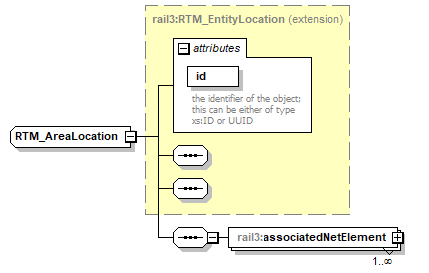 | ||||||||||||||
| namespace | https://www.railml.org/schemas/3.1 | ||||||||||||||
| type | extension of rail3:RTM_EntityLocation | ||||||||||||||
| properties |
| ||||||||||||||
| children | rail3:associatedNetElement | ||||||||||||||
| used by |
| ||||||||||||||
| attributes |
| ||||||||||||||
| source | <xs:complexType name="RTM_AreaLocation"> <xs:complexContent> <xs:extension base="rail3:RTM_EntityLocation"> <xs:sequence> <xs:element name="associatedNetElement" type="rail3:RTM_AssociatedNetElement" minOccurs="1" maxOccurs="unbounded"/> </xs:sequence> </xs:extension> </xs:complexContent> </xs:complexType> |
element RTM_AreaLocation/associatedNetElement
| diagram | 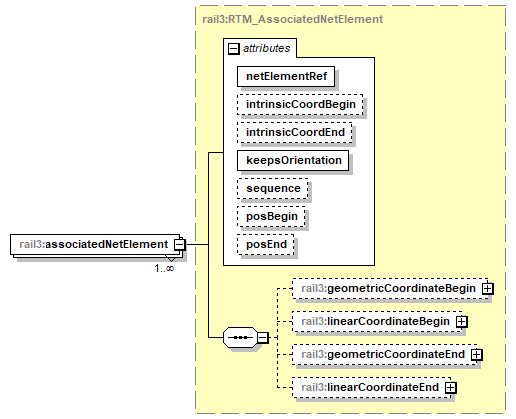 | ||||||||||||||||||||||||||||||||||||||||||||||||
| namespace | https://www.railml.org/schemas/3.1 | ||||||||||||||||||||||||||||||||||||||||||||||||
| type | rail3:RTM_AssociatedNetElement | ||||||||||||||||||||||||||||||||||||||||||||||||
| properties |
| ||||||||||||||||||||||||||||||||||||||||||||||||
| children | rail3:geometricCoordinateBegin rail3:linearCoordinateBegin rail3:geometricCoordinateEnd rail3:linearCoordinateEnd | ||||||||||||||||||||||||||||||||||||||||||||||||
| attributes |
| ||||||||||||||||||||||||||||||||||||||||||||||||
| source | <xs:element name="associatedNetElement" type="rail3:RTM_AssociatedNetElement" minOccurs="1" maxOccurs="unbounded"/> |
complexType RTM_AssociatedNetElement
| diagram | 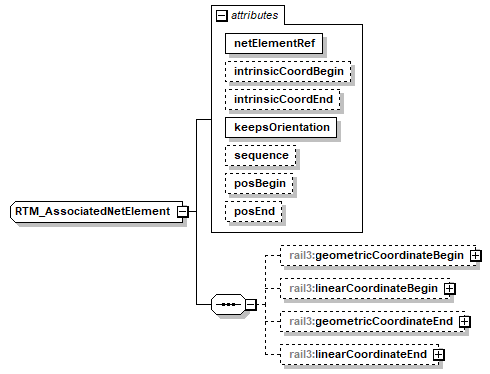 | ||||||||||||||||||||||||||||||||||||||||||||||||
| namespace | https://www.railml.org/schemas/3.1 | ||||||||||||||||||||||||||||||||||||||||||||||||
| children | rail3:geometricCoordinateBegin rail3:linearCoordinateBegin rail3:geometricCoordinateEnd rail3:linearCoordinateEnd | ||||||||||||||||||||||||||||||||||||||||||||||||
| used by |
| ||||||||||||||||||||||||||||||||||||||||||||||||
| attributes |
| ||||||||||||||||||||||||||||||||||||||||||||||||
| source | <xs:complexType name="RTM_AssociatedNetElement"> <xs:sequence> <xs:element name="geometricCoordinateBegin" type="rail3:RTM_GeometricCoordinate" minOccurs="0" maxOccurs="1"/> <xs:element name="linearCoordinateBegin" type="rail3:RTM_LinearCoordinate" minOccurs="0" maxOccurs="1"/> <xs:element name="geometricCoordinateEnd" type="rail3:RTM_GeometricCoordinate" minOccurs="0" maxOccurs="1"/> <xs:element name="linearCoordinateEnd" type="rail3:RTM_LinearCoordinate" minOccurs="0" maxOccurs="1"/> </xs:sequence> <xs:attribute name="netElementRef" type="rail3:tRef" use="required"/> <xs:attribute name="intrinsicCoordBegin" type="xs:double" use="optional"/> <xs:attribute name="intrinsicCoordEnd" type="xs:double" use="optional"/> <xs:attribute name="keepsOrientation" type="xs:boolean" use="required"/> <xs:attribute name="sequence" type="xs:int" use="optional"/> <xs:attribute name="posBegin" type="rail3:tLengthM" use="optional"/> <xs:attribute name="posEnd" type="rail3:tLengthM" use="optional"/> </xs:complexType> |
attribute RTM_AssociatedNetElement/@netElementRef
| type | rail3:tRef | ||
| properties |
| ||
| source | <xs:attribute name="netElementRef" type="rail3:tRef" use="required"/> |
attribute RTM_AssociatedNetElement/@intrinsicCoordBegin
| type | xs:double | ||
| properties |
| ||
| source | <xs:attribute name="intrinsicCoordBegin" type="xs:double" use="optional"/> |
attribute RTM_AssociatedNetElement/@intrinsicCoordEnd
| type | xs:double | ||
| properties |
| ||
| source | <xs:attribute name="intrinsicCoordEnd" type="xs:double" use="optional"/> |
attribute RTM_AssociatedNetElement/@keepsOrientation
| type | xs:boolean | ||
| properties |
| ||
| source | <xs:attribute name="keepsOrientation" type="xs:boolean" use="required"/> |
attribute RTM_AssociatedNetElement/@sequence
| type | xs:int | ||
| properties |
| ||
| source | <xs:attribute name="sequence" type="xs:int" use="optional"/> |
attribute RTM_AssociatedNetElement/@posBegin
| type | rail3:tLengthM | ||
| properties |
| ||
| source | <xs:attribute name="posBegin" type="rail3:tLengthM" use="optional"/> |
attribute RTM_AssociatedNetElement/@posEnd
| type | rail3:tLengthM | ||
| properties |
| ||
| source | <xs:attribute name="posEnd" type="rail3:tLengthM" use="optional"/> |
element RTM_AssociatedNetElement/geometricCoordinateBegin
| diagram | 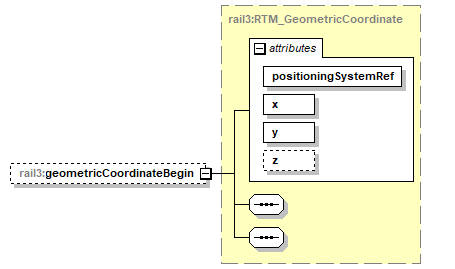 | ||||||||||||||||||||||||||||||
| namespace | https://www.railml.org/schemas/3.1 | ||||||||||||||||||||||||||||||
| type | rail3:RTM_GeometricCoordinate | ||||||||||||||||||||||||||||||
| properties |
| ||||||||||||||||||||||||||||||
| attributes |
| ||||||||||||||||||||||||||||||
| source | <xs:element name="geometricCoordinateBegin" type="rail3:RTM_GeometricCoordinate" minOccurs="0" maxOccurs="1"/> |
element RTM_AssociatedNetElement/linearCoordinateBegin
| diagram | 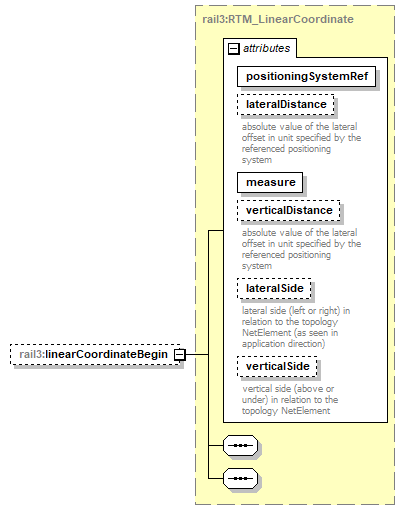 | ||||||||||||||||||||||||||||||||||||||||||||||||||
| namespace | https://www.railml.org/schemas/3.1 | ||||||||||||||||||||||||||||||||||||||||||||||||||
| type | rail3:RTM_LinearCoordinate | ||||||||||||||||||||||||||||||||||||||||||||||||||
| properties |
| ||||||||||||||||||||||||||||||||||||||||||||||||||
| attributes |
| ||||||||||||||||||||||||||||||||||||||||||||||||||
| source | <xs:element name="linearCoordinateBegin" type="rail3:RTM_LinearCoordinate" minOccurs="0" maxOccurs="1"/> |
element RTM_AssociatedNetElement/geometricCoordinateEnd
| diagram | 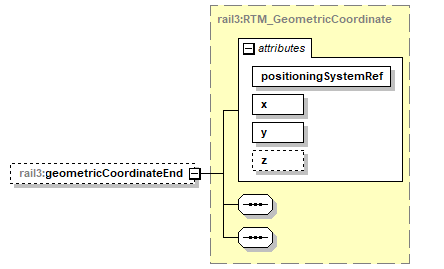 | ||||||||||||||||||||||||||||||
| namespace | https://www.railml.org/schemas/3.1 | ||||||||||||||||||||||||||||||
| type | rail3:RTM_GeometricCoordinate | ||||||||||||||||||||||||||||||
| properties |
| ||||||||||||||||||||||||||||||
| attributes |
| ||||||||||||||||||||||||||||||
| source | <xs:element name="geometricCoordinateEnd" type="rail3:RTM_GeometricCoordinate" minOccurs="0" maxOccurs="1"/> |
element RTM_AssociatedNetElement/linearCoordinateEnd
| diagram | 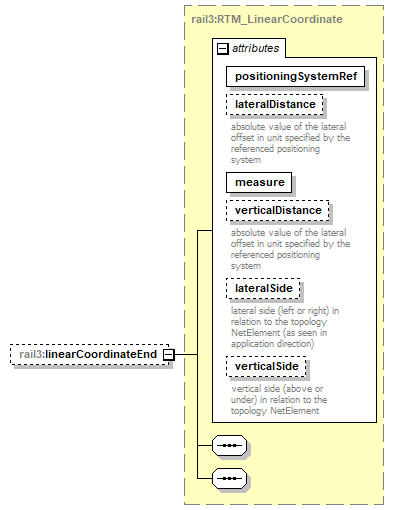 | ||||||||||||||||||||||||||||||||||||||||||||||||||
| namespace | https://www.railml.org/schemas/3.1 | ||||||||||||||||||||||||||||||||||||||||||||||||||
| type | rail3:RTM_LinearCoordinate | ||||||||||||||||||||||||||||||||||||||||||||||||||
| properties |
| ||||||||||||||||||||||||||||||||||||||||||||||||||
| attributes |
| ||||||||||||||||||||||||||||||||||||||||||||||||||
| source | <xs:element name="linearCoordinateEnd" type="rail3:RTM_LinearCoordinate" minOccurs="0" maxOccurs="1"/> |
complexType RTM_AssociatedPositioningSystem
| diagram | 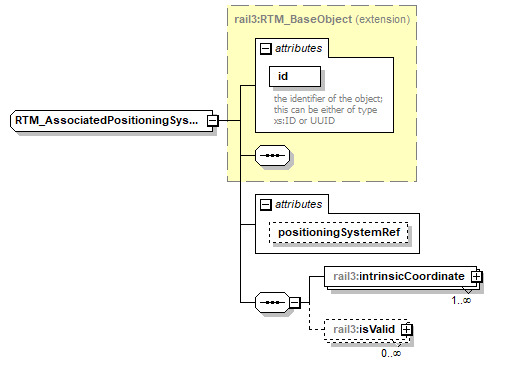 | ||||||||||||||||||||
| namespace | https://www.railml.org/schemas/3.1 | ||||||||||||||||||||
| type | extension of rail3:RTM_BaseObject | ||||||||||||||||||||
| properties |
| ||||||||||||||||||||
| children | rail3:intrinsicCoordinate rail3:isValid | ||||||||||||||||||||
| used by |
| ||||||||||||||||||||
| attributes |
| ||||||||||||||||||||
| source | <xs:complexType name="RTM_AssociatedPositioningSystem"> <xs:complexContent> <xs:extension base="rail3:RTM_BaseObject"> <xs:sequence> <xs:element name="intrinsicCoordinate" type="rail3:RTM_IntrinsicCoordinate" minOccurs="1" maxOccurs="unbounded"/> <xs:element name="isValid" type="rail3:RTM_Validity" minOccurs="0" maxOccurs="unbounded"/> </xs:sequence> <xs:attribute name="positioningSystemRef" type="rail3:tRef" use="optional"/> </xs:extension> </xs:complexContent> </xs:complexType> |
attribute RTM_AssociatedPositioningSystem/@positioningSystemRef
| type | rail3:tRef | ||
| properties |
| ||
| source | <xs:attribute name="positioningSystemRef" type="rail3:tRef" use="optional"/> |
element RTM_AssociatedPositioningSystem/intrinsicCoordinate
| diagram | 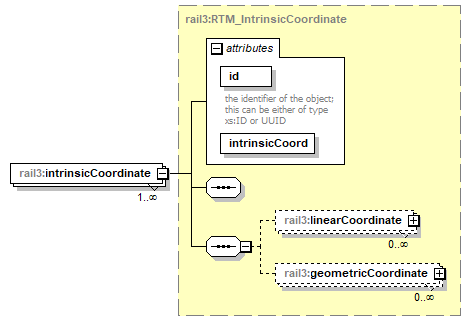 | ||||||||||||||||||||
| namespace | https://www.railml.org/schemas/3.1 | ||||||||||||||||||||
| type | rail3:RTM_IntrinsicCoordinate | ||||||||||||||||||||
| properties |
| ||||||||||||||||||||
| children | rail3:linearCoordinate rail3:geometricCoordinate | ||||||||||||||||||||
| attributes |
| ||||||||||||||||||||
| source | <xs:element name="intrinsicCoordinate" type="rail3:RTM_IntrinsicCoordinate" minOccurs="1" maxOccurs="unbounded"/> |
element RTM_AssociatedPositioningSystem/isValid
| diagram | 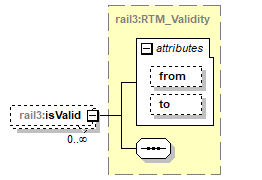 | ||||||||||||||||||
| namespace | https://www.railml.org/schemas/3.1 | ||||||||||||||||||
| type | rail3:RTM_Validity | ||||||||||||||||||
| properties |
| ||||||||||||||||||
| attributes |
| ||||||||||||||||||
| source | <xs:element name="isValid" type="rail3:RTM_Validity" minOccurs="0" maxOccurs="unbounded"/> |
complexType RTM_BaseObject
| diagram | 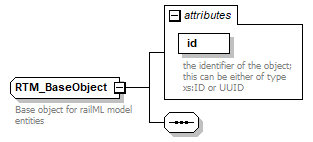 | ||||||||||||||
| namespace | https://www.railml.org/schemas/3.1 | ||||||||||||||
| properties |
| ||||||||||||||
| used by |
| ||||||||||||||
| attributes |
| ||||||||||||||
| annotation |
| ||||||||||||||
| source | <xs:complexType name="RTM_BaseObject" abstract="true"> <xs:annotation> <xs:documentation>Base object for railML model entities</xs:documentation> </xs:annotation> <xs:sequence/> <xs:attribute name="id" type="rail3:tID" use="required"> <xs:annotation> <xs:documentation>the identifier of the object; this can be either of type xs:ID or UUID</xs:documentation> </xs:annotation> </xs:attribute> </xs:complexType> |
attribute RTM_BaseObject/@id
| type | rail3:tID | ||
| properties |
| ||
| annotation |
| ||
| source | <xs:attribute name="id" type="rail3:tID" use="required"> <xs:annotation> <xs:documentation>the identifier of the object; this can be either of type xs:ID or UUID</xs:documentation> </xs:annotation> </xs:attribute> |
complexType RTM_CompositionNetElement
| diagram | 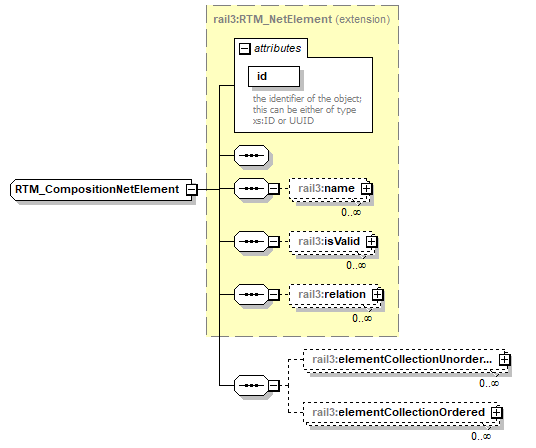 | ||||||||||||||
| namespace | https://www.railml.org/schemas/3.1 | ||||||||||||||
| type | extension of rail3:RTM_NetElement | ||||||||||||||
| properties |
| ||||||||||||||
| children | rail3:name rail3:isValid rail3:relation rail3:elementCollectionUnordered rail3:elementCollectionOrdered | ||||||||||||||
| used by |
| ||||||||||||||
| attributes |
| ||||||||||||||
| source | <xs:complexType name="RTM_CompositionNetElement"> <xs:complexContent> <xs:extension base="rail3:RTM_NetElement"> <xs:sequence> <xs:element name="elementCollectionUnordered" type="rail3:RTM_UnorderedCollection" minOccurs="0" maxOccurs="unbounded"/> <xs:element name="elementCollectionOrdered" type="rail3:RTM_OrderedCollection" minOccurs="0" maxOccurs="unbounded"/> </xs:sequence> </xs:extension> </xs:complexContent> </xs:complexType> |
element RTM_CompositionNetElement/elementCollectionUnordered
| diagram | 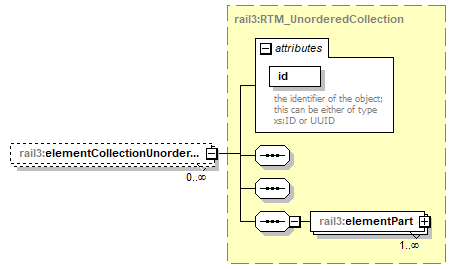 | ||||||||||||||
| namespace | https://www.railml.org/schemas/3.1 | ||||||||||||||
| type | rail3:RTM_UnorderedCollection | ||||||||||||||
| properties |
| ||||||||||||||
| children | rail3:elementPart | ||||||||||||||
| attributes |
| ||||||||||||||
| source | <xs:element name="elementCollectionUnordered" type="rail3:RTM_UnorderedCollection" minOccurs="0" maxOccurs="unbounded"/> |
element RTM_CompositionNetElement/elementCollectionOrdered
| diagram | 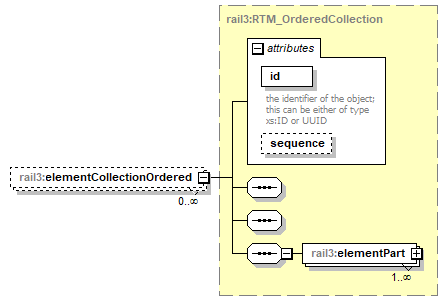 | ||||||||||||||||||||
| namespace | https://www.railml.org/schemas/3.1 | ||||||||||||||||||||
| type | rail3:RTM_OrderedCollection | ||||||||||||||||||||
| properties |
| ||||||||||||||||||||
| children | rail3:elementPart | ||||||||||||||||||||
| attributes |
| ||||||||||||||||||||
| source | <xs:element name="elementCollectionOrdered" type="rail3:RTM_OrderedCollection" minOccurs="0" maxOccurs="unbounded"/> |
complexType RTM_ElementPartCollection
| diagram | 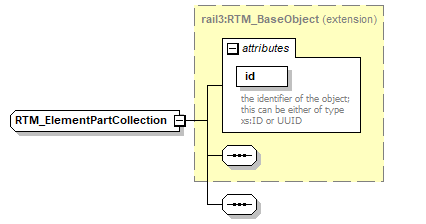 | ||||||||||||||
| namespace | https://www.railml.org/schemas/3.1 | ||||||||||||||
| type | extension of rail3:RTM_BaseObject | ||||||||||||||
| properties |
| ||||||||||||||
| used by |
| ||||||||||||||
| attributes |
| ||||||||||||||
| source | <xs:complexType name="RTM_ElementPartCollection" abstract="true"> <xs:complexContent> <xs:extension base="rail3:RTM_BaseObject"> <xs:sequence/> </xs:extension> </xs:complexContent> </xs:complexType> |
complexType RTM_EntityLocation
| diagram | 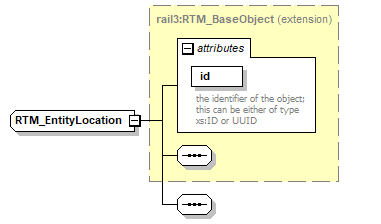 | ||||||||||||||
| namespace | https://www.railml.org/schemas/3.1 | ||||||||||||||
| type | extension of rail3:RTM_BaseObject | ||||||||||||||
| properties |
| ||||||||||||||
| used by |
| ||||||||||||||
| attributes |
| ||||||||||||||
| source | <xs:complexType name="RTM_EntityLocation" abstract="true"> <xs:complexContent> <xs:extension base="rail3:RTM_BaseObject"> <xs:sequence/> </xs:extension> </xs:complexContent> </xs:complexType> |
complexType RTM_GeometricCoordinate
| diagram | 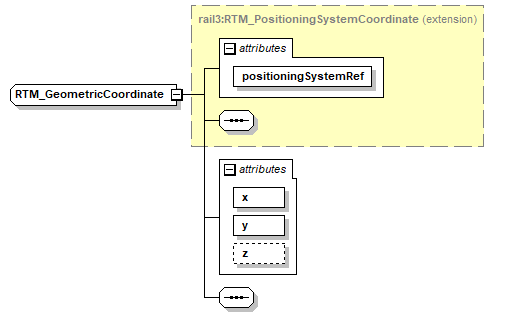 | ||||||||||||||||||||||||||||||
| namespace | https://www.railml.org/schemas/3.1 | ||||||||||||||||||||||||||||||
| type | extension of rail3:RTM_PositioningSystemCoordinate | ||||||||||||||||||||||||||||||
| properties |
| ||||||||||||||||||||||||||||||
| used by |
| ||||||||||||||||||||||||||||||
| attributes |
| ||||||||||||||||||||||||||||||
| source | <xs:complexType name="RTM_GeometricCoordinate"> <xs:complexContent> <xs:extension base="rail3:RTM_PositioningSystemCoordinate"> <xs:sequence/> <xs:attribute name="x" type="xs:double" use="required"/> <xs:attribute name="y" type="xs:double" use="required"/> <xs:attribute name="z" type="xs:double" use="optional"/> </xs:extension> </xs:complexContent> </xs:complexType> |
attribute RTM_GeometricCoordinate/@x
| type | xs:double | ||
| properties |
| ||
| source | <xs:attribute name="x" type="xs:double" use="required"/> |
attribute RTM_GeometricCoordinate/@y
| type | xs:double | ||
| properties |
| ||
| source | <xs:attribute name="y" type="xs:double" use="required"/> |
attribute RTM_GeometricCoordinate/@z
| type | xs:double | ||
| properties |
| ||
| source | <xs:attribute name="z" type="xs:double" use="optional"/> |
complexType RTM_GeometricPositioningSystem
| diagram | 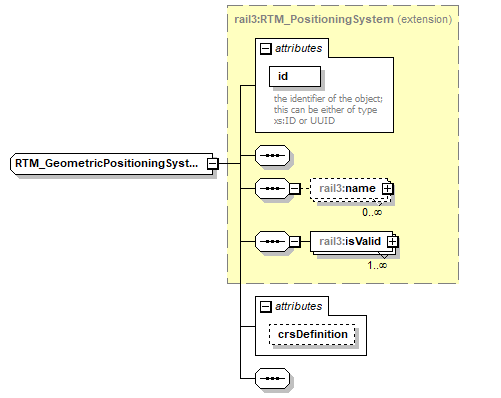 | ||||||||||||||||||||
| namespace | https://www.railml.org/schemas/3.1 | ||||||||||||||||||||
| type | extension of rail3:RTM_PositioningSystem | ||||||||||||||||||||
| properties |
| ||||||||||||||||||||
| children | rail3:name rail3:isValid | ||||||||||||||||||||
| used by |
| ||||||||||||||||||||
| attributes |
| ||||||||||||||||||||
| source | <xs:complexType name="RTM_GeometricPositioningSystem"> <xs:complexContent> <xs:extension base="rail3:RTM_PositioningSystem"> <xs:sequence/> <xs:attribute name="crsDefinition" type="xs:string" use="optional"/> </xs:extension> </xs:complexContent> </xs:complexType> |
attribute RTM_GeometricPositioningSystem/@crsDefinition
| type | xs:string | ||
| properties |
| ||
| source | <xs:attribute name="crsDefinition" type="xs:string" use="optional"/> |
complexType RTM_IntrinsicCoordinate
| diagram | 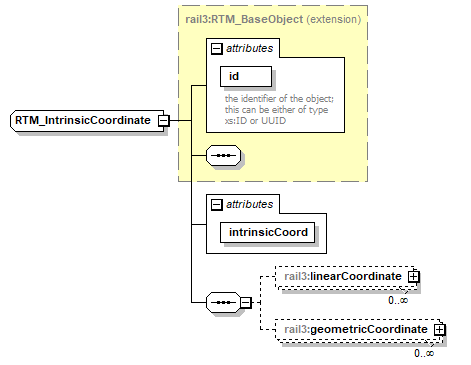 | ||||||||||||||||||||
| namespace | https://www.railml.org/schemas/3.1 | ||||||||||||||||||||
| type | extension of rail3:RTM_BaseObject | ||||||||||||||||||||
| properties |
| ||||||||||||||||||||
| children | rail3:linearCoordinate rail3:geometricCoordinate | ||||||||||||||||||||
| used by |
| ||||||||||||||||||||
| attributes |
| ||||||||||||||||||||
| source | <xs:complexType name="RTM_IntrinsicCoordinate"> <xs:complexContent> <xs:extension base="rail3:RTM_BaseObject"> <xs:sequence> <xs:element name="linearCoordinate" type="rail3:RTM_LinearCoordinate" minOccurs="0" maxOccurs="unbounded"/> <xs:element name="geometricCoordinate" type="rail3:RTM_GeometricCoordinate" minOccurs="0" maxOccurs="unbounded"/> </xs:sequence> <xs:attribute name="intrinsicCoord" type="xs:double" use="required"/> </xs:extension> </xs:complexContent> </xs:complexType> |
attribute RTM_IntrinsicCoordinate/@intrinsicCoord
| type | xs:double | ||
| properties |
| ||
| source | <xs:attribute name="intrinsicCoord" type="xs:double" use="required"/> |
element RTM_IntrinsicCoordinate/linearCoordinate
| diagram | 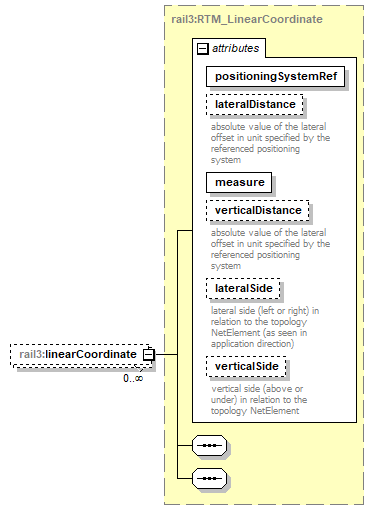 | ||||||||||||||||||||||||||||||||||||||||||||||||||
| namespace | https://www.railml.org/schemas/3.1 | ||||||||||||||||||||||||||||||||||||||||||||||||||
| type | rail3:RTM_LinearCoordinate | ||||||||||||||||||||||||||||||||||||||||||||||||||
| properties |
| ||||||||||||||||||||||||||||||||||||||||||||||||||
| attributes |
| ||||||||||||||||||||||||||||||||||||||||||||||||||
| source | <xs:element name="linearCoordinate" type="rail3:RTM_LinearCoordinate" minOccurs="0" maxOccurs="unbounded"/> |
element RTM_IntrinsicCoordinate/geometricCoordinate
| diagram | 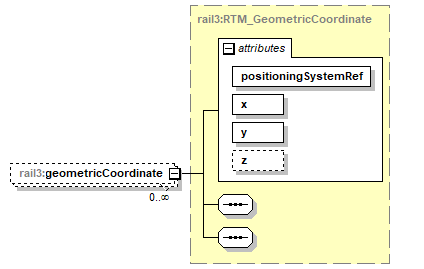 | ||||||||||||||||||||||||||||||
| namespace | https://www.railml.org/schemas/3.1 | ||||||||||||||||||||||||||||||
| type | rail3:RTM_GeometricCoordinate | ||||||||||||||||||||||||||||||
| properties |
| ||||||||||||||||||||||||||||||
| attributes |
| ||||||||||||||||||||||||||||||
| source | <xs:element name="geometricCoordinate" type="rail3:RTM_GeometricCoordinate" minOccurs="0" maxOccurs="unbounded"/> |
complexType RTM_LevelNetwork
| diagram | 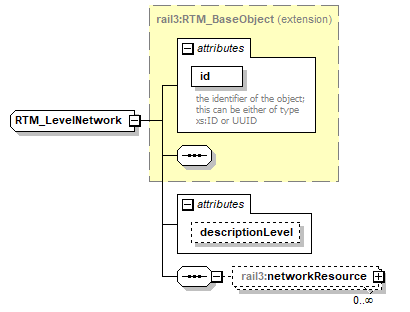 | ||||||||||||||||||||
| namespace | https://www.railml.org/schemas/3.1 | ||||||||||||||||||||
| type | extension of rail3:RTM_BaseObject | ||||||||||||||||||||
| properties |
| ||||||||||||||||||||
| children | rail3:networkResource | ||||||||||||||||||||
| used by |
| ||||||||||||||||||||
| attributes |
| ||||||||||||||||||||
| source | <xs:complexType name="RTM_LevelNetwork"> <xs:complexContent> <xs:extension base="rail3:RTM_BaseObject"> <xs:sequence> <xs:element name="networkResource" type="rail3:tElementWithIDref" minOccurs="0" maxOccurs="unbounded"/> </xs:sequence> <xs:attribute name="descriptionLevel" type="rail3:tDescriptionLevel" use="optional"/> </xs:extension> </xs:complexContent> </xs:complexType> |
attribute RTM_LevelNetwork/@descriptionLevel
| type | rail3:tDescriptionLevel | ||||||||||||
| properties |
| ||||||||||||
| facets |
| ||||||||||||
| source | <xs:attribute name="descriptionLevel" type="rail3:tDescriptionLevel" use="optional"/> |
element RTM_LevelNetwork/networkResource
| diagram | 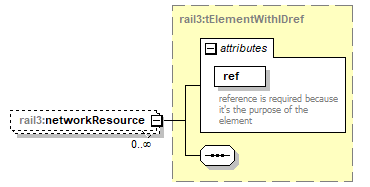 | ||||||||||||||
| namespace | https://www.railml.org/schemas/3.1 | ||||||||||||||
| type | rail3:tElementWithIDref | ||||||||||||||
| properties |
| ||||||||||||||
| attributes |
| ||||||||||||||
| source | <xs:element name="networkResource" type="rail3:tElementWithIDref" minOccurs="0" maxOccurs="unbounded"/> |
complexType RTM_LinearAnchorPoint
| diagram | 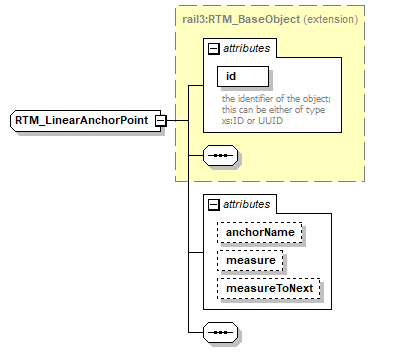 | ||||||||||||||||||||||||||||||||
| namespace | https://www.railml.org/schemas/3.1 | ||||||||||||||||||||||||||||||||
| type | extension of rail3:RTM_BaseObject | ||||||||||||||||||||||||||||||||
| properties |
| ||||||||||||||||||||||||||||||||
| used by |
| ||||||||||||||||||||||||||||||||
| attributes |
| ||||||||||||||||||||||||||||||||
| source | <xs:complexType name="RTM_LinearAnchorPoint"> <xs:complexContent> <xs:extension base="rail3:RTM_BaseObject"> <xs:sequence/> <xs:attribute name="anchorName" type="xs:string" use="optional"/> <xs:attribute name="measure" type="xs:double" use="optional"/> <xs:attribute name="measureToNext" type="xs:double" use="optional"/> </xs:extension> </xs:complexContent> </xs:complexType> |
attribute RTM_LinearAnchorPoint/@anchorName
| type | xs:string | ||
| properties |
| ||
| source | <xs:attribute name="anchorName" type="xs:string" use="optional"/> |
attribute RTM_LinearAnchorPoint/@measure
| type | xs:double | ||
| properties |
| ||
| source | <xs:attribute name="measure" type="xs:double" use="optional"/> |
attribute RTM_LinearAnchorPoint/@measureToNext
| type | xs:double | ||
| properties |
| ||
| source | <xs:attribute name="measureToNext" type="xs:double" use="optional"/> |
complexType RTM_LinearCoordinate
| diagram | 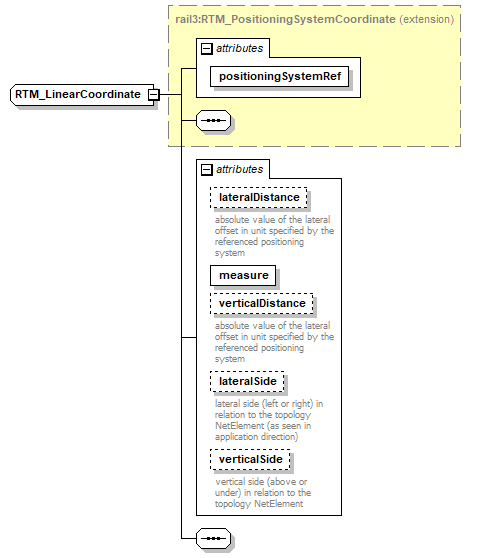 | ||||||||||||||||||||||||||||||||||||||||||||||||||
| namespace | https://www.railml.org/schemas/3.1 | ||||||||||||||||||||||||||||||||||||||||||||||||||
| type | extension of rail3:RTM_PositioningSystemCoordinate | ||||||||||||||||||||||||||||||||||||||||||||||||||
| properties |
| ||||||||||||||||||||||||||||||||||||||||||||||||||
| used by |
| ||||||||||||||||||||||||||||||||||||||||||||||||||
| attributes |
| ||||||||||||||||||||||||||||||||||||||||||||||||||
| source | <xs:complexType name="RTM_LinearCoordinate"> <xs:complexContent> <xs:extension base="rail3:RTM_PositioningSystemCoordinate"> <xs:sequence/> <xs:attribute name="lateralDistance" type="xs:double" use="optional"> <xs:annotation> <xs:documentation>absolute value of the lateral offset in unit specified by the referenced positioning system</xs:documentation> </xs:annotation> </xs:attribute> <xs:attribute name="measure" type="xs:double" use="required"/> <xs:attribute name="verticalDistance" type="xs:double" use="optional"> <xs:annotation> <xs:documentation>absolute value of the lateral offset in unit specified by the referenced positioning system</xs:documentation> </xs:annotation> </xs:attribute> <xs:attribute name="lateralSide" type="rail3:tLateralSide" use="optional"> <xs:annotation> <xs:documentation>lateral side (left or right) in relation to the topology NetElement (as seen in application direction)</xs:documentation> </xs:annotation> </xs:attribute> <xs:attribute name="verticalSide" type="rail3:tVerticalSide" use="optional"> <xs:annotation> <xs:documentation>vertical side (above or under) in relation to the topology NetElement</xs:documentation> </xs:annotation> </xs:attribute> </xs:extension> </xs:complexContent> </xs:complexType> |
attribute RTM_LinearCoordinate/@lateralDistance
| type | xs:double | ||
| properties |
| ||
| annotation |
| ||
| source | <xs:attribute name="lateralDistance" type="xs:double" use="optional"> <xs:annotation> <xs:documentation>absolute value of the lateral offset in unit specified by the referenced positioning system</xs:documentation> </xs:annotation> </xs:attribute> |
attribute RTM_LinearCoordinate/@measure
| type | xs:double | ||
| properties |
| ||
| source | <xs:attribute name="measure" type="xs:double" use="required"/> |
attribute RTM_LinearCoordinate/@verticalDistance
| type | xs:double | ||
| properties |
| ||
| annotation |
| ||
| source | <xs:attribute name="verticalDistance" type="xs:double" use="optional"> <xs:annotation> <xs:documentation>absolute value of the lateral offset in unit specified by the referenced positioning system</xs:documentation> </xs:annotation> </xs:attribute> |
attribute RTM_LinearCoordinate/@lateralSide
| type | rail3:tLateralSide | |||||||||
| properties |
| |||||||||
| facets |
| |||||||||
| annotation |
| |||||||||
| source | <xs:attribute name="lateralSide" type="rail3:tLateralSide" use="optional"> <xs:annotation> <xs:documentation>lateral side (left or right) in relation to the topology NetElement (as seen in application direction)</xs:documentation> </xs:annotation> </xs:attribute> |
attribute RTM_LinearCoordinate/@verticalSide
| type | rail3:tVerticalSide | |||||||||
| properties |
| |||||||||
| facets |
| |||||||||
| annotation |
| |||||||||
| source | <xs:attribute name="verticalSide" type="rail3:tVerticalSide" use="optional"> <xs:annotation> <xs:documentation>vertical side (above or under) in relation to the topology NetElement</xs:documentation> </xs:annotation> </xs:attribute> |
complexType RTM_LinearLocation
| diagram | 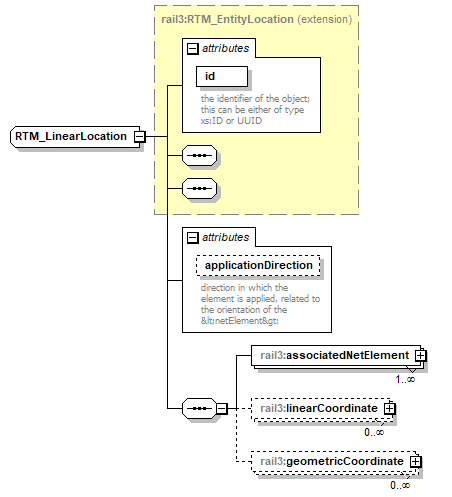 | ||||||||||||||||||||||
| namespace | https://www.railml.org/schemas/3.1 | ||||||||||||||||||||||
| type | extension of rail3:RTM_EntityLocation | ||||||||||||||||||||||
| properties |
| ||||||||||||||||||||||
| children | rail3:associatedNetElement rail3:linearCoordinate rail3:geometricCoordinate | ||||||||||||||||||||||
| used by |
| ||||||||||||||||||||||
| attributes |
| ||||||||||||||||||||||
| source | <xs:complexType name="RTM_LinearLocation"> <xs:complexContent> <xs:extension base="rail3:RTM_EntityLocation"> <xs:sequence> <xs:element name="associatedNetElement" type="rail3:RTM_AssociatedNetElement" minOccurs="1" maxOccurs="unbounded"/> <xs:element name="linearCoordinate" type="rail3:RTM_LinearCoordinate" minOccurs="0" maxOccurs="unbounded"/> <xs:element name="geometricCoordinate" type="rail3:RTM_GeometricCoordinate" minOccurs="0" maxOccurs="unbounded"/> </xs:sequence> <xs:attribute name="applicationDirection" type="rail3:tApplicationDirection" use="optional"> <xs:annotation> <xs:documentation>direction in which the element is applied, related to the orientation of the <netElement></xs:documentation> </xs:annotation> </xs:attribute> </xs:extension> </xs:complexContent> </xs:complexType> |
attribute RTM_LinearLocation/@applicationDirection
| type | rail3:tApplicationDirection | ||||||||||||
| properties |
| ||||||||||||
| facets |
| ||||||||||||
| annotation |
| ||||||||||||
| source | <xs:attribute name="applicationDirection" type="rail3:tApplicationDirection" use="optional"> <xs:annotation> <xs:documentation>direction in which the element is applied, related to the orientation of the <netElement></xs:documentation> </xs:annotation> </xs:attribute> |
element RTM_LinearLocation/associatedNetElement
| diagram | 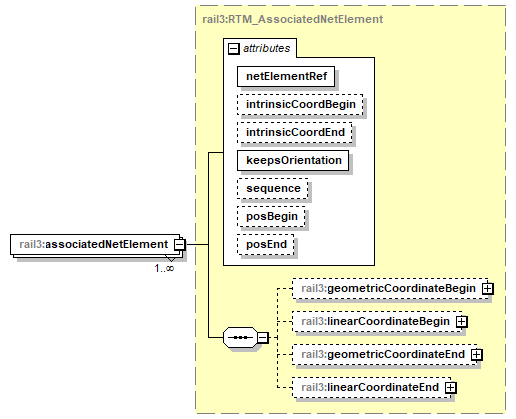 | ||||||||||||||||||||||||||||||||||||||||||||||||
| namespace | https://www.railml.org/schemas/3.1 | ||||||||||||||||||||||||||||||||||||||||||||||||
| type | rail3:RTM_AssociatedNetElement | ||||||||||||||||||||||||||||||||||||||||||||||||
| properties |
| ||||||||||||||||||||||||||||||||||||||||||||||||
| children | rail3:geometricCoordinateBegin rail3:linearCoordinateBegin rail3:geometricCoordinateEnd rail3:linearCoordinateEnd | ||||||||||||||||||||||||||||||||||||||||||||||||
| attributes |
| ||||||||||||||||||||||||||||||||||||||||||||||||
| source | <xs:element name="associatedNetElement" type="rail3:RTM_AssociatedNetElement" minOccurs="1" maxOccurs="unbounded"/> |
element RTM_LinearLocation/linearCoordinate
| diagram | 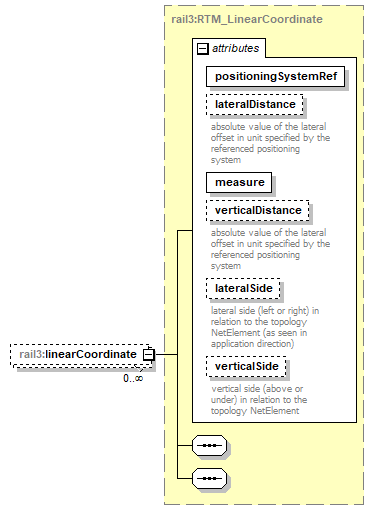 | ||||||||||||||||||||||||||||||||||||||||||||||||||
| namespace | https://www.railml.org/schemas/3.1 | ||||||||||||||||||||||||||||||||||||||||||||||||||
| type | rail3:RTM_LinearCoordinate | ||||||||||||||||||||||||||||||||||||||||||||||||||
| properties |
| ||||||||||||||||||||||||||||||||||||||||||||||||||
| attributes |
| ||||||||||||||||||||||||||||||||||||||||||||||||||
| source | <xs:element name="linearCoordinate" type="rail3:RTM_LinearCoordinate" minOccurs="0" maxOccurs="unbounded"/> |
element RTM_LinearLocation/geometricCoordinate
| diagram | 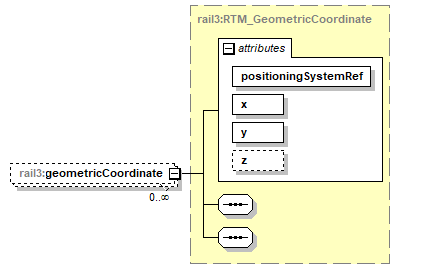 | ||||||||||||||||||||||||||||||
| namespace | https://www.railml.org/schemas/3.1 | ||||||||||||||||||||||||||||||
| type | rail3:RTM_GeometricCoordinate | ||||||||||||||||||||||||||||||
| properties |
| ||||||||||||||||||||||||||||||
| attributes |
| ||||||||||||||||||||||||||||||
| source | <xs:element name="geometricCoordinate" type="rail3:RTM_GeometricCoordinate" minOccurs="0" maxOccurs="unbounded"/> |
complexType RTM_LinearNetElement
| diagram | 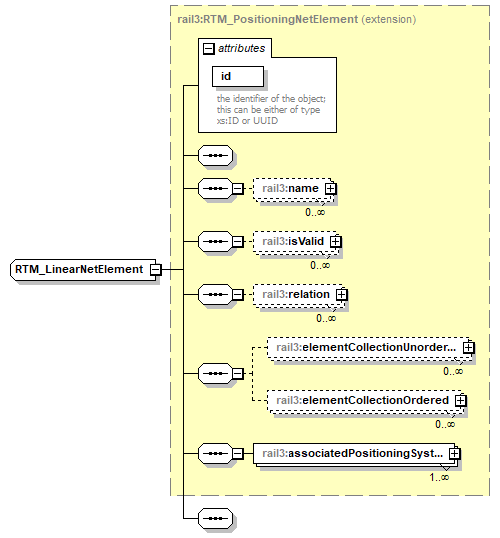 | ||||||||||||||
| namespace | https://www.railml.org/schemas/3.1 | ||||||||||||||
| type | extension of rail3:RTM_PositioningNetElement | ||||||||||||||
| properties |
| ||||||||||||||
| children | rail3:name rail3:isValid rail3:relation rail3:elementCollectionUnordered rail3:elementCollectionOrdered rail3:associatedPositioningSystem | ||||||||||||||
| attributes |
| ||||||||||||||
| source | <xs:complexType name="RTM_LinearNetElement"> <xs:complexContent> <xs:extension base="rail3:RTM_PositioningNetElement"> <xs:sequence/> </xs:extension> </xs:complexContent> </xs:complexType> |
complexType RTM_LinearPositioningSystem
| diagram | 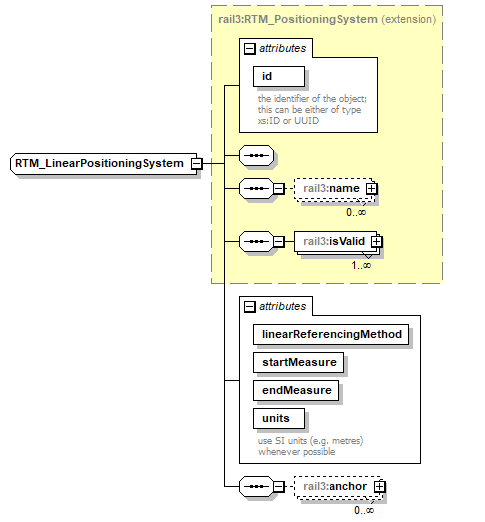 | ||||||||||||||||||||||||||||||||||||||||
| namespace | https://www.railml.org/schemas/3.1 | ||||||||||||||||||||||||||||||||||||||||
| type | extension of rail3:RTM_PositioningSystem | ||||||||||||||||||||||||||||||||||||||||
| properties |
| ||||||||||||||||||||||||||||||||||||||||
| children | rail3:name rail3:isValid rail3:anchor | ||||||||||||||||||||||||||||||||||||||||
| used by |
| ||||||||||||||||||||||||||||||||||||||||
| attributes |
| ||||||||||||||||||||||||||||||||||||||||
| source | <xs:complexType name="RTM_LinearPositioningSystem"> <xs:complexContent> <xs:extension base="rail3:RTM_PositioningSystem"> <xs:sequence> <xs:element name="anchor" type="rail3:RTM_LinearAnchorPoint" minOccurs="0" maxOccurs="unbounded"/> </xs:sequence> <xs:attribute name="linearReferencingMethod" type="rail3:tLrsMethod" use="required"/> <xs:attribute name="startMeasure" type="xs:double" use="required"/> <xs:attribute name="endMeasure" type="xs:double" use="required"/> <xs:attribute name="units" type="xs:string" use="required"> <xs:annotation> <xs:documentation>use SI units (e.g. metres) whenever possible</xs:documentation> </xs:annotation> </xs:attribute> </xs:extension> </xs:complexContent> </xs:complexType> |
attribute RTM_LinearPositioningSystem/@linearReferencingMethod
| type | rail3:tLrsMethod | ||||||||||||
| properties |
| ||||||||||||
| facets |
| ||||||||||||
| source | <xs:attribute name="linearReferencingMethod" type="rail3:tLrsMethod" use="required"/> |
attribute RTM_LinearPositioningSystem/@startMeasure
| type | xs:double | ||
| properties |
| ||
| source | <xs:attribute name="startMeasure" type="xs:double" use="required"/> |
attribute RTM_LinearPositioningSystem/@endMeasure
| type | xs:double | ||
| properties |
| ||
| source | <xs:attribute name="endMeasure" type="xs:double" use="required"/> |
attribute RTM_LinearPositioningSystem/@units
| type | xs:string | ||
| properties |
| ||
| annotation |
| ||
| source | <xs:attribute name="units" type="xs:string" use="required"> <xs:annotation> <xs:documentation>use SI units (e.g. metres) whenever possible</xs:documentation> </xs:annotation> </xs:attribute> |
element RTM_LinearPositioningSystem/anchor
| diagram | 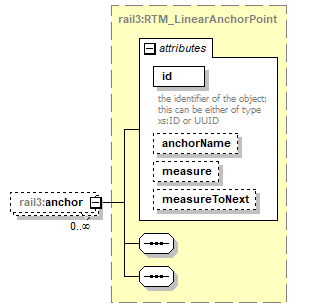 | ||||||||||||||||||||||||||||||||
| namespace | https://www.railml.org/schemas/3.1 | ||||||||||||||||||||||||||||||||
| type | rail3:RTM_LinearAnchorPoint | ||||||||||||||||||||||||||||||||
| properties |
| ||||||||||||||||||||||||||||||||
| attributes |
| ||||||||||||||||||||||||||||||||
| source | <xs:element name="anchor" type="rail3:RTM_LinearAnchorPoint" minOccurs="0" maxOccurs="unbounded"/> |
complexType RTM_LocatedNetEntity
| diagram | 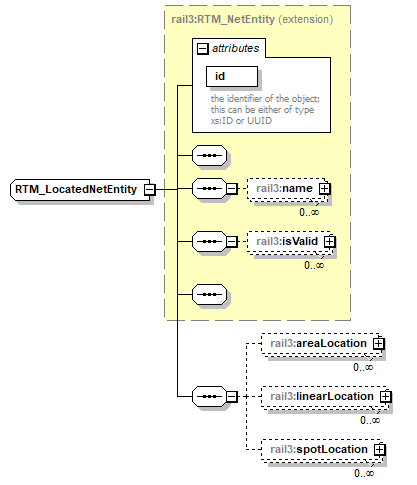 | ||||||||||||||
| namespace | https://www.railml.org/schemas/3.1 | ||||||||||||||
| type | extension of rail3:RTM_NetEntity | ||||||||||||||
| properties |
| ||||||||||||||
| children | rail3:name rail3:isValid rail3:areaLocation rail3:linearLocation rail3:spotLocation | ||||||||||||||
| used by |
| ||||||||||||||
| attributes |
| ||||||||||||||
| source | <xs:complexType name="RTM_LocatedNetEntity"> <xs:complexContent> <xs:extension base="rail3:RTM_NetEntity"> <xs:sequence> <xs:element name="areaLocation" type="rail3:RTM_AreaLocation" minOccurs="0" maxOccurs="unbounded"/> <xs:element name="linearLocation" type="rail3:RTM_LinearLocation" minOccurs="0" maxOccurs="unbounded"/> <xs:element name="spotLocation" type="rail3:RTM_SpotLocation" minOccurs="0" maxOccurs="unbounded"/> </xs:sequence> </xs:extension> </xs:complexContent> </xs:complexType> |
element RTM_LocatedNetEntity/areaLocation
| diagram | 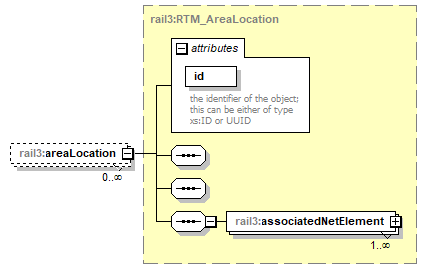 | ||||||||||||||
| namespace | https://www.railml.org/schemas/3.1 | ||||||||||||||
| type | rail3:RTM_AreaLocation | ||||||||||||||
| properties |
| ||||||||||||||
| children | rail3:associatedNetElement | ||||||||||||||
| attributes |
| ||||||||||||||
| source | <xs:element name="areaLocation" type="rail3:RTM_AreaLocation" minOccurs="0" maxOccurs="unbounded"/> |
element RTM_LocatedNetEntity/linearLocation
| diagram | 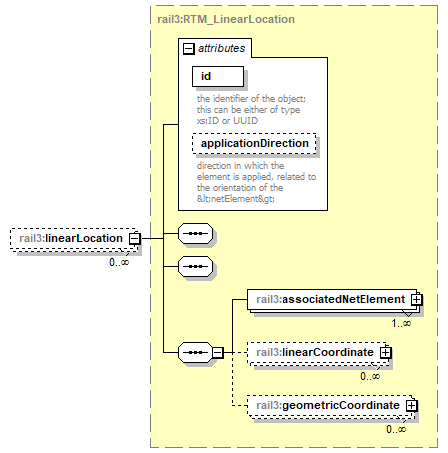 | ||||||||||||||||||||||
| namespace | https://www.railml.org/schemas/3.1 | ||||||||||||||||||||||
| type | rail3:RTM_LinearLocation | ||||||||||||||||||||||
| properties |
| ||||||||||||||||||||||
| children | rail3:associatedNetElement rail3:linearCoordinate rail3:geometricCoordinate | ||||||||||||||||||||||
| attributes |
| ||||||||||||||||||||||
| source | <xs:element name="linearLocation" type="rail3:RTM_LinearLocation" minOccurs="0" maxOccurs="unbounded"/> |
element RTM_LocatedNetEntity/spotLocation
| diagram | 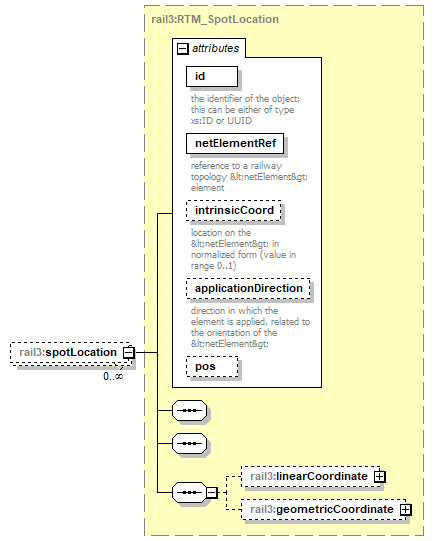 | ||||||||||||||||||||||||||||||||||||||||||||
| namespace | https://www.railml.org/schemas/3.1 | ||||||||||||||||||||||||||||||||||||||||||||
| type | rail3:RTM_SpotLocation | ||||||||||||||||||||||||||||||||||||||||||||
| properties |
| ||||||||||||||||||||||||||||||||||||||||||||
| children | rail3:linearCoordinate rail3:geometricCoordinate | ||||||||||||||||||||||||||||||||||||||||||||
| attributes |
| ||||||||||||||||||||||||||||||||||||||||||||
| source | <xs:element name="spotLocation" type="rail3:RTM_SpotLocation" minOccurs="0" maxOccurs="unbounded"/> |
complexType RTM_NamedResource
| diagram | 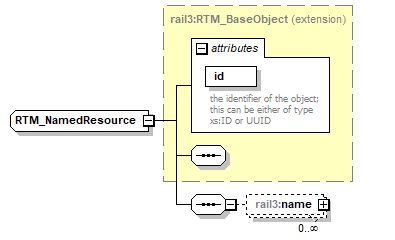 | ||||||||||||||
| namespace | https://www.railml.org/schemas/3.1 | ||||||||||||||
| type | extension of rail3:RTM_BaseObject | ||||||||||||||
| properties |
| ||||||||||||||
| children | rail3:name | ||||||||||||||
| used by |
| ||||||||||||||
| attributes |
| ||||||||||||||
| source | <xs:complexType name="RTM_NamedResource"> <xs:complexContent> <xs:extension base="rail3:RTM_BaseObject"> <xs:sequence> <xs:element name="name" type="rail3:Name" minOccurs="0" maxOccurs="unbounded"/> </xs:sequence> </xs:extension> </xs:complexContent> </xs:complexType> |
element RTM_NamedResource/name
| diagram | 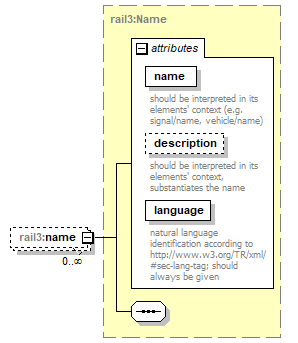 | ||||||||||||||||||||||||||||||
| namespace | https://www.railml.org/schemas/3.1 | ||||||||||||||||||||||||||||||
| type | rail3:Name | ||||||||||||||||||||||||||||||
| properties |
| ||||||||||||||||||||||||||||||
| attributes |
| ||||||||||||||||||||||||||||||
| source | <xs:element name="name" type="rail3:Name" minOccurs="0" maxOccurs="unbounded"/> |
complexType RTM_NetElement
| diagram | 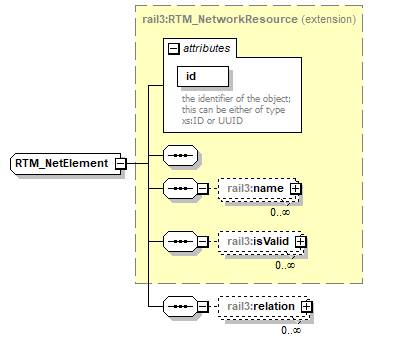 | ||||||||||||||
| namespace | https://www.railml.org/schemas/3.1 | ||||||||||||||
| type | extension of rail3:RTM_NetworkResource | ||||||||||||||
| properties |
| ||||||||||||||
| children | rail3:name rail3:isValid rail3:relation | ||||||||||||||
| used by |
| ||||||||||||||
| attributes |
| ||||||||||||||
| source | <xs:complexType name="RTM_NetElement"> <xs:complexContent> <xs:extension base="rail3:RTM_NetworkResource"> <xs:sequence> <xs:element name="relation" type="rail3:tElementWithIDref" form="qualified" minOccurs="0" maxOccurs="unbounded"/> </xs:sequence> </xs:extension> </xs:complexContent> </xs:complexType> |
element RTM_NetElement/relation
| diagram | 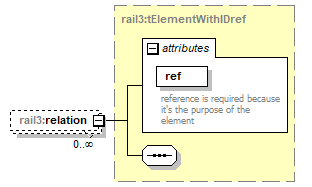 | ||||||||||||||
| namespace | https://www.railml.org/schemas/3.1 | ||||||||||||||
| type | rail3:tElementWithIDref | ||||||||||||||
| properties |
| ||||||||||||||
| attributes |
| ||||||||||||||
| source | <xs:element name="relation" type="rail3:tElementWithIDref" form="qualified" minOccurs="0" maxOccurs="unbounded"/> |
complexType RTM_NetEntity
| diagram | 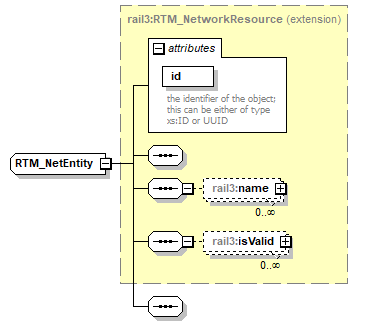 | ||||||||||||||
| namespace | https://www.railml.org/schemas/3.1 | ||||||||||||||
| type | extension of rail3:RTM_NetworkResource | ||||||||||||||
| properties |
| ||||||||||||||
| children | rail3:name rail3:isValid | ||||||||||||||
| used by |
| ||||||||||||||
| attributes |
| ||||||||||||||
| source | <xs:complexType name="RTM_NetEntity"> <xs:complexContent> <xs:extension base="rail3:RTM_NetworkResource"> <xs:sequence/> </xs:extension> </xs:complexContent> </xs:complexType> |
complexType RTM_Network
| diagram | 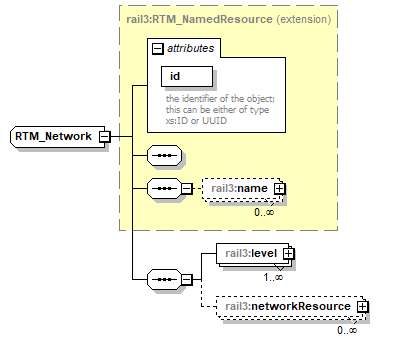 | ||||||||||||||
| namespace | https://www.railml.org/schemas/3.1 | ||||||||||||||
| type | extension of rail3:RTM_NamedResource | ||||||||||||||
| properties |
| ||||||||||||||
| children | rail3:name rail3:level rail3:networkResource | ||||||||||||||
| used by |
| ||||||||||||||
| attributes |
| ||||||||||||||
| source | <xs:complexType name="RTM_Network" abstract="true"> <xs:complexContent> <xs:extension base="rail3:RTM_NamedResource"> <xs:sequence> <xs:element name="level" type="rail3:RTM_LevelNetwork" minOccurs="1" maxOccurs="unbounded"/> <xs:element name="networkResource" type="rail3:RTM_NetworkResource" minOccurs="0" maxOccurs="unbounded"/> </xs:sequence> </xs:extension> </xs:complexContent> </xs:complexType> |
element RTM_Network/level
| diagram | 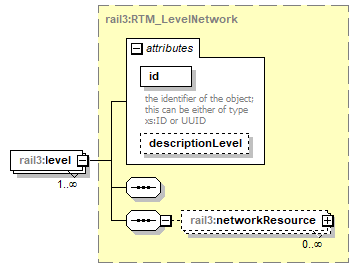 | ||||||||||||||||||||
| namespace | https://www.railml.org/schemas/3.1 | ||||||||||||||||||||
| type | rail3:RTM_LevelNetwork | ||||||||||||||||||||
| properties |
| ||||||||||||||||||||
| children | rail3:networkResource | ||||||||||||||||||||
| attributes |
| ||||||||||||||||||||
| source | <xs:element name="level" type="rail3:RTM_LevelNetwork" minOccurs="1" maxOccurs="unbounded"/> |
element RTM_Network/networkResource
| diagram | 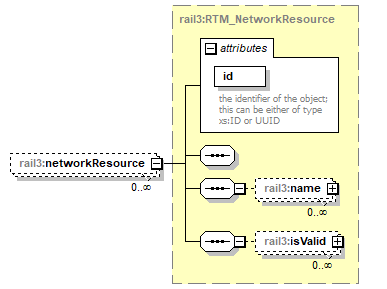 | ||||||||||||||
| namespace | https://www.railml.org/schemas/3.1 | ||||||||||||||
| type | rail3:RTM_NetworkResource | ||||||||||||||
| properties |
| ||||||||||||||
| children | rail3:name rail3:isValid | ||||||||||||||
| attributes |
| ||||||||||||||
| source | <xs:element name="networkResource" type="rail3:RTM_NetworkResource" minOccurs="0" maxOccurs="unbounded"/> |
complexType RTM_NetworkResource
| diagram | 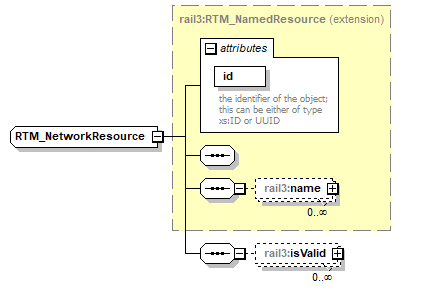 | ||||||||||||||
| namespace | https://www.railml.org/schemas/3.1 | ||||||||||||||
| type | extension of rail3:RTM_NamedResource | ||||||||||||||
| properties |
| ||||||||||||||
| children | rail3:name rail3:isValid | ||||||||||||||
| used by |
| ||||||||||||||
| attributes |
| ||||||||||||||
| source | <xs:complexType name="RTM_NetworkResource"> <xs:complexContent> <xs:extension base="rail3:RTM_NamedResource"> <xs:sequence> <xs:element name="isValid" type="rail3:RTM_Validity" minOccurs="0" maxOccurs="unbounded"/> </xs:sequence> </xs:extension> </xs:complexContent> </xs:complexType> |
element RTM_NetworkResource/isValid
| diagram | 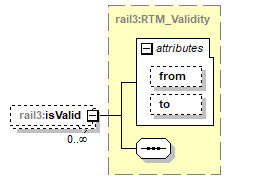 | ||||||||||||||||||
| namespace | https://www.railml.org/schemas/3.1 | ||||||||||||||||||
| type | rail3:RTM_Validity | ||||||||||||||||||
| properties |
| ||||||||||||||||||
| attributes |
| ||||||||||||||||||
| source | <xs:element name="isValid" type="rail3:RTM_Validity" minOccurs="0" maxOccurs="unbounded"/> |
complexType RTM_NonLinearNetElement
| diagram | 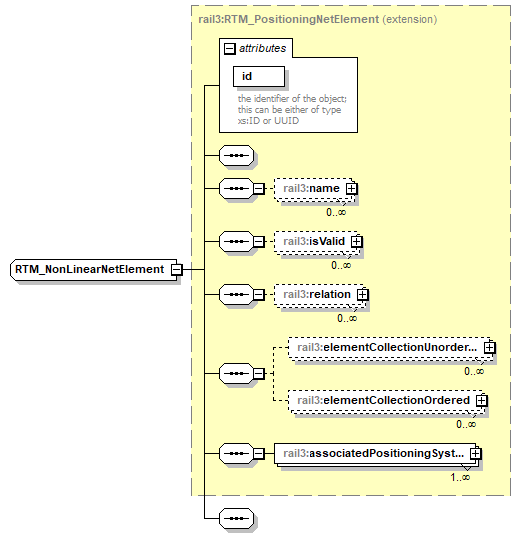 | ||||||||||||||
| namespace | https://www.railml.org/schemas/3.1 | ||||||||||||||
| type | extension of rail3:RTM_PositioningNetElement | ||||||||||||||
| properties |
| ||||||||||||||
| children | rail3:name rail3:isValid rail3:relation rail3:elementCollectionUnordered rail3:elementCollectionOrdered rail3:associatedPositioningSystem | ||||||||||||||
| attributes |
| ||||||||||||||
| source | <xs:complexType name="RTM_NonLinearNetElement"> <xs:complexContent> <xs:extension base="rail3:RTM_PositioningNetElement"> <xs:sequence/> </xs:extension> </xs:complexContent> </xs:complexType> |
complexType RTM_OrderedCollection
| diagram | 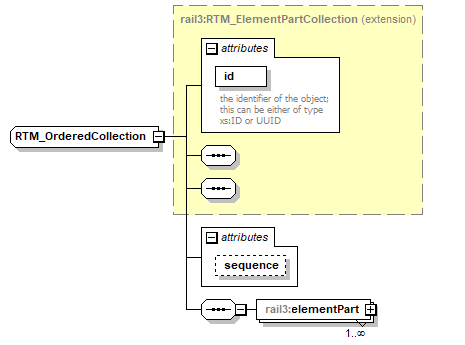 | ||||||||||||||||||||
| namespace | https://www.railml.org/schemas/3.1 | ||||||||||||||||||||
| type | extension of rail3:RTM_ElementPartCollection | ||||||||||||||||||||
| properties |
| ||||||||||||||||||||
| children | rail3:elementPart | ||||||||||||||||||||
| used by |
| ||||||||||||||||||||
| attributes |
| ||||||||||||||||||||
| source | <xs:complexType name="RTM_OrderedCollection"> <xs:complexContent> <xs:extension base="rail3:RTM_ElementPartCollection"> <xs:sequence> <xs:element name="elementPart" type="rail3:tElementWithIDref" minOccurs="1" maxOccurs="unbounded"/> </xs:sequence> <xs:attribute name="sequence" type="xs:integer" use="optional"/> </xs:extension> </xs:complexContent> </xs:complexType> |
attribute RTM_OrderedCollection/@sequence
| type | xs:integer | ||
| properties |
| ||
| source | <xs:attribute name="sequence" type="xs:integer" use="optional"/> |
element RTM_OrderedCollection/elementPart
| diagram | 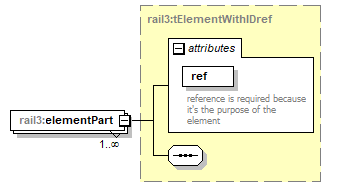 | ||||||||||||||
| namespace | https://www.railml.org/schemas/3.1 | ||||||||||||||
| type | rail3:tElementWithIDref | ||||||||||||||
| properties |
| ||||||||||||||
| attributes |
| ||||||||||||||
| source | <xs:element name="elementPart" type="rail3:tElementWithIDref" minOccurs="1" maxOccurs="unbounded"/> |
complexType RTM_PositioningNetElement
| diagram | 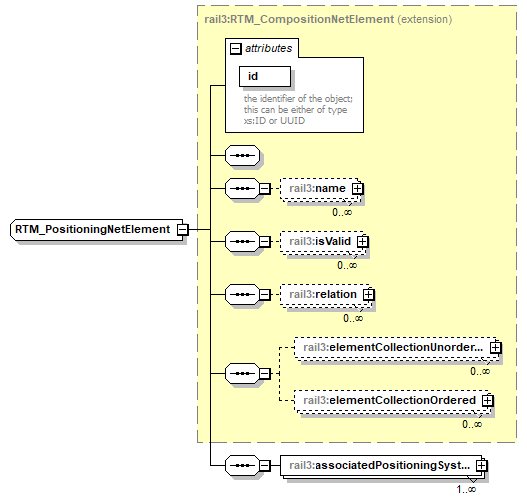 | ||||||||||||||
| namespace | https://www.railml.org/schemas/3.1 | ||||||||||||||
| type | extension of rail3:RTM_CompositionNetElement | ||||||||||||||
| properties |
| ||||||||||||||
| children | rail3:name rail3:isValid rail3:relation rail3:elementCollectionUnordered rail3:elementCollectionOrdered rail3:associatedPositioningSystem | ||||||||||||||
| used by |
| ||||||||||||||
| attributes |
| ||||||||||||||
| source | <xs:complexType name="RTM_PositioningNetElement"> <xs:complexContent> <xs:extension base="rail3:RTM_CompositionNetElement"> <xs:sequence> <xs:element name="associatedPositioningSystem" type="rail3:RTM_AssociatedPositioningSystem" minOccurs="1" maxOccurs="unbounded"/> </xs:sequence> </xs:extension> </xs:complexContent> </xs:complexType> |
element RTM_PositioningNetElement/associatedPositioningSystem
| diagram | 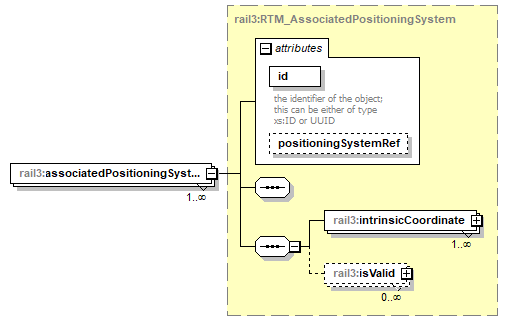 | ||||||||||||||||||||
| namespace | https://www.railml.org/schemas/3.1 | ||||||||||||||||||||
| type | rail3:RTM_AssociatedPositioningSystem | ||||||||||||||||||||
| properties |
| ||||||||||||||||||||
| children | rail3:intrinsicCoordinate rail3:isValid | ||||||||||||||||||||
| attributes |
| ||||||||||||||||||||
| source | <xs:element name="associatedPositioningSystem" type="rail3:RTM_AssociatedPositioningSystem" minOccurs="1" maxOccurs="unbounded"/> |
complexType RTM_PositioningSystem
| diagram | 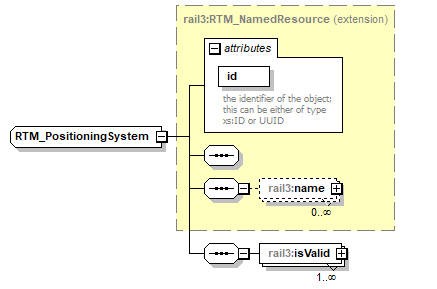 | ||||||||||||||
| namespace | https://www.railml.org/schemas/3.1 | ||||||||||||||
| type | extension of rail3:RTM_NamedResource | ||||||||||||||
| properties |
| ||||||||||||||
| children | rail3:name rail3:isValid | ||||||||||||||
| used by |
| ||||||||||||||
| attributes |
| ||||||||||||||
| source | <xs:complexType name="RTM_PositioningSystem"> <xs:complexContent> <xs:extension base="rail3:RTM_NamedResource"> <xs:sequence> <xs:element name="isValid" type="rail3:RTM_Validity" minOccurs="1" maxOccurs="unbounded"/> </xs:sequence> </xs:extension> </xs:complexContent> </xs:complexType> |
element RTM_PositioningSystem/isValid
| diagram | 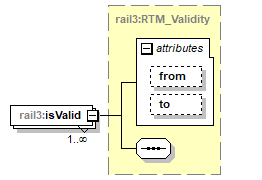 | ||||||||||||||||||
| namespace | https://www.railml.org/schemas/3.1 | ||||||||||||||||||
| type | rail3:RTM_Validity | ||||||||||||||||||
| properties |
| ||||||||||||||||||
| attributes |
| ||||||||||||||||||
| source | <xs:element name="isValid" type="rail3:RTM_Validity" minOccurs="1" maxOccurs="unbounded"/> |
complexType RTM_PositioningSystemCoordinate
| diagram |  | ||||||||||||
| namespace | https://www.railml.org/schemas/3.1 | ||||||||||||
| used by |
| ||||||||||||
| attributes |
| ||||||||||||
| source | <xs:complexType name="RTM_PositioningSystemCoordinate"> <xs:sequence/> <xs:attribute name="positioningSystemRef" type="rail3:tRef" use="required"/> </xs:complexType> |
attribute RTM_PositioningSystemCoordinate/@positioningSystemRef
| type | rail3:tRef | ||
| properties |
| ||
| source | <xs:attribute name="positioningSystemRef" type="rail3:tRef" use="required"/> |
complexType RTM_Relation
| diagram | 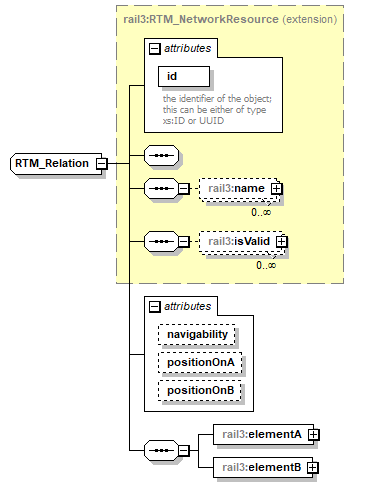 | ||||||||||||||||||||||||||||||||
| namespace | https://www.railml.org/schemas/3.1 | ||||||||||||||||||||||||||||||||
| type | extension of rail3:RTM_NetworkResource | ||||||||||||||||||||||||||||||||
| properties |
| ||||||||||||||||||||||||||||||||
| children | rail3:name rail3:isValid rail3:elementA rail3:elementB | ||||||||||||||||||||||||||||||||
| used by |
| ||||||||||||||||||||||||||||||||
| attributes |
| ||||||||||||||||||||||||||||||||
| source | <xs:complexType name="RTM_Relation"> <xs:complexContent> <xs:extension base="rail3:RTM_NetworkResource"> <xs:sequence> <xs:element name="elementA" type="rail3:tElementWithIDref" form="qualified" minOccurs="1" maxOccurs="1"/> <xs:element name="elementB" type="rail3:tElementWithIDref" form="qualified" minOccurs="1" maxOccurs="1"/> </xs:sequence> <xs:attribute name="navigability" type="rail3:tNavigability" use="optional"/> <xs:attribute name="positionOnA" type="rail3:tUsage" use="optional"/> <xs:attribute name="positionOnB" type="rail3:tUsage" use="optional"/> </xs:extension> </xs:complexContent> </xs:complexType> |
attribute RTM_Relation/@navigability
| type | rail3:tNavigability | |||||||||||||||
| properties |
| |||||||||||||||
| facets |
| |||||||||||||||
| source | <xs:attribute name="navigability" type="rail3:tNavigability" use="optional"/> |
attribute RTM_Relation/@positionOnA
| type | rail3:tUsage | |||||||||
| properties |
| |||||||||
| facets |
| |||||||||
| source | <xs:attribute name="positionOnA" type="rail3:tUsage" use="optional"/> |
attribute RTM_Relation/@positionOnB
| type | rail3:tUsage | |||||||||
| properties |
| |||||||||
| facets |
| |||||||||
| source | <xs:attribute name="positionOnB" type="rail3:tUsage" use="optional"/> |
element RTM_Relation/elementA
| diagram | 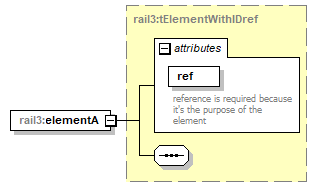 | ||||||||||||||
| namespace | https://www.railml.org/schemas/3.1 | ||||||||||||||
| type | rail3:tElementWithIDref | ||||||||||||||
| properties |
| ||||||||||||||
| attributes |
| ||||||||||||||
| source | <xs:element name="elementA" type="rail3:tElementWithIDref" form="qualified" minOccurs="1" maxOccurs="1"/> |
element RTM_Relation/elementB
| diagram | 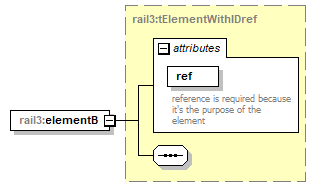 | ||||||||||||||
| namespace | https://www.railml.org/schemas/3.1 | ||||||||||||||
| type | rail3:tElementWithIDref | ||||||||||||||
| properties |
| ||||||||||||||
| attributes |
| ||||||||||||||
| source | <xs:element name="elementB" type="rail3:tElementWithIDref" form="qualified" minOccurs="1" maxOccurs="1"/> |
complexType RTM_SpotLocation
| diagram | 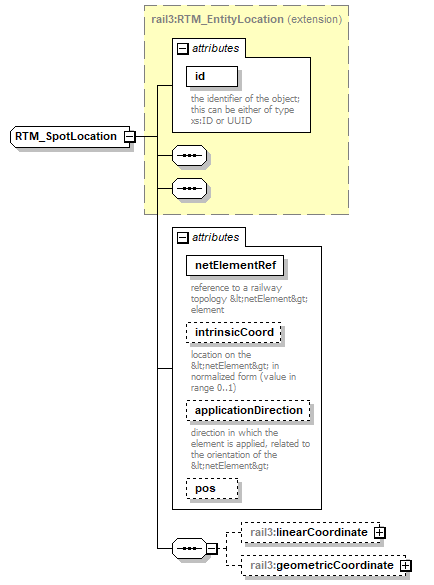 | ||||||||||||||||||||||||||||||||||||||||||||
| namespace | https://www.railml.org/schemas/3.1 | ||||||||||||||||||||||||||||||||||||||||||||
| type | extension of rail3:RTM_EntityLocation | ||||||||||||||||||||||||||||||||||||||||||||
| properties |
| ||||||||||||||||||||||||||||||||||||||||||||
| children | rail3:linearCoordinate rail3:geometricCoordinate | ||||||||||||||||||||||||||||||||||||||||||||
| used by |
| ||||||||||||||||||||||||||||||||||||||||||||
| attributes |
| ||||||||||||||||||||||||||||||||||||||||||||
| source | <xs:complexType name="RTM_SpotLocation"> <xs:complexContent> <xs:extension base="rail3:RTM_EntityLocation"> <xs:sequence> <xs:element name="linearCoordinate" type="rail3:RTM_LinearCoordinate" minOccurs="0" maxOccurs="1"/> <xs:element name="geometricCoordinate" type="rail3:RTM_GeometricCoordinate" minOccurs="0" maxOccurs="1"/> </xs:sequence> <xs:attribute name="netElementRef" type="rail3:tRef" use="required"> <xs:annotation> <xs:documentation>reference to a railway topology <netElement> element</xs:documentation> </xs:annotation> </xs:attribute> <xs:attribute name="intrinsicCoord" type="xs:double" use="optional"> <xs:annotation> <xs:documentation>location on the <netElement> in normalized form (value in range 0..1)</xs:documentation> </xs:annotation> </xs:attribute> <xs:attribute name="applicationDirection" type="rail3:tApplicationDirection" use="optional"> <xs:annotation> <xs:documentation>direction in which the element is applied, related to the orientation of the <netElement></xs:documentation> </xs:annotation> </xs:attribute> <xs:attribute name="pos" type="rail3:tLengthM" use="optional"/> </xs:extension> </xs:complexContent> </xs:complexType> |
attribute RTM_SpotLocation/@netElementRef
| type | rail3:tRef | ||
| properties |
| ||
| annotation |
| ||
| source | <xs:attribute name="netElementRef" type="rail3:tRef" use="required"> <xs:annotation> <xs:documentation>reference to a railway topology <netElement> element</xs:documentation> </xs:annotation> </xs:attribute> |
attribute RTM_SpotLocation/@intrinsicCoord
| type | xs:double | ||
| properties |
| ||
| annotation |
| ||
| source | <xs:attribute name="intrinsicCoord" type="xs:double" use="optional"> <xs:annotation> <xs:documentation>location on the <netElement> in normalized form (value in range 0..1)</xs:documentation> </xs:annotation> </xs:attribute> |
attribute RTM_SpotLocation/@applicationDirection
| type | rail3:tApplicationDirection | ||||||||||||
| properties |
| ||||||||||||
| facets |
| ||||||||||||
| annotation |
| ||||||||||||
| source | <xs:attribute name="applicationDirection" type="rail3:tApplicationDirection" use="optional"> <xs:annotation> <xs:documentation>direction in which the element is applied, related to the orientation of the <netElement></xs:documentation> </xs:annotation> </xs:attribute> |
attribute RTM_SpotLocation/@pos
| type | rail3:tLengthM | ||
| properties |
| ||
| source | <xs:attribute name="pos" type="rail3:tLengthM" use="optional"/> |
element RTM_SpotLocation/linearCoordinate
| diagram | 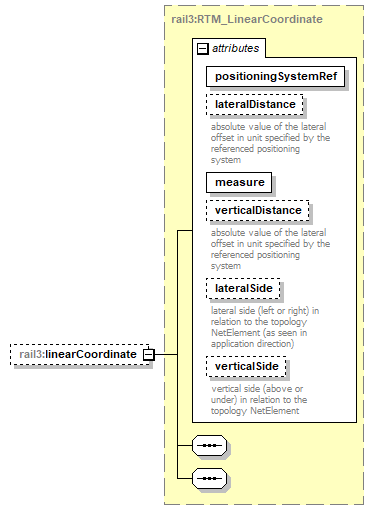 | ||||||||||||||||||||||||||||||||||||||||||||||||||
| namespace | https://www.railml.org/schemas/3.1 | ||||||||||||||||||||||||||||||||||||||||||||||||||
| type | rail3:RTM_LinearCoordinate | ||||||||||||||||||||||||||||||||||||||||||||||||||
| properties |
| ||||||||||||||||||||||||||||||||||||||||||||||||||
| attributes |
| ||||||||||||||||||||||||||||||||||||||||||||||||||
| source | <xs:element name="linearCoordinate" type="rail3:RTM_LinearCoordinate" minOccurs="0" maxOccurs="1"/> |
element RTM_SpotLocation/geometricCoordinate
| diagram | 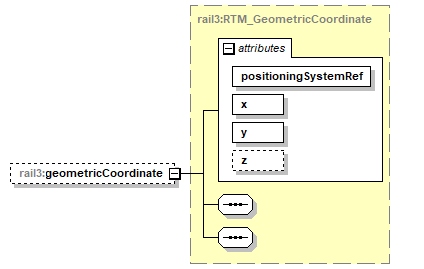 | ||||||||||||||||||||||||||||||
| namespace | https://www.railml.org/schemas/3.1 | ||||||||||||||||||||||||||||||
| type | rail3:RTM_GeometricCoordinate | ||||||||||||||||||||||||||||||
| properties |
| ||||||||||||||||||||||||||||||
| attributes |
| ||||||||||||||||||||||||||||||
| source | <xs:element name="geometricCoordinate" type="rail3:RTM_GeometricCoordinate" minOccurs="0" maxOccurs="1"/> |
complexType RTM_UnorderedCollection
| diagram | 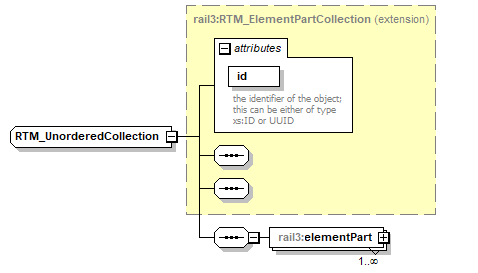 | ||||||||||||||
| namespace | https://www.railml.org/schemas/3.1 | ||||||||||||||
| type | extension of rail3:RTM_ElementPartCollection | ||||||||||||||
| properties |
| ||||||||||||||
| children | rail3:elementPart | ||||||||||||||
| used by |
| ||||||||||||||
| attributes |
| ||||||||||||||
| source | <xs:complexType name="RTM_UnorderedCollection"> <xs:complexContent> <xs:extension base="rail3:RTM_ElementPartCollection"> <xs:sequence> <xs:element name="elementPart" type="rail3:tElementWithIDref" minOccurs="1" maxOccurs="unbounded"/> </xs:sequence> </xs:extension> </xs:complexContent> </xs:complexType> |
element RTM_UnorderedCollection/elementPart
| diagram | 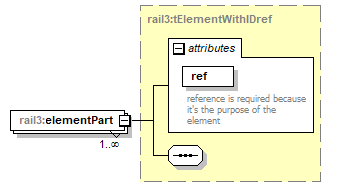 | ||||||||||||||
| namespace | https://www.railml.org/schemas/3.1 | ||||||||||||||
| type | rail3:tElementWithIDref | ||||||||||||||
| properties |
| ||||||||||||||
| attributes |
| ||||||||||||||
| source | <xs:element name="elementPart" type="rail3:tElementWithIDref" minOccurs="1" maxOccurs="unbounded"/> |
complexType RTM_Validity
| diagram | 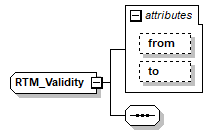 | ||||||||||||||||||
| namespace | https://www.railml.org/schemas/3.1 | ||||||||||||||||||
| used by |
| ||||||||||||||||||
| attributes |
| ||||||||||||||||||
| source | <xs:complexType name="RTM_Validity"> <xs:sequence/> <xs:attribute name="from" type="xs:date" use="optional"/> <xs:attribute name="to" type="xs:date" use="optional"/> </xs:complexType> |
attribute RTM_Validity/@from
| type | xs:date | ||
| properties |
| ||
| source | <xs:attribute name="from" type="xs:date" use="optional"/> |
attribute RTM_Validity/@to
| type | xs:date | ||
| properties |
| ||
| source | <xs:attribute name="to" type="xs:date" use="optional"/> |
simpleType tApplicationDirection
| namespace | https://www.railml.org/schemas/3.1 | ||||||||||||
| type | restriction of xs:string | ||||||||||||
| properties |
| ||||||||||||
| used by |
| ||||||||||||
| facets |
| ||||||||||||
| source | <xs:simpleType name="tApplicationDirection"> <xs:restriction base="xs:string"> <xs:enumeration value="both"/> <xs:enumeration value="reverse"/> <xs:enumeration value="normal"/> </xs:restriction> </xs:simpleType> |
simpleType tDescriptionLevel
| namespace | https://www.railml.org/schemas/3.1 | ||||||||||||
| type | restriction of xs:string | ||||||||||||
| properties |
| ||||||||||||
| used by |
| ||||||||||||
| facets |
| ||||||||||||
| source | <xs:simpleType name="tDescriptionLevel"> <xs:restriction base="xs:string"> <xs:enumeration value="Micro"/> <xs:enumeration value="Meso"/> <xs:enumeration value="Macro"/> </xs:restriction> </xs:simpleType> |
simpleType tLateralSide
| namespace | https://www.railml.org/schemas/3.1 | |||||||||
| type | restriction of xs:string | |||||||||
| properties |
| |||||||||
| used by |
| |||||||||
| facets |
| |||||||||
| source | <xs:simpleType name="tLateralSide"> <xs:restriction base="xs:string"> <xs:enumeration value="right"/> <xs:enumeration value="left"/> </xs:restriction> </xs:simpleType> |
simpleType tLrsMethod
| namespace | https://www.railml.org/schemas/3.1 | ||||||||||||
| type | restriction of xs:string | ||||||||||||
| properties |
| ||||||||||||
| used by |
| ||||||||||||
| facets |
| ||||||||||||
| source | <xs:simpleType name="tLrsMethod"> <xs:restriction base="xs:string"> <xs:enumeration value="interpolation"/> <xs:enumeration value="relative"/> <xs:enumeration value="absolute"/> </xs:restriction> </xs:simpleType> |
simpleType tNavigability
| namespace | https://www.railml.org/schemas/3.1 | |||||||||||||||
| type | restriction of xs:string | |||||||||||||||
| properties |
| |||||||||||||||
| used by |
| |||||||||||||||
| facets |
| |||||||||||||||
| source | <xs:simpleType name="tNavigability"> <xs:restriction base="xs:string"> <xs:enumeration value="None"/> <xs:enumeration value="Both"/> <xs:enumeration value="BA"/> <xs:enumeration value="AB"/> </xs:restriction> </xs:simpleType> |
simpleType tOrientation
| namespace | https://www.railml.org/schemas/3.1 | |||||||||
| type | restriction of xs:integer | |||||||||
| properties |
| |||||||||
| facets |
| |||||||||
| source | <xs:simpleType name="tOrientation"> <xs:restriction base="xs:integer"> <xs:enumeration value="-1"/> <xs:enumeration value="1"/> </xs:restriction> </xs:simpleType> |
simpleType tUsage
| namespace | https://www.railml.org/schemas/3.1 | |||||||||
| type | restriction of xs:integer | |||||||||
| properties |
| |||||||||
| used by |
| |||||||||
| facets |
| |||||||||
| source | <xs:simpleType name="tUsage"> <xs:restriction base="xs:integer"> <xs:enumeration value="1"/> <xs:enumeration value="0"/> </xs:restriction> </xs:simpleType> |
simpleType tVerticalSide
| namespace | https://www.railml.org/schemas/3.1 | |||||||||
| type | restriction of xs:string | |||||||||
| properties |
| |||||||||
| used by |
| |||||||||
| facets |
| |||||||||
| source | <xs:simpleType name="tVerticalSide"> <xs:restriction base="xs:string"> <xs:enumeration value="under"/> <xs:enumeration value="above"/> </xs:restriction> </xs:simpleType> |
group StandardObjectProperties
| diagram | 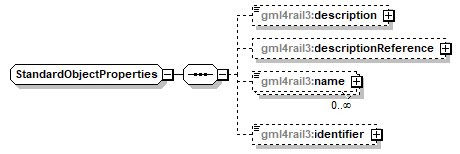 | ||
| namespace | https://www.railml.org/schemas/3.1/gml | ||
| children | gml4rail3:description gml4rail3:descriptionReference gml4rail3:name gml4rail3:identifier | ||
| used by |
| ||
| source | <xs:group name="StandardObjectProperties"> <xs:sequence> <xs:element name="description" type="gml4rail3:StringOrRefType" minOccurs="0" maxOccurs="1"/> <xs:element name="descriptionReference" type="gml4rail3:ReferenceType" minOccurs="0" maxOccurs="1"/> <xs:element name="name" type="gml4rail3:CodeType" minOccurs="0" maxOccurs="unbounded"/> <xs:element name="identifier" type="gml4rail3:CodeWithAuthorityType" minOccurs="0" maxOccurs="1"/> </xs:sequence> </xs:group> |
element StandardObjectProperties/description
| diagram | 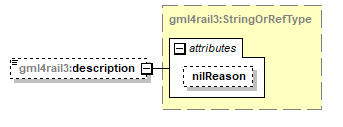 | ||||||||||||
| namespace | https://www.railml.org/schemas/3.1/gml | ||||||||||||
| type | gml4rail3:StringOrRefType | ||||||||||||
| properties |
| ||||||||||||
| attributes |
| ||||||||||||
| source | <xs:element name="description" type="gml4rail3:StringOrRefType" minOccurs="0" maxOccurs="1"/> |
element StandardObjectProperties/descriptionReference
| diagram | 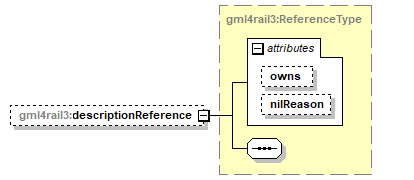 | ||||||||||||||||||
| namespace | https://www.railml.org/schemas/3.1/gml | ||||||||||||||||||
| type | gml4rail3:ReferenceType | ||||||||||||||||||
| properties |
| ||||||||||||||||||
| attributes |
| ||||||||||||||||||
| source | <xs:element name="descriptionReference" type="gml4rail3:ReferenceType" minOccurs="0" maxOccurs="1"/> |
element StandardObjectProperties/name
| diagram | 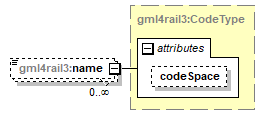 | ||||||||||||
| namespace | https://www.railml.org/schemas/3.1/gml | ||||||||||||
| type | gml4rail3:CodeType | ||||||||||||
| properties |
| ||||||||||||
| attributes |
| ||||||||||||
| source | <xs:element name="name" type="gml4rail3:CodeType" minOccurs="0" maxOccurs="unbounded"/> |
element StandardObjectProperties/identifier
| diagram | 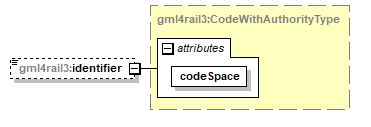 | ||||||||||||
| namespace | https://www.railml.org/schemas/3.1/gml | ||||||||||||
| type | gml4rail3:CodeWithAuthorityType | ||||||||||||
| properties |
| ||||||||||||
| attributes |
| ||||||||||||
| source | <xs:element name="identifier" type="gml4rail3:CodeWithAuthorityType" minOccurs="0" maxOccurs="1"/> |
complexType AbstractCurveType
| diagram | 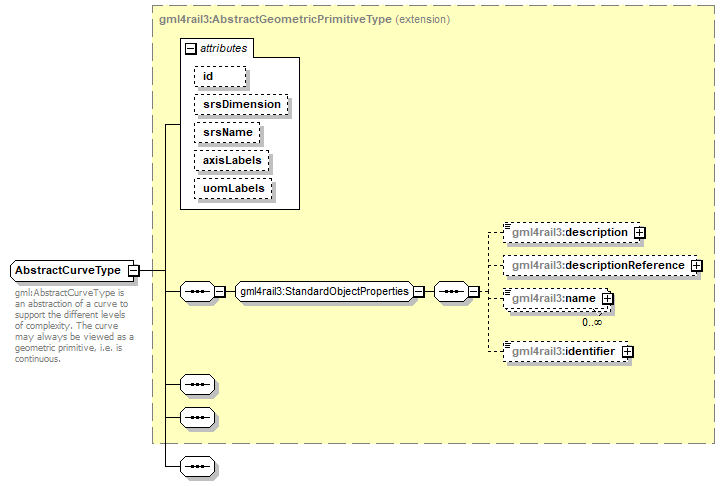 | ||||||||||||||||||||||||||||||||||||
| namespace | https://www.railml.org/schemas/3.1/gml | ||||||||||||||||||||||||||||||||||||
| type | extension of gml4rail3:AbstractGeometricPrimitiveType | ||||||||||||||||||||||||||||||||||||
| properties |
| ||||||||||||||||||||||||||||||||||||
| children | gml4rail3:description gml4rail3:descriptionReference gml4rail3:name gml4rail3:identifier | ||||||||||||||||||||||||||||||||||||
| used by |
| ||||||||||||||||||||||||||||||||||||
| attributes |
| ||||||||||||||||||||||||||||||||||||
| annotation |
| ||||||||||||||||||||||||||||||||||||
| source | <xs:complexType name="AbstractCurveType" abstract="true"> <xs:annotation> <xs:documentation>gml:AbstractCurveType is an abstraction of a curve to support the different levels of complexity. The curve may always be viewed as a geometric primitive, i.e. is continuous.</xs:documentation> </xs:annotation> <xs:complexContent> <xs:extension base="gml4rail3:AbstractGeometricPrimitiveType"> <xs:sequence/> </xs:extension> </xs:complexContent> </xs:complexType> |
complexType AbstractGeometricPrimitiveType
| diagram | 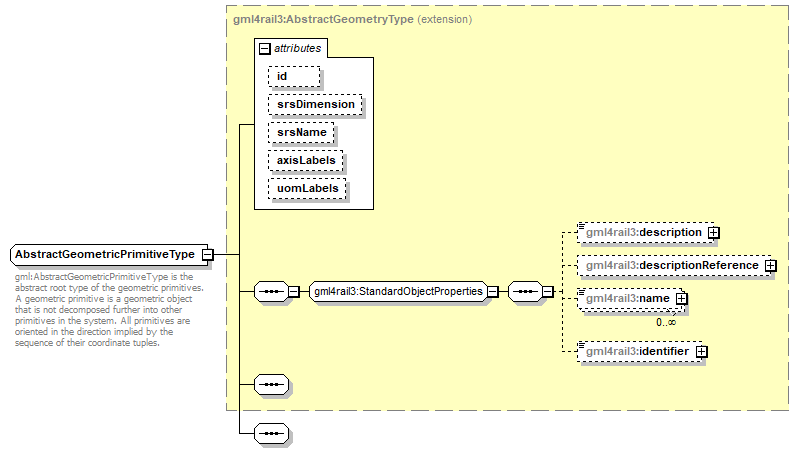 | ||||||||||||||||||||||||||||||||||||
| namespace | https://www.railml.org/schemas/3.1/gml | ||||||||||||||||||||||||||||||||||||
| type | extension of gml4rail3:AbstractGeometryType | ||||||||||||||||||||||||||||||||||||
| properties |
| ||||||||||||||||||||||||||||||||||||
| children | gml4rail3:description gml4rail3:descriptionReference gml4rail3:name gml4rail3:identifier | ||||||||||||||||||||||||||||||||||||
| used by |
| ||||||||||||||||||||||||||||||||||||
| attributes |
| ||||||||||||||||||||||||||||||||||||
| annotation |
| ||||||||||||||||||||||||||||||||||||
| source | <xs:complexType name="AbstractGeometricPrimitiveType" abstract="true"> <xs:annotation> <xs:documentation>gml:AbstractGeometricPrimitiveType is the abstract root type of the geometric primitives. A geometric primitive is a geometric object that is not decomposed further into other primitives in the system. All primitives are oriented in the direction implied by the sequence of their coordinate tuples.</xs:documentation> </xs:annotation> <xs:complexContent> <xs:extension base="gml4rail3:AbstractGeometryType"> <xs:sequence/> </xs:extension> </xs:complexContent> </xs:complexType> |
complexType AbstractGeometryType
| diagram | 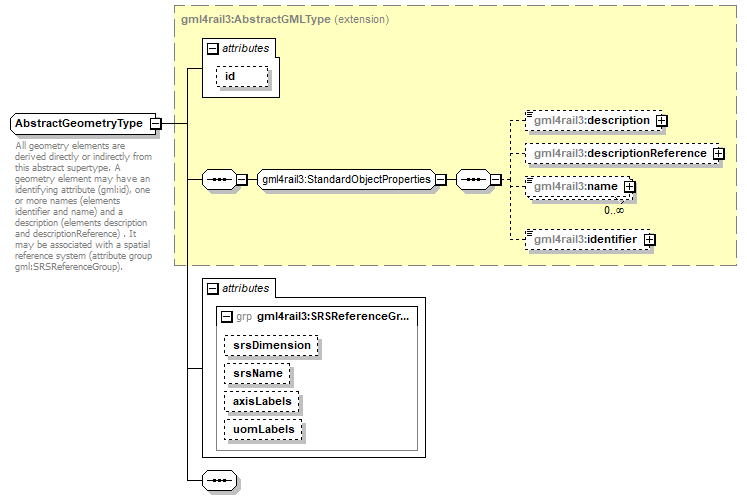 | ||||||||||||||||||||||||||||||||||||
| namespace | https://www.railml.org/schemas/3.1/gml | ||||||||||||||||||||||||||||||||||||
| type | extension of gml4rail3:AbstractGMLType | ||||||||||||||||||||||||||||||||||||
| properties |
| ||||||||||||||||||||||||||||||||||||
| children | gml4rail3:description gml4rail3:descriptionReference gml4rail3:name gml4rail3:identifier | ||||||||||||||||||||||||||||||||||||
| used by |
| ||||||||||||||||||||||||||||||||||||
| attributes |
| ||||||||||||||||||||||||||||||||||||
| annotation |
| ||||||||||||||||||||||||||||||||||||
| source | <xs:complexType name="AbstractGeometryType" abstract="true"> <xs:annotation> <xs:documentation>All geometry elements are derived directly or indirectly from this abstract supertype. A geometry element may have an identifying attribute (gml:id), one or more names (elements identifier and name) and a description (elements description and descriptionReference) . It may be associated with a spatial reference system (attribute group gml:SRSReferenceGroup).</xs:documentation> </xs:annotation> <xs:complexContent> <xs:extension base="gml4rail3:AbstractGMLType"> <xs:sequence/> <xs:attributeGroup ref="gml4rail3:SRSReferenceGroup"/> </xs:extension> </xs:complexContent> </xs:complexType> |
complexType AbstractGMLType
| diagram |  | ||||||||||||
| namespace | https://www.railml.org/schemas/3.1/gml | ||||||||||||
| properties |
| ||||||||||||
| children | gml4rail3:description gml4rail3:descriptionReference gml4rail3:name gml4rail3:identifier | ||||||||||||
| used by |
| ||||||||||||
| attributes |
| ||||||||||||
| source | <xs:complexType name="AbstractGMLType" abstract="true"> <xs:sequence> <xs:group ref="gml4rail3:StandardObjectProperties" minOccurs="1" maxOccurs="1"/> </xs:sequence> <xs:attribute name="id" type="xs:ID" use="optional"/> </xs:complexType> |
attribute AbstractGMLType/@id
| type | xs:ID | ||
| properties |
| ||
| source | <xs:attribute name="id" type="xs:ID" use="optional"/> |
complexType CodeType
| diagram | 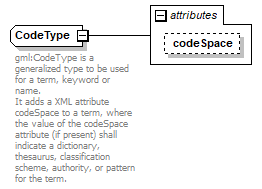 | ||||||||||||
| namespace | https://www.railml.org/schemas/3.1/gml | ||||||||||||
| type | extension of xs:string | ||||||||||||
| properties |
| ||||||||||||
| used by |
| ||||||||||||
| attributes |
| ||||||||||||
| annotation |
| ||||||||||||
| source | <xs:complexType name="CodeType"> <xs:annotation> <xs:documentation>gml:CodeType is a generalized type to be used for a term, keyword or name. It adds a XML attribute codeSpace to a term, where the value of the codeSpace attribute (if present) shall indicate a dictionary, thesaurus, classification scheme, authority, or pattern for the term.</xs:documentation> </xs:annotation> <xs:simpleContent> <xs:extension base="xs:string"> <xs:attribute name="codeSpace" type="xs:anyURI" use="optional"/> </xs:extension> </xs:simpleContent> </xs:complexType> |
attribute CodeType/@codeSpace
| type | xs:anyURI | ||
| properties |
| ||
| source | <xs:attribute name="codeSpace" type="xs:anyURI" use="optional"/> |
complexType CodeWithAuthorityType
| diagram | 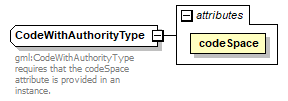 | ||||||||||||
| namespace | https://www.railml.org/schemas/3.1/gml | ||||||||||||
| type | restriction of gml4rail3:CodeType | ||||||||||||
| properties |
| ||||||||||||
| used by |
| ||||||||||||
| attributes |
| ||||||||||||
| annotation |
| ||||||||||||
| source | <xs:complexType name="CodeWithAuthorityType"> <xs:annotation> <xs:documentation>gml:CodeWithAuthorityType requires that the codeSpace attribute is provided in an instance.</xs:documentation> </xs:annotation> <xs:simpleContent> <xs:restriction base="gml4rail3:CodeType"> <xs:attribute name="codeSpace" type="xs:anyURI" use="required"/> </xs:restriction> </xs:simpleContent> </xs:complexType> |
attribute CodeWithAuthorityType/@codeSpace
| type | xs:anyURI | ||
| properties |
| ||
| source | <xs:attribute name="codeSpace" type="xs:anyURI" use="required"/> |
complexType DirectPositionListType
| diagram | 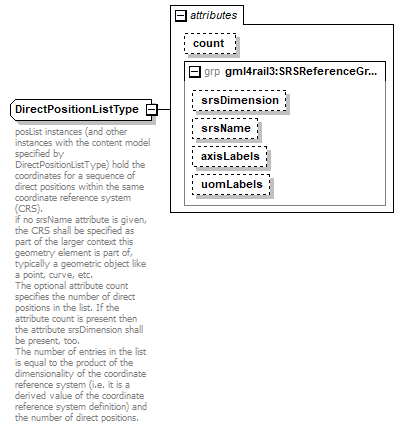 | ||||||||||||||||||||||||||||||||||||
| namespace | https://www.railml.org/schemas/3.1/gml | ||||||||||||||||||||||||||||||||||||
| type | extension of gml4rail3:doubleList | ||||||||||||||||||||||||||||||||||||
| properties |
| ||||||||||||||||||||||||||||||||||||
| used by |
| ||||||||||||||||||||||||||||||||||||
| attributes |
| ||||||||||||||||||||||||||||||||||||
| annotation |
| ||||||||||||||||||||||||||||||||||||
| source | <xs:complexType name="DirectPositionListType"> <xs:annotation> <xs:documentation>posList instances (and other instances with the content model specified by DirectPositionListType) hold the coordinates for a sequence of direct positions within the same coordinate reference system (CRS). if no srsName attribute is given, the CRS shall be specified as part of the larger context this geometry element is part of, typically a geometric object like a point, curve, etc. The optional attribute count specifies the number of direct positions in the list. If the attribute count is present then the attribute srsDimension shall be present, too. The number of entries in the list is equal to the product of the dimensionality of the coordinate reference system (i.e. it is a derived value of the coordinate reference system definition) and the number of direct positions.</xs:documentation> </xs:annotation> <xs:simpleContent> <xs:extension base="gml4rail3:doubleList"> <xs:attribute name="count" type="xs:positiveInteger" use="optional"/> <xs:attributeGroup ref="gml4rail3:SRSReferenceGroup"/> </xs:extension> </xs:simpleContent> </xs:complexType> |
attribute DirectPositionListType/@count
| type | xs:positiveInteger | ||
| properties |
| ||
| source | <xs:attribute name="count" type="xs:positiveInteger" use="optional"/> |
complexType DirectPositionType
| diagram | 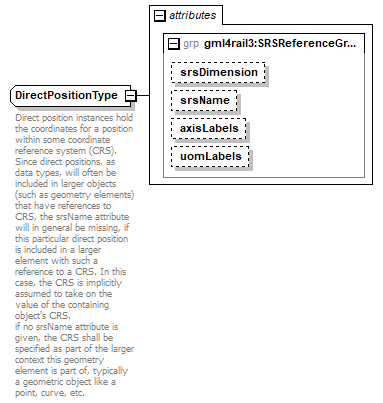 | ||||||||||||||||||||||||||||||
| namespace | https://www.railml.org/schemas/3.1/gml | ||||||||||||||||||||||||||||||
| type | extension of gml4rail3:doubleList | ||||||||||||||||||||||||||||||
| properties |
| ||||||||||||||||||||||||||||||
| used by |
| ||||||||||||||||||||||||||||||
| attributes |
| ||||||||||||||||||||||||||||||
| annotation |
| ||||||||||||||||||||||||||||||
| source | <xs:complexType name="DirectPositionType"> <xs:annotation> <xs:documentation>Direct position instances hold the coordinates for a position within some coordinate reference system (CRS). Since direct positions, as data types, will often be included in larger objects (such as geometry elements) that have references to CRS, the srsName attribute will in general be missing, if this particular direct position is included in a larger element with such a reference to a CRS. In this case, the CRS is implicitly assumed to take on the value of the containing object's CRS. if no srsName attribute is given, the CRS shall be specified as part of the larger context this geometry element is part of, typically a geometric object like a point, curve, etc.</xs:documentation> </xs:annotation> <xs:simpleContent> <xs:extension base="gml4rail3:doubleList"> <xs:attributeGroup ref="gml4rail3:SRSReferenceGroup"/> </xs:extension> </xs:simpleContent> </xs:complexType> |
complexType LineStringType
| diagram | 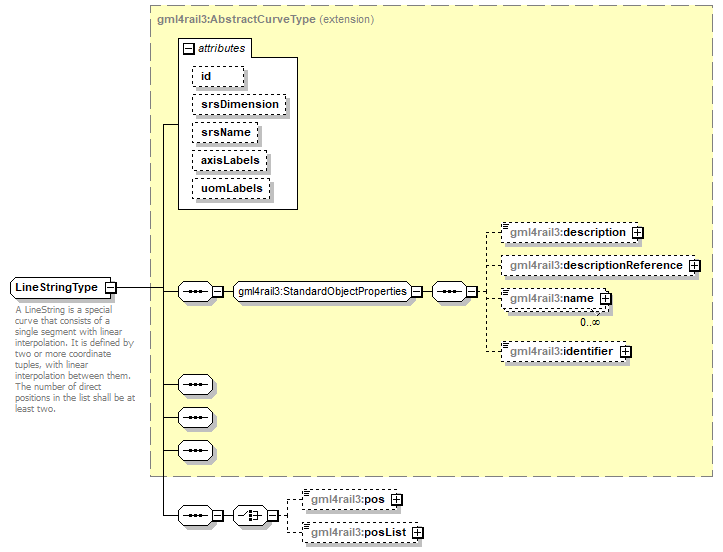 | ||||||||||||||||||||||||||||||||||||
| namespace | https://www.railml.org/schemas/3.1/gml | ||||||||||||||||||||||||||||||||||||
| type | extension of gml4rail3:AbstractCurveType | ||||||||||||||||||||||||||||||||||||
| properties |
| ||||||||||||||||||||||||||||||||||||
| children | gml4rail3:description gml4rail3:descriptionReference gml4rail3:name gml4rail3:identifier gml4rail3:pos gml4rail3:posList | ||||||||||||||||||||||||||||||||||||
| used by |
| ||||||||||||||||||||||||||||||||||||
| attributes |
| ||||||||||||||||||||||||||||||||||||
| annotation |
| ||||||||||||||||||||||||||||||||||||
| source | <xs:complexType name="LineStringType"> <xs:annotation> <xs:documentation>A LineString is a special curve that consists of a single segment with linear interpolation. It is defined by two or more coordinate tuples, with linear interpolation between them. The number of direct positions in the list shall be at least two.</xs:documentation> </xs:annotation> <xs:complexContent> <xs:extension base="gml4rail3:AbstractCurveType"> <xs:sequence> <xs:choice minOccurs="1" maxOccurs="1"> <xs:element name="pos" type="gml4rail3:DirectPositionType" minOccurs="0" maxOccurs="1"/> <xs:element name="posList" type="gml4rail3:DirectPositionListType" minOccurs="0" maxOccurs="1"/> </xs:choice> </xs:sequence> </xs:extension> </xs:complexContent> </xs:complexType> |
element LineStringType/pos
| diagram | 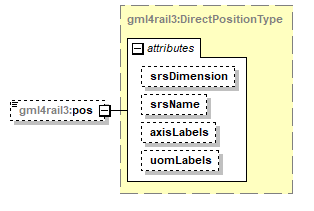 | ||||||||||||||||||||||||||||||
| namespace | https://www.railml.org/schemas/3.1/gml | ||||||||||||||||||||||||||||||
| type | gml4rail3:DirectPositionType | ||||||||||||||||||||||||||||||
| properties |
| ||||||||||||||||||||||||||||||
| attributes |
| ||||||||||||||||||||||||||||||
| source | <xs:element name="pos" type="gml4rail3:DirectPositionType" minOccurs="0" maxOccurs="1"/> |
element LineStringType/posList
| diagram | 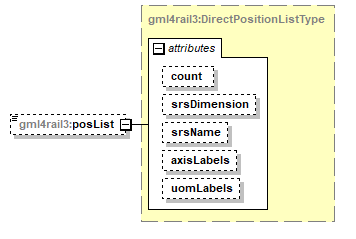 | ||||||||||||||||||||||||||||||||||||
| namespace | https://www.railml.org/schemas/3.1/gml | ||||||||||||||||||||||||||||||||||||
| type | gml4rail3:DirectPositionListType | ||||||||||||||||||||||||||||||||||||
| properties |
| ||||||||||||||||||||||||||||||||||||
| attributes |
| ||||||||||||||||||||||||||||||||||||
| source | <xs:element name="posList" type="gml4rail3:DirectPositionListType" minOccurs="0" maxOccurs="1"/> |
complexType PointType
| diagram | 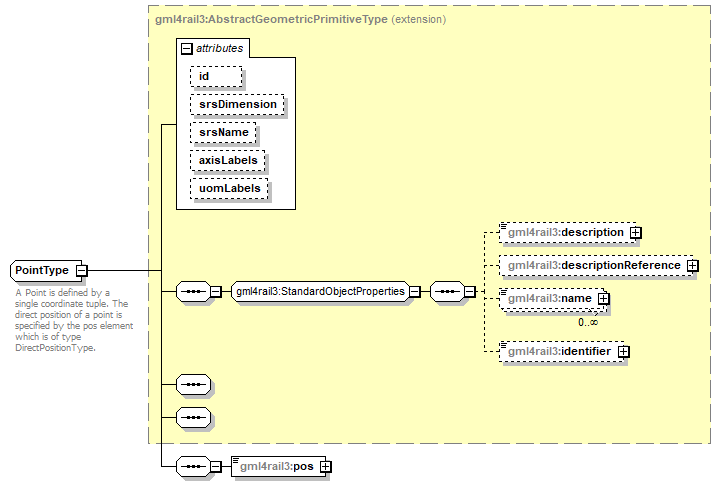 | ||||||||||||||||||||||||||||||||||||
| namespace | https://www.railml.org/schemas/3.1/gml | ||||||||||||||||||||||||||||||||||||
| type | extension of gml4rail3:AbstractGeometricPrimitiveType | ||||||||||||||||||||||||||||||||||||
| properties |
| ||||||||||||||||||||||||||||||||||||
| children | gml4rail3:description gml4rail3:descriptionReference gml4rail3:name gml4rail3:identifier gml4rail3:pos | ||||||||||||||||||||||||||||||||||||
| used by |
| ||||||||||||||||||||||||||||||||||||
| attributes |
| ||||||||||||||||||||||||||||||||||||
| annotation |
| ||||||||||||||||||||||||||||||||||||
| source | <xs:complexType name="PointType"> <xs:annotation> <xs:documentation>A Point is defined by a single coordinate tuple. The direct position of a point is specified by the pos element which is of type DirectPositionType.</xs:documentation> </xs:annotation> <xs:complexContent> <xs:extension base="gml4rail3:AbstractGeometricPrimitiveType"> <xs:sequence> <xs:element name="pos" type="gml4rail3:DirectPositionType" minOccurs="1" maxOccurs="1"/> </xs:sequence> </xs:extension> </xs:complexContent> </xs:complexType> |
element PointType/pos
| diagram | 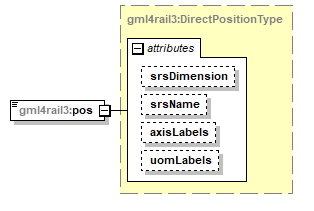 | ||||||||||||||||||||||||||||||
| namespace | https://www.railml.org/schemas/3.1/gml | ||||||||||||||||||||||||||||||
| type | gml4rail3:DirectPositionType | ||||||||||||||||||||||||||||||
| properties |
| ||||||||||||||||||||||||||||||
| attributes |
| ||||||||||||||||||||||||||||||
| source | <xs:element name="pos" type="gml4rail3:DirectPositionType" minOccurs="1" maxOccurs="1"/> |
complexType ReferenceType
| diagram | 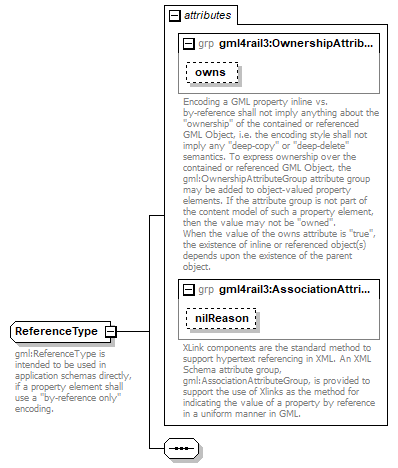 | ||||||||||||||||||
| namespace | https://www.railml.org/schemas/3.1/gml | ||||||||||||||||||
| used by |
| ||||||||||||||||||
| attributes |
| ||||||||||||||||||
| annotation |
| ||||||||||||||||||
| source | <xs:complexType name="ReferenceType"> <xs:annotation> <xs:documentation>gml:ReferenceType is intended to be used in application schemas directly, if a property element shall use a "by-reference only" encoding.</xs:documentation> </xs:annotation> <xs:sequence/> <xs:attributeGroup ref="gml4rail3:OwnershipAttributeGroup"/> <xs:attributeGroup ref="gml4rail3:AssociationAttributeGroup"/> </xs:complexType> |
complexType StringOrRefType
| diagram | 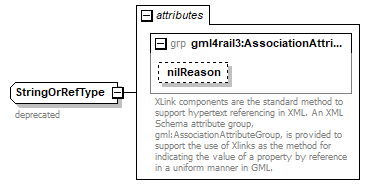 | ||||||||||||
| namespace | https://www.railml.org/schemas/3.1/gml | ||||||||||||
| type | extension of xs:string | ||||||||||||
| properties |
| ||||||||||||
| used by |
| ||||||||||||
| attributes |
| ||||||||||||
| annotation |
| ||||||||||||
| source | <xs:complexType name="StringOrRefType"> <xs:annotation> <xs:documentation>deprecated</xs:documentation> </xs:annotation> <xs:simpleContent> <xs:extension base="xs:string"> <xs:attributeGroup ref="gml4rail3:AssociationAttributeGroup"/> </xs:extension> </xs:simpleContent> </xs:complexType> |
simpleType doubleList
| namespace | https://www.railml.org/schemas/3.1/gml | ||
| type | list of xs:double | ||
| properties |
| ||
| used by |
| ||
| annotation |
| ||
| source | <xs:simpleType name="doubleList"> <xs:annotation> <xs:documentation>A type for a list of values of the respective simple type.</xs:documentation> </xs:annotation> <xs:list itemType="xs:double"/> </xs:simpleType> |
simpleType NCNameList
| namespace | https://www.railml.org/schemas/3.1/gml | ||
| type | list of xs:NCName | ||
| properties |
| ||
| annotation |
| ||
| source | <xs:simpleType name="NCNameList"> <xs:annotation> <xs:documentation>A type for a list of values of the respective simple type.</xs:documentation> </xs:annotation> <xs:list itemType="xs:NCName"/> </xs:simpleType> |
simpleType NilReasonType
| namespace | https://www.railml.org/schemas/3.1/gml | ||
| type | xs:string | ||
| properties |
| ||
| source | <xs:simpleType name="NilReasonType"> <xs:restriction base="xs:string"/> </xs:simpleType> |
attributeGroup AssociationAttributeGroup
| namespace | https://www.railml.org/schemas/3.1/gml | ||||||||||||
| used by |
| ||||||||||||
| attributes |
| ||||||||||||
| annotation |
| ||||||||||||
| source | <xs:attributeGroup name="AssociationAttributeGroup"> <xs:annotation> <xs:documentation>XLink components are the standard method to support hypertext referencing in XML. An XML Schema attribute group, gml:AssociationAttributeGroup, is provided to support the use of Xlinks as the method for indicating the value of a property by reference in a uniform manner in GML.</xs:documentation> </xs:annotation> <xs:attribute name="nilReason" type="xs:string" use="optional"/> </xs:attributeGroup> |
attribute AssociationAttributeGroup/@nilReason
| type | xs:string | ||
| properties |
| ||
| source | <xs:attribute name="nilReason" type="xs:string" use="optional"/> |
attributeGroup OwnershipAttributeGroup
| namespace | https://www.railml.org/schemas/3.1/gml | ||||||||||||
| used by |
| ||||||||||||
| attributes |
| ||||||||||||
| annotation |
| ||||||||||||
| source | <xs:attributeGroup name="OwnershipAttributeGroup"> <xs:annotation> <xs:documentation>Encoding a GML property inline vs. by-reference shall not imply anything about the "ownership" of the contained or referenced GML Object, i.e. the encoding style shall not imply any "deep-copy" or "deep-delete" semantics. To express ownership over the contained or referenced GML Object, the gml:OwnershipAttributeGroup attribute group may be added to object-valued property elements. If the attribute group is not part of the content model of such a property element, then the value may not be "owned". When the value of the owns attribute is "true", the existence of inline or referenced object(s) depends upon the existence of the parent object.</xs:documentation> </xs:annotation> <xs:attribute name="owns" type="xs:boolean" use="optional"/> </xs:attributeGroup> |
attribute OwnershipAttributeGroup/@owns
| type | xs:boolean | ||
| properties |
| ||
| source | <xs:attribute name="owns" type="xs:boolean" use="optional"/> |
attributeGroup SRSInformationGroup
| namespace | https://www.railml.org/schemas/3.1/gml | ||||||||||||||||||
| used by |
| ||||||||||||||||||
| attributes |
| ||||||||||||||||||
| source | <xs:attributeGroup name="SRSInformationGroup"> <xs:attribute name="axisLabels" type="xs:string" use="optional"/> <xs:attribute name="uomLabels" type="xs:string" use="optional"/> </xs:attributeGroup> |
attribute SRSInformationGroup/@axisLabels
| type | xs:string | ||
| properties |
| ||
| source | <xs:attribute name="axisLabels" type="xs:string" use="optional"/> |
attribute SRSInformationGroup/@uomLabels
| type | xs:string | ||
| properties |
| ||
| source | <xs:attribute name="uomLabels" type="xs:string" use="optional"/> |
attributeGroup SRSReferenceGroup
| namespace | https://www.railml.org/schemas/3.1/gml | ||||||||||||||||||||||||||||||
| used by |
| ||||||||||||||||||||||||||||||
| attributes |
| ||||||||||||||||||||||||||||||
| source | <xs:attributeGroup name="SRSReferenceGroup"> <xs:attribute name="srsDimension" type="xs:positiveInteger" use="optional"/> <xs:attribute name="srsName" type="xs:anyURI" use="optional"/> <xs:attributeGroup ref="gml4rail3:SRSInformationGroup"/> </xs:attributeGroup> |
attribute SRSReferenceGroup/@srsDimension
| type | xs:positiveInteger | ||
| properties |
| ||
| source | <xs:attribute name="srsDimension" type="xs:positiveInteger" use="optional"/> |
attribute SRSReferenceGroup/@srsName
| type | xs:anyURI | ||
| properties |
| ||
| source | <xs:attribute name="srsName" type="xs:anyURI" use="optional"/> |
element any
| diagram | 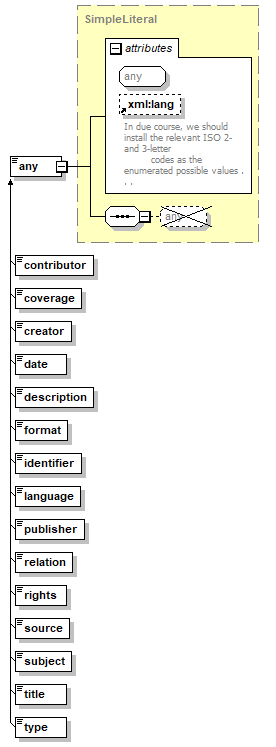 | ||||||||||||||
| namespace | http://purl.org/dc/elements/1.1/ | ||||||||||||||
| type | SimpleLiteral | ||||||||||||||
| properties |
| ||||||||||||||
| used by |
| ||||||||||||||
| attributes |
| ||||||||||||||
| source | <xs:element name="any" type="SimpleLiteral" abstract="true"/> |
element contributor
| diagram |  |
| namespace | http://purl.org/dc/elements/1.1/ |
| substitution group | any |
| source | <xs:element name="contributor" substitutionGroup="any"/> |
element coverage
| diagram |  |
| namespace | http://purl.org/dc/elements/1.1/ |
| substitution group | any |
| source | <xs:element name="coverage" substitutionGroup="any"/> |
element creator
| diagram |  |
| namespace | http://purl.org/dc/elements/1.1/ |
| substitution group | any |
| source | <xs:element name="creator" substitutionGroup="any"/> |
element date
| diagram |  |
| namespace | http://purl.org/dc/elements/1.1/ |
| substitution group | any |
| source | <xs:element name="date" substitutionGroup="any"/> |
element description
| diagram |  |
| namespace | http://purl.org/dc/elements/1.1/ |
| substitution group | any |
| source | <xs:element name="description" substitutionGroup="any"/> |
element format
| diagram |  |
| namespace | http://purl.org/dc/elements/1.1/ |
| substitution group | any |
| source | <xs:element name="format" substitutionGroup="any"/> |
element identifier
| diagram |  |
| namespace | http://purl.org/dc/elements/1.1/ |
| substitution group | any |
| source | <xs:element name="identifier" substitutionGroup="any"/> |
element language
| diagram |  |
| namespace | http://purl.org/dc/elements/1.1/ |
| substitution group | any |
| source | <xs:element name="language" substitutionGroup="any"/> |
element publisher
| diagram |  |
| namespace | http://purl.org/dc/elements/1.1/ |
| substitution group | any |
| source | <xs:element name="publisher" substitutionGroup="any"/> |
element relation
| diagram |  |
| namespace | http://purl.org/dc/elements/1.1/ |
| substitution group | any |
| source | <xs:element name="relation" substitutionGroup="any"/> |
element rights
| diagram |  |
| namespace | http://purl.org/dc/elements/1.1/ |
| substitution group | any |
| source | <xs:element name="rights" substitutionGroup="any"/> |
element source
| diagram |  |
| namespace | http://purl.org/dc/elements/1.1/ |
| substitution group | any |
| source | <xs:element name="source" substitutionGroup="any"/> |
element subject
| diagram |  |
| namespace | http://purl.org/dc/elements/1.1/ |
| substitution group | any |
| source | <xs:element name="subject" substitutionGroup="any"/> |
element title
| diagram |  |
| namespace | http://purl.org/dc/elements/1.1/ |
| substitution group | any |
| source | <xs:element name="title" substitutionGroup="any"/> |
element type
| diagram |  |
| namespace | http://purl.org/dc/elements/1.1/ |
| substitution group | any |
| source | <xs:element name="type" substitutionGroup="any"/> |
group elementsGroup
| diagram | 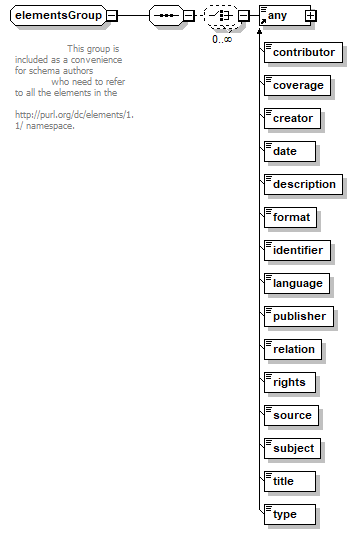 | ||
| namespace | http://purl.org/dc/elements/1.1/ | ||
| children | any | ||
| used by |
| ||
| annotation |
| ||
| source | <xs:group name="elementsGroup"> <xs:annotation> <xs:documentation xml:lang="en"> This group is included as a convenience for schema authors who need to refer to all the elements in the http://purl.org/dc/elements/1.1/ namespace. </xs:documentation> </xs:annotation> <xs:sequence> <xs:choice minOccurs="0" maxOccurs="unbounded"> <xs:element ref="any"/> </xs:choice> </xs:sequence> </xs:group> |
complexType elementContainer
| diagram | 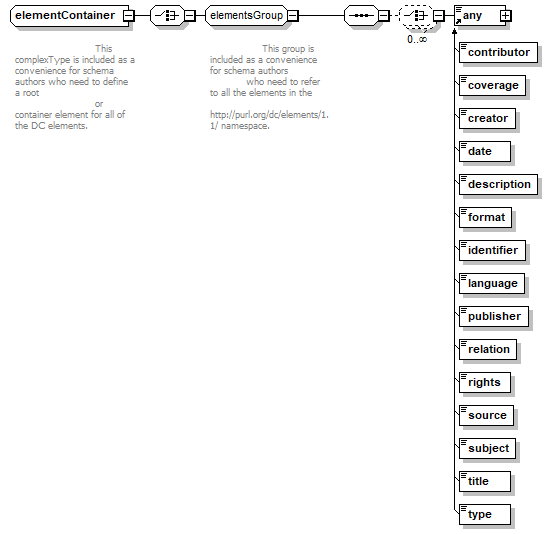 | ||
| namespace | http://purl.org/dc/elements/1.1/ | ||
| children | any | ||
| used by |
| ||
| annotation |
| ||
| source | <xs:complexType name="elementContainer"> <xs:annotation> <xs:documentation xml:lang="en"> This complexType is included as a convenience for schema authors who need to define a root or container element for all of the DC elements. </xs:documentation> </xs:annotation> <xs:choice> <xs:group ref="elementsGroup"/> </xs:choice> </xs:complexType> |
complexType SimpleLiteral
| diagram |  | ||||||||||||||
| namespace | http://purl.org/dc/elements/1.1/ | ||||||||||||||
| type | restriction of xs:anyType | ||||||||||||||
| properties |
| ||||||||||||||
| used by |
| ||||||||||||||
| attributes |
| ||||||||||||||
| annotation |
| ||||||||||||||
| source | <xs:complexType name="SimpleLiteral" mixed="true"> <xs:annotation> <xs:documentation xml:lang="en"> This is the default type for all of the DC elements. It permits text content only with optional xml:lang attribute. Text is allowed because mixed="true", but sub-elements are disallowed because minOccurs="0" and maxOccurs="0" are on the xs:any tag. This complexType allows for restriction or extension permitting child elements. </xs:documentation> </xs:annotation> <xs:complexContent> <xs:restriction base="xs:anyType"> <xs:sequence> <xs:any processContents="lax" minOccurs="0" maxOccurs="0"/> </xs:sequence> <xs:attribute ref="xml:lang" use="optional"/> </xs:restriction> </xs:complexContent> </xs:complexType> |
attribute base
| namespace | http://www.w3.org/XML/1998/namespace | ||
| type | xs:anyURI | ||
| used by |
| ||
| annotation |
| ||
| source | <xs:attribute name="base" type="xs:anyURI"> <xs:annotation> <xs:documentation>See http://www.w3.org/TR/xmlbase/ for information about this attribute.</xs:documentation> </xs:annotation> </xs:attribute> |
attribute lang
| namespace | http://www.w3.org/XML/1998/namespace | ||||
| type | xs:language | ||||
| used by |
| ||||
| annotation |
| ||||
| source | <xs:attribute name="lang" type="xs:language"> <xs:annotation> <xs:documentation>In due course, we should install the relevant ISO 2- and 3-letter codes as the enumerated possible values . . .</xs:documentation> </xs:annotation> </xs:attribute> |
attribute space
| namespace | http://www.w3.org/XML/1998/namespace | |||||||||
| type | restriction of xs:NCName | |||||||||
| properties |
| |||||||||
| used by |
| |||||||||
| facets |
| |||||||||
| source | <xs:attribute name="space" default="preserve"> <xs:simpleType> <xs:restriction base="xs:NCName"> <xs:enumeration value="default"/> <xs:enumeration value="preserve"/> </xs:restriction> </xs:simpleType> </xs:attribute> |
attributeGroup specialAttrs
| namespace | http://www.w3.org/XML/1998/namespace | ||||||||||||||||||||||||||||
| attributes |
| ||||||||||||||||||||||||||||
| source | <xs:attributeGroup name="specialAttrs"> <xs:attribute ref="xml:base"/> <xs:attribute ref="xml:lang"/> <xs:attribute ref="xml:space"/> </xs:attributeGroup> |
XML Schema documentation generated by XMLSpy Schema Editor http://www.altova.com/xmlspy
